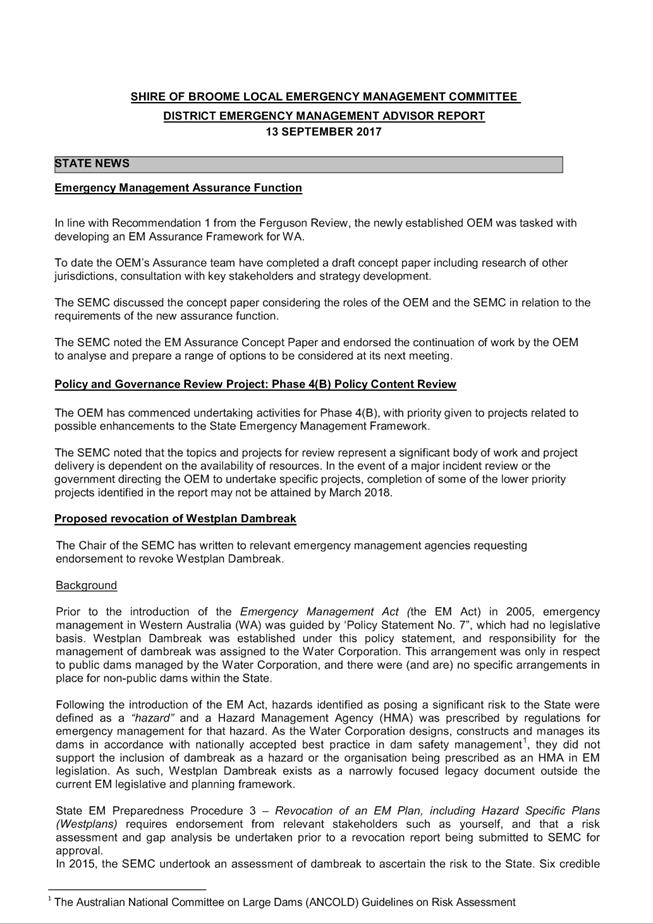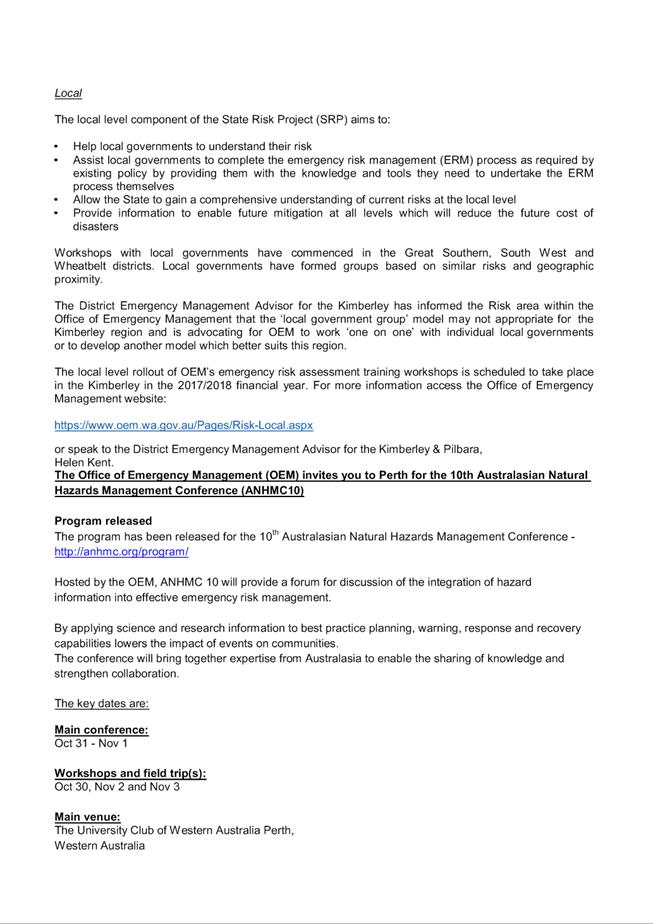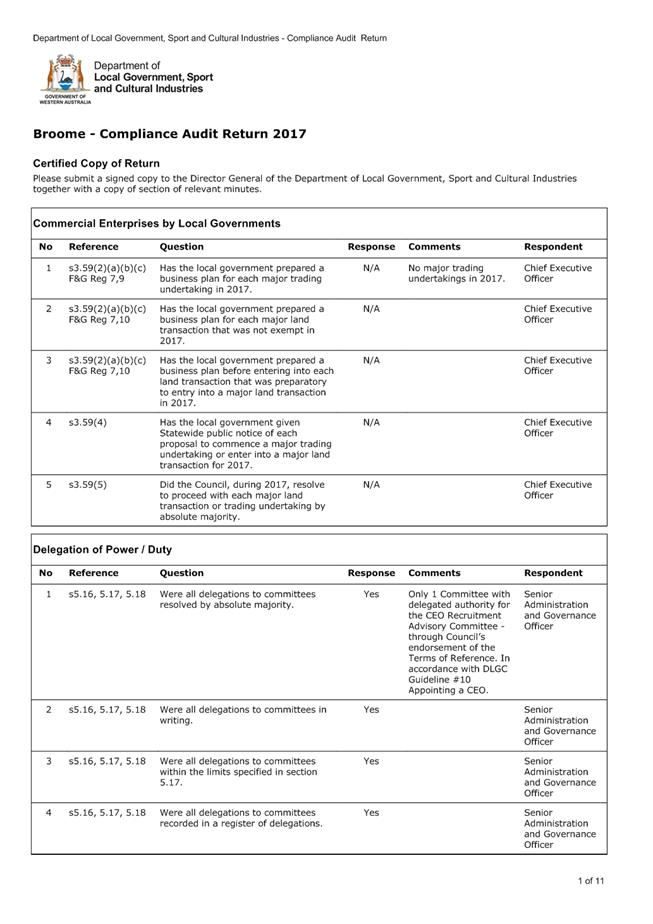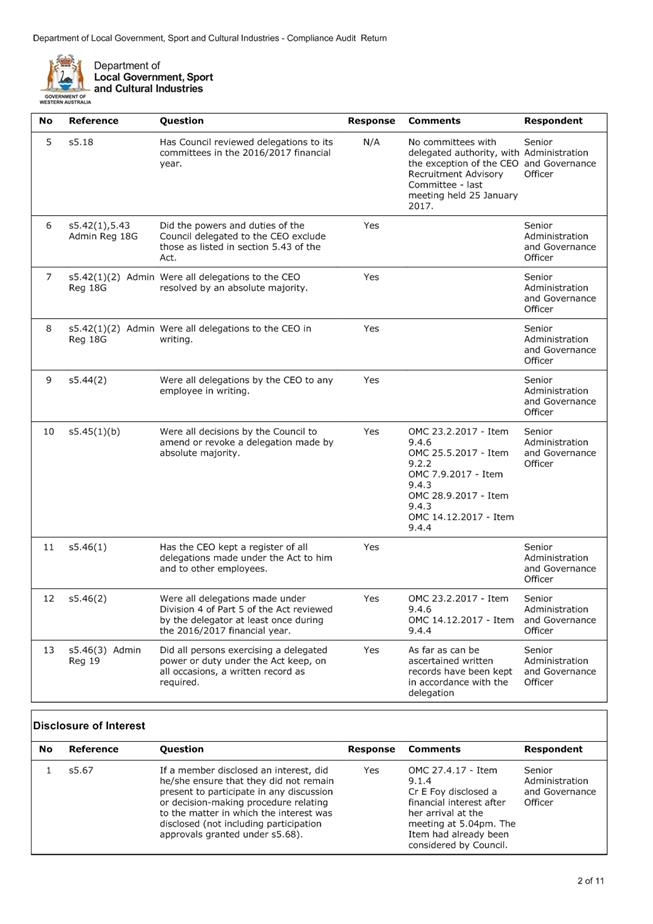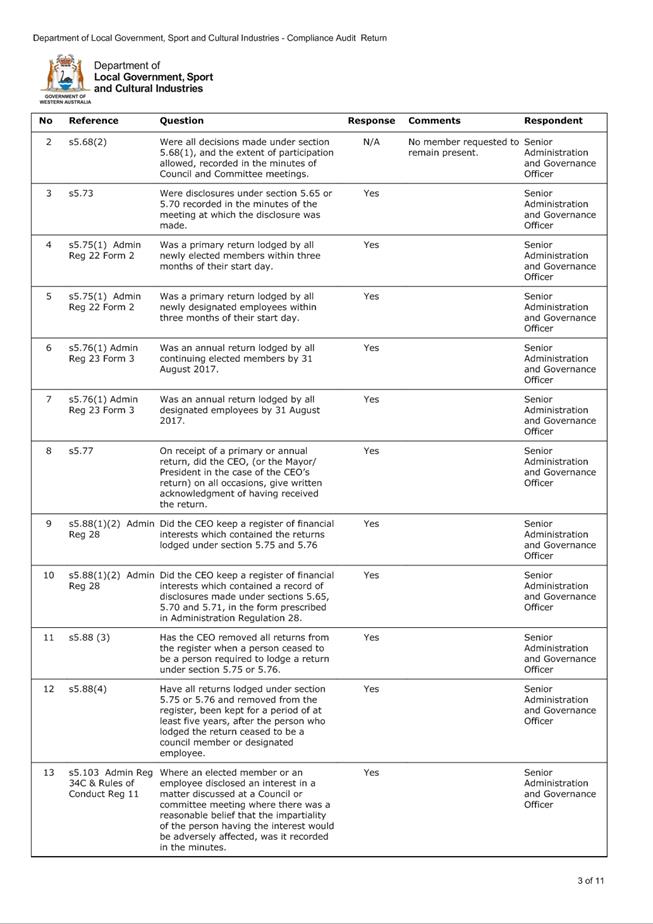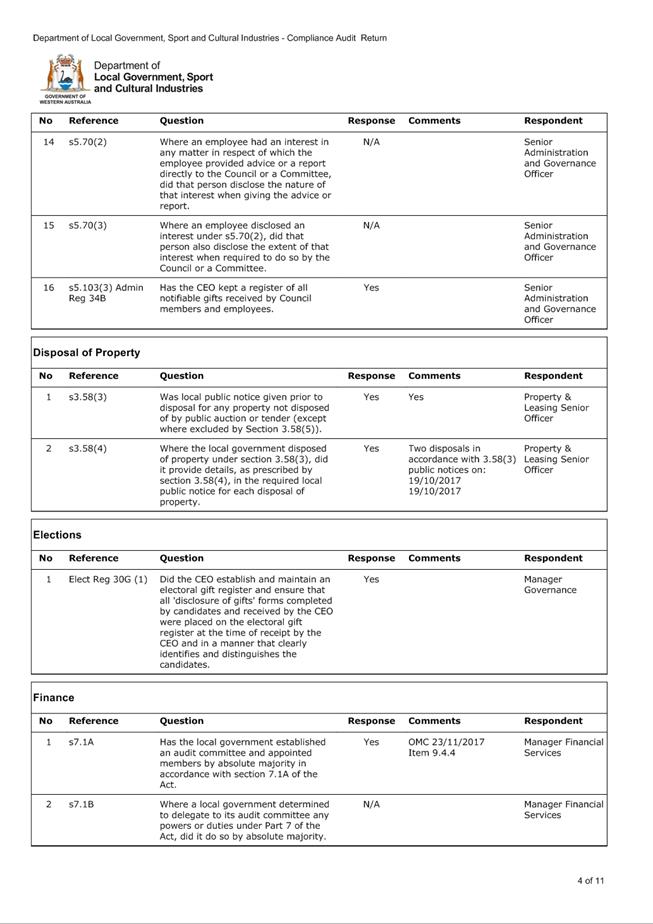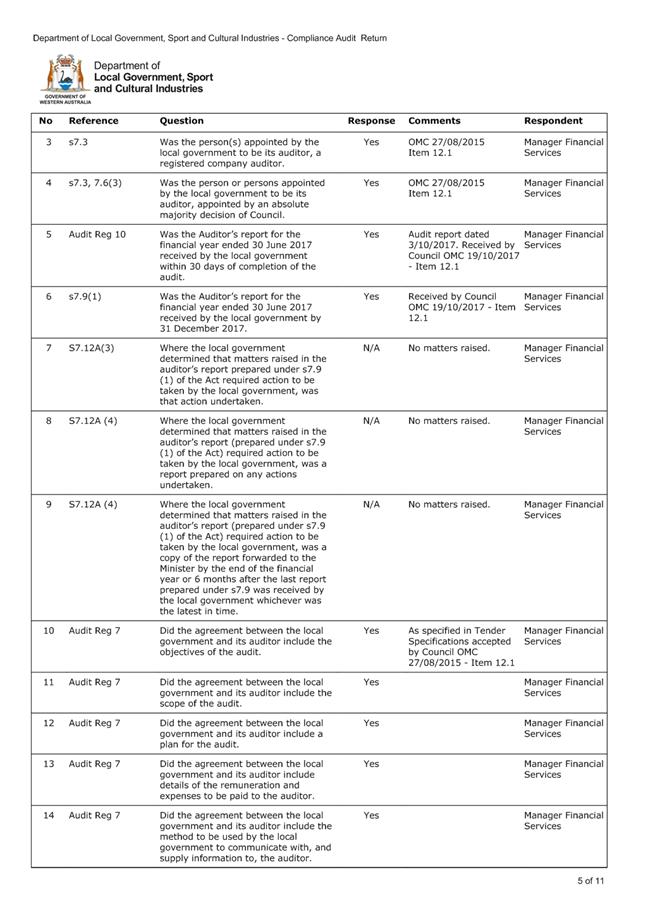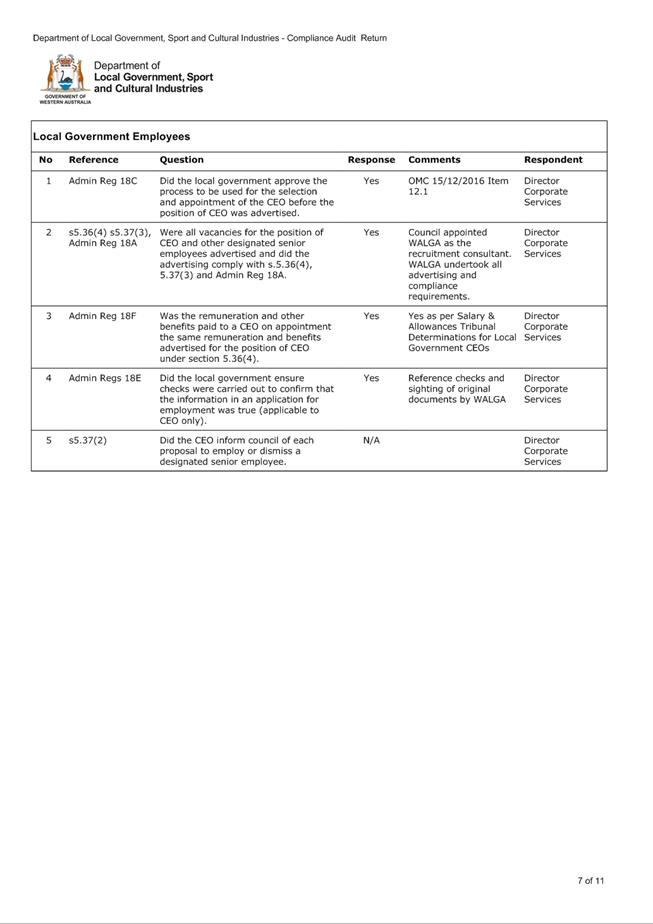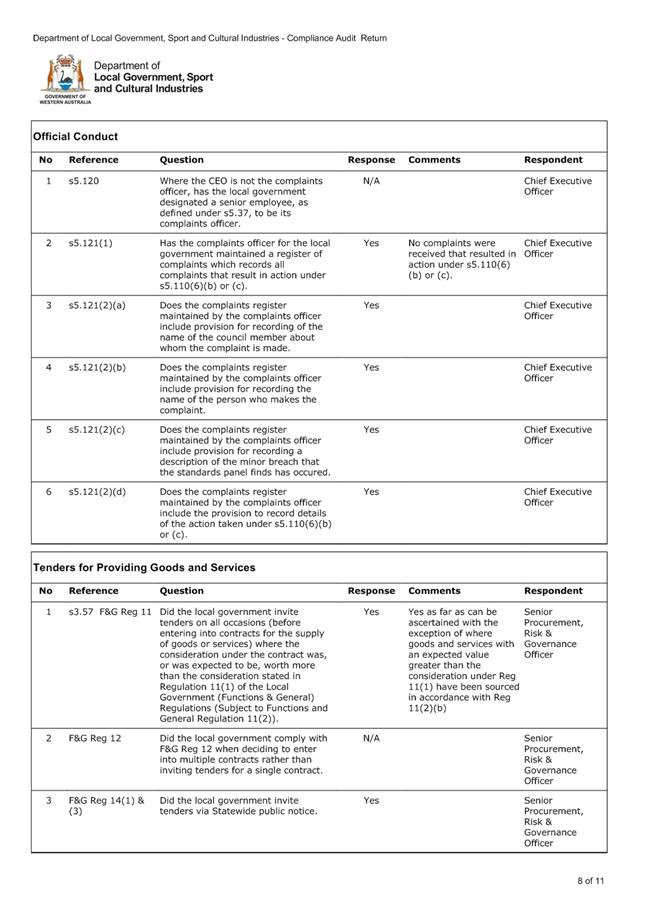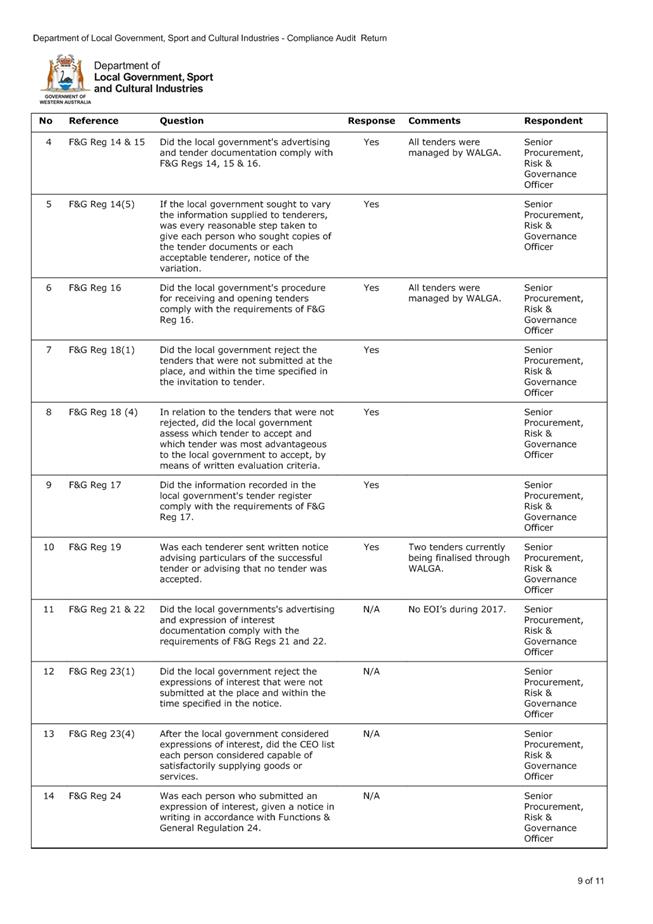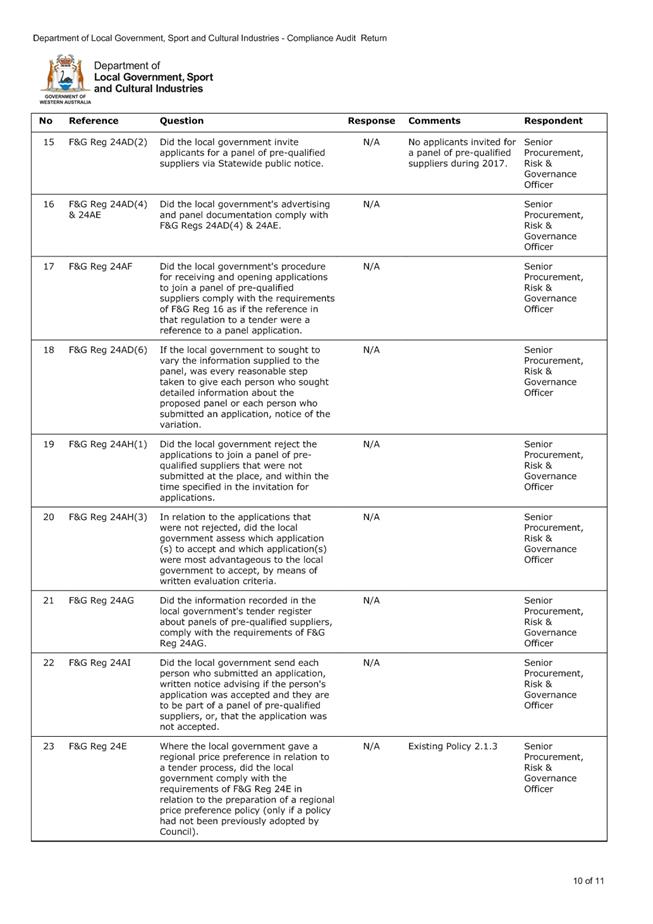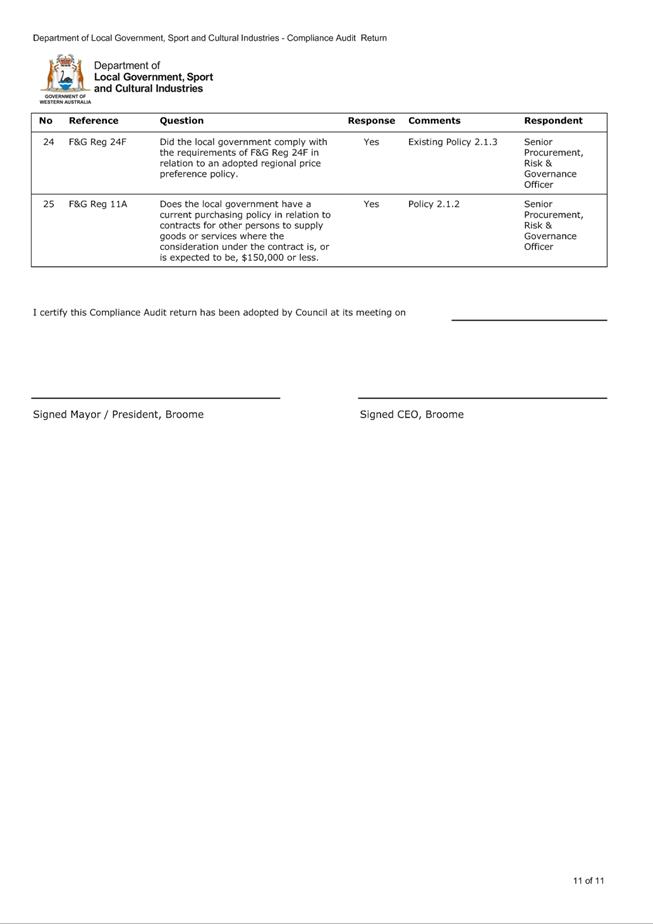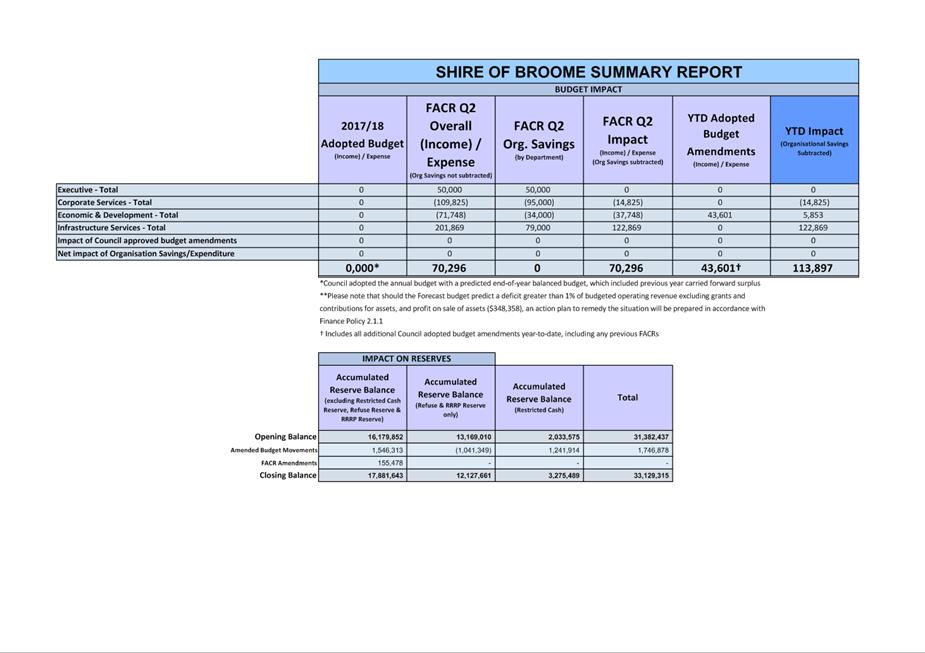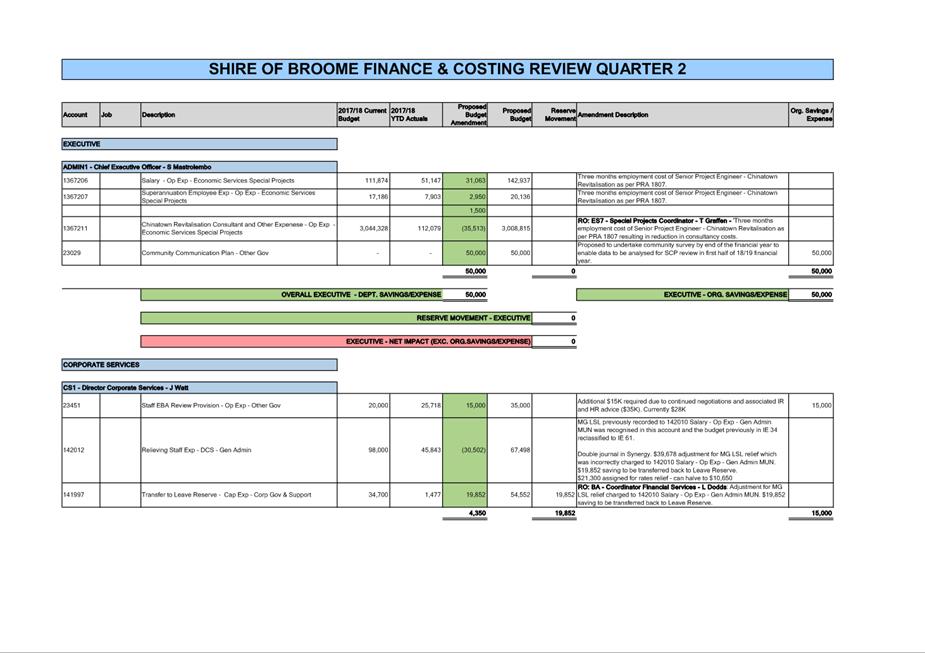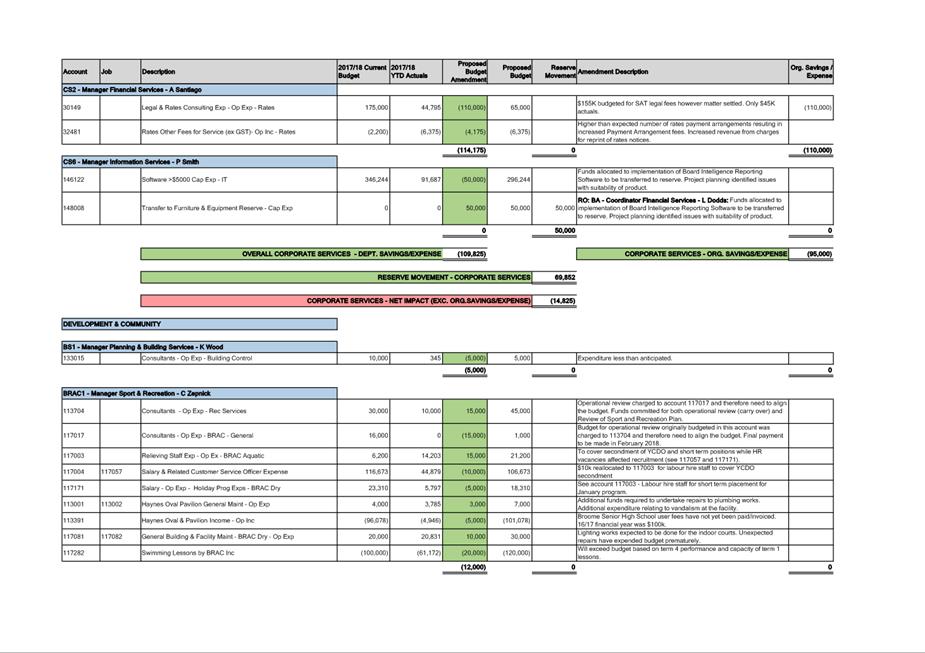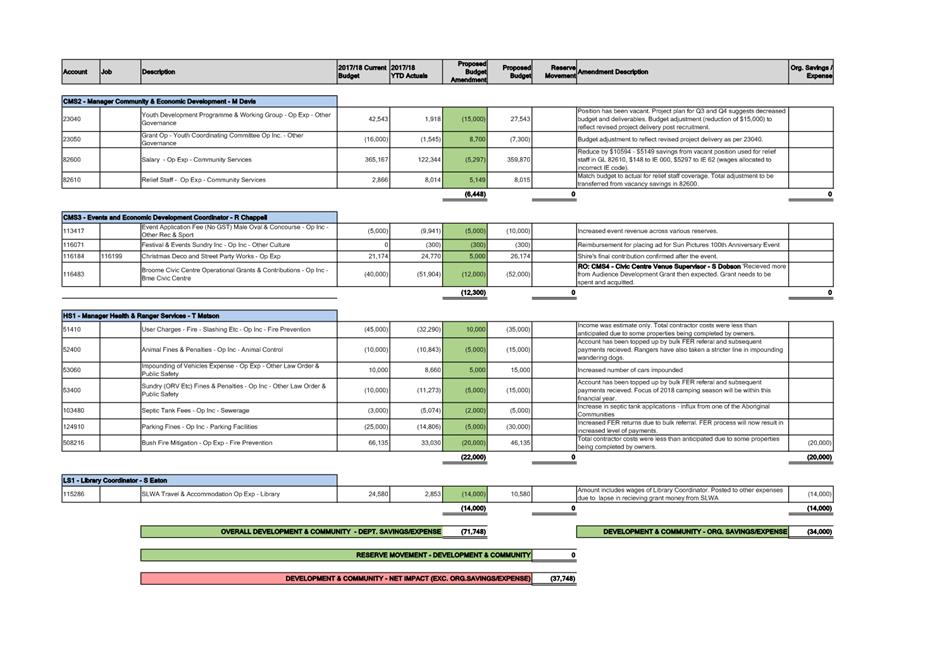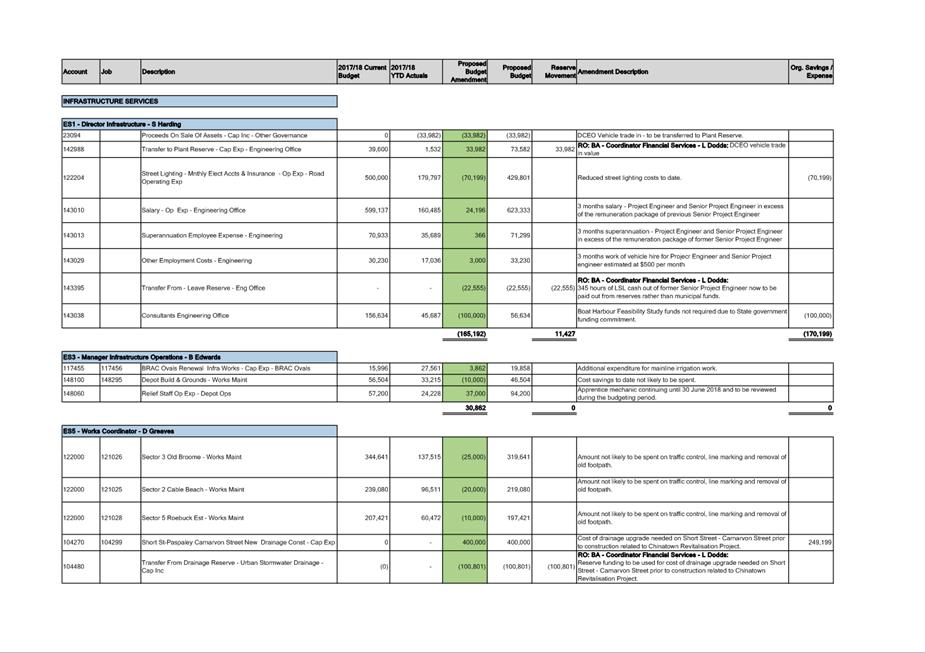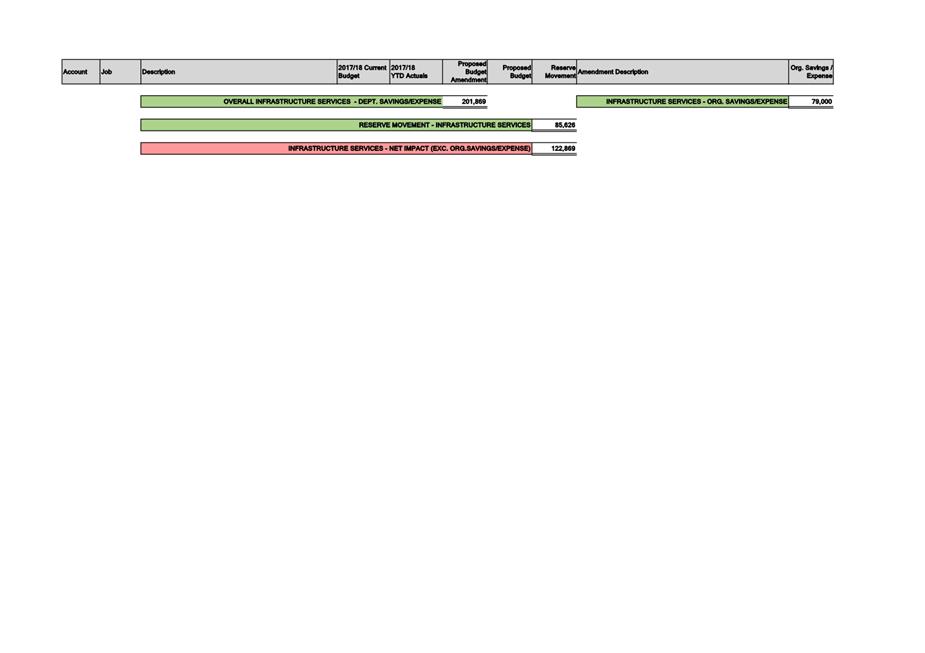
MISSION AND VALUES OF COUNCIL
"A Sustainable Community that is
inclusive, attractive, healthy and pleasant to live in, that uses our land so
as to preserve our history and environment, respects the rights and equality of
our citizens and manages our future growth wisely."
CONFIRMED
MINUTES
OF THE
Ordinary Meeting of Council
22 February 2018
"A
thriving and friendly community that recognises our history and embraces
cultural diversity and economic opportunity, whilst nurturing our unique
natural and built environment."
OUR MISSION
“To
deliver affordable and quality Local Government services.”
CORE VALUES
OF THE SHIRE
The core
values that underpin the achievement of the
mission
will be based on a strong customer service
focus and a
positive attitude:
Communication
Integrity
Respect
Innovation
Transparency
Courtesy
DISCLAIMER
The purpose of Council Meetings is to discuss, and where possible,
make resolutions about items appearing on the agenda. Whilst Council has
the power to resolve such items and may in fact, appear to have done so at the
meeting, no person should rely on or act on the basis of such decision or on
any advice or information provided by a Member or Officer, or on the content of
any discussion occurring, during the course of the meeting.
Persons should be aware that the provisions of the Local
Government Act 1995 (Section 5.25 (e)) establish procedures for revocation or
rescission of a Council decision. No person should rely on the decisions
made by Council until formal advice of the Council decision is received by that
person. The Shire of Broome expressly disclaims liability for any loss or
damage suffered by any person as a result of relying on or acting on the basis
of any resolution of Council, or any advice or information provided by a Member
or Officer, or the content of any discussion occurring, during the course of the
Council meeting.
|
Councillor
|
Cr R Johnston
|
Cr H Tracey
|
Cr M Fairborn
|
Cr W Fryer
|
Cr E Foy
|
Cr D Male
|
Cr P Matsumoto
|
Cr C Mitchell
|
Cr B Rudeforth
|
|
2015
|
26 November
|
|
|
|
|
|
|
LOA
|
|
|
|
2015
|
17 December
|
|
|
|
|
|
|
|
|
|
|
2016
|
25 February
|
|
|
|
|
A
|
|
|
|
|
|
2016
|
31 March
|
|
|
|
|
LOA
|
|
|
|
|
|
2016
|
28 April
|
|
LOA
|
A
|
LOA
|
LOA
|
|
|
|
|
|
2016
|
26 May
|
|
|
A
|
|
|
|
LOA
|
|
|
|
2016
|
30 June
|
|
LOA
|
|
|
|
|
|
|
LOA
|
|
2016
|
28 July
|
|
|
|
|
|
|
|
|
|
|
2016
|
25 August
|
|
|
|
|
LOA
|
|
|
|
|
|
2016
|
29 September
|
|
A
|
|
|
|
LOA
|
|
|
|
|
2016
|
27 October
|
|
|
|
|
|
|
|
LOA
|
|
|
2016
|
24 November
|
|
|
LOA
|
|
|
A
|
|
|
|
|
2016
|
15 December
|
|
|
|
|
A
|
|
|
|
A
|
|
2017
|
23 February
|
|
|
|
|
|
|
|
|
A
|
|
2017
|
30 March
|
|
|
LOA
|
|
LOA
|
|
|
|
|
|
2017
|
27 April
|
|
A
|
LOA
|
A
|
|
|
|
|
|
|
2017
|
25 May 2017
|
|
|
|
|
LOA
|
|
|
|
|
|
2017
|
29 June 2017
|
|
|
|
A
|
LOA
|
|
|
|
|
|
2017
|
27 July
|
|
A
|
|
|
LOA
|
|
|
|
|
|
2017
|
7 September
|
A
|
|
|
|
LOA
|
|
|
LOA
|
|
|
2017
|
28 September
|
LOA
|
|
|
LOA
|
|
|
|
LOA
|
LOA
|
|
2017
|
19 October
|
LOA
|
|
LOA
|
|
|
|
|
|
|
|
2017 Local Government Ordinary Election held 21
October
|
|
Councillor
|
Cr H Tracey
|
Cr D Male
|
Cr M Fairborn
|
Cr W Fryer
|
Cr E Foy
|
Cr C Marriott
|
Cr P Matsumoto
|
Cr C Mitchell
|
Cr B Rudeforth
|
|
2017
|
23 November
|
|
|
|
|
LOA
|
|
|
|
|
|
2017
|
14 December
|
|
|
A
|
A
|
A
|
|
|
|
|
|
2018
|
22 February
|
|
|
|
LOA
|
|
|
|
|
|
|
·
LOA
(Leave of Absence)
|
·
NA
(Non Attendance)
|
·
A
(Apologies)
|
2.25. Disqualification
for failure to attend meetings
(1) A
council may, by resolution, grant leave of absence, to a member.
(2) Leave
is not to be granted to a member in respect of more than 6 consecutive ordinary
meetings of the council without the approval of the Minister, unless all
of the meetings are within a period of 3 months.
(3A) Leave
is not to be granted in respect of —
(a) a
meeting that has concluded; or
(b) the
part of a meeting before the granting of leave.
(3) The
granting of the leave, or refusal to grant the leave and reasons for
that refusal, is to be recorded in the
minutes of the meeting.
(4) A
member who is absent, without obtaining leave of the council, throughout 3
consecutive ordinary meetings of the council is disqualified from continuing
his or her membership of the council, unless all of the meetings are
within a 2 month period.
(5A) If
a council holds 3 or more ordinary meetings within a 2 month period, and a
member is absent without leave throughout each of those meetings, the member is
disqualified if he or she is absent without leave throughout the ordinary
meeting of the council immediately following the end of that period.
(5) The
non‑attendance of a member at the time and place appointed for an
ordinary meeting of the council does not constitute absence from an ordinary
meeting of the council —
(a) if
no meeting of the council at which a quorum is present is actually held on that
day; or
(b) if
the non‑attendance occurs —
(i) while
the member has ceased to act as a member after written notice has been given to
the member under section 2.27(3) and before written notice has been given to
the member under section 2.27(5); or
(ii) while
proceedings in connection with the disqualification of the member have been
commenced and are pending; or
(iiia) while
the member is suspended under section 5.117(1)(a)(iv); or
(iii) while
the election of the member is disputed and proceedings relating to the disputed
election have been commenced and are pending.
(6) A
member who before the commencement of the Local
Government Amendment Act 2009 section 5 1 was granted
leave during an ordinary meeting of the council from which the member was absent
is to be taken to have first obtained leave for the remainder of that meeting.
[Section
2.25 amended by No. 49 of 2004 s. 19(1); No. 17 of 2009 s. 5.]
Minutes – Ordinary
Meeting of Council 22 February 2018 Page 7 of 1227
NOTICE OF MEETING
Dear Council Member,
The next Ordinary Meeting of the
Shire of Broome will be held on Thursday, 22 February 2018 in the Council
Chambers, Corner Weld and Haas Streets, Broome, commencing at 5.00pm.
Regards

S MASTROLEMBO
Chief Executive Officer
15/02/2018
Minutes –
Ordinary Meeting of Council 22 February 2018 Page 15 of 1227
MINUTES
OF THE Ordinary Meeting of Council
OF THE SHIRE OF BROOME,
HELD
IN THE Council Chambers, Corner Weld and
Haas Streets, Broome, ON Thursday
22 February 2018, COMMENCING AT 5.00pm.
The Chairman welcomed Councillors,
Officers and members of the public and declared the meeting open at 5.00pm.
Attendance: Cr
H Tracey Shire
President
Cr
D Male Deputy
Shire President
Cr
M Fairborn
Cr
E Foy
Cr
C Marriott
Cr
P Matsumoto
Cr
C Mitchell
Cr
B Rudeforth
Apologies: Nil
Officers: Mr
S Mastrolembo Chief Executive Officer
Mr
J Watt Director
Corporate Services
Ms
A Nugent Director
Development and Community
Mr
S Harding Director
Infrastructure
Mr
S Penn Media
and Promotions Officer
Ms
R Piggin Manager
Governance
Ms
E Harding Senior
Administration and Governance Officer
Public
Gallery: Shaun
Clark
Ketrina
Keeley
Ty
Matson Shire
of Broome
Glenn
Cordingley Broome Advertiser
Jakob
Waddell Broome
Advertiser
Michelle
Teoh Dinosaur
Coast Management Group
Peter
Smith Shire
of Broome
Denis
Ryan Broome
Futures
Kevin
Smith
Jeremy
Macmath Shire of Broome
John
Geappen Red Sun Camels
Jon
Hall
Trevor
Price
|
FINANCIAL
INTEREST
|
|
Councillor
|
Item
No
|
Item
|
Nature
of Interest
|
|
Cr H
Tracey
|
12.1
|
Broome
Regional Resource Recovery Park - Update on Site Selection.
|
Indirect
Financial – I am a director and shareholder in a jointly owned
company of which Yawuru is part owner.
|
|
IMPARTIALITY
|
|
Councillor
|
Item
No
|
Item
|
Nature
of Interest
|
|
Cr D
Male
|
9.1.1
|
Chinatown
Revitalisation Project Six Month Update
|
Impartiality
– I run a business in the precinct and am a beneficiary of a trust that
owns property in the precinct.
|
|
Cr P
Matsumoto
|
9.2.2
|
Waterbank
– Portion Lot 259 on Deposited Plan 220696
|
Impartiality
– a board member and Director of Nyamba Buru Yawuru.
|
|
Cr E
Foy
|
9.2.2
|
Waterbank
– Portion Lot 259 on Deposited Plan 220696
|
Impartiality
– Yawuru TO member
|
The Chairman advised that public questions had been received
from Gavin Nottle prior to the meeting, however as he was not in attendance in
accordance with Clause 3.4(2) of the Shire of Broome Standing Orders Local Law
his questions would be processed administratively.
********
The following questions were received
at the meeting from Katrina Keeley on behalf of Goolarabooloo Families.
Question One:
Is the Shire Council aware that
Goolarabooloo was notified by the Department of Lands that under the proposed s91
license the grantee (Country Downs) may not:
(a)
cause
environmental harm or damage the land;
(b) clear vegetation, excavate, cut
tracks or put in roads;
(c) erect permanent infrastructure
or fencing;
(d) light fires;
(e) establish watering points
(f)
exclude
Goolarabooloo people or any other native title holders from the license area.
These understandings are reflected in the draft license
forwarded to Goolarabooloo on 10 May 2017.
It is precisely because of this, however, that the
Goolarabooloo people harbour deep concerns about how stock can in fact be
grazed in the proposed license area in a way that is consistent with the terms
and conditions set out in clause 6(a) – (x) of the draft license.
How on earth is this possible, because to give the license
is to agree to the damage of the environment not just to the Springs but to the
Aboriginal Heritage Sites.
Answer provided by Chairman:
This question will be taken on
notice
Question Two:
Is the Shire Council aware that
Goolarabooloo have been working with CALM, DEC and DePAW over the last 18 years
to remove the cattle from Waterbank and in particular the Pt Coloumb
Conservation reserve? Country Downs was notified from these government
departments to help but declined because they said they did not have the funds
to do so.
Answer provided by Chairman:
This question will be taken on
notice
Question Three:
Is the Council aware Goolarabooloo
has at the present moment received funding from DAA to protect their sites. A
portion of that is to remove the cattle from the area. Goolarabooloo has
already purchased the portable stockyards to do so. And will begin to remove
the cattle over the next few months?
Answer provided by Chairman:
This question will be taken on
notice.
********
The following question was received
prior to the meeting from Michelle Teoh, Secretary Dinosaur Coast Management
Group Inc.
Question One – Regarding
Agenda Item 9.1.1 Chinatown Revitalisation:
There is a report on the proposed
Kimberley Centre for Culture Arts and Story. In October 2016 the DCMG resolved
to work with Yawuru in the development of the dinosaur component of a
Cultural/Interpretive Centre. The DCMG had a brief opportunity in November 2017
to discuss options/approaches with the consultant. The report states:
“Further discussion around
potential governance structures and other key elements is due to be workshopped
by the Working Group throughout March, in addition to the drafting of the
feasibility study and business case.”
When will the DCMG be advised
whether the dinosaur story (cultural and scientific) is to be included in the
proposed Centre?
Response provided by Director
Development and Community:
The Shire of Broome is part of a Working Group and
Steering Committee which are overseeing current investigations to inform the
development of a feasibility study and business plan for the Kimberley Centre
for Culture, Arts and Story. Other stakeholders represented on the Working
Group and Steering Committee include Nyamba Buru Yawuru, Landcorp, Kimberley
Development Commission and Tourism WA.
These reports are to be tabled with the Steering
Committee mid this year. Elements including funding, demand, governance, site,
economic impact and an outline of potential activities, displays and uses for
the Centre are part of this study – and the Shire thanks the Dinosaur
Coast Management Group for its contribution thus far.
The business case is the first step in a process and
future stages will include additional opportunities for consultation as part of
determining exhibition content. In addition to the project being viable, the
continuance of these stages will be subject to successfully obtaining funding.
Question Two - Agenda Item: 10.3
Yawuru Park Council Minutes and Recommendations:
On 8 June 2017 the DCMG made a
submission on the proposed Coastal Park Management Plan. In the submission we
detailed some matters that need rectification in relation to the infrastructure
improvements at Gantheaume Point and the Reddell Beach car parks. A question
was asked at the OCM 28 September 2017 as to what was happening as no response
had been received. The Shire then advised as follows:
“The Yawuru Minyirr Buru
Management Plan is still in draft format. Submissions have been reviewed by the
Yawuru Park Council (YPC) Working Group and forwarded to the consultant
responsible for finalising the report. The consultant has requested some
additional information for context only. Once the recommended changes have been
made to the draft plan, the final plan will be presented to Council for
adoption. At this time, all persons or organisations who made a submission in
relation to the draft plan will be advised of the outcome of the process.”
The Yawuru Minyirr Buru Management
Plan has been endorsed by the YPC and is listed for Council endorsement. It is
noted that neither the YPC report nor the Shire report includes any
‘response to submissions’.
When will the DCMG receive a
detailed response to the various matters raised in its original submission in a
manner and time that will enable the DCMG (a volunteer based organisation) to
review the responses and if appropriate seek further clarification?
Response provided by Director
Development and Community:
The consultant preparing the Yawuru Minyirr Buru
Management Plan, Natural Area Consulting Management Services, acknowledged the
Dinosaur Coast Management Group’s original submission via email on 9 June
2017.
Following the endorsement of the Yawuru Minyirr Buru
Management Plan by both the Yawuru Park Council (which occurred on 20 December
2017) and the Shire of Broome Council (scheduled for the Ordinary Meeting of
Council tonight), all parties making a submission will be advised of the
outcome.
Question Three - Agenda
Item: 10.3 Yawuru Park Council Minutes and Recommendations:
There is reference to a Yawuru Conservation Parks
Recreation Master Plan – it has been deferred for endorsement. The
Nationally Heritage Listed dinosaur tracks occur in the Broome Sandstone
– located primarily within the intertidal area. Yawuru and the DCMG have
agreed there are particular sites around the coastline that are suitable for
public viewing. These include Marlagun on Cable Beach, Reddell Beach (north),
Gantheaume Point and Entrance Point. Access to three of these sites occurs
through the Minyirr Buru Conservation Park – the DCMG is keen to work
with the Shire and Yawuru in the development of the Recreation Master Plan to
ensure the access points are suitably located, safe and appropriately signed.
Will the DCMG be permitted to contribute to the development of the Yawuru
Conservation Park Recreation Master Plan and if so when can this happen?
Response provided by Director
Development and Community:
The draft Recreation Master Plan is a living document
which will guide the joint management partners in the development of visitor
management infrastructure priorities and budget across the Conservation Estate.
Yawuru and the Yawuru Conservation Estate joint management partners are keen to
work with the Dinosaur Coast Management Group to develop strategies for the
protection and management of the dinosaur footprints, including locations and
content for interpretive signage. The CEO of Yawuru wrote to the DCMG on 6
October 2017 proposing a field trip to the footprints with senior Yawuru people
when Dr Salisbury was next in Broome, to begin these discussions and develop
the relationship.
********
The following questions were received
prior to the meeting from Kevin Smith:
My questions relate to recent
overflows from Broome’s Waste Water Treatment Plants. Cr Foy has supplied
a Background Briefing Paper, and also distributed copies to her fellow
Councillors. My questions for this meeting are:
Question One:
Has the Shire of Broome advised or
consulted with its insurers, and/or been provided with advice by the insurers
regarding actions required and potential costs regarding the wastewater
overflows, given the existence of considerable public liability issues arising
from these pollution events and , if so, what advice has been received?
Response provided by Director
Development and Community:
The Shire of Broome is still assessing the impacts of the
weather events of 2018. It is unlikely that a claim will be made to the
Shire’s insurers as a result of any potential discharge to Roebuck Bay,
on the basis that the waste water treatment ponds are not owned, controlled or
managed by the Shire. The Shire of Broome is not aware of any claims for
damages from any person or entity and will not comment on the possibility of
any such claim.
The Shire is in discussion with other stakeholders and is
seeking advice on if the erosion caused by the weather events at the Demco
reserves is an eligible claim under the WANDRRA scheme.
Question Two:
A number of government agencies,
departments and other organisations have a view on, and interest in, the
impacts of these pollution events including, but not limited to, the Shire of
Broome, Yawuru Traditional Owners, Water Corp, Parks and Wildlife Service,
Department of Water and Environmental Regulation, Department of Health. Have
meetings been convened involving these organisations, to co-ordinate views and
interests, determine required actions, and allocate responsibilities and costs,
and if not, will they be convened?
Response provided by Director
Development and Community:
Shire officers have had ongoing
consultation with a range of stakeholders regarding the recent weather events
and impacts on Broome. This is consistent with the Shire’s
responsibilities to coordinate and assist in recovery efforts from declared
events, and also as a land manager in the Demco area. This consultation will be
ongoing.
Question Three:
What are the Shire of
Broome’s prescribed responsibilities with regard to maintenance and management
of Ramsar-listed Wetlands of International Significance within its boundaries,
and what is the Shire’s estimate of the financial impact on the local
economy should Ramsar-listing be removed from sites within the Shire of Broome
due to ‘The limits of acceptable change’ being exceeded?
Response provided by Director
Development and Community:
The Shire has no legislated
responsibilities for Ramsar listed wetlands beyond those of any other land
manager. The Shire has not conducted any detailed estimate of the financial
implications should the relevant Minister remove the Ramsar listing for the
parts of Roebuck Bay that are listed.
The responsibility for determining
the environmental health of Roebuck Bay for the purposes of the Ramsar listing
is a matter for the Commonwealth Department of Environment and Energy. An
assessment of what is the acceptable limits of change and the possibility that
these limits have been exceeded is the responsibility of that Department. The
Shire is unaware of any studies having been undertaken by the Commonwealth
Department of Environment and Energy that may indicate that the acceptable
limits of change have been exceeded. It should be noted that the Shire
has no knowledge of and has received no correspondence to indicate that the
Ramsar listing is being revaluated.
A written request for a Leave of
Absence for the period 23 April 2018 to 14 May 2018 inclusive was received from
Cr C Marriott.
|
council Resolution:
Moved: Cr D Male Seconded:
Cr C Mitchell
That a leave of absence for
Cr C Marriott be granted for the period 23 April 2018 to 14 May 2018
inclusive.
CARRIED UNANIMOUSLY 8/0
|
A written request for a Leave of
Absence for the period 12 February 2018 to 20 March 2018 inclusive was received
from Cr W Fryer.
|
Council Resolution:
Moved: Cr C
Mitchell Seconded:
Cr M Fairborn
That a leave of absence for
Cr W Fryer be granted for the period 12 February 2018 to 20 March 2018
inclusive.
CARRIED UNANIMOUSLY 8/0
|
A written request for a Leave of
Absence for the period 19 March 2018 to 4 April 2018 inclusive was received
from Cr D Male:
|
Council Resolution:
Moved: Cr C
Mitchell Seconded:
Cr B Rudeforth
That a leave of absence for
Cr D Male be granted for the period 19 March 2018 to 4 April 2018 inclusive.
CARRIED UNANIMOUSLY 8/0
|
A written request for a Leave of
Absence for the period 19 March 2018 to 25 March 2018 inclusive was received
from Cr P Matsumoto:
|
COUNCIL Resolution:
Moved: Cr C
Mitchell Seconded:
Cr D Male
That
a leave of absence for Cr P Matsumoto be grated for the period 19 March 2018
to 25 March 2018 inclusive
CARRIED UNANIMOUSLY 8/0
|
|
COUNCIL
Resolution:
Moved: Cr D Male Seconded:
Cr C Mitchell
That the Minutes
of the Ordinary Meeting of Council held on 14 December 2017, as published and
circulated, be confirmed as a true and accurate record of that meeting.
CARRIED
UNANIMOUSLY 8/0
|
Nil
Cr Fairborn presented a petition from
residents of Broome North Estate requesting “that the Shire investigate
solutions to rectify the health and safety concerns regarding the Open Drainage
that runs through the residential properties at Broome North for the following
reasons:
·
The risk of
a child or pet drowning in the open drainage system during the wet.
·
The risk of
a child of pet being injured in the open drainage system during the wet.
·
The risk of
a child crawling under a fence, getting caught under during the wet, or possibly
venturing into the neighbours yards or public areas.
·
The current
use of chicken wire/mesh catches rubbish flowing into the drains and is a
safety hazard as there are unknown items and sharp objects (tins, needles,
glass) that children could play with and injure themselves.
·
Additional
cost to make the property safer and more functional for our use and enjoyment.”
The Chief Executive Officer advised the
petition was accepted and an item would be presented to the next Ordinary
Meeting of Council.
The Chief Executive Officer
advises that there are matters for discussion on the agenda for which the
meeting may be closed, in accordance with section 5.23(2) of the Local
Government Act 1995.
|
Council Resolution:
Moved: Cr D Male Seconded:
Cr C Mitchell
That the following Agenda items be considered under
14. Matters Behind Closed Doors, in accordance with section 5.23(2) of the
Local Government Act 1995, as specified:
9.4.8 WESTERN
AUSTRALIA NATIONAL DISASTER RELIEF RECOVERY ARRANGEMENTS - CONTRACTS
RFQ17-103 to 17-108 AND RFQ17-110
Item 9.4.8 and any
attachments are confidential in accordance with Section 5.23(2) of the Local
Government Act 1995 section 5.23(2)((e)(iii)) as it contains “a matter
that if disclosed, would reveal information about the business,
professional, commercial or financial affairs of a person, where the
information is held by, or is about, a person other than the local
government”.
12.1 BROOME
REGIONAL RESOURCE RECOVERY PARK - UPDATE ON SITE SELECTION
Item 12.1 and any
attachments are confidential in accordance with Section 5.23(2) of the Local
Government Act 1995 section 5.23(2)(c) as it contains “a contract
entered into, or which may be entered into, by the local government and which
relates to a matter to be discussed at the meeting”.
CARRIED
UNANIMOUSLY 8/0
|
9.1

PRIORITY STATEMENT
Embracing our cultural diversity and the relationship
between our unique heritage and people, we aim to work in partnership with the
community to provide relevant, quality services and infrastructure that meet
the needs and aspirations of our community and those visiting and doing
business in our region.
Supporting and contributing to the well-being and
safety of our community is paramount, as is our focus on community engagement
and participation.
Council aims to build safe, strong and resilient
communities with access to services, infrastructure and opportunities that will
result in an increase in active civic participation, a reduction in anti-social
behaviour and improved social cohesion.
Minutes – Ordinary
Meeting of Council 22 February 2018 Page 32 of 1227
|
With regard to Item 9.1.1, Cr D Male declared the
following impartiality interest pursuant to Regulation 11 of the Local
Government (Rules of Conduct) Regulations 2007 – “I run a
business in the precinct and am a beneficiary of a trust that owns property
in the precinct.”
|
|
9.1.1 CHINATOWN
REVITALISATION PROJECT SIX MONTH UPDATE
LOCATION/ADDRESS: N/A
APPLICANT: Nil
FILE: PLA94
AUTHOR: Chief
Executive Officer
CONTRIBUTOR/S: Manager
Planning & Building Services
Manager Community and Economic
Development
Chinatown Investment &
Development Coordinator
RESPONSIBLE
OFFICER: Chief
Executive Officer
DISCLOSURE
OF INTEREST: Nil
DATE OF REPORT: 7
February 2017
|
|
SUMMARY: This
report seeks to provide Council with an update on the progress made to date
on the delivery of the Chinatown Revitalisation Project (CRP) and also seeks
Council endorsement of proposed amendments to the Financial Assistance
Agreement.
|
BACKGROUND
Previous
Considerations
OMC 26 June 2014 Item
9.3.1
OMC 30 April 2015 Item
9.2.7
OMC 2 June 2015 Item
9.2.5
OMC 27 August 2015 Item
9.3.1
OMC 26 November 2015 Item
9.4.5
SMC 17 June 2016 Item
6.2.1
OMC 25 August 2016 Item
9.1.6
OMC 27 October 2016 Item
10.2
OMC 15 December 2016 Item
9.3.1
OMC 23 February 2017 Item
9.1.2
OMC 25 May 2017 Item
9.3.1
OMC 28 September 2017 Item
9.1.1
OMC 14 December 2017 Item
9.3.1
OMC 14 December 2017 Item
9.2.12
OMC 14 December 2017 Item
9.3.1
At the Special Meeting of Council
held 17 June 2016, Council resolved as follows;
|
COUNCIL RESOLUTION:
(REPORT
RECOMMENDATION)
Moved: Cr B Rudeforth Seconded:
Cr H Tracey
That Council:
1. Thanks the State of
Western Australia for the $10 million grant funding for the Chinatown
Revitalisation Project.
2. Thanks Tourism
Western Australia for confirmation for the Tourism Demand Driver
Infrastructure Grant of $300,000 to be applied towards the Frederick
Street/Dampier Terrace Lookout Facility, which forms part of the Chinatown
Revitalisation Project.
3. Endorses the Draft
Financial Assistance Agreement with the Department of Regional Development
and authorises the Shire President and Chief Executive Officer to engross the
final documentation as required.
4. Endorses the
updated Memorandum of Understanding between the Shire of Broome, Landcorp and
Kimberley Development Commission and authorises the Shire President and Chief
Executive Officer to engross the documentation as required.
5. Endorses the Chinatown
Revitalisation Steering Group Terms of Reference and Governance structure and
appoints the Chief Executive Officer to be the Shire’s representative
on this group.
6. Requests the Chief
Executive Officer to:
(a)
Allocate $1.7 million dollars over the 2016/17 and 2017/18 financial years to
the Chinatown
Revitalisation Project.
(b) Commence procurement of the relevant
consultancies together with the project collaborative group in line with the
project documentation.
(c) Ensure incentives are included
within project tender specifications to encourage submissions from and/or
involvement of local businesses where appropriate.
(d) Provide six monthly updates on the
project for Council’s information.
CARRIED
UNANIMOUSLY 7/0
|
In accordance with point 6(d) of the
above resolution, six monthly updates on the CRP are to be provided to Council
and this has been provided at the Ordinary Meetings of Council (OMC) held 23
February 2017 and 28 September 2017. This report seeks to provide
Council with a further six-monthly update. It is also noted that Steering
Committee meeting minutes have been provided to Council through the Councillor
Information Bulletin monthly and feedback sought for project specifics from
Councillor workshops or formally where need be through OMCs.
The Financial Assistance Agreement
(FAA) between the WA Department of Primary Industries and Regional Development
(DPIRD) and the Shire of Broome (the Shire) provides for an investment of $10
million by the State for the delivery of various key projects. The Shire
and Tourism WA have also allocated a further $2 million and $700k respectively,
resulting in a total project spend of $12.7 million. These Projects are as
follows:
|
Item of Expenditure
|
Budget
|
Source of Funds
|
|
Gray Street Extension
Feasibility & Technical Studies
|
$1,000,000
|
Royalties for Regions
($745,000)
Shire of Broome ($255,000)
|
|
Roebuck Bay Reconnection
and Coastal Protection Feasibility
|
$1,000,000
|
Royalties for Regions
($855,000)
Shire of Broome ($145,000)
|
|
Cultural Centre Feasibility
|
$850,000
|
Royalties for Regions
Tourism WA ($100,000)
|
|
Dampier Terrace Renovation
|
$3,800,000
|
Royalties for Regions
|
|
Carnarvon Street Upgrades
|
$2,725,000
|
Royalties for Regions
|
|
Frederick Street Lookout
|
$900,000
|
Shire of Broome ($600,000)
Tourism WA ($300,000)
|
|
Tourist Rest Facilities
|
$700,000
|
Shire of Broome
|
|
Connection of Dampier
Terrace and Terrace Street
|
$600,000
|
Shire of Broome ($300,000)
Tourism WA ($300,000)
|
|
Enhanced laneways strategy
and funding program
|
$290,000
|
Royalties for Regions
|
|
Chinatown Commercial
Liaison Officer (over 2 years) and funding program
|
$600,000
|
Royalties for Regions
|
|
Administration/Audits/Reporting
|
$235,000
|
Royalties for Regions
|
|
Total Budget
|
$12,700,000
|
|
Following the engrossing of the FAA,
an amount of $10 million was deposited into the Shire’s account. These
funds were then deposited into a Western Australian Treasury Corporation
Account (Treasury) and are transferred across in agreed lump sums upon successful
achievement of project milestones set out in the agreement. The aforementioned
projects have been scheduled across two years with deliverable milestones
allocated across this period.
The first milestone was the signing
of the FAA with DPIRD which occurred on 27 June 2016 and released $500,000 of
funding. In accordance with the adopted Business Case and the FAA, the
first items of expenditure incurred in 2016/17 were the recruitment of a
Chinatown Investment and Development Coordinator (CIDC) and the engagement of a
Project Director consultancy (DEVMAN).
Further to this, the Communications
and Engagement consultancy team were also engaged by LandCorp on 12 September
2016. This was awarded to the partnership of RFF Australia and the Broome
Chamber of Commerce and Industry. The role of this consultancy is to
manage all external communications for the suite of projects forming part of
the CRP and manage community and stakeholder engagement for the feasibility
projects, with the exception of the Kimberley Centre for Culture, Art and
Story.
The second milestone date was 31
December 2016 and required the submission of finalised project plans for all
ten sub-projects, recruitment of the CIDC, and the completion of the CIDC Two
Year Activity Plan and preliminary community engagement on the Kimberley
Centre. These milestone requirements have been met and further funds of
$1.3 million were released in February 2017.
A team of specialist
consultants have also been engaged by LandCorp to deliver the feasibility
studies and/or design and construction projects detailed in the Chinatown
Revitalisation Business Case. These consultants include:
o Place Making Consultant
– The Planning Group (TPG);
o Environmental Consultant
– Strategen;
o Civil Engineer – TABEC;
o Public Realm Architecture
– UDLA;
o Research and Engagement
– Simon McArthur & Associates;
o Engagement – NBY;
o Environmental Assessment
– GHD;
o Coastal Design – MP
Rogers;
o Traffic Assessments –
DVC; and
o Gray St Reclamation Valuation
– Colliers.
The third milestone date was 30 June
2017. At the OMC held 25 May 2017, Council endorsed proposed amendments
to some of the milestones defined within the FAA (The revised FAA is Attachment
1 to this report). The amendments related solely to the
wording around the deliverables and did not impact milestone dates and payments
themselves, resulting in a nil impact on the budget cash flow for the
project. These milestone requirements were also met with further funds of
$4.75 million released in September 2017. In review and
reconciliation of milestone payments it has been identified that a further
$200k was due for release at this time, however has not been transferred to
date. A payment request follow-up is pending with DPIRD.
The fourth milestone date was 31
December 2017 and the milestones and respective amount of funding that was due
for release is outlined below:
|
Project
|
Performance Method
|
Payment
|
|
Dampier Terrace Upgrade
|
|
· Tender documentation complete.
|
Quarterly Reports on progress
provided to the Department.
|
$1,000,000
|
|
Carnarvon St Upgrade
|
|
· Tender documentation complete.
|
Quarterly Reports on progress
provided to the Department.
|
$1,000,000
|
|
|
|
Enhanced
Laneways Strategy and Grant Funding Program
|
|
· Practical completion of one laneway and evidence of successful
negotiation with laneway owners.
|
Quarterly Reports on progress
provided to the Department.
|
$150,000
|
|
Chinatown Investment and
Development Coordinator
|
|
· 12 month review of position and implementation.
|
Annual Report provided to the Department.
|
$200,000
|
|
Total
Amount Due
|
$2,350,000
|
In brief, the milestone relating to
the Chinatown Investment and Development Coordinator has been met, however the
milestones relating to the Dampier Tce and Carnarvon St Upgrades and the
Enhanced Laneways Strategy and Grant Funding Program have not been met.
It is noted that following agreement from the Steering Committee, DPIRD were
advised in September 2017 of the need to adjust the milestone for Tender
documentation completion. The Steering Committee are also proposing to revise
the milestone relating to the Enhanced Laneway and Grant Funding Program.
A revised FAA is attached for Council consideration of endorsement.
This report will provide more detail
on the progress of the milestone tasks to 31 December 2017 and an update on
progress of the broader Chinatown Revitalisation project. A copy of the
minutes of the Chinatown Stakeholder Reference Group meetings held between
August and December 2017 are also tabled for Council’s information.
COMMENT
A six-monthly update is provided
below and has been summarised by:
1. CIDC
activities;
2. Design
and Constructions Projects;
3. Feasibility
Projects; and
4. Chinatown
Stakeholder Reference Group Minutes
1. Chinatown
Investment and Development Coordinator Activities
Over the last six
months the CIDC has undertaken the following based on the following four sub
roles:
· Community
& Trader Engagement
· CIDC
led Initiatives
· Grants
Support & Project Development
· Administration
Community
& Trader Engagement
· Trader
Workshop: 29 November 2017 regarding 2018 grants end events calendar
· CIDC
Towns Walks, General and HQ Correspondence, details
o Approximately one town
walk per month, visiting 70 – 80 traders per visit
o Correspondence with
approximately 20 traders or owners per month (phone, email, meeting)
o Approximately 50
visitors at HQ per week with queries such as requesting project info, trader
assistance, general interest and directions
CIDC led
Initiatives
· Project
HQ, Activators
o Hive Handmade;
o Artist Michael Torres;
and
o Corrugated Lines
Festival Hub
· Music
mornings
o 6 August 2017;
o 13 August 2017;
o 20 August 2017; and
o 27 August 2017
· Friday
late night trading:
o 25 August 2017;
o 15 September 2017;
o 6 October 2017; and
o 10 November 2017
o 8 December (Christmas
Party Support)
Grants Support
and Project Development
Johnny Chi
Lane Refurbishment
· Meetings/discussions
with applicant prior to application regarding project scope
· Review
and assessment of application
· Ongoing
artwork development
· Status:
complete
Aarli Bar
Redevelopment
· Meetings/discussions
with applicant prior to application regarding project scope
· Review
and assessment of application
· Design
Development with Streetscape design team
· Ongoing
project development with applicant
· Status:
in progress
Sun Pictures
· Meetings/discussions
with applicant prior to application regarding project scope
· Review
and assessment of application
· Ongoing
project development with applicant
· Event
Communications & oversight
· Status:
complete
Incredible
Edible Broome
· Meetings/discussions
with applicant prior to application regarding project scope
· Review
and assessment of application
· Ongoing
project development with applicant
· Status:
complete
Signage and
Relocation of Azure Beach
· Meetings/discussions
with applicant prior to application regarding project scope and viability
· Review
and assessment of application
· Status:
open
Betty’s
Frock Shop Refurbishment
· Meetings
and discussions with applicant prior to application regarding project scope and
viability
· Review
and assessment of application
· Ongoing
project development with applicant
· Status:
in progress
Corrugated
Lines Festival
· Meetings/discussions
with applicant prior to application regarding project scope
· Review
and assessment of application
· HQ
and event communications & oversight
· Status:
complete
T.B Eliies
Store Refurbishment Artwork
· Meetings/discussions
with applicant prior to application regarding project scope and viability
· Review
and assessment of application
· Negotiation
of Project scope
· Ongoing
project development with applicant
· Status:
in progress
Chinatown
Historical Models
· Meetings/discussions
with applicant prior to application regarding project scope
· Review
and assess application
· Negotiation
of Project scope
· Ongoing
project development with applicant
· Status:
in progress
Goolari Media
Chinatown Stories App Development
· Meetings
and discussions with applicant prior to application
· Review
and assessment of application
· Follow
up project development meetings
· Status:
open
Chinatown
Nights Event
· Meetings
and discussions with applicant prior to application
· Review
and assessment of application
· Relationship
management following exclusion of project
· Status:
not supported
Jetty to Jetty
Activation Events
· Meetings/discussions
with applicant prior to application regarding project scope
· Review
and assessment of application
· Event
Communications & oversight
· Status:
complete
Shinju Pearl
Harvest Party
· Meetings/discussions
with applicant prior to application regarding project scope
· Review
and assessment of application
· HQ
and Events Communications & oversight
· Status:
complete
Sun Pictures
al fresco Area
· Meetings
and discussions with applicant prior to application regarding project scope and
viability
· Review
and assessment of application
· Ongoing
project development with applicant
· Status:
open
Sun Pictures
100 Year Anniversary Plaques
· Meetings/discussions
with applicant prior to application regarding project scope
· Review
and assessment of application
· Ongoing
project development with applicant
· Event
Communications & oversight
· Status:
complete
Administration
· Annual
Report (see Attachment 2) completed and provided to DPIRD as per
milestone requirement.
· The
Steering Committee have proposed a revised milestone relating to the Laneway
Enhancement Strategy and Grant Funding Program. The revision is to remove
the requirement for the construction of a new laneway and replace this with the
need for the first round of laneway matching grants to have been advertised and
awarded. This revised milestone has been met.
· Monthly
EMG updates
· Laneway
Enhancement Strategy
o Development and
finalisation of Draft Strategy December 2017
o Commenced review of
strategy with key landholders
· Communications
o Attended monthly
‘round table’ strategy meetings
o Assisted with review of
media releases 7-9.
o Interviews with Goolari
Media, ABC Kimberley and Spirit Radio relating to Grants and Project HQ media
releases
For
Council’s information, it is noted that the incumbent CIDC has recently
taken on a new role with the Shire of Broome and as such this position is
currently under recruitment. At the Steering Committee meeting held on 31
January 2018 a proposal was presented for this position to be funded for an
additional 6 months by the Chinatown Revitalisation Project. The position
was originally intended to be a 2 year fixed term position, however there is
concern that the resource will be lost at the time that construction is due for
completion.
Activation
of the Chinatown CBD is critical post construction to ensure the project is
successful. Staff had prepared a Project Brief for Council to consider
extending this resource as part of the 2018-19 Annual Budget deliberations,
however the Steering Committee has now provided commitment to fund the project
up until at least 30 June 2019, subject to Council providing in principal
support for the position continuing post this time. It is believed a
general Place Making role could build on the capacity of existing staff
resources to focus on improved activation of prime precincts into the
future. In addition to Chinatown, this could also include both Cable
Beach and Town Beach. Council is requested to support this proposal.
2. Design and Construction
Projects
The draft Chinatown Masterplan was
developed following extensive consultation with Chinatown traders, landowners
and other key stakeholders. It was advertised for public comment for 21 days
following endorsement at the Ordinary Meeting of Council on 28 September 2017.
The Masterplan aims to re-establish
Chinatown as the ‘heart and soul’ of Broome with proposed
improvements to draw the community and visitors to the precinct, and stimulate
economic activity.
The proposed improvements include:
· A major renovation
of Carnarvon Street that will provide expansive, shaded, engaging pedestrian
areas and event spaces, with less bitumen and wider footpaths resulting in
amended parking and improved cross-street access. The upgrades will improve
amenities such as signage, lighting, street furniture and public art, and WiFi
will be available across Chinatown.
· Upgrades to
Dampier Terrace including widening footpaths to create space for alfresco
dining. Much-needed shade would be provided by additional tree planting
and structures to create a welcoming space for pedestrians.
· A new Tourist Rest
Facility on the eastern edge of Male Oval on Carnarvon St. This would
include replacing current toilet facilities, adding shade structures, street
furniture, bus parking, power and lighting and a significant landscape upgrade
acting as an arrival point for visitors.
The 21day advertising period closed on 30 October
2017. Overall the Masterplan was well received during the public
consultation period. It is considered that the Masterplan will provide guidance
to deliver positive public realm improvements, and lay the foundations for
projects to move from the theoretical to practical implementation.
The number of submissions received
demonstrate the high community interest in the project and highlight the
willingness of residents and traders alike to help shape the future of
Broome’s iconic town centre. There were a number of comments/suggestions
that have been tabled for consideration in the preparation of the detailed design,
however did not trigger any significant amendments to the Masterplan.
In response to submissions received,
the Chinatown Steering Committee and Council (at the 14 December 207 OMC)
endorsed the Masterplan subject to the following amendments:
1. Remove
the lookout shown on Napier Terrace.
2. Remove
the northern laneway link shown in Section 8 of the Masterplan.
3. Amend
section 2.2 and 2.3 to show Streeters Jetty Plaza being a ‘Priority 2
– Light Touch Project’ and the Male Oval Tourist Rest Facilities
being a ‘Priority 3 – Medium Term Project’.
The Shire President, Chief Executive
Officer and representatives from the design team and Steering Committee
provided Minister MacTiernan an update on the progress of the Masterplan and
the project in general in Perth on 18 December 2017. The plans were well
received by the Minister and in addition, constructive feedback was also
provided by two independent peer review architects. In brief, the
feedback provided sought for the design works to be quality, robust,
imaginative, cognisant of the existing built form and that consideration be
given to car parking in the precinct. The feedback was well received and
provided confidence to all partners and the design team that the project was
progressing in the right direction.
With respect to car parking, this is
a matter that remains outstanding for Steering Committee consideration and
resolution. Concerns over parking were a common theme raised in the public
submissions received for the Masterplan. Whilst it is widely acknowledged that
the amount of bitumen will need to be reduced to improve the public realm;
there remain concerns relating to the impact that this could have on car
parking availability for visitors and traders alike. Other car parking concerns
were also raised, including a lack of long term parking options for local
workers, as well as the equity of removing bays paid for by developers as part
of a ‘cash in lieu’ car parking agreement.
To address the concerns raised
regarding previous collection of cash-in-lieu funds and also in recognition
that the availability of car parking does have an impact on the viability of a
town centre (particularly in Broome where there is minimal provision of public
transport); it is recommended that the reinstatement of the bays lost through
the implementation of the Masterplan form part of the project costs. A concept
design has been prepared that confirms that the land between Sam Su Lane and
the Broome Visitors Centre Car Park can accommodate up to 40 parking bays. The
Steering Committee in January 2018 have authorised the detailed design to be
progressed, however whether the project will fund the construction of the bays
remains undecided. It is therefore recommended that Council request the Steering
Committee to formally consider reallocation of any surplus funds that may be
available to the reinstatement of lost carparking bays caused by the Chinatown
Revitalisation Project.
With regard to the lookout project on
the corner of Frederick Street and Dampier Terrace, this has progressed to
detailed design and the Shire has called for tenders. The tender period opened
on the 3 February 2018 and closes on the 6 March 2018. An item will be
presented to the March 2018 Ordinary Council Meeting to consider the responses received
and to award the tender to a successful contractor. It is anticipated that
works will commence on site in early April 2018 and conclude by the 30 June
2018 deadline. Engagement has also progressed with Yawuru to incorporate public
art and interpretation into the lookout structure.
Further to the Masterplan, a Draft
Chinatown Public Art and Strategy was also presented to the OMC held on 17
December 2017. The development of this Strategy reflects the previous
direction provided by the Arts, Culture and Heritage Advisory Committee and
Council in relation to the incorporation of public art, heritage values and
multiculturalism into the Chinatown Revitalisation Project. The opportunities
and themes articulated by the Strategy also take into account a number of
previous documents, plans and proposals, in addition to the feedback gathered
from key stakeholders.
Planning for the detailed design of
streetscape upgrades within Chinatown will incorporate further costings,
consideration and prioritisation of public art and interpretative projects in
order to achieve the best outcomes in parallel with the balance of works.
The Strategy was endorsed by Council for the seeking of public comment which is
due to commence in February 2018. At a Council workshop held on 6
February 2018, Council provided an indication of priority projects for Steering
Committee consideration, based on the available project budget.
Finally, at the September Steering
Committee meeting it became apparent that due to delays experienced in
finalisation of the Chinatown Masterplan that it was not going to be possible
to meet the upcoming 31 December 2017 milestone; which required completion of
tender documentation for both the Dampier Tce and Carnarvon St upgrades.
As such the Steering Committee agreed for DPIRD to be updated on the revised
timing of this milestone which is now proposed to be 30 April 2018. KDC
and most recently the Shire have been in consultation with DPIRD to update and
amend the FAA accordingly. The revised Draft FAA is attached (Attachment
3) for Council consideration for endorsement with this aforementioned
change. No additional changes have been proposed at this time with
construction timeframes to be reviewed post detailed design.
3. Feasibility Projects
Gray Street Extension and Roebuck
Bay Reconnection
As part of the last 6 monthly update
to Council reported at the 28 September 2017 OMC, it was advised that a fatal
flaw analysis had been undertaken on both the Gray St Extension and Roebuck Bay
Reconnection projects and project cessation had been recommended.
A formal request was tabled with
DPIRD in August 2017, however at the time of writing this report a response
remains outstanding. Members of the PCG have been in deliberations with
DPIRD and a revised FAA has been proposed to finalise the matter. The
attached revised FAA includes a revised budget proposal based on Steering
Committee decisions to date, including the reallocation of these available
funds due to the cancellation of these feasibility projects.
Kimberley Centre for Culture, Art
and Story
Following the previous formal update
provided to Council, this project has made continued progress towards the
completion of a feasibility study and business case for the Kimberley Centre
for Culture, Art and Story. Key elements completed in the past six months
include:
· Review and
revision to the governance and operational structure for the project, which was
subsequently endorsed by the three Project Partners, including Council as part
of the December 2017 Ordinary Meeting of Council. The key
focus of the change is to allow a focus on the technical aspects by adding
stakeholders with more relevant skills to allow them add value to the process.
The Working Group consists of representatives from Nyamba Buru Yawuru, Shire of
Broome, Tourism WA, Landcorp, Kimberley Development Commission, WA Museum and
project consultants SMA.
· Working
Group Meetings were held in November and December 2017 to provide input and
feedback into key project milestones including a phased timeline for
development of a potential centre, high level location analysis, concept design
and emerging key experiences. This group also discussed the potential for the
centre to play a key role in marketing and growing cultural tourism across the
Kimberley.
· Further
consultation with the region’s Aboriginal leaders was undertaken by
Nyamba Buru Yawuru and SMA at the JALALAY Festival in September at Lombadina.
The consultation included further feedback regarding the project as a regional
opportunity – rather than being Broome centric.
· Presentation
of high level feasibility of development costs, operational viability and risks
to moving forward to allow the Working Group and Steering Committee to provide
direction to the progress of the project into its final phases (finalization of
feasibility study and business case).
Project updates continue to be
published on the project’s website and emailed to key stakeholders to key
them abreast of developments. Further discussion around potential governance
structures and other key elements is due to be workshopped by the Working Group
throughout March, in addition to the drafting of the feasibility study and
business case.
4. Chinatown Stakeholder and
Community Reference Group
During development of the governance
structure for the CRP, the following structure was endorsed:

The Chinatown Stakeholder and
Community Reference Group was established at the Ordinary Meeting of Council
held 27 August 2015. The first meeting of the Group was held on 4 March
2016 and meetings have occurred for the most part on a monthly basis since
then. Minutes from each meeting held during the update period (held in
October and November) are contained in Attachment 4 of this report and
provided for Council’s information.
The Terms of Reference state that the
purpose of the Chinatown Stakeholder and Community Reference Group is to:
1. Provide
input and feedback to the Project Control Group and Council on the
Revitalisation of Chinatown.
2. Ensure
the community and key stakeholders are appropriately engaged in the design and
delivery of projects as part of the Chinatown Revitalisation.
3. Act
as a conduit between the Project Working Group and the community and traders
and landowners in Chinatown.
In brief, the Group has been
presented the following information and/or deliberated on the following
initiatives since the previous six-monthly update:
· Review
on the Business Case and process and Governance Structure for delivery of the
CRP;
· Updates
from the Project Control Group;
· Project
information and updates, expected activities for 2017 including:
o consultation and engagement;
o design;
o approvals; and
o tender.
· Presentations
from the Communications consultant;
· Presentations
from the Chinatown Investment and Development Coordinator;
· Land
tenure queries within the Chinatown precinct;
· Presentation
on the Public Art and Interpretation Strategy;
· Consideration
of one-way street in Dampier Terrace; and
· Activities
workshop and liaison with Japanese, Chinese and European cultural groups for
the Kimberley Centre Project and presentations from the Chair of the Working
Group on this Project.
Council is requested to note the
minutes of these meetings.
CONSULTATION
Kimberley Development Commission
Landcorp
Nyamba Buru Yawuru Ltd
Chinatown Stakeholder and Reference
Group
Chinatown Investment and Development
Coordinator
Chinatown Traders
Chinatown Land Owners
Tourism WA
STATUTORY ENVIRONMENT
Nil
POLICY IMPLICATIONS
Nil
FINANCIAL IMPLICATIONS
At the SMC held on 17 June 2016,
Council resolved to:
(a) Allocate
$1.7 million dollars over the 2016/17 and 2017/18 financial years to the
Chinatown Revitalisation Project.
An additional $300k was also
allocated to the Frederick St/Dampier Tce Link sub-project.
The Terms of Reference for the
Steering Group includes responsibility;
- To approve and manage the release of funds in accordance
with agreed budget, process, timelines and milestones within each project and
within standard government accountability guidelines;
Total
Contracted Expenditure to end of January 2018 is $2,557,987.
Total
Actual Expenditure to end of January 2018 is $1,801,426.
RISK
The Governance Agreement and Terms of
Reference for the CRP have been developed with high regard for the risks
associated with the project as outlined in the report considered by Council at
the SMC held 17 June 2016.
The project schedule remains a project
risk as the CRP moves forward. Current schedules place the CRP up to two months
behind target with regard to compilation of tender documentation. Project
delays have occurred in the concept design period and options for delivery
projects.
There is a risk that businesses could
be negatively impacted during the construction period. The Steering
Committee is analysing the construction methodology in significant detail to
ensure these impacts are minimised. The final construction program will be
determined upon completion of Detailed Design. This body of work requires
finalisation and then scrutiny to ensure the scheduling and construction is
carried out in a manner to minimise disruption to local businesses. The
completion target of 31 December 2018 will be reviewed in due course with
consideration of all of the above.
STRATEGIC
IMPLICATIONS
Our People
Goal – Foster a community environment that is accessible, affordable,
inclusive, healthy and safe:
Effective communication
Affordable services and initiatives
to satisfy community need
Accessible and safe community spaces
Our Place
Goal – Help to protect the nature and built environment and cultural
heritage of Broome whilst recognising the unique sense of the place:
A preserved, unique and significant
historical and cultural heritage of Broome
Retention and expansion of
Broome’s iconic tourism assets and reputation
Our
Prosperity Goal – Create the means to enable local jobs creation and
lifestyle affordability for the current and future population:
Affordable and equitable services and
infrastructure
Our
Organisation Goal – Continually enhance the Shire’s organisational
capacity to service the needs of a growing community:
Sustainable and integrated strategic
and operational plans
Responsible resource allocation
Effective community engagement
Improved systems, processes and
compliance
VOTING REQUIREMENTS
Simple Majority
|
Council Resolution:
(Report Recommendation)
Moved: Cr C Mitchell Seconded:
Cr M Fairborn
That Council:
1. Notes
the progress achieved to date in the delivery of the Chinatown Revitalisation
Project as outlined in this report;
2. Notes
the Chinatown Investment and Development Coordinator Annual Report 2016/17 as
attached;
3. Notes
the minutes of the Chinatown Stakeholder and Reference Group meetings as
attached;
4. Provides
in principal support to continue to resource the Chinatown Investment and
Development Coordinator post 30 June 2019 through the provision of a general
Place Making role within the Shire of Broome, in addition to noting the
support of existing internal resources;
5. Endorses
the attached revised Draft Financial Assistance Agreement, as provided in
Attachment 3 to this report and authorises the Shire President and Chief
Executive Officer to engross the necessary documentation with any minor
amendment; and
6. Requests
the Chinatown Steering Committee to formally consider a budget allocation for
the cost of reinstatement of lost carparking bays that are due to the
Chinatown Revitalisation Project.
CARRIED UNANIMOUSLY 8/0
|
Attachments
|
1.
|
Revised FAA May 2017
|
|
2.
|
CIDC Annual Report
|
|
3.
|
Draft Revised FAA Feb
2018
|
|
4.
|
CSRG Minutes
|
|
Item 9.1.1 - CHINATOWN REVITALISATION PROJECT SIX MONTH
UPDATE
|






















|
Item 9.1.1 - CHINATOWN REVITALISATION PROJECT SIX MONTH UPDATE
|



















































---------------------------------------------------------------------------------------------------------------------------------------------------------------------------SCHEDULE
4 – ROYALTIES FOR REGIONS PROJECT DETAILS
1. Use
of Funding by the Recipient
Without limiting clause 8(b) or clause 11.3 in
any way, the Recipient must use the Funding (and any
interest which accrues on that Funding) to carry out the Project in
accordance with this Agreement and for no other purpose.
2. Funding
Amount
Funding of up to $10 000 000
(excluding GST) will be provided by the State to the Recipient in the manner
and within the timeframes outlined in item 3.2 of this Schedule 4 and in
Schedule 6.
Disbursal of Funding will be subject to
availability of funds through the State budget and mid-year review of the State
budget each financial year.
3. Manner
in which Funding is to be Paid
After
this Agreement has been executed by both Parties, the Department will authorise
the Department of Treasury to transfer the Funding to the Recipient in the
manner described in item 3.1 of Schedule 4.
The transfer of the Funding will be subject to
an assessment, with the Department being satisfied with the results of the
assessment, of actual Project expenditure and material cash at bank balances of
the Funding previously paid and available to the Recipient.
3.1. Payment of Royalties for Regions Funding
|
Deliverable
|
Payment details and
timing
|
Amount
$’000
(ex GST)
|
|
Execution of
Financial Assistance Agreement
|
The Department will
initiate payment following:
· The signing of this
Agreement by both Parties.
· Provision of a valid
Tax Invoice.
Payment made June
2016.
|
10,000,000
|
|
Total Payment
|
|
10,000,000
|
3.2. Payment of Royalties for Regions held in
Western Australian Treasury Corporation Account
|
Milestone Date
|
Deliverable
|
Payment details and
timing
|
Amount
$’000
(ex GST)
|
|
30/06/2016
(complete)
|
Funding Transferred
to a Western Australian Treasury Corporation account.
|
Payment will be
authorised within 20 business days upon evidence of:
· The transfer of
funding to a Western Australian Treasury Corporation account.
· Provision of a valid
Western Australian Treasury Corporation Notice of Withdrawal.
Payment made August
2016.
|
500,000
|
|
31/12/2016
(complete)
|
· Project plans (see
Schedule 4 for detail) finalised for all 10 sub-projects.
· Kimberley Centre
Feasibility
- Completion of
preliminary community stakeholder engagement.
· Grant funding
strategy (guidelines) for Enhanced Laneways Strategy and Grant Funding program completed.
· Chinatown Investment
and Development Coordinator
- Recruitment to the
position
- establishment of the
Chinatown Traders Reference Group
- Completion of a two
year activity plan.
|
Payment will be
authorised within 20 business days upon evidence of:
· The deliverables have
been met to the satisfaction of the Department.
· Provision of a valid
Western Australian Treasury Corporation Notice of Withdrawal.
Payment made February
2017.
|
1,000,000
100,000
100,000
100,000
Sub-total: $1,300,000
|
|
30/06/2017
(complete)
|
Gray Street
Extension:
· Fatal Flaw Analysis
(Environmental, Heritage and other approvals).
· Confirmation of
Costings for Geotechnical Investigation.
Roebuck Bay Reconnection and Coastal
Protection Feasibility:
· Fatal Flaw Analysis (Environmental,
Heritage and other approvals)
· Confirmation of
Costings for Geotechnical Investigation.
Kimberley Centre Feasibility
· Preliminary
investigation into governance models.
· Coarse benchmarking
of comparable facilities.
· Preliminary identification
of suitable sites.
· Commence stakeholder
consultation.
Dampier Terrace Upgrade
Completion of:
· Preliminary community
stakeholder engagement.
· Functional design
brief.
· Concept design and
cost estimates.
Carnarvon Street Upgrades:
· Preliminary community
stakeholder engagement.
· Functional design
brief
· Concept design and
cost estimates.
Chinatown Investment
and Development Coordinator:
· Completion of a grant
funding strategy (guidelines) for Chinatown commercial activation activities.
|
Payment will be
authorised within 20 business days upon evidence of:
· The deliverables have
been met to the satisfaction of the Department.
· Provision of a valid
Western Australian Treasury Corporation Notice of Withdrawal.
Payment made
September 2017.
PAYMENT REQUEST
PENDING
|
500,000
600,000
400,000
1,650,000
1,600,000
Sub-total:
4,750,000
200,000
|
|
31/12/2017
(complete, to be
invoiced)
|
· Enhanced Laneways
Strategy and Grant Funding program – First round of laneway enhancement
matching grants advertised and awarded.
· 12-month review of Chinatown Investment
and Development Coordinator position and implementation.
|
Payment will be
authorised within 20 business days upon evidence of:
· The deliverables have
been met to the satisfaction of the Department.
· Provision of a valid
Western Australian Treasury Corporation Notice of Withdrawal.
PAYMENT REQUEST PENDING
PAYMENT REQUEST PENDING
|
150,000
200,000
|
|
30/04/2018
|
· Dampier Terrace
Upgrade - Tender
documentation complete.
· Carnarvon Street
Upgrades - Tender
documentation complete.
4
|
Payment will be
authorised within 20 business days upon evidence of:
· The deliverables have
been met to the satisfaction of the Department.
· Provision of a valid
Western Australian Treasury Corporation Notice of Withdrawal.
|
1,200,000
1,200,000
|
|
31/12/2018
|
Kimberley Centre
Feasibility:
· Completion of
Feasibility Study and Business Case
|
Payment will be
authorised within 20 business days upon evidence of:
· The deliverables have
been met to the satisfaction of the Department.
· Provision of a valid
Western Australian Treasury Corporation Notice of Withdrawal.
|
200,000
|
|
31/12/2018
|
Practical Completion:
· All construction activities
for sub-projects completed.
|
Payment will be
authorised within 20 business days upon evidence of:
· The deliverables have
been met to the satisfaction of the Department.
· Provision of a valid
Western Australian Treasury Corporation Notice of Withdrawal.
|
300,000
|
|
|
|
Total:
|
10,000,000
|
Note: Disbursal of
funds will be authorised subject to:
1. Evidence
of approval of the milestones having been met by the Project Steering
Committee.
2. Provision
of a valid Western Australian Treasury Corporation Notice of Withdrawal.
4. Detailed
Description of Project
4.1. Project
Description
The Broome Chinatown Revitalisation project has
been developed with an aim to best utilise a $10 million investment under
Royalties for Regions. The project will see the delivery of key activities to
boost economic activity along with preserving and enhancing Chinatown's role as
the social, cultural and economic hub of Broome. The project is comprised of 10
distinct sub-projects that will result in key planning and feasibilities being
undertaken as well as some on ground activity.
Each sub-project will have a project plan
developed that will include key review gateways and milestones, detailed budget
estimates and risk assessment approved and signed by the Chinatown Project
Steering Committee.
Chinatown
Project Steering Committee
A Chinatown Project Steering Committee (Steering
Committee) has been established to encourage the development of other inputs
into the project area. The Steering Committee ensures that the approved
projects proceed in a logical, measured and timely manner.
The Steering Committee also ensures that,
during the life of the capital phase of the Project, all major stakeholders in
particular, but also the general community are kept apprised of the Project and
the opportunities that it is creating.
At a meeting held on 6 July 2017, the Steering
Committee agreed that, given the limited budget, it would be best to focus on
those revitalisation projects that present the greatest opportunity to
strengthen Chinatown in the short term. To that end, following completion of a
fatal flaw
analysis and confirmation of costings for geotechnical investigation, for the Gray Street
Extension and the Roebuck Bay Reconnection and Coastal Protection feasibility studies, it was agreed to cease
work on each
of these sub-projects.
The components of the overall Broome Chinatown
Revitalisation include:
1. Gray Street
Extension
As per the original FAA executed on 24 June
2016, this sub-project was to investigate and if feasible address the heritage,
native title, environmental, tenure, planning and geotechnical issues entailed
in extending Gray Street via a raised road/sea wall, to provide additional
developable land and provide coastal protection for the Chinatown precinct.
The following components of the original
Agreement have been completed:
· Fatal Flaw Analysis
· Confirmation of
costings for geotechnical investigation.
As agreed by the Steering Committee, it has
been recognised that additional road access is not required to meet traffic
requirements until 2031 therefore this sub-project will not continue and
no further components will be undertaken.
2. Roebuck Bay
Reconnection and Coastal Protection
This sub-project will investigate and if
feasible address the heritage, native title, environmental, tenure, planning
and geotechnical issues entailed in providing water front access infrastructure
along the seaward side of Dampier Terrace.
The following components of the original
Agreement have been completed:
· Fatal Flaw Analysis
· Confirmation of
costings for geotechnical investigation.
As agreed by the Steering Committee, research
and expert advice has indicated it is highly likely that this sub-project would
do little to activate Chinatown, therefore this sub-project will
not continue and no further components will be undertaken.
3. Kimberley Centre for
Culture, Art and Story
The Kimberley Centre
will provide Broome and the Kimberley with a major new visitor attraction,
situated in Chinatown. The Kimberley Centre will share all the stories
(multicultural, pearling, Indigenous etc) of Broome and the Kimberley and aims
to whet the appetite of visitors to explore the Kimberley and experience those
stories first hand.
This sub-project will
undertake a feasibility study and prepare a business case for the Kimberley
Centre for Culture, Art and Story (Kimberley Centre). The Kimberley Centre
feasibility study will aim to determine:
§ The demand for a Kimberley
Centre in Broome
§ Identify potential audience
§ Establish ownership and
leadership of the Kimberley Centre
§ Community and industry support
for and contributions to the Centre
§ An outline of activities,
displays, and uses for the Centre
§ Conceptual Design Brief and
spatial requirements
§ Identification of a suitable
site
§ Governance and Management
Structure
§ Capital and operational cost
estimates, revenue and financial viability & sustainability
§ Potential sources of funding:
Local State and Federal, Industry, Private / Philanthropic contributions
§ Potential economic impact
4. Dampier Terrace
Upgrade
This sub-project will undertake concept design,
site services investigation, community engagement, detailed design and
construction of a range of upgrades to Dampier Terrace to improve its functions
as a pedestrian, traffic, retail and social centre. The upgrade will likely
include:
· Traffic calming, shade,
improved landscapes supporting pedestrian movement and Wi-Fi.
· Lighting, street furniture,
event infrastructure, multi-poles, bubblers, public art and entry statements.
· Improved pathways and
connections between Dampier Terrace and Carnarvon Street.
· Improved drainage
management through water sensitive urban design.
· Crime prevention
through environmental design principles, including lighting to support night
time activities.
5. Frederick Street
Lookout
This sub-project will undertake design (from
preliminary to detailed stages) and stakeholder engagement, address any
heritage and environmental issues and then complete construction of an elevated
lookout over Roebuck Bay. Royalties for Regions funding is not provided for
this sub-project.
6. Tourist Rest
Facilities at the Male Oval
This sub-project will investigate and obtain
tenure, heritage and environmental approvals for the selected site and then
undertake design and construction of tourism facilities at the Male Oval site
including landscaping, street furniture, bus parking and a range of other
improvements to improve the sites function as a way point for tourists.
Royalties for Regions funding is not provided for this sub-project.
7. Connection of
Dampier Terrace and Frederick Street
This sub-project will connect Frederick Street
and Dampier Terraces via the existing road reserve. This road development will
provide functional connectivity, reduce traffic congestion and facilitate the
development of blocks to the south of Fredrick Street. Royalties for Regions
funding is not provided for this sub-project.
8. Enhanced laneways
This sub-project will determine a strategy with
stakeholder engagement, aiming to create at least one new laneway and further
activate the existing laneways by enhancing connections between Carnarvon Street
and Dampier Terrace and improving shaded connections. Implementation of the
strategy will be enabled under this project via a small grants/seed funding
program to be delivered by the Recipient.
9. Chinatown Investment
and Development Coordinator
This sub-project will fund the employment of a
suitably skilled coordinator to implement a commercial and social activation
strategy for two years. The role will drive commercial tenant attraction and
engagement, connecting small businesses with vacant leases and supporting
smaller activation projects such as merchandising, retailer displays,
promotional activities and working with traders to enhance their understanding
of planning requirements.
The Coordinator will drive an ongoing programme
of events, place activation and branding for Chinatown whilst undertaking key
communication/information programs for the community on the broader Chinatown
revitalisation project. A small grants/seed funding program will be
established for appropriate activation projects, to be delivered by the
Recipient and the role will be reviewed after 12 months.
10. Carnarvon Street
Upgrades
This sub-project will undertake the design,
site services investigation, stakeholder engagement and construction required
to provide pedestrian, traffic and stormwater management. The upgrade will
include:
· Traffic calming, shade,
improved landscapes supporting pedestrian movement and Wi-Fi.
· Lighting, street
furniture, event infrastructure, multi-poles, bubblers, public art and entry
statements.
· Improved pathways and
connections between Dampier Terrace and Carnarvon Street.
· Improved drainage
management through water sensitive urban design.
· Crime prevention
through environmental design principles, including lighting to support night
time activities.
4.2. Project Outcome
The
outcomes/outputs and the performance measures of the Project are as follows:
|
Output
|
Performance Measures
|
Performance Measure
Method
|
|
Confirmation of
Leveraged Funding
|
|
Timing and amount of
leveraged funding for the project
|
Leveraged funding
provided for the project on time.
|
Written confirmation
from the Shire of Broome and Tourism WA provided to the Department.
|
|
Project Plans for all
10 Sub-projects
|
|
Project plans include
key review gateways and milestones, detailed budget estimates and risk
assessment approved and signed by the project steering committee.
|
Documented evidence
of finalised agreements and project plans including detailed budget and risk
assessment provided to the satisfaction of the Department.
|
Quarterly reports on
progress provided to the Department.
|
|
Gray
Street Extension
|
|
· Fatal Flaw Analysis
(Environmental, Heritage and other approvals)
· Confirmation of
Costings for Geotechnical Investigation.
|
Documents completed
on time and to the satisfaction of the Steering Committee and the Department.
|
Quarterly reports on
progress provided to the Department.
|
|
Roebuck
Bay Reconnection
|
|
· Fatal Flaw Analysis
(Environmental, Heritage and other approvals)
· Confirmation of Costings for
Geotechnical Investigation
|
Documents completed
on time and to the satisfaction of the Steering Committee and the Department.
|
Quarterly reports on
progress provided to the Department.
|
Kimberley
Centre Feasibility
|
|
Completion of
preliminary community stakeholder engagement
|
Evidence that stakeholder engagement
has been undertaken to
the satisfaction of the Steering Committee and the Department.
|
Quarterly reports on
progress provided to the Department.
|
|
Completion of:
· Preliminary investigation into
governance models.
· Coarse benchmarking
of comparable facilities.
· Preliminary
identification of suitable sites.
· Commence stakeholder
consultation.
|
Documents completed
on time and to the satisfaction of the Steering Committee and the Department.
|
Quarterly reports on
progress provided to the Department.
|
|
· Completion of:
Feasibility Study and Business Case
|
Documents completed
on time and to the satisfaction of the Steering Committee and the Department.
|
Quarterly reports on
progress provided to the Department.
|
|
Dampier Terrace
Upgrade
|
|
Completion of:
· Preliminary community
stakeholder engagement
· Functional design
brief
· Concept design and
cost estimates.
|
Documents completed
on time and to the satisfaction of the Steering Committee and the Department.
|
Quarterly reports on
progress provided to the Department.
|
|
Tender documentation
complete.
|
Documents completed
on time and to the satisfaction of the Steering Committee
|
Quarterly reports on
progress provided to the Department.
|
|
Frederick Street Lookout
|
|
Construction of an
elevated lookout over Roebuck Bay
|
Documentary evidence
of completion.
|
Quarterly Reports on
progress provided to the Department.
|
|
Tourist Rest
Facilities at Male Oval
|
|
Design and
construction of tourism facilities at the Male Oval site including,
landscaping, street furniture and bus parking
|
Documentary evidence
of completion.
|
Quarterly Reports on
progress provided to the Department.
|
|
Connection of Damper
Terrace and Frederick Street
|
|
Connection of
Frederick Street and Dampier Terraces via the existing road reserve
|
Documentary evidence
of completion.
|
Quarterly Reports on
progress provided to the Department.
|
|
Enhanced Laneways
Strategy and Grant Funding program
|
|
Completion of a grant
funding strategy (guidelines).
|
Completion of guidelines
on time.
|
Quarterly reports on
progress provided to the Department.
|
|
First round of
Laneway Enhancement Matching Grants advertised and awarded
|
Documented evidence
provided to the satisfaction of the Department.
|
Quarterly reports on
progress provided to the Department.
|
|
Chinatown Investment
and Development Coordinator
|
|
Recruitment to the
position of Chinatown
Investment and Development Coordinator.
|
Evidence that the
position has been filled to the satisfaction of the Steering Committee and
the Department.
|
Quarterly reports on
progress provided to the Department.
|
|
Completion of a grant
funding strategy (guidelines) for Chinatown commercial activation activities.
|
Documentary evidence
provided to the Department.
|
Quarterly reports on
progress provided to the Department.
|
|
12-month review of
position and implementation.
|
Review undertaken on
time and to the satisfaction of the Steering Committee and the Department.
|
Annual report
provided to the Department.
|
|
Carnarvon Street
Upgrades
|
|
Completion of:
· Preliminary community
stakeholder engagement
· Functional design
brief
· Concept design and
cost estimates.
|
Documents completed
on time and to the satisfaction of the Steering Committee and the Department.
|
Quarterly reports on
progress provided to the Department.
|
|
Tender documentation
complete.
|
Documents completed
on time and to the satisfaction of the Steering Committee.
|
Quarterly reports on
progress provided to the Department.
|
|
Complete construction
of:
· Traffic calming, shade landscaping.
· Lighting, street
furniture, event infrastructure, multi-poles, bubblers, public art and entry
statements.
· Pathways and
connections between Dampier Terrace and Carnarvon Street.
|
Construction
completed on time and within budget and to relevant standards.
|
Quarterly reports on
progress provided to the Department.
|
|
|
|
|
4.3. Project Timeframe
The Recipient agrees to commence the Project
within six (6) months after execution of the Agreement and to finalise the
Project within six (6) months after the Project Completion Date noted in the
table below.
|
Main Activities /
Milestone
|
Milestone Date
|
|
Funding transferred
to WA Treasury Account
|
30 June 2016
|
|
Project plans
finalised for all 10 sub-projects
|
31 December 2016
|
|
Gray Street Extension
|
|
Fatal Flaw Analysis
|
30 June 2017
|
|
Confirmation of
Costings for Geotechnical Investigation
|
30 June 2017
|
|
Roebuck
Bay Reconnection and Coastal Protection Feasibility
|
|
Fatal Flaw Analysis
|
30 June 2017
|
|
Confirmation of
Costings for Geotechnical Investigation
|
30 June 2017
|
|
Kimberley Centre
Feasibility
|
|
Completion of
preliminary community stakeholder engagement.
|
31 December 2016
|
|
Completion of:
· Preliminary
investigation into governance models.
· Coarse benchmarking
of comparable facilities.
· Preliminary
identification of suitable sites.
· Commence stakeholder
consultation.
|
30 June 2017
|
|
Completion of:
· commercial analysis
of options
· governance structure
· confirmation of
preferred concept.
|
30 June 2018
|
|
Dampier Terrace
Upgrade
|
|
Completion of:
· preliminary community
stakeholder engagement
· functional design
brief
· concept design and
cost estimates.
|
30 June 2017
|
|
Tender documentation
complete.
|
30 April 2018
|
|
Frederick Street
Lookout
|
30 June 2018
|
|
Tourist Rest
Facilities at Male Oval
|
30 June 2018
|
|
Connection of Dampier
Terrace and Frederick Street – completion of works
|
Completed
|
|
Enhanced Laneways
Strategy and Grant Funding program
|
|
Completion of a grant
funding strategy (guidelines).
|
31 December 2016
|
|
First Round of
Laneway Enhancement Matching Grants advertised and awarded
|
31 December 2017
|
|
Chinatown Investment
and Development Coordinator
|
|
Recruitment to the
position, establishment of the Chinatown Traders Reference Group and
completion of a two year activity plan.
|
31 December 2016
|
|
Completion of a grant
funding strategy (guidelines) for Chinatown commercial activation activities.
|
30 June 2017
|
|
12 month review of
position and implementation
|
31 December 2017
|
|
Carnarvon Street
Upgrades
|
|
Completion of:
· preliminary community
stakeholder engagement
· functional design
brief
· concept design and
cost estimates.
|
30 June 2017
|
|
Tender documentation
complete.
|
30 April 2018
|
|
Practical Completion
|
|
|
All construction
activities for sub projects completed.
|
31 December 2018
|
|
Feasibility Reports and business cases
finalised for:
Kimberley Centre.
|
31 December 2018
|
|
Project Completion
Date
|
30 June 2019
|
The
Recipient agrees to commence the Project within six (6) months after execution
of the Agreement.
4.4. Project
Budget
Note: This includes $138,495 of interest
earned.
|
Item of Expenditure
|
Budget ($)
|
Source of Funds
|
|
Project Management
for all 10 Projects
|
1,237,833
|
Royalties for Regions
|
|
Gray Street Extension
|
98,669
|
Royalties for Regions
|
|
Roebuck Bay
Reconnection and Coastal Protection Feasibility
|
86,408
|
Royalties for Regions
|
|
Kimberley Centre
Feasibility
|
953,627
|
Royalties for Regions
($853,627)
Tourism WA
($100 000)
|
|
Dampier Terrace
Upgrade
|
2,598,559
|
Royalties for Regions
|
|
Frederick Street
Lookout
|
696,613
|
Royalties for Regions
($96,613)
Recipient ($300 000)
Tourism WA
($300 000)
|
|
Tourist Rest
Facilities
|
838,214
|
Recipient
|
|
Connection of Dampier
Terrace and Terrace Street
|
600,000
|
Recipient
($300 000)
Tourism WA
($300 000)
|
|
Enhanced laneways
strategy and funding program
|
290,000
|
Royalties for Regions
|
|
Chinatown Investment
and Development Coordinator (over 2 years)
|
660,000
|
Royalties for Regions
|
|
Carnarvon Street
Upgrades
|
4,778,572
|
Recipient ($561,786)
Royalties for Regions
($4,216,786)
|
|
Total Budget
|
$12,838,495
|
|
5. Term
of Agreement
The
Agreement remains valid from the date of this Agreement until the time the
Recipient has properly complied with its Obligations. The previous
sentence is subject to those provisions of this Agreement that expressly or
impliedly survive expiration of this Agreement.
6. Special
Conditions
6.1. Project Governance
– Broome Chinatown Revitalisation
Project Governance will
be in accordance with the Chinatown Revitalisation – Governance Terms of
Reference, November 2016.
6.2. Leveraged Funding
(a) The Recipient must obtain the funding
from the sources set out in the table immediately below (Leveraged Funding),
which the Recipient must use to carry out the Project in accordance with this
Agreement and for no other purpose:
|
Source of Leveraged
Funding
|
Amount
|
|
Recipient
|
$2,000 000
|
|
Tourism Western Australia
|
$700 000
|
(b) Despite
anything express or implied to the contrary in this Agreement, before the
Recipient is entitled to any payment under this Agreement, it has to provide
evidence to the Department which proves to the satisfaction of the State, in
its absolute discretion, that the Recipient has obtained the Leveraged Funding.
If the Recipient does not obtain any part of the Leveraged Funding (that part
being the Shortfall), the State may reduce the amount it is to pay the
Recipient under this Agreement by the amount of the Shortfall.
6.3. Insurance
6.3.1. Policies of insurance
6.3.1.1. Effecting,
maintaining and keeping in force policies of insurance
Subject to sub-item 4.2.1.3
below, the Recipient must effect, maintain and keep in force, or cause to be
effected, maintained and kept in force, from the Commencement Date until it
receives the Notification (or for a longer period where it is required to keep
any insurance current for a longer period as set out in this subitem below)
adequate insurance cover in its name for its rights and interests in relation
to the Project:
(a) with a
reputable and solvent insurer (with a Standard and Poor's rating of not less
than A minus) which carries on insurance business in Australia and is
authorised in Australia to operate as an insurance company; or
(b) only for
insurance policies which the Recipient effects, maintains and keeps in force,
with LGISWA instead of an insurer of the type set out in subitem 4.2.1.1(a)
immediately above,
including effecting,
maintaining and keeping in force, or causing to be effected, maintained and
kept in force, the following policies of insurance for the Project:
(c) a
public liability policy for an amount of indemnity of not less than 20 MILLION
DOLLARS ($20,000,000) (or any higher sum as is determined by the State from
time to time (acting reasonably)) for any one occurrence and unlimited as to
the number of occurrences which must:
(i) be
effected, maintained and kept in force from the Commencement Date until the
later of one year from the date the Recipient receives the Notification and the
end of any Defects Liability Period;
(ii) must
contain or be endorsed to contain an indemnity extension in favour of the State
to the extent of its vicarious liability caused, contributed to, or arising
directly or indirectly out of the negligent acts or omissions of the Recipient,
its employees, contractors or agents in their performance or non-performance of
the Project;
(iii) cover liability
resulting from loss of or damage to property and the death or illness of, or
injury to, any person (other than liability which is required by Law to be
insured under a workers compensation policy of insurance) arising out of or in
connection with the Project, this Agreement or both;
(iv) be endorsed to
cover;
(A) the use of
unregistered motor vehicles, plant and equipment; and
(B) sudden and
accidental pollution.
(d) where the
Recipient has obligations in this Agreement to Construct any Structure, a
policy of insurance in relation to all work required for and incidental to the
Construction of that Structure and rectifying Defects (Works) which
must:
(i) be in
the joint names of the Recipient and all agents and contractors employed from
time to time in relation to the Works and:
(A) note the State as a
person to whom the benefit of the insurance cover provided by that insurance
policy extends; and
(B) expressly provide
that to the extent (if any) that noting the State in the manner set out in
subitem 4.2.1.1(d)(i)(A) above does not have the effect that the State's
interests and rights, and liabilities of, and owed to, the State (howsoever
these interests, rights and liabilities arise, including if they arise under
clause 8(c) of this Agreement) are noted on that insurance policy, that
insurance policy also notes those interests, rights and liabilities;
(ii) cover
against any and all physical loss or damage to the Works including covering
the:
(A) full
replacement value of that Structure, including any extension of or addition to
that Structure;
(B) the
cost of removal of materials and debris from the Site;
(C) any
loss or damage to any equipment used in relation to the Works;
(iii) covering the
cost of making good resultant damage arising in connection with faulty design;
(iv) provide that any
breach of the conditions of this policy of insurance by an insured under the
policy will not in any way prejudice or diminish any rights which any other
person has under the policy;
(v) provide
that the insurance provided under this policy is primary with respect to the
interest of the State and any other insurance or self-insurance arrangements
maintained by the State is excess to and not contributory with this policy; and
(vi) be effected,
maintained and kept in force from the Commencement Date until the end of any
Defects Liability Period, or if there is no Defects Liability Period, then
until one year from the date the Recipient receives the Notification;
(e) where
the Recipient has obligations in this Agreement to Construct any Structure, a
vehicle and equipment policy of insurance for the Recipient's vehicles,
registered plant and equipment brought on to the Site or used in connection
with the Project whether owned, hired or leased (Recipient's Vehicles)
in addition to any compulsory motor vehicle third party insurance required to be
taken out by the Recipient under any Law. This vehicle and equipment insurance
policy must;
(i) cover
third party liability for personal injury or death (other than compulsory third
party motor vehicle insurance) and property loss or damage involving the
Recipient's Vehicles;
(ii) be for not
less than $20 million third party liability insurance for any one occurrence
and unlimited as to the number of occurrences;
(iii) to the extent
available at the times of placement and each renewal, be endorsed to cover the
State to the extent of its vicarious liability caused, contributed to, or
arising directly or indirectly out of the use of the Recipient's vehicles; and
(iv) be effected,
maintained and kept in force from the Commencement Date until the later of one
year from the date the Recipient receives the Notification and the end of any
Defects Liability Period;
(f) where
the Recipient has obligations in this Agreement to Construct any Structure, in
addition to the insurance cover set out in subitems 4.2.1.1(d) and 4.2.1.1(e)
of this Schedule 4, it must take out, or cause to be taken out, any other
policies of insurance consistent with Best Industry Practice for the
engineering, design, procurement, supply, Construction, testing and
commissioning of the Project, which must be effected, maintained and kept in
force from the Commencement Date until the end of any Defects Liability Period,
or if there is no Defects Liability Period, then until one year from the date
the Recipient receives the Notification;
(g) where
the Recipient is in the business of providing professional services, has
Obligations to provide professional services, or both, a professional indemnity
policy of insurance, which must:
(i) to
the extent available at the times of placement and each renewal, be endorsed to
contain an indemnity extension in favour of the State if the Recipient has
Obligations to provide professional services;
(ii) include
one full automatic reinstatement of the limit of liability;
(iii) cover liability
arising from any negligent act or omission in connection with or arising out of
the professional activities and duties under this Agreement;
(iv) cover claims in
respect of this Agreement or otherwise under the Competition and Consumer
Act 2010 (Cth), Fair Trading Act 2010 (WA), Fair Trading Act 1987
(WA), and any similar legislation in any other state or territory insofar
as they relate to the provision of professional advice; and
(v) be
effected, maintained and kept in force from the Commencement Date until seven
(7) years from the date the Recipient receives the Notification for not less
than five ($5) million for each and every claim and in the aggregate annually;
and
(h) a
policy of insurance which:
(i) insures
against liability under any applicable statute relating to workers or accident
compensation for death of, or illness or injury to, natural persons employed or
engaged by the Recipient which are required to be insured under the Workers’
Compensation and Injury Management Act 1981 (WA) or equivalent legislation
in other Australian jurisdictions in work under this Agreement including
liability by statute and, where available, at common law; and
(ii) which
must be effected, maintained and kept in force from the Commencement Date until
the date the Recipient receives the Notification. Where common law claims are
not fully covered under this policy of insurance, the Recipient must effect,
maintain and keep in force, or cause to be effected, maintained and kept in
force, from the Commencement Date until the date the Recipient receives the
Notification a policy of insurance which insures against employer's liability
at common law for not less than fifty million dollars ($50,000,000.00) for any
one event.
6.3.1.2. Noting
the State
In accordance with subitem
4.2.1.1(d), where the Recipient has obligations in this Agreement to Construct
any Structure, it must effect, maintain and keep in force, or cause to be
effected, maintained and kept in force, a policy of insurance in relation to
the Works in the terms set out in that subitem, including noting the State in
the manner set out in subitem 4.2.1.1(d)(i). Each other policy of insurance
which the Recipient effects, maintains and keeps in force (or causes to be effected,
maintained and kept in force) in relation to the Project, must note the
interests of the State.
6.3.1.3. State
may extend time by which Recipient has to procure certain policies of insurance
The Recipient must comply in full with subitem 4.2.1.1 of
this Schedule 4 except that, with respect to the policies of insurance required
to be effected, maintained and kept in force (or caused to be effected,
maintained and kept in force) set out in subitems 4.2.1.1(d), 4.2.1.1(e) and
4.2.1.1(f), if the State has provided written notice to the Recipient prior to
the Commencement Date (which notice, notwithstanding that this Agreement had
not been executed at the time the notice was given, must comply with clause 10
of this Agreement as if both parties were bound by clause 10 at the time the
notice was given) which:
(a) provides
that the Recipient may effect (or cause to be effected) one or more of those
policies of insurance from a later date than the Commencement Date; and
(b) specifies
the date from which the Recipient must effect, maintain and keep in force (or
cause to be effected, maintained and kept in force) that policy of insurance or
those policies of insurance (as the case may be),
then the Recipient may effect (or cause to be effected)
that policy of insurance or those policies of insurance (as the case may be)
from the date specified in that written notice. For the avoidance of doubt, if
the State provides written notice of the type outlined in this subitem 4.2.1.3:
(c) the policy
of insurance or policies of insurance (as the case may be) to be effected,
maintained and kept in force by the Recipient (or which it causes to be
effected maintained and kept in force) specified in that written notice must
comply in all other respects with the relevant Provisions in subitem 4.2.1.1
(and comply with subitem 4.2.1.2) and only the time by which the Recipient must
effect that policy of insurance or those policies of insurance (as the case may
be) is altered; and
(d) if that
notice only alters the time by which one or some of the policies of insurance
set out in subitems 4.2.1.1(d), 4.2.1.1(e) and 4.2.1.1(f) must be effected, the
Recipient must still effect the other policy of insurance or policies of
insurance (as the case may be) by the Commencement Date.
6.3.2. Proof of insurance
(a) Within ten (10) Business Days
from:
(i) the Commencement Date;
(ii) the date the Recipient
receives the Notification (except in relation to insurance cover which is only
required under this Agreement to be maintained until receipt by the Recipient
of the Notification);
(iii) the date any insurance policy is
renewed or varied; and
(iv) any other request by the State,
the
Recipient must provide the Department with the following information in
relation to all insurance cover for the Project (regardless of whether the
Recipient or another party effected the policies or whether one or more of the
policies are in the joint names of the Recipient and one or more other
parties):
(v) certificates of currency from
the insurer which provided the insurance. These certificates of currency must
be accurate as at the time of issue, must not contain a general disclaimer to
the effect that they can not be relied upon and must contain sufficient
information to enable the Recipient to demonstrate to the satisfaction of the
State in its absolute discretion that the Recipient has complied with its
Obligations under item 4.2 of Schedule 4. Where, in the opinion of the State in
its absolute discretion, these certificates of currency do not provide this
information, then the Recipient must provide such further information as the
State may require to demonstrate compliance with the Recipient's Obligations
under item 4.2 of Schedule 4. The Recipient is entitled to redact
commercially sensitive information in any insurance policies which relates to
other projects; and
(vi) receipts for premiums paid for each
policy of insurance.
(b) If,
after being requested in writing by the State to do so, the Recipient fails to
produce evidence (to the satisfaction of the State in its absolute discretion)
of compliance with its Obligations under Item 4.2 of Schedule 4, the State may
do one or more of the following:
(i) effect and maintain the
required insurance and pay the premiums. The amount paid by the State in
effecting and maintaining the required insurance is a debt due and payable on
demand from the Recipient to the State;
(ii) exercise its rights under
clause 11 of this Agreement; or
(iii) suspend one or both of the
performance of the Recipient's Obligations and the provision of Funding to the
Recipient until evidence that the Recipient has complied with its Obligations
under item 4.2 of Schedule 4 is provided to the Department and is satisfactory
to the State in its absolute discretion.
The
rights given to the State by this subitem
4.2.2(b) of Schedule 4 are in addition to any other rights the State may
have.
6.3.3. Recipient's Obligations and
Recipient's further obligations
(a) Unless the Recipient first
obtains the State's prior written consent, which consent can be given or
withheld by the State in its absolute discretion, the Recipient must not:
(i) do, allow to be done by
another person (except the State), or suffer the doing of, anything which
adversely affects any insurance cover taken out by, or on behalf of, the
Recipient or the State in relation to the Project or this Agreement or both, or
which may increase the premium on that insurance;
(ii) store or use inflammable,
volatile or explosive substances on the site or premises on which the Project
is being carried out except those normally used in the Recipient’s
business; or
(iii) settle or compromise, or allow any
other person (except an insurer who is legally entitled to, and does, take over
conduct of the matter) to settle or compromise, any claim under any policy of
insurance relating to the Project or this Agreement, or both.
(b) The Recipient must give notice
to the Department immediately if:
(v) an event occurs which may give
rise to a claim under any of the policies of insurance in relation to the
Project (including under any of the policies of insurance held by a
sub-contractor or sub-grantee in relation to the Project) and must keep the
Department informed of subsequent developments concerning the claim. This
requirement does not apply to those occurrences that may give rise to a motor
vehicle or worker's compensation claim;
(vi) an event occurs which could
adversely affect any of the policies of insurance in relation to the Project
(including under any of the policies of insurance held by a sub-contractor or
sub-grantee in relation to the Project); or
(vii) any of the policies of insurance in relation
to the Project (including under any of the policies of insurance held by a
sub-contractor or sub-grantee in relation to the Project) are cancelled.
(c) The Recipient must
pay (or procure the payment of) all premiums and all deductibles applicable to
the policies of insurance effected by it, or which it causes to be effected, in
relation to the Project and promptly reinstate any of these policies which
lapse or under which cover is exhausted.
(d) Each policy of
insurance effected by the Recipient, or which the Recipient causes to be
effected, in relation to the Project must:
(i) provide that
where the number of persons (in each case, an "insured") who are
either:
(1) named on that policy of
insurance; or
(2) otherwise entitled to insurance
cover under that policy of insurance,
exceeds
one person, that policy of insurance must include a cross liability clause in
which the insurer agrees to waive all express and implied rights of subrogation
against any insured under that policy and agrees that the term
"insured" applies to each insured under that policy as if a separate
policy of insurance has been issued to each of them in the same terms as that
policy of insurance
but not so
as to increase the limit of liability or sum insured under that policy;
(ii) state that they are governed
by the laws of Western Australia and that each insurer irrevocably submits to
the non-exclusive jurisdiction of courts exercising jurisdiction in Western
Australia; and
(iii) provide that the excess in any of
these policies must not exceed 1% of the insurance amount.
(e) The Recipient must
not do or omit to do, and must ensure that the Recipient's personnel (including
its agents and contractors) not do or omit to do, any act or thing that would
be grounds for an insurer to refuse to pay the whole of or any part of a claim
made under any of the insurance policies effected by the Recipient, or which
the Recipient causes to be effected, in relation to the Project.
(f) The Recipient
must give the Department prior notice of at least one (1) month of the
cancellation, non-renewal, or a material alteration to the detriment of cover
of any of the insurance policies effected by the Recipient, or which the
Recipient causes to be effected, in relation to the Project or in accordance
with the Insurance Contracts Act 1984 (Cth).
6.3.4. Insurance policies primary
(a) Each policy of insurance
effected by the Recipient, or which the Recipient causes to be effected, in
relation to the Project is primary and not secondary to the indemnity given by
the Recipient to the State in clause 8(c) of this Agreement. However, the State
is not obliged to make a claim or institute proceedings against any insurer
under any of these insurance policies before enforcing any of its rights or
remedies under the indemnity given by the Recipient to the State in clause 8(c)
of this Agreement, or generally. In addition, the parties acknowledge that if a
claim is made under any of these insurance policies by the State, it is their
intention that the insurer cannot require the State to exhaust the indemnity
given by the Recipient to the State in clause 8(c) of this Agreement before the
insurer considers or meets the relevant claim.
(b) The Recipient acknowledges that
regardless of whether any of the policies of insurance effected by the
Recipient, or which the Recipient causes to be effected, in relation to the
Project respond or not, and regardless of the reason why any of these insurance
policies respond or fail to respond, the Recipient is not released (in whole or
in part), from any of its obligations under the indemnity given by the
Recipient to the State in clause 8(c) of this Agreement, or any of its
Obligations generally.
6.3.5. Settlement of claims
Upon settlement of a claim under any of the
policies of insurance effected by the Recipient, or which the Recipient causes
to be effected, in relation to the Project, to the extent that the work to be
reinstated or services to be repeated have been the subject of a payment of
Funding by the State to the Recipient, the State may determine in its absolute
discretion whether the Recipient must repay that Funding (and any interest
accrued on that Funding) to the State out of the proceeds of insurance or use
the proceeds of insurance to reinstate the work or repeat the services for
which the Funding was provided. If the State requests that the Recipient repay
that Funding (and any interest accrued on that Funding), or any part of that
Funding (and any interest accrued on that Funding), to the State, the Recipient
must do so:
(a) within ten (10) Business Days
of the date of the State's request (if the Recipient has already received the
proceeds of insurance); and
(b) within ten (10) Business Days
of receipt of the proceeds of insurance (if the Recipient has not received the
proceeds of insurance by the date of the State's request).
In order to ensure that the Recipient can
fulfil its obligations under this subitem 4.2.5, the Recipient must ensure that
any other party (except the State) named as an insured or otherwise noted or covered
under any of the policies of insurance effected by the Recipient in relation to
the Project, or which the Recipient causes to be effected in relation to the
Project, has a contractual obligation to the Recipient to, if it receives
proceeds of insurance under any of those policies, pay on request:
(a) the Recipient; or
(b) the State if directed by the
Recipient to do so,
within a sufficient timeframe a sufficient part
of those proceeds of insurance, to enable the Recipient to fulfil its
obligation to the State in this subitem 4.2.5.
6.3.6. Insurance review
(a) The State may, from time to
time, review the adequacy and appropriateness of the policies of insurance
effected by the Recipient, or which the Recipient causes to be effected, in
relation to the Project. As part of this review, the State may ascertain
whether, in the State's reasonable opinion, any additional insurance policies
are required, or whether any insurance policies effected by the Recipient, or
which the Recipient causes to be effected, in relation to the Project and
maintained at the time of the review are still required or require amendment.
(b) To allow the State to perform
this function, it may make a request for the documents set out in subitem 4.2.2
of this Schedule 4 which the Recipient must comply with.
(c) The Recipient must commence
negotiations to obtain insurances or amend the policies of insurance effected
by the Recipient, or which the Recipient causes to be effected, in relation to
the Project within ten (10) Business Days of receiving notice from the State to
do so, and must, as soon as practicable thereafter at the Recipient's own cost,
obtain insurances or amend the policies of insurance effected by the Recipient,
or which the Recipient causes to be effected, in relation to the Project to
reflect the recommendations made by the State following its review.
(d) The Recipient must promptly
notify the Department if it is unable to, or it becomes apparent that it will
be unable to, comply with the recommendations arising in connection with the
State's review. The parties must determine what action, if any, is to be taken
following receipt of this notice.
6.4. Local
Products and Services
The
Recipient agrees to comply
with the State’s Buy Local Policy and Building Local Industry Policy when
purchasing goods or services or works for the Project.
6.5. Aboriginal
Participation
In carrying out the
Project, the Recipient must comply with any applicable State policies in
relation to creating employment opportunities and engaging and developing
relationships with Indigenous peoples.
|
Item 9.1.1 - CHINATOWN REVITALISATION PROJECT SIX MONTH UPDATE
|





9.2
Our Place

PRIORITY STATEMENT
The Shire of Broome has an abundance of unique natural
features, coastal attractions, significant streetscapes, historic precincts and
a mix of old and new urban developments.
Our aim is for all communities and settled areas,
including the Broome Township, to be a place where the natural environment, on
which life depends, is maintained, whilst at the same time the built
environment contributes to the economy and a quality lifestyle for all.
Preserving the Shire’s natural environment is a
critical community outcome. Council will put into place strategies that nurture
and improve the Shire’s unique environment and biodiversity.
The Shire will work in partnership with the community
and other agencies to ensure responsible and accountable management of both the
natural and build environments is achieved in the short term and for future
generations.
Minutes –
Ordinary Meeting of Council 22 February 2018 Page 141 of 1227
|
9.2.1 RESERVE 31340 (TOWN
BEACH) - CHANGE TO INTERTIDAL BOUNDARIES FOR TOWN BEACH REVETMENT WALL AND
FISHING PLATFORM
LOCATION/ADDRESS: Town
Beach
APPLICANT: Nil
FILE: RES
31340
AUTHOR: Land
Tenure Officer
CONTRIBUTOR/S: Nil
RESPONSIBLE
OFFICER: Director
Development and Community
DISCLOSURE
OF INTEREST: Nil
DATE OF REPORT: 12
December 2017
|
|
SUMMARY: A
the Ordinary Meeting of Council of 7 September 2017, Council resolved to
support the adjustment of the Port Waters boundary to facilitate the
construction of the revetment wall and fishing platform at Town Beach.
Subsequently, the Shire has received correspondence from
the Kimberley Ports Authority (KPA), providing support for the
surrender of that portion of Port Waters to support the construction of the
revetment wall and the grant of a jetty licence for the fishing platform.
This report recommends that Council supports the
KPA’s proposal to amend the Port Waters boundary to excise that portion
only of the intertidal zone required for the revetment wall and the grant of
the jetty licence for the proposed fishing platform.
|
BACKGROUND
Previous
Considerations
OMC 7 September 2017 Item
9.2.1
At the Ordinary Meeting of Council (OMC)
of 7 September 2017, Council considered a request by the Shire to the Kimberley
Ports Authority (KPA) to amend the Port Waters boundary to facilitate
the construction of the revetment wall and proposed fishing platform at Town
Beach. It was proposed that the excised Port Waters would be incorporated
into Reserve 31340 (Town Beach). At this meeting, Council resolved as
follows:
|
COUNCIL
RESOLUTION:
(REPORT
RECOMMENDATION)
Moved: Cr D Male
Seconded: Cr B Rudeforth
That Council supports the
adjustment of the Port Boundary in line with Attachment 1 and requests the
Chief Executive Officer to:
1. Progress the matter with the Kimberley
Ports Authority;
2. Approach the Department of Planning, Lands
and Heritage to amalgamate the excised portion of Port Waters, as shown in
Attachment 1, into Reserve 31340; and
3. Apply for any licences or approvals and
sign all relevant documents.
CARRIED UNANIMOUSLY 6/0
|
The revetment wall construction has
been identified by Council in the Corporate Business Plan. The revetment
wall is required to provide protection from erosion of the pindan cliffs
adjacent to the Town Beach park area, which includes the Pioneer Cemetery.
Detailed designs include the rock wall, drainage, three stairways spread along
the entire wall length, lighting that can be switched off during the Staircase
to the Moon events and an amphitheatre located at the top of the rock wall.
The 2017/2018 adopted budget also
provides for the design of a fishing platform at Town Beach. The location
of the fishing platform and the revetment wall are as identified in the Town
Beach Masterplan.
COMMENT
On 24 October 2017, the Shire
received correspondence from the KPA advising the KPA Board of Directors
resolved the following:
1. Surrender the part
of the intertidal zone necessary to support the revetment wall;
2. Grant
a jetty licence for the sum of $1.00 for the part of the port intertidal zones,
for a term of 49 years, 50 years being the maximum period permitted by the Port
Authorities Act.
The KPA also advised that the Shire
will need to pay:
1. Any
legal costs associated with the preparation and negotiation of the licence
agreement and deed concerning the surrender of port lands to the Shire;
2. Rates
and taxes associated with the grant of the finger jetty licence;
3. Survey
costs for the new boundaries; and
4. Incidental
expenses reasonably attributable to this project.
This report recommends that Council
supports the KPA’s proposal to amend the Port Waters boundary to excise
that portion only of the intertidal zone to support the revetment wall and the
grant of the jetty licence for the proposed fishing platform (Attachment 1).
CONSULTATION
The Department of Planning, Lands and
Heritage
Kimberley Ports Authority
STATUTORY ENVIRONMENT
Port Authority Act 1999
Local Government Act 1995
Land Administration Act 1997
POLICY IMPLICATIONS
Nil
FINANCIAL IMPLICATIONS
To facilitate the implementation of
this arrangement, the Shire will need to pay:
1. Any
legal costs associated with the preparation and negotiation of the licence
agreement and deed concerning the surrender of Port Waters to the Shire.
2. Rates
and taxes associated with the grant of the finger jetty licence.
3. Survey
costs for the new boundaries.
4. Incidental
expenses reasonably attributable to this project.
The ongoing costs of the annual jetty
licence is $1.00.
These costs can be accommodated
within the project budget for the revetment wall and fishing platform.
RISK
There is not
considered to be any risk to the Shire with progressing KPA’s
proposal to include the excised Port Waters into Reserve 31340 and issuing of a
jetty licence for the fishing platform.
STRATEGIC
IMPLICATIONS
Our People
Goal – Foster a community environment that is accessible, affordable,
inclusive, healthy and safe:
Affordable services and initiatives
to satisfy community need
Accessible and safe community spaces
Participation in recreational and
leisure activity
A healthy and safe environment
Our Place
Goal – Help to protect the nature and built environment and cultural
heritage of Broome whilst recognising the unique sense of the place:
Realistic and sustainable land use strategies
for the Shire within state and national frameworks and in consultation with the
community
Our
Prosperity Goal – Create the means to enable local jobs creation and
lifestyle affordability for the current and future population:
Affordable and equitable services and
infrastructure
Our
Organisation Goal – Continually enhance the Shire’s organisational
capacity to service the needs of a growing community:
Sustainable and integrated strategic
and operational plans
VOTING REQUIREMENTS
Simple Majority
|
COUNCIL Resolution:
(Report Recommendation)
Moved: Cr D Male Seconded:
Cr C Mitchell
That Council supports the
adjustment of the Port Waters boundary to support the Town Beach revetment
wall construction and requests the Chief Executive Officer to:
1. Progress
with the finalisation of the jetty licence with the Kimberley Ports
Authority;
2. Approach
the Department of Planning, Lands and Heritage to facilitate the excision of
the Port Waters to be amalgamated into Reserve 31340 for that area required
for the construction of the revetment wall; and
3. Apply
for any licence or approvals and sign all relevant documents.
CARRIED
UNANIMOUSLY 8/0
|
Attachments
|
1.
|
Amended Port Waters
Boundary
|
Minutes – Ordinary
Meeting of Council 22 February 2018 Page 144 of 1227
|
With regard to Item 9.2.2, Cr P Matsumoto declared
the following impartiality interest pursuant to Regulation 11 of the Local
Government (Rules of Conduct) Regulations 2007 – “A board member
and director of Nyamba Buru Yawuru.”
With regard to Item 9.2.2, Cr E Foy declared the
following impartiality interest pursuant to Regulation 11 of the Local
Government (Rules of Conduct) Regulations 2007 – “Yawuru TO
member”
|
|
9.2.2 Waterbank
– Portion Lot 259 on Deposited Plan 220696
LOCATION/ADDRESS: Portion
Lot 259 on Deposited Plan 220696
APPLICANT: Department
of Planning, Lands and Heritage
FILE: COU;
MOU-1/GEN; YEE; KIL; PLA53
AUTHOR: Land
Tenure Officer
CONTRIBUTOR/S: Nil
RESPONSIBLE
OFFICER: Director
Development and Community
DISCLOSURE
OF INTEREST: Nil
DATE OF REPORT: 3
January 2018
|
|
SUMMARY: The
Shire of Broome has received a request for comment from the Department of
Planning, Lands and Heritage regarding a proposal to amalgamate a portion of
Unallocated Crown Land (UCL) into adjoining pastoral leases.
As delegation does not exist for officers to provide
comment and as the proposed amalgamation covers a large area of land, the
request for comment is being referred to Council for consideration.
This report recommends that the Shire supports the amalgamation
of that portion of UCL Lot 259 on Deposited Plan 220696 into the adjacent
Pastoral Leases.
|
BACKGROUND
Previous
Considerations
Nil.
History
The Shire has received correspondence
from the Department of Planning, Lands and Heritage (DPLH), seeking the
Shire’s comments on the proposed amalgamation of a portion of Unallocated
Crown Land (UCL) Lot 259 on Deposited Plan 220696 into adjacent pastoral
leases, being Country Downs, Mt Jowlaenga, Yeeda, Kilto and Roebuck Plains (adjacent
Pastoral Leases). The area proposed to be amalgamated is
approximately 77,000 hectares (see Attachment 1). A map showing the
proposed area and the surrounding pastoral leases is included in Attachment
2.
COMMENT
Pastoral leases are administered
under the Land Administration Act 1997 by the Minister for Lands and the
Pastoral Lands Board, having separate and specific powers.
The DPLH will facilitate the proposed
amalgamation of that portion of UCL Lot 259 into the adjacent Pastoral
Leases. Further, it is anticipated that the Minister for Lands will
invite expressions of interests from the adjacent Pastoral Lessees for the
amalgamation of the relevant portions of UCL Lot 259.
The portion of UCL Lot 259 proposed
to be amalgamated into the adjacent Pastoral Leases is zoned ‘Cultural
and Natural Resources Use’, under the Shire’s Local Planning Scheme
No.6. Grazing, non-irrigated crop production and the development associated
with pastoral use are considered ‘Agriculture – Extensive’
and is a permitted land-use activity in the Culture and Natural Resource Use
zone.
It is therefore recommended that
Council support the amalgamation of that portion of UCL Lot 259 as indicated on
Attachment 1 into adjacent pastoral leases, Country Downs, Mt Jowlaenga,
Yeeda, Kilto and Roebuck Plains.
CONSULTATION
Department of Planning Lands and
Heritage
Country Downs Station
Mt Jowlaenga Station
Yeeda Station
Kilto Station
Roebuck Plains Station
STATUTORY ENVIRONMENT
Land
Administration Act 1997
101. Grant of pastoral lease,
Minister’s powers as to
(1) The
Minister may grant a lease (a pastoral lease) over any Crown lands in accordance with
Part 6 and this Part.
(2) Subject
to this section, if land under a pastoral lease proposed to be granted includes
improvements, the grant of the lease may be subject to the payment of a sale
price.
(3) Subsection (2)
does not apply in relation to a grant or renewal of a lease offered under
section 140.
(4) The
Minister must act under this section in consultation with the Board, which is
to offer its advice on the setting of the sale price, conditions and procedures
for any of the release processes, and the evaluation of applicants under
section 102.
(5) A pastoral
lease must not be granted unless —
(a) the
Board is satisfied that the land under the lease will be capable, when fully
developed, of carrying sufficient authorised stock to enable it to be worked as
an economically viable and ecologically sustainable pastoral business unit; or
(b) the
lease is to be amalgamated with an adjoining pastoral lease; or
(c) the
lease is to become, together with an adjoining pastoral lease or part of an
adjoining pastoral lease, a pastoral business unit under section 142A, the
creation of which has been approved under section 142A(1).
102. Public offers etc. of pastoral
leases to be made before grant
(1) Before
granting a pastoral lease, the Minister must by advertisement in a daily
newspaper circulating throughout the State —
(a) offer
the pastoral lease for sale; or
(b) invite
expressions of interest in the lease; or
(c) invite
tenders for the lease; or
(d) offer
the lease for auction.
(2) An
offer or invitation under this section may be withdrawn at any time, and
another offer or invitation made at any time.
(3) An
application in response to an offer or invitation under this section must be in
an approved form.
POLICY IMPLICATIONS
Nil.
FINANCIAL IMPLICATIONS
Nil.
RISK
Nil.
STRATEGIC
IMPLICATIONS
Our Place
Goal – Help to protect the nature and built environment and cultural
heritage of Broome whilst recognising the unique sense of the place:
Realistic and sustainable land use
strategies for the Shire within state and national frameworks and in
consultation with the community
Our
Prosperity Goal – Create the means to enable local jobs creation and lifestyle
affordability for the current and future population:
Affordable land for residential,
industrial, commercial and community use
Key economic development strategies
for the Shire which are aligned to regional outcomes working through recognised
planning and development groups/committees
VOTING REQUIREMENTS
Simple Majority
|
COUNCIL Resolution:
(Report Recommendation)
Moved: Cr B Rudeforth Seconded:
Cr C Mitchell
That Council requests that the Chief Executive
Officer advise the Department of Planning, Lands and Heritage that it
supports the proposed amalgamation of that portion of Unallocated Crown Land
Lot 259 on Deposited Plan 220696, as indicated on Attachment 1, into adjacent
pastoral leases being Country Downs, Mt Jowlaenga, Yeeda, Kilto
and Roebuck Plains.
CARRIED UNANIMOUSLY 8/0
|
Attachments
|
1.
|
Portion of Lot 259 on
DP 220696
|
|
2.
|
Plan showing adjacent
pastoral leases
|
|
Item 9.2.2 - Waterbank
– Portion Lot 259 on Deposited Plan 220696
|

|
Item 9.2.2 - Waterbank – Portion Lot 259 on
Deposited Plan 220696
|

Minutes –
Ordinary Meeting of Council 22 February 2018 Page 153 of 1227
|
9.2.3 PROPOSED THIRD PARTY
APPEAL RIGHTS FOR DECISIONS MADE BY DEVELOPMENT ASSESSMENT PANELS
LOCATION/ADDRESS: N/A
APPLICANT: N/A
FILE: PLA22
AUTHOR: Senior
Planning Officer
CONTRIBUTOR/S: Nil
RESPONSIBLE
OFFICER: Director
Development and Community
DISCLOSURE
OF INTEREST: Nil
DATE OF REPORT: 23
January 2018
|
|
SUMMARY: The Western Australian Local Government
Association (WALGA) State Council has requested member Local Councils
provide comment as to whether they support the introduction of third party
appeal rights for decisions made by Development Assessment Panels (DAPs).
The arguments for and against the introduction of third
party appeal rights are presented for Council’s consideration. This
report recommends that Council register support for the introduction of
limited third party appeal rights for DAP decisions.
|
BACKGROUND
Previous
Considerations
Nil.
What are third party appeal
rights?
Third party appeal rights provide
third parties with the ability to appeal a planning decision on the basis of
the planning merits of the decision. Currently in Western Australia, an
applicant can appeal a decision via the State Administrative Tribunal, such
appeal rights do not exist for third parties. Under the current planning
system, appeals must be founded on valid planning rationale. This would also be
the case if third party appeal rights were introduced, with appeals to be
considered on their planning merits.
In addition to merit based third
party appeals, planning decisions may also be appealed by a third party via
judicial review (through a court of law). In such instances, consideration is
given to the administrative process by which a decision was made and not the planning
merit/rationale.
In the context of potential third
party appeal rights for decisions made by DAPs, merit based appeals are the
only form of third party appeal under consideration.
Background
Third party appeal rights for
planning decisions exist in most of Australia’s States and Territories.
The models allowing for third party appeals vary, with some appeal rights
limited to types of applications based on categories of significance of a
proposal or categories based on assessable impact of a proposal. For
example, third party appeals may only be allowed for development adjoining a
residential area or place of designated environmental value. The Victorian and
Tasmanian systems make provision for the broadest appeal rights. Appeals in
Tasmania are limited to discretionary decisions requiring advertising.
Appellants in Victoria do not need to demonstrate how they will personally be
affected, allowing for appeals based on broad public interest issues.
Western Australia’s State
planning framework, unlike other State jurisdictions in Australia, does not
make provision for third party appeal rights, with the stated position of the
State Government as at 2015 being:
“The Government does not
believe that the introduction of third party appeal rights in Western Australia
is consistent with current attempts to simplify and streamline the planning
approvals process. The Planning and Development Act 2005 requires public
consultation in relation to the planning framework established in local and
regional areas, with public consultation mandated for local and region planning
scheme amendments, as well as State Planning Policies, local planning policies,
and structure plans. As such, the Government believes that the current planning
process provides sufficient opportunity for the local community to have a say
in what happens in their neighbourhoods.”
Although some local planning schemes
have in the past made provision for third party appeal rights, no such
provision for third party appeal rights exists under the current Planning
and Development Act 2005 (P&D Act). The WALGA State Council in
2008 formed a policy position against the introduction of third party appeal
rights, however since that time reforms to the State planning framework,
including the introduction of DAPs, has led to renewed interest in
consideration of the matter.
In December 2016, the WALGA State
Council resolved to undertake research on third party appeal rights around
Australia and consult with member local governments regarding its policy
position. WALGA prepared a discussion paper (see Attachment 1), which
provides background on the development of WALGA’s position and a review
of arguments for and against third party appeal rights. Following circulation
of the discussion paper to local governments, feedback was presented to the
State Council at its 8 September 2017 meeting where it was resolved that:
1. State
Council notes that there is increased support for the introduction of some form
of TPAR.
2. WALGA
undertakes further consultation with members on TPAR included elected member
workshops, discuss the various concerns and suggestions raised in response to
the discussion paper, the form and scope of any such appeal right should
include the appropriate jurisdiction including Joint-DAPS, SAT, and WAPC to
determine a preferred model.
3. The
findings to be distributed for comment and the Item then be reconsidered by
State Council.
4. WALGA
continue to advocate that an independent review of decision making within the
WA planning system is required, including the roles and responsibilities of
State and Local Government and other decision-making agencies, Development
Assessment Panels and the State Administrative Tribunal appeal process.
The submissions received on the
discussion paper were collated into four options for third party appeal rights
which were presented at two workshops and a webinar held in November 2017.
These sessions were attended by some 35 officers and 5 elected members
representing 25 local governments. During the workshops there was general
consensus on the benefits that the introduction of third party appeal rights would
provide. These included:
- Greater
accountability of decision-makers, including Local Government, Development
Assessment Panels and the State;
- Greater
transparency in the planning decision-making process;
- Improved
consultation by applicants;
- Increased
community confidence in the planning system and planning decisions; and
- More
equity between applicants and appellants.
There was general agreement on areas
of concern should some form of third party appeal rights be introduced. These
included:
- Increased
costs, in terms of both staff resources and financial requirements;
- More
time required for a development to receive a planning approval in order to
allow for third party appeals;
- Introduction
of third party appeal rights would be counter to current efforts to streamline
the planning process;
- Introduction
of third party appeal rights would create uncertainty for the development
industry;
- Removal
of decision making power from Local Government;
- Raises
community expectations which may not be met in practice;
- Creates
an adversarial/litigious environment around planning decisions; and
- Introduction
of third party appeals does not address most of the underlying concerns
regarding the current planning system.
It was clear from the discussions
that any system of third party appeals would need to be carefully constructed
and provide clear guidance on several issues, including:
- When
and how a third party can lodge an appeal, and the types of appeals that would
be supported;
- Ensuring
appeals are only lodged on proper planning grounds, and not for vexatious or
competitive purposes;
- Whether
‘deemed-to-comply’ decisions would be appealable; and
- Would
third party appellants be provided some form of ‘legal aid’ to
assist in lodging appeals, to keep the process from being cost prohibitive?
After reviewing the model options
participants were asked to vote via secret ballot for their preferred model.
The option which received the greatest support was the introduction of third
party appeal rights for decisions made by DAPs. A summary of remarks, both for
and against, is set out below:
|
FOR
|
AGAINST
|
|
Local government would be able to
appeal a DAP decision and defend the merits of their policies and enforceability
of their conditions.
|
Will require increased staff and
resources.
|
|
Addresses community concerns that
decisions are being made ‘removed’ from the local community,
leading to improved community confidence in the system.
|
Possibility that the Minister could
remove elected members from DAPs if local government can appeal anyway.
Possible conflict of interest for elected member panellists.
|
|
More transparent process with more
accountable DAP members, in both decision making and condition setting.
|
Elected members may be pressured to
initiate an appeal, rather than the community initiating an appeal.
|
|
Could allow for appeal on
conditions that may have been removed from a Responsible Authority Report.
|
Reduces certainty in the
decision-making process.
|
|
A good first stage approach for the
introduction of third party appeal rights could be expanded later.
|
Possibility for more than one
person to want to appeal – how to manage multiple appeals/appellants,
and determine degree of impact?
|
|
Limits appeal rights to larger,
more complex applications and would filter out ‘smaller’ impact
applications which could potentially overburden the system.
|
Only applies to DAP determinations,
does not include applications for $2-$10 million that are determined by the
local government. If applicant does not opt-in to the DAP then they can avoid
third party appeal rights.
|
|
May rarely be used in rural areas,
is almost the status quo.
|
Could undermine the reason for DAPs
being set up originally.
|
|
Likely that more applications will
be decided by local government.
|
Adds another layer to an already
complex system.
|
The purpose of the consultation
undertaken by WALGA was not to develop the full details and criteria for a
system of third party appeal rights, but rather to determine a preferred model
for third party appeal rights. Accordingly, WALGA is now requesting that
Council consider the merits of introducing third party appeal rights for
decisions made by DAPs and advise of their support or otherwise for this model.
A summary of the pros and cons
regarding the introduction of third party appeal rights for decisions made by
DAPs, and potential implications for the Shire of Broome is detailed in the
comments section below.
COMMENT
The Western Australian planning
framework does not currently make provision for third parties (i.e. persons
other than an applicant) to appeal a DAP decision. A right of appeal is also
not available to third parties for non-DAP planning decisions made by local
governments or the Western Australian Planning Commission (WAPC).
A key point of difference between
non-DAP and DAP decisions is that non-DAP decisions are made by local
government, or by authorities such as WAPC following consultation with local
government. However, DAP decisions are made by the panel consisting of three
Minister appointed experts and two local government elected members. There has
been some criticism levelled at decisions made by DAPs, particularly in the
metropolitan area where DAPs have approved developments which were not
supported by the local government and involved a significant departure from the
adopted planning framework. In such instances, there is no avenue available for
the local government to request a review of that decision.
In light of this, the merits of
introducing third party appeal rights for DAP decision are outlined
below.
Arguments for the introduction of
third party appeal rights for DAP decisions
An argument put forward in support of
the introduction of third party appeal rights for DAP decisions is that DAP
decisions are, by design, largely removed from community and elected member decision
making. A common criticism of DAP decisions and processes is that DAPs are not
representative of community interests. With the membership of DAPs comprising a
greater number of expert panel members than elected representatives, concern
has been raised as to whether the current DAP system is adequate in ensuring
that decisions reflect the objectives of local planning frameworks. From this
perspective, the introduction of third party appeal rights for DAPs should
enhance access for both community members and local governments in the DAP
decision-making process.
Research undertaken as part of the
preparation of WALGA’s 2017 discussion paper found that the majority of
third party appeals in Melbourne were lodged by well-organised, well-connected,
and well-resourced sectors of the community, with data pointing to a clear link
between the socio-economic capacity of an area and the likelihood of an appeal.
Though perhaps not surprising, the research does indicate that third party
appeal rights do not necessarily translate to a broader equity of access for
communities. Nevertheless, there is an argument that an absence of third party
appeal rights equates, to some extent, to a silencing of the community voice in
the DAP decision-making process.
A merit-based framework for
third-party appeals has benefits insofar as it ensures that appeals based on
vexatious issues or non-planning grounds are not able to delay or prevent
development. On this basis, the introduction of third party appeal rights for
DAP decisions will have the benefit of allowing community concerns to be taken
into account, but this would be limited to concerns relating to planning merit
alone.
A number of other local governments,
including City of Swan and City of Joondalup, support the introduction of third
party appeal rights for DAP decisions on this basis.
Arguments against introduction of
third party appeal rights for DAP
The introduction of third party
appeal rights for decisions made by DAPs could in some cases lead to time
delays for applicants, and increased costs for all parties involved. Research
by the Australian Housing and Research Institute has indicated that although
third party appeals account for just 19% of all planning appeals to the
Victorian Civil and Administrative Tribunal, the impact of delays and increased
costs associated with such appeals contributes to decreased investor confidence
with flow-on detrimental impacts on investment and economic activity.
From an organisational perspective,
though the Shire has very limited exposure to DAP (or JDAP) decisions, it is
foreseeable that the introduction of third party appeal rights for such
decisions could lead to added costs with respect legal fees and demand on staff
resources. Additionally, the introduction of third party appeal rights may
increase demands on the time of those elected members appointed as
representatives on the JDAP.
Conclusion
In considering how the introduction
of third party appeal rights for DAP decisions may affect the Shire of Broome,
it is clear, given the limited number of DAP applications that are presented to
the Kimberley JDAP, that there is not likely to be a significant impact
organisationally in terms of increased demand on resourcing. However, there is
weight to the argument that third party appeal rights for DAP decisions would
increase community confidence in the DAP decision-making process by providing a
mechanism through which broader community issues and concerns, and the
interests of the Shire, may be presented.
Recognising that the introduction of
third party appeal rights on an unlimited basis could facilitate appeals made
without sound planning merit, it is recommended that support for the
introduction of third party appeal rights for DAP decisions be conditioned on
appeal rights being limited to consideration of planning merit. This would
limit the potential for increased costs and time-delays for both developers and
the Shire organisationally. Such a model would also ensure a greater
level of protection for both Shire and community interests compared to what is
provided for under the current system.
CONSULTATION
Nil.
STATUTORY ENVIRONMENT
Planning and Development Act 2005
POLICY IMPLICATIONS
Nil.
FINANCIAL IMPLICATIONS
There is a risk that should third
party appeal rights for DAP decisions be introduced, some increased costs associated
with assessment and consideration of appeals may be incurred by the Shire
organisationally with respect legal, consultant and staff resourcing demands.
RISK
There is a risk
that should third party appeal rights for DAP decisions be introduced, some
increased costs associated with assessment and consideration of appeals may be
incurred by the Shire organisationally with respect legal, consultant and staff
resourcing demands.
However, the
introduction of third party appeal rights for DAP decisions would provide an
increased level of protection for the interests of the Shire, reducing the risk
of an outcome through a DAP decision being averse to the Shire’s
interests.
STRATEGIC
IMPLICATIONS
Our People
Goal – Foster a community environment that is accessible, affordable,
inclusive, healthy and safe:
Effective communication
A healthy and safe environment
Our Place
Goal – Help to protect the nature and built environment and cultural
heritage of Broome whilst recognising the unique sense of the place:
Realistic and sustainable land use
strategies for the Shire within state and national frameworks and in
consultation with the community
A built environment that reflects
arid tropical climate design principles and historical built form
A unique natural environment for the
benefit and enjoyment of current and future generations
Our
Organisation Goal – Continually enhance the Shire’s organisational
capacity to service the needs of a growing community:
Improved systems, processes and
compliance
VOTING REQUIREMENTS
Simple Majority
|
Council
Resolution:
(Report Recommendation)
Moved: Cr D Male Seconded:
Cr P Matsumoto
That Council requests that the Chief Executive
Officer advise the WALGA State Council that it supports the introduction of
limited third party appeal rights in the Western Australian planning
framework for decisions made by Development Assessment Panels (DAPs), on the
basis that:
1. The
DAP system as it currently exists provides for Panels that are comprised
predominantly of non-elected members who cannot be expected to have the
knowledge or awareness of local issues;
2. As
there are more non-elected members than elected members on DAPs, the local
government representatives do not have the ability to ensure a DAP decision
is made that is consistent with the community’s and local
government’s interests;
3. Public
confidence in the accountability of the DAP system would be enhanced through
the introduction of third party appeal rights; and
4. If
introduced, third party appeal rights should only extend to consideration of
valid planning grounds.
CARRIED
UNANIMOUSLY 8/0
|
Attachments
|
1.
|
WALGA Discussion Paper
|
|
Item 9.2.3 - PROPOSED THIRD PARTY APPEAL RIGHTS FOR
DECISIONS MADE BY DEVELOPMENT ASSESSMENT PANELS
|















Minutes –
Ordinary Meeting of Council 22 February 2018 Page 175 of 1227
|
9.2.4 CONSTRUCTION OF CAR
PARKING IN ROAD RESERVE IN ASSOCIATION WITH NEW SHOWROOM - LOT 50 GUY STREET
LOCATION/ADDRESS: Lot
50 (No.95) Guy Street
APPLICANT: Ricon
on behalf of Warren & Charmain Minshull
FILE: GUY-1/95
AUTHOR: Senior
Planning Officer
CONTRIBUTOR/S: Nil
RESPONSIBLE
OFFICER: Director
Development and Community
DISCLOSURE
OF INTEREST: Nil
DATE OF REPORT: 24
January 2018
|
|
SUMMARY: An application for Development Approval
has been received for the construction of a new 435sqm automotive parts
showroom in association with the existing ‘Minshull Mechanical’
business at 95 Guy Street. Submitted plans detail 31 car parking bays to be
constructed on-site, with an additional 19 bays to be constructed within the
adjoining Guy Street road reserve.
The application is presented for consideration further to
the Shire’s Local Planning Policy 5.5 – Parking (LPP
5.6), which allows for construction of car parking bays in a verge
abutting a property at Council’s discretion.
This report recommends that the application be approved,
subject to conditions.
|
BACKGROUND
Previous
Considerations
OMC 13 April 2004 Item
9.2.4
OMC 27 November 2014 Item
9.2.6
Site and Surrounds
Zoned ‘Light and Service
Industry’, the 6,253sqm subject site is located on the southern side of
Guy Street with the adjoining land-use consisting of light industrial
development to the east, west and south. Medium density residential development
is located opposite the lot across Guy Street to the north.
Existing land-use on-site consists of
an automotive parts and mechanical repair and wrecking business,
(‘Minshull Mechanical’), with existing development comprising a
667sqm workshop, 153sqm automotive parts retail floor-space, 180sqm car detailing/painting
workshop, and an 80sqm staff amenities building.
Background
Development approval was originally
granted on 13 April 2004 for a ‘Mechanical Workshop, Showroom, Wrecking
Yard and Caretaker’s Dwelling’ at 95 Guy Street. An application to
vary the 2004 approval, to allow for the construction of 34 car parking bays
within the road reserve, was approved by Council on 27 November 2014. The
approval was conditioned to require installation of landscaping for the car
parking within the verge; and registration of notification on title setting out
the landowner’s responsibility for maintenance and removal (if required)
of works within the road reserve. The landowner was also required to take out
and maintain public liability insurance for works within the road reserve.
Specifically, Council’s approval required car parking to be constructed
prior to 1 March 2015, and landscaping installed prior to 30 June 2015.
Following the failure of the landowner to meet these requirements, compliance
action was undertaken by the Shire in relation to these conditions of approval.
However ultimately, the approval and conditions were never acted upon by the
developer.
The Proposal
The current application proposes the construction of a new
435sqm automotive parts showroom, of which 285sqm will be used for retail sales
and 150sqm for storage. Existing car parking and manoeuvring areas on-site are
unsealed, being a mixture of cracker-dust and pindan. Submitted plans (see Attachment
1) show 31 car parking bays to be constructed on-site, with all bays and
vehicle manoeuvring areas to be hard-sealed. Additionally, the application
proposes the construction of 19 car parking bays within the Guy Street road
verge.
COMMENT
Land Use
The subject site is zoned
‘Light & Service Industry’ under Local Planning Scheme No 6 (LPS6).
The proposed ‘Showroom’ use a ‘D’,
‘discretionary’, land-use within the zone for which Development
Approval is required.
The proposed development is
consistent with the objectives for the zone as set out under clause 3.9 of LPS
6 and complies with all site requirements, including the allocation of areas
for landscaping. The applicant at this point has not provided a detailed
landscaping plan and this is recommended to form a condition of approval and
would need to be submitted before building commences on site.
Parking Provision – Schedule
16 & Local Planning Policy 5.6 - Parking
Schedule 9 of LPS 6 requires parking to be provided for
development within the Light & Service Industry zone at a ratio of 1 bay
per 50sqm of gross-leasable area floor-space. In assessing the current
application, calculation of parking ratios has been undertaken with
consideration for the intended uses of the proposed showroom, as follows:
|
Proposed
land-use activity type & floor-area
|
Parking Ratio
– Schedule 9
|
Required Bays
|
|
Automotive Parts
Retail 285sqm
|
1 bay per 15sqm
|
19
|
|
Storage 150sqm
|
1 bay per 50sqm
|
3
|
|
|
Total
|
22
|
As shown above, a minimum of 22 car parking bays are
required to service the proposed development. Assessment of parking requirements
applicable to existing land-use and development on-site is as follows:
|
Existing
land-use activity type & floor-area
|
Parking Ratio
– Schedule 9
|
Required Bays
|
|
Mechanical Repair
Workshop 667sqm
|
1 bay per 50sqm
|
14
|
|
Automotive Parts
Retail 153sqm
|
1 bay per 15sqm
|
10
|
|
Automotive/Light
& Service Industry 180sqm
|
1 bay per 50sqm
|
4
|
|
|
Total
|
28
|
Further to the above, a minimum of 50 car parking bays are
required to be provided to service both the existing and proposed land-use
activity on-site. While submitted plans show 50 bays, 19 of these are proposed
to be constructed within the adjacent Guy Street road reserve. LPP 5.6
provides guidance for the assessment of proposals to install off-site parking
within road reserves. Specifically, LPP 5.6 provides that in order for
‘off-site’ parking to be considered, the applicant must show:
a) the location of the off-site park is
conveniently located to the subject development;
b) a safe and well-lit pedestrian access can be
provided between the sites;
c) the customers and patrons of the proposed
development can be reasonably expected to use the ‘off-site’
parking area; and
d) any
other relevant matters.
With consideration for the above, the
construction of bays within the verge as proposed:
a) will
be conveniently located adjacent to the subject development;
b) will
be landscaped to include safe pedestrian connection through vehicle manoeuvring
areas; and
c) is
likely to be utilised by patrons and employees of the proposed development, given
the prevalence of customer parking on the verge under current arrangements.
LPP 5.6 requires off-site parking
areas to be landscaped at a rate of 1 tree per 4 parking bays to ensure shading
of bays, or 1 tree per 12m of consecutive bays, whichever the lesser. It is
recommended that approval be conditioned to require the submission of
landscaping plans demonstrating shading of parking bays and construction of
parking bays, pedestrian connections and vehicle manoeuvring areas in
compliance with LPP 5.6 and the Shire’s Local Planning Policy 5.7
– Development Standards for Development Applications (LPP 5.7.
Additionally, it is recommended that approval be conditioned to require
submission of an engineering plan detailing all proposed works within the verge
in accordance with the Shire’s Guidelines for the Construction of
Carparking within the Shire of Broome Road Reserves.
Deed of Agreement –
Maintenance Responsibilities & Public Liability Insurance
To ensure that development is
undertaken and maintained to a standard in compliance with approved plans as
required under LPP 5.5, it is also recommended that a deed of agreement
(prepared at the landowners cost) be entered into between the Shire and the
landowner setting out the landowner’s ongoing maintenance responsibilities
with respect to car-parking and landscaping within the road reserve. As is
standard practice consistent with the provisions of LPP 5.5, it is also
recommended that approval be conditioned to require the landowner to take out
and maintain public liability insurance for works within the road
reserve.
Summary
The application to construct 19 car
parking bays and landscaping within the Guy Street road reserve in association
with a proposed showroom development complies with the land-use objectives and
site and development requirements of LPS 6.
With reference to the Matters to be
Considered under Clause 67 of the Deemed Provisions, it is considered that the
development proposal will contribute positively to the streetscape in the
locality, is not expected to impact adversely upon adjoining development, and
is a form of land-use that complements the development objectives for the zone
under the Shire’s planning framework. Accordingly, the application is
recommended for approval subject to conditions to ensure ongoing maintenance
responsibilities for car parking and landscaping areas within the road
reserve.
CONSULTATION
As per the Shire’s Local
Planning Policy 5.14 – Public Consultation Planning Matters advertising
of the application was not required.
STATUTORY ENVIRONMENT
Planning and Development Act 2005
Planning and Development (Local
Planning Schemes) Regulations 2015
Local Planning Scheme No.6.
POLICY IMPLICATIONS
Local Planning Policy 5.5 –
Parking
Local Planning Policy 5.7 –
Development Standards for Development Applications
FINANCIAL IMPLICATIONS
Conditions of approval are
recommended setting out that car parking and landscaping will be the
responsibility of the landowner to maintain.
RISK
Nil.
STRATEGIC
IMPLICATIONS
Our People
Goal – Foster a community environment that is accessible, affordable,
inclusive, healthy and safe:
Accessible and safe community spaces
Our Place
Goal – Help to protect the nature and built environment and cultural
heritage of Broome whilst recognising the unique sense of the place:
A built environment that reflects
arid tropical climate design principles and historical built form
Core asset management to optimise
Shire’s infrastructure whilst minimising life cycle costs.
VOTING REQUIREMENTS
Simple Majority
|
Council Resolution:
(Report Recommendation)
Moved: Cr C Mitchell Seconded:
Cr M Fairborn
That Council:
1. Approves
the ‘Construction of Car Parking within the Road Reserve in association
with new Showroom’ at Lot 1 (No.95), Guy Street, Broome, subject to the
following conditions:
a) Development
must be carried out in compliance with the plans and documentation listed
below and endorsed with the Council's stamp, except where amended by other
conditions of this approval.
Plans & Specifications
P1, (Site Plans &
Elevations), & P2, P3, P4, (Floor Plans & Elevations), as received by
the Shire on 18 December 2017.
b) Prior
to any construction or works commencing on site, the applicant must prepare
and submit the following plans for the approval of the Shire of Broome:
i. A
detailed engineering plan for all car parking and works (including footpaths,
structures and crossovers) within the adjacent road reserve;
ii. A
storm water drainage plan designed and documented by a practising Civil
Engineer;
iii. A
landscaping plan detailing landscaping of the lot and car parking areas within
the adjoining road reserve.
c) Prior
to the occupation of the development, the applicant is to complete the
following works and therein maintain to the satisfaction of the Shire of
Broome:
i. Construct
the car parking bays on site and within the adjacent road verge in accordance
with the approved engineering plan and storm water drainage plan.
ii. Construct
the crossover in accordance with the approved engineering plan.
iii. Install
the landscaping in accordance with the approved landscaping plan.
d) Prior
to the occupation of the development a deed of agreement is to be prepared
and executed at the owner’s cost between the owner and the Shire, under
which:
i. The
owner is responsible for the maintenance of the car parking and landscaping
within the road verge; and
ii. The
owner indemnifies the Shire over any claim arising from the improvements in the
road verge and agrees to take out and maintain public liability insurance for
a minimum amount of $10 million for any one claim.
The deed of agreement is
to permit the Shire to lodge a caveat against the Certificate of Title to the
land to secure the performance of the obligations of the deed.
e) Car parking bays and areas designated for landscaping, both within
the boundaries of the lot and road reserve, shall not be used for the
storage, display or selling of any goods or vehicles whatsoever. Car parking
bays shown on the approved plans must be kept available at all times for
customer/employee parking and cannot be used for vehicle storage.
Advice
Notes
A. This
approval does not permit the use of the land and or any building or
undertaking of development unless all conditions have been and continue to be
complied with. You are advised of the need to comply with the requirements of
the following other legislation:
- The
Western Australian Building Act 2011 which requires a Building Permit to be
obtained from the Shire before any work commences on site; and
- Health
Act 1911 and Department requirements in respect to the development and use of
the premises.
Please note the above is
not an exhaustive list of legislation and you may be required to comply with
other relevant legislation.
B. If
the development the subject of this approval is not substantially commenced
within two (2) years from the date of this letter, the approval shall lapse
and be of no further effect. Where an approval has lapsed, development is
prohibited without further approval being obtained.
C. With
regard to Condition b) above, the engineering plan for parking and works
(footpaths, structures, parking and crossovers) must be prepared in
accordance with the Guidelines for the Construction of Carparking within the
Shire of Broome Road Reserves.
D. The
granting of this Development Approval is not a clearance that there are no
Aboriginal Heritage Sites on the land nor is it an approval under Section 18
of the Aboriginal Heritage Act, in the event that there is an Aboriginal
Heritage Site on the land. The land owner will need to make enquiry and
application to the Department of Aboriginal Affairs in this regard.
E. The
development must be connected to the Water Corporations sewer and water.
F. With
regard to condition b) the engineering plan must show a minimum 300mm
clearance from the edge of footpaths to any solid obstruction.
G. With
regard to Condition b) above, the landscaping plan must be drawn to an
appropriate scale and show the following:
o The location and type of new
trees and shrubs (including an estimate of ultimate girth and canopy sizes
demonstrating capacity to provide shading of parking areas) that are proposed
to be installed as part of landscaping;
o Those areas that are to be
reticulated or irrigated;
o A minimum area of
landscaping 1 metre wide to be installed and a minimum area of 1sqm around
proposed tree trunks to be kept clear of impervious material.
2. Authorises
the Shire President and Chief Executive Officer to engross the necessary
legal documents required to be prepared to satisfy the abovementioned
conditions.
CARRIED
UNANIMOUSLY 8/0
|
Attachments
|
1.
|
Site Plan &
Elevations
|
|
2.
|
Floor Plans &
Elevations
|
|
Item 9.2.4 - CONSTRUCTION OF CAR PARKING IN ROAD RESERVE
IN ASSOCIATION WITH NEW SHOWROOM - LOT 50 GUY STREET
|

|
Item 9.2.4 - CONSTRUCTION OF CAR PARKING IN ROAD RESERVE
IN ASSOCIATION WITH NEW SHOWROOM - LOT 50 GUY STREET
|

Minutes –
Ordinary Meeting of Council 22 February 2018 Page 184 of 1227
|
9.2.5 Local Government Property
and Public Places Amendment Local Law 2017
LOCATION/ADDRESS: Nil
APPLICANT: Nil
FILE: BYL11
AUTHOR: Manager
Emergency, Health and Ranger Services
CONTRIBUTOR/S: Nil
RESPONSIBLE
OFFICER: Director
Development and Community
DISCLOSURE
OF INTEREST: Nil
DATE OF REPORT: 2
January 2018
|
|
SUMMARY: At
the Ordinary Meeting of Council on 28 September 2017, Council resolved to
make the Local Government Property and Public Places Amendment Local Law
2017. The proposed local law was advertised for public comment and
submissions from interested parties were invited in accordance with the Local
Government Act 1995.
The purpose of this report is for Council to consider the
submission made during the submission period and, in accordance with
provisions of Section 3.12(4) of the Local Government Act 1995, make the
Shire of Broome Local Government Property and Public Places Amendment Local
Law 2017.
|
BACKGROUND
Previous
Considerations
OMC 9 August 2012 Item
9.4.3
OMC 25 September 2014 Item
12.2
OMC 26 May 2016 Item
9.2.8
OMC 9 November 2016 Item
9.2.10
OMC 25 May 2017 Item
9.2.3
OMC 28 September 2017 Item
9.2.7
At the May 2017 Ordinary Meeting of
Council (OMC), Council resolved to make the Local Government Property
and Public Places Local Law 2016 (existing Local Law). The
existing Local Law replaced the Local Government Property and Public Places
Local Law 2012. The existing Local Law was gazetted on 22 June 2017 and
came into effect on 7 July 2017.
Whilst implementing the provisions of
the existing Local Law, Officers have identified a number of further amendments
that are required to fully implement the Local Law. The extent of the
proposed changes are not extensive and may be accommodated in amending rather
than replacing the existing Local Law.
At the 28 September 2017 OMC it was
resolved:
|
COUNCIL
RESOLUTION:
(REPORT RECOMMENDATION)
Moved: Cr D Male Seconded:
Cr M Fairborn
That Council:
1. Notes the purpose
and effect of the proposed law:
Purpose:
·
to ensure the Local Government
Property and Public Places Local 2016 is effective in ensuring that local
government property and public places are regulated and managed to the
benefit of all users;
· to ensure the Local Government Property and Public Places
Local Law 2016 is effective in managing events on private land to minimise
the impacts on surrounding land and safeguard the safety of attendees.
Effect:
· To ensure the Local Government Property and Public
Places Local 2016 has the effect of appropriately controlling the use of
local government property and activities in public places.
2. Proposes to make
the Shire of Broome Local Government Property and Public Places Amendment
Local Law 2017 as shown in Attachment 1;
3. Advertises in
accordance with section 3.12(3)(a) of the Local Government Act 1995 the
proposed Shire of Broome Local Government Property and Public Places
Amendment Local Law 2017 for a period of not less than 42 days; and
4. In accordance with
section 3.12(3)(b) of the Local Government Act 1995 forwards a copy of the
advertisement and the proposed Shire of Broome Local Government Property and
Public Places Amendment Local Law 2017 to the Minister for Local Government.
CARRIED
UNANIMOUSLY BY ABSOLUTE MAJORITY 5/0
|
The proposed Local Government
Property and Public Places Amendment Local Law 2017 (proposed Local Law)
was subsequently advertised for public submissions. The advertisements were
placed in the West Australian on 14 October 2017 and the Broome Advertiser on
12 October 2017 as well as the Shire’s website and noticeboards at the
Administration Building and Library.
The submission period closed 1
December 2017. No public submissions were received. In accordance with section
3.12(3)(b) of the Local Government Act 1995, a copy of the advertisement
and proposed Local Law were sent to the Minister for Local Government on 17
October 2017. The Department of Local Government, Sport and Cultural Industries
(DLGSC) responded on behalf of the Minister on 28 November 2017. The
DLGSC comments included advice on potential repetition between existing
subclauses and a proposed new subclause in clause 3.15 and other minor
edits. These comments have been incorporated into a schedule of
submissions, see Attachment 1 to this report.
Attachment 2 to this report
contains the proposed Local Law with tracked changes showing amendments made in
response to the submission, including an additional formatting correction in
clauses 1.5. Attachment 3 shows the proposed Local Law with these
amendments but without tracked changes. Attachment 4 shows the Shire of
Broome Local Government Property and Public Places Local Law 2016 including the
amendments in the proposed Local Law shown in tracked changes. Attachment 5
shows the Shire of Broome Local Government Property and Public Places Local Law
2016 amended in accordance with the proposed Local Law and without tracked
changes.
COMMENT
The amendments made in response to
the DLGSC comments and to correct the minor formatting errors do not alter the
scope of the proposed Local Law. The changes made to the proposed Local Law in
response to the submission are:
1. Amend
Clause 3:
Place “Government
Gazette” in italics
2. Amend
Clause 8:
Remove the designation (a) as only
one amendment is being made;
3. Amend
clause 8:
Replace the text with the
following:
In clause 3.15 delete paragraphs
3.15(b), (c), (d) and (e), and insert a new clause 3.15(b) as follows:
“(b) where
the permit relates to an activity on local government property or a
thoroughfare:
(i) leave
the local government property or thoroughfare in a clean and tidy condition
after its use;
(ii) report
any damage or defacement of the local government property or thoroughfare to
the local government;
(iii) take
steps to repair or rectify any damage or defacement of the local government
property or thoroughfare as directed by the local government; and
(iv) prevent
the consumption of any liquor on the local government property or thoroughfare
unless the permit allows it and a licence has been obtained under the Liquor
Control Act 1988 for that purpose.”
4. Amend
Clause 14
delete
“public place” and insert “a public place”.
5. Amend
Clause 15
in paragraph (b), delete “and” at the end of
the sentence.
6. Amend Clause 15
in
paragraph (c), insert “; and” at the end of the sentence.
The changes
recommended by DLGSC as outlined above are relatively minor and enhance the
proposed Local Law. Therefore, officers recommend that these changes be made to
the proposed Local Law.
In
addition, a minor formatting error was identified by officers in clause 1.5 (a
full stop instead of a semicolon at the end of the new definition of
“public place”). It is recommended that this correction be
made in the proposed Local Law also.
During
review of the existing Local Law it was noted that clause 3.15 of the existing
Local Law states:
A permit
holder must - …..
(iv)
prevent the consumption of any liquor within the public place unless the permit
allows it and a licence has been obtained under the Liquor Control Act 1988 for
that purpose.
Current
Director of Liquor Licencing policy is to exempt small events from requiring a
liquor licence. The exemption applies to events with less than 100 people that
last for less than 2 hours, and less than 75 people that last for 4 hours. This
exemption applies to a large proportion of the events approved in accordance with
the existing Local Law. Therefore, the existing Local Law requires a licence
but the Director of Liquor Licencing won’t issue one.
Following
consultation with the DLGSC, it was agreed that a minor edit to the existing
Local Law was required in response to this issue. It is therefore proposed that
clause 8 of the amendment local law be amended to read:
A permit
holder must- …..
(iv)
prevent the consumption of any liquor within the public place unless –
A. the permit allows it; and
B. if applicable, a licence has been
obtained under the Liquor Control Act 1988 for that purpose.
The changes
recommended above to the proposed Local Law are minor and enhance the operation
of the proposed Local Law. It is therefore recommended that the Council
resolves to make the proposed Local Law and undertake the necessary steps for
the amendments to take effect.
CONSULTATION
The proposed Local Law was advertised
for public comment for a period of 42 days in accordance with the requirements
of the Local Government Act 1995. No Public submissions were received.
The DLGSC made a submission which is outlined in the schedule of submissions in
Attachment 1.
The DLGSC and the Joint Standing
Committee on Delegated Legislation (JSCDL) were consulted with regards
to the additional amendments to Clause 3.15 of the existing Local Law. The
advice sought was whether the changes made the amendment local
‘significantly different’ from what was advertised for public
comment. The JSCDL were unable to provide a definitive answer, however based on
the information provided both DLGSC and the JSCDL felt that the changes were
minor in nature.
There remains a risk that the JSCDL
may disallow the proposed Local Law if they find that the additional proposed
amendment significantly alters the proposed Local Law. Council has the option
of discontinuing the current process and readvertising, proceeding with the
current process acknowledging the risk, or alternatively not proceeding with
the proposed changes to clause 3.15 as proposed.
STATUTORY ENVIRONMENT
The Local
Government Act 1995 provides the head of power for local governments to
make local laws.
The process
for the making of local laws is prescribed in section 3.12 of the Local
Government Act 1995. This section states:
3.12. Procedure
for making local laws
(1) In making a local law a local government is to
follow the procedure described in this section, in the sequence in which it is
described.
(2) At a council meeting the person presiding is to
give notice to the meeting of the purpose and effect of the proposed local law
in the prescribed manner.
(3) The local government is to —
(a) give Statewide public notice stating
that —
(i) the local government proposes to make
a local law the purpose and effect of which is summarized in the notice; and
(ii) a copy of the proposed local law may be
inspected or obtained at any place specified in the notice; and
(iii) submissions about the proposed local law may be
made to the local government before a day to be specified in the notice, being
a day that is not less than 6 weeks after the notice is given;
and
(b) as soon as the notice is given, give a copy of the
proposed local law and a copy of the notice to the Minister and, if another
Minister administers the Act under which the local law is proposed to be made,
to that other Minister; and
(c) provide a copy of the proposed local law, in accordance
with the notice, to any person requesting it.
(3a) A notice under subsection (3) is also
to be published and exhibited as if it were a local public notice.
(4) After the last day for submissions, the local
government is to consider any submissions made and may make the local law* as
proposed or make a local law* that is not significantly different from what was
proposed.
* Absolute majority required.
(5) After making the local law, the local government is to
publish it in the Gazette and give a copy of it to the Minister and, if another
Minister administers the Act under which the local law is proposed to be made,
to that other Minister.
(6) After the local law has been published in the Gazette
the local government is to give local public notice —
(a) stating the title
of the local law; and
(b) summarizing the
purpose and effect of the local law (specifying the day on which it comes into
operation); and
(c) advising that
copies of the local law may be inspected or obtained from the local
government’s office.
(7) The Minister may give directions to local
governments requiring them to provide to the Parliament copies of local laws
they have made and any explanatory or other material relating to them.
(8) In this section —
making in
relation to a local law, includes making a local law to amend the text of, or
repeal, a local law.
After the last day for
submissions, the local government is to consider any submissions made, and may
make the local law as proposed or make a local law that is not significantly
different from what was proposed.
The local law is then published in
the Government Gazette and a copy sent to the relevant Minister and the JSCDL.
The local law comes into effect 14
days after publication in the Government Gazette.
POLICY IMPLICATIONS
Nil.
FINANCIAL IMPLICATIONS
In accordance with section 3.12 (6)
of the Local Government Act 1995, if Council resolves to make the
proposed Local Law, it will be necessary to advertise in a newspaper
circulating throughout the district and publish the text in the Government
Gazette. The current charge is $101.45 per page. The draft amended local law is
4 pages long. This equates to a gazettal fee of approximately $405.80.
Advertising in newspapers is at a
cost of approximately $300 per occasion. Three advertisements are required at a
cost of $900. This combined cost of advertising and gazetting is $1305.80
however this may vary slightly due to changes in charges and fees beyond the
Shire’s control.
RISK
There is a risk that the proposed
Local Law will not be valid if it is not properly drafted. The risk of
this occurring is considered Moderate. The risk of the incorrect drafting
of this Local Law is mitigated through submission of the approved draft to the DLGSC
and subsequent review by the JSCDL.
There is a risk that if the proposed
Local Law is not made, then there is likely to continue to be uncertainty over
the application of the existing Local Law or the Shire may be challenged when
applying the provisions of the local law. This risk is also considered
Moderate.
STRATEGIC
IMPLICATIONS
Our People
Goal – Foster a community environment that is accessible, affordable,
inclusive, healthy and safe:
Accessible and safe community spaces
Participation in recreational and
leisure activity
A healthy and safe environment
Our Place
Goal – Help to protect the nature and built environment and cultural
heritage of Broome whilst recognising the unique sense of the place:
Retention and expansion of
Broome’s iconic tourism assets and reputation
Our
Organisation Goal – Continually enhance the Shire’s organisational
capacity to service the needs of a growing community:
An organisational culture that
strives for service excellence
Effective community engagement
Improved systems, processes and
compliance
VOTING REQUIREMENTS
Absolute Majority
|
COUNCIL Resolution:
(Report Recommendation)
Moved: Cr B Rudeforth Seconded:
Cr C Marriott
That Council:
1. Under
the provisions of section 3.12 of the Local Government Act 1995:
a. Makes
the Shire of Broome Local Government Property and Public Places Amendment
Local Law 2017; and
b. Publishes
the Shire of Broome Local Government Property and Public Places Amendment
Local Law 2017 in the Government Gazette and provides local public notice of
the new Local Law.
2. Forwards
a copy of the gazetted Shire of Broome Property and Public Places Amendment
Local Law 2017 to the Minister for Local Government, and provides
documentation supporting the new local law to the Joint Standing Committee on
Delegated Legislation.
CARRIED
UNANIMOUSLY BY ABSOLUTE MAJORITY 8/0
|
Attachments
|
1.
|
Schedule of Submissions
|
|
2.
|
Proposed Local
Government Property and Public Places Amendment Local Law 2017 with tracked
changes
|
|
3.
|
Proposed Local
Government Property and Public Places Amendment Local Law 2017
|
|
4.
|
Local Government
Property and Public Places Local Law 2016 with tracked changes
|
|
5.
|
Local Government
Property and Public Places Local Law 2016
|
|
Item 9.2.5 - Local Government Property and Public Places
Amendment Local Law 2017
|
Schedule of Submissions – Shire of
Broome Local Government Property and Public Places Amendment Local Law 2017
|
NO.
|
NAME & ADDRESS
|
SUBMISSION
|
OFFICER COMMENT
|
OFFICER RECOMMENDATION
|
|
1
|
DLGC
|
Clause
8 – Clause 3.15
Clause
8 amends clause 3.15 of the principal local law by deleting paragraph 3.15(b)
and inserting a new paragraph 3.15(b).
The new
clause 3.15(b) appears to replicate paragraphs 3.15(c), (d) and (e) of the
principal local law.
As the
amendment local law is currently drafted, paragraphs 3.15(c), (d) and (e) of
the principal local law would remain in the principal local law in
conjunction to the new paragraph 3.15(b).
If it
is consistent with the Shire’s intention, the Shire may like to
consider including an amendment in the amendment local law that deletes
paragraphs (c) to (e) of the principal local law. This could be achieved by
inserting the following:
8. Clause 3.15
amended
Clause 3.15 is
amended as follows –
Delete paragraphs
3.15(b), (c), (d) and (e), and insert a new clause 3.15(b) as follows….
|
Examination found that the new
clause 3.15(b) does replicate clauses 3.15(c) to (e).
|
Make the changes recommended by the
DLGC.
|
|
|
DLGC
|
Minor
Edits:
a) Clause 3 – place “Government
Gazette” in italics.
b) Clause 8 – designation (a) is not required
as there is only one amendment being made.
c) Clause 14 – delete “public
place” and insert “a public place”.
d) Clause 15 – in paragraph (b), delete
“and” at the end of the sentence.
e) Clause 15 – in paragraph (c), insert
“; and” at the end of the sentence.
f) Clause 17 – place the following in capital
letters as follows: “ON LOCAL GOVERNMENT PROPERTY AND
THOROUGHFARES”.
|
Minor edits recommended.
|
Include minor edits in Local Law.
It is recommended that item f not be
incorporated as this would make the heading inconsistent with existing
headings in the Local Law.
|
|
|
|
Item 9.2.5 - Local Government Property and Public Places Amendment Local Law
2017
|
LOCAL GOVERNMENT ACT 1995
Shire
of Broome
LOCAL GOVERNMENT
PROPERTY AND PUBLIC PLACES AMENDMENT LOCAL LAW 2017
Under the powers
conferred by the Local Government Act 1995, and under all other powers
enabling it, the Council of the Shire of Broome resolved on [insert date] to make the following local
law.
1. Citation
This local law is the Shire
of Broome Local Government Property and Public Places Amendment Local Law 2017.
2. Commencement
This local law comes
into operation 14 days after the date of its publication in the Government
Gazette.
3. Principal
local law amended
This local law amends
the Shire of Broome Local Government Property and Public Places Local Law
2016 as published in the Government Gazette on 22 June 2017.
4. Clause
1.5 amended
In clause
1.5 –
(a) in
the definition for local government property in item (b) insert
“, but does not include a thoroughfare” prior to “;
or”;
(b) in
the definition for local government property delete “but
does not include a thoroughfare” after items (a), (b) and (c);
(c) delete
the definition for private land;
(d) delete
the definition for public place and insert a new definition for public
place as follows –
“public place means:
(a) any
thoroughfare or local government property; or
(b) any
place which the public is allowed to use, whether the place is or is not on
private land, including park lands, squares, reserves, beaches, the intertidal
zone and other land designated as being for the use and enjoyment of the
public;”
5. Clause
3.1 amended
In clause 3.1(b) delete “2003” and replace with
“2016”.
6. Clause
3.2 amended
Clause 3.2 is amended as follows –
(a) in clause 3.2(1)(b)
replace “at a public place” with “on local government
property or a thoroughfare”;
(b) in clause 3.2(1)(e)
replace “within a public place” with “on local government
property or a thoroughfare”;
(c) in clause
3.2(1)(g)(iii) replace “on local government property” with
“within a public place”;
(d) delete clause
3.2(1)(i);
(e) in clause 3.2(1)(k)
replace “a public place” with “local government property or a
thoroughfare”;
(f) in clause
3.2(1)(l) replace “within a public place” with “on local
government property or a thoroughfare”;
(g) in clause 3.2(1)(m)
replace “within a public place” with “on local government
property or a thoroughfare;
(h) in clause 3.2(1)(n)
replace “in a public place” with “on local government
property or a thoroughfare”;
(i) in
clause 3.2(1)(o) replace “within a public place” with “on
local government property or a thoroughfare”;
(j) in
clause 3.2(1)(p) replace “a public place” with “local
government property or a thoroughfare”;
(k) in clause
3.2(1)(r) replace “in a public place” with “on local
government property or a thoroughfare”; and
(l) in
clause 3.2(4) delete “public”.
7. Clause
3.4 amended
In clause 3.4(1) replace “in a public place”
with “on local government property”.
8. Clause
3.15 amended
In clause
3.15 delete clause 3.15(b), (c), (d) and (e) and insert a new clause 3.15(b) as
follows –
“(b) where
the permit relates to an activity on local government property or a
thoroughfare:
(i) leave
the local government property or thoroughfare in a clean and tidy condition
after its use;
(ii) report
any damage or defacement of the local government property or thoroughfare to
the local government;
(iii) take steps
to repair or rectify any damage or defacement of the local government property
or thoroughfare as directed by the local government; and
(iv) prevent
the consumption of any liquor on the local government property or thoroughfare
unless –
A. the permit allows
it; and
B. if applicable, a
licence has been obtained under the Liquor Control Act 1988 for that
purpose.”
9. Clause
4.2 amended
Clause 4.2 is amended as follows –
(a) in clause 4.2(1)
replace “in a public place” with “on local government
property or a thoroughfare”;
(b) in clause 4.2(2)(a)
delete “public”;
(c) in clause
4.2(2)(b) delete “public”; and
(d) in clause 4.2(2)(c)
delete “public”.
10. Clause 4.4 amended
In clause
4.4(1) replace “public place” with “local government property
or thoroughfare”.
11. Clause 4.5 amended
In clause
4.5(c) delete “public”.
12. Clause 4.8 amended
In clause
4.8(1):
(a) replace “in a
public place” with “on local government property”; and
(b) replace
“public place” with “property”.
13. Clause 5.1 amended
In clause
5.1(1) replace “3.5” with “3.2”.
14. Clause 7.2 amended
In clause
7.2(1)(a) replace “a public place” with “local government
property”.
15. Clause
8.3 amended
Clause 8.3
is amended as follows –
(a) insert the word
‘or’ at the end of 8.3(c)(ii)A;
(b) in clause
8.3(c)(ii)B. insert words ‘or gravel 20mm<’ following the words
‘crushed rock’;
(c) delete the
word ‘or’ at the end of 8.3(c)(ii)B; and
(d) delete clause
8.3(c)(ii)C.
16. Clause
8.5 amended
Clause 8.5
is amended as follows –
(a) replace
“bitumen,” with “bitumen or”; and
(b) delete “or an
area of inorganic material which exceeds 20 square metres”.
17. Part
9 heading amended
The heading
for Part 9 is amended by replacing “in public places” with
“on local government property and thoroughfares”.
18. Clause 9.3 amended
Clause 9.3
is amended as follows –
(a) in clause 9.3(1)(a)
replace “in a public place” with “on local government
property or a thoroughfare”; and
(b) in clause 9.3(1)(b)
replace “in a public place” with “on local government
property or a thoroughfare”.
19. Clause 9.5 amended
In clause
9.5(1)(a)(vii) replace “public” with “thoroughfare or”.
20. Clause 9.6 amended
Clause 9.6
is amended as follows –
(a) in clause 9.6(1) replace
“in a public place” with “on local government property or a
thoroughfare”;
(b) in clause 9.6(1)(c)
replace “public” with “thoroughfare or”; and
(c) in clause 9.6(1)(h) replace
“in a public place” with “on a thoroughfare”.
21. Schedule
1 amended
Schedule 1
is amended as follows –
(a) in the General
Description of Offence for item 24 replace “a public place or” with
“local government property or a”; and
(b) in the General
Description of Offence for item 39 delete “in a public place”.
Dated XX XXXX XXXX
The Common Seal of the )
Shire of Broome )
was affixed under the authority )
of a resolution of Council
in the )
presence of: )
_____________________________ _____________________________
H TRACEY S
MASTROLEMBO
Shire
President
Chief Executive Officer
|
Item 9.2.5 - Local Government Property and Public Places Amendment Local Law
2017
|
LOCAL GOVERNMENT ACT 1995
Shire
of Broome
LOCAL GOVERNMENT
PROPERTY AND PUBLIC PLACES AMENDMENT LOCAL LAW 2017
Under the powers
conferred by the Local Government Act 1995, and under all other powers
enabling it, the Council of the Shire of Broome resolved on [insert date] to make the following local
law.
1. Citation
This local law is the Shire
of Broome Local Government Property and Public Places Amendment Local Law 2017.
2. Commencement
This local law comes
into operation 14 days after the date of its publication in the Government
Gazette.
3. Principal
local law amended
This local law amends
the Shire of Broome Local Government Property and Public Places Local Law 2016
as published in the Government Gazette on 22 June 2017.
4. Clause
1.5 amended
In clause
1.5 –
(a) in
the definition for local government property in item (b) insert
“, but does not include a thoroughfare” prior to “;
or”;
(b) in
the definition for local government property delete “but
does not include a thoroughfare” after items (a), (b) and (c);
(c) delete
the definition for private land;
(d) delete
the definition for public place and insert a new definition for public
place as follows –
“public place means:
(a) any
thoroughfare or local government property; or
(b) any
place which the public is allowed to use, whether the place is or is not on
private land, including park lands, squares, reserves, beaches, the intertidal
zone and other land designated as being for the use and enjoyment of the
public;”
5. Clause
3.1 amended
In clause 3.1(b) delete “2003” and replace with
“2016”.
6. Clause
3.2 amended
Clause 3.2 is amended as follows –
(a) in clause 3.2(1)(b)
replace “at a public place” with “on local government
property or a thoroughfare”;
(b) in clause 3.2(1)(e)
replace “within a public place” with “on local government
property or a thoroughfare”;
(c) in clause
3.2(1)(g)(iii) replace “on local government property” with
“within a public place”;
(d) delete clause
3.2(1)(i);
(e) in clause 3.2(1)(k)
replace “a public place” with “local government property or a
thoroughfare”;
(f) in clause
3.2(1)(l) replace “within a public place” with “on local
government property or a thoroughfare”;
(g) in clause 3.2(1)(m)
replace “within a public place” with “on local government
property or a thoroughfare;
(h) in clause 3.2(1)(n)
replace “in a public place” with “on local government
property or a thoroughfare”;
(i) in
clause 3.2(1)(o) replace “within a public place” with “on
local government property or a thoroughfare”;
(j) in
clause 3.2(1)(p) replace “a public place” with “local
government property or a thoroughfare”;
(k) in clause
3.2(1)(r) replace “in a public place” with “on local
government property or a thoroughfare”; and
(l) in
clause 3.2(4) delete “public”.
7. Clause
3.4 amended
In clause 3.4(1) replace “in a public place”
with “on local government property”.
8. Clause
3.15 amended
In clause
3.15 delete clause 3.15(b), (c), (d) and (e) and insert a new clause 3.15(b) as
follows –
“(b) where
the permit relates to an activity on local government property or a
thoroughfare:
(i) leave
the local government property or thoroughfare in a clean and tidy condition
after its use;
(ii) report
any damage or defacement of the local government property or thoroughfare to
the local government;
(iii) take steps
to repair or rectify any damage or defacement of the local government property
or thoroughfare as directed by the local government; and
(iv) prevent the
consumption of any liquor on the local government property or thoroughfare
unless –
A. the
permit allows it; and
B. if
applicable, a licence has been obtained under the Liquor Control Act 1988 for
that purpose.
9. Clause
4.2 amended
Clause 4.2 is amended as follows –
(a) in clause 4.2(1)
replace “in a public place” with “on local government
property or a thoroughfare”;
(b) in clause 4.2(2)(a)
delete “public”;
(c) in clause
4.2(2)(b) delete “public”; and
(d) in clause 4.2(2)(c)
delete “public”.
10. Clause 4.4 amended
In clause
4.4(1) replace “public place” with “local government property
or thoroughfare”.
11. Clause 4.5 amended
In clause
4.5(c) delete “public”.
12. Clause 4.8 amended
In clause
4.8(1):
(a) replace “in a
public place” with “on local government property”; and
(b) replace
“public place” with “property”.
13. Clause 5.1 amended
In clause
5.1(1) replace “3.5” with “3.2”.
14. Clause 7.2 amended
In clause 7.2(1)(a)
replace “a public place” with “local government
property”.
15. Clause
8.3 amended
Clause 8.3
is amended as follows –
(a) insert the word
‘or’ at the end of 8.3(c)(ii)A;
(b) in clause
8.3(c)(ii)B. insert words ‘or gravel 20mm<’ following the words
‘crushed rock’;
(c) delete the
word ‘or’ at the end of 8.3(c)(ii)B; and
(d) delete clause
8.3(c)(ii)C.
16. Clause
8.5 amended
Clause 8.5
is amended as follows –
(a) replace
“bitumen,” with “bitumen or”; and
(b) delete “or an
area of inorganic material which exceeds 20 square metres”.
17. Part
9 heading amended
The heading
for Part 9 is amended by replacing “in public places” with
“on local government property and thoroughfares”.
18. Clause 9.3 amended
Clause 9.3
is amended as follows –
(a) in clause 9.3(1)(a)
replace “in a public place” with “on local government
property or a thoroughfare”; and
(b) in clause 9.3(1)(b)
replace “in a public place” with “on local government
property or a thoroughfare”.
19. Clause 9.5 amended
In clause 9.5(1)(a)(vii)
replace “public” with “thoroughfare or”.
20. Clause 9.6 amended
Clause 9.6
is amended as follows –
(a) in clause 9.6(1) replace
“in a public place” with “on local government property or a
thoroughfare”;
(b) in clause 9.6(1)(c)
replace “public” with “thoroughfare or”; and
(c) in clause 9.6(1)(h)
replace “in a public place” with “on a thoroughfare”.
21. Schedule
1 amended
Schedule 1
is amended as follows –
(a) in the General
Description of Offence for item 24 replace “a public place or” with
“local government property or a”; and
(b) in the General
Description of Offence for item 39 delete “in a public place”.
Dated XX XXXX XXXX
The Common Seal of the )
Shire of Broome )
was affixed under the authority )
of a resolution of Council
in the )
presence of: )
_____________________________ _____________________________
H TRACEY S
MASTROLEMBO
Shire
President
Chief Executive Officer
|
Item 9.2.5 - Local Government Property and Public Places Amendment Local Law
2017
|
Local Law Published in the Government
Gazette – [insert date], No [insert]
____________________________________________________________________________
LOCAL
GOVERNMENT ACT 1995
SHIRE
OF BROOME
LOCAL
GOVERNMENT PROPERTY AND PUBLIC PLACES LOCAL LAW 2016
LOCAL
GOVERNMENT ACT 1995
SHIRE
OF BROOME
LOCAL
GOVERNMENT PROPERTY AND PUBLIC PLACES LOCAL LAW 2016
CONTENTS
Part 1 - Preliminary
1.1 Title
1.2 Commencement
1.3 Application
of local law
1.4 Repeal
1.5 Definitions
1.6 Assistance
animals
Part 2 – Determinations in respect
of local government property
Division 1 - Determinations
2.1 Determinations
as to use of local government property
2.2 Procedure
for making a determination
2.3 Discretion
to erect sign
2.4 Determination
to be complied with
2.5 Register of
determinations
2.6 Amendment or
revocation of a determination
Division 2 - Activities which may be
pursued or prohibited under a determination
2.7 Activities
which may be pursued on specified local government property
2.8 Activities
which may be prohibited on specified local government property
Division 3 - Transitional
2.9 Signs taken
to be determinations
Part 3 - Permits
Division 1 - Preliminary
3.1 Application
of Part
Division 2 - When a permit is required
3.2 Activities
needing a permit
3.3 Permit
required to camp outside a facility
3.4 Permit
required for possession and consumption of liquor
Division 3 Applying for a permit
3.5 Application
for permit
3.6 Decision
on application for permit
3.7 Factors
relevant to the determination of an application
Division 4 - Conditions
3.8 Conditions
which may be imposed on a permit
3.9 Compliance
with and variation of conditions
Division 5 - General
3.10 Duration of
permit
3.11 Renewal of
permit
3.12 Transfer of permit
3.13 Production of permit
3.14 Cancellation
of permit
Division 6 – Responsibilities of
permit holder
3.15 Responsibilities
of permit holder
Part 4 - Behaviour in public places
Division 1 - Behaviour on and
interference with local government property
4.1 Behaviour
which interferes with others
4.2 Behaviour
detrimental to a public place
4.3 Adequate
clothing and loitering outside toilets
4.4 Taking or
injuring any fauna
4.5 Entry
to local government property
Division 2
- Fees for use of local government property
4.6 Payment
of applicable fees for entry or participation
4.7 No
refund of fees
Division 3 - Signs
4.8 Signs
Part 5
– Hiring of local government property
5.1 Application
for hire
5.2 Decision
on application where 2 or more applicants
5.3 Conditions
of hire and use
5.4 Responsibilities
of hirer
Part 6
– Swimming pools and water parks
6.1 Use
of all or part of a pool premises
6.2 When
entry to and use of pool premises will be refused
6.3 When
entry to and use of pool premises may be refused
6.4 Person
to comply with direction
6.5 Decency
6.6 Objection
or Appeal against refusal of admission
6.7 Carnivals
6.8 Closure
of pool premises
6.9 Limitations
on use
6.10 Ticket or
membership card not transferable
Part 7
– Beaches and bathing
7.1 Sandboarding
and sand dune protection
7.2 Boat
launching
7.3 Surf
life saving activities
7.4 Identification
of life saving patrol
7.5 Compliance
with signs and directions
7.6 Fishing
7.7 Surfboards
and boats
7.8 Authority of local government
authorised employee to prevail
Part 8
– Activities on verges and footpaths
Division 1
- Verge treatments
8.1 Interpretation
8.2 Verge
treatment
8.3 Permissible
verge treatments
8.4 Owner’s
or occupier's responsibilities for verge treatments
8.5 Installation
of hardstand surface on a verge for the parking of cars
8.6 Enforcement
Division 2
- Vehicle crossings
8.7 Standard
vehicle crossings
Division 3
- Protection of footpaths
8.8 Footpath
protection
Part 9 - Advertising signs on local government property and
thoroughfares
Division
1- Preliminary
9.1 Definitions
9.2 Person
taken to own advertising sign
Division
2- Permit
9.3 Permit
required for advertising signs and portable direction signs
9.4 Matters
to be considered in determining application for permit
Division
3- Conditions on permit
9.5 Conditions
on portable sign
9.6 Conditions
on election sign
Part 10
– Damage to and closed thoroughfares
Division 1
- Damage to thoroughfares
10.1 Notice to
repair damage to thoroughfare
Division 2
- No driving on closed thoroughfares
10.2 No access
without consent
Part 11
– Shopping trolleys
11.1 Name of
owner of shopping trolley
11.2 Shopping
trolleys in public places
11.3 Shopping
trolley to be removed by retailer
11.4 Retailer
taken to own shopping trolley
Part 12
– Secured sum
12.1 Security
for restoration and reinstatement
Part 13
– Remedy for breach
13.1 Notice
requiring works to be done
Part 14 -
Miscellaneous
14.1 Public
liability insurance and indemnity
14.2 Directions
of authorised person
14.3 Disposal of
lost and found property
Part 15
– Offences and penalties
15.1 Offences
15.2 Infringement
and infringement withdrawal notices
15.3 Offence
description and modified penalty
Part 16 -
Objections and review
16.1 Application of Division 1, Part 9
of the Act
Schedule
1 – Prescribed Offences
Schedule
2 – Determinations
Schedule
3 – Definition of “weed”

LOCAL
GOVERNMENT ACT 1995
SHIRE
OF BROOME
LOCAL
GOVERNMENT PROPERTY AND PUBLIC PLACES LOCAL LAW 2016
Under the powers
conferred by the Local Government Act 1995, and under all other powers enabling
it, the Council of the Shire of Broome resolved on [insert date] 2016 to make
the following local law.
Part
1 – Preliminary
1.1 Title
This local
law may be referred to as the Shire of Broome Local Government Property and
Public Places Local Law 2016.
1.2 Commencement
This local
law comes into operation 14 days after the date of its publication in the Government
Gazette.
1.3 Application
of local law
This local
law applies except where indicated otherwise throughout the district and in the
sea adjoining the district for a distance of 200 metres seawards of the local
government’s western district boundary which is bound by the low water
mark of the Indian Ocean.
1.4 Repeal
The Shire
of Broome Local Government Property and Public Places Local Law 2012 as
published in the Government Gazette on 23 October 2012 and as amended on
20 September 2013 and 6 January 2015 is repealed.
1.5 Definitions
(1) In this
local law, unless the context otherwise requires -
Act means the Local
Government Act 1995;
animal means any living thing that is not a
human being or plant;
applicant means a person who has
lodged an application for a permit;
application
for a permit
means an application for a permit referred to in clause 3.5;
approval means an application
for a permit which has been approved by the local government under clause
3.6(1)(a);
article in respect of lost
property, includes money;
attendant means an employee of
the local government duly authorised to perform duties in connection with a
pool premises;
authorised
person
means -
(a) a person appointed by the local
government under section 9.10 of the Act to perform any of the functions of an authorised person under this local law; and
(b) any member of the Western
Australian Police Force;
bathing means the act of
entering the sea, a swimming pool or other water body to swim or use a bathing
appliance and includes the act of emerging therefrom;
bathing
appliance
means a float of any material, including kick boards, paddle boards, body
boards, or any other device used or capable of being used for the purpose of
bathing;
beach includes so much of
the sea adjoining the beach as is within the application of this local law;
boat means any structure
vessel, excluding personal watercraft, whether motorised or not and made or
used to travel or float on water or travel under water;
Broome
townsite area
means the area of the district constituted as the Broome townsite under the Land
Administration Act 1997;
carriageway has the meaning given
to it in the Road Traffic Code 2000;
CEO means the Chief
Executive Officer of the local government;
closed
thoroughfare
means a thoroughfare wholly or partly closed under section 3.50 or section
3.50A of the Act;
commencement
day
means the day on which this local law comes into operation;
Council
means
the council of the local government;
development
approval means
approval granted by the local government in accordance with the Planning and
Development Act 2005;
district means the district of
the local government;
event
means
an occurrence held within the district by a person(s)/group/organisation, where
people assemble at a given time for entertainment, recreation or community
purposes and includes but is not limited to -
(a) concerts and events run as a
commercial activity;
(b) ceremonies and processions;
(c) sporting and competitor events
such as marathons, triathlons, organised swims and other similar events;
(d) shows and fairs including
circuses, carnivals and other customised venue based events;
(e) festivals, exhibitions and
expos; and
(f) community events and
fundraisers;
fishing means to use any line,
lure, rod, pot or other method for the purpose of catching marine life;
footpath means an area that is
open to the public that is designated for, or has as 1 of its main uses, use by
pedestrians;
garden means any part of a
verge planted, developed or treated otherwise than as a lawn, with 1 or more
plants;
indecent
exposure
means the revealing to view those parts of the body, especially the genitals,
which by law and convention should be covered by clothing under the given
circumstances;
intersection
has
the meaning given to it in the Road Traffic Code 2000;
large
animal
includes a cow, horse, pig, sheep, goat or camel;
lawn means any part of a
verge which is planted only with grass, or with a similar plant, but may
include any other plant provided that it has been planted by the local
government;
life
saving club
means a life saving club affiliated with Surf Life Saving Western Australia;
life
saving gear
means any gear or appliance for use in life saving or for use in the training
of members of a life saving club;
life
saving patrol
means a patrol comprising such members of a life saving club as are appointed
by that club from time to time to provide life saving services in an area, and
the term includes any local government employee authorised to perform any of
the functions in clause 7.3;
liquor has the meaning given
to it in section 3 of the Liquor Control Act 1988;
local
government
means the Shire of Broome;
local
government facility means
any building, function room, hall, sports field or premises that is owned or
managed by the local government and made available for use by arrangement or
during certain opening hours;
local
government property means anything -
(a) which belongs to, is owned by
or is under the care, control and management of the local government;
(b) which is an “otherwise
unvested facility” within section 3.53 of the Act, but does not include a
thoroughfare; or
(c) of
which the local government is a management body under the Land
Administration Act 1997; local planning scheme means a
local planning scheme of the local government made under the Planning and
Development Act 2005;
lot has the meaning given
to it in section 4 of the Planning and Development Act 2005;
manager means the person for
the time being employed, contracted or appointed by the local government to
manage any pool premises and includes any assistant or deputy;
nuisance means -
(a) an
activity or condition which is harmful or annoying and which gives rise to
legal liability in the tort of public or private nuisance at law;
(b) an
unreasonable interference with the use and enjoyment of a person of his or her
ownership or occupation of land; or
(c) interference which
causes material damage to land or other property on the land affected by the
interference;
patrol
flag
means a flag or notice ordinarily erected at the limits of a bathing area to
indicate the extremities of that area;
permit means a permit issued
under this local law;
permit
holder
means a person who holds a valid permit;
person does not include an authorised person performing a function of the local government;
personal
watercraft
means any vessel designed for the transport of 1, 2, or 3 persons that -
(a) is propelled by means of an
inboard motor powering a water jet pump; and
(b) is designed to be steered by
means of handlebars by a person sitting, standing or kneeling on the vessel and
not within it;
pool
premises
means and includes any swimming pool or water park that is local government
property and all buildings, fences, gardens, car parks, structures, fittings,
fixtures, machinery, chattels, furniture and equipment forming part of the
swimming pool facility or used in connection with it;
public
place
means -
(a) any thoroughfare or
local government property; or
(b) any place which the
public is allowed to use, whether the place is or is not on private land,
including park lands, squares, reserves, beaches, the intertidal zone and other
land designated as being for the use and enjoyment of the public;
retailer means a proprietor of a
shop which provides shopping trolleys for the use of customers of the shop;
Regulations mean the Local
Government (Functions and General) Regulations 1996;
sandboard means a board designed
to be used for sliding down a slope of land or a sand dune or any similar
device;
shopping
trolley
means a container or receptacle on wheels provided by a retailer for its
customers to transport goods;
sign includes a notice,
flag, mark, structure or device approved by the local government on which may
be shown words, numbers, expressions or symbols;
surfboard means flotation device
designed and used for the purpose of riding waves that includes 1 or more fins,
which is capable of or may endanger the safety of swimmers;
thoroughfare means a road or other
thoroughfare including parking areas, structures or other things appurtenant to
the thoroughfare that are within its limits, and nothing is prevented from
being a thoroughfare only because it is not open at each end;
verge means that part of a
thoroughfare that lies between the front of a property and the edge of the
carriageway;
vehicle includes every
conveyance and every object capable of being propelled or drawn on wheels,
tracks or otherwise and an animal being ridden, driven or led, but excludes -
(a) a wheelchair or any
device designed for use by a physically impaired person on a footpath;
(b) a pram, stroller or
similar device; and
(c) a boat or personal
watercraft;
vehicle
crossing
means a crossing giving access from a public thoroughfare to either private
land or a private thoroughfare serving private land;
weed
has
the meaning specified in Schedule 3; and
zoned means zoned under a
local planning scheme.
(2) In this
local law, a reference to local government property or a public place includes
the reference to any part, respectively, of that local government property or
public place.
1.6 Assistance
animals
This local law is
subject to any written law and law of the Commonwealth about assistance animals
as defined in the Disability Discrimination Act 1992 (Commonwealth)
section 9(2).
Part 2 –
Determinations in respect of local government property
Division 1 -
Determinations
2.1 Determinations
as to use of local government property
(1) The local
government may make a determination in accordance with clause 2.2 –
(a) setting
aside specified local government property for the pursuit of all or any of the
activities referred to in clause 2.7;
(b) prohibiting
a person from pursuing all or any of the activities referred to in clause
2.8 on specified local government property;
(c) as
to the matters in clauses 2.7(2) and 2.8(2); and
(d) as
to any matter ancillary or necessary to give effect to a determination.
(2) The determinations
in Schedule 2 –
(a) are
to be taken to have been made in accordance with clause 2.2;
(b) may
be amended or revoked in accordance with clause 2.6; and
(c) have
effect on the commencement day.
2.2 Procedure
for making a determination
(1) The local
government is to give local public notice of its intention to make a
determination.
(2) The local public
notice referred to in subclause (1) is to state that –
(a) the
local government intends to make a determination, the purpose and effect of
which is summarised in the notice;
(b) a
copy of the proposed determination may be inspected and obtained from the
offices of the local government; and
(c) submissions
in writing about the proposed determination may be lodged with the local
government within 21 days after the date of publication.
(3) If no submissions
are received in accordance with subclause (2)(c), the Council is to decide to
–
(a) give
local public notice that the proposed determination has effect as a
determination on and from the date of publication;
(b) amend
the proposed determination, in which case subclause (5) will apply; or
(c) not
continue with the proposed determination.
(4) If submissions are
received in accordance with subclause (2)(c) the Council is to –
(a) consider
those submissions; and
(b) decide
–
(i) whether
or not to amend the proposed determination; or
(ii) not
to continue with the proposed determination.
(5) If the Council
decides to amend the proposed determination, it is to give local public notice
–
(a) of
the effect of the amendments; and
(b) that
the proposed determination has effect as a determination on and from the date
of publication.
(6) If the Council
decides not to amend the proposed determination, it is to give local public
notice that the proposed determination has effect as a determination on and
from the date of publication.
(7) A proposed
determination is to have effect as a determination on and from the date of
publication of the local public notice referred to in subclauses
(3), (5) and (6).
(8) A decision under
subclause (3) or (4) must not be delegated by the Council.
2.3 Discretion
to erect sign
The local government
may erect a sign on local government property to give notice of the effect of a
determination which applies to that property.
2.4 Determination
to be complied with
A person must comply
with a determination.
2.5 Register
of determinations
(1) The local
government is to keep a register of determinations made under clause
2.1, and of any amendments to or revocations of determinations made under clause
2.6.
(2) Sections 5.94 and
5.95 of the Act apply to the register referred to in subclause (1) and for that
purpose the register is to be taken to be information within section 5.94(u)(i)
of the Act.
2.6 Amendment
or revocation of a determination
(1) The Council may
amend or revoke a determination.
(2) The provisions of
clause 2.2 are to apply to an amendment of a determination as if the amendment
were a proposed determination.
(3) If the Council
revokes a determination it must give local public notice of the revocation and
the determination ceases to have effect on the date of publication.
Division 2 - Activities
which may be pursued or prohibited under a determination
2.7 Activities
which may be pursued on specified local government property
(1) A determination may
provide that specified local government property is set aside as an area on
which a person may –
(a) bring,
ride or drive an animal;
(b) take,
ride or drive a vehicle, or a particular class of vehicle;
(c) fly
or use a motorised model aeroplane;
(d) use
a children’s playground provided that the person is under an age
specified in the determination;
(e) launch,
beach or leave a boat;
(f) take
or use a boat, or a particular class of boat;
(g) deposit
refuse, rubbish or liquid waste, whether or not of particular classes, and
whether or not in specified areas of that local government property;
(h) play
or practice –
(i) golf
or archery;
(ii) pistol
or rifle shooting, but subject to the compliance of that person with the Firearms
Act 1973; or
(iii) a
similar activity, specified in the determination, involving the use of a
projectile which in the opinion of the local government may cause injury or
damage to a person or property;
(i) ride
a bicycle, a skateboard, rollerblades, a sandboard or a similar device; and
(j) wear
no clothing.
(2) A determination may
specify the extent to which and the manner in which an activity referred to in
subclause (1) may be pursued and in particular –
(a) the
days and times during which the activity may be pursued;
(b) that
an activity may be pursued on a class of local government property, specified
local government property or all local government property;
(c) that
an activity is prohibited on all local government property other than that
specified in the determination;
(d) may
limit the activity to a class of vehicles, boats, equipment or things, or may
extend it to all vehicles, boats, equipment or things;
(e) may
specify that the activity can be pursued by a class of persons or all persons;
and
(f) may
distinguish between different classes of the activity.
2.8 Activities
which may be prohibited on specified local government property
(1) A determination may
provide that a person is prohibited from pursuing all or any of the following
activities on specified local government property -
(a) smoking
on premises;
(b) riding
a bicycle, a skateboard, rollerblades, a sandboard or a similar device;
(c) taking,
riding or driving a vehicle or a particular class of vehicle on the property;
(d) riding
or driving a vehicle of a particular class or any vehicle above a specified
speed;
(e) taking
or using a boat, or a particular class of boat;
(f) the
playing or practice of -
(i) golf,
archery, pistol shooting or rifle shooting; or
(ii) a
similar activity, specified in the determination, involving the use of a
projectile which in the opinion of the local government may cause injury or
damage to a person or property;
(g) the
playing or practice of any ball game which may cause detriment to the property
or any fauna on the property; and
(h) the
traversing of sand dunes or land which in the opinion of the local government
has environmental value warranting such protection, either absolutely or by
limiting the traversing of sand dunes or land to paths provided for that
purpose.
(2) A determination may
specify the extent to which and the manner in which a person is prohibited from
pursuing an activity referred to in subclause (1) and, in particular –
(a) the
days and times during which the activity is prohibited;
(b) that
an activity is prohibited on a class of local government property, specified
local government property or all local government property;
(c) that
an activity is prohibited in respect of a class of vehicles, boats, equipment
or things, or all vehicles, boats, equipment or things;
(d) that
an activity is prohibited in respect of a class of persons or all persons; and
(e) may
distinguish between different classes of the activity.
(3) In this clause
–
premises means a building,
stadium or similar structure which is local government property, but not an
open space such as a park or a playing field.
Division 3 -
Transitional
2.9 Signs
taken to be determinations
(1) Where a sign
erected on local government property has been erected under a local law of the
local government repealed by this local law, then it is to be taken to be and
have effect as a determination on and from the commencement day, except to the
extent that the sign is inconsistent with any provision of this local law or
any determination made under clause 2.1.
(2) Clause
2.5 does not apply to a sign referred to in subclause (1).
Part 3 - Permits
Division 1 -
Preliminary
3.1 Application
of Part
This Part does not
apply to a person who uses or occupies a public place:
(a) under
a written agreement with the local government to do so; or
(b) subject
to a licence issued in accordance with the local government’s Trading,
Outdoor Dining and Street Entertainment Local Law 2016.
Division 2 - When a
permit is required
3.2 Activities
needing a permit
(1) A permit is
required to undertake the following activities –
(a) subject
to subclause (3), hire local government property;
(b) advertise
anything by any means on local government property or a thoroughfare;
(c) erect
a structure for public amusement or for any performance, whether for gain or
otherwise, within a public place;
(d) teach,
coach or train for profit any person in a pool area or an indoor recreation
facility which is local government property;
(e) plant
any plant or sow any seeds on local government property or a thoroughfare,
except where this is done to establish a permissible verge treatment in
accordance with clause 8.3;
(f) carry
on any trading within a public place unless the trading is conducted with the
consent of a person who holds a permit to conduct an event and the trading is
carried out in accordance with the permit; or
(g) unless
undertaken by an employee of the local government in the course of her or his
duties or on an area set aside for that purpose -
(i) drive
or ride or take any vehicle on to local government property;
(ii) park
or stop any vehicle on local government property; or
(iii) take
or ride a large animal or large animals within a public place;
(h) conduct
an event within a public place;
(i) conduct an event on private land,
except where the carrying out of the event on that property:
(i) is
consistent with a development approval, if 1 is required in accordance with the
Planning and Development Act 2005; and
(ii) a
certificate of approval for a public building has been issued for the private
land in accordance with the Health Act 1911 and the event is consistent
with the certificate of approval;
(j) light
a fire except in a facility provided for that purpose;
(k) parachute,
hang glide, abseil or base jump from or on to local government property or a
thoroughfare;
(l) erect
a building or a refuelling site on local government property or a thoroughfare;
(m) make
any excavation on or erect or remove any fence on local government property or
a thoroughfare;
(n) undertake
any works on local government property or a thoroughfare including but not
limited to constructing a crossover, constructing a footpath, landscaping,
roadworks and works to install sewerage, water, power and communications
infrastructure;
(o) depasture
any horse, sheep, cattle, goat, camel, ass or mule on local government property
or a thoroughfare;
(p) conduct
or take part in any gambling game or contest or bet, or offer to bet, from
local government property or a thoroughfare;
(q) use
or set off fireworks; or
(r) land
an aircraft or helicopter on local government property or a thoroughfare.
(2) A person must not
undertake an activity listed in subclause (1) without a permit.
(3) The local
government may exempt a person from compliance with subclause (1) on the
application of that person.
(4) The local
government may exempt specified places or a class of local government property
from the application of subclause (1)(a).
3.3 Permit
required to camp outside a facility
(1) In this clause
–
camping means to carry out
activities associated with habitation including but not limited to sleeping,
cooking, laundry, ablutions or other domestic tasks.
facility has the same meaning as
is given to it in section 5(1) of the Caravan Parks and
Camping Grounds Act 1995.
goods has the same meaning
as is given to it in section 3.38 of the Act.(2) This clause does not apply to a
facility operated by the local government.
(3) A person must not
without a permit -
(a) camp
on, lodge at or occupy any structure at night for the purpose of sleeping in a
public place;
(b) undertake
camping in a public place;
(c) erect
any tent, camp, hut or similar structure in a public place other than a beach
shade or windbreak erected for use during the hours of daylight and which is
dismantled during those hours on the same day; or
(d) park
a vehicle in a public place for the purpose of camping in or around the
vehicle.
(4) The maximum period
for which the local government may approve an application for a permit in
respect of paragraphs (a), (b) or (c) of subclause (3) is that provided in
regulation 11(2)(a) of the Caravan Parks and Camping Grounds Regulations
1997.
(5) Any tent, camp, hut
or similar structure erected in contravention of paragraphs (b) or (c) of subclause
(3) and associated goods may, subject to regulation 29 of the Regulations, be
impounded.
(6) A vehicle used or
parked in contravention of paragraphs (b) or (d) of subclause (3) may, subject
to the provisions of regulation 29 of the Regulations, be impounded by
immobilising the vehicle by the use of wheel clamps.
(7) An authorised
person who impounds a vehicle under subclause (6) must attach a notice to the
vehicle advising the owner of the vehicle that:
(a) the
vehicle will be released upon payment of the costs of impounding;
(b) the
place where and hours during which the costs can be paid; and
(c) that
if the impounding costs are not paid within 24 hours, the vehicle may be
removed to the local government pound.
(8) Notices issued
under this clause will be in the form determined by the CEO.
3.4 Permit
required for possession and consumption of liquor
(1) A person must not,
on local government property, consume any liquor or have in her or his
possession or under her or his control any liquor, unless –
(a) it
is permitted under the Liquor Control Act 1988; and
(b) a
permit has been obtained under this local law for that purpose.
(2) Subclause
(1) does not apply where the liquor is in a sealed container.
Division 3 - Applying
for a permit
3.5 Application
for permit
(1) Where a person is
required to obtain a permit under this local law, that person must apply for
the permit in accordance with subclause (2).
(2) An application for
a permit under this local law must -
(a) be
in the form determined by the local government;
(b) be
signed by the applicant;
(c) provide
the information required by the form; and
(d) be
forwarded to the CEO together with the application fee.
(3) The local
government may require an applicant to provide additional information
reasonably related to an application before determining an application for a
permit.
(4) The local
government may require an applicant to give local public notice of the
application for a permit.
(5) The local
government may refuse to consider an application for a permit which is not in
accordance with subclause (2).
3.6 Decision
on application for permit
(1) The local
government may –
(a) approve
an application for a permit unconditionally or subject to any conditions; or
(b) refuse
to approve an application for a permit.
(2) If the local
government approves an application for a permit, it will issue to the applicant
a permit in the form determined by the local government.
(3) If the local
government refuses to approve an application for a permit, it will give written
notice of that refusal to the applicant.
3.7 Factors
relevant to the determination of an application
(1) In deciding whether
to approve an application for a permit, the local government:
(a) may
assess the application for a permit in accordance with the provisions of any
relevant policy that applies to the proposed use or occupation of the public
place;
(b) must
satisfy itself that the proposed use or occupation of the public place –
(i)
will not result in harm to human health or safety or personal injury;
(ii)
will not result in property damage or a loss of amenity;
(iii) will
not result in environmental harm or environmental nuisance; and
(iv) will
not result in a nuisance.
(2) Before the local
government decides an application for a permit, an authorised person may
–
(a) inspect
any vehicle, equipment, animal, plant or thing to be involved in the
undertaking of the activity; and
(b) measure,
weigh, sample, test or otherwise examine anything that may be inspected.
Division 4 - Conditions
3.8 Conditions
which may be imposed on a permit
(1) Without limiting
the generality of clause 3.6(1)(a), the local government may approve an
application for a permit subject to conditions relating to -
(a) the
payment of a fee and the timing for the payment of that fee;
(b) compliance
with the provisions of any relevant policy that applies to the proposed use or
occupation of the public place;
(c) the
duration and commencement of the permit;
(d) the
commencement of the permit being contingent upon an occurrence;
(e) the
rectification, remedying or restoration of a situation or circumstance
reasonably related to the application;
(f) the
requirement for approval under any written law;
(g) the
area of the district to which the permit applies;
(h) where
a permit is issued for an activity which will or may cause damage to local
government property, the payment of a deposit or bond against such damage;
(i) payment
of a bond for cleaning expenses;
(j) restrictions
on the erection of material or external decorations;
(k) rules
about the use of furniture, plant and effects;
(l) limitations
on the number of persons who may attend an event;
(m) the
duration of the hire of local government property and whether or not the hire
is for the exclusive use of the local government property;
(n) the
right of the local government to cancel a booking during the course of an
annual or seasonal booking, if the local government sees fit;
(o) the
prohibition on the sale, supply or consumption of liquor;
(p) the
provision of an indemnity from the applicant, indemnifying the local government
in respect of any injury to any person or any damage to any property which may
occur in connection with the proposed use or occupation of the public place;
and
(q) the
obtaining of a policy of insurance in an amount and on terms reasonably
required by the local government.
3.9 Compliance
with and variation of conditions
(1) Where an
application for a permit has been approved subject to conditions, the permit
holder must comply with each of those conditions.
(2) The local
government may vary the conditions of a permit, and the permit holder must
comply with those conditions as varied.
Division 5 - General
3.10 Duration
of permit
A permit is valid for 1
year from the date on which it is issued, unless it is –
(a) otherwise
stated in this local law or in the permit; or
(b) cancelled
under clause 3.15.
3.11 Renewal of
permit
(1) A permit holder may
apply to the local government in writing prior to expiry of a permit for the
renewal of the permit.
(2) The provisions of
this Part apply to an application for the renewal of a permit with appropriate
modifications.
3.12 Transfer of
permit
(1) An application for
the transfer of a valid permit must –
(a) be
made in writing;
(b) be
signed by the permit holder and the proposed transferee of the permit;
(c) provide
such information as the local government may require to enable the application
to be determined; and
(d) be
forwarded to the CEO together with any fee imposed and determined by the local
government.
(2) Subject to clause
16.1, the local government may approve an application for the transfer of a
permit, refuse to approve it or approve it subject to conditions.
(3) Where the local
government approves or refuses the transfer of a permit, it is not required to
refund any part of any fee paid by the former permit holder.
(4) Where the local
government refuses to approve the application for the transfer of a permit and
the permit holder does not wish to continue as the permit holder, the permit
holder must return the permit as soon as practicable to the CEO.
3.13 Production
of permit
A permit holder must
produce to an authorised person her or his permit immediately upon being
required to do so by that authorised person.
3.14 Cancellation
of permit
(1) Subject to clause
16.1, a permit may be cancelled by the local government if the permit holder
has not complied with a –
(a) condition
of the permit; or
(b) determination
or a provision of any written law which relates to the activity regulated by
the permit.
(2) On the cancellation
of a permit the permit holder -
(a) must
return the permit as soon as practicable to the CEO; and
(b) is
taken to have forfeited any fees paid in respect of the permit.
Division 6 -
Responsibilities of permit holder
3.15 Responsibilities
of permit holder
A
holder of a permit must -
(a) ensure
that an authorised person has unobstructed access to any public place for the
purpose of inspecting the public place or enforcing any provision of this local
law;
(b) where
the permit relates to an activity on local government property or a
thoroughfare:
(i) leave
the local government property or thoroughfare in a clean and tidy condition
after its use;
(ii) report
any damage or defacement of the local government property or thoroughfare to
the local government;
(iii) take
steps to repair or rectify any damage or defacement of the local government
property or thoroughfare as directed by the local government; and
(iv) prevent
the consumption of any liquor on the local government property or thoroughfare
unless –
A. the
permit allows it; and
B. if
applicable, a licence has been obtained under the Liquor Control Act 1988 for
that purpose.
Part 4 - Behaviour in
public places
Division 1 - Behaviour
on and interference with local government property
4.1 Behaviour
which interferes with others
A person
must not, in a public place, behave in a manner which—
(a) is likely to interfere with the
enjoyment of a person who might use the place;
(b) interferes with the enjoyment
of a person using the place or nearby private land; or
(c) creates a nuisance.
4.2 Behaviour
detrimental to a public place
(1) A person must not behave on local
government property or a thoroughfare in a way which is or might be detrimental
to the place.
(2) In subclause (1) –
detrimental to the
place
includes –
(a) removing
any thing from the place such as a rock, a plant or a seat provided for the use
of any person;
(b) destroying,
defacing or damaging any thing within the place, such as a plant, a seat
provided for the use of any person or a building; and
(c) causing
environmental harm or nuisance within the place.
4.3 Adequate
clothing and loitering outside toilets
(1) A
person over the age of 6 years must not in any public place –
(a) be present unless dressed in a
manner which prevents indecent exposure, except where the local government
property is set aside for the wearing of no clothes under clause 2.7;
(b) loiter outside or act in an
unacceptable manner in any portion of a toilet or dressing room; or
(c) without the consent of the
occupier, attempt to enter any dressing room or other compartment which is
already occupied.
(2) Where
an authorised person considers that a person on or in a public place is not
dressed in a manner which prevents indecent exposure, an authorised person may
direct that person to put on adequate clothing which prevents indecent
exposure, and that person must comply with the direction immediately.
4.4 Taking
or injuring any fauna
(1)
A person must not take, injure or kill or attempt to take, injure or kill any
fauna which is on or above any local government property or thoroughfare,
unless that person is authorised under a written law to do so.
(2)
In this clause –
fauna means any animal
indigenous to or which periodically migrates to any State or Territory of the
Commonwealth or the territorial waters of the Commonwealth and includes in
relation to any such animal –
(a) any class of animal or
individual member;
(b) the nests, eggs or larvae; or
(c) the carcass, skin, plumage or
fur.
4.5 Entry
to local government property
A person,
other than a contractor of the local government carrying out a contracted duty,
must not –
(a) enter or leave any local
government property other than by the public entrance or exit, except in an
emergency;
(b) enter or remain on any local
government property except on those days and during those times when access is
available to the public; or
(c) enter any place that has been
fenced off or closed to the public.
Division
2 - Fees for use of local government property
4.6 Payment
of applicable fees for entry or participation
Where a fee
is payable for entry to local government property or participation in an
activity on or in any local government property, a person must not enter that
property or participate in the activity without first paying the applicable
fee, unless that person has been exempted by the local government from paying
that fee.
4.7 No
refund of fees
(1) A
person will not be entitled to a refund of any fee paid for bathing or using
any facilities provided for public use in a pool premises.
(2) Where
the hire of local government property is cancelled, the local government may,
at its sole discretion, authorise repayment of part or all of the amount paid.
Division 3 - Signs
4.8 Signs
(1)
A local government may erect a sign on local government property specifying any
conditions of use which apply to that property.
(2)
A person must comply with a sign erected under subclause (1).
(3)
A condition of use specified on a sign erected under subclause (1) must –
(a) not be
inconsistent with any provision of this local law or any determination; and
(b) be for the purpose of giving
notice of the effect of a provision of this local law.
Part 5 – Hiring
of local government property
5.1 Application
for hire
(1) The
local government may hire local government property to a person who makes an
application for a permit for the hire of the local government property under
clause 3.2 and who pays the hire fee, if the local government approves the
application under clause 3.6.
(2) The
local government may determine that the requirements of subclause
(1) do not apply to the hiring of particular local government property or a
class of local government property.
5.2 Decision
on application where 2 or more applicants
In the
event of 2 or more applications being made for the hire of the same local
government property for the same date and time, the local government may
determine which, if any, applicant will be granted an approval to hire.
5.3 Conditions
of hire and use
The
conditions that may relate to a permit for hire of local government property
include–
(a) the amount of any fees and
charges and when they are to be paid;
(b) the purpose for which the local
government property may be used;
(c) the duration of the hire;
(d) payment of a bond against
possible damage, cleaning or other expenses;
(e) restrictions on the erection of
decorations inside and outside any building which is local government property;
(f) restrictions on use of
furniture, plants and effects;
(g) the number of persons that may
attend any event in a building which is local government property;
(h) the right of the local government to
cancel a booking at any time during the course of an annual or seasonal
booking;
(i) the prohibition of the
consumption of liquor unless an approval has been issued by the local
government;
(j) the prohibition of or any
restrictions on the sale and supply of liquor;
(k) securing and locking up local
government property at the end of each hire period;
(l) the prohibition of
gaming;
(m) restrictions on the type of container
(whether of glass, metal, plastic or other) that drinks may be provided and
served in or consumed from;
(n) requiring that the amplification of
any noise or any noise emitted during the duration of the hire complies at all
times with the Environmental Protection (Noise) Regulations 1997; and
(o) any other condition that the
local government considers fit.
5.4 Responsibilities
of hirer
The holder
of a permit for the hire of local government property must –
(a) take reasonable steps to
maintain law and order by all in attendance at any event for which the local
government property has been hired;
(b) ensure that an authorised person has unobstructed access to the local government property for the purpose of
inspecting the local government property or enforcing any provision of this
local law;
(c) prevent overcrowding;
(d) leave the local government
property in a clean and tidy condition after its use;
(e) prevent the sale and
consumption of any liquor unless a licence has been obtained under the Liquor
Control Act 1988 for that purpose, and the local government has approved
the sale and consumption of the liquor;
(f) report any damage or
defacement to the local government property to the local government forthwith;
(g) take steps to repair or rectify any
damage or defacement to the local government property as directed by the local
government; and
(h) ensure compliance with all conditions
and relevant laws upon which the permit was issued.
Part
6 – Swimming pools and water parks
6.1 Use
of all or part of a pool premises
The manager
or attendant of a pool premises may –
(a) set aside all or part of the pool premises
for the use of certain persons to the exclusion of others; and
(b) direct a person as to that person’s
use of the pool premises.
6.2 When entry to
and use of pool premises will be refused
The manager
or attendant of a pool premises will refuse admission to, direct to leave or
will remove, or cause to be removed from the pool premises any person who in
the opinion of the manager or attendant –
(a) is under the age of 10 years and who is
unaccompanied by a responsible person over the age of 16 years; or
(b) is -
(i) suffering from any
contagious, infectious or cutaneous disease or complaint; or
(ii) in an unclean condition; or
(iii) wearing unclean clothes; or
(iv) is or appears to be under the
influence of intoxicating liquor or drugs; or
(c) is to be refused admission
under and in accordance with a decision of the local government for breaching
any clause of this local law.
6.3 When entry to
and use of pool premises may be refused
The manager or attendant of a pool premises may
–
(a) temporarily suspend admission
to, direct to leave or remove from the pool premises all persons or any person,
if in her or his opinion such action is necessary or desirable;
(b) refuse admission to, direct to
leave or remove, or cause to be removed from the pool premises any person who,
in the opinion of the manager or attendant –
(i) is committing
a breach of any provision of this local law; or
(ii) is by reason of
her or his past or present conduct, within or about the pool premises, has
created or is creating a nuisance; and
(c) suspend admission for a minimum
period of 1 week to any person who has committed a breach of any provision of
this local law in relation to the pool premises.
6.4 Person
to comply with direction
If a
manager or an attendant of a pool premises has refused admission to a person,
directed a person to leave the pool premises or otherwise directed a person in
relation to her or his use of the pool premises, then that person must accept
that refusal or direction.
6.5 Decency
If a person
appearing in public is not dressed in a manner which prevents indecent
exposure, the manager or attendant will direct that person to put on a bathing
costume or other clothing that prevents indecent exposure and that person must
comply with that direction immediately.
6.6 Objection
or appeal against refusal of admission
(1) Where a
manager or attendant refuses admission to a person or directs a person to leave
pool premises under clause 6.3(b), the person may seek a review of that refusal
or direction by the CEO.
6.7 Carnivals
(1) A
person, club, organisation or association must not conduct controlled swimming
events, carnivals or competitions without the prior consent of the manager.
(2) The
manager may grant such consent subject to any conditions considered fit by the
manager and may, at any time, withdraw that consent.
(3) A
person, club, organisation or association conducting a carnival or event at the
pool premises must take reasonable steps to –
(a) prevent overcrowding;
(b) ensure that no damage is done
to the buildings or fencing or any other portion of the pool premises; and
(c) ensure that this local law is
observed by all competitors, officials and spectators attending the function.
6.8 Closure
of pool premises
(1) The
local government may, for such periods and reasons that it determines, close a
pool premises on giving 7 days local public notice under section 1.7 of the
Act.
(2) Subclause
(1) does not apply where the local government considers that the condition of
the pool premises may affect the health of any person, in which case it may
close the pool premises without giving any notice.
6.9 Limitations
on use
A person
must not -
(a) enter any portion of the pool
premises set apart exclusively for the opposite sex unless the person is under
the age of 6 years;
(b) behave in a manner which creates a
nuisance;
(c) play any ball games or other
aquatic sports whatsoever which would in any way limit the enjoyment of the
users of the pool premises, unless as part of any games or aquatic sports
undertaken in accordance with the Manager’s approval;
(d) permit any animal of which he
or she is the owner or for which he or she is liable for the control of to
enter or remain in or about the pool premises, unless the animal is a dog and
the person is a person referred to in section 8 of the Dog Act 1976 acting
in accordance with that section;
(e) undress or remove any part of
their bathing costume except in a dressing room or enclosure provided for that
purpose;
(f) use any soap or shampoo
in any part of the pool premises other than in a shower recess or bathroom;
(g) climb up or upon any roof,
fence, wall, grandstand railings or partition on the pool premises;
(h) use indecent, obscene, offensive or
abusive language or spit in the pool or on any part of the pool premises or in
any way commit any nuisance on or in any part of the pool premises;
(i) bring onto or deposit in
any part of the pool premises any filth or rubbish except in receptacles set aside
for that purpose;
(j) consume any foodstuffs or
drinks in any area in which that consumption is prohibited;
(k) wastefully use the water or
leave any taps flowing in the dressing rooms or elsewhere in the pool premises;
(l) use any substance or
preparation whereby the water of the swimming pool becomes discoloured or
rendered turbid or otherwise unfit for the proper use of persons;
(m) foul or pollute water in a shower or
swimming pool;
(n) soil, damage, injure, destroy, use
improperly, disfigure or write in or upon any dressing room, cubicle or
compartment or any part of the pool premises or any furniture or other article
or equipment on the pool premises;
(o) while suffering from a
contagious, infectious or cutaneous disease or skin complaint or whilst in an
unclean condition, enter or use or attempt to enter or use the swimming pool or
pool premises;
(p) smoke
in the pool premises; or
(q) operate a recording device to
record or transmit images of any person without that person’s knowledge
or consent.
6.10 Ticket
or membership card not transferable
No ticket,
token, licence, membership card or receipt issued by or under the authority
of the local government in respect of the use of or admission to the pool
premises is transferable to another person.
Part 7 - Beaches and bathing
7.1 Sandboarding
and sand dune protection
A person
must not -
(a) use a sandboard or any other
board or thing to slide down sand dunes on local government property;
(b) take onto any sand dunes a
sandboard or other thing used for sliding down sand dunes on local government
property;
(c) traverse sand dunes on local
government property except along pathways designated by signs or fences for the
purpose; or
(d) unless authorised to do so by
the local government or permitted by a sign, take a vehicle onto any beach or
sand dunes on local government property.
7.2 Boat
launching
(1) A
person must not launch a boat or personal watercraft from -
(a) a local government property
unless it has been set aside for that purpose under clause 2.7; or
(b) a beach within the application
of this local law unless that launching is permitted by a sign.
(2) Any
prohibition in subclause (1) does not apply to a member of a surf life saving
club or life saving patrol in the course of her or his duties, training or
while in competition.
7.3 Surf
life saving activities
The local
government may authorise members of surf life saving clubs or any local
government employee to perform all or any of the following functions in the
interests of maintaining safety at beaches in the district -
(a) patrol any beach;
(b) take onto any beach any life
saving gear including vehicles or boats that are for use in life saving
activities;
(c) indicate by signs or patrol
flags, any areas of a beach and the adjacent water beyond the beach, where
bathing is permitted;
(d) indicate by signs any areas of
a beach and the adjacent water beyond the beach where -
(i) the riding of surfboards
or use of any other bathing appliance is prohibited;
(ii) the driving of boats or
personal watercraft is prohibited;
(iii) fishing is prohibited; or
(iv) the use of skim boards, land boards,
kite surfing and associated activities are prohibited;
(e) regulate, prohibit, restrict or
set aside by a sign, rope, wire, cloth or other flexible sheeting or thing any
areas of a beach for any 1 or more of the following activities -
(i) entry or exit by any
person;
(ii) playing of games;
(iii) conduct of training or surf club
carnivals; and
(iv) establishing a first aid or command
post; and
(f) direct any person to
–
(i) bathe within the
permitted bathing area indicated by signs or patrol flags under paragraph (c);
(ii) leave the water adjacent to a
beach during any period of potential dangerous conditions or the sighting of a
shark or crocodile; or
(iii) cease any activity not in
accordance with this local law.
7.4 Identification
of life saving patrol
(1) A
person who is a member of a life saving club will wear a red and yellow
quartered swimming cap while he or she is on duty during a life saving club
life saving patrol.
(2) A
person who is not a member of an on duty life saving patrol must not wear a red
and yellow quartered swimming cap or give the impression they are a member of
an on duty life saving patrol.
(3) A
person appointed by the local government to patrol any beach must wear a patrol
uniform in the colours and style as determined by the local government.
(4) A
vehicle used for a life saving patrol must have a logo or decal on the vehicle
to indicate that it is a vehicle being used for that purpose.
7.5 Compliance
with signs and directions
A person attending
at any beach must -
(a) comply with any sign erected on
the beach;
(b) comply with any lawful
direction given by an authorised person, member of a surf life saving club or
local government employee under clause 7.3(f);
(c) not enter any area designated
for any life saving activity, training, competition or carnival conducted by a
life saving club unless that person is a member of the club or has obtained
permission to enter that area from the club; and
(d) not interfere with, obscure,
obstruct or hang any item of clothing or towel on a flag, sign, notice or item
of life saving equipment.
7.6 Fishing
(1) A
person must not fish on or from any public place –
(a) where fishing is prohibited and
the prohibition is designated by a sign; or
(b) in any permitted bathing area
indicated by signs or patrol flags under clause 7.3(c).
(2) A
person must not, whether fishing is permitted or not –
(a) leave or deposit dead fish or
fish offal on any beach;
(b) leave or deposit dead fish or
fish offal in the sea within 200 metres of any part of a beach; or
(c) fish for sharks by the use of
set or buoyed lines or use blood, offal or any other lure for the purpose of
attracting sharks within 200 metres of any part of a beach.
7.7 Surfboards
and boats
(1) A
person must not ride a surfboard or drive a personal watercraft or boat in any
permitted bathing area indicated by signs or patrol flags under clause 7.3(c).
(2) A
person must not drive or ride on any personal watercraft within 50 metres of
any person bathing.
(3) In this
clause surfboard includes a windsurfer and surf kite.
7.8 Authority of
local government authorised employee to prevail
If
the local government has authorised a person under clause 7.3 and member of a
surf life saving club under clause 7.3 in relation to the same beach, where
they could perform a function referred to in clause 7.3 or 7.5
contemporaneously, the authority of an authorised person employed by the local
government under clause 7.3 is to prevail.
Part
8 - Activities on verges and footpaths
Division
1 - Verge treatments
8.1 Interpretation
In this
Division, the following terms have the following meaning -
acceptable
material
means material that will create a dust free, moisture retentive, erosion
resistant surface and is prescribed in clause 8.3(c); and
permissible
verge treatment
means a verge treatment specified in clause 8.3.
8.2 Verge
treatment
The owner
or occupier of land adjacent to a verge must not -
(a) install or maintain a verge
treatment on the verge which is not a permissible verge treatment;
(b) alter the finished level of the
verge; or
(c) cover, obstruct or otherwise
adversely affect the intended purpose of any manhole, inspection pit,
constructed drain or other facility or installation placed or constructed by a public
body in any part of or adjacent to a thoroughfare.
8.3 Permissible
verge treatments
For the
purpose of clause 8.1, the permissible verge treatments are as follows –
(a) plant and maintain a lawn;
(b) plant and maintain a garden
provided that no part of the vegetation –
(i) is greater than 400
millimetres in height within 20 metres of an intersection;
(ii) restricts the clear sight
visibility of a person using the thoroughfare or using a driveway abutting the
thoroughfare;
(iii) inhibits or interferes with street
lighting and visibility of signage;
(iv) is of a thorny or poisonous nature
or which may otherwise create a hazard for pedestrians;
(v) is a weed;
(vi) produces large heavy fruits, eg
coconuts;
(vii) restricts a 2 metre clear and safe
pedestrian access way where there is no existing footpath;
(viii) is
no more than 600 millimetres in height within 1.2 metres of either side of a
footpath or access way;
(ix) intrude on a 3 metre clearance zone
above a footpath or access way or a 4.5 metre clearance zone above a roadway;
and
(x) no water pipes or connections
protrude above the surface of the garden;
(c) installation of surface
treatments using 1 of the following materials where the treatment is installed
and levelled to 15 millimetres below a containment border or garden kerb
–
(i) treated timber, plastic or concrete
garden edge kerbing flush with infill or garden bed;
(ii) stone/rock-mulch treatments
using –
A. river-washed rounded stone D50<40
millimetres; or
B. crushed rock or gravel 20mm<D50<40
millimetres, limited to an area no greater than 20 square metres unless
otherwise approved in accordance with a development approval;
(iii) organic
mulch;
(d) installation of statues and/or
boulder rockwork provided they do not –
(i) exceed 600 millimetres in
height when within 20 metres of an intersection;
(ii) restrict clear visibility for
a person using the thoroughfare or driveway abutting the thoroughfare;
(iii) inhibit or interfere with adequate
street lighting and visibility of signage;
(iv) occur within 2.75 metres of the back
of kerb or travelled path on roads without kerbing; or
(v) require electricity; or
(e) a combination of (a) to (d)
above.
8.4 Owner’s
or occupier's responsibilities for verge treatments
An owner or
occupier of land adjacent to a verge who installs or maintains a permissible
verge treatment on the verge must -
(a) keep the verge treatment in
good and tidy condition and ensure, where the verge treatment is a garden or
lawn, that no obstruction of any sort (physical, sight or other) is caused to
any access way, footpath, pavement or carriageway;
(b) create a hard surface with an
acceptable material only;
(c) not place any obstruction on or
around any verge treatment;
(d) not water or maintain a verge
treatment in such a manner as to cause a nuisance or hazard to any person using
the adjacent footpath, access way or carriageway;
(e) keep the verge free of weeds;
and
(f) not extend the verge treatment
beyond the verge immediately adjacent to the land owned or occupied by the
owner or occupier, without the written approval of the owner of the adjoining
property, immediately adjacent to the verge to be treated.
8.5 Installation
of hardstand surface on a verge for the parking of cars
An owner or
occupier must not install an impervious concrete, bitumen or brick-paved
hardstand surface on a verge for the purpose of parking vehicles without first
obtaining written approval of the local government.
8.6 Enforcement
The local
government may give a notice under clause 13.1, requiring the owner or occupier
of any land adjacent to a verge to –
(a) make good within the time
period specified in the notice any breach of a provision of this Division; or
(b) within the time specified in
the notice, give a satisfactory reason to the local government why the verge
treatment should be retained without alteration, or why the owner or occupier
should be given extra time in which to comply with the notice.
Division
2 - Vehicle crossings
8.7 Standard
vehicle crossings
For the
purpose of regulation 15 of the Local Government (Uniform Local Provisions)
Regulations 1996, a standard crossing in the district is a vehicle crossing
constructed in accordance with the local government’s residential vehicle
specifications as determined by the local government and varied by it from time
to time.
Division
3 - Protection of footpaths
8.8 Footpath
protection
(1) An
owner, occupier, licensee or contractor who undertakes works on land adjacent
to a footpath must –
(a) take all necessary precautions
to ensure that the footpath is not damaged during the course of the works; and
(b) notify the local government of any
existing damage to the footpath prior to the commencement of the works.
(2) A
person who carries out any building or other operations or works necessitating
the crossing of a footpath with vehicles that may cause damage to the footpath
must ensure that –
(a) all reasonable precautions
are taken to prevent damage to the footpath during the course of the works; and
(b) heavy vehicles, that access the
land, cross the footpath at the designated area for the proposed vehicle
crossing.
(3) Any
person who causes damage to a footpath during works undertaken on the land or
works within the thoroughfare must reinstate the footpath to the satisfaction
of the local government.
Part
9 — Advertising signs on local government property and thoroughfares
Division
1—Preliminary
9.1 Definitions
In this
Part, unless the context otherwise requires—
advertisement
means
the use or intention of use for the purpose of advertising any premises,
services, business, function, event, product or thing;
advertising
device
means an object on which words, numbers or figures are written, placed, affixed
or painted for the purpose of advertising any business, function, operation,
event, undertaking, product, or thing and includes a vehicle or trailer or
other similar object placed or located so as to serve the purpose of
advertising a business, function, operation, event, undertaking, product or
thing;
advertising
sign means
a sign used for the purpose of advertisement and includes an election sign,
advertising device, portable direction sign and real estate sign;
direction
sign means
a sign which indicates the direction of a place, activity or event, but does
not include any such sign erected or affixed by the local government or the
Commissioner of Main Roads;
election
sign means
a sign which advertises any aspect of a forthcoming Federal, State or local
government election;
portable
direction sign means
a direction sign that is portable;
portable
sign means
a portable freestanding advertising sign;
real
estate sign
means a sign indicating that the premises whereon it is affixed or erected, are
for sale, for letting or to be auctioned; and
sign includes a notice,
poster, flag, mark, word, letter, model, placard, board, structure, device or
representation.
9.2 Person
taken to own advertising sign
In the
absence of any proof to the contrary, an advertising sign is to be taken to
belong to the person—
(a) whose name is marked on the
sign; or
(b) who owns the business or is
identified in the local government’s records as in control of the company
or business marked on the sign.
Division
2—Permit
9.3 Permit
required for advertising signs and portable direction signs
(1) A
person must not, without a permit—
(a) erect or place an advertising
sign on local government property or a thoroughfare; or
(b) post any bill or paint, place
or affix any advertisement on local government property or a thoroughfare.
(2)
Notwithstanding subclause (1), a permit is not required in respect of a
portable direction sign which neither exceeds 500 millimetres in height nor 0.5
square metres in area, provided that the sign is placed or erected on a
thoroughfare on an infrequent or occasional basis only to direct attention to a
place, activity or event during the hours of that activity or event.
(3)
Notwithstanding subclause (1), a person must not erect or place an advertising
sign—
(a) on a footpath, or where there
is no existing footpath, in a way that restricts a 2 metre clear and safe
pedestrian access way;
(b) over any footpath where the
resulting vertical clearance between the sign and the footpath is less than 2.5
metres;
(c) on or within 3 metres of a
carriageway;
(d) in any other location where, in
the opinion of the local government or an authorised person, the sign is likely
to obstruct lines of sight along a thoroughfare or cause danger to any person
using the thoroughfare; or
(e)on any natural feature, including a rock or
tree, on a thoroughfare, or on any bridge or the structural approaches to
a bridge.
9.4 Matters
to be considered in determining application for permit
In
determining an application for a permit for the purpose of clauses 3.6 and
9.3(1), the local government may have regard to—
(a) any other written law
regulating the erection or placement of advertising signs or advertisements
within the district;
(b) the dimensions of the
advertising signs or advertisements;
(c) whether the siting, design and
general appearance of the advertising sign detracts from the visual amenity and
character of the area;
(d) other advertising signs already
approved or erected in the vicinity of the proposed location;
(e) whether or not the advertising
signs or advertisements will create a hazard to persons using a thoroughfare;
and
(f) the amount of the public
liability insurance cover, if any, to be obtained by the applicant.
Division
3—Conditions on permit
9.5 Conditions
on portable sign
(1) Without
limiting the generality of clause 3.6(1)(a), the local government may approve
an application for a permit for a portable sign subject to conditions relating
to—
(a) the portable sign —
(i) not exceeding 1,000
millimetres in height;
(ii) not exceeding an area of 0.8
square metres on any side;
(iii) relating only to the business
activity described on the permit;
(iv) not being placed in any position
other than immediately in front of the building or the business to which the
sign relates, and being located no closer than 500 millimetres to the kerb or
further than 1,200 millimetres from the kerb so as to ensure the free passage
of persons using the footpath, if the sign is advertising an adjacent business
or activity;
(v) being removed each day at the
close of the business to which it relates and not be erected again until the
business next opens for trading, if the sign is advertising an adjacent
business or activity;
(vi) being secured in position in
accordance with any requirements of the local government;
(vii) being placed so as not to obstruct or
impede the reasonable use of a thoroughfare or place by any person or the sight
line of any vehicle drivers; and
(viii) being
maintained in good condition; and
(b) the number of portable signs
being erected in relation to the 1 building or business.
(2) The
permit holder of a permit for a portable sign must comply with any conditions
imposed in accordance with subclause (1).
9.6 Conditions
on election sign
(1) If the
local government approves an application for a permit for the erection or
placement of an election sign on local government property or a thoroughfare,
the application is to be taken to be approved subject to the sign—
(a) being erected at least 30
metres from any intersection;
(b) being free standing and not
being affixed to any existing sign, post, power or light pole or similar
structure;
(c) being placed so as not to
obstruct or impede the reasonable use of a thoroughfare or place by any person;
(d) being placed so as not to
obstruct or impede the vision of a driver of a vehicle entering or leaving a
thoroughfare or crossing;
(e) being maintained in good
condition;
(f) not being erected until
the election to which it relates has been officially announced;
(g) being removed within 24 hours
of the close of polls on voting day;
(h) not being placed within 100 metres of
any works on a thoroughfare;
(i) being securely installed;
(j) not being an illuminated
sign;
(k) not incorporating reflective or
fluorescent materials; and
(l) not displaying only part
of a message which is to be read with other separate signs in order to obtain
the whole message.
(2) The
permit holder of a permit for the erection or placement of an election sign
must comply with each of the conditions in subclause (1).
Part
10 – Damage to and closed thoroughfares
Division
1 - Damage to thoroughfares
10.1 Notice
to repair damage to thoroughfare
Where any
portion of a thoroughfare has been damaged, the local government may, by notice
to the person who caused the damage, order the person to repair or replace that
portion of the thoroughfare to the satisfaction of the local government.
Division
2 - No driving on closed thoroughfares
10.2 No
access without consent
(1) A
person must not drive or take a vehicle on or cause a vehicle to be driven or
taken on a closed thoroughfare –
(a) unless it is in accordance with
any limits or exceptions specified in the order made under section 3.50 of the
Act; or
(b) the person has first obtained
approval from the local government under this local law or another written law.
(2) In this
clause –closed thoroughfare means a thoroughfare
wholly or partly closed under section 3.50 or 3.50A of the Act.
Part 11 - Shopping trolleys
11.1 Name
of owner of shopping trolley
A retailer
must clearly mark its name or its trading name on any shopping trolley made
available for the use of its customers.
11.2 Shopping
trolleys in public places
A person
must not leave a shopping trolley in a public place, other than in an area
approved by the local government for this purpose and set aside for the storage
of shopping trolleys.
11.3 Shopping
trolley to be removed by retailer
Where a
shopping trolley is found in a public place, other than in an area approved by
the local government for this purpose and set aside for the storage of shopping
trolleys, and the retailer whose name is marked on the trolley has been advised
verbally or in writing of its location by an authorised person, the retailer
must remove the shopping trolley from the public place within 12 hours of being
advised.
11.4 Retailer
taken to own shopping trolley
In the
absence of any proof to the contrary, a shopping trolley is to be taken to
belong to a retailer whose name is marked on the trolley.
Part
12 - Secured sum
12.1 Security
for restoration and reinstatement
(1) The
local government may require payment of a bond for a sum determined by the
local government for the purpose of ensuring that –
(a) hired local government
property, including fixtures and fittings in a building, can be cleaned or
repaired;
(b) any local government asset
damaged during works in a public place, works adjacent to a public place or the
construction of a building on land adjacent to a public place, can be repaired
or reinstated; or
(c) conditions of an approval, in
so far as they relate to a public place, are complied with.
(2) A bond
required under subclause (1) must be deposited into an account established by
the local government for the purpose of this clause.
Part
13 - Remedy for breach
13.1 Notice
requiring works to be done
(1) Where
the local government requires works to be done to rectify a breach of any
approval or a condition of an approval or a provision of this local law, the
local government may give a notice in writing to the approval holder or person
who has breached this local law -
(a) advising details of the breach
of the approval, condition or local law and of the works required to rectify
the breach;
(b) requiring the approval holder
or person to do the works required within the time specified in the notice; and
(c) advising that where the
approval holder or person fails to comply with the requirements of the notice
within the time specified, the local government may do the required works.
(2) An
approval holder or person must comply with a notice given to her or him under
subclause (1).
(3) Where
the approval holder or person referred to in subclause (1) fails to comply with
the requirements of a notice given under subclause (1), the local government
may by its employees, agents or contractors carry out all works and do all
things necessary to comply with the requirements of the notice.
(4) The
local government may recover the expenses incurred in carrying out the works
under subclause (3) –
(a) as a charge against any secured
sum lodged for the purpose by the approval holder or person who has breached
this local law under clause 13.1; or
(b) from the approval holder or
person who has breached this local law in a court of competent jurisdiction.
Part
14 - Miscellaneous
14.1 Public
liability insurance and indemnity
(1) Where,
as a condition of an approval, an approval holder or person is required to
obtain public liability insurance, this public liability insurance must
indemnify the local government against all actions, suits, claims, damages,
losses and expenses made against or incurred by the local government arising
from any activity, action or thing performed or erected in accordance with the
approval.
(2) The
public liability insurance policy referred to in subclause (1) must be kept
current for the duration of the approval and –
(a) must be in the name of the
approval holder or person and the local government, for a minimum value of $10
million or such other amount as the local government considers appropriate for
the risk involved;
(b) include a clause which prevents
the policy from being cancelled without the written consent of the local
government;
(c) include a clause which requires
both the approval holder or person and the insurance company to advise the
local government if the policy lapses, is cancelled or is no longer in
operation; and
(d) be available for inspection by
an authorised person at the request of the authorised person.
(3) An
approval holder or person who refuses or cannot provide a certificate of
currency within 2 working days of a request under subclause (2)(d) commits an
offence.
14.2 Directions
of authorised person
(1) An
authorised person may direct any person in a public place to -
(a) stop doing anything which the
authorised person considers on reasonable grounds the person is in the process
of doing, which is contrary to this local law or any other local law applying
in the district;
(b) leave that place; or
(c) assist the authorised person in
the case of an emergency.
(2) A
person who is given a lawful direction under subclause (1) must comply with
that direction.
14.3 Disposal
of lost and found property
(1) This clause
does not apply to an article which is subject to Subdivision 4 of Division 3 of
Part 3 of the Act.
(2) A
person finding an article left at or in a local government facility must give
that article to the local government, an authorised person or a manager or
attendant.
(3) The
local government must register a description of the article and all particulars
relating to it in a lost property register to be kept for that purpose.
(4) A
person claiming the article who satisfies the local government, an authorised
person, or manager or attendant that he or she is the lawful owner of the
article must, on return of the article, by way of acknowledging its receipt,
write her or his name and address and provide their signature in the lost
property register.
(5) An
article not claimed within a period of 3 months from the date it is entered in
the lost property register must be disposed of by the local government as it
considers fit and the proceeds from any sale belong to the local government.
(6) Where
an article which is perishable is given to the local government, an authorised
person or a manager or attendant under subclause (2), may dispose of that
article at any time without entering that in the register under subclause (3).
Part
15 - Offences and penalties
15.1 Offences
(1) Any
person who fails to do anything required, directed or ordered to be done under
this local law, or who does anything which under this local law that person is
prohibited from doing without reasonable excuse, commits an offence.
(2) An
offence against a clause specified in Schedule 1 of this local law is a
prescribed offence for the purposes of section 9.16(1) of the Act.
(3) Any
person who commits an offence under this local law is liable, upon conviction,
to a penalty not exceeding $5,000 and, if the offence is of a continuing
nature, to an additional penalty not exceeding $500 for each day or part of
each day during which the offence continues.
15.2 Infringement
and infringement withdrawal notices
(1)
For the purposes of this local law -
(a) where a vehicle is involved in
the commission of an offence, the form of the notice referred to in section
9.13 of the Act is that of Form 1 in Schedule 1 of the Regulations;
(b) the form of the infringement
notice given under section 9.16 of the Act is that of Form 2 in Schedule 1 of
the Regulations; and
(c) the form of the notice referred
to in section 9.20 of the Act is that of Form 3 in Schedule 1 of the Regulations.
(2)
Where an infringement notice is given under section 9.16 of the Act in respect
of an alleged offence against clause 2.4, the notice is to contain a
description of the alleged offence.
15.3 Offence
description and modified penalty
(1) The
amount appearing in the final column of the table in Schedule 1 directly
opposite an offence described in Schedule 1 is the modified penalty for that
offence.
(2) The
amount appearing in the final column in the table in Schedule 1 directly
opposite an offence described in Schedule 1 is the modified penalty which
applies each day or part of each day during which the offence continues.
Part 16 - Objections
and review
16.1 Application of
Division 1, Part 9 of the Act
When the local
government makes a decision as to whether it will –
(a) grant
a person a permit or approval under this local law; or
(b) renew,
vary, or cancel a permit or approval that a person has under this local law,
the provisions of
Division 1 of Part 9 of the Act and regulation 33 of the Regulations applies to
that decision.

Schedule
1 – Prescribed Offences
[cl
15.1(2)]
|
Item
No
|
Clause
No
|
General
Description of Offence
|
Modified
Penalty
$
|
|
1
|
2.4
|
Failure
to comply with a determination
|
175
|
|
2
|
3.2(2)
|
Undertaking
an activity without a permit
|
175
|
|
3
|
3.3(3)
|
Failure
to obtain permit to camp outside facility
|
175
|
|
4
|
3.4(1)
|
Failure
to obtain permit for liquor
|
175
|
|
5
|
3.9(1)
|
Failing
to comply with conditions of a permit
|
175
|
|
6
|
3.9(2)
|
Failing
to comply with conditions of permit as varied
|
175
|
|
7
|
4.1(a)
|
Behaviour
likely to interrupt, disturb or interfere with enjoyment of other persons
|
175
|
|
8
|
4.1(b)
|
Behaviour
which interrupts, disturbs or interferes with enjoyment of other persons
|
175
|
|
9
|
4.1(c)
|
Behaviour
which creates a nuisance
|
175
|
|
10
|
4.2(1)
|
Behaviour
detrimental to the place
|
175
|
|
11
|
4.3(1)(c)
|
Without
consent of the occupier, entering or attempting to enter a dressing room
already occupied
|
175
|
|
12
|
4.4(1)
|
Taking,
killing or injuring any fauna
|
175
|
|
13
|
4.5(a)
|
Entering
or leaving any local government property or building other than by the public
entrance or exit
|
110
|
|
14
|
4.5(b)
|
Entering
or remaining on any local government property except during times access is
available to the public
|
110
|
|
15
|
4.5(c)
|
Entering
any place that has been fenced off, or closed to the public
|
175
|
|
16
|
4.6
|
Entering
local government property without first paying the applicable fee or charge
|
110
|
|
17
|
4.8(2)
|
Failure
to comply with sign on local government property
|
175
|
|
18
|
5.4
|
Failing
to meet responsibilities of hirer of local government property
|
175
|
|
19
|
6.4
|
Failing
to accept a refusal or direction in relation to the pool premises
|
110
|
|
20
|
6.9
|
Failing
to meet limitations on use of swimming pool
|
175
|
|
21
|
7.1(a)
|
Using
a sandboard, other board or thing to slide down sand dunes
|
175
|
|
22
|
7.1(c)
|
Traversing
sand dunes other than along designated paths
|
175
|
|
23
|
7.1(d)
|
Taking
a vehicle onto any beach or sand dunes without local government authorisation
|
175
|
|
24
|
7.2(1)
|
Launching
a boat or personal watercraft from local government property or a beach
not set aside for that purpose or approved by a sign
|
175
|
|
25
|
7.5(a)
|
Failing
to comply with a sign erected on a beach
|
175
|
|
26
|
7.6(1)(a)
|
Fishing
in an area where fishing is prohibited and designated by signs
|
150
|
|
27
|
7.6(1)(b)
|
Fishing
in a permitted bathing area indicated by signs or patrol flags
|
150
|
|
28
|
7.6(2)(a)
|
Leaving
or depositing dead fish or fish offal on any beach
|
110
|
|
29
|
7.6(2)(b)
|
Leaving
or depositing dead fish or fish offal in the sea within 200m of any beach
|
110
|
|
30
|
7.7(1)
|
Riding
a surfboard, driving a personal watercraft or boat in a designated permitted
bathing area
|
150
|
|
31
|
8.2(a)
|
Installation
of verge treatment other than permissible verge treatment
|
150
|
|
32
|
8.2(b)
|
Alteration
of the finished level of a verge
|
150
|
|
33
|
8.2(c)
|
Covering,
obstructing or adversely affecting any manhole, inspection pit, constructed
drain, other facility or installation on a verge
|
150
|
|
34
|
8.4(a)
|
Failing
to keep verge treatment in good and tidy condition and avoid obstruction of
any sort
|
150
|
|
35
|
8.4(c)
|
Placing
any obstruction on or around any verge treatment
|
150
|
|
36
|
8.4(d)
|
Watering
or maintaining a verge treatment so as to cause a nuisance or hazard to a
person using the adjacent footpath, access way or carriageway
|
150
|
|
37
|
8.8(1)(a)
|
Failing
to take necessary precautions to ensure footpath is not damaged during works
|
150
|
|
38
|
8.8(1)(b)
|
Failing
to notify local government of existing footpath damage prior to commencement
of works
|
110
|
|
39
|
9.3(1)
|
Failure
to obtain permit for an advertising sign or advertisement
|
175
|
|
40
|
9.5(2)
|
Failure
to comply with conditions of permit for a portable sign
|
175
|
|
41
|
9.6(2)
|
Failure
to comply with conditions of permit for an election sign
|
175
|
|
42
|
10.2(1)
|
Driving
on a closed thoroughfare
|
200
|
|
43
|
11.2
|
Leaving
a shopping trolley in a public place not set aside for storage of trolleys
|
110
|
|
44
|
11.3
|
Failure
of owner to remove shopping trolley within 12 hours of being advised by local
government
|
150
|
|
45
|
13.1(2)
|
Failing
to comply with a notice
|
300
|
|
46
|
14.2(2)
|
Failing
to comply with a lawful direction of an authorised person
|
175
|

Schedule
2 – Determinations
[cl
2.1]
The following determinations are to be
taken to have been made by the local government under clause 2.1.
Part 1 –
Preliminary
1.1 Definitions
(1) In these determinations unless the
context otherwise requires –
approved
place means
the land or premises specified in a trading licence as approved by the local
government;
approved route means a route specified in a
trading licence approved by the local government;
authorised
person
means a person appointed by the local government under section 9.10 of the Local
Government Act 1995 to perform any of the functions of an authorised person under this local law;
camel operators means those persons
associated with commercial camel activities, either as the owner, the licensee
or an employee;
commercial camel activities means those activities
associated with camel tours/rides on Cable Beach;
local
government
means the Shire of Broome; and
local
law
means the Shire of Broome Local Government Property and Public Places Local
Law 2016.
(2) Unless the context otherwise
requires, where a term is used but not defined in a determination and that term
is defined in the local law then the term has the meaning given to it in the
local law.
Part 2 – Driving
vehicles on local government property
2.1 Speed
of Vehicles on Reserves
A person must not drive
a vehicle or allow a vehicle to be driven upon local government property at a
speed exceeding 15 kilometres an hour, or in such a manner as to cause danger,
inconvenience or annoyance to any person.
Part 3 –
Activities prohibited on local government property
3.1 Activities
prohibited on local government property
A person is prohibited
from pursuing all or any of the following activities on local government
property, except on land which is reserved to the local government for the
purpose or which is set aside under clause 2.7(1) of this local law for the purpose
of playing or practicing golf, archery, pistol shooting or rifle shooting.
Part 4 –
Activities which may be pursued on specified local government property
4.1 Activities
which may be pursued on specified local government property
(1)
In this Part –
Cable Beach means that part of the beach as
described in clause (2).
(2)
Under clause 2.7(1)(a) of this local law commercial camel activities may be
conducted in the area of Cable Beach between a point formed by the westerly
prolongation, to the low water mark of the northern boundary of Reserve 36477,
to a point formed by the westerly prolongation, to the low water mark of the
Northern Boundary of Lot 405 Lullfitz Drive between the high and low water
mark.
(3) Under clause 2.7(2)
of this local law the following conditions apply –
(a) camel
operators must have a trading licence issued by the local government under its Trading,
Outdoor Dining and Street Entertainment Local Law 2003;
(b) camel
operators must only access Cable Beach via the approved route from the approved
place of stabling camels, unless otherwise approved by the local government;
(c) only gelded male
camels and/or cow camels are permitted for commercial camel activities on Cable
Beach;
(d) a maximum of 18
camels per operator is allowed on Cable Beach at any 1 time, unless otherwise
approved by the local government for extraordinary circumstances, eg. cruise
ships and corporate/conference functions;
(e) camel operators
will at all times identify their own camels with the same coloured and
patterned blankets, which must be easily distinguishable from the colours and
patters used by other operators of commercial activities on Cable Beach;
(f) camel operators
must comply with any lawful direction given at any time by the CEO of the local
government or his or her delegate, or an authorised person;
(g) each
licence holder is responsible for the effective control of their respective
camel trains at all times and:
(i) at all
times during the tours being conducted on Cable Beach, a competent staff member
must lead the camel train whilst walking and holding onto the reins of the lead
camel;
(ii) where a
camel train exceeds 4 camels:
A. 2 competent staff
members must be in attendance;
B. at all times a
competent staff member must lead the camel train whilst walking and holding
onto the reins of the lead camel; and
C. the other staff member may
ride a camel in the train to and from the beach but not whilst undertaking a
camel tour on the beach;
(iii)
During morning sessions only, and where 4 or less camels form the
camel train:
A. only
1 competent staff member is required to be in attendance; and
B. on
the route to and from the beach, the competent staff member may either lead the
camel by walking and holding the reins or may ride the lead camel at walking
pace.
(h) camel operators must, at
the conclusion of business each day, remove all and any refuse and litter
associated with the operation of their activity and ensure the site is left in
a clean and safe condition;
(i) all camels
must be fitted with manure collection devices and any manure that may escape
the manure collection devices must be collected immediately along the local
government approved access route and along the entire distance of the tour;
(j) front and
rear camels must be fitted with lights facing to the front and the rear and
every second camel must have a reflective tape to each saddle and/or stirrup;
and
(k) camel operators
must ensure there is at least 30 metres between each camel train at all times.
(4) The local
government reserves the right to close Cable Beach to commercial camel
activities at any time.
Schedule
3 – Definition of “weed”
[cl
1.5]
For the
purposes of this local law, the following plant species are weeds:
|
Botanical
name
|
Common
name
|
|
Alternanthera
pungens
|
Khaki
Weed
|
|
Azadirachta
indica
|
Neem
|
|
Cenchrus
biflorus
|
Gallon’s
Curse
|
|
Cenchrus
ciliaris
|
Buffel
Grass
|
|
Hyptis
suaveolens
|
Mint
Bush
|
|
Jatropha
gossypifolia
|
Bellyache
Bush
|
|
Leucaena
leucocephala
|
Coffee
Bush
|
|
Macroptilium
atropurpureum
|
Siratro
|
|
Merremia
aegyptia
|
Hairy
Morning Glory
|
|
Merremia
dissecta
|
Noyau
Vine
|
|
Passifora
foetida
|
Bush
Passionfruit
|
|
Tribulus
terrestris
|
Caltrop
|
Dated
[insert date] 2016
The Common
Seal of Shire of Broome was affixed by the authority of a resolution of Council
in the presence of –
R J JOHNSTON, Shire President
K R DONOHOE, Chief Executive Officer
|
Item 9.2.5 - Local Government Property and Public Places Amendment Local Law
2017
|
Local Law Published in the Government
Gazette – [insert date], No [insert]
____________________________________________________________________________
LOCAL
GOVERNMENT ACT 1995
SHIRE
OF BROOME
LOCAL
GOVERNMENT PROPERTY AND PUBLIC PLACES LOCAL LAW 2016
LOCAL
GOVERNMENT ACT 1995
SHIRE
OF BROOME
LOCAL
GOVERNMENT PROPERTY AND PUBLIC PLACES LOCAL LAW 2016
CONTENTS
Part 1 - Preliminary
1.1 Title
1.2 Commencement
1.3 Application
of local law
1.4 Repeal
1.5 Definitions
1.6 Assistance
animals
Part 2 – Determinations in respect
of local government property
Division 1 - Determinations
2.1 Determinations
as to use of local government property
2.2 Procedure
for making a determination
2.3 Discretion
to erect sign
2.4 Determination
to be complied with
2.5 Register of
determinations
2.6 Amendment or
revocation of a determination
Division 2 - Activities which may be
pursued or prohibited under a determination
2.7 Activities
which may be pursued on specified local government property
2.8 Activities
which may be prohibited on specified local government property
Division 3 - Transitional
2.9 Signs taken
to be determinations
Part 3 - Permits
Division 1 - Preliminary
3.1 Application
of Part
Division 2 - When a permit is required
3.2 Activities
needing a permit
3.3 Permit
required to camp outside a facility
3.4 Permit required
for possession and consumption of liquor
Division 3 Applying for a permit
3.5 Application
for permit
3.6 Decision
on application for permit
3.7 Factors
relevant to the determination of an application
Division 4 - Conditions
3.8 Conditions
which may be imposed on a permit
3.9 Compliance
with and variation of conditions
Division 5 - General
3.10 Duration of
permit
3.11 Renewal of
permit
3.12 Transfer of permit
3.13 Production of permit
3.14 Cancellation
of permit
Division 6 – Responsibilities of
permit holder
3.15 Responsibilities
of permit holder
Part 4 - Behaviour in public places
Division 1 - Behaviour on and
interference with local government property
4.1 Behaviour
which interferes with others
4.2 Behaviour
detrimental to a public place
4.3 Adequate
clothing and loitering outside toilets
4.4 Taking or
injuring any fauna
4.5 Entry
to local government property
Division 2
- Fees for use of local government property
4.6 Payment
of applicable fees for entry or participation
4.7 No
refund of fees
Division 3 - Signs
4.8 Signs
Part 5
– Hiring of local government property
5.1 Application
for hire
5.2 Decision
on application where 2 or more applicants
5.3 Conditions
of hire and use
5.4 Responsibilities
of hirer
Part 6
– Swimming pools and water parks
6.1 Use
of all or part of a pool premises
6.2 When
entry to and use of pool premises will be refused
6.3 When
entry to and use of pool premises may be refused
6.4 Person
to comply with direction
6.5 Decency
6.6 Objection
or Appeal against refusal of admission
6.7 Carnivals
6.8 Closure
of pool premises
6.9 Limitations
on use
6.10 Ticket or
membership card not transferable
Part 7
– Beaches and bathing
7.1 Sandboarding
and sand dune protection
7.2 Boat
launching
7.3 Surf
life saving activities
7.4 Identification
of life saving patrol
7.5 Compliance
with signs and directions
7.6 Fishing
7.7 Surfboards
and boats
7.8 Authority of local government
authorised employee to prevail
Part 8
– Activities on verges and footpaths
Division 1
- Verge treatments
8.1 Interpretation
8.2 Verge
treatment
8.3 Permissible
verge treatments
8.4 Owner’s
or occupier's responsibilities for verge treatments
8.5 Installation
of hardstand surface on a verge for the parking of cars
8.6 Enforcement
Division 2
- Vehicle crossings
8.7 Standard
vehicle crossings
Division 3
- Protection of footpaths
8.8 Footpath
protection
Part 9 -
Advertising signs on local government property and thoroughfares
Division
1- Preliminary
9.1 Definitions
9.2 Person
taken to own advertising sign
Division
2- Permit
9.3 Permit
required for advertising signs and portable direction signs
9.4 Matters
to be considered in determining application for permit
Division
3- Conditions on permit
9.5 Conditions
on portable sign
9.6 Conditions
on election sign
Part 10
– Damage to and closed thoroughfares
Division 1
- Damage to thoroughfares
10.1 Notice to
repair damage to thoroughfare
Division 2
- No driving on closed thoroughfares
10.2 No access
without consent
Part 11
– Shopping trolleys
11.1 Name of
owner of shopping trolley
11.2 Shopping
trolleys in public places
11.3 Shopping
trolley to be removed by retailer
11.4 Retailer
taken to own shopping trolley
Part 12
– Secured sum
12.1 Security
for restoration and reinstatement
Part 13
– Remedy for breach
13.1 Notice
requiring works to be done
Part 14 -
Miscellaneous
14.1 Public
liability insurance and indemnity
14.2 Directions
of authorised person
14.3 Disposal of
lost and found property
Part 15
– Offences and penalties
15.1 Offences
15.2 Infringement
and infringement withdrawal notices
15.3 Offence
description and modified penalty
Part 16 -
Objections and review
16.1 Application of Division 1, Part 9
of the Act
Schedule
1 – Prescribed Offences
Schedule
2 – Determinations
Schedule
3 – Definition of “weed”

LOCAL
GOVERNMENT ACT 1995
SHIRE
OF BROOME
LOCAL
GOVERNMENT PROPERTY AND PUBLIC PLACES LOCAL LAW 2016
Under the powers
conferred by the Local Government Act 1995, and under all other powers enabling
it, the Council of the Shire of Broome resolved on [insert date] 2016 to make
the following local law.
Part
1 – Preliminary
1.1 Title
This local
law may be referred to as the Shire of Broome Local Government Property and
Public Places Local Law 2016.
1.2 Commencement
This local
law comes into operation 14 days after the date of its publication in the Government
Gazette.
1.3 Application
of local law
This local
law applies except where indicated otherwise throughout the district and in the
sea adjoining the district for a distance of 200 metres seawards of the local
government’s western district boundary which is bound by the low water
mark of the Indian Ocean.
1.4 Repeal
The Shire
of Broome Local Government Property and Public Places Local Law 2012 as
published in the Government Gazette on 23 October 2012 and as amended on
20 September 2013 and 6 January 2015 is repealed.
1.5 Definitions
(1) In this
local law, unless the context otherwise requires -
Act means the Local
Government Act 1995;
animal means any living thing that is not a
human being or plant;
applicant means a person who has
lodged an application for a permit;
application
for a permit
means an application for a permit referred to in clause 3.5;
approval means an application
for a permit which has been approved by the local government under clause
3.6(1)(a);
article in respect of lost
property, includes money;
attendant means an employee of
the local government duly authorised to perform duties in connection with a
pool premises;
authorised
person
means -
(a) a person appointed by the local
government under section 9.10 of the Act to perform any of the functions of an authorised person under this local law; and
(b) any member of the Western
Australian Police Force;
bathing means the act of
entering the sea, a swimming pool or other water body to swim or use a bathing
appliance and includes the act of emerging therefrom;
bathing
appliance
means a float of any material, including kick boards, paddle boards, body
boards, or any other device used or capable of being used for the purpose of
bathing;
beach includes so much of
the sea adjoining the beach as is within the application of this local law;
boat means any structure
vessel, excluding personal watercraft, whether motorised or not and made or
used to travel or float on water or travel under water;
Broome
townsite area
means the area of the district constituted as the Broome townsite under the Land
Administration Act 1997;
carriageway has the meaning given
to it in the Road Traffic Code 2000;
CEO means the Chief
Executive Officer of the local government;
closed
thoroughfare
means a thoroughfare wholly or partly closed under section 3.50 or section
3.50A of the Act;
commencement
day
means the day on which this local law comes into operation;
Council
means
the council of the local government;
development
approval means
approval granted by the local government in accordance with the Planning and
Development Act 2005;
district means the district of
the local government;
event
means
an occurrence held within the district by a person(s)/group/organisation, where
people assemble at a given time for entertainment, recreation or community
purposes and includes but is not limited to -
(a) concerts and events run as a
commercial activity;
(b) ceremonies and processions;
(c) sporting and competitor events
such as marathons, triathlons, organised swims and other similar events;
(d) shows and fairs including
circuses, carnivals and other customised venue based events;
(e) festivals, exhibitions and
expos; and
(f) community events and
fundraisers;
fishing means to use any line,
lure, rod, pot or other method for the purpose of catching marine life;
footpath means an area that is
open to the public that is designated for, or has as 1 of its main uses, use by
pedestrians;
garden means any part of a
verge planted, developed or treated otherwise than as a lawn, with 1 or more
plants;
indecent
exposure
means the revealing to view those parts of the body, especially the genitals,
which by law and convention should be covered by clothing under the given
circumstances;
intersection
has
the meaning given to it in the Road Traffic Code 2000;
large
animal
includes a cow, horse, pig, sheep, goat or camel;
lawn means any part of a
verge which is planted only with grass, or with a similar plant, but may
include any other plant provided that it has been planted by the local
government;
life
saving club
means a life saving club affiliated with Surf Life Saving Western Australia;
life
saving gear
means any gear or appliance for use in life saving or for use in the training
of members of a life saving club;
life
saving patrol
means a patrol comprising such members of a life saving club as are appointed
by that club from time to time to provide life saving services in an area, and
the term includes any local government employee authorised to perform any of
the functions in clause 7.3;
liquor has the meaning given
to it in section 3 of the Liquor Control Act 1988;
local
government
means the Shire of Broome;
local
government facility means
any building, function room, hall, sports field or premises that is owned or
managed by the local government and made available for use by arrangement or
during certain opening hours;
local
government property means anything -
(a) which belongs to, is owned by
or is under the care, control and management of the local government;
(b) which is an “otherwise
unvested facility” within section 3.53 of the Act, but does not include a
thoroughfare; or
(c) of
which the local government is a management body under the Land
Administration Act 1997;
local
planning scheme
means a local planning scheme of the local government made under the Planning
and Development Act 2005;
lot has the meaning given
to it in section 4 of the Planning and Development Act 2005;
manager means the person for
the time being employed, contracted or appointed by the local government to
manage any pool premises and includes any assistant or deputy;
nuisance means -
(a) an
activity or condition which is harmful or annoying and which gives rise to
legal liability in the tort of public or private nuisance at law;
(b) an
unreasonable interference with the use and enjoyment of a person of his or her
ownership or occupation of land; or
(c) interference which
causes material damage to land or other property on the land affected by the
interference;
patrol
flag
means a flag or notice ordinarily erected at the limits of a bathing area to
indicate the extremities of that area;
permit means a permit issued
under this local law;
permit
holder
means a person who holds a valid permit;
person does not include an authorised person performing a function of the local government;
personal
watercraft
means any vessel designed for the transport of 1, 2, or 3 persons that -
(a) is propelled by means of an inboard
motor powering a water jet pump; and
(b) is designed to be steered by
means of handlebars by a person sitting, standing or kneeling on the vessel and
not within it;
pool
premises
means and includes any swimming pool or water park that is local government
property and all buildings, fences, gardens, car parks, structures, fittings,
fixtures, machinery, chattels, furniture and equipment forming part of the
swimming pool facility or used in connection with it;
public
place
means -
(a) any thoroughfare or
local government property; or
(b) any place which the
public is allowed to use, whether the place is or is not on private land,
including park lands, squares, reserves, beaches, the intertidal zone and other
land designated as being for the use and enjoyment of the public;
retailer means a proprietor of a
shop which provides shopping trolleys for the use of customers of the shop;
Regulations mean the Local
Government (Functions and General) Regulations 1996;
sandboard means a board designed
to be used for sliding down a slope of land or a sand dune or any similar
device;
shopping
trolley
means a container or receptacle on wheels provided by a retailer for its
customers to transport goods;
sign includes a notice,
flag, mark, structure or device approved by the local government on which may
be shown words, numbers, expressions or symbols;
surfboard means flotation device
designed and used for the purpose of riding waves that includes 1 or more fins,
which is capable of or may endanger the safety of swimmers;
thoroughfare means a road or other
thoroughfare including parking areas, structures or other things appurtenant to
the thoroughfare that are within its limits, and nothing is prevented from
being a thoroughfare only because it is not open at each end;
verge means that part of a
thoroughfare that lies between the front of a property and the edge of the
carriageway;
vehicle includes every
conveyance and every object capable of being propelled or drawn on wheels,
tracks or otherwise and an animal being ridden, driven or led, but excludes -
(a) a wheelchair or any
device designed for use by a physically impaired person on a footpath;
(b) a pram, stroller or
similar device; and
(c) a boat or personal
watercraft;
vehicle
crossing
means a crossing giving access from a public thoroughfare to either private
land or a private thoroughfare serving private land;
weed
has
the meaning specified in Schedule 3; and
zoned means zoned under a
local planning scheme.
(2) In this
local law, a reference to local government property or a public place includes
the reference to any part, respectively, of that local government property or
public place.
1.6 Assistance
animals
This local law is
subject to any written law and law of the Commonwealth about assistance animals
as defined in the Disability Discrimination Act 1992 (Commonwealth)
section 9(2).
Part 2 –
Determinations in respect of local government property
Division 1 -
Determinations
2.1 Determinations
as to use of local government property
(1) The local
government may make a determination in accordance with clause 2.2 –
(a) setting
aside specified local government property for the pursuit of all or any of the activities
referred to in clause 2.7;
(b) prohibiting
a person from pursuing all or any of the activities referred to in clause
2.8 on specified local government property;
(c) as
to the matters in clauses 2.7(2) and 2.8(2); and
(d) as
to any matter ancillary or necessary to give effect to a determination.
(2) The determinations
in Schedule 2 –
(a) are
to be taken to have been made in accordance with clause 2.2;
(b) may
be amended or revoked in accordance with clause 2.6; and
(c) have
effect on the commencement day.
2.2 Procedure
for making a determination
(1) The local
government is to give local public notice of its intention to make a
determination.
(2) The local public
notice referred to in subclause (1) is to state that –
(a) the
local government intends to make a determination, the purpose and effect of
which is summarised in the notice;
(b) a
copy of the proposed determination may be inspected and obtained from the
offices of the local government; and
(c) submissions
in writing about the proposed determination may be lodged with the local
government within 21 days after the date of publication.
(3) If no submissions
are received in accordance with subclause (2)(c), the Council is to decide to
–
(a) give
local public notice that the proposed determination has effect as a
determination on and from the date of publication;
(b) amend
the proposed determination, in which case subclause (5) will apply; or
(c) not
continue with the proposed determination.
(4) If submissions are
received in accordance with subclause (2)(c) the Council is to –
(a) consider
those submissions; and
(b) decide
–
(i) whether
or not to amend the proposed determination; or
(ii) not
to continue with the proposed determination.
(5) If the Council
decides to amend the proposed determination, it is to give local public notice
–
(a) of
the effect of the amendments; and
(b) that
the proposed determination has effect as a determination on and from the date
of publication.
(6) If the Council
decides not to amend the proposed determination, it is to give local public
notice that the proposed determination has effect as a determination on and
from the date of publication.
(7) A proposed
determination is to have effect as a determination on and from the date of
publication of the local public notice referred to in subclauses
(3), (5) and (6).
(8) A decision under
subclause (3) or (4) must not be delegated by the Council.
2.3 Discretion
to erect sign
The local government
may erect a sign on local government property to give notice of the effect of a
determination which applies to that property.
2.4 Determination
to be complied with
A person must comply
with a determination.
2.5 Register
of determinations
(1) The local
government is to keep a register of determinations made under clause
2.1, and of any amendments to or revocations of determinations made under clause
2.6.
(2) Sections 5.94 and
5.95 of the Act apply to the register referred to in subclause (1) and for that
purpose the register is to be taken to be information within section 5.94(u)(i)
of the Act.
2.6 Amendment
or revocation of a determination
(1) The Council may
amend or revoke a determination.
(2) The provisions of
clause 2.2 are to apply to an amendment of a determination as if the amendment
were a proposed determination.
(3) If the Council
revokes a determination it must give local public notice of the revocation and
the determination ceases to have effect on the date of publication.
Division 2 - Activities
which may be pursued or prohibited under a determination
2.7 Activities
which may be pursued on specified local government property
(1) A determination may
provide that specified local government property is set aside as an area on
which a person may –
(a) bring,
ride or drive an animal;
(b) take,
ride or drive a vehicle, or a particular class of vehicle;
(c) fly
or use a motorised model aeroplane;
(d) use
a children’s playground provided that the person is under an age
specified in the determination;
(e) launch,
beach or leave a boat;
(f) take
or use a boat, or a particular class of boat;
(g) deposit
refuse, rubbish or liquid waste, whether or not of particular classes, and
whether or not in specified areas of that local government property;
(h) play
or practice –
(i) golf
or archery;
(ii) pistol
or rifle shooting, but subject to the compliance of that person with the Firearms
Act 1973; or
(iii) a
similar activity, specified in the determination, involving the use of a
projectile which in the opinion of the local government may cause injury or
damage to a person or property;
(i) ride
a bicycle, a skateboard, rollerblades, a sandboard or a similar device; and
(j) wear
no clothing.
(2) A determination may
specify the extent to which and the manner in which an activity referred to in
subclause (1) may be pursued and in particular –
(a) the
days and times during which the activity may be pursued;
(b) that
an activity may be pursued on a class of local government property, specified
local government property or all local government property;
(c) that
an activity is prohibited on all local government property other than that
specified in the determination;
(d) may
limit the activity to a class of vehicles, boats, equipment or things, or may
extend it to all vehicles, boats, equipment or things;
(e) may
specify that the activity can be pursued by a class of persons or all persons;
and
(f) may
distinguish between different classes of the activity.
2.8 Activities
which may be prohibited on specified local government property
(1) A determination may
provide that a person is prohibited from pursuing all or any of the following
activities on specified local government property -
(a) smoking
on premises;
(b) riding
a bicycle, a skateboard, rollerblades, a sandboard or a similar device;
(c) taking,
riding or driving a vehicle or a particular class of vehicle on the property;
(d) riding
or driving a vehicle of a particular class or any vehicle above a specified
speed;
(e) taking
or using a boat, or a particular class of boat;
(f) the
playing or practice of -
(i) golf,
archery, pistol shooting or rifle shooting; or
(ii) a
similar activity, specified in the determination, involving the use of a
projectile which in the opinion of the local government may cause injury or
damage to a person or property;
(g) the
playing or practice of any ball game which may cause detriment to the property
or any fauna on the property; and
(h) the
traversing of sand dunes or land which in the opinion of the local government
has environmental value warranting such protection, either absolutely or by
limiting the traversing of sand dunes or land to paths provided for that
purpose.
(2) A determination may
specify the extent to which and the manner in which a person is prohibited from
pursuing an activity referred to in subclause (1) and, in particular –
(a) the
days and times during which the activity is prohibited;
(b) that
an activity is prohibited on a class of local government property, specified
local government property or all local government property;
(c) that
an activity is prohibited in respect of a class of vehicles, boats, equipment
or things, or all vehicles, boats, equipment or things;
(d) that
an activity is prohibited in respect of a class of persons or all persons; and
(e) may
distinguish between different classes of the activity.
(3) In this clause
–
premises means a building,
stadium or similar structure which is local government property, but not an
open space such as a park or a playing field.
Division 3 -
Transitional
2.9 Signs
taken to be determinations
(1) Where a sign
erected on local government property has been erected under a local law of the
local government repealed by this local law, then it is to be taken to be and
have effect as a determination on and from the commencement day, except to the
extent that the sign is inconsistent with any provision of this local law or
any determination made under clause 2.1.
(2) Clause
2.5 does not apply to a sign referred to in subclause (1).
Part 3 - Permits
Division 1 -
Preliminary
3.1 Application
of Part
This Part does not
apply to a person who uses or occupies a public place:
(a) under
a written agreement with the local government to do so; or
(b) subject
to a licence issued in accordance with the local government’s Trading,
Outdoor Dining and Street Entertainment Local Law 2016.
Division 2 - When a
permit is required
3.2 Activities
needing a permit
(1) A permit is
required to undertake the following activities –
(a) subject
to subclause (3), hire local government property;
(b) advertise
anything by any means on local government property or a thoroughfare;
(c) erect
a structure for public amusement or for any performance, whether for gain or
otherwise, within a public place;
(d) teach,
coach or train for profit any person in a pool area or an indoor recreation
facility which is local government property;
(e) plant
any plant or sow any seeds on local government property or a thoroughfare,
except where this is done to establish a permissible verge treatment in
accordance with clause 8.3;
(f) carry
on any trading within a public place unless the trading is conducted with the
consent of a person who holds a permit to conduct an event and the trading is
carried out in accordance with the permit; or
(g) unless
undertaken by an employee of the local government in the course of her or his
duties or on an area set aside for that purpose -
(i) drive
or ride or take any vehicle on to local government property;
(ii) park
or stop any vehicle on local government property; or
(iii) take
or ride a large animal or large animals within a public place;
(h) conduct
an event within a public place;
(i) clause
deleted
(j) light
a fire except in a facility provided for that purpose;
(k) parachute,
hang glide, abseil or base jump from or on to local government property or a
thoroughfare;
(l) erect
a building or a refuelling site on local government property or a thoroughfare;
(m) make
any excavation on or erect or remove any fence on local government property or
a thoroughfare;
(n) undertake
any works on local government property or a thoroughfare including but not
limited to constructing a crossover, constructing a footpath, landscaping,
roadworks and works to install sewerage, water, power and communications
infrastructure;
(o) depasture
any horse, sheep, cattle, goat, camel, ass or mule on local government property
or a thoroughfare;
(p) conduct
or take part in any gambling game or contest or bet, or offer to bet, from
local government property or a thoroughfare;
(q) use
or set off fireworks; or
(r) land
an aircraft or helicopter on local government property or a thoroughfare.
(2) A person must not
undertake an activity listed in subclause (1) without a permit.
(3) The local
government may exempt a person from compliance with subclause (1) on the
application of that person.
(4) The local
government may exempt specified places or a class of local government property
from the application of subclause (1)(a).
3.3 Permit
required to camp outside a facility
(1) In this clause
–
camping means to carry out
activities associated with habitation including but not limited to sleeping,
cooking, laundry, ablutions or other domestic tasks.
facility has the same meaning as
is given to it in section 5(1) of the Caravan Parks and
Camping Grounds Act 1995.
goods has the same meaning
as is given to it in section 3.38 of the Act.(2) This clause does not apply to a
facility operated by the local government.
(3) A person must not
without a permit -
(a) camp
on, lodge at or occupy any structure at night for the purpose of sleeping in a
public place;
(b) undertake
camping in a public place;
(c) erect
any tent, camp, hut or similar structure in a public place other than a beach
shade or windbreak erected for use during the hours of daylight and which is
dismantled during those hours on the same day; or
(d) park
a vehicle in a public place for the purpose of camping in or around the
vehicle.
(4) The maximum period
for which the local government may approve an application for a permit in
respect of paragraphs (a), (b) or (c) of subclause (3) is that provided in
regulation 11(2)(a) of the Caravan Parks and Camping Grounds Regulations
1997.
(5) Any tent, camp, hut
or similar structure erected in contravention of paragraphs (b) or (c) of
subclause (3) and associated goods may, subject to regulation 29 of the
Regulations, be impounded.
(6) A vehicle used or
parked in contravention of paragraphs (b) or (d) of subclause (3) may, subject
to the provisions of regulation 29 of the Regulations, be impounded by
immobilising the vehicle by the use of wheel clamps.
(7) An authorised
person who impounds a vehicle under subclause (6) must attach a notice to the
vehicle advising the owner of the vehicle that:
(a) the
vehicle will be released upon payment of the costs of impounding;
(b) the
place where and hours during which the costs can be paid; and
(c) that
if the impounding costs are not paid within 24 hours, the vehicle may be
removed to the local government pound.
(8) Notices issued
under this clause will be in the form determined by the CEO.
3.4 Permit
required for possession and consumption of liquor
(1) A person must not,
on local government property, consume any liquor or have in her or his
possession or under her or his control any liquor, unless –
(a) it
is permitted under the Liquor Control Act 1988; and
(b) a
permit has been obtained under this local law for that purpose.
(2) Subclause
(1) does not apply where the liquor is in a sealed container.
Division 3 - Applying
for a permit
3.5 Application
for permit
(1) Where a person is
required to obtain a permit under this local law, that person must apply for
the permit in accordance with subclause (2).
(2) An application for
a permit under this local law must -
(a) be
in the form determined by the local government;
(b) be
signed by the applicant;
(c) provide
the information required by the form; and
(d) be
forwarded to the CEO together with the application fee.
(3) The local
government may require an applicant to provide additional information
reasonably related to an application before determining an application for a
permit.
(4) The local
government may require an applicant to give local public notice of the
application for a permit.
(5) The local
government may refuse to consider an application for a permit which is not in
accordance with subclause (2).
3.6 Decision
on application for permit
(1) The local
government may –
(a) approve
an application for a permit unconditionally or subject to any conditions; or
(b) refuse
to approve an application for a permit.
(2) If the local
government approves an application for a permit, it will issue to the applicant
a permit in the form determined by the local government.
(3) If the local
government refuses to approve an application for a permit, it will give written
notice of that refusal to the applicant.
3.7 Factors
relevant to the determination of an application
(1) In deciding whether
to approve an application for a permit, the local government:
(a) may
assess the application for a permit in accordance with the provisions of any
relevant policy that applies to the proposed use or occupation of the public
place;
(b) must
satisfy itself that the proposed use or occupation of the public place –
(i)
will not result in harm to human health or safety or personal injury;
(ii)
will not result in property damage or a loss of amenity;
(iii) will
not result in environmental harm or environmental nuisance; and
(iv) will
not result in a nuisance.
(2) Before the local
government decides an application for a permit, an authorised person may
–
(a) inspect
any vehicle, equipment, animal, plant or thing to be involved in the
undertaking of the activity; and
(b) measure,
weigh, sample, test or otherwise examine anything that may be inspected.
Division 4 - Conditions
3.8 Conditions
which may be imposed on a permit
(1) Without limiting
the generality of clause 3.6(1)(a), the local government may approve an
application for a permit subject to conditions relating to -
(a) the
payment of a fee and the timing for the payment of that fee;
(b) compliance
with the provisions of any relevant policy that applies to the proposed use or
occupation of the public place;
(c) the
duration and commencement of the permit;
(d) the
commencement of the permit being contingent upon an occurrence;
(e) the
rectification, remedying or restoration of a situation or circumstance
reasonably related to the application;
(f) the
requirement for approval under any written law;
(g) the
area of the district to which the permit applies;
(h) where
a permit is issued for an activity which will or may cause damage to local
government property, the payment of a deposit or bond against such damage;
(i) payment
of a bond for cleaning expenses;
(j) restrictions
on the erection of material or external decorations;
(k) rules
about the use of furniture, plant and effects;
(l) limitations
on the number of persons who may attend an event;
(m) the
duration of the hire of local government property and whether or not the hire
is for the exclusive use of the local government property;
(n) the
right of the local government to cancel a booking during the course of an
annual or seasonal booking, if the local government sees fit;
(o) the
prohibition on the sale, supply or consumption of liquor;
(p) the
provision of an indemnity from the applicant, indemnifying the local government
in respect of any injury to any person or any damage to any property which may
occur in connection with the proposed use or occupation of the public place;
and
(q) the
obtaining of a policy of insurance in an amount and on terms reasonably
required by the local government.
3.9 Compliance
with and variation of conditions
(1) Where an
application for a permit has been approved subject to conditions, the permit
holder must comply with each of those conditions.
(2) The local
government may vary the conditions of a permit, and the permit holder must
comply with those conditions as varied.
Division 5 - General
3.10 Duration of
permit
A permit is valid for 1
year from the date on which it is issued, unless it is –
(a) otherwise
stated in this local law or in the permit; or
(b) cancelled
under clause 3.15.
3.11 Renewal of
permit
(1) A permit holder may
apply to the local government in writing prior to expiry of a permit for the
renewal of the permit.
(2) The provisions of
this Part apply to an application for the renewal of a permit with appropriate
modifications.
3.12 Transfer of
permit
(1) An application for
the transfer of a valid permit must –
(a) be
made in writing;
(b) be
signed by the permit holder and the proposed transferee of the permit;
(c) provide
such information as the local government may require to enable the application
to be determined; and
(d) be
forwarded to the CEO together with any fee imposed and determined by the local
government.
(2) Subject to clause
16.1, the local government may approve an application for the transfer of a
permit, refuse to approve it or approve it subject to conditions.
(3) Where the local
government approves or refuses the transfer of a permit, it is not required to
refund any part of any fee paid by the former permit holder.
(4) Where the local
government refuses to approve the application for the transfer of a permit and
the permit holder does not wish to continue as the permit holder, the permit
holder must return the permit as soon as practicable to the CEO.
3.13 Production
of permit
A permit holder must
produce to an authorised person her or his permit immediately upon being
required to do so by that authorised person.
3.14 Cancellation
of permit
(1) Subject to clause
16.1, a permit may be cancelled by the local government if the permit holder
has not complied with a –
(a) condition
of the permit; or
(b) determination
or a provision of any written law which relates to the activity regulated by
the permit.
(2) On the cancellation
of a permit the permit holder -
(a) must
return the permit as soon as practicable to the CEO; and
(b) is
taken to have forfeited any fees paid in respect of the permit.
Division 6 -
Responsibilities of permit holder
3.15 Responsibilities
of permit holder
A
holder of a permit must -
(a) ensure
that an authorised person has unobstructed access to any public place for the
purpose of inspecting the public place or enforcing any provision of this local
law;
(b) where
the permit relates to an activity on local government property or a
thoroughfare:
(i) leave
the local government property or thoroughfare in a clean and tidy
condition after its use;
(ii) report
any damage or defacement of the local government property or thoroughfare
to the local government;
(iii) take
steps to repair or rectify any damage or defacement of the local government
property or thoroughfare as directed by the local government; and
(iv) prevent
the consumption of any liquor on the local government property or thoroughfare
unless –
A. the
permit allows it; and
B. if
applicable, a licence has been obtained under the Liquor Control Act 1988 for
that purpose.
Part 4 - Behaviour in
public places
Division 1 - Behaviour
on and interference with local government property
4.1 Behaviour
which interferes with others
A person
must not, in a public place, behave in a manner which—
(a) is likely to interfere with the
enjoyment of a person who might use the place;
(b) interferes with the enjoyment
of a person using the place or nearby private land; or
(c) creates a nuisance.
4.2 Behaviour
detrimental to a public place
(1) A person must not behave on local
government property or a thoroughfare in a way which is or might be detrimental
to the place.
(2) In subclause (1) –
detrimental to the
place
includes –
(a) removing
any thing from the place such as a rock, a plant or a seat provided for the use
of any person;
(b) destroying,
defacing or damaging any thing within the place, such as a plant, a seat
provided for the use of any person or a building; and
(c) causing
environmental harm or nuisance within the place.
4.3 Adequate
clothing and loitering outside toilets
(1) A
person over the age of 6 years must not in any public place –
(a) be present unless dressed in a
manner which prevents indecent exposure, except where the local government
property is set aside for the wearing of no clothes under clause 2.7;
(b) loiter outside or act in an
unacceptable manner in any portion of a toilet or dressing room; or
(c) without the consent of the
occupier, attempt to enter any dressing room or other compartment which is
already occupied.
(2) Where
an authorised person considers that a person on or in a public place is not
dressed in a manner which prevents indecent exposure, an authorised person may
direct that person to put on adequate clothing which prevents indecent
exposure, and that person must comply with the direction immediately.
4.4 Taking
or injuring any fauna
(1)
A person must not take, injure or kill or attempt to take, injure or kill any
fauna which is on or above any local government property or thoroughfare,
unless that person is authorised under a written law to do so.
(2)
In this clause –
fauna means any animal
indigenous to or which periodically migrates to any State or Territory of the
Commonwealth or the territorial waters of the Commonwealth and includes in
relation to any such animal –
(a) any class of animal or
individual member;
(b) the nests, eggs or larvae; or
(c) the carcass, skin, plumage or
fur.
4.5 Entry
to local government property
A person,
other than a contractor of the local government carrying out a contracted duty,
must not –
(a) enter or leave any local
government property other than by the public entrance or exit, except in an
emergency;
(b) enter or remain on any local
government property except on those days and during those times when access is
available to the public; or
(c) enter any place that has been
fenced off or closed to the public.
Division
2 - Fees for use of local government property
4.6 Payment
of applicable fees for entry or participation
Where a fee
is payable for entry to local government property or participation in an
activity on or in any local government property, a person must not enter that
property or participate in the activity without first paying the applicable
fee, unless that person has been exempted by the local government from paying
that fee.
4.7 No
refund of fees
(1) A
person will not be entitled to a refund of any fee paid for bathing or using
any facilities provided for public use in a pool premises.
(2) Where
the hire of local government property is cancelled, the local government may,
at its sole discretion, authorise repayment of part or all of the amount paid.
Division 3 - Signs
4.8 Signs
(1)
A local government may erect a sign on local government property specifying any
conditions of use which apply to that property.
(2)
A person must comply with a sign erected under subclause (1).
(3)
A condition of use specified on a sign erected under subclause (1) must –
(a) not be
inconsistent with any provision of this local law or any determination; and
(b) be for the purpose of giving
notice of the effect of a provision of this local law.
Part 5 – Hiring
of local government property
5.1 Application
for hire
(1) The
local government may hire local government property to a person who makes an
application for a permit for the hire of the local government property under
clause 3.2 and who pays the hire fee, if the local government approves the
application under clause 3.6.
(2) The
local government may determine that the requirements of subclause
(1) do not apply to the hiring of particular local government property or a
class of local government property.
5.2 Decision
on application where 2 or more applicants
In the
event of 2 or more applications being made for the hire of the same local
government property for the same date and time, the local government may
determine which, if any, applicant will be granted an approval to hire.
5.3 Conditions
of hire and use
The
conditions that may relate to a permit for hire of local government property
include–
(a) the amount of any fees and
charges and when they are to be paid;
(b) the purpose for which the local
government property may be used;
(c) the duration of the hire;
(d) payment of a bond against
possible damage, cleaning or other expenses;
(e) restrictions on the erection of
decorations inside and outside any building which is local government property;
(f) restrictions on use of
furniture, plants and effects;
(g) the number of persons that may
attend any event in a building which is local government property;
(h) the right of the local government to
cancel a booking at any time during the course of an annual or seasonal
booking;
(i) the prohibition of the
consumption of liquor unless an approval has been issued by the local
government;
(j) the prohibition of or any
restrictions on the sale and supply of liquor;
(k) securing and locking up local
government property at the end of each hire period;
(l) the prohibition of
gaming;
(m) restrictions on the type of container
(whether of glass, metal, plastic or other) that drinks may be provided and
served in or consumed from;
(n) requiring that the amplification of
any noise or any noise emitted during the duration of the hire complies at all
times with the Environmental Protection (Noise) Regulations 1997; and
(o) any other condition that the
local government considers fit.
5.4 Responsibilities
of hirer
The holder
of a permit for the hire of local government property must –
(a) take reasonable steps to
maintain law and order by all in attendance at any event for which the local
government property has been hired;
(b) ensure that an authorised person has unobstructed access to the local government property for the purpose of
inspecting the local government property or enforcing any provision of this
local law;
(c) prevent overcrowding;
(d) leave the local government
property in a clean and tidy condition after its use;
(e) prevent the sale and
consumption of any liquor unless a licence has been obtained under the Liquor
Control Act 1988 for that purpose, and the local government has approved
the sale and consumption of the liquor;
(f) report any damage or
defacement to the local government property to the local government forthwith;
(g) take steps to repair or rectify any
damage or defacement to the local government property as directed by the local
government; and
(h) ensure compliance with all conditions
and relevant laws upon which the permit was issued.
Part
6 – Swimming pools and water parks
6.1 Use
of all or part of a pool premises
The manager
or attendant of a pool premises may –
(a) set aside all or part of the pool premises
for the use of certain persons to the exclusion of others; and
(b) direct a person as to that person’s
use of the pool premises.
6.2 When entry to
and use of pool premises will be refused
The manager
or attendant of a pool premises will refuse admission to, direct to leave or
will remove, or cause to be removed from the pool premises any person who in
the opinion of the manager or attendant –
(a) is under the age of 10 years and who is
unaccompanied by a responsible person over the age of 16 years; or
(b) is -
(i) suffering from any
contagious, infectious or cutaneous disease or complaint; or
(ii) in an unclean condition; or
(iii) wearing unclean clothes; or
(iv) is or appears to be under the
influence of intoxicating liquor or drugs; or
(c) is to be refused admission
under and in accordance with a decision of the local government for breaching
any clause of this local law.
6.3 When entry to
and use of pool premises may be refused
The manager or attendant of a pool premises may
–
(a) temporarily suspend admission
to, direct to leave or remove from the pool premises all persons or any person,
if in her or his opinion such action is necessary or desirable;
(b) refuse admission to, direct to
leave or remove, or cause to be removed from the pool premises any person who,
in the opinion of the manager or attendant –
(i) is committing
a breach of any provision of this local law; or
(ii) is by reason of
her or his past or present conduct, within or about the pool premises, has
created or is creating a nuisance; and
(c) suspend admission for a minimum
period of 1 week to any person who has committed a breach of any provision of
this local law in relation to the pool premises.
6.4 Person
to comply with direction
If a
manager or an attendant of a pool premises has refused admission to a person,
directed a person to leave the pool premises or otherwise directed a person in
relation to her or his use of the pool premises, then that person must accept
that refusal or direction.
6.5 Decency
If a person
appearing in public is not dressed in a manner which prevents indecent
exposure, the manager or attendant will direct that person to put on a bathing
costume or other clothing that prevents indecent exposure and that person must
comply with that direction immediately.
6.6 Objection
or appeal against refusal of admission
(1) Where a
manager or attendant refuses admission to a person or directs a person to leave
pool premises under clause 6.3(b), the person may seek a review of that refusal
or direction by the CEO.
6.7 Carnivals
(1) A
person, club, organisation or association must not conduct controlled swimming events,
carnivals or competitions without the prior consent of the manager.
(2) The
manager may grant such consent subject to any conditions considered fit by the
manager and may, at any time, withdraw that consent.
(3) A
person, club, organisation or association conducting a carnival or event at the
pool premises must take reasonable steps to –
(a) prevent overcrowding;
(b) ensure that no damage is done
to the buildings or fencing or any other portion of the pool premises; and
(c) ensure that this local law is
observed by all competitors, officials and spectators attending the function.
6.8 Closure
of pool premises
(1) The
local government may, for such periods and reasons that it determines, close a
pool premises on giving 7 days local public notice under section 1.7 of the
Act.
(2) Subclause
(1) does not apply where the local government considers that the condition of
the pool premises may affect the health of any person, in which case it may
close the pool premises without giving any notice.
6.9 Limitations
on use
A person
must not -
(a) enter any portion of the pool
premises set apart exclusively for the opposite sex unless the person is under
the age of 6 years;
(b) behave in a manner which creates a
nuisance;
(c) play any ball games or other
aquatic sports whatsoever which would in any way limit the enjoyment of the
users of the pool premises, unless as part of any games or aquatic sports
undertaken in accordance with the Manager’s approval;
(d) permit any animal of which he
or she is the owner or for which he or she is liable for the control of to
enter or remain in or about the pool premises, unless the animal is a dog and
the person is a person referred to in section 8 of the Dog Act 1976 acting
in accordance with that section;
(e) undress or remove any part of
their bathing costume except in a dressing room or enclosure provided for that
purpose;
(f) use any soap or shampoo
in any part of the pool premises other than in a shower recess or bathroom;
(g) climb up or upon any roof,
fence, wall, grandstand railings or partition on the pool premises;
(h) use indecent, obscene, offensive or
abusive language or spit in the pool or on any part of the pool premises or in
any way commit any nuisance on or in any part of the pool premises;
(i) bring onto or deposit in
any part of the pool premises any filth or rubbish except in receptacles set
aside for that purpose;
(j) consume any foodstuffs or
drinks in any area in which that consumption is prohibited;
(k) wastefully use the water or
leave any taps flowing in the dressing rooms or elsewhere in the pool premises;
(l) use any substance or
preparation whereby the water of the swimming pool becomes discoloured or
rendered turbid or otherwise unfit for the proper use of persons;
(m) foul or pollute water in a shower or
swimming pool;
(n) soil, damage, injure, destroy, use
improperly, disfigure or write in or upon any dressing room, cubicle or
compartment or any part of the pool premises or any furniture or other article
or equipment on the pool premises;
(o) while suffering from a
contagious, infectious or cutaneous disease or skin complaint or whilst in an
unclean condition, enter or use or attempt to enter or use the swimming pool or
pool premises;
(p) smoke
in the pool premises; or
(q) operate a recording device to
record or transmit images of any person without that person’s knowledge
or consent.
6.10 Ticket
or membership card not transferable
No ticket,
token, licence, membership card or receipt issued by or under the authority
of the local government in respect of the use of or admission to the pool
premises is transferable to another person.
Part 7 - Beaches and bathing
7.1 Sandboarding
and sand dune protection
A person
must not -
(a) use a sandboard or any other
board or thing to slide down sand dunes on local government property;
(b) take onto any sand dunes a
sandboard or other thing used for sliding down sand dunes on local government
property;
(c) traverse sand dunes on local
government property except along pathways designated by signs or fences for the
purpose; or
(d) unless authorised to do so by
the local government or permitted by a sign, take a vehicle onto any beach or
sand dunes on local government property.
7.2 Boat
launching
(1) A
person must not launch a boat or personal watercraft from -
(a) a local government property
unless it has been set aside for that purpose under clause 2.7; or
(b) a beach within the application
of this local law unless that launching is permitted by a sign.
(2) Any
prohibition in subclause (1) does not apply to a member of a surf life saving
club or life saving patrol in the course of her or his duties, training or
while in competition.
7.3 Surf
life saving activities
The local
government may authorise members of surf life saving clubs or any local
government employee to perform all or any of the following functions in the
interests of maintaining safety at beaches in the district -
(a) patrol any beach;
(b) take onto any beach any life
saving gear including vehicles or boats that are for use in life saving
activities;
(c) indicate by signs or patrol
flags, any areas of a beach and the adjacent water beyond the beach, where
bathing is permitted;
(d) indicate by signs any areas of
a beach and the adjacent water beyond the beach where -
(i) the riding of surfboards
or use of any other bathing appliance is prohibited;
(ii) the driving of boats or
personal watercraft is prohibited;
(iii) fishing is prohibited; or
(iv) the use of skim boards, land boards,
kite surfing and associated activities are prohibited;
(e) regulate, prohibit, restrict or
set aside by a sign, rope, wire, cloth or other flexible sheeting or thing any
areas of a beach for any 1 or more of the following activities -
(i) entry or exit by any
person;
(ii) playing of games;
(iii) conduct of training or surf club
carnivals; and
(iv) establishing a first aid or command
post; and
(f) direct any person to
–
(i) bathe within the
permitted bathing area indicated by signs or patrol flags under paragraph (c);
(ii) leave the water adjacent to a
beach during any period of potential dangerous conditions or the sighting of a
shark or crocodile; or
(iii) cease any activity not in
accordance with this local law.
7.4 Identification
of life saving patrol
(1) A
person who is a member of a life saving club will wear a red and yellow
quartered swimming cap while he or she is on duty during a life saving club
life saving patrol.
(2) A
person who is not a member of an on duty life saving patrol must not wear a red
and yellow quartered swimming cap or give the impression they are a member of
an on duty life saving patrol.
(3) A
person appointed by the local government to patrol any beach must wear a patrol
uniform in the colours and style as determined by the local government.
(4) A
vehicle used for a life saving patrol must have a logo or decal on the vehicle
to indicate that it is a vehicle being used for that purpose.
7.5 Compliance
with signs and directions
A person attending
at any beach must -
(a) comply with any sign erected on
the beach;
(b) comply with any lawful
direction given by an authorised person, member of a surf life saving club or
local government employee under clause 7.3(f);
(c) not enter any area designated
for any life saving activity, training, competition or carnival conducted by a
life saving club unless that person is a member of the club or has obtained
permission to enter that area from the club; and
(d) not interfere with, obscure,
obstruct or hang any item of clothing or towel on a flag, sign, notice or item
of life saving equipment.
7.6 Fishing
(1) A
person must not fish on or from any public place –
(a) where fishing is prohibited and
the prohibition is designated by a sign; or
(b) in any permitted bathing area
indicated by signs or patrol flags under clause 7.3(c).
(2) A
person must not, whether fishing is permitted or not –
(a) leave or deposit dead fish or
fish offal on any beach;
(b) leave or deposit dead fish or
fish offal in the sea within 200 metres of any part of a beach; or
(c) fish for sharks by the use of
set or buoyed lines or use blood, offal or any other lure for the purpose of
attracting sharks within 200 metres of any part of a beach.
7.7 Surfboards
and boats
(1) A
person must not ride a surfboard or drive a personal watercraft or boat in any
permitted bathing area indicated by signs or patrol flags under clause 7.3(c).
(2) A
person must not drive or ride on any personal watercraft within 50 metres of
any person bathing.
(3) In this
clause surfboard includes a windsurfer and surf kite.
7.8 Authority of
local government authorised employee to prevail
If
the local government has authorised a person under clause 7.3 and member of a
surf life saving club under clause 7.3 in relation to the same beach, where
they could perform a function referred to in clause 7.3 or 7.5
contemporaneously, the authority of an authorised person employed by the local
government under clause 7.3 is to prevail.
Part
8 - Activities on verges and footpaths
Division
1 - Verge treatments
8.1 Interpretation
In this
Division, the following terms have the following meaning -
acceptable
material
means material that will create a dust free, moisture retentive, erosion
resistant surface and is prescribed in clause 8.3(c); and
permissible
verge treatment
means a verge treatment specified in clause 8.3.
8.2 Verge
treatment
The owner
or occupier of land adjacent to a verge must not -
(a) install or maintain a verge
treatment on the verge which is not a permissible verge treatment;
(b) alter the finished level of the
verge; or
(c) cover, obstruct or otherwise
adversely affect the intended purpose of any manhole, inspection pit,
constructed drain or other facility or installation placed or constructed by a
public body in any part of or adjacent to a thoroughfare.
8.3 Permissible
verge treatments
For the
purpose of clause 8.1, the permissible verge treatments are as follows –
(a) plant and maintain a lawn;
(b) plant and maintain a garden
provided that no part of the vegetation –
(i) is greater than 400
millimetres in height within 20 metres of an intersection;
(ii) restricts the clear sight
visibility of a person using the thoroughfare or using a driveway abutting the
thoroughfare;
(iii) inhibits or interferes with street
lighting and visibility of signage;
(iv) is of a thorny or poisonous nature
or which may otherwise create a hazard for pedestrians;
(v) is a weed;
(vi) produces large heavy fruits, eg
coconuts;
(vii) restricts a 2 metre clear and safe
pedestrian access way where there is no existing footpath;
(viii) is
no more than 600 millimetres in height within 1.2 metres of either side of a
footpath or access way;
(ix) intrude on a 3 metre clearance zone
above a footpath or access way or a 4.5 metre clearance zone above a roadway;
and
(x) no water pipes or connections
protrude above the surface of the garden;
(c) installation of surface
treatments using 1 of the following materials where the treatment is installed
and levelled to 15 millimetres below a containment border or garden kerb
–
(i) treated timber, plastic or concrete
garden edge kerbing flush with infill or garden bed;
(ii) stone/rock-mulch treatments
using –
A. river-washed rounded stone D50<40
millimetres; or
B. crushed rock or gravel 20mm<D50<40
millimetres, limited to an area no greater than 20 square metres unless
otherwise approved in accordance with a development approval;
(iii) organic
mulch;
(d) installation of statues and/or
boulder rockwork provided they do not –
(i) exceed 600 millimetres in
height when within 20 metres of an intersection;
(ii) restrict clear visibility for
a person using the thoroughfare or driveway abutting the thoroughfare;
(iii) inhibit or interfere with adequate
street lighting and visibility of signage;
(iv) occur within 2.75 metres of the back
of kerb or travelled path on roads without kerbing; or
(v) require electricity; or
(e) a combination of (a) to (d)
above.
8.4 Owner’s
or occupier's responsibilities for verge treatments
An owner or
occupier of land adjacent to a verge who installs or maintains a permissible
verge treatment on the verge must -
(a) keep the verge treatment in good
and tidy condition and ensure, where the verge treatment is a garden or lawn,
that no obstruction of any sort (physical, sight or other) is caused to any
access way, footpath, pavement or carriageway;
(b) create a hard surface with an
acceptable material only;
(c) not place any obstruction on or
around any verge treatment;
(d) not water or maintain a verge
treatment in such a manner as to cause a nuisance or hazard to any person using
the adjacent footpath, access way or carriageway;
(e) keep the verge free of weeds;
and
(f) not extend the verge
treatment beyond the verge immediately adjacent to the land owned or occupied
by the owner or occupier, without the written approval of the owner of the
adjoining property, immediately adjacent to the verge to be treated.
8.5 Installation
of hardstand surface on a verge for the parking of cars
An owner or
occupier must not install an impervious concrete, bitumen or brick-paved
hardstand surface on a verge for the purpose of parking vehicles without first
obtaining written approval of the local government.
8.6 Enforcement
The local
government may give a notice under clause 13.1, requiring the owner or occupier
of any land adjacent to a verge to –
(a) make good within the time
period specified in the notice any breach of a provision of this Division; or
(b) within the time specified in
the notice, give a satisfactory reason to the local government why the verge
treatment should be retained without alteration, or why the owner or occupier
should be given extra time in which to comply with the notice.
Division
2 - Vehicle crossings
8.7 Standard
vehicle crossings
For the
purpose of regulation 15 of the Local Government (Uniform Local Provisions)
Regulations 1996, a standard crossing in the district is a vehicle crossing
constructed in accordance with the local government’s residential vehicle
specifications as determined by the local government and varied by it from time
to time.
Division
3 - Protection of footpaths
8.8 Footpath
protection
(1) An
owner, occupier, licensee or contractor who undertakes works on land adjacent
to a footpath must –
(a) take all necessary precautions
to ensure that the footpath is not damaged during the course of the works; and
(b) notify the local government of
any existing damage to the footpath prior to the commencement of the works.
(2) A
person who carries out any building or other operations or works necessitating
the crossing of a footpath with vehicles that may cause damage to the footpath
must ensure that –
(a) all reasonable precautions
are taken to prevent damage to the footpath during the course of the works; and
(b) heavy vehicles, that access the
land, cross the footpath at the designated area for the proposed vehicle
crossing.
(3) Any
person who causes damage to a footpath during works undertaken on the land or
works within the thoroughfare must reinstate the footpath to the satisfaction
of the local government.
Part
9 — Advertising signs on local government
property and thoroughfares
Division
1—Preliminary
9.1 Definitions
In this
Part, unless the context otherwise requires—
advertisement
means
the use or intention of use for the purpose of advertising any premises,
services, business, function, event, product or thing;
advertising
device
means an object on which words, numbers or figures are written, placed, affixed
or painted for the purpose of advertising any business, function, operation,
event, undertaking, product, or thing and includes a vehicle or trailer or
other similar object placed or located so as to serve the purpose of
advertising a business, function, operation, event, undertaking, product or
thing;
advertising
sign means
a sign used for the purpose of advertisement and includes an election sign,
advertising device, portable direction sign and real estate sign;
direction
sign means
a sign which indicates the direction of a place, activity or event, but does
not include any such sign erected or affixed by the local government or the
Commissioner of Main Roads;
election
sign means
a sign which advertises any aspect of a forthcoming Federal, State or local
government election;
portable
direction sign means
a direction sign that is portable;
portable
sign means
a portable freestanding advertising sign;
real
estate sign
means a sign indicating that the premises whereon it is affixed or erected, are
for sale, for letting or to be auctioned; and
sign includes a notice,
poster, flag, mark, word, letter, model, placard, board, structure, device or
representation.
9.2 Person
taken to own advertising sign
In the
absence of any proof to the contrary, an advertising sign is to be taken to
belong to the person—
(a) whose name is marked on the
sign; or
(b) who owns the business or is
identified in the local government’s records as in control of the company
or business marked on the sign.
Division
2—Permit
9.3 Permit
required for advertising signs and portable direction signs
(1) A
person must not, without a permit—
(a) erect or place an advertising
sign on local government property or a thoroughfare; or
(b) post any bill or paint, place
or affix any advertisement on local government property or a thoroughfare.
(2)
Notwithstanding subclause (1), a permit is not required in respect of a
portable direction sign which neither exceeds 500 millimetres in height nor 0.5
square metres in area, provided that the sign is placed or erected on a
thoroughfare on an infrequent or occasional basis only to direct attention to a
place, activity or event during the hours of that activity or event.
(3) Notwithstanding
subclause (1), a person must not erect or place an advertising sign—
(a) on a footpath, or where there
is no existing footpath, in a way that restricts a 2 metre clear and safe
pedestrian access way;
(b) over any footpath where the resulting
vertical clearance between the sign and the footpath is less than 2.5 metres;
(c) on or within 3 metres of a
carriageway;
(d) in any other location where, in
the opinion of the local government or an authorised person, the sign is likely
to obstruct lines of sight along a thoroughfare or cause danger to any person
using the thoroughfare; or
(e)on any natural feature, including a rock or
tree, on a thoroughfare, or on any bridge or the structural approaches to
a bridge.
9.4 Matters
to be considered in determining application for permit
In
determining an application for a permit for the purpose of clauses 3.6 and
9.3(1), the local government may have regard to—
(a) any other written law
regulating the erection or placement of advertising signs or advertisements
within the district;
(b) the dimensions of the
advertising signs or advertisements;
(c) whether the siting, design and
general appearance of the advertising sign detracts from the visual amenity and
character of the area;
(d) other advertising signs already
approved or erected in the vicinity of the proposed location;
(e) whether or not the advertising
signs or advertisements will create a hazard to persons using a thoroughfare;
and
(f) the amount of the public
liability insurance cover, if any, to be obtained by the applicant.
Division
3—Conditions on permit
9.5 Conditions
on portable sign
(1) Without
limiting the generality of clause 3.6(1)(a), the local government may approve
an application for a permit for a portable sign subject to conditions relating
to—
(a) the portable sign —
(i) not exceeding 1,000
millimetres in height;
(ii) not exceeding an area of 0.8
square metres on any side;
(iii) relating only to the business
activity described on the permit;
(iv) not being placed in any position
other than immediately in front of the building or the business to which the
sign relates, and being located no closer than 500 millimetres to the kerb or
further than 1,200 millimetres from the kerb so as to ensure the free passage
of persons using the footpath, if the sign is advertising an adjacent business
or activity;
(v) being removed each day at the
close of the business to which it relates and not be erected again until the
business next opens for trading, if the sign is advertising an adjacent
business or activity;
(vi) being secured in position in
accordance with any requirements of the local government;
(vii) being placed so as not to obstruct or
impede the reasonable use of a thoroughfare or place by any person or the sight
line of any vehicle drivers; and
(viii) being
maintained in good condition; and
(b) the number of portable signs
being erected in relation to the 1 building or business.
(2) The
permit holder of a permit for a portable sign must comply with any conditions
imposed in accordance with subclause (1).
9.6 Conditions
on election sign
(1) If the
local government approves an application for a permit for the erection or
placement of an election sign on local government property or a thoroughfare,
the application is to be taken to be approved subject to the sign—
(a) being erected at least 30
metres from any intersection;
(b) being free standing and not
being affixed to any existing sign, post, power or light pole or similar
structure;
(c) being placed so as not to
obstruct or impede the reasonable use of a thoroughfare or place by any person;
(d) being placed so as not to
obstruct or impede the vision of a driver of a vehicle entering or leaving a
thoroughfare or crossing;
(e) being maintained in good
condition;
(f) not being erected until
the election to which it relates has been officially announced;
(g) being removed within 24 hours
of the close of polls on voting day;
(h) not being placed within 100 metres of
any works on a thoroughfare;
(i) being securely installed;
(j) not being an illuminated
sign;
(k) not incorporating reflective or
fluorescent materials; and
(l) not displaying only part
of a message which is to be read with other separate signs in order to obtain
the whole message.
(2) The
permit holder of a permit for the erection or placement of an election sign
must comply with each of the conditions in subclause (1).
Part
10 – Damage to and closed thoroughfares
Division
1 - Damage to thoroughfares
10.1 Notice
to repair damage to thoroughfare
Where any
portion of a thoroughfare has been damaged, the local government may, by notice
to the person who caused the damage, order the person to repair or replace that
portion of the thoroughfare to the satisfaction of the local government.
Division
2 - No driving on closed thoroughfares
10.2 No
access without consent
(1) A
person must not drive or take a vehicle on or cause a vehicle to be driven or
taken on a closed thoroughfare –
(a) unless it is in accordance with
any limits or exceptions specified in the order made under section 3.50 of the
Act; or
(b) the person has first obtained
approval from the local government under this local law or another written law.
(2) In this
clause –closed thoroughfare means a thoroughfare
wholly or partly closed under section 3.50 or 3.50A of the Act.
Part 11 - Shopping trolleys
11.1 Name
of owner of shopping trolley
A retailer
must clearly mark its name or its trading name on any shopping trolley made
available for the use of its customers.
11.2 Shopping
trolleys in public places
A person
must not leave a shopping trolley in a public place, other than in an area
approved by the local government for this purpose and set aside for the storage
of shopping trolleys.
11.3 Shopping
trolley to be removed by retailer
Where a
shopping trolley is found in a public place, other than in an area approved by
the local government for this purpose and set aside for the storage of shopping
trolleys, and the retailer whose name is marked on the trolley has been advised
verbally or in writing of its location by an authorised person, the retailer
must remove the shopping trolley from the public place within 12 hours of being
advised.
11.4 Retailer
taken to own shopping trolley
In the
absence of any proof to the contrary, a shopping trolley is to be taken to
belong to a retailer whose name is marked on the trolley.
Part
12 - Secured sum
12.1 Security
for restoration and reinstatement
(1) The
local government may require payment of a bond for a sum determined by the
local government for the purpose of ensuring that –
(a) hired local government
property, including fixtures and fittings in a building, can be cleaned or
repaired;
(b) any local government asset
damaged during works in a public place, works adjacent to a public place or the
construction of a building on land adjacent to a public place, can be repaired
or reinstated; or
(c) conditions of an approval, in
so far as they relate to a public place, are complied with.
(2) A bond
required under subclause (1) must be deposited into an account established by
the local government for the purpose of this clause.
Part
13 - Remedy for breach
13.1 Notice
requiring works to be done
(1) Where
the local government requires works to be done to rectify a breach of any
approval or a condition of an approval or a provision of this local law, the
local government may give a notice in writing to the approval holder or person
who has breached this local law -
(a) advising details of the breach
of the approval, condition or local law and of the works required to rectify
the breach;
(b) requiring the approval holder
or person to do the works required within the time specified in the notice; and
(c) advising that where the
approval holder or person fails to comply with the requirements of the notice
within the time specified, the local government may do the required works.
(2) An
approval holder or person must comply with a notice given to her or him under
subclause (1).
(3) Where
the approval holder or person referred to in subclause (1) fails to comply with
the requirements of a notice given under subclause (1), the local government
may by its employees, agents or contractors carry out all works and do all
things necessary to comply with the requirements of the notice.
(4) The
local government may recover the expenses incurred in carrying out the works
under subclause (3) –
(a) as a charge against any secured
sum lodged for the purpose by the approval holder or person who has breached
this local law under clause 13.1; or
(b) from the approval holder or
person who has breached this local law in a court of competent jurisdiction.
Part
14 - Miscellaneous
14.1 Public
liability insurance and indemnity
(1) Where,
as a condition of an approval, an approval holder or person is required to
obtain public liability insurance, this public liability insurance must
indemnify the local government against all actions, suits, claims, damages,
losses and expenses made against or incurred by the local government arising
from any activity, action or thing performed or erected in accordance with the
approval.
(2) The
public liability insurance policy referred to in subclause (1) must be kept
current for the duration of the approval and –
(a) must be in the name of the
approval holder or person and the local government, for a minimum value of $10
million or such other amount as the local government considers appropriate for
the risk involved;
(b) include a clause which prevents
the policy from being cancelled without the written consent of the local
government;
(c) include a clause which requires
both the approval holder or person and the insurance company to advise the
local government if the policy lapses, is cancelled or is no longer in
operation; and
(d) be available for inspection by
an authorised person at the request of the authorised person.
(3) An
approval holder or person who refuses or cannot provide a certificate of
currency within 2 working days of a request under subclause (2)(d) commits an
offence.
14.2 Directions
of authorised person
(1) An
authorised person may direct any person in a public place to -
(a) stop doing anything which the
authorised person considers on reasonable grounds the person is in the process
of doing, which is contrary to this local law or any other local law applying
in the district;
(b) leave that place; or
(c) assist the authorised person in
the case of an emergency.
(2) A
person who is given a lawful direction under subclause (1) must comply with
that direction.
14.3 Disposal
of lost and found property
(1) This clause
does not apply to an article which is subject to Subdivision 4 of Division 3 of
Part 3 of the Act.
(2) A
person finding an article left at or in a local government facility must give
that article to the local government, an authorised person or a manager or
attendant.
(3) The
local government must register a description of the article and all particulars
relating to it in a lost property register to be kept for that purpose.
(4) A
person claiming the article who satisfies the local government, an authorised
person, or manager or attendant that he or she is the lawful owner of the
article must, on return of the article, by way of acknowledging its receipt,
write her or his name and address and provide their signature in the lost
property register.
(5) An
article not claimed within a period of 3 months from the date it is entered in
the lost property register must be disposed of by the local government as it
considers fit and the proceeds from any sale belong to the local government.
(6) Where
an article which is perishable is given to the local government, an authorised
person or a manager or attendant under subclause (2), may dispose of that
article at any time without entering that in the register under subclause (3).
Part
15 - Offences and penalties
15.1 Offences
(1) Any
person who fails to do anything required, directed or ordered to be done under
this local law, or who does anything which under this local law that person is
prohibited from doing without reasonable excuse, commits an offence.
(2) An
offence against a clause specified in Schedule 1 of this local law is a
prescribed offence for the purposes of section 9.16(1) of the Act.
(3) Any
person who commits an offence under this local law is liable, upon conviction,
to a penalty not exceeding $5,000 and, if the offence is of a continuing
nature, to an additional penalty not exceeding $500 for each day or part of
each day during which the offence continues.
15.2 Infringement
and infringement withdrawal notices
(1)
For the purposes of this local law -
(a) where a vehicle is involved in
the commission of an offence, the form of the notice referred to in section
9.13 of the Act is that of Form 1 in Schedule 1 of the Regulations;
(b) the form of the infringement
notice given under section 9.16 of the Act is that of Form 2 in Schedule 1 of
the Regulations; and
(c) the form of the notice referred
to in section 9.20 of the Act is that of Form 3 in Schedule 1 of the Regulations.
(2)
Where an infringement notice is given under section 9.16 of the Act in respect
of an alleged offence against clause 2.4, the notice is to contain a
description of the alleged offence.
15.3 Offence
description and modified penalty
(1) The
amount appearing in the final column of the table in Schedule 1 directly
opposite an offence described in Schedule 1 is the modified penalty for that
offence.
(2) The
amount appearing in the final column in the table in Schedule 1 directly
opposite an offence described in Schedule 1 is the modified penalty which
applies each day or part of each day during which the offence continues.
Part 16 - Objections
and review
16.1 Application of
Division 1, Part 9 of the Act
When the local
government makes a decision as to whether it will –
(a) grant
a person a permit or approval under this local law; or
(b) renew,
vary, or cancel a permit or approval that a person has under this local law,
the provisions of
Division 1 of Part 9 of the Act and regulation 33 of the Regulations applies to
that decision.

Schedule
1 – Prescribed Offences
[cl
15.1(2)]
|
Item
No
|
Clause
No
|
General
Description of Offence
|
Modified
Penalty
$
|
|
1
|
2.4
|
Failure
to comply with a determination
|
175
|
|
2
|
3.2(2)
|
Undertaking
an activity without a permit
|
175
|
|
3
|
3.3(3)
|
Failure
to obtain permit to camp outside facility
|
175
|
|
4
|
3.4(1)
|
Failure
to obtain permit for liquor
|
175
|
|
5
|
3.9(1)
|
Failing
to comply with conditions of a permit
|
175
|
|
6
|
3.9(2)
|
Failing
to comply with conditions of permit as varied
|
175
|
|
7
|
4.1(a)
|
Behaviour
likely to interrupt, disturb or interfere with enjoyment of other persons
|
175
|
|
8
|
4.1(b)
|
Behaviour
which interrupts, disturbs or interferes with enjoyment of other persons
|
175
|
|
9
|
4.1(c)
|
Behaviour
which creates a nuisance
|
175
|
|
10
|
4.2(1)
|
Behaviour
detrimental to the place
|
175
|
|
11
|
4.3(1)(c)
|
Without
consent of the occupier, entering or attempting to enter a dressing room
already occupied
|
175
|
|
12
|
4.4(1)
|
Taking,
killing or injuring any fauna
|
175
|
|
13
|
4.5(a)
|
Entering
or leaving any local government property or building other than by the public
entrance or exit
|
110
|
|
14
|
4.5(b)
|
Entering
or remaining on any local government property except during times access is
available to the public
|
110
|
|
15
|
4.5(c)
|
Entering
any place that has been fenced off, or closed to the public
|
175
|
|
16
|
4.6
|
Entering
local government property without first paying the applicable fee or charge
|
110
|
|
17
|
4.8(2)
|
Failure
to comply with sign on local government property
|
175
|
|
18
|
5.4
|
Failing
to meet responsibilities of hirer of local government property
|
175
|
|
19
|
6.4
|
Failing
to accept a refusal or direction in relation to the pool premises
|
110
|
|
20
|
6.9
|
Failing
to meet limitations on use of swimming pool
|
175
|
|
21
|
7.1(a)
|
Using
a sandboard, other board or thing to slide down sand dunes
|
175
|
|
22
|
7.1(c)
|
Traversing
sand dunes other than along designated paths
|
175
|
|
23
|
7.1(d)
|
Taking
a vehicle onto any beach or sand dunes without local government authorisation
|
175
|
|
24
|
7.2(1)
|
Launching
a boat or personal watercraft from local government property or a beach not
set aside for that purpose or approved by a sign
|
175
|
|
25
|
7.5(a)
|
Failing
to comply with a sign erected on a beach
|
175
|
|
26
|
7.6(1)(a)
|
Fishing
in an area where fishing is prohibited and designated by signs
|
150
|
|
27
|
7.6(1)(b)
|
Fishing
in a permitted bathing area indicated by signs or patrol flags
|
150
|
|
28
|
7.6(2)(a)
|
Leaving
or depositing dead fish or fish offal on any beach
|
110
|
|
29
|
7.6(2)(b)
|
Leaving
or depositing dead fish or fish offal in the sea within 200m of any beach
|
110
|
|
30
|
7.7(1)
|
Riding
a surfboard, driving a personal watercraft or boat in a designated permitted
bathing area
|
150
|
|
31
|
8.2(a)
|
Installation
of verge treatment other than permissible verge treatment
|
150
|
|
32
|
8.2(b)
|
Alteration
of the finished level of a verge
|
150
|
|
33
|
8.2(c)
|
Covering,
obstructing or adversely affecting any manhole, inspection pit, constructed
drain, other facility or installation on a verge
|
150
|
|
34
|
8.4(a)
|
Failing
to keep verge treatment in good and tidy condition and avoid obstruction of
any sort
|
150
|
|
35
|
8.4(c)
|
Placing
any obstruction on or around any verge treatment
|
150
|
|
36
|
8.4(d)
|
Watering
or maintaining a verge treatment so as to cause a nuisance or hazard to a
person using the adjacent footpath, access way or carriageway
|
150
|
|
37
|
8.8(1)(a)
|
Failing
to take necessary precautions to ensure footpath is not damaged during works
|
150
|
|
38
|
8.8(1)(b)
|
Failing
to notify local government of existing footpath damage prior to commencement
of works
|
110
|
|
39
|
9.3(1)
|
Failure
to obtain permit for an advertising sign or advertisement
|
175
|
|
40
|
9.5(2)
|
Failure
to comply with conditions of permit for a portable sign
|
175
|
|
41
|
9.6(2)
|
Failure
to comply with conditions of permit for an election sign
|
175
|
|
42
|
10.2(1)
|
Driving
on a closed thoroughfare
|
200
|
|
43
|
11.2
|
Leaving
a shopping trolley in a public place not set aside for storage of trolleys
|
110
|
|
44
|
11.3
|
Failure
of owner to remove shopping trolley within 12 hours of being advised by local
government
|
150
|
|
45
|
13.1(2)
|
Failing
to comply with a notice
|
300
|
|
46
|
14.2(2)
|
Failing
to comply with a lawful direction of an authorised person
|
175
|

Schedule
2 – Determinations
[cl
2.1]
The following determinations are to be
taken to have been made by the local government under clause 2.1.
Part 1 –
Preliminary
1.1 Definitions
(1) In these determinations unless the
context otherwise requires –
approved
place means
the land or premises specified in a trading licence as approved by the local
government;
approved route means a route specified in a
trading licence approved by the local government;
authorised
person
means a person appointed by the local government under section 9.10 of the Local
Government Act 1995 to perform any of the functions of an authorised person under this local law;
camel operators means those persons
associated with commercial camel activities, either as the owner, the licensee
or an employee;
commercial camel activities means those activities
associated with camel tours/rides on Cable Beach;
local
government
means the Shire of Broome; and
local
law
means the Shire of Broome Local Government Property and Public Places Local
Law 2016.
(2) Unless the context otherwise
requires, where a term is used but not defined in a determination and that term
is defined in the local law then the term has the meaning given to it in the
local law.
Part 2 – Driving
vehicles on local government property
2.1 Speed
of Vehicles on Reserves
A person must not drive
a vehicle or allow a vehicle to be driven upon local government property at a
speed exceeding 15 kilometres an hour, or in such a manner as to cause danger,
inconvenience or annoyance to any person.
Part 3 –
Activities prohibited on local government property
3.1 Activities
prohibited on local government property
A person is prohibited
from pursuing all or any of the following activities on local government
property, except on land which is reserved to the local government for the
purpose or which is set aside under clause 2.7(1) of this local law for the purpose
of playing or practicing golf, archery, pistol shooting or rifle shooting.
Part 4 –
Activities which may be pursued on specified local government property
4.1 Activities
which may be pursued on specified local government property
(1)
In this Part –
Cable Beach means that part of the beach as
described in clause (2).
(2)
Under clause 2.7(1)(a) of this local law commercial camel activities may be
conducted in the area of Cable Beach between a point formed by the westerly
prolongation, to the low water mark of the northern boundary of Reserve 36477,
to a point formed by the westerly prolongation, to the low water mark of the
Northern Boundary of Lot 405 Lullfitz Drive between the high and low water
mark.
(3) Under clause 2.7(2)
of this local law the following conditions apply –
(a) camel
operators must have a trading licence issued by the local government under its Trading,
Outdoor Dining and Street Entertainment Local Law 2003;
(b) camel
operators must only access Cable Beach via the approved route from the approved
place of stabling camels, unless otherwise approved by the local government;
(c) only gelded male
camels and/or cow camels are permitted for commercial camel activities on Cable
Beach;
(d) a maximum of 18
camels per operator is allowed on Cable Beach at any 1 time, unless otherwise
approved by the local government for extraordinary circumstances, eg. cruise
ships and corporate/conference functions;
(e) camel operators
will at all times identify their own camels with the same coloured and
patterned blankets, which must be easily distinguishable from the colours and
patters used by other operators of commercial activities on Cable Beach;
(f) camel operators
must comply with any lawful direction given at any time by the CEO of the local
government or his or her delegate, or an authorised person;
(g) each
licence holder is responsible for the effective control of their respective
camel trains at all times and:
(i) at all
times during the tours being conducted on Cable Beach, a competent staff member
must lead the camel train whilst walking and holding onto the reins of the lead
camel;
(ii) where a
camel train exceeds 4 camels:
A. 2 competent staff
members must be in attendance;
B. at all times a
competent staff member must lead the camel train whilst walking and holding
onto the reins of the lead camel; and
C. the other staff member may
ride a camel in the train to and from the beach but not whilst undertaking a
camel tour on the beach;
(iii)
During morning sessions only, and where 4 or less camels form the
camel train:
A. only
1 competent staff member is required to be in attendance; and
B. on
the route to and from the beach, the competent staff member may either lead the
camel by walking and holding the reins or may ride the lead camel at walking
pace.
(h) camel operators must, at
the conclusion of business each day, remove all and any refuse and litter
associated with the operation of their activity and ensure the site is left in
a clean and safe condition;
(i) all camels
must be fitted with manure collection devices and any manure that may escape
the manure collection devices must be collected immediately along the local
government approved access route and along the entire distance of the tour;
(j) front and
rear camels must be fitted with lights facing to the front and the rear and
every second camel must have a reflective tape to each saddle and/or stirrup;
and
(k) camel operators
must ensure there is at least 30 metres between each camel train at all times.
(4) The local
government reserves the right to close Cable Beach to commercial camel
activities at any time.
Schedule
3 – Definition of “weed”
[cl
1.5]
For the
purposes of this local law, the following plant species are weeds:
|
Botanical
name
|
Common
name
|
|
Alternanthera
pungens
|
Khaki
Weed
|
|
Azadirachta
indica
|
Neem
|
|
Cenchrus
biflorus
|
Gallon’s
Curse
|
|
Cenchrus
ciliaris
|
Buffel
Grass
|
|
Hyptis
suaveolens
|
Mint
Bush
|
|
Jatropha
gossypifolia
|
Bellyache
Bush
|
|
Leucaena
leucocephala
|
Coffee
Bush
|
|
Macroptilium
atropurpureum
|
Siratro
|
|
Merremia
aegyptia
|
Hairy
Morning Glory
|
|
Merremia
dissecta
|
Noyau
Vine
|
|
Passifora
foetida
|
Bush
Passionfruit
|
|
Tribulus
terrestris
|
Caltrop
|
Dated
[insert date] 2016
The Common
Seal of Shire of Broome was affixed by the authority of a resolution of Council
in the presence of –
R J JOHNSTON, Shire President
K R DONOHOE, Chief Executive Officer
Minutes –
Ordinary Meeting of Council 22 February 2018 Page 278 of 1227
|
9.2.6 Trading, Outdoor Dining
and Street Entertainment Amendment Local Law 2017
LOCATION/ADDRESS: Nil
APPLICANT: Nil
FILE: BYL12
AUTHOR: Manager
Emergency, Health and Ranger Services
CONTRIBUTOR/S: Nil
RESPONSIBLE
OFFICER: Director
Development and Community
DISCLOSURE
OF INTEREST: Nil
DATE OF REPORT: 3
January 2018
|
|
SUMMARY: At
the Ordinary Meeting of Council on 28 September 2017, Council resolved to
make the Trading, Outdoor Dining and Street Entertainment Amendment Local Law
2017. The proposed Local Law was advertised for public comment and
submissions from interested parties were invited in accordance with the Local
Government Act 1995.
The purpose of this report is for Council to consider the
submission made during the submission period and, in accordance with
provisions of Section 3.12(4) of the Local Government Act 1995, make
the Trading, Outdoor Dining and Street Entertainment Amendment Local Law
2017.
|
BACKGROUND
Previous
Considerations
OMC 14 October 2003 Item
9.1.9
OMC 20 January 2004 Item
9.1.8
OMC 29 September 2011 Item
9.1.4
OMC 14 June 2012 Item
9.4.10
OMC 30 June 2016 Item
9.2.4
OMC 15 December 2016 Item
9.2.3
OMC 28 September 2017 Item
9.2.8
At the December 2016 Ordinary Meeting
of Council (OMC), Council resolved to make the Trading, Outdoor Dining
and Street Entertainment Local Law 2016 (existing Local Law). The
existing Local Law replaced the Trading, Outdoor Dining and Street
Entertainment Local Law 2003. The existing Local Law was gazetted on the
16 January 2017 and came into effect on 31 January 2017.
Whilst implementing the provisions of
the existing Local Law, Officers have identified that some definitions required
clarification to give greater certainty on where the law has effect.
At the 28 September 2017 OMC Council
resolved:
|
COUNCIL
RESOLUTION:
(REPORT RECOMMENDATION)
Moved: Cr P Matsumoto
Seconded: Cr M Fairborn
That Council:
1. Notes
the purpose and effect of the proposed local law:
Purpose
· To ensure the Trading, Outdoor Dining and Street
Entertainment Local Law 2016 is effective in regulating trading, outdoor
dining and street entertainment in the Shire and that the area of application
is clarified.
Effect
· Removes ambiguity in relation to the application of the
Trading, Outdoor Dining and Street Entertainment Local Law 2016.
2. Proposes
to make the Shire of Broome Trading, Outdoor Dining and Street Entertainment
Amendment Local Law 2017 as shown in Attachment 1;
3. Advertises
in accordance with section 3.12(3)(a) of the Local Government Act 1995 the
proposed Shire of Broome Trading, Outdoor Dining and Street Entertainment
Amendment Local Law 2017 for a period of not less than 42 days; and
4. In
accordance with section 3.12(3)(b) of the Local Government Act 1995 forwards
a copy of the advertisement and the proposed Shire of Broome Shire of Broome
Trading, Outdoor Dining and Street Entertainment Amendment Local Law 2017 to
the Minister for Local Government.
CARRIED
UNANIMOUSLY BY ABSOLUTE MAJORITY 5/0
|
The proposed Trading, Outdoor Dining
and Street Entertainment Amendment Local Law 2017 (proposed Local Law)
was subsequently advertised for public submissions. The advertisements were
placed in the West Australian Newspaper on 14 October 2017 and the
Broome Advertiser on 12 October 2017as well as the Shire’s website and
noticeboards at the Administration Building and Library.
The submission period closed 1
December 2017. No public submissions were received. In accordance with section
3.12(3)(b) of the Local Government Act 1995, a copy of the proposed
Local Law was sent to the Minister for Local Government and Communities on 17
October 2017. The Department of Local Government, Sport and Cultural Industries
(DLGSC) responded on behalf of the Minister on 28 November 2017. The
DLGSC comments only included minor edits to the proposed Local Law. These
comments have been incorporated into a schedule of submissions, see Attachment
1 of this report.
Attachment 2 to this report
contains the proposed Local Law with tracked changes showing amendments made in
response to the submission. Attachment 3 shows the proposed Local Law
with amendments made in response to the submission but without tracked changes.
Attachment 4 shows the existing Local Law including the
amendments in the proposed Local Law shown as tracked changes. Attachment 5
shows the existing Local Law amended in accordance with the proposed
Local Law without tracked changes.
COMMENT
The DLGSC comments are minor in
nature and do not alter the scope of the proposed Local Law. The changes
recommended to be made to the proposed Local Law in response to the submission
are:
1. Clause 3 – place “Government
Gazette” in italics”.
2. Clause 4 – in paragraph (d) delete
“section 3.53 of the Act” and insert “Land Administration
Act 1997”.
3. Remove the header and footer from the
document, including page numbers.
4. Amend a slight formatting error to align
the words “Chief Executive Officer” directly underneath “S
MASTROLEMBO” under the seal.
Items 1, 2
and 4 have been incorporated into the proposed Local Law.
Item 3 was
not incorporated as neither the existing Local Law, nor the proposed Local Law
contains headers, footers or page numbers. Discussions with the DLGSC indicated
that their copy had headers and footers.
In
addition, a minor formatting error was identified by officers in clause 4 (a
full stop instead of a semicolon at the end of the new definition of
“public place”). It is recommended that this correction be made in
the proposed Local Law also.
The changes
recommended above to the proposed Local Law are minor and enhance the operation
of the proposed Local Law. It is therefore recommended that the Council
resolves to make the proposed Local Law and undertake the necessary steps for
the amendments to take effect.
CONSULTATION
The proposed Local Law was advertised
for public comment for a period of 42 days in accordance with the requirements
of the Local Government Act 1995. No public submissions were received.
The DLGSC made a submission which is outlined in the Schedule of Submissions in
Attachment 1.
STATUTORY ENVIRONMENT
The Local
Government Act 1995 provides the head of power for local governments to
make local laws.
The process
for the making of local laws is prescribed in section 3.12 of the Local
Government Act 1995. This section states:
3.12. Procedure
for making local laws
(1) In making a local law a local government is to follow the
procedure described in this section, in the sequence in which it is described.
(2) At a council meeting the person presiding is to give notice
to the meeting of the purpose and effect of the proposed local law in the
prescribed manner.
(3) The local government is to —
(a) give Statewide public notice stating
that —
(i) the local government proposes to make a local law the
purpose and effect of which is summarized in the notice; and
(ii) a copy of the proposed local law may be inspected or
obtained at any place specified in the notice; and
(iii) submissions about the proposed local law may be made to the
local government before a day to be specified in the notice, being a day that
is not less than 6 weeks after the notice is given;
and
(b) as soon as the notice is given, give a copy of the
proposed local law and a copy of the notice to the Minister and, if another
Minister administers the Act under which the local law is proposed to be made,
to that other Minister; and
(c) provide a copy of the proposed local law, in accordance
with the notice, to any person requesting it.
(3a) A notice under subsection (3) is also
to be published and exhibited as if it were a local public notice.
(4) After the last day for submissions, the local government is
to consider any submissions made and may make the local law* as proposed or
make a local law* that is not significantly different from what was proposed.
* Absolute majority required.
(5) After making the local law, the local government is to
publish it in the Gazette and give a copy of it to the Minister and, if another
Minister administers the Act under which the local law is proposed to be made,
to that other Minister.
(6) After the local law has been published in the Gazette
the local government is to give local public notice —
(a) stating the title
of the local law; and
(b) summarizing the
purpose and effect of the local law (specifying the day on which it comes into
operation); and
(c) advising that
copies of the local law may be inspected or obtained from the local
government’s office.
(7) The Minister may give directions to local
governments requiring them to provide to the Parliament copies of local laws
they have made and any explanatory or other material relating to them.
(8) In this section —
making in
relation to a local law, includes making a local law to amend the text of, or
repeal, a local law.
After the last day for
submissions, the local government is to consider any submissions made, and may
make the local law as proposed or make a local law that is not significantly
different from what was proposed.
The local law is then published in
the Government Gazette and a copy sent to the relevant Minister and the JSCDL.
The local law comes into effect 14
days after publication in the Government Gazette.
POLICY IMPLICATIONS
Nil.
FINANCIAL IMPLICATIONS
In accordance with section 3.12 (6)
of the Local Government Act 1995, if Council resolves to make the
proposed Local Law, it will be necessary to advertise in a newspaper
circulating throughout the district and publish the text in the Government
Gazette. The current charge is $101.45 per page. The draft amended local law is
2 pages long. This equates to a gazettal fee of approximately $202.90.
Advertising in newspapers is at a
cost of approximately $300 per occasion. Three advertisements are required at a
cost of $900. This combined cost of advertising and gazetting is $1305.80
however this may vary slightly due to changes in charges and fees beyond the
Shire’s control.
RISK
There is a risk that the proposed
Local Law will not be valid if it is not properly drafted. The risk of
this occurring is considered Moderate. The risk of the incorrect drafting
of this Local Law is mitigated through submission of the approved draft to the DLGSC
and subsequent review by the JSCDL.
There is a risk that if the proposed
Local Law is not made, then there is likely to continue to be uncertainty over
the application of the existing Local Law or the Shire may be challenged when
applying the provisions of the Local Law.
STRATEGIC
IMPLICATIONS
Our People
Goal – Foster a community environment that is accessible, affordable,
inclusive, healthy and safe:
Accessible and safe community spaces
A healthy and safe environment
Our
Organisation Goal – Continually enhance the Shire’s organisational
capacity to service the needs of a growing community:
An organisational culture that
strives for service excellence
Improved systems, processes and
compliance
VOTING REQUIREMENTS
Absolute Majority
|
Council Resolution:
(Report Recommendation)
Moved: Cr M Fairborn Seconded:
Cr D Male
That Council:
1. Under the
provisions of section 3.12 of the Local Government Act 1995:
(a) Makes
the Shire of Broome Trading, Outdoor Dining and Street Entertainment Amendment
Local Law 2017; and
(b) Publishes
the Shire of Broome Trading, Outdoor Dining and Street Entertainment
Amendment Local Law 2017 in the Government Gazette and provides local public
notice of the new Local Law.
2. Forwards a
copy of the gazetted Shire of Broome Trading, Outdoor Dining and Street
Entertainment Amendment Local Law 2017 to the Minister for Local Government,
and provides documentation supporting the new local law to the Joint Standing
Committee on Delegated Legislation.
CARRIED
UNANIMOUSLY BY ABSOLUTE MAJORITY 8/0
|
Attachments
|
1.
|
Schedule of Submissions
|
|
2.
|
Proposed Amendment
Local Law with tracked changes
|
|
3.
|
Proposed Amendment
Local Law - without tracked changes
|
|
4.
|
Amended Existing Local
Law with tracked changes
|
|
5.
|
Amended Existing Local
Law - without tracked changes
|
|
Item 9.2.6 - Trading, Outdoor Dining and Street
Entertainment Amendment Local Law 2017
|
Schedule of Submissions – Shire of
Broome, Trading, Outdoor Dining and Street Entertainment Amendment Local Law
2017
|
NO.
|
NAME & ADDRESS
|
SUBMISSION
|
OFFICER COMMENT
|
OFFICER RECOMMENDATION
|
|
1
|
DLGSCI
|
Minor edits
1. Clause
3 – place “Government Gazette” in italics.
2. Clause
4 – in paragraph (d) delete “section 3.53 of the Act” and
insert “Land Administration Act 1997”.
3. Remove
the header and footer from the document, including page numbers.
4. There
is a slight formatting error, namely that the words “Chief Executive
Officer” do not align directly underneath “S MASTROLEMBO”
under the seal.
|
Clause 1 - Amend as recommended.
Clause 2 - Amend as recommended.
Clause 3 - Headers and Footers were
not in the proposed document.
Clause 4 - Amend as recommended.
|
Make changes as per submission
except for Clause 3 which was not required.
|
|
Item 9.2.6 - Trading, Outdoor Dining and Street Entertainment Amendment Local
Law 2017
|
LOCAL GOVERNMENT ACT 1995
Shire
of Broome
TRADING, OUTDOOR DINING
AND STREET ENTERTAINMENT AMENDMENT LOCAL LAW 2017
Under the powers
conferred by the Local Government Act 1995, and under all other powers
enabling it, the Council of the Shire of Broome resolved on 22 February 2018 to
make the following local law.
1. Citation
This local law is the Shire
of Broome Trading, Outdoor Dining and Street Entertainment Amendment Local Law
2017.
2. Commencement
This local law comes
into operation 14 days after the date of its publication in the Government
Gazette.
3. Principal
local law amended
This local law amends
the Shire of Broome Trading, Outdoor Dining and Street Entertainment Local
Law 2016 as published in the Government Gazette on 16 January 2017.
4. Clause
1.6 amended
In clause
1.6 –
(a) in
the definition for event in item (a) replace “local government
on private or public land” with “district”;
(b) in
the definition for event in item (b) replace “2012”
with “2016”;
(c) in
the definition for local government property in item (b) insert
“, but does not include a thoroughfare” prior to “;
or”;
(d) in
the definition for local government property in item (c) delete
“, but does not include a thoroughfare” after “Land
Administration Act 1997”;
(e) delete
the definition for public place and insert a new definition for public
place as follows –
“public place means:
(a) any thoroughfare or local government
property; or
(b) any place which the public is allowed to
use, whether the place is or is not on private land, including park lands,
squares, reserves, beaches, the intertidal zone and other land designated as
being for the use and enjoyment of the public;”; and
(f) in
the definition for trading in item (f) replace “in a
public place” with “on local government property or a
thoroughfare”.
5. Clause
7.1 amended
In clause 7.1.1 delete “a public” and replace
with “an approved”.
Dated XX XXXX XXXX
The Common Seal of the )
Shire of Broome )
was affixed under the authority )
of a resolution of Council
in the )
presence of: )
_____________________________ _____________________________
H TRACEYS MASTROLEMBO
Shire
President Chief
Executive Officer
|
Item 9.2.6 - Trading, Outdoor Dining and Street Entertainment Amendment Local
Law 2017
|
22LOCAL GOVERNMENT ACT 1995
Shire
of Broome
TRADING, OUTDOOR DINING
AND STREET ENTERTAINMENT AMENDMENT LOCAL LAW 2017
Under the powers
conferred by the Local Government Act 1995, and under all other powers
enabling it, the Council of the Shire of Broome resolved on 22 February 2018
to make the following local law.
1. Citation
This local law is the Shire
of Broome Trading, Outdoor Dining and Street Entertainment Amendment Local Law
2017.
2. Commencement
This local law comes
into operation 14 days after the date of its publication in the Government
Gazette.
3. Principal
local law amended
This local law amends
the Shire of Broome Trading, Outdoor Dining and Street Entertainment Local
Law 2016 as published in the Government Gazette on 16 January 2017.
4. Clause
1.6 amended
In clause
1.6 –
(a) in
the definition for event in item (a) replace “local
government on private or public land” with “district”;
(b) in
the definition for event in item (b) replace “2012”
with “2016”;
(c) in
the definition for local government property in item (b) insert
“, but does not include a thoroughfare” prior to “;
or”;
(d) in
the definition for local government property in item (c) delete
“, but does not include a thoroughfare” after “Land
Administration Act 1997”;
(e) delete
the definition for public place and insert a new definition for public
place as follows –
“public place means:
(a) any thoroughfare or local government
property; or
(b) any place which the public is allowed to
use, whether the place is or is not on private land, including park lands,
squares, reserves, beaches, the intertidal zone and other land designated as
being for the use and enjoyment of the public;”; and
(f) in
the definition for trading in item (f) replace “in a
public place” with “on local government property or a
thoroughfare”.
5. Clause
7.1 amended
In clause 7.1.1 delete “a public” and replace
with “an approved”.
Dated XX XXXX XXXX
The Common Seal of the )
Shire of Broome )
was affixed under the authority )
of a resolution of Council
in the )
presence of: )
_____________________________ _____________________________
R J JOHNSTON S
MASTROLEMBO
Shire
President Chief
Executive Officer
|
Item 9.2.6 - Trading, Outdoor Dining and Street Entertainment Amendment Local
Law 2017
|
LOCAL GOVERNMENT ACT 1995
SHIRE OF BROOME
TRADING, OUTDOOR DINING AND STREET ENTERTAINMENT LOCAL LAW
2016
(This copy of the Shire of Broome Trading, Outdoor Dining
and Street Entertainment Local Law 2016 is as published in the Government
Gazette on 16 January 2017)
LOCAL
GOVERNMENT ACT 1995
SHIRE OF
BROOME
TRADING, OUTDOOR DINING AND STREET ENTERTAINMENT LOCAL LAW
2016
CONTENTS
Part
1 - Preliminary
1.1 Citation
1.2 Commencement
1.3 Purpose
1.4 Repeal
1.5 Application
1.6 Definitions
Part
2 – Application for licence and issue of licence
2.1 Planning
consent
2.2 Application
for licence
2.3 Determination
of application
2.4 Issue
of licence
2.5 Licence
renewal
2.6 Fees
2.7 Cancellation
of licence
2.8 Suspension
of licensee rights and privileges
2.9 Rights
of objection and appeal
Part
3 – Outdoor dining
3.1 Outdoor
dining
3.2 Limitations
on outdoor dining
3.3 Licence
application
3.4 Outdoor
dining licence
3.5 Term
and validity of licence
3.6 Cancellation
of an outdoor dining license
3.7 Responsibilities
of licensee
Part
4 - Markets
4.1 Markets
4.2 Limitations
on markets
4.3 Licence
application
4.4 Market
licence
4.5 Term
and validity of license
4.6 Responsibilities
of licensee
Part
5 - Trading
5.1 Trading
5.2 Limitations
on trading
5.3 Exemption
from requirement to pay fee
5.4 Licence
application
5.5 Trading
licence
5.6 Term
and validity of licence
5.7 Responsibilities
of licensee
Part
6 – Street entertainment
6.1 Street
entertainment
6.2 Limitations
on street entertainment
6.3 Licence
application
6.4 Street
entertainment licence
6.5 Term
and validity of licence
6.6 Responsibilities
of licensee
6.7 Cancellation
or variation of street entertainment licence
Part
7 – Secured sum
7.1 Security
for restoration and reinstatement
7.2 Use
by the local government of secured sum
Part
8 - Miscellaneous
8.1 Directions
of authorised person
8.2 Notice
requiring works to be done to remedy breach
8.3 Notice
to advise licensee of planned or emergency works
8.4 Works
in public property
8.5 Serving
of notice
8.6 Public
liability insurance and indemnity
Part
9 – Offences and penalties
9.1 Offences
9.2 Prescribed
offences and modified penalties
Schedule
1 – Prescribed offences and modified penalties
LOCAL
GOVERNMENT ACT 1995
SHIRE OF
BROOME
TRADING, OUTDOOR DINING AND STREET ENTERTAINMENT LOCAL LAW
2016
Under the powers conferred by the Local
Government Act 1995 and under all other powers enabling it, the Council of the
Shire of Broome
resolved to make the following local law on 15 December 2016.
PART 1 -
PRELIMINARY
1.1 Citation
This
local law may be cited as the Shire of Broome Trading, Outdoor Dining and
Street Entertainment Local Law 2016.
1.2 Commencement
This
local law comes into operation 14 days after the date of its publication in the
Government Gazette.
1.3 Purpose
The
purpose of this local law is to provide for the regulation, control and
management of outdoor dining areas, markets, trading (including door to door)
and street entertainment, in any public place within the district.
1.4 Repeal
The
Shire of Broome Trading, Outdoor Dining and Street Entertainment Local Law 2003
as published in the Government Gazette on 5 March 2004 and amended on 31
July 2012, is repealed.
1.5 Application
This
local law applies throughout the district.
1.6 Definitions
In
this local law unless the context requires otherwise:
Act
means the Local Government Act 1995;
advertising device means an
object on which words, numbers or figures are written, placed, affixed or
painted for the purpose of advertising any business, function, operation,
event, undertaking, product, or thing and includes a vehicle or trailer or
other similar object placed or located so as to serve the purpose of
advertising a business, function, operation, event, undertaking, product or
thing;
applicant
means a person who has lodged an application for a licence;
application
fee means the application fee referred to in subclause
2.2.2(d) and which relates to the lodgement, assessment and determination of an
application for a licence but does not include the licence fee;
approved
area means an approved outdoor dining area, approved street
entertainment area, approved market area or approved trading area;
approved
market area means the portion of a public place approved for the
setting up or conduct of a market under a market licence;
approved
outdoor dining area means the portion of a public place approved for
the setting up or conduct of an outdoor dining area under an outdoor dining
licence;
approved
street entertainment area means the portion of a public place approved
for street entertainment under a street entertainment licence;
approved
trading area means the portion of a public place approved for the
carrying on of trading under a trading licence, or in the case of a licensee
who does not trade from a fixed location, the route or the areas approved for
the carrying on of trading under a trading licence;
authorised
person means:
(a) a
person appointed by the local government under section 9.10 of the Act to
perform any of the functions of an authorised person under this local law; and
(b) any
member of the Western Australian Police Force;
carriageway
has
the meaning given to it in the Road Traffic Code 2000;
certificate
of currency is a document which outlines the currency of an insurance
policy, it details the type of policy, sums insured, policy expiry date and the
insurer;
Council
means the council of the local government;
development approval means
approval granted by the local government in accordance with the Planning and
Development Act 2005;
district
means the district of the local government;
event means:
(a) an
occurrence held within the district, by a person(s)/group/organisation, where
people assemble at a given time for entertainment, recreation or community
purposes and includes but is not limited to:
(i) concerts
and events run as a commercial activity;
(ii) ceremonies
and processions;
(iii) sporting
and competitor events such as marathons, triathlons, organised swims and other
similar events;
(iv) shows
and fairs including circuses, carnivals and other customised venue based
events;
(v) festivals,
exhibitions and expos; and
(vi) community
events and fundraisers, and
(b) an
occurrence approved by the local government in accordance with the Shire of
Broome Local Government Property and Public Places Local Law 2016;
food
has the same meaning as that in section 9 of the Food Act 2008;
food
premises means premises –
(a) on which a
food business as defined by the Food Act 2008 is carried out; or
(b) that
is the subject of a hotel licence, limited hotel licence, special facility
licence or restaurant licence granted under the Liquor Control Act 1988;
footpath
means
an area that is open to the public that is designated for, or has as one of its
main uses, use by pedestrians;
goods
means goods, wares, merchandise and produce;
licence
means a licence issued under this local law;
licence
fee means the fee referred to in subclause 2.4.1(b) and which relates
to the issue of a licence;
licence
number means the licence reference number assigned to a licence by the
local government;
licensee
means the holder of a licence;
liquor
has the meaning given to it in section 3 of the Liquor Control Act 1988;
local
government means the Shire of Broome;
local
government property means anything:
(a) which
belongs to, is owned by or is under the care, control and management of the
local government;
(b) which
is an “otherwise unvested facility” within section 3.53 of the Act,
but does not include a thoroughfare; or
(c) of
which the local government is a management body under the Land
Administration Act 1997;
market
means a collection of stalls set up or conducted for the purpose of trading;
market
licence means a licence issued under this local law to set up or
conduct a market in a public place;
nuisance
means:
(a) any
activity, thing, condition, circumstance or state of affairs caused
or contributed to by a person which is injurious or dangerous to the health of
another person of normal susceptibility, or which has a disturbing effect on
the reasonable physical, mental or social state of another person;
(b) any
thing a person does or permits or causes to be done which interferes with or is
likely to interfere with the reasonable enjoyment or safe use by another person
of any public place; or
(c) any
thing a person does in or on a public place which unreasonably detracts from or
interferes with the enjoyment or value of nearby land owned by another person;
outdoor dining area means an
area in which tables, chairs and other structures are provided for the purpose
of the supply of food or drink to the public or the consumption of food or
drink by the public;
outdoor dining licence means a
licence issued under this local law to set up and conduct an outdoor dining
area in a public place;
pavement or visual artist means performance
art whereby the artist renders artistic designs on pavement such as streets,
footpaths and town squares or creates visual artworks such as painting,
sculpting, drawing, photography etc;
person does not include the
local government;
proprietor in relation to a food
premises, means -
(a) the
person carrying on the food business or if that person cannot be identified,
the person in charge of the food business; or
(b) the
holder of a hotel licence, a limited hotel licence, a special facility licence
or a restaurant licence granted under the Liquor Control Act 1988 in
relation to the food premises;
public liability insurance policy means an
insurance policy held with an insurance company that insures against all sums
for which the policy holder may become legally liable by way of compensation
for claims of personal injury or property damage that a third party suffers (or
claims to have suffered) as a result of the policy holder’s business
operation/activities;
public
place
means -
(a) any thoroughfare
or local government property; or
(b) any place
which the public is allowed to use, whether the place is or is not on private
land, including park lands, squares, reserves, beaches, the intertidal zone and
other land designated as being for the use and enjoyment of the public;
public thoroughfare means any
thoroughfare which the public are allowed to use;
stall means a movable or
temporarily fixed structure, stand or table and includes a vehicle;
standard
business card means a card made of paper or cardboard displaying the
details of the licensee that is no larger than 8.5 centimetres by 5.5
centimetres in size;
street
entertainment means any form of theatrical, artistic, musical, audio
or visual performance, whether for reward or not, and includes busking;
street entertainment licence means a
licence issued under this local law to engage in street entertainment in a
public place;
thoroughfare means a road
or other thoroughfare including parking areas, structures or other things
appurtenant to the thoroughfare that are within its limits, and nothing is
prevented from being a thoroughfare only because it is not open at each end;
trading includes:
(a) the
selling or offering for sale of goods or services in a public place; or
(b) the
hiring or offering for hire of goods; or
(c) the
soliciting of orders for goods or services in a public place; or
(d) the
undertaking of training or instruction, including fitness classes, in a public
place, where:
(i) any
person(s) receiving the training or instruction pay a fee to the person
undertaking the training or instruction; and
(ii) the
training or instruction operates primarily and regularly in public places; or
(e) displaying
goods in any public place for the purpose of:
(i) offering
them for sale or hire;
(ii) inviting
offers for their sale or hire;
(iii) soliciting
orders for their sale or hire; or
(iv) carrying
out any other transaction in relation to them; and
(f) the
going from place to place, whether or not public places, and:
(i) offering
goods or services for sale or hire; or
(ii) inviting
offers or soliciting orders for the sale or hire of goods or services, but does
not include:
A. the
delivery of pre ordered goods or services to the purchaser of those goods or
services; or
B. the
taking of further orders for goods or services from the purchaser of the pre
ordered goods or services when those orders are taken at the same time as the
previous order is being delivered;
but
excludes the erection or placement of a sign advertising the selling or hiring
of, the offering for sale or hire of or the soliciting of orders for goods or
services on local government property or a thoroughfare approved in accordance
with the Shire of Broome Local Government Property and Public Places Local
Law 2012;
trading licence means a licence issued
under this local law to carry on trading; and
vehicle includes:
(a) every
conveyance and every object capable of being propelled or drawn on wheels,
tracks or otherwise; and
(b) an
animal being ridden, driven or led,
but excludes:
(c) a
wheel-chair or any device designed for use, by a physically impaired person on
a footpath; and
(d) a
pram, stroller or similar device.
PART 2
- APPLICATION FOR LICENCE AND ISSUE OF LICENCE
2.1 Planning
consent
The requirement
for a licence under this local law is additional to the requirement, if any,
for development approval.
2.2 Application
for licence
2.2.1 Where
a person is required to obtain or hold a licence under this local law, that
person must apply for the licence in accordance with subclause
2.2.2 and —
(a) clause
3.3 in the case of an application for an outdoor dining licence;
(b) clause
4.3 in the case of an application for a market licence;
(c) clause
5.4 in the case of an application for a trading licence; and
(d) clause
6.3 in the case of an application for a street entertainment licence.
2.2.2 An
application for a licence under this local law must —
(a) be
in the form determined by the local government;
(b) be
signed by the applicant;
(c) provide
the information required by the form or by any other clause of this local law;
and
(d) be
forwarded to the local government together with the application fee.
2.2.3 The
local government may refuse to consider or determine an application for a
licence which is not in accordance with subclause 2.2.2 or any other clause
containing requirements to be complied with when making an application for a
licence.
2.3 Determination
of application
2.3.1 The
local government may, in respect of an application for a licence —
(a) refuse
to approve the application; or
(b) approve
the application on such terms and conditions, if any, as it sees fit.
2.3.2 The
local government may refuse to approve an application for a licence, where -
(a) it
is not in accordance with clause 2.2 or any other clause containing
requirements to be complied with when making an application for a licence;
(b) the
activity will have an unreasonable impact on an established shop or an activity
undertaken under an existing licence;
(c) the
application does not comply with a policy of the local government adopted by
the Council and relevant to that application;
(d) the
proposed activity or location in respect of which a licence is sought is
considered by the local government to be undesirable;
(e) the
proposed stall is considered by the local government to be unsuitable in any
respect for the activity or location for which the licence is sought;
(f) the
applicant is not a suitable person to hold a licence;
(g) the
applicant is an undischarged bankrupt or is in liquidation;
(h) the
applicant has entered into any composition or arrangement with creditors;
(i) a
manager, an administrator, a trustee, a receiver or a receiver and manager has
been appointed in relation to any part of the applicant’s undertakings or
property; or
(j) there
are other grounds on which the local government considers the application
should be refused.
2.3.3 Where
the local government approves an application for a licence, it may approve the
application subject to conditions by reference to any policy of the local
government adopted by the Council which contains conditions subject to which an
application for a licence may be approved.
2.3.4 If
the local government refuses to approve an application for a licence, it is to
give written reasons for that refusal to the applicant.
2.4 Issue
of licence
2.4.1 When
—
(a) the
local government approves an application for a licence; and
(b) the
applicant pays the licence fee,
then
the local government will issue to the applicant a licence in the form
determined by the local government.
2.4.2 A
licence may include plans or other documents other than the form of licence.
2.4.3 A
licence will not be valid until such time as any public liability insurance
policy, if required as a condition of the licence, has been put into effect and
a certificate of currency covering the period of the licence has been provided
to the local government.
2.4.4 The local
government may vary the terms or conditions of a licence and the licensee must
comply with those terms and conditions as varied on and from the date of
notification of the variation.
2.5 Licence
renewal
2.5.1 Prior
to the expiry of an outdoor dining licence, a market licence or a trading
licence, the licensee may apply to the local government for the renewal of the
licence.
2.5.2 Subject
to subclause 2.5.3, the provisions of this local law which are relevant to the
licence to be renewed apply to an application for the renewal of the licence.
2.5.3
Where the relevant details in relation to an activity have not changed since
the licence was issued, the licensee is not required to resubmit details
required at the time of the initial application with the application to renew
the licence.
2.5.4 Where
the local government approves an application under subclause 2.5.1 —
(a) the
licensee must pay the licence fee for the renewed licence prior to the issue of
that licence; and
(b) the
renewed licence will be in the form determined by the local government.
2.6 Fees
2.6.1 All
fees referred to in this local law will be imposed and determined by the local
government under and in accordance with sections 6.16 to 6.19 of the Act.
2.6.2 In
the event of the cancellation of a licence, a licensee will not be entitled to
a refund of the licence fees for the remainder of the licence period unless the
licence is cancelled under clause 2.7(g).
2.7 Cancellation
of licence
The
local government may cancel any licence if —
(a) the
licensee does not comply with the conditions of the licence;
(b) the
licensee is convicted of an offence against this local law;
(c) the
licensee does not comply with subclause 8.6.1 where it is a condition of the
licence that the licensee provide a public liability insurance policy;
(d) the
licensee does not comply with a notice given under Part 8;
(e) the
licensee fails to undertake the activity approved by the licence for a period
of 12 months;
(f) when
relevant to the activity regulated by the licence:
(i) the
licensee has become bankrupt or gone into liquidation;
(ii) the
licensee has entered into any composition or arrangement with creditors; or
(iii) a
manager, an administrator, a trustee, a receiver, or a receiver and manager is
appointed in relation to any part of the licensee's undertakings or property;
or
(g) there
are other grounds on which the local government considers the licence should be
cancelled.
2.8 Suspension
of licensee rights and privileges
2.8.1 Where
a public liability insurance policy is required as a condition of a licence,
the rights and privileges granted to a licensee on the issue of a licence will
be taken to be suspended if that policy lapses, is cancelled or is no longer
current.
2.8.2 The
rights and privileges granted to a licensee on the issue of a licence may be
suspended by the local government for the purpose and duration of any works
proposed or done in or adjacent to the area subject of the licence, by or on
behalf of a Government department, instrumentality of the Crown or the local
government.
2.9 Rights
of objection and appeal
When
the local government makes a decision as to whether it will —
(a) grant
a person a licence under this local law; or
(b) renew,
vary, transfer or cancel a licence that a person has under this local law,
the
provisions of Division 1 of Part 9 of the Act and regulation 33 of the Local
Government (Functions and General) Regulations 1996 apply to that decision.
PART 3 - OUTDOOR DINING
3.1 Outdoor
dining
A
person must not establish an outdoor dining area in a public place without an
outdoor dining licence, unless the outdoor dining area is established—
(a) in
accordance with a development approval;
(b) as
part of an event; or
(c) in
accordance with an approval granted by the local government under another
written law.
3.2 Limitations
on outdoor dining
An
outdoor dining licence —
3.2.1 (a) may
only be issued —
(i) to
the proprietor of a food premises, for use of land adjacent to the food
premises;
(ii) where
the positioning of tables and chairs is not in conflict with existing street
furniture approved or installed by the local government; and
(iii) where
the pedestrian flow on any footpath will not be unreasonably impeded; and
(b) is
only transferable with the approval of the local government and on payment of
the transfer fee.
3.2.2 The
issue of an outdoor dining licence does not give the licensee exclusive
possession or use of the approved outdoor dining area.
3.3 Licence
application
3.3.1 An
applicant for an outdoor dining licence must comply with subclause
2.2.2.
3.3.2 The
application for an outdoor dining licence must be forwarded to the local
government together with:
(a) a
plan or plans to a scale of 1:50 showing —
(i) the
location and dimensions of the proposed outdoor dining area and the means by
which the outdoor dining area will be separated from the rest of the public
place;
(ii) the
food premises to which the outdoor dining area is adjacent, including any
indoor seating areas, the area of food preparation and any counter service, and
the dimension, location and purpose of all entrances to the food premises;
(iii) the
dimensions, levels and slope of the adjacent footpath and the location and
nature of any street furniture, drainage and utilities in the immediate
vicinity of the food premises;
(iv) the
location and nature of any parking or service bays in the immediate vicinity of
the food premises and the alignment of the adjacent carriageway;
(v) the
number, position and dimensions of all tables, chairs and associated furniture
and fixtures proposed to be placed in the outdoor dining area;
(vi) the
position and description of any landscaping, bollards or other objects proposed
to be used or displayed in the proposed outdoor dining area; and
(vii) any
other information requested by the local government to assist with the
assessment of the application;
(b) a
plan to a scale of 1:50 showing the location of the proposed outdoor dining
area and all land and improvements within 30 metres of the boundaries of the
eating area, and in particular—
(i) the
development and use of adjoining properties, including the location of any
pedestrian or service access to those sites, the alignment of the building
facade and the location of any windows;
(ii) the
footpath and carriageway alignment, vehicle crossovers and any on-street
parking provision or restrictions; and
(iii) any
street furniture or other structures situated in the verge area including any
power poles, bollards, phone booths, bus shelters, fire hydrants, trees or free
standing signage;
(c) a
management plan outlining the operations of the proposed outdoor dining area
including—
(i) the
manner in which food and other dining accessories will be conveyed to and
protected from contamination in the proposed outdoor dining area;
(ii) the
proposed days and times of operation of the outdoor dining area;
(iii) the
nature of any advertising devices to be displayed on or within the proposed
outdoor dining area;
(iv) the
arrangements for serving liquor to customers in the proposed outdoor dining
area;
(v) where
tables, chairs, furniture and equipment to be used as part of the proposed
outdoor dining area will be stored when the proposed outdoor dining area is not
open for business;
(vi) the
daily cleaning schedule for the proposed outdoor dining area which must
include:
A. sweeping,
washing or scrubbing the paved surface;
B. removing
and disposing of all rubbish, food and cigarette ashes and butts; and
C. clearing
the immediate surrounds of any rubbish, matter or things coming from or caused
by patrons of the proposed outdoor dining area;
(vii) the
type of table ornaments, including umbrellas and ashtrays, to be provided,
noting that ashtrays must be such that the contents of the ashtray and the
ashtray itself will not be blown onto the paved surface of the proposed outdoor
dining area; and
(viii) details
of how customers of the proposed outdoor area will be discouraged from throwing
or disposing of rubbish, cigarette butts or food onto the paved surface of the
proposed outdoor dining area.
3.4 Outdoor
dining licence
3.4.1 An
outdoor dining licence granted by the local government will include —
(a) an
endorsed copy of the plan or plans detailing the location and number of tables
and chairs, plus any other furniture and equipment required for the operation
of the outdoor dining area;
(b) the
management plan;
(c) the
days and hours of operation; and
(d) details
of any terms and conditions to be included as part of the licence.
3.4.2 The
licensee must not commence trading until the local government is satisfied that
all conditions imposed under subclause 2.3.1(b) have been met.
3.5 Term
and validity of licence
3.5.1 An
outdoor dining licence remains valid until —
(a) 30
June of the financial year in which the licence was issued, noting that the
licence fee for a licence may be calculated on a pro-rata basis;
(b) the
proprietor of the food premises changes and no transfer of the licence has been
approved under subclause 3.2.1(b);
(c) variations
are made to the outdoor dining area, including an increase or reduction in the
approved outdoor dining area or the type of furniture or equipment used in the
operation, unless the variations are made by the local government in accordance
with clause 2.4.4;
(d) any
public liability insurance policy required as a condition of the licence
lapses, is cancelled or is no longer in operation; or
(e) the
licence is cancelled by the local government.
3.5.2 If
any of the events specified in subclause 3.5.1 occur, then a new application
for an outdoor dining licence must be made and a new outdoor dining licence
issued before any outdoor dining area can be established.
3.6 Cancellation
of an outdoor dining licence
3.6.1 Without
limiting clause 2.7, the local government may cancel an outdoor dining licence
where —
(a) there
is a lapse or cancellation of the food premises registration or licence issued
to the proprietor under the Food Act 2008; or
(b) the
setting up or conduct of the outdoor dining area is determined by the local
government to be detrimental to the interests of the public, any adjacent
property owner or occupier or cause a nuisance because of the behaviour of
customers.
3.6.2 A
decision to cancel a licence under sub-clause (b) will not be made without
first having advised the licensee of the nature of any complaint or concern and
having given the licensee an opportunity to respond.
3.7 Responsibilities
of licensee
3.7.1 The
licensee must —
(a) comply
with the conditions of the outdoor dining licence;
(b) not
permit the operation of the outdoor dining area to extend beyond the portion of
a public place specified in the plans approved as part of the licence;
(c) manage
the approved outdoor dining area in accordance with the approved management
plan submitted with the application, subject to any approved amendments or
modifications by the local government;
(d) keep
the approved outdoor dining area free of any obstacle or matter likely to cause
injury to persons or property;
(e) ensure
furniture and equipment remains within the approved outdoor dining area and the
storage location approved as part of the licence and does not impede pedestrian
flow or access;
(f) repair
any damage to the surface area or any fixtures, fittings or utility services in
or on the approved outdoor dining area caused by or attributable to the conduct
of the approved outdoor dining area;
(g) pay
all fees, charges, rates and taxes levied or incurred as a result of the
establishment and operation of the approved outdoor dining area;
(h) ensure
trading within the approved outdoor dining area is limited to only the
operating hours stated in the licence; and
(i) pay
all and any costs associated with the alteration, repair, reinstatement or
reconstruction of all or part of the approved outdoor dining area or adjacent
public place required as a result of the operation of the outdoor dining area.
3.7.2 If
the outdoor dining licence lapses or is cancelled, the licensee must —
(a) remove
all furniture, equipment, structures and other things placed in or adjacent to
the approved outdoor dining area; and
(b) reinstate
the area to the satisfaction of the local government or pay the costs of that
reinstatement.
PART 4 -
MARKETS
4.1 Markets
A
person must not set up or conduct a market in a public place without a market
licence, unless the market —
(a) forms
part of an event; or
(b)
is established in accordance with an approval granted by the local government
under another written law.
4.2 Limitations
on markets
4.2.1 A
market licence is only transferable with the approval of the local government
and on payment of the transfer fee.
4.2.2 The
issue of a market licence does not give the licensee exclusive possession or
use of the approved market area.
4.3 Licence
application
4.3.1 An
applicant for a market licence must comply with subclause 2.2.2.
4.3.2 An
application for a market licence must be forwarded to the local government
together with —
(a) a
plan or plans to a scale of 1:50 showing:
(i) the
location and dimensions of the proposed market;
(ii) the
dimensions of the public place including any footpath, and the location and
nature of any street furniture, trees, utilities, parking or service bays in
the area of the proposed market; and
(iii) the
position and dimensions of all proposed stalls;
(b) any
other information requested by the local government to assist with the
assessment of the application;
(c) a
management plan outlining the operations of the proposed market including:
(i) the
days and times of operation;
(ii) the
type and form of any advertising devices to be displayed on or within the
proposed market; and
(iii) details
of how the operational responsibilities of the licensee will be met;
(d) the
nature and extent of any activity relating to street entertainment; and
(e) details
of the goods or services to be traded under the market licence.
4.4 Market
licence
A
market licence granted by the local government will include —
(a) a
licence number;
(b) an
endorsed copy of the plan or plans detailing the location where any stalls,
furniture displays and other equipment may be placed for the operation of the
market;
(c) the
management plan;
(d) the
days and hours of operation; and
(e) any
terms and conditions of the licence.
4.5 Term
and validity of licence
4.5.1 A
market licence remains valid until —
(a) the
expiry date stated in the licence is reached;
(b) variations
are made to the market area, including an increase or reduction in the approved
market area, unless the variations are made by the local government in
accordance with clause 2.4.4;
(c) any
public liability insurance policy required as a condition of the licence
lapses, is cancelled or is no longer in operation; or
(d) the
licence is cancelled by the local government.
4.5.2 If
any of the events specified in subclause 4.5.1 occur, then a new application
for a market licence must be made and a new market licence issued before any
market can be set up or conducted.
4.6 Responsibilities
of licensee
4.6.1 The
licensee must —
(a) comply
with the conditions of the market licence;
(b) not
permit the operation of the market to extend beyond the portion of a public
place specified in the plans and approved as part of the licence;
(c) prior
to setting up or conducting the market, obtain the following further approvals
and make arrangements as follows:
(i) where
the market is to be set up or conducted on a public thoroughfare, obtain
approval from the local government and Western Australian Police Service for
the closure of the public thoroughfare to vehicular traffic or the part of it
where the market is to be held during the hours of operation of the market;
(ii) ensure
adequate refuse collection arrangements have been made to the satisfaction of
the local government; and
(iii) where
appropriate, have the necessary local government approvals under the Health
(Public Buildings) Regulations 1992, including a:
A. certificate
of approval under regulation 6 of those regulations; and
B. certificate
of electrical compliance under regulation 10 of those regulations.
4.6.2 During
the operation of the market and the setting up and dismantling of the market,
the licensee must —
(a) maintain
pedestrian access through and beyond the approved market area;
(b) maintain
access to building entries adjacent to the approved market area;
(c) retain
access to existing or approved outdoor dining areas associated with the
building entries referred to in sub-clause (b);
(d) maintain
adequate access for emergency vehicles through any thoroughfare of the approved
market area;
(e) stabilise
all stalls, furniture and other equipment provided and used in the operation of
the market at all times and remove stalls, furniture and equipment when not in
use;
(f) maintain
noise levels from any associated music, announcements and the like, in
accordance with any condition of the market licence, so as not to cause
a nuisance; and
(g) maintain
the approved market area clean and free from rubbish.
4.6.3 The
licensee must at the conclusion of the operation of each market, ensure that
all stalls, furniture and other equipment used in the operation of the market,
are removed and the area returned to the condition it was in before the
commencement of the market, and to the satisfaction of the local government.
PART 5 – TRADING
5.1 Trading
A
person must not undertake trading in a public place without a trading licence,
unless the trading —
(a) is
undertaken as part of an event;
(b) is
undertaken in accordance with a valid market licence;
(c) is
undertaken in accordance with an approval granted by the local government under
another written law; or
(d) is
of a type or undertaken in a way that is specified as being exempt from the
requirement for a trading licence under a policy adopted by the local
government.
5.2 Limitations
on trading
5.2.1 A
trading licence is only transferable with the approval of the local government
and on payment of the transfer fee.
5.2.2 The
issue of a trading licence does not give the licensee exclusive possession or
use of the approved trading area.
5.3 Exemption
from requirement to pay fee
5.3.1 In
this clause:
charitable organisation means an
institution, association, club, society or body, whether incorporated or not,
the objects of which are of a charitable, benevolent, religious, cultural,
educational, recreational, sporting or other like nature and from which any
member does not receive any pecuniary profit except where the member is an
employee or the profit is an honorarium.
5.3.2 The
local government may waive the application fee referred to in clause
2.2.2(d) or the licence fee referred to in clause 2.4.1(b) or both, or may
return any such fee which has been paid, if trading is carried —
(a) on
a public place adjoining the normal place of business of the applicant for the
trading licence; or
(b) solely
by members of a charitable organisation to raise funds for that charitable
organisation.
5.4 Licence
application
5.4.1 An
applicant for a trading licence must comply with subclause 2.2.2.
5.4.2 An
application for a trading licence must be forwarded to the local government
together with —
(a) details
of the number of persons to be employed or engaged in the trading at any one
time;
(b) a
plan of the proposed location or, where the trading will not be conducted from
a fixed location, a description of the route or areas from which the applicant
proposes to trade;
(c) details
of the days and hours of operation;
(d) details
of the proposed goods or services to be traded under the trading licence;
(e) if
any stall will be used for trading, a detailed and accurate plan and
description, including dimensions, of the stall; and
(f) where
the applicant is a corporation, the name and address of the person responsible
for complying with any terms and conditions of the licence.
5.5 Trading
licence
A
trading licence granted by the local government will —
(a) include
a licence number;
(b) include
the location, days and hours of operation and approved trading area;
(c) detail
the goods or services which can be traded under the trading licence;
(d) specify
the number of persons that may carry on trading at any time under the trading
licence; and
(e) detail
any other terms and conditions imposed on the licence.
5.6 Term
and validity of licence
5.6.1 A
trading licence remains valid until —
(a) the
expiry date stated in the licence is reached;
(b) variations
are made to the trading area or activities, including an increase, reduction or
change in the approved trading area, unless the variations are made by the
local government in accordance with subclause 2.4.4;
(c) any
public liability insurance policy required as a condition of the licence
lapses, is cancelled or is no longer in operation; or
(d) the
licence is cancelled by the local government.
5.6.2 If
any of the events specified in subclause 5.6.1 occur, then a new application
for a trading licence must be made and a new trading licence issued before any
trading can be carried out.
5.7 Responsibilities
of licensee
5.7.1 The
licensee must —
(a) comply
with the conditions of the trading licence;
(b) where
a stall is being used for trading:
(i) display
a sign indicating the name of the licensee and the licence number, with letters
and numerals not less than 5 centimetres in height in a conspicuous place in
the approved trading area;
(ii) ensure
that the approved trading area is attended either by the licensee or a person
employed or engaged in the trading activity at all times when trading is being
undertaken;
(iii) keep
the stall in a clean and safe condition and in good repair;
(iv) keep
the approved trading area free from refuse and rubbish;
(v) remove
any stall, goods, equipment and signs from the approved trading area and leave
that location clean and vacant -
A. at
the conclusion of the permitted hours of operation specified in the trading
licence; and
B. whenever
trading is not taking place; and
(c) have
the trading licence available at all times trading is being undertaken, for
inspection at the request of any authorised person.
5.7.2 The
licensee must not —
(a) permit
any trading activity to extend beyond the approved trading area;
(b) engage
in or permit any trading in any goods or services other than those specified in
the trading licence;
(c) cause,
permit or suffer any nuisance to exist, arise or continue on or from the
approved trading area;
(d) deposit,
place or store any goods on any public place, other than within the trading
area;
(e) obstruct
the free passage of pedestrians on any footpath or pedestrian accessway;
(f) use
or display or permit to be used or displayed any advertisement, placard,
poster, streamer, sign or signboard on or about the approved trading area
exceeding a total area of 0.5 square metres;
(g) erect
and maintain any signs in accordance with sub-clause (f) so as to obscure any
other signage on or adjacent to the approved trading area;
(h) cry
out or shout about, or permit any other person to cry out or shout about, any
goods or services in any public place or from the trading area, to the
detriment of or causing a nuisance to nearby traders or persons undertaking
commercial activities; or
(i) use
or permit to be used —
(i). any
loud hailer, microphone, amplifier or other apparatus for making or
transmitting sound, on or from the approved trading area, unless approved by
the local government;
(ii). any
record, tape, radio, bell, musical instrument or other instrument or device
capable of being heard beyond the boundaries of the approved trading area
unless approved by the local government;
(iii)
any flashing or intermittent lighting apparatus or device on or from the
approved trading area; or
(iv). an
apparatus or device including a flap or shelf whereby the dimensions of the
stall are increased beyond the dimensions specified in the trading licence.
PART 6 -
STREET ENTERTAINMENT
6.1 Street
entertainment
A
person must not engage in street entertainment in a public place without a
street entertainment licence, unless the street entertainment —
(a) forms
part of an event;
(b) forms
part of a market for which a licence has been granted by the local government
under clause 4.4; or
(c) is
provided in accordance with an approval granted by the local government under
another written law.
6.2 Limitations
on street entertainment
6.2.1 A
street entertainment licence is not transferable.
6.2.2 The
issue of a street entertainment licence does not give the licensee exclusive
possession or use of the approved street entertainment area.
6.3 Licence
application
6.3.1 An
applicant for a street entertainment licence must comply with subclause
2.2.2.
6.3.2 An
application for a street entertainment licence must be forwarded to the local
government together with —
(a) details
of the nature of the proposed street entertainment;
(b) details
of any musical instrument or amplifier proposed to be used;
(c) details
of the number of people to be involved in the proposed street entertainment;
and
(d) any
other information requested by the local government.
6.4 Street
entertainment licence
A
street entertainment licence issued by the local government will include
—
(a) a
licence number;
(b) details
of the location and equipment that can be used for the street entertainment;
(c) the
days and permitted times for the street entertainment; and
(d) any
other terms and conditions of the licence.
6.5 Term
and validity of licence
6.5.1
A street entertainment licence remains valid until —
(a) the
expiry time and date stated in the licence is reached;
(b) any
public liability insurance policy required as a condition of the licence
lapses, is cancelled or is no longer in operation; or
(c) the
licence is cancelled by the local government.
6.5.2 If
any of the events specified in subclause 6.5.1 occur, then a new application
for street entertainment must be made and a new street entertainment licence
issued before any street entertainment can take place.
6.6 Responsibilities
of licensee
6.6.1 The
licensee of the street entertainment licence must —
(a) comply
with the conditions of the street entertainment licence;
(b) not
permit the street entertainment to extend beyond the specified portion of the
public place approved in the street entertainment licence;
(c) ensure
that the conduct of street entertainment approved under the licence:
(i) does
not prevent or impede pedestrian flow or access to and along footpaths, entry
or exit to shops and other buildings;
(ii) does
not prevent or impede vehicular flow or access to and along any thoroughfare or
vehicular entry or exit to any shop or other building;
(iii) does
not cause a nuisance to any other street entertainment or activity approved by
the local government;
(iv) unless
otherwise approved, does not have more than 4 people participating in any one
performance;
(v) unless
otherwise approved, does not include any person under the age of 14 years -
A. during
school hours, on school days;
B. between
7.00pm and 6.00am;
(vi) does
not include, involve or permit —
A. anything
that is offensive or obscene;
B. the
use of fire;
C. any
weapon or object with sharp edges, including knives or swords;
D. any
motorised machinery that emits a loud noise in its operation or is not suitable
in the location;
E. any
other activity, object or matter whatsoever that endangers the safety of the
public or the performer; or
F. cruelty
to an animal;
(vii) does not
include any amplification unless specifically approved and endorsed on the
street entertainment licence;
(viii)
notwithstanding sub-clause (vii), does not include any amplification between
Monday to Saturday, 10.00pm to 7.00am and Sundays between 10.00pm and 9.00am;
and
(ix) complies
at all times with the Environmental Protection (Noise) Regulations 1997;
(d) use
the approved street entertainment area to perform during the days and times
specified in the licence or vacate that area;
(e) produce
the street entertainment licence when requested to do so by an authorised person;
(f) display
—
(i) a
sign indicating the name of the licensee and the licence number with letters
and numerals not less than 5 centimetres in height in a conspicuous place in
the performance location; or
(ii) standard
business cards;
(g) if
the licensee is a performing pavement or visual artist, return the performance
location, including the pavement surface, to its former condition on the
completion of a performance; and
(h) comply
at all times with a direction of an authorised person.
6.6.2 A
licensee of a street entertainment licence must not —
(a) reserve
or attempt to reserve a performance location within the approved street
entertainment area or leave equipment at a location used for performances
unless immediately before, during or after a performance;
(b) trade
any goods or services without a licence issued for that purpose;
(c) erect
or display, or permit to be erected or displayed, at or near the performance
location any sign —
(i) larger
than 0.25 square metres in area, displaying the name of the performance; or
(ii) standard
business cards;
(d)perform
in any one location for more than 60 minutes, unless specifically authorised
in the licence, unless the performance is by a pavement or visual artist; and
(e)if
the licensee is a performing pavement or visual artist, use spray paint,
crayons, felt tip pens or other indelible materials unless working on paper or
card.
6.7 Cancellation
or variation of street entertainment licence
Without
limiting clause 2.7, the local government may cancel or vary the terms and
conditions of a street entertainment licence in the event that —
(a) a
complaint is received about a performance or the amenity of a performance
location;
(b) an
authorised person has concerns with the content or material used in the
performance; or
(c) the
licensee fails to meet any of the responsibilities detailed in clause
6.6.
PART 7 - SECURED SUM
7.1 Security
for restoration and reinstatement
7.1.1 The
local government may require the payment of a bond, bank guarantee or other
form of security acceptable to the local government for the purpose of ensuring
that an approved area is repaired, restored or reinstated.
7.1.2 A
bond, bank guarantee or other form of security payable in accordance with
subclause 7.1.1 may be required —
(a) as
a condition of a licence;
(b) before
the issue of a licence; or
(c) before
the renewal or transfer of an outdoor dining licence, market licence or trading
licence.
7.1.3 The
local government will determine the amount payable as a bond, bank guarantee or
other form of security payable in accordance with subclause 7.1.1.
7.1.4 If
a bond is paid under subclause 7.1.1, the local government must deposit the
bond into an account established by the local government for the purpose of
holding bonds or other forms of security.
7.2 Use
by the local government of secured sum
7.2.1 If
a licensee fails to carry out or complete the restoration and reinstatement
works required by the licence conditions or by a notice where the local
government has given the licensee a notice requiring such works to be carried
out ("the required restoration and reinstatement work") —
(a) within
the time specified in those conditions;
(b) where
no such time has been specified, within a reasonable period of time from the
expiration of the licence; or
(c) within
14 days of being given a notice or such other time as may be specified in the
notice,
then
the local government may carry out or cause to be carried out the required
restoration and reinstatement work or so much of that work that has not been
completed.
7.2.2 The
licensee must pay to the local government on demand all administrative, legal,
contractor and other costs actually incurred by the local government in
carrying out and completing the required restoration and reinstatement work.
7.2.3 The
local government may apply the proceeds of any bond, bank guarantee or other
security provided by the licensee under clause 7.1 to meet the costs referred
to in subclause 7.2.2.
7.2.4 The
liability of a licensee to pay the costs referred to in subclause
7.2.2 is not limited to the amount, if any, secured under clause
7.1.
7.2.5 A
person or a licensee is not entitled to make any claim by way of damages or
otherwise, against an authorised person, local government employee, local
government appointed sub-contractor or other person authorised by the local
government to enter the land and carry out all or part of the required
restoration and reinstatement work.
PART 8 - MISCELLANEOUS
8.1 Directions
of authorised person
8.1.1 An
authorised person may direct a person to stop doing anything which the
authorised person considers on reasonable grounds the person is in the process
of doing, which is contrary to this local law or the condition of a licence
issued under this local law.
8.1.2 A
person who is given a lawful direction under subclause 8.1.1 must comply with
that direction.
8.2 Notice
requiring works to be done to remedy breach
8.2.1 The
local government may give notice to a licensee requiring the licensee —
(a) to
rectify a breach of any condition or term of a licence or of a provision of
this local law; or
(b) to
change the arrangement or operation of an approved area considered necessary to
maintain public safety, facilitate public works to the public place or to
protect the amenity of premises adjacent to an approved area;
8.2.2 A
notice issued by the local government under subclause 8.2.1 will —
(a) outline—
(i) details
of the breach of the condition or term of the licence;
(ii) the
provision of the local law; or
(iii) of
the change in arrangement or operation required;
(b) require
the licensee to remedy the breach or to change the arrangement or operation as
required within the time specified in the notice; and
(c) advise
that where the licensee fails to comply with the requirements of the notice
within the time specified, the local government may remedy the breach or change
the arrangement or operation as required.
8.2.3 Where
the licensee fails to comply with the requirements of the notice within the
time specified in the notice, the local government may by its employees, agents
or contractors do all things necessary to remedy the breach of the condition or
term of the licence or of the provision of this local law or to change the
arrangement or operation which is required by the notice.
8.2.4 The
local government may recover the expenses incurred in doing the works referred
to in subclause 8.2.3 —
(a) by
deducting the expenses from the secured sum (if any), and where the secured sum
is less than the expenses, the local government may recover the balance through
a court of competent jurisdiction; or
(b) from the
licensee in a court of competent jurisdiction.
8.3 Notice
to advise licensee of planned or emergency works
8.3.1 The
local government will give 14 days notice of any works to be undertaken by the
local government, that will require closure, part closure or access to an
approved area.
8.3.2 Where
the local government is to carry out emergency works in an approved area, the
local government will give such a period of notice which it considers
reasonable in the circumstances.
8.4 Works
in public property
Where
an applicant or a licensee is required to obtain the local government's
permission under regulation 17 of the Local Government (Uniform Local
Provisions) Regulations 1996, any licence issued under this local law to
the applicant or licensee will not be taken to be a grant of that permission.
8.5 Serving
of notice
Where
a notice or other document is to be given to a person by the local government
under this local law, it may be given to the person—
(a) by
delivering it to the person personally;
(b) where
the person is an applicant or a licensee, by posting it by prepaid post to or
leaving it at the address appearing on the application for a licence or the
licence; or
(c) where
the person is not an applicant or a licensee, by posting it by prepaid post to
or leaving it at the usual or the last known place of residence or business of
the person.
8.6 Public
liability insurance and indemnity
8.6.1 Where
as a condition of a licence, the licensee is required to obtain public
liability insurance, this public liability insurance must indemnify the local
government against all actions, suits, claims, damages, losses and expenses
made against or incurred by the local government arising from any activity,
action or thing performed or erected under the licence.
8.6.2 The
public liability insurance policy referred to in subclause 8.6.1 must be kept
current for the duration of the licence and —
(a) must
be in the name of the licensee and the local government for a minimum value of
$5,000,000 or such other amount as the local government considers appropriate
to the risk involved;
(b) include
a clause which prevents the policy from being cancelled without the written
consent of the local government;
(c) include
a clause which requires both the licensee and the insurance company to advise
the local government if the policy lapses, is cancelled or is no longer in
operation; and
(d) be
available for inspection by an authorised person.
8.6.3 A
licensee who refuses or cannot provide a current certificate of insurance
within 2 working days of a request under subclause 8.6.2(d) commits an offence.
PART 9- OFFENCES AND
PENALTIES
9.1 Offences
9.1.1 A
person who fails to do anything required or directed to be done under this
local law, or who does anything which under this local law that person is
prohibited from doing without reasonable excuse, commits an offence.
9.1.2 Whenever
the local government gives a notice under this local law requiring a person to
do anything, if the person fails to comply with the notice, the person commits
an offence.
9.1.3 A
person who commits an offence under this local law will be liable, upon
conviction, to a penalty not exceeding $5,000, and if the offence is of a
continuing nature, to an additional penalty not exceeding $500 for each day or
part of a day during which the offence has continued.
9.2 Prescribed
offences and modified penalties
9.2.1 An
offence against a clause specified in Schedule 1 is a prescribed offence for
the purposes of section 9.16(1) of the Act.
9.2.2 The amount
appearing in the final column of the table in Schedule 1 directly opposite an
offence described in Schedule 1 is the modified penalty for that offence.
9.2.3 If
the offence is of a continuing nature, the modified penalty of $50 applies for
the offences described in Schedule 1 for each day or part of a day during which
the offence continues following the issue of an infringement notice for the
amount calculated in accordance with subclause 9.2.2.
Schedule 1 - Prescribed
offences and modified penalties
[cl 9.2]
|
Item No
|
Clause No
|
Nature of Offence
|
Modified Penalty $
|
|
PART 3 – OUTDOOR DINING
|
|
1
|
3.1
|
Establishing
an outdoor dining area in a public place without an outdoor dining licence.
|
250
|
|
2
|
3.7.1(a)
|
Failing
to comply with conditions of outdoor dining licence.
|
150
|
|
3
|
3.7.1(b)
|
Permitting
operation of outdoor dining area to extend beyond approved area.
|
150
|
|
4
|
3.7.1(c)
|
Failing
to manage outdoor dining area in accordance with approved management plan.
|
150
|
|
5
|
3.7.1(d)
|
Failing
to keep licenced area free of any obstacle or matter likely to cause
injury to persons or property.
|
150
|
|
6
|
3.7.1(e)
|
Failing
to ensure furniture or equipment remains in approved outdoor dining area and
does not impede pedestrian flow.
|
150
|
|
7
|
3.7.1(f)
|
Failing
to repair damage to surface area, fixtures, fittings or utility services caused
by operation of an outdoor dining area.
|
150
|
|
8
|
3.7.1(h)
|
Failing
to ensure trading in outdoor dining area is limited to operating hours stated
in licence.
|
150
|
|
9
|
3.7.2
|
Failing
to remove all equipment, structures and other things and reinstate area to
satisfaction of local government on cessation of licence and pay
reinstatement costs.
|
150
|
|
Part 4 –MARKETS
|
|
10
|
4.1
|
Setting up or conducting market
without licence
|
250
|
|
11
|
4.6.1(a)
|
Failing to comply with conditions of
market licence
|
150
|
|
12
|
4.6.1(b)
|
Permitting operation of market area to
extend beyond approved market area.
|
150
|
|
13
|
4.6.1(c)(i)
|
Failing
to obtain approval from local government and Police to close public
thoroughfare where market held during market times.
|
150
|
|
|
|
|
|
|
14
|
4.6.1(c)(ii)
|
Failing
to make adequate refuse collection arrangements to satisfaction of local
government.
|
150
|
|
15
|
4.6.1(c)(iii)A.
|
Failing
to obtain approval under Health (Public Buildings) Regulations 1992 –
Certificate of Approval.
|
150
|
|
16
|
4.6.1(c)(iii)B.
|
Failing
to obtain approval under Health (Public Buildings) Regulations 1992 –
Certificate of electrical compliance.
|
150
|
|
17
|
4.6.2(a)
|
Failing
to maintain pedestrian access through and beyond approved market area.
|
150
|
|
18
|
4.6.2(b)
|
Failing
to maintain access to adjacent building entries.
|
150
|
|
19
|
4.6.2(c)
|
Failing
to retain access to existing or approved outdoor dining areas with adjacent
building entries.
|
150
|
|
20
|
4.6.2(d)
|
Failing
to maintain adequate access for emergency vehicles through any thoroughfare
of the approved market area.
|
150
|
|
21
|
4.6.2(e)
|
Failing
to stabilise all stalls and furniture and other equipment used in operation
of market and remove same when not in use.
|
150
|
|
22
|
4.6.2(f)
|
Failing
to maintain noise levels from music, announcements and the like so as not to
cause a nuisance.
|
150
|
|
23
|
4.6.2(g)
|
Failing
to maintain approved market area clean and free from rubbish.
|
150
|
|
24
|
4.6.3
|
Failing
to remove all structures and equipment at conclusion of market.
|
150
|
|
PART 5 –TRADING
|
|
25
|
5.1
|
Trading
without a licence.
|
250
|
|
26
|
5.7.1(a)
|
Failure
to comply with conditions of trading licence.
|
150
|
|
27
|
5.7.1(b)(i)
|
Failing
to display sign indicating licensee name and licence number.
|
100
|
|
28
|
5.7.1(b)(ii)
|
Failing
to have approved trading area attended when trading.
|
100
|
|
29
|
5.7.1(b)(iii)
|
Failing
to keep any stall in clean, safe condition and good repair.
|
150
|
|
30
|
5.7.1(b)(iv)
|
Failing
to keep approved trading area free from refuse and rubbish.
|
150
|
|
31
|
5.7.1(b)(v)
A.
|
Failing
to remove any stall, goods, equipment and signs and leave approved trading
area clean at conclusion of operation hours.
|
150
|
|
32
|
5.7.1(b)(v)
B.
|
Failing
to remove any stall, goods, equipment and signs and leave location vacant
whenever trading is not taking place.
|
150
|
|
33
|
5.7.1(c)
|
Failing
to have licence available at all operation times for inspection at the
request of any authorised person.
|
100
|
|
|
|
|
|
|
34
|
5.7.2(a)
|
Trading
beyond approved trading area.
|
150
|
|
35
|
5.7.2(b)
|
Trading
in any goods or services not specified in the licence.
|
150
|
|
36
|
5.7.2(c)
|
Causing
or permitting any nuisance to exist, arise, or continue from the approved
trading area.
|
150
|
|
37
|
5.7.2(d)
|
Depositing,
placing or storing any goods on any public place other than the approved trading
area.
|
150
|
|
38
|
5.7.2(e)
|
Obstructing
free passage of pedestrians on footpath or access way.
|
150
|
|
39
|
5.7.2(f)
|
Using,
displaying or permitting advertisement outside licence location, larger than
approved size.
|
150
|
|
40
|
5.7.2(g)
|
Erecting
and maintaining signs so as to obscure other signage on or adjacent to the
approved trading area.
|
150
|
|
41
|
5.7.2(h)
|
Crying
out or shouting about goods or services in public place.
|
150
|
|
42
|
5.7.2(i)A.
|
Using
or permitting use of loud hailer, microphone, amplifier or other sound
apparatus, on approved trading area without approval.
|
150
|
|
43
|
5.7.2(i)B.
|
Using
or permitting use of any record, tape, radio or musical instrument capable of
being heard outside approved trading area without approval.
|
150
|
|
44
|
5.7.2(i)C.
|
Using
or permitting use of any flashing or intermittent lighting apparatus or
device on or from approved trading area.
|
150
|
|
45
|
5.7.2(i)D.
|
Using
or permitting use of any apparatus to increase dimensions of a stall beyond
that specified in the licence.
|
150
|
|
PART 6 STREET ENTERTAINMENT
|
|
46
|
6.1
|
Engaging
in street entertainment without a licence.
|
250
|
|
47
|
6.6.1(a)
|
Failing
to comply with conditions of street entertainment licence
|
150
|
|
48
|
6.6.1(b)
|
Permitting
street entertainment to extend beyond area approved as part of the licence.
|
100
|
|
49
|
6.6.1(c)(i)
|
Permitting
the performance to impede pedestrian flow or access to and along footpaths,
entry or exit to shops or other buildings.
|
150
|
|
50
|
6.6.1(c)(ii)
|
Permitting
the performance to impede vehicular flow or access to and along any
thoroughfare or vehicular entry or exit.
|
150
|
|
51
|
6.6.1(c)(iii)
|
Permitting
the performance to cause a nuisance to any other street entertainment or
activity approved by the local government.
|
150
|
|
52
|
6.6.1(c)(iv)
|
Having
more than 4 people participating in any performance without approval.
|
150
|
|
53
|
6.6.1(c)(v)A.
|
Permitting
the performance to include persons under 14 years of age, during school hours
on a school day, without approval.
|
150
|
|
54
|
6.6.1(c)(v)B.
|
Permitting
the performance to include persons under 14 years of age on school days
between 7.00pm and 6.00am, without approval.
|
150
|
|
55
|
6.6.1(c)(vi)A.
|
Permitting
the performance to involve anything that is offensive or obscene.
|
150
|
|
56
|
6.6.1(c)(vi)B.
|
Permitting
the performance to involve the use of fire.
|
150
|
|
57
|
6.6.1(c)(vi)C.
|
Permitting
the performance to involve any weapon or object with sharp edges, including
knives or swords.
|
150
|
|
58
|
6.6.1(c)(vi)D.
|
Permitting
the performance to involve any motorised machinery which emits a loud noise
or is not suitable for the location.
|
150
|
|
59
|
6.6.1(c)(vi)E.
|
Permitting
the performance to involve any activity, object or matter whatsoever that
endangers the safety of the public or performer.
|
150
|
|
60
|
6.6.1(c)(vi)F.
|
Permitting
the performance to involve cruelty to animals.
|
150
|
|
61
|
6.6.1(c)(vii)
|
Permitting
the performance to include amplification without specific approval.
|
150
|
|
62
|
6.6.1(c)(viii)
|
Permitting
the performance to include amplification outside permitted times.
|
150
|
|
63
|
6.6.1(d)
|
Failing
to use the approved street entertainment area to perform during the days and
times specified or vacate that area.
|
150
|
|
64
|
6.6.1(e)
|
Failing
to produce the licence when requested by an authorised person.
|
100
|
|
65
|
6.6.1(f)(i)
|
Failing
to display the name of the licensee and licence number during each
performance.
|
150
|
|
66
|
6.6.1(g)
|
Failing
to return the performance location to its former condition
|
150
|
|
67
|
6.6.1(h)
|
Failing
to comply with direction of an authorised person.
|
150
|
|
68
|
6.6.2(a)
|
Reserving
or leaving equipment at performance location unless immediately before,
during or after performance.
|
150
|
|
69
|
6.6.2(b)
|
Trading
any goods or services without licence for the purpose.
|
150
|
|
70
|
6.6.2(c)(i)
|
Erecting
or permitting to be erected or displayed a sign larger than specified.
|
150
|
|
71
|
6.6.2(d)
|
Performing
in same location for more than 60 minutes without approval.
|
150
|
|
72
|
6.6.2(e)
|
Use
of spray paint, crayons, textures or other indelible materials, by a pavement
or visual artist unless working on paper or card.
|
250
|
|
|
|
|
|
|
73
|
8.1.2
|
Failure
to comply with a lawful direction under subclause 8.1.1.
|
200
|
|
|
|
|
|
Dated 11 January 2017
The Common Seal of
Shire of Broome was affixed by the authority of a resolution of Council in the
presence of –
R J JOHNSTON, Shire President
S MASTROLEMBO, Acting Chief Executive Officer
|
Item 9.2.6 - Trading, Outdoor Dining and Street Entertainment Amendment Local
Law 2017
|
LOCAL GOVERNMENT ACT 1995
SHIRE OF BROOME
TRADING, OUTDOOR DINING AND STREET ENTERTAINMENT LOCAL LAW
2016
(This copy of the Shire of Broome Trading, Outdoor Dining
and Street Entertainment Local Law 2016 is as published in the Government
Gazette on 16 January 2017)
LOCAL
GOVERNMENT ACT 1995
SHIRE OF
BROOME
TRADING, OUTDOOR DINING AND STREET ENTERTAINMENT LOCAL LAW
2016
CONTENTS
Part
1 - Preliminary
1.1 Citation
1.2 Commencement
1.3 Purpose
1.4 Repeal
1.5 Application
1.6 Definitions
Part
2 – Application for licence and issue of licence
2.1 Planning
consent
2.2 Application
for licence
2.3 Determination
of application
2.4 Issue
of licence
2.5 Licence
renewal
2.6 Fees
2.7 Cancellation
of licence
2.8 Suspension
of licensee rights and privileges
2.9 Rights
of objection and appeal
Part
3 – Outdoor dining
3.1 Outdoor
dining
3.2 Limitations
on outdoor dining
3.3 Licence
application
3.4 Outdoor
dining licence
3.5 Term
and validity of licence
3.6 Cancellation
of an outdoor dining license
3.7 Responsibilities
of licensee
Part
4 - Markets
4.1 Markets
4.2 Limitations
on markets
4.3 Licence
application
4.4 Market
licence
4.5 Term
and validity of license
4.6 Responsibilities
of licensee
Part
5 - Trading
5.1 Trading
5.2 Limitations
on trading
5.3 Exemption
from requirement to pay fee
5.4 Licence
application
5.5 Trading
licence
5.6 Term
and validity of licence
5.7 Responsibilities
of licensee
Part
6 – Street entertainment
6.1 Street
entertainment
6.2 Limitations
on street entertainment
6.3 Licence
application
6.4 Street
entertainment licence
6.5 Term
and validity of licence
6.6 Responsibilities
of licensee
6.7 Cancellation
or variation of street entertainment licence
Part
7 – Secured sum
7.1 Security
for restoration and reinstatement
7.2 Use
by the local government of secured sum
Part
8 - Miscellaneous
8.1 Directions
of authorised person
8.2 Notice
requiring works to be done to remedy breach
8.3 Notice
to advise licensee of planned or emergency works
8.4 Works
in public property
8.5 Serving
of notice
8.6 Public
liability insurance and indemnity
Part
9 – Offences and penalties
9.1 Offences
9.2 Prescribed
offences and modified penalties
Schedule
1 – Prescribed offences and modified penalties
LOCAL
GOVERNMENT ACT 1995
SHIRE OF
BROOME
TRADING, OUTDOOR DINING AND STREET ENTERTAINMENT LOCAL LAW
2016
Under the powers conferred by the Local
Government Act 1995 and under all other powers enabling it, the Council of the
Shire of Broome
resolved to make the following local law on 15 December 2016.
PART 1 - PRELIMINARY
1.1 Citation
This
local law may be cited as the Shire of Broome Trading, Outdoor Dining and
Street Entertainment Local Law 2016.
1.2 Commencement
This
local law comes into operation 14 days after the date of its publication in the
Government Gazette.
1.3 Purpose
The
purpose of this local law is to provide for the regulation, control and
management of outdoor dining areas, markets, trading (including door to door)
and street entertainment, in any public place within the district.
1.4 Repeal
The
Shire of Broome Trading, Outdoor Dining and Street Entertainment Local Law 2003
as published in the Government Gazette on 5 March 2004 and amended on 31
July 2012, is repealed.
1.5 Application
This
local law applies throughout the district.
1.6 Definitions
In
this local law unless the context requires otherwise:
Act
means the Local Government Act 1995;
advertising device means an
object on which words, numbers or figures are written, placed, affixed or
painted for the purpose of advertising any business, function, operation,
event, undertaking, product, or thing and includes a vehicle or trailer or
other similar object placed or located so as to serve the purpose of
advertising a business, function, operation, event, undertaking, product or
thing;
applicant
means a person who has lodged an application for a licence;
application
fee means the application fee referred to in subclause
2.2.2(d) and which relates to the lodgement, assessment and determination of an
application for a licence but does not include the licence fee;
approved
area means an approved outdoor dining area, approved street
entertainment area, approved market area or approved trading area;
approved
market area means the portion of a public place approved for the
setting up or conduct of a market under a market licence;
approved
outdoor dining area means the portion of a public place approved for
the setting up or conduct of an outdoor dining area under an outdoor dining
licence;
approved
street entertainment area means the portion of a public place approved
for street entertainment under a street entertainment licence;
approved
trading area means the portion of a public place approved for the
carrying on of trading under a trading licence, or in the case of a licensee
who does not trade from a fixed location, the route or the areas approved for
the carrying on of trading under a trading licence;
authorised
person means:
(a) a
person appointed by the local government under section 9.10 of the Act to
perform any of the functions of an authorised person under this local law; and
(b) any
member of the Western Australian Police Force;
carriageway
has
the meaning given to it in the Road Traffic Code 2000;
certificate
of currency is a document which outlines the currency of an insurance
policy, it details the type of policy, sums insured, policy expiry date and the
insurer;
Council
means the council of the local government;
development approval means
approval granted by the local government in accordance with the Planning and
Development Act 2005;
district
means the district of the local government;
event means:
(a) an
occurrence held within the district, by a person(s)/group/organisation, where
people assemble at a given time for entertainment, recreation or community
purposes and includes but is not limited to:
(i) concerts
and events run as a commercial activity;
(ii) ceremonies
and processions;
(iii) sporting
and competitor events such as marathons, triathlons, organised swims and other
similar events;
(iv) shows
and fairs including circuses, carnivals and other customised venue based
events;
(v) festivals,
exhibitions and expos; and
(vi) community
events and fundraisers, and
(b) an
occurrence approved by the local government in accordance with the Shire of
Broome Local Government Property and Public Places Local Law 2016;
food
has the same meaning as that in section 9 of the Food Act 2008;
food
premises means premises –
(a) on which a
food business as defined by the Food Act 2008 is carried out; or
(b) that
is the subject of a hotel licence, limited hotel licence, special facility
licence or restaurant licence granted under the Liquor Control Act 1988;
footpath
means
an area that is open to the public that is designated for, or has as one of its
main uses, use by pedestrians;
goods
means goods, wares, merchandise and produce;
licence
means a licence issued under this local law;
licence
fee means the fee referred to in subclause 2.4.1(b) and which relates
to the issue of a licence;
licence
number means the licence reference number assigned to a licence by the
local government;
licensee
means the holder of a licence;
liquor
has the meaning given to it in section 3 of the Liquor Control Act 1988;
local
government means the Shire of Broome;
local
government property means anything:
(a) which
belongs to, is owned by or is under the care, control and management of the
local government;
(b) which
is an “otherwise unvested facility” within section 3.53 of the Act,
but does not include a thoroughfare; or
(c) of
which the local government is a management body under the Land
Administration Act 1997;
market
means a collection of stalls set up or conducted for the purpose of trading;
market
licence means a licence issued under this local law to set up or
conduct a market in a public place;
nuisance
means:
(a) any
activity, thing, condition, circumstance or state of affairs caused
or contributed to by a person which is injurious or dangerous to the health of
another person of normal susceptibility, or which has a disturbing effect on
the reasonable physical, mental or social state of another person;
(b) any
thing a person does or permits or causes to be done which interferes with or is
likely to interfere with the reasonable enjoyment or safe use by another person
of any public place; or
(c) any
thing a person does in or on a public place which unreasonably detracts from or
interferes with the enjoyment or value of nearby land owned by another person;
outdoor dining area means an
area in which tables, chairs and other structures are provided for the purpose
of the supply of food or drink to the public or the consumption of food or
drink by the public;
outdoor dining licence means a
licence issued under this local law to set up and conduct an outdoor dining
area in a public place;
pavement or visual artist means
performance art whereby the artist renders artistic designs on pavement such as
streets, footpaths and town squares or creates visual artworks such as
painting, sculpting, drawing, photography etc;
person does not include the
local government;
proprietor in relation to a food
premises, means -
(a) the
person carrying on the food business or if that person cannot be identified,
the person in charge of the food business; or
(b) the
holder of a hotel licence, a limited hotel licence, a special facility licence
or a restaurant licence granted under the Liquor Control Act 1988 in
relation to the food premises;
public liability insurance policy means an
insurance policy held with an insurance company that insures against all sums
for which the policy holder may become legally liable by way of compensation
for claims of personal injury or property damage that a third party suffers (or
claims to have suffered) as a result of the policy holder’s business
operation/activities;
public
place
means -
(a) any
thoroughfare or local government property; or
(b) any place
which the public is allowed to use, whether the place is or is not on private
land, including park lands, squares, reserves, beaches, the intertidal zone and
other land designated as being for the use and enjoyment of the public;
public thoroughfare means any
thoroughfare which the public are allowed to use;
stall means a movable or
temporarily fixed structure, stand or table and includes a vehicle;
standard
business card means a card made of paper or cardboard displaying the
details of the licensee that is no larger than 8.5 centimetres by 5.5
centimetres in size;
street
entertainment means any form of theatrical, artistic, musical, audio
or visual performance, whether for reward or not, and includes busking;
street entertainment licence means a
licence issued under this local law to engage in street entertainment in a
public place;
thoroughfare means a road
or other thoroughfare including parking areas, structures or other things
appurtenant to the thoroughfare that are within its limits, and nothing is
prevented from being a thoroughfare only because it is not open at each end;
trading includes:
(a) the
selling or offering for sale of goods or services in a public place; or
(b) the
hiring or offering for hire of goods; or
(c) the
soliciting of orders for goods or services in a public place; or
(d) the
undertaking of training or instruction, including fitness classes, in a public
place, where:
(i) any
person(s) receiving the training or instruction pay a fee to the person
undertaking the training or instruction; and
(ii) the
training or instruction operates primarily and regularly in public places; or
(e) displaying
goods in any public place for the purpose of:
(i) offering
them for sale or hire;
(ii) inviting
offers for their sale or hire;
(iii) soliciting
orders for their sale or hire; or
(iv) carrying
out any other transaction in relation to them; and
(f) the
going from place to place, whether or not public places, and:
(i) offering
goods or services for sale or hire; or
(ii) inviting
offers or soliciting orders for the sale or hire of goods or services, but does
not include:
A. the
delivery of pre ordered goods or services to the purchaser of those goods or
services; or
B. the
taking of further orders for goods or services from the purchaser of the pre
ordered goods or services when those orders are taken at the same time as the
previous order is being delivered;
but
excludes the erection or placement of a sign advertising the selling or hiring
of, the offering for sale or hire of or the soliciting of orders for goods or
services on local government property or a thoroughfare approved in accordance
with the Shire of Broome Local Government Property and Public Places Local
Law 2012;
trading licence means a licence issued
under this local law to carry on trading; and
vehicle includes:
(a) every
conveyance and every object capable of being propelled or drawn on wheels,
tracks or otherwise; and
(b) an
animal being ridden, driven or led,
but excludes:
(c) a
wheel-chair or any device designed for use, by a physically impaired person on
a footpath; and
(d) a
pram, stroller or similar device.
PART 2
- APPLICATION FOR LICENCE AND ISSUE OF LICENCE
2.1 Planning
consent
The
requirement for a licence under this local law is additional to the
requirement, if any, for development approval.
2.2 Application
for licence
2.2.1 Where
a person is required to obtain or hold a licence under this local law, that
person must apply for the licence in accordance with subclause
2.2.2 and —
(a) clause
3.3 in the case of an application for an outdoor dining licence;
(b) clause
4.3 in the case of an application for a market licence;
(c) clause
5.4 in the case of an application for a trading licence; and
(d) clause
6.3 in the case of an application for a street entertainment licence.
2.2.2 An
application for a licence under this local law must —
(a) be
in the form determined by the local government;
(b) be
signed by the applicant;
(c) provide
the information required by the form or by any other clause of this local law;
and
(d) be
forwarded to the local government together with the application fee.
2.2.3 The
local government may refuse to consider or determine an application for a
licence which is not in accordance with subclause 2.2.2 or any other clause
containing requirements to be complied with when making an application for a
licence.
2.3 Determination
of application
2.3.1 The
local government may, in respect of an application for a licence —
(a) refuse
to approve the application; or
(b) approve
the application on such terms and conditions, if any, as it sees fit.
2.3.2 The
local government may refuse to approve an application for a licence, where -
(a) it
is not in accordance with clause 2.2 or any other clause containing
requirements to be complied with when making an application for a licence;
(b) the
activity will have an unreasonable impact on an established shop or an activity
undertaken under an existing licence;
(c) the
application does not comply with a policy of the local government adopted by
the Council and relevant to that application;
(d) the
proposed activity or location in respect of which a licence is sought is
considered by the local government to be undesirable;
(e) the
proposed stall is considered by the local government to be unsuitable in any
respect for the activity or location for which the licence is sought;
(f) the
applicant is not a suitable person to hold a licence;
(g) the
applicant is an undischarged bankrupt or is in liquidation;
(h) the
applicant has entered into any composition or arrangement with creditors;
(i) a
manager, an administrator, a trustee, a receiver or a receiver and manager has
been appointed in relation to any part of the applicant’s undertakings or
property; or
(j) there
are other grounds on which the local government considers the application
should be refused.
2.3.3 Where
the local government approves an application for a licence, it may approve the
application subject to conditions by reference to any policy of the local
government adopted by the Council which contains conditions subject to which an
application for a licence may be approved.
2.3.4 If
the local government refuses to approve an application for a licence, it is to
give written reasons for that refusal to the applicant.
2.4 Issue
of licence
2.4.1 When
—
(a) the
local government approves an application for a licence; and
(b) the
applicant pays the licence fee,
then
the local government will issue to the applicant a licence in the form
determined by the local government.
2.4.2 A
licence may include plans or other documents other than the form of licence.
2.4.3 A
licence will not be valid until such time as any public liability insurance
policy, if required as a condition of the licence, has been put into effect and
a certificate of currency covering the period of the licence has been provided
to the local government.
2.4.4 The local
government may vary the terms or conditions of a licence and the licensee must
comply with those terms and conditions as varied on and from the date of
notification of the variation.
2.5 Licence
renewal
2.5.1 Prior
to the expiry of an outdoor dining licence, a market licence or a trading
licence, the licensee may apply to the local government for the renewal of the
licence.
2.5.2 Subject
to subclause 2.5.3, the provisions of this local law which are relevant to the
licence to be renewed apply to an application for the renewal of the licence.
2.5.3
Where the relevant details in relation to an activity have not changed since
the licence was issued, the licensee is not required to resubmit details required
at the time of the initial application with the application to renew the
licence.
2.5.4 Where
the local government approves an application under subclause 2.5.1 —
(a) the
licensee must pay the licence fee for the renewed licence prior to the issue of
that licence; and
(b) the
renewed licence will be in the form determined by the local government.
2.6 Fees
2.6.1 All
fees referred to in this local law will be imposed and determined by the local
government under and in accordance with sections 6.16 to 6.19 of the Act.
2.6.2 In
the event of the cancellation of a licence, a licensee will not be entitled to
a refund of the licence fees for the remainder of the licence period unless the
licence is cancelled under clause 2.7(g).
2.7 Cancellation
of licence
The
local government may cancel any licence if —
(a) the
licensee does not comply with the conditions of the licence;
(b) the
licensee is convicted of an offence against this local law;
(c) the
licensee does not comply with subclause 8.6.1 where it is a condition of the
licence that the licensee provide a public liability insurance policy;
(d) the
licensee does not comply with a notice given under Part 8;
(e) the
licensee fails to undertake the activity approved by the licence for a period of
12 months;
(f) when
relevant to the activity regulated by the licence:
(i) the
licensee has become bankrupt or gone into liquidation;
(ii) the
licensee has entered into any composition or arrangement with creditors; or
(iii) a
manager, an administrator, a trustee, a receiver, or a receiver and manager is
appointed in relation to any part of the licensee's undertakings or property;
or
(g) there
are other grounds on which the local government considers the licence should be
cancelled.
2.8 Suspension
of licensee rights and privileges
2.8.1 Where
a public liability insurance policy is required as a condition of a licence,
the rights and privileges granted to a licensee on the issue of a licence will
be taken to be suspended if that policy lapses, is cancelled or is no longer
current.
2.8.2 The
rights and privileges granted to a licensee on the issue of a licence may be
suspended by the local government for the purpose and duration of any works
proposed or done in or adjacent to the area subject of the licence, by or on
behalf of a Government department, instrumentality of the Crown or the local
government.
2.9 Rights
of objection and appeal
When
the local government makes a decision as to whether it will —
(a) grant
a person a licence under this local law; or
(b) renew,
vary, transfer or cancel a licence that a person has under this local law,
the
provisions of Division 1 of Part 9 of the Act and regulation 33 of the Local
Government (Functions and General) Regulations 1996 apply to that decision.
PART 3 - OUTDOOR DINING
3.1 Outdoor
dining
A
person must not establish an outdoor dining area in a public place without an
outdoor dining licence, unless the outdoor dining area is established—
(a) in
accordance with a development approval;
(b) as
part of an event; or
(c) in
accordance with an approval granted by the local government under another
written law.
3.2 Limitations
on outdoor dining
An
outdoor dining licence —
3.2.1 (a) may
only be issued —
(i) to
the proprietor of a food premises, for use of land adjacent to the food
premises;
(ii) where
the positioning of tables and chairs is not in conflict with existing street
furniture approved or installed by the local government; and
(iii) where
the pedestrian flow on any footpath will not be unreasonably impeded; and
(b) is
only transferable with the approval of the local government and on payment of
the transfer fee.
3.2.2 The
issue of an outdoor dining licence does not give the licensee exclusive possession
or use of the approved outdoor dining area.
3.3 Licence
application
3.3.1 An
applicant for an outdoor dining licence must comply with subclause
2.2.2.
3.3.2 The
application for an outdoor dining licence must be forwarded to the local
government together with:
(a) a
plan or plans to a scale of 1:50 showing —
(i) the
location and dimensions of the proposed outdoor dining area and the means by
which the outdoor dining area will be separated from the rest of the public
place;
(ii) the
food premises to which the outdoor dining area is adjacent, including any
indoor seating areas, the area of food preparation and any counter service, and
the dimension, location and purpose of all entrances to the food premises;
(iii) the
dimensions, levels and slope of the adjacent footpath and the location and
nature of any street furniture, drainage and utilities in the immediate
vicinity of the food premises;
(iv) the
location and nature of any parking or service bays in the immediate vicinity of
the food premises and the alignment of the adjacent carriageway;
(v) the
number, position and dimensions of all tables, chairs and associated furniture
and fixtures proposed to be placed in the outdoor dining area;
(vi) the
position and description of any landscaping, bollards or other objects proposed
to be used or displayed in the proposed outdoor dining area; and
(vii) any
other information requested by the local government to assist with the
assessment of the application;
(b) a
plan to a scale of 1:50 showing the location of the proposed outdoor dining
area and all land and improvements within 30 metres of the boundaries of the
eating area, and in particular—
(i) the
development and use of adjoining properties, including the location of any
pedestrian or service access to those sites, the alignment of the building
facade and the location of any windows;
(ii) the
footpath and carriageway alignment, vehicle crossovers and any on-street
parking provision or restrictions; and
(iii) any
street furniture or other structures situated in the verge area including any
power poles, bollards, phone booths, bus shelters, fire hydrants, trees or free
standing signage;
(c) a
management plan outlining the operations of the proposed outdoor dining area
including—
(i) the
manner in which food and other dining accessories will be conveyed to and
protected from contamination in the proposed outdoor dining area;
(ii) the
proposed days and times of operation of the outdoor dining area;
(iii) the
nature of any advertising devices to be displayed on or within the proposed
outdoor dining area;
(iv) the
arrangements for serving liquor to customers in the proposed outdoor dining
area;
(v) where
tables, chairs, furniture and equipment to be used as part of the proposed
outdoor dining area will be stored when the proposed outdoor dining area is not
open for business;
(vi) the
daily cleaning schedule for the proposed outdoor dining area which must
include:
A. sweeping,
washing or scrubbing the paved surface;
B. removing
and disposing of all rubbish, food and cigarette ashes and butts; and
C. clearing
the immediate surrounds of any rubbish, matter or things coming from or caused
by patrons of the proposed outdoor dining area;
(vii) the
type of table ornaments, including umbrellas and ashtrays, to be provided,
noting that ashtrays must be such that the contents of the ashtray and the
ashtray itself will not be blown onto the paved surface of the proposed outdoor
dining area; and
(viii) details
of how customers of the proposed outdoor area will be discouraged from throwing
or disposing of rubbish, cigarette butts or food onto the paved surface of the
proposed outdoor dining area.
3.4 Outdoor
dining licence
3.4.1 An
outdoor dining licence granted by the local government will include —
(a) an
endorsed copy of the plan or plans detailing the location and number of tables
and chairs, plus any other furniture and equipment required for the operation
of the outdoor dining area;
(b) the
management plan;
(c) the
days and hours of operation; and
(d) details
of any terms and conditions to be included as part of the licence.
3.4.2 The
licensee must not commence trading until the local government is satisfied that
all conditions imposed under subclause 2.3.1(b) have been met.
3.5 Term
and validity of licence
3.5.1 An
outdoor dining licence remains valid until —
(a) 30
June of the financial year in which the licence was issued, noting that the
licence fee for a licence may be calculated on a pro-rata basis;
(b) the
proprietor of the food premises changes and no transfer of the licence has been
approved under subclause 3.2.1(b);
(c) variations
are made to the outdoor dining area, including an increase or reduction in the
approved outdoor dining area or the type of furniture or equipment used in the
operation, unless the variations are made by the local government in accordance
with clause 2.4.4;
(d) any
public liability insurance policy required as a condition of the licence
lapses, is cancelled or is no longer in operation; or
(e) the
licence is cancelled by the local government.
3.5.2 If
any of the events specified in subclause 3.5.1 occur, then a new application
for an outdoor dining licence must be made and a new outdoor dining licence
issued before any outdoor dining area can be established.
3.6 Cancellation
of an outdoor dining licence
3.6.1 Without
limiting clause 2.7, the local government may cancel an outdoor dining licence
where —
(a) there
is a lapse or cancellation of the food premises registration or licence issued
to the proprietor under the Food Act 2008; or
(b) the
setting up or conduct of the outdoor dining area is determined by the local
government to be detrimental to the interests of the public, any adjacent
property owner or occupier or cause a nuisance because of the behaviour of
customers.
3.6.2 A
decision to cancel a licence under sub-clause (b) will not be made without
first having advised the licensee of the nature of any complaint or concern and
having given the licensee an opportunity to respond.
3.7 Responsibilities
of licensee
3.7.1 The
licensee must —
(a) comply
with the conditions of the outdoor dining licence;
(b) not
permit the operation of the outdoor dining area to extend beyond the portion of
a public place specified in the plans approved as part of the licence;
(c) manage
the approved outdoor dining area in accordance with the approved management
plan submitted with the application, subject to any approved amendments or
modifications by the local government;
(d) keep
the approved outdoor dining area free of any obstacle or matter likely to cause
injury to persons or property;
(e) ensure
furniture and equipment remains within the approved outdoor dining area and the
storage location approved as part of the licence and does not impede pedestrian
flow or access;
(f) repair
any damage to the surface area or any fixtures, fittings or utility services in
or on the approved outdoor dining area caused by or attributable to the conduct
of the approved outdoor dining area;
(g) pay
all fees, charges, rates and taxes levied or incurred as a result of the
establishment and operation of the approved outdoor dining area;
(h) ensure
trading within the approved outdoor dining area is limited to only the
operating hours stated in the licence; and
(i) pay
all and any costs associated with the alteration, repair, reinstatement or
reconstruction of all or part of the approved outdoor dining area or adjacent
public place required as a result of the operation of the outdoor dining area.
3.7.2 If
the outdoor dining licence lapses or is cancelled, the licensee must —
(a) remove
all furniture, equipment, structures and other things placed in or adjacent to
the approved outdoor dining area; and
(b) reinstate
the area to the satisfaction of the local government or pay the costs of that
reinstatement.
PART 4 -
MARKETS
4.1 Markets
A
person must not set up or conduct a market in a public place without a market
licence, unless the market —
(a) forms
part of an event; or
(b)
is established in accordance with an approval granted by the local government
under another written law.
4.2 Limitations
on markets
4.2.1 A
market licence is only transferable with the approval of the local government
and on payment of the transfer fee.
4.2.2 The
issue of a market licence does not give the licensee exclusive possession or use
of the approved market area.
4.3 Licence
application
4.3.1 An
applicant for a market licence must comply with subclause 2.2.2.
4.3.2 An
application for a market licence must be forwarded to the local government
together with —
(a) a
plan or plans to a scale of 1:50 showing:
(i) the
location and dimensions of the proposed market;
(ii) the
dimensions of the public place including any footpath, and the location and
nature of any street furniture, trees, utilities, parking or service bays in
the area of the proposed market; and
(iii) the
position and dimensions of all proposed stalls;
(b) any
other information requested by the local government to assist with the
assessment of the application;
(c) a
management plan outlining the operations of the proposed market including:
(i) the
days and times of operation;
(ii) the
type and form of any advertising devices to be displayed on or within the
proposed market; and
(iii) details
of how the operational responsibilities of the licensee will be met;
(d) the
nature and extent of any activity relating to street entertainment; and
(e) details
of the goods or services to be traded under the market licence.
4.4 Market
licence
A
market licence granted by the local government will include —
(a) a
licence number;
(b) an
endorsed copy of the plan or plans detailing the location where any stalls,
furniture displays and other equipment may be placed for the operation of the
market;
(c) the
management plan;
(d) the
days and hours of operation; and
(e) any
terms and conditions of the licence.
4.5 Term
and validity of licence
4.5.1 A
market licence remains valid until —
(a) the
expiry date stated in the licence is reached;
(b) variations
are made to the market area, including an increase or reduction in the approved
market area, unless the variations are made by the local government in
accordance with clause 2.4.4;
(c) any
public liability insurance policy required as a condition of the licence
lapses, is cancelled or is no longer in operation; or
(d) the
licence is cancelled by the local government.
4.5.2 If
any of the events specified in subclause 4.5.1 occur, then a new application
for a market licence must be made and a new market licence issued before any
market can be set up or conducted.
4.6 Responsibilities
of licensee
4.6.1 The
licensee must —
(a) comply
with the conditions of the market licence;
(b) not
permit the operation of the market to extend beyond the portion of a public
place specified in the plans and approved as part of the licence;
(c) prior
to setting up or conducting the market, obtain the following further approvals
and make arrangements as follows:
(i) where
the market is to be set up or conducted on a public thoroughfare, obtain
approval from the local government and Western Australian Police Service for
the closure of the public thoroughfare to vehicular traffic or the part of it
where the market is to be held during the hours of operation of the market;
(ii) ensure
adequate refuse collection arrangements have been made to the satisfaction of
the local government; and
(iii) where
appropriate, have the necessary local government approvals under the Health
(Public Buildings) Regulations 1992, including a:
A. certificate
of approval under regulation 6 of those regulations; and
B. certificate
of electrical compliance under regulation 10 of those regulations.
4.6.2 During
the operation of the market and the setting up and dismantling of the market,
the licensee must —
(a) maintain
pedestrian access through and beyond the approved market area;
(b) maintain
access to building entries adjacent to the approved market area;
(c) retain
access to existing or approved outdoor dining areas associated with the
building entries referred to in sub-clause (b);
(d) maintain
adequate access for emergency vehicles through any thoroughfare of the approved
market area;
(e) stabilise
all stalls, furniture and other equipment provided and used in the operation of
the market at all times and remove stalls, furniture and equipment when not in
use;
(f) maintain
noise levels from any associated music, announcements and the like, in
accordance with any condition of the market licence, so as not to cause
a nuisance; and
(g) maintain
the approved market area clean and free from rubbish.
4.6.3 The
licensee must at the conclusion of the operation of each market, ensure that
all stalls, furniture and other equipment used in the operation of the market,
are removed and the area returned to the condition it was in before the
commencement of the market, and to the satisfaction of the local government.
PART 5 – TRADING
5.1 Trading
A
person must not undertake trading in a public place without a trading licence,
unless the trading —
(a) is
undertaken as part of an event;
(b) is
undertaken in accordance with a valid market licence;
(c) is
undertaken in accordance with an approval granted by the local government under
another written law; or
(d) is
of a type or undertaken in a way that is specified as being exempt from the
requirement for a trading licence under a policy adopted by the local
government.
5.2 Limitations
on trading
5.2.1 A
trading licence is only transferable with the approval of the local government
and on payment of the transfer fee.
5.2.2 The
issue of a trading licence does not give the licensee exclusive possession or
use of the approved trading area.
5.3 Exemption
from requirement to pay fee
5.3.1 In
this clause:
charitable organisation means an
institution, association, club, society or body, whether incorporated or not,
the objects of which are of a charitable, benevolent, religious, cultural,
educational, recreational, sporting or other like nature and from which any
member does not receive any pecuniary profit except where the member is an
employee or the profit is an honorarium.
5.3.2 The
local government may waive the application fee referred to in clause
2.2.2(d) or the licence fee referred to in clause 2.4.1(b) or both, or may
return any such fee which has been paid, if trading is carried —
(a) on
a public place adjoining the normal place of business of the applicant for the
trading licence; or
(b) solely
by members of a charitable organisation to raise funds for that charitable
organisation.
5.4 Licence
application
5.4.1 An
applicant for a trading licence must comply with subclause 2.2.2.
5.4.2 An
application for a trading licence must be forwarded to the local government
together with —
(a) details
of the number of persons to be employed or engaged in the trading at any one
time;
(b) a
plan of the proposed location or, where the trading will not be conducted from
a fixed location, a description of the route or areas from which the applicant
proposes to trade;
(c) details
of the days and hours of operation;
(d) details
of the proposed goods or services to be traded under the trading licence;
(e) if
any stall will be used for trading, a detailed and accurate plan and
description, including dimensions, of the stall; and
(f) where
the applicant is a corporation, the name and address of the person responsible
for complying with any terms and conditions of the licence.
5.5 Trading
licence
A
trading licence granted by the local government will —
(a) include
a licence number;
(b) include
the location, days and hours of operation and approved trading area;
(c) detail
the goods or services which can be traded under the trading licence;
(d) specify
the number of persons that may carry on trading at any time under the trading
licence; and
(e) detail
any other terms and conditions imposed on the licence.
5.6 Term
and validity of licence
5.6.1 A
trading licence remains valid until —
(a) the
expiry date stated in the licence is reached;
(b) variations
are made to the trading area or activities, including an increase, reduction or
change in the approved trading area, unless the variations are made by the
local government in accordance with subclause 2.4.4;
(c) any
public liability insurance policy required as a condition of the licence
lapses, is cancelled or is no longer in operation; or
(d) the
licence is cancelled by the local government.
5.6.2 If
any of the events specified in subclause 5.6.1 occur, then a new application
for a trading licence must be made and a new trading licence issued before any
trading can be carried out.
5.7 Responsibilities
of licensee
5.7.1 The
licensee must —
(a) comply
with the conditions of the trading licence;
(b) where
a stall is being used for trading:
(i) display
a sign indicating the name of the licensee and the licence number, with letters
and numerals not less than 5 centimetres in height in a conspicuous place in
the approved trading area;
(ii) ensure
that the approved trading area is attended either by the licensee or a person
employed or engaged in the trading activity at all times when trading is being
undertaken;
(iii) keep
the stall in a clean and safe condition and in good repair;
(iv) keep
the approved trading area free from refuse and rubbish;
(v) remove
any stall, goods, equipment and signs from the approved trading area and leave
that location clean and vacant -
A. at
the conclusion of the permitted hours of operation specified in the trading licence;
and
B. whenever
trading is not taking place; and
(c) have
the trading licence available at all times trading is being undertaken, for
inspection at the request of any authorised person.
5.7.2 The
licensee must not —
(a) permit
any trading activity to extend beyond the approved trading area;
(b) engage
in or permit any trading in any goods or services other than those specified in
the trading licence;
(c) cause,
permit or suffer any nuisance to exist, arise or continue on or from the
approved trading area;
(d) deposit,
place or store any goods on any public place, other than within the trading
area;
(e) obstruct
the free passage of pedestrians on any footpath or pedestrian accessway;
(f) use
or display or permit to be used or displayed any advertisement, placard,
poster, streamer, sign or signboard on or about the approved trading area
exceeding a total area of 0.5 square metres;
(g) erect
and maintain any signs in accordance with sub-clause (f) so as to obscure any
other signage on or adjacent to the approved trading area;
(h) cry
out or shout about, or permit any other person to cry out or shout about, any
goods or services in any public place or from the trading area, to the
detriment of or causing a nuisance to nearby traders or persons undertaking
commercial activities; or
(i) use
or permit to be used —
(i). any
loud hailer, microphone, amplifier or other apparatus for making or
transmitting sound, on or from the approved trading area, unless approved by
the local government;
(ii). any
record, tape, radio, bell, musical instrument or other instrument or device
capable of being heard beyond the boundaries of the approved trading area
unless approved by the local government;
(iii)
any flashing or intermittent lighting apparatus or device on or from the
approved trading area; or
(iv). an
apparatus or device including a flap or shelf whereby the dimensions of the
stall are increased beyond the dimensions specified in the trading licence.
PART 6 -
STREET ENTERTAINMENT
6.1 Street
entertainment
A
person must not engage in street entertainment in a public place without a
street entertainment licence, unless the street entertainment —
(a) forms
part of an event;
(b) forms
part of a market for which a licence has been granted by the local government
under clause 4.4; or
(c) is
provided in accordance with an approval granted by the local government under
another written law.
6.2 Limitations
on street entertainment
6.2.1 A
street entertainment licence is not transferable.
6.2.2 The
issue of a street entertainment licence does not give the licensee exclusive
possession or use of the approved street entertainment area.
6.3 Licence
application
6.3.1 An
applicant for a street entertainment licence must comply with subclause
2.2.2.
6.3.2 An
application for a street entertainment licence must be forwarded to the local
government together with —
(a) details
of the nature of the proposed street entertainment;
(b) details
of any musical instrument or amplifier proposed to be used;
(c) details
of the number of people to be involved in the proposed street entertainment;
and
(d) any
other information requested by the local government.
6.4 Street
entertainment licence
A
street entertainment licence issued by the local government will include
—
(a) a
licence number;
(b) details
of the location and equipment that can be used for the street entertainment;
(c) the
days and permitted times for the street entertainment; and
(d) any
other terms and conditions of the licence.
6.5 Term
and validity of licence
6.5.1
A street entertainment licence remains valid until —
(a) the
expiry time and date stated in the licence is reached;
(b) any
public liability insurance policy required as a condition of the licence lapses,
is cancelled or is no longer in operation; or
(c) the
licence is cancelled by the local government.
6.5.2 If
any of the events specified in subclause 6.5.1 occur, then a new application
for street entertainment must be made and a new street entertainment licence
issued before any street entertainment can take place.
6.6 Responsibilities
of licensee
6.6.1 The
licensee of the street entertainment licence must —
(a) comply
with the conditions of the street entertainment licence;
(b) not
permit the street entertainment to extend beyond the specified portion of the
public place approved in the street entertainment licence;
(c) ensure
that the conduct of street entertainment approved under the licence:
(i) does
not prevent or impede pedestrian flow or access to and along footpaths, entry
or exit to shops and other buildings;
(ii) does
not prevent or impede vehicular flow or access to and along any thoroughfare or
vehicular entry or exit to any shop or other building;
(iii) does
not cause a nuisance to any other street entertainment or activity approved by
the local government;
(iv) unless
otherwise approved, does not have more than 4 people participating in any one
performance;
(v) unless
otherwise approved, does not include any person under the age of 14 years -
A. during
school hours, on school days;
B. between
7.00pm and 6.00am;
(vi) does
not include, involve or permit —
A. anything
that is offensive or obscene;
B. the
use of fire;
C. any
weapon or object with sharp edges, including knives or swords;
D. any
motorised machinery that emits a loud noise in its operation or is not suitable
in the location;
E. any
other activity, object or matter whatsoever that endangers the safety of the
public or the performer; or
F. cruelty
to an animal;
(vii) does not
include any amplification unless specifically approved and endorsed on the
street entertainment licence;
(viii)
notwithstanding sub-clause (vii), does not include any amplification between
Monday to Saturday, 10.00pm to 7.00am and Sundays between 10.00pm and 9.00am;
and
(ix) complies
at all times with the Environmental Protection (Noise) Regulations 1997;
(d) use
the approved street entertainment area to perform during the days and times
specified in the licence or vacate that area;
(e) produce
the street entertainment licence when requested to do so by an authorised person;
(f) display
—
(i) a
sign indicating the name of the licensee and the licence number with letters
and numerals not less than 5 centimetres in height in a conspicuous place in
the performance location; or
(ii) standard
business cards;
(g) if
the licensee is a performing pavement or visual artist, return the performance
location, including the pavement surface, to its former condition on the
completion of a performance; and
(h) comply
at all times with a direction of an authorised person.
6.6.2 A
licensee of a street entertainment licence must not —
(a) reserve
or attempt to reserve a performance location within the approved street
entertainment area or leave equipment at a location used for performances
unless immediately before, during or after a performance;
(b) trade
any goods or services without a licence issued for that purpose;
(c) erect
or display, or permit to be erected or displayed, at or near the performance
location any sign —
(i) larger
than 0.25 square metres in area, displaying the name of the performance; or
(ii) standard
business cards;
(d)perform
in any one location for more than 60 minutes, unless specifically authorised
in the licence, unless the performance is by a pavement or visual artist; and
(e)if
the licensee is a performing pavement or visual artist, use spray paint,
crayons, felt tip pens or other indelible materials unless working on paper or
card.
6.7 Cancellation
or variation of street entertainment licence
Without
limiting clause 2.7, the local government may cancel or vary the terms and
conditions of a street entertainment licence in the event that —
(a) a
complaint is received about a performance or the amenity of a performance
location;
(b) an
authorised person has concerns with the content or material used in the
performance; or
(c) the
licensee fails to meet any of the responsibilities detailed in clause
6.6.
PART 7 - SECURED SUM
7.1 Security
for restoration and reinstatement
7.1.1 The
local government may require the payment of a bond, bank guarantee or other
form of security acceptable to the local government for the purpose of ensuring
that an approved area is repaired, restored or reinstated.
7.1.2 A
bond, bank guarantee or other form of security payable in accordance with
subclause 7.1.1 may be required —
(a) as
a condition of a licence;
(b) before
the issue of a licence; or
(c) before
the renewal or transfer of an outdoor dining licence, market licence or trading
licence.
7.1.3 The
local government will determine the amount payable as a bond, bank guarantee or
other form of security payable in accordance with subclause 7.1.1.
7.1.4 If
a bond is paid under subclause 7.1.1, the local government must deposit the
bond into an account established by the local government for the purpose of
holding bonds or other forms of security.
7.2 Use
by the local government of secured sum
7.2.1 If
a licensee fails to carry out or complete the restoration and reinstatement
works required by the licence conditions or by a notice where the local
government has given the licensee a notice requiring such works to be carried
out ("the required restoration and reinstatement work") —
(a) within
the time specified in those conditions;
(b) where
no such time has been specified, within a reasonable period of time from the
expiration of the licence; or
(c) within
14 days of being given a notice or such other time as may be specified in the
notice,
then
the local government may carry out or cause to be carried out the required
restoration and reinstatement work or so much of that work that has not been
completed.
7.2.2 The
licensee must pay to the local government on demand all administrative, legal,
contractor and other costs actually incurred by the local government in
carrying out and completing the required restoration and reinstatement work.
7.2.3 The
local government may apply the proceeds of any bond, bank guarantee or other security
provided by the licensee under clause 7.1 to meet the costs referred to in
subclause 7.2.2.
7.2.4 The
liability of a licensee to pay the costs referred to in subclause
7.2.2 is not limited to the amount, if any, secured under clause
7.1.
7.2.5 A
person or a licensee is not entitled to make any claim by way of damages or
otherwise, against an authorised person, local government employee, local
government appointed sub-contractor or other person authorised by the local
government to enter the land and carry out all or part of the required
restoration and reinstatement work.
PART 8 - MISCELLANEOUS
8.1 Directions
of authorised person
8.1.1 An
authorised person may direct a person to stop doing anything which the
authorised person considers on reasonable grounds the person is in the process
of doing, which is contrary to this local law or the condition of a licence
issued under this local law.
8.1.2 A
person who is given a lawful direction under subclause 8.1.1 must comply with
that direction.
8.2 Notice
requiring works to be done to remedy breach
8.2.1 The
local government may give notice to a licensee requiring the licensee —
(a) to
rectify a breach of any condition or term of a licence or of a provision of
this local law; or
(b) to
change the arrangement or operation of an approved area considered necessary to
maintain public safety, facilitate public works to the public place or to
protect the amenity of premises adjacent to an approved area;
8.2.2 A
notice issued by the local government under subclause 8.2.1 will —
(a) outline—
(i) details
of the breach of the condition or term of the licence;
(ii) the
provision of the local law; or
(iii) of
the change in arrangement or operation required;
(b) require
the licensee to remedy the breach or to change the arrangement or operation as
required within the time specified in the notice; and
(c) advise
that where the licensee fails to comply with the requirements of the notice
within the time specified, the local government may remedy the breach or change
the arrangement or operation as required.
8.2.3 Where
the licensee fails to comply with the requirements of the notice within the
time specified in the notice, the local government may by its employees, agents
or contractors do all things necessary to remedy the breach of the condition or
term of the licence or of the provision of this local law or to change the
arrangement or operation which is required by the notice.
8.2.4 The
local government may recover the expenses incurred in doing the works referred
to in subclause 8.2.3 —
(a) by
deducting the expenses from the secured sum (if any), and where the secured sum
is less than the expenses, the local government may recover the balance through
a court of competent jurisdiction; or
(b) from the
licensee in a court of competent jurisdiction.
8.3 Notice
to advise licensee of planned or emergency works
8.3.1 The
local government will give 14 days notice of any works to be undertaken by the
local government, that will require closure, part closure or access to an
approved area.
8.3.2 Where
the local government is to carry out emergency works in an approved area, the
local government will give such a period of notice which it considers
reasonable in the circumstances.
8.4 Works
in public property
Where
an applicant or a licensee is required to obtain the local government's
permission under regulation 17 of the Local Government (Uniform Local
Provisions) Regulations 1996, any licence issued under this local law to
the applicant or licensee will not be taken to be a grant of that permission.
8.5 Serving
of notice
Where
a notice or other document is to be given to a person by the local government
under this local law, it may be given to the person—
(a) by
delivering it to the person personally;
(b) where
the person is an applicant or a licensee, by posting it by prepaid post to or
leaving it at the address appearing on the application for a licence or the
licence; or
(c) where
the person is not an applicant or a licensee, by posting it by prepaid post to
or leaving it at the usual or the last known place of residence or business of
the person.
8.6 Public
liability insurance and indemnity
8.6.1 Where
as a condition of a licence, the licensee is required to obtain public
liability insurance, this public liability insurance must indemnify the local
government against all actions, suits, claims, damages, losses and expenses
made against or incurred by the local government arising from any activity,
action or thing performed or erected under the licence.
8.6.2 The
public liability insurance policy referred to in subclause 8.6.1 must be kept
current for the duration of the licence and —
(a) must
be in the name of the licensee and the local government for a minimum value of
$5,000,000 or such other amount as the local government considers appropriate
to the risk involved;
(b) include
a clause which prevents the policy from being cancelled without the written
consent of the local government;
(c) include
a clause which requires both the licensee and the insurance company to advise
the local government if the policy lapses, is cancelled or is no longer in
operation; and
(d) be
available for inspection by an authorised person.
8.6.3 A
licensee who refuses or cannot provide a current certificate of insurance
within 2 working days of a request under subclause 8.6.2(d) commits an offence.
PART 9- OFFENCES AND
PENALTIES
9.1 Offences
9.1.1 A
person who fails to do anything required or directed to be done under this local
law, or who does anything which under this local law that person is prohibited
from doing without reasonable excuse, commits an offence.
9.1.2 Whenever
the local government gives a notice under this local law requiring a person to
do anything, if the person fails to comply with the notice, the person commits
an offence.
9.1.3 A
person who commits an offence under this local law will be liable, upon
conviction, to a penalty not exceeding $5,000, and if the offence is of a
continuing nature, to an additional penalty not exceeding $500 for each day or
part of a day during which the offence has continued.
9.2 Prescribed
offences and modified penalties
9.2.1 An
offence against a clause specified in Schedule 1 is a prescribed offence for
the purposes of section 9.16(1) of the Act.
9.2.2 The amount
appearing in the final column of the table in Schedule 1 directly opposite an
offence described in Schedule 1 is the modified penalty for that offence.
9.2.3 If
the offence is of a continuing nature, the modified penalty of $50 applies for
the offences described in Schedule 1 for each day or part of a day during which
the offence continues following the issue of an infringement notice for the
amount calculated in accordance with subclause 9.2.2.
Schedule 1 - Prescribed
offences and modified penalties
[cl 9.2]
|
Item No
|
Clause No
|
Nature of Offence
|
Modified Penalty $
|
|
PART 3 – OUTDOOR DINING
|
|
1
|
3.1
|
Establishing
an outdoor dining area in a public place without an outdoor dining licence.
|
250
|
|
2
|
3.7.1(a)
|
Failing
to comply with conditions of outdoor dining licence.
|
150
|
|
3
|
3.7.1(b)
|
Permitting
operation of outdoor dining area to extend beyond approved area.
|
150
|
|
4
|
3.7.1(c)
|
Failing
to manage outdoor dining area in accordance with approved management plan.
|
150
|
|
5
|
3.7.1(d)
|
Failing
to keep licenced area free of any obstacle or matter likely to cause
injury to persons or property.
|
150
|
|
6
|
3.7.1(e)
|
Failing
to ensure furniture or equipment remains in approved outdoor dining area and
does not impede pedestrian flow.
|
150
|
|
7
|
3.7.1(f)
|
Failing
to repair damage to surface area, fixtures, fittings or utility services caused
by operation of an outdoor dining area.
|
150
|
|
8
|
3.7.1(h)
|
Failing
to ensure trading in outdoor dining area is limited to operating hours stated
in licence.
|
150
|
|
9
|
3.7.2
|
Failing
to remove all equipment, structures and other things and reinstate area to
satisfaction of local government on cessation of licence and pay
reinstatement costs.
|
150
|
|
Part 4 –MARKETS
|
|
10
|
4.1
|
Setting up or conducting market without
licence
|
250
|
|
11
|
4.6.1(a)
|
Failing to comply with conditions of
market licence
|
150
|
|
12
|
4.6.1(b)
|
Permitting operation of market area to
extend beyond approved market area.
|
150
|
|
13
|
4.6.1(c)(i)
|
Failing
to obtain approval from local government and Police to close public
thoroughfare where market held during market times.
|
150
|
|
|
|
|
|
|
14
|
4.6.1(c)(ii)
|
Failing
to make adequate refuse collection arrangements to satisfaction of local
government.
|
150
|
|
15
|
4.6.1(c)(iii)A.
|
Failing
to obtain approval under Health (Public Buildings) Regulations 1992 –
Certificate of Approval.
|
150
|
|
16
|
4.6.1(c)(iii)B.
|
Failing
to obtain approval under Health (Public Buildings) Regulations 1992 –
Certificate of electrical compliance.
|
150
|
|
17
|
4.6.2(a)
|
Failing
to maintain pedestrian access through and beyond approved market area.
|
150
|
|
18
|
4.6.2(b)
|
Failing
to maintain access to adjacent building entries.
|
150
|
|
19
|
4.6.2(c)
|
Failing
to retain access to existing or approved outdoor dining areas with adjacent
building entries.
|
150
|
|
20
|
4.6.2(d)
|
Failing
to maintain adequate access for emergency vehicles through any thoroughfare
of the approved market area.
|
150
|
|
21
|
4.6.2(e)
|
Failing
to stabilise all stalls and furniture and other equipment used in operation
of market and remove same when not in use.
|
150
|
|
22
|
4.6.2(f)
|
Failing
to maintain noise levels from music, announcements and the like so as not to
cause a nuisance.
|
150
|
|
23
|
4.6.2(g)
|
Failing
to maintain approved market area clean and free from rubbish.
|
150
|
|
24
|
4.6.3
|
Failing
to remove all structures and equipment at conclusion of market.
|
150
|
|
PART 5 –TRADING
|
|
25
|
5.1
|
Trading
without a licence.
|
250
|
|
26
|
5.7.1(a)
|
Failure
to comply with conditions of trading licence.
|
150
|
|
27
|
5.7.1(b)(i)
|
Failing
to display sign indicating licensee name and licence number.
|
100
|
|
28
|
5.7.1(b)(ii)
|
Failing
to have approved trading area attended when trading.
|
100
|
|
29
|
5.7.1(b)(iii)
|
Failing
to keep any stall in clean, safe condition and good repair.
|
150
|
|
30
|
5.7.1(b)(iv)
|
Failing
to keep approved trading area free from refuse and rubbish.
|
150
|
|
31
|
5.7.1(b)(v)
A.
|
Failing
to remove any stall, goods, equipment and signs and leave approved trading
area clean at conclusion of operation hours.
|
150
|
|
32
|
5.7.1(b)(v)
B.
|
Failing
to remove any stall, goods, equipment and signs and leave location vacant
whenever trading is not taking place.
|
150
|
|
33
|
5.7.1(c)
|
Failing
to have licence available at all operation times for inspection at the
request of any authorised person.
|
100
|
|
|
|
|
|
|
34
|
5.7.2(a)
|
Trading
beyond approved trading area.
|
150
|
|
35
|
5.7.2(b)
|
Trading
in any goods or services not specified in the licence.
|
150
|
|
36
|
5.7.2(c)
|
Causing
or permitting any nuisance to exist, arise, or continue from the approved
trading area.
|
150
|
|
37
|
5.7.2(d)
|
Depositing,
placing or storing any goods on any public place other than the approved
trading area.
|
150
|
|
38
|
5.7.2(e)
|
Obstructing
free passage of pedestrians on footpath or access way.
|
150
|
|
39
|
5.7.2(f)
|
Using,
displaying or permitting advertisement outside licence location, larger than
approved size.
|
150
|
|
40
|
5.7.2(g)
|
Erecting
and maintaining signs so as to obscure other signage on or adjacent to the
approved trading area.
|
150
|
|
41
|
5.7.2(h)
|
Crying
out or shouting about goods or services in public place.
|
150
|
|
42
|
5.7.2(i)A.
|
Using
or permitting use of loud hailer, microphone, amplifier or other sound
apparatus, on approved trading area without approval.
|
150
|
|
43
|
5.7.2(i)B.
|
Using
or permitting use of any record, tape, radio or musical instrument capable of
being heard outside approved trading area without approval.
|
150
|
|
44
|
5.7.2(i)C.
|
Using
or permitting use of any flashing or intermittent lighting apparatus or
device on or from approved trading area.
|
150
|
|
45
|
5.7.2(i)D.
|
Using
or permitting use of any apparatus to increase dimensions of a stall beyond
that specified in the licence.
|
150
|
|
PART 6 STREET ENTERTAINMENT
|
|
46
|
6.1
|
Engaging
in street entertainment without a licence.
|
250
|
|
47
|
6.6.1(a)
|
Failing
to comply with conditions of street entertainment licence
|
150
|
|
48
|
6.6.1(b)
|
Permitting
street entertainment to extend beyond area approved as part of the licence.
|
100
|
|
49
|
6.6.1(c)(i)
|
Permitting
the performance to impede pedestrian flow or access to and along footpaths,
entry or exit to shops or other buildings.
|
150
|
|
50
|
6.6.1(c)(ii)
|
Permitting
the performance to impede vehicular flow or access to and along any
thoroughfare or vehicular entry or exit.
|
150
|
|
51
|
6.6.1(c)(iii)
|
Permitting
the performance to cause a nuisance to any other street entertainment or
activity approved by the local government.
|
150
|
|
52
|
6.6.1(c)(iv)
|
Having
more than 4 people participating in any performance without approval.
|
150
|
|
53
|
6.6.1(c)(v)A.
|
Permitting
the performance to include persons under 14 years of age, during school hours
on a school day, without approval.
|
150
|
|
54
|
6.6.1(c)(v)B.
|
Permitting
the performance to include persons under 14 years of age on school days
between 7.00pm and 6.00am, without approval.
|
150
|
|
55
|
6.6.1(c)(vi)A.
|
Permitting
the performance to involve anything that is offensive or obscene.
|
150
|
|
56
|
6.6.1(c)(vi)B.
|
Permitting
the performance to involve the use of fire.
|
150
|
|
57
|
6.6.1(c)(vi)C.
|
Permitting
the performance to involve any weapon or object with sharp edges, including
knives or swords.
|
150
|
|
58
|
6.6.1(c)(vi)D.
|
Permitting
the performance to involve any motorised machinery which emits a loud noise
or is not suitable for the location.
|
150
|
|
59
|
6.6.1(c)(vi)E.
|
Permitting
the performance to involve any activity, object or matter whatsoever that
endangers the safety of the public or performer.
|
150
|
|
60
|
6.6.1(c)(vi)F.
|
Permitting
the performance to involve cruelty to animals.
|
150
|
|
61
|
6.6.1(c)(vii)
|
Permitting
the performance to include amplification without specific approval.
|
150
|
|
62
|
6.6.1(c)(viii)
|
Permitting
the performance to include amplification outside permitted times.
|
150
|
|
63
|
6.6.1(d)
|
Failing
to use the approved street entertainment area to perform during the days and
times specified or vacate that area.
|
150
|
|
64
|
6.6.1(e)
|
Failing
to produce the licence when requested by an authorised person.
|
100
|
|
65
|
6.6.1(f)(i)
|
Failing
to display the name of the licensee and licence number during each
performance.
|
150
|
|
66
|
6.6.1(g)
|
Failing
to return the performance location to its former condition
|
150
|
|
67
|
6.6.1(h)
|
Failing
to comply with direction of an authorised person.
|
150
|
|
68
|
6.6.2(a)
|
Reserving
or leaving equipment at performance location unless immediately before,
during or after performance.
|
150
|
|
69
|
6.6.2(b)
|
Trading
any goods or services without licence for the purpose.
|
150
|
|
70
|
6.6.2(c)(i)
|
Erecting
or permitting to be erected or displayed a sign larger than specified.
|
150
|
|
71
|
6.6.2(d)
|
Performing
in same location for more than 60 minutes without approval.
|
150
|
|
72
|
6.6.2(e)
|
Use
of spray paint, crayons, textures or other indelible materials, by a pavement
or visual artist unless working on paper or card.
|
250
|
|
|
|
|
|
|
73
|
8.1.2
|
Failure
to comply with a lawful direction under subclause 8.1.1.
|
200
|
|
|
|
|
|
Dated 11 January 2017
The Common Seal of
Shire of Broome was affixed by the authority of a resolution of Council in the
presence of –
R J JOHNSTON, Shire President
S MASTROLEMBO, Acting Chief Executive Officer
9.3
Our Prosperity

PRIORITY STATEMENT
Our
region has grown significantly over the past years in terms of population,
economy and industry – this will continue! Balancing ecological
sustainability with economic growth and retaining the ‘look and
feel’ of Broome and its environs are an ongoing challenge for the
region. Encouraging appropriate investment and business development opportunities
to ensure a strong, diverse economic base is essential for community prosperity
and the success of our future generations.
Focusing
on developing clear pathways linking education with employment for our youth
and the community at large is essential as we aim to retain our local people
and continue to build a skilled and highly motivated workforce.
Business
and Industry partnerships must be fostered to ensure sustainable economic
growth is achieved, along with the provision of affordable and equitable
services and infrastructure. Ensuring development meets community needs
and legislative requirements whilst creating close community relationships and
enhancing our understanding of local heritage and cultural issues will continue
to be a major focus. The built environment must contribute to the
economy, long term viability of the region and provide a quality lifestyle for
all.
Minutes
– Ordinary Meeting of Council 22 February 2018 Page
336 of 1227
There are
no reports in this section.
9.4
Our Organisation

PRIORITY STATEMENT
Council will strive to create an environment where
local governance is delivered in an open and accountable manner; where we
provide leadership to the region in such areas as planning and financial
management; where the community has the opportunity to contribute to the
Council’s decision making thereby fostering ownership of strategies and
initiatives.
In delivering open, accountable and inclusive
governance, we will be ever mindful that we operate within a highly regulated
environment that requires a high level of compliance.
Council will strive to be the conduit between the
other spheres of government and the community, translating State and Federal
law, policy and practice into customer focussed, on ground service delivery
that support’s Broome’s unique lifestyle.
The
Region is experiencing significant change with Council dedicated to sound
governance, effective leadership and innovation, and high quality
services. Building organisational capacity is a priority with a
commitment to delivering services to the community in a sustainable, effective
and accountable way.
Minutes –
Ordinary Meeting of Council 22 February 2018 Page 340 of 1227
|
9.4.1 MONTHLY PAYMENT LISTING -
DECEMBER 2017
LOCATION/ADDRESS: Nil
APPLICANT: Nil
FILE: FRE02
AUTHOR: Coordinator
Financial Operations
CONTRIBUTOR/S: Nil
RESPONSIBLE
OFFICER: Manager
Financial Services
DISCLOSURE
OF INTEREST: Nil
DATE OF REPORT: 1
February 2018
|
|
SUMMARY: This report recommends that Council
receives the list of payments made under delegated authority, as per the
attachment to this report for the month of December 2017.
|
BACKGROUND
Previous
Considerations
Nil
COMMENT
The Chief Executive Officer (CEO) has
delegated authority to make payments from the Municipal and Trust funds in
accordance with budget allocations.
The Shire provides payments to
suppliers by either Electronic Funds Transfer (EFT), cheque, credit card or
direct debit.
Attached is a list of all payments
processed under delegated authority during the month December 2017.
CONSULTATION
Nil
STATUTORY ENVIRONMENT
Local Government (Financial
Management) Regulations 1996
13. Payments from
municipal fund or trust fund by CEO, CEO’s duties as to etc.
(1) If the local
government has delegated to the CEO the exercise of its power to make payments
from the municipal fund or the trust fund, a list of accounts paid by the CEO
is to be prepared each month showing for each account paid since the last such
list was prepared —
(a) the payee’s name;
(b) the amount of the payment;
and
(c) the date of the payment;
and
(d) sufficient information to
identify the transaction.
(2) A
list of accounts for approval to be paid is to be prepared each month showing —
(a) for each account which
requires council authorisation in that month —
(i) the
payee’s name; and
(ii) the
amount of the payment; and
(iii) sufficient
information to identify the transaction; and
(b) the date of the meeting of
the council to which the list is to be presented.
(3) A list prepared under
sub regulation (1) or (2) is to be —
(a) presented to the council at
the next ordinary meeting of the council after the list is prepared; and
(b) recorded in the minutes of
that meeting.
POLICY IMPLICATIONS
Nil
FINANCIAL IMPLICATIONS
List of payments made in accordance
with budget and delegated authority.
Payments can also be analysed as
follows:

The above graph shows the percentage
of local spend in comparison to non-local and recoupable spend for the month of
December 2017 after $435,332.70 personnel payments and Chinatown Revitalisation
Project costs of $1,268,300 have been excluded.
RISK
The risk of Council not adopting this
report is extreme as this will result in non-compliance with Regulation 13 of
the Local Government (Financial Management) Regulations 1996. The
likelihood of this ever occurring is rare due to the CEO’s implementation
of procedures to ensure payment details are disclosed to Council in a timely
manner, as well as Procurement and Purchasing policies which ensure these
payments are made in accordance with budget and delegated authority and comply
with Local Government (Financial Management) Regulations 1996.
STRATEGIC
IMPLICATIONS
Our
Organisation Goal – Continually enhance the Shire’s organisational
capacity to service the needs of a growing community:
An organisational culture that
strives for service excellence
Responsible resource allocation
Effective community engagement
Improved systems, processes and compliance
VOTING REQUIREMENTS
Simple Majority
|
council Resolution:
(Report Recommendation)
Moved: Cr C Mitchell Seconded:
Cr B Rudeforth
That Council receives the list of
payments made from the Municipal and Trust Accounts in December 2017 totalling
$4,456,531.02 (Attachment 1) in accordance with the requirements of
Regulation 12 of the Local Government (Financial Management) Regulations 1996
covering:
• EFT
Vouchers 42268 – 43596 totalling $3,997,826.84;
• Municipal
Cheque Vouchers 57497 – 57500 totalling $3,507.96;
• Trust
Cheque Voucher 3442 totalling $4,747.28;
• Credit
Card Payments & Municipal Direct Debits DD23543.1 – DD23628.1
totalling $450,448.94; and
• Notes
the local spend included in the amount above totals $1,434,112.82, 52% of
total payments excluding personnel costs.
CARRIED
UNANIMOUSLY 8/0
|
Attachments
|
1.
|
Monthly Payment Listing
December 2017
|
|
Item 9.4.1 - MONTHLY PAYMENT LISTING - DECEMBER 2017
|

















Minutes –
Ordinary Meeting of Council 22 February 2018 Page 360 of 1227
|
9.4.2 MONTHLY PAYMENT LISTING -
JANUARY 2018
LOCATION/ADDRESS: Nil
APPLICANT: Nil
FILE: FRE02
AUTHOR: Coordinator
Financial Operations
CONTRIBUTOR/S: Nil
RESPONSIBLE
OFFICER: Director
Corporate Services
DISCLOSURE
OF INTEREST: Nil
DATE OF REPORT: 13
February 2018
|
|
SUMMARY: This report recommends that Council
receives the list of payments made under delegated authority, as per the
attachment to this report for the month of January 2018.
|
BACKGROUND
Previous
Considerations
Nil
COMMENT
The Chief Executive Officer (CEO) has
delegated authority to make payments from the Municipal and Trust funds in
accordance with budget allocations.
The Shire provides payments to
suppliers by either Electronic Funds Transfer (EFT), cheque, credit card or
direct debit.
Attached is a list of all payments
processed under delegated authority during the month January
2018.
CONSULTATION
Nil
STATUTORY ENVIRONMENT
Local Government (Financial
Management) Regulations 1996
13. Payments from
municipal fund or trust fund by CEO, CEO’s duties as to etc.
(1) If the local
government has delegated to the CEO the exercise of its power to make payments
from the municipal fund or the trust fund, a list of accounts paid by the CEO
is to be prepared each month showing for each account paid since the last such
list was prepared —
(a) the payee’s name;
(b) the amount of the payment;
and
(c) the date of the payment;
and
(d) sufficient information to
identify the transaction.
(2) A
list of accounts for approval to be paid is to be prepared each month
showing —
(a) for each account which
requires council authorisation in that month —
(i) the
payee’s name; and
(ii) the
amount of the payment; and
(iii) sufficient
information to identify the transaction; and
(b) the date of the meeting of
the council to which the list is to be presented.
(3) A list prepared under
sub regulation (1) or (2) is to be —
(a) presented to the council at
the next ordinary meeting of the council after the list is prepared; and
(b) recorded in the minutes of
that meeting.
POLICY IMPLICATIONS
Nil
FINANCIAL IMPLICATIONS
List of payments made in accordance
with budget and delegated authority.
Payments can also be analysed as
follows:

The above graph shows the percentage
of local spend in comparison to non-local and recoupable spend for the month of
January 2018 after $1,082,582.83 in personnel payments and utilities have been
excluded.
RISK
The risk of Council not adopting this
report is extreme as this will result in non-compliance with Regulation 13 of
the Local Government (Financial Management) Regulations 1996. The
likelihood of this ever occurring is rare due to the CEO’s implementation
of procedures to ensure payment details are disclosed to Council in a timely
manner, as well as Procurement and Purchasing policies which ensure these
payments are made in accordance with budget and delegated authority and comply
with Local Government (Financial Management) Regulations 1996.
STRATEGIC
IMPLICATIONS
Our
Organisation Goal – Continually enhance the Shire’s organisational
capacity to service the needs of a growing community:
An organisational culture that
strives for service excellence
Responsible resource allocation
Effective community engagement
Improved systems, processes and
compliance
VOTING REQUIREMENTS
Simple Majority
|
Council Resolution:
(Report Recommendation)
Moved: Cr D Male Seconded:
Cr C Mitchell
That Council receives the list of
payments made from the Municipal and Trust Accounts in January 2018 totalling
$2,544,111.40 (Attachment 1) in accordance with the requirements of
Regulation 12 of the Local Government (Financial Management) Regulations 1996
covering:
• EFT
Vouchers 43597 – 43914 totalling $2,285,410.13;
• Municipal
Cheque Vouchers 57502 – 57503 totalling $261.50;
• Trust
Cheque Voucher 3443 totalling $1,731.67;
• Credit
Card Payments & Municipal Direct Debits DD23656.1– DD23810.5
totalling $256,708.10; and
• Notes
the local spend included in the amount above totals $638,747.45, 43.7% of
total payments excluding personnel and utility costs.
CARRIED
UNANIMOUSLY 8/0
|
Attachments
|
1.
|
Monthly Payment Listing
January 2018
|
|
Item 9.4.2 - MONTHLY PAYMENT LISTING - JANUARY 2018
|























Minutes –
Ordinary Meeting of Council 22 February 2018 Page 388 of 1227
|
9.4.3 MONTHLY STATEMENT OF
FINANCIAL ACTIVITY REPORT DECEMBER 2017
LOCATION/ADDRESS: Nil
APPLICANT: Nil
FILE: FRE02
AUTHOR: Coordinator
Financial Operations
CONTRIBUTOR/S: Nil
RESPONSIBLE
OFFICER: Manager
Financial Services
DISCLOSURE
OF INTEREST: Nil
DATE OF REPORT: 2
February 2018
|
|
SUMMARY: Council is required by legislation to consider and adopt
the Monthly Statement of Financial Activity Report for the period ended 31
December 2017, as required by Regulation 34(1) of the Local Government
(Financial Management) Regulations 1996 (FMR).
Council is further provided with a General Fund Summary of
Financial Activity (Schedules 2 to 14) which provides comprehensive
information on Council’s operations by Function and Activity.
|
BACKGROUND
Previous
Considerations
Council is
provided with the Monthly Financial Activity Report which has been developed in
line with statutory reporting standards and provides Council with a holistic
overview of the operations of the Shire of Broome.
Supplementary
information has been provided in the form of Notes to the Monthly Report and a
General Fund Summary of Financial Activity, which discloses Council’s
Revenue and Expenditure in summary form, by Programme (Function and Activity).
Disclosure
and supply of appropriate explanations for variances presented in the Statement
of Financial Activity, is mandatory under FMR 34(2)(b) as stated in Policy
2.1.1 Materiality in Financial Reporting.
FMR 34(5)
requires a local government to adopt a percentage or value, calculated in
accordance with the Australian Accounting Standards (AAS) and Council’s
adopted risk management matrix thresholds, to be used in statements of
financial activity for reporting material variances.
COMMENT
The 2017/2018 Annual Budget was
adopted at the Ordinary Meeting of Council on 29 June 2017.
The
following are key indicators supporting the year to-date budget position with
respect to the Annual Forecast Budget:
Budget Year elapsed 50.41%
Total Rates Raised Revenue 100%
(of which 75.82% has been collected)
Total Other Operating Revenue 53%
Total Operating Expenditure 40%
Total Capital Revenue 37%
Total Capital Expenditure 16%
Total Sale of Assets Revenue 37%
More detailed explanations of variances are contained in
Note 2 of the Monthly Statement of Financial Activity. The commentary
identifies material variations between the expected year-to-date budget
position and the position at the reporting date.
Based on the 2017/2018 Annual Budget
presented at the Ordinary Meeting of Council on 29 June 2017, Council adopted a
balanced budget to 30 June 2018.
It should be noted that the Annual Financial Statements for
the Shire of Broome were completed and presented to the Audit Committee on 16
October 2017 before being endorsed by Council on 19 October 2017. The final
report included recommendations for the use of an additional $1,727,141 in
carried forward surplus. These recommendations were approved by Council and
incorporated into the 2017-18 budget. The result of all amendments year-to-date
has a nil impact on the forecast end-of-year position and presents a balanced
budget.
CONSULTATION
Nil
STATUTORY ENVIRONMENT
Local
Government (Financial Management) Regulations 1996
34.
Financial activity statement report — s. 6.4
(1A) In this regulation —
“committed
assets” means revenue unspent but set aside under the annual budget for a
specific purpose.
(1) A
local government is to prepare each month a statement of financial activity
reporting on the sources and applications of funds, as set out in the annual
budget under regulation 22(1)(d), for that month in the following detail
—
(a) annual
budget estimates, taking into account any expenditure incurred for an
additional purpose under section 6.8(1)(b) or (c);
(b) budget
estimates to the end of the month to which the statement relates;
(c) actual
amounts of expenditure, revenue and income to the end of the month to which the
statement relates;
(d) material
variances between the comparable amounts referred to in paragraphs (b) and (c);
and
(e) the
net current assets at the end of the month to which the statement relates
(2) Each
statement of financial activity is to be accompanied by documents containing
—
(a) an
explanation of the composition of the net current assets of the month to which
the statement relates, less committed assets and restricted assets;
(b) an
explanation of each of the material variances referred to in sub regulation
(1)(d); and
(c) such
other supporting information as is considered relevant by the local government.
(3)
The information in a statement of financial activity may be shown —
(a) according
to nature and type classification;
(b)
by program; or
(c)
by business unit.
(4) A
statement of financial activity, and the accompanying documents referred to in
sub regulation (2), are to be —
(a) presented
at an ordinary meeting of the council within 2 months after the end of the
month to which the statement relates; and
(b) recorded
in the minutes of the meeting at which it is presented.
(5) Each
financial year, a local government is to adopt a percentage or value,
calculated in accordance with the AAS, to be used in statements of financial
activity for reporting material variances.
Local
Government Act 1995
6.8.
Expenditure from municipal fund not included in annual budget
(1) A local
government is not to incur expenditure from its municipal fund for an
additional purpose except where the expenditure —
(a) is
incurred in a financial year before the adoption of the annual budget by the
local government;
(b) is
authorised in advance by resolution*; or
(c) is
authorised in advance by the mayor or president in an emergency.
*
Absolute majority required.
(1a) In subsection (1)
—
“additional
purpose” means a purpose for
which no expenditure estimate is included in the local government’s
annual budget.
(2)
Where expenditure has been incurred by a local government —
(a) pursuant
to subsection (1)(a), it is to be included in the annual budget for that
financial year; and
(b) pursuant
to subsection (1)(c), it is to be reported to the next ordinary meeting of the
council.
POLICY IMPLICATIONS
2.2.2
Materiality in Financial Reporting
FINANCIAL IMPLICATIONS
The
adoption of the Monthly Financial Report is retrospective. Accordingly,
the financial implications associated with adopting the Monthly Financial
Report are nil.
RISK
The Financial Activity report is presented monthly and provides a retrospective
picture of the activities at the Shire. Contained within the report is
information pertaining to the financial cost and delivery of strategic
initiatives and key projects.
In order to mitigate the risk of
budget over-runs or non-delivery of projects, the Chief Executive Officer has
implemented internal control measures such as regular Council and management
reporting and the quarterly FACR process to monitor financial performance
against budget estimates. Materiality reporting thresholds have been
established at half the adopted Council levels, which equate to $5,000 for
operating budget line items and $10,000 for capital items, to alert management
prior to there being irreversible impacts.
It should also be noted that there is
an inherent level of risk of misrepresentation of the financials through either
human error or potential fraud. The establishment of control measures through a
series of efficient systems, policies and procedures, which fall under the
responsibility of the CEO as laid out in the Local Government (Financial
Management Regulations) 1996 regulation 5, seek to mitigate the possibility
of this occurring. These controls are set in place to provide daily, weekly and
monthly checks to ensure that the integrity of the data provided is reasonably
assured.
STRATEGIC
IMPLICATIONS
Our
Prosperity Goal – Create the means to enable local jobs creation and
lifestyle affordability for the current and future population:
Affordable and equitable services and
infrastructure
Affordable land for residential,
industrial, commercial and community use
Key economic development strategies
for the Shire which are aligned to regional outcomes working through recognised
planning and development groups/committees
Our
Organisation Goal – Continually enhance the Shire’s organisational
capacity to service the needs of a growing community:
An organisational culture that
strives for service excellence
Sustainable and integrated strategic
and operational plans
Responsible resource allocation
Effective community engagement
Improved systems, processes and
compliance
VOTING REQUIREMENTS
Simple Majority
|
Council Resolution:
(Report Recommendation)
Moved: Cr C Mitchell Seconded:
Cr M Fairborn
That Council:
1. Adopts
the Monthly Financial Activity Report for the period ended 31 December 2017;
and
2. Receives
the General Fund Summary of Financial Activity (Schedules 2-14) for the
period ended 31 December 2017.
CARRIED UNANIMOUSLY 8/0
|
Attachments
|
1.
|
Monthly Financial
Activity Statements Report- December 2017
|
|
2.
|
Summary Schedule
|
|
3.
|
Schedule 3-14
|
|
Item 9.4.3 - MONTHLY STATEMENT OF FINANCIAL ACTIVITY
REPORT DECEMBER 2017
|








|
Item 9.4.3 - MONTHLY STATEMENT OF FINANCIAL ACTIVITY REPORT DECEMBER 2017
|

|
9.4.4 MONTHLY STATEMENT OF
FINANCIAL ACTIVITY REPORT JANUARY 2018
LOCATION/ADDRESS: Nil
APPLICANT: Nil
FILE: FRE02
AUTHOR: Coordinator
Financial Operations
CONTRIBUTOR/S: Nil
RESPONSIBLE
OFFICER: Manager
Financial Services
DISCLOSURE
OF INTEREST: Nil
DATE OF REPORT: 14
February 2018
|
|
SUMMARY: Council is required by legislation to consider and adopt
the Monthly Statement of Financial Activity Report for the period ended 31
January 2018, as required by Regulation 34(1) of the Local Government
(Financial Management) Regulations 1996 (FMR).
Council is further provided with a General Fund Summary of
Financial Activity (Schedules 2 to 14) which provides comprehensive
information on Council’s operations by Function and Activity.
|
BACKGROUND
Previous
Considerations
Council is
provided with the Monthly Financial Activity Report which has been developed in
line with statutory reporting standards and provides Council with a holistic
overview of the operations of the Shire of Broome.
Supplementary
information has been provided in the form of Notes to the Monthly Report and a
General Fund Summary of Financial Activity, which discloses Council’s
Revenue and Expenditure in summary form, by Programme (Function and Activity).
Disclosure
and supply of appropriate explanations for variances presented in the Statement
of Financial Activity, is mandatory under FMR 34(2)(b) as stated in Policy
2.1.1 Materiality in Financial Reporting.
FMR 34(5)
requires a local government to adopt a percentage or value, calculated in
accordance with the Australian Accounting Standards (AAS) and Council’s
adopted risk management matrix thresholds, to be used in statements of
financial activity for reporting material variances.
COMMENT
The 2017/2018 Annual Budget was
adopted at the Ordinary Meeting of Council on 29 June 2017.
The
following are key indicators supporting the year to-date budget position with
respect to the Annual Forecast Budget:
Budget Year elapsed 58.9%
Total Rates Raised Revenue 100%
(of which 86.19% has been collected)
Total Other Operating Revenue 57%
Total Operating Expenditure 47%
Total Capital Revenue 37%
Total Capital Expenditure 17%
Total Sale of Assets Revenue 37%
More detailed explanations of variances are contained in
Note 2 of the Monthly Statement of Financial Activity. The commentary
identifies material variations between the expected year-to-date budget
position and the position at the reporting date.
Based on the 2017/2018 Annual Budget
presented at the Ordinary Meeting of Council on 29 June 2017, Council adopted a
balanced budget to 30 June 2018.
It should be noted that the Annual Financial Statements for
the Shire of Broome were completed and presented to the Audit Committee on 16
October 2017 before being endorsed by Council on 19 October 2017. The final
report included recommendations for the use of an additional $1,727,141 in
carried forward surplus. These recommendations were approved by Council and
incorporated into the 2017-18 budget. The result of all amendments year-to-date
has a nil impact on the forecast end-of-year position and presents a balanced
budget.
CONSULTATION
Nil
STATUTORY ENVIRONMENT
Local
Government (Financial Management) Regulations 1996
34.
Financial activity statement report — s. 6.4
(1A) In this regulation —
“committed
assets” means revenue unspent but set aside under the annual budget for a
specific purpose.
(1) A
local government is to prepare each month a statement of financial activity
reporting on the sources and applications of funds, as set out in the annual
budget under regulation 22(1)(d), for that month in the following detail
—
(a) annual
budget estimates, taking into account any expenditure incurred for an additional
purpose under section 6.8(1)(b) or (c);
(b) budget
estimates to the end of the month to which the statement relates;
(c) actual
amounts of expenditure, revenue and income to the end of the month to which the
statement relates;
(d) material
variances between the comparable amounts referred to in paragraphs (b) and (c);
and
(e) the
net current assets at the end of the month to which the statement relates
(2) Each
statement of financial activity is to be accompanied by documents containing
—
(a) an
explanation of the composition of the net current assets of the month to which
the statement relates, less committed assets and restricted assets;
(b) an
explanation of each of the material variances referred to in sub regulation
(1)(d); and
(c) such
other supporting information as is considered relevant by the local government.
(3)
The information in a statement of financial activity may be shown —
(a)
according to nature and type classification;
(b)
by program; or
(c)
by business unit.
(4) A
statement of financial activity, and the accompanying documents referred to in
sub regulation (2), are to be —
(a) presented
at an ordinary meeting of the council within 2 months after the end of the
month to which the statement relates; and
(b) recorded
in the minutes of the meeting at which it is presented.
(5) Each
financial year, a local government is to adopt a percentage or value, calculated
in accordance with the AAS, to be used in statements of financial activity for
reporting material variances.
Local
Government Act 1995
6.8.
Expenditure from municipal fund not included in annual budget
(1) A
local government is not to incur expenditure from its municipal fund for an
additional purpose except where the expenditure —
(a) is
incurred in a financial year before the adoption of the annual budget by the
local government;
(b) is
authorised in advance by resolution*; or
(c) is
authorised in advance by the mayor or president in an emergency.
*
Absolute majority required.
(1a) In subsection (1)
—
“additional
purpose” means a purpose for
which no expenditure estimate is included in the local government’s
annual budget.
(2)
Where expenditure has been incurred by a local government —
(a) pursuant
to subsection (1)(a), it is to be included in the annual budget for that
financial year; and
(b) pursuant
to subsection (1)(c), it is to be reported to the next ordinary meeting of the
council.
POLICY IMPLICATIONS
2.2.2
Materiality in Financial Reporting
FINANCIAL IMPLICATIONS
The
adoption of the Monthly Financial Report is retrospective. Accordingly,
the financial implications associated with adopting the Monthly Financial
Report are nil.
RISK
The Financial Activity report is presented monthly and provides a retrospective
picture of the activities at the Shire. Contained within the report is
information pertaining to the financial cost and delivery of strategic
initiatives and key projects.
In order to mitigate the risk of
budget over-runs or non-delivery of projects, the Chief Executive Officer has
implemented internal control measures such as regular Council and management
reporting and the quarterly FACR process to monitor financial performance
against budget estimates. Materiality reporting thresholds have been
established at half the adopted Council levels, which equate to $5,000 for
operating budget line items and $10,000 for capital items, to alert management
prior to there being irreversible impacts.
It should also be noted that there is
an inherent level of risk of misrepresentation of the financials through either
human error or potential fraud. The establishment of control measures through a
series of efficient systems, policies and procedures, which fall under the
responsibility of the CEO as laid out in the Local Government (Financial
Management Regulations) 1996 regulation 5, seek to mitigate the possibility
of this occurring. These controls are set in place to provide daily, weekly and
monthly checks to ensure that the integrity of the data provided is reasonably
assured.
STRATEGIC
IMPLICATIONS
Our
Prosperity Goal – Create the means to enable local jobs creation and
lifestyle affordability for the current and future population:
Affordable and equitable services and
infrastructure
Affordable land for residential,
industrial, commercial and community use
Key economic development strategies
for the Shire which are aligned to regional outcomes working through recognised
planning and development groups/committees
Our
Organisation Goal – Continually enhance the Shire’s organisational
capacity to service the needs of a growing community:
An organisational culture that
strives for service excellence
Sustainable and integrated strategic
and operational plans
Responsible resource allocation
Effective community engagement
Improved systems, processes and
compliance
VOTING REQUIREMENTS
Simple Majority
|
COUNCIL
Resolution:
(Report Recommendation)
Moved: Cr P Matsumoto Seconded:
Cr C Mitchell
That Council:
1. Adopts
the Monthly Financial Activity Report for the period ended 31 January 2018;
and
2. Receives the
General Fund Summary of Financial Activity (Schedules 2-14) for the period
ended 31 January 2018.
CARRIED
UNANIMOUSLY 8/0
|
Attachments
|
1.
|
Monthly Financial
Activity Statements Report- January 2018
|
|
2.
|
Summary Schedule
|
|
3.
|
Schedule 2
|
|
Item 9.4.4 - MONTHLY STATEMENT OF FINANCIAL ACTIVITY
REPORT JANUARY 2018
|








|
Item 9.4.4 - MONTHLY STATEMENT OF FINANCIAL ACTIVITY REPORT JANUARY 2018
|









































































Minutes –
Ordinary Meeting of Council 22 February 2018 Page 623 of 1227
|
9.4.5 ANNUAL ELECTORS MEETING
HELD 14 DECEMBER 2017
LOCATION/ADDRESS: Nil
APPLICANT: Nil
FILE: AME02
AUTHOR: Manager
Governance
CONTRIBUTOR/S: Nil
RESPONSIBLE
OFFICER: Director
Corporate Services
DISCLOSURE
OF INTEREST: Nil
DATE OF REPORT: 19
December 2017
|
|
SUMMARY: The
purpose of this report is to present to Council the Minutes of the Annual
Electors Meeting held 14 December 2017.
|
BACKGROUND
Previous
Considerations
OMC 10 April 2008 Item
9.1.2
OMC 19 March 2009 Item
9.1.1
OMC 18 February 2010 Item
9.1.1
OMC 17 March 2011 Item
9.1.1
OMC 16 February 2012 Item
9.4.1
OMC 21 February 2013 Item
9.4.10
OMC 27 February 2014 Item
9.4.5
OMC 26 February 2015 Item
9.4.8
OMC 17 December 2015 Item
9.4.6
OMC 23 February 2017 Item
9.4.5
COMMENT
Pursuant to section 5.27 of the Local
Government Act 1995, the Annual Electors Meeting was held on Thursday 14
December 2017 commencing at 4.00pm.
The former Shire President’s
Report and the Annual Report for the financial year 1 July 2016 to 30 June 2017
were received, and there were no further decisions made. A copy of the minutes
form an attachment to this report.
CONSULTATION
The Annual Electors Meeting was
advertised in the Broome Advertiser on the 2 November 2017, notices were placed
on the Shire Administration Building and Library notice boards and on the
Shire’s website.
STATUTORY ENVIRONMENT
Local Government Act 1995
5.27 Electors’
general meetings
(1) A
general meeting of the electors of a district is to be held once every
financial year.
(2) A
general meeting is to be held on a day selected by the local government but not
more than 56 days after the local government accepts the annual report for the
previous financial year.
(3) The
matters to be discussed at general electors’ meetings are to be those
prescribed.
5.30. Who
presides at electors’ meetings
(1) The
mayor or president is to preside at electors’ meetings.
(2) If
the circumstances mentioned in section 5.34(a) or (b) apply the deputy mayor or
deputy president may preside at an electors’ meeting in accordance with
that section.
(3) If
the circumstances mentioned in section 5.34(a) or (b) apply and —
(a) the
office of deputy mayor or deputy president is vacant; or
(b) the
deputy mayor or deputy president is not available or is unable or unwilling to
perform the functions of mayor or president,
then
the electors present are to choose one of the councillors present to preside at
the meeting but if there is no councillor present, able and willing to preside,
then the electors present are to choose one of themselves to preside.
5.31. Procedure
for electors’ meetings
The procedure to be followed
at, and in respect of, electors’ meetings and the methods of voting at
electors’ meetings are to be in accordance with regulations.
5.32. Minutes
of electors’ meetings
The
CEO is to —
(a) cause
minutes of the proceedings at an electors’ meeting to be kept and preserved;
and
(b) ensure
that copies of the minutes are made available for inspection by members
of the public before the council meeting at which decisions made at the
electors’ meeting are first considered.
5.33. Decisions
made at electors’ meetings
(1) All
decisions made at an electors’ meeting are to be considered at the next
ordinary council meeting or, if that is not practicable —
(a) at
the first ordinary council meeting after that meeting; or
(b) at
a special meeting called for that purpose,
whichever
happens first.
(2) If
at a meeting of the council a local government makes a decision in response to
a decision made at an electors’ meeting, the reasons for the decision are
to be recorded in the minutes of the council meeting.
5.34. When
deputy mayors and deputy presidents can act
If —
(a) the
office of mayor or president is vacant; or
(b) the
mayor or president is not available or is unable or unwilling to perform the
functions of the mayor or president,
then
the deputy mayor may perform the functions of mayor and the deputy president
may perform the functions of president, as the case requires.
Local Government Administration
Regulations 1996
15. Matters to be
discussed at general meeting (Act s. 5.27(3))
For the
purposes of section 5.27(3), the matters to be discussed at a general
electors’ meeting are, firstly, the contents of the annual report for the
previous financial year and then any other general business.
17. Voting at meeting
(Act s. 5.31)
(1) Each
elector who is present at a general or special meeting of electors is entitled
to one vote on each matter to be decided at the meeting but does not have to
vote.
(2) All
decisions at a general or special meeting of electors are to be made by a
simple majority of votes.
(3) Voting
at a general or special meeting of electors is to be conducted so that no
voter’s vote is secret.
18. Procedure at meeting
(Act s. 5.31)
Subject to
regulations 15 and 17, the procedure to be followed at a general or special
meeting of electors is to be determined by the person presiding at the meeting.
POLICY IMPLICATIONS
Nil
FINANCIAL IMPLICATIONS
Nil
RISK
Section 5.33 of the Local
Government Act 1995 requires that all decisions made at an electors’
meeting are to be considered at the next ordinary council meeting or, if that
is not practicable at the first ordinary council meeting after that meeting, or
at a special meeting called for that purpose.
As the Annual Electors Meeting was
held on the 14 December 2017 legislative compliance has been met.
STRATEGIC IMPLICATIONS
Our People
Goal – Foster a community environment that is accessible, affordable,
inclusive, healthy and safe:
Effective communication
Affordable services and initiatives
to satisfy community needs
Accessible and safe community spaces
Participation in recreational and
leisure activities for Broome and the North West
A healthy and safe environment
Our Place
Goal – Help to protect the natural and built environment and cultural
heritage of Broome:
Realistic and sustainable land use strategies
for the Shire within state and national frameworks and in consultation with the
community
A built environment that reflects
tropical climate design principles and the Broome vernacular
A natural environment for the benefit
and enjoyment of current and future generations
A preserved, historical and cultural
heritage of Broome
Retention and expansion of
Broome’s iconic tourism assets and reputation
Core asset management to optimise the
Shire’s infrastructure whilst minimising life cycle costs
Our
Prosperity Goal – Create the means to enable economic diversity, growth
and lifestyle affordability for the current and future population:
Affordable and equitable services and
infrastructure
Affordable land for residential,
industrial, commercial and community use
Key economic development strategies
for the Shire which are aligned to regional outcomes working through recognised
planning and development groups/committees
Our
Organisation Goal – Continually enhance the Shire’s organisational
capacity to service the needs of a growing community:
An organisational culture that
strives for service excellence
Sustainable and integrated strategic
and operational plans
Responsible resource allocation
Improved systems, processes and
compliance
VOTING REQUIREMENTS
Simple Majority
|
Council Resolution:
(Report Recommendation)
Moved: Cr B Rudeforth Seconded:
Cr D Male
That Council notes that the former Shire
President’s Report and the Annual Report for the financial year ended
30 June 2017 were received, and that there were no further decisions made at
the Annual Electors Meeting held 14 December 2017.
CARRIED
UNANIMOUSLY 8/0
|
Attachments
|
1.
|
Minutes - Annual
Electors Meeting held 14 December 2017
|
|
Item 9.4.5 - ANNUAL ELECTORS MEETING HELD 14 DECEMBER
2017
|







Minutes –
Ordinary Meeting of Council 22 February 2018 Page 638 of 1227
|
9.4.6 LOCAL GOVERNMENT ACT
REVIEW SUBMISSION
LOCATION/ADDRESS: N/A
APPLICANT: N/A
FILE: ACT03
AUTHOR: Director
Corporate Services
CONTRIBUTOR/S: Nil
RESPONSIBLE
OFFICER: Director
Corporate Services
DISCLOSURE
OF INTEREST: N/A
DATE OF REPORT: 13
February 2018
|
|
SUMMARY: For
Council to endorse the Shire’s submission to the Department of Local
Government, Sport and Cultural Industries (DLGSC) in response to the DLGSC
Phase 1 Consultation Paper as part of the review of the Local Government
Act 1995.
|
BACKGROUND
Previous
Considerations
Nil
On 20 June 2017, the former
Local Government Minister announced that a review of the Local
Government Act 1995 (the Act) would be undertaken. The new WA Government
decided to progress this review and the DLGSC commenced public consultation in
November 2017. This is the first major review since the Act was introduced more
than 20 years ago.
The intent of the review is to
introduce changes that will modernise the Act and reduce red tape. The review
is being undertaken in two phases and is supported by a reference group with
representation from the Western Australian Local Government Association, Local
Government Professionals Australia (WA), Western Australian Electoral
Commission, Western Australian Council of Social Service, Regional Chamber
of Commerce and Industry and the WA Rangers Association.
Phase 1 of the
review will focus on 4 key areas:
· Electronic
availability of information
· Meeting
public expectations for accountability, including gift disclosures
· Meeting
community expectations of standards, ethics and performance
· Building
capacity through reducing red tape.
Commencing in 2018, Phase
2 will seek to ensure local governments are positioned to deliver for the
community by examining ways to:
· Increase
participation and public confidence in local government elections
· Increase
community participation in local government decision-making
· Improve
financial management, including through local government enterprises
· Build
capacity through reducing red tape.
COMMENT
The DLGSC released a Phase 1
Consultation Paper on 8 November 2017, which is open for public comment until
9 March 2018 (see Attachment 2). The Consultation Paper discusses
areas for additional, reduced or revised regulation under the following 5
themes:
1. Meeting
community expectation of standards and performance
a. Relationships
between Council and Administration
b. Training
for elected members
c. The
behaviour of elected members
d. Local
government administration
e. Supporting
local governments in challenging times
f. Making
it easier to move between State and Local Government employment
2. Public
confidence in Local Government
a. Gifts
3. Transparency
a. Access
to information
b. Available
information
4. Red
Tape Reduction
a. Reducing
red tape
5. Regional
Subsidiaries
a. Regional
Subsidiaries
Local governments and the community
have been invited to have their say throughout the consultation period. In
addition to making written submissions, DLGSC have run community consultation
sessions and workshops across Western Australia to seek feedback on issues
covered by the Consultation Paper. The DLGSC conducted consultation sessions
and workshops in Broome, with the community workshop being held on Thursday, 16
November 2017 at 6.00pm. A workshop for Councillors and Shire staff was held on
17 November 2017. This workshop was attended by Councillors Mitchell and Male.
WALGA has advised that they are not
making a submission in response to the Phase 1 Consultation Paper. Instead
WALGA will have input into the consultation processes on specific policy
proposals and draft legislation. In anticipation of this process, WALGA has
undertaken a review of its advocacy positions. The WALGA State Council
Meeting on 6 December 2017, considered the outcomes of this review and adopted
updated policy positions. A copy of the WALGA Policy Positions Discussion
Paper and an extract of the WALGA State Council Meeting Minutes relating to the
WALGA advocacy positions and the Local Government Act 1995 Review are
attached to this report (see Attachments 3 and 4).
Given this is the first comprehensive
review of the Act in more than 20 years, officers believe that it is important
to have input into the consultation process. In addition to addressing the
issues discussed in the Consultation Paper, it is an opportunity to raise
additional matters that we would like to see considered in the review. It
is also timely to highlight broader concerns regarding the intensity of
regulation of local governments.
While support the overarching
outcomes guiding the review, not all of the options discussed in the
Consultation Paper would be consistent with the intent to develop modern,
principles-based legislation which would provide local governments with more
flexibility to implement their responsibilities and deliver outcomes in a way
that best suits their particular circumstances and community.
Shire officers have developed a
submission on the Consultation Paper and present it to Council for
consideration (see Attachment 1). The table below provides a summary of
the comments in the submission against the topics in the Phase 1 Consultation
Paper.
|
THEME
|
SHIRE
OF BROOME COMMENTS
|
|
1. Meeting
community expectation of standards and performance
|
|
Relationships
between Council and Administration
|
No
comments on defining the roles of the Council and administration. Note most
issues could be addressed through improved training.
(Note:
There is no WALGA policy position on this matter.)
|
|
Training
for elected members
|
Support
the WALGA policy positions that training should be provided and funded on
core competencies, for newly elected members in particular, and continuing
professional development. Do not support mandatory training because risks
excluding cohorts from participating in local government, cannot see how
would be enforced and community support is unclear. (We note that there
are different views among Councillors on mandatory training.)
Additional
comments relate to: (a) elected members should be able to undertake training
from their home location; (b) DLGSC should fund and provide core training;
and (c) the costs, particularly for regional and remote local governments.
|
|
The
behaviour of elected members
|
Support
WALGA policy positions on official conduct legislation, the role of an
independent Standards Panel and principles of natural justice, procedural
fairness and confidentiality for parties during an investigation.
Support
the WALGA policy position that the Standards Panel can dismiss vexatious and
frivolous complaints, but consider the Panel, rather than the local
government, should be able to declare a vexatious and frivolous complainant.
Additional
comments relate to: (a) reviewing what constitutes a minor breach; (b)
providing legislative backing for taking earlier action on meeting attendance;
(c) supporting proposals for cost recovery and financial compensation to
local government for misconduct; (d) supporting transparency of decisions;
(e) interests in not-for-profit organisations in the same way as
interests in commercial businesses when determining a local government
member’s role in decision-making.
|
|
Local
Government Administration
|
Support
the WALGA policy position that only the most important minimum requirements
for CEO recruitment and performance should be in legislation, not other
employees.
|
|
Supporting
Local Governments in challenging times
|
No
comments, noting the Shire does not have any experience with these
provisions.
(Note:
There is no WALGA policy position on this matter.)
|
|
Making
it easier to move between State and Local Government employment
|
Supportive
of the proposal, noting risk of disproportionate movement from local to state
government. Also suggest looking at opportunities between local governments
within WA and across states.
(Note:
There is no WALGA policy position on this matter.)
|
|
2. Public
confidence in Local Government
|
|
Gifts
|
Support
the WALGA policy positions to simplify the gifts and travel framework into a
single category with a single threshold.
In
addition, propose that gifts received in a genuine personal capacity and
gifts received by partners related to their own employment are excluded. Also
propose streamlining reporting and recording requirements.
Noted
that travel from remote locations is always likely to exceed the proposed
$500 threshold.
|
|
3. Transparency
|
|
Access
to information
|
Support
the WALGA policy positions as a minimum step.
In
addition, propose more flexibility and outcomes-based legislation to enable
use of current and new communication channels as they evolve, consistent with
community expectations.
Also
provided information on the Shire’s current communication strategies
which already go beyond what is proposed.
|
|
Available
information
|
Do not
support legislation mandating the publication of information that is not
critical to effective functioning of local government. Instead legislation
should be flexible and outcomes-based, with detail in best practice guidance.
Propose
removing barriers to digital-only record keeping and communication, and also
a review of access to personal information to bring in line with privacy
principles and other levels of government.
(Note:
There is no WALGA policy position on this matter.)
|
|
4. Red
Tape Reduction
|
|
Red
Tape Reduction
|
Support
the WALGA policy positions:
- local governments should have
flexibility to determine fees and charges for services;
- a review of rates exemptions,
including commercial activities of charities, resource projects, government
entities;
- a review of rate valuation
methods;
- flexibility to offer digital
notices, electronic payment options and flexible instalment options
- debt recovery actions should
be recoverable
review
and update legislation relating to financial management, borrowing and
investment powers which are too prescriptive and restrict
- increase tender threshold in
line with State government
return
responsibility for unvested facilities on Crown land to the State
- legislation should only
specify requirements for CEO recruitment and performance
- exemption from AASB124 Related
Party Transactions
- remove restrictions and
increase thresholds relating to the disposal of property
In
addition:
- request definition of
“charitable” in relation to rate exemptions under the Act
- Request clarification of
religious exemption clauses in regards to their application to Aboriginal
culture (Aboriginal Corporations and Native Title bodies have requested
exemptions under these clauses and there is no case law precedent nor State
government direction provided to Local Governments)
- remove impediments to digital
transformation
- suggest any details, such as
thresholds be in regulations or other instruments so the can be reviewed and
updated on a regular basis
|
|
5. Regional
Subsidiaries
|
|
Regional
Subsidiaries
|
Support
the WALGA policy positions on regional subsidiaries to allow local
governments to establish Council Controlled Organisations and also, borrow in
their own right and enter land transactions.
|
The Shire’s submission proposes
that the following additional issues be considered in Phase 2 of the
review. While the Shire has raised these issues in the submission under
the Red Tape Reduction theme, we think that they warrant further investigation
and discussion by the DLGSC in the next consultation paper.
|
TOPIC
|
ISSUE
|
|
Rating
exemption categories
|
A broad review of all rating
exemption categories as a high priority, consistent with the WALGA policy
position.
Request
definition of “charitable” in relation to rate exemptions under
the Act.
Request
clarification of religious exemption clauses in regard to their application
to Aboriginal culture (Aboriginal Corporations and Native Title bodies have
requested exemptions under these clauses and there is no case law precedent
nor State government direction provided to Local Government).
|
|
Local
government elections and meetings
|
Investigation of options to
modernise local government elections and Council meetings, including the
WALGA policy positions, with a view to increasing community engagement in
local government and reducing red tape.
|
|
Digital
transformation
|
A broad review of impediments to
digital transformation, noting some of the barriers are in other legislation
not just the Local Government Act.
|
|
Access
to personal information
|
A review of public access to
personal information in local government records. The Shire is concerned that
the current level of access to personal information is out of step with
privacy principles and other levels of government.
|
|
Role
of DLGSC
|
A shift in the role of the
Department from a compliance focus to capacity building and support for local
governments.
|
The detailed submission forms
Attachment 1 to this report.
CONSULTATION
Department of Local Government, Sport
and Cultural Industries (DLGSC)
Western Australian Local Government
Association
Local governments and the community
have been invited to have their say throughout the consultation period. In
addition to making written submissions, DLGSC have run community consultation
sessions and workshops across Western Australia to seek feedback on issues
covered by the Consultation Paper. The DLGSC conducted consultation sessions
and workshops in Broome, with the community workshop being held on Thursday 16
November 2017 at 6.00pm. A workshop for Councillors and Shire staff was held on
17 November 2017. This workshop was attended by Councillors Mitchell and Male.
STATUTORY ENVIRONMENT
Local Government Act 1995
POLICY IMPLICATIONS
Nil at
this stage. However, note that any future amendments to the Local Government
Act 1995 and associated regulations may require subsequent changes to
Council policies.
FINANCIAL IMPLICATIONS
Nil
RISK
The Local Government Act 1995
governs all functions and responsibilities of local governments, elected
members and employees.
This is the first major review of the
legislation in more than 20 years. Not making a submission will be a missed
opportunity to influence the review, and risk that issues of importance to the
Shire will not be considered. Further, there are some issues where the
Shire’s position differs to the policy position endorsed by WALGA.
STRATEGIC
IMPLICATIONS
Our People
Goal – Foster a community environment that is accessible, affordable,
inclusive, healthy and safe:
Effective communication
Affordable services and initiatives
to satisfy community need
Accessible and safe community spaces
Participation in recreational and
leisure activities for Broome and the North West region
A healthy and safe environment
Our Place
Goal – Help to protect the nature and built environment and cultural
heritage of Broome whilst recognising the unique sense of the place:
Realistic and sustainable land use
strategies for the Shire within the state and national frameworks and in
consultation with the community
A built environment that reflects
tropical climate design principles and the Broome vernacular
A natural environment for the benefit
and enjoyment of current and future generations
A preserved, historical and cultural
heritage of Broome
Retention and expansion of
Broome’s iconic tourism assets and reputation
Core asset management to optimise the
Shire’s infrastructure whilst minimising life cycle costs.
Our
Prosperity Goal – Create the means to enable local jobs creation and
lifestyle affordability for the current and future population:
Affordable and equitable services and
infrastructure
Affordable land for residential,
industrial, commercial and community use
Key economic development strategies
for the Shire which are aligned to regional outcomes working through recognised
planning and development groups/committees
Our
Organisation Goal – Continually enhance the Shire’s organisational
capacity to service the needs of a growing community:
An organisational culture that
strives for service excellence
Sustainable and integrated strategic
and operational plans
Responsible resource allocation
Effective community engagement
Improved systems, processes and
compliance
VOTING REQUIREMENTS
Simple Majority
|
Council Resolution:
(Report Recommendation)
Moved: Cr C Mitchell Seconded:
Cr B Rudeforth
That Council:
1. endorse the
Shire of Broome submission to Phase 1 of the Review of the Local Government
Act 1995; and
2. request that the
Chief Executive Officer forward the submission at Attachment 1 to the
Department of Local Government, Sport and Cultural Industries before the
closing date of 9 March 2018 and provide a copy to the Western Australian
Local Government Association.
CARRIED UNANIMOUSLY 8/0
|
Attachments
|
1.
|
Proposed Shire of
Broome Submission in response to the Phase 1 Consultation Paper
|
|
2.
|
Local Government Act
1995 Review - Agile, Smart, Inclusive - Local governments for the future -
Phase 1: Consultation Paper
|
|
3.
|
Extract of WALGA State
Council Minutes, December 2017 - Policy Positions
|
|
4.
|
WALGA Policy Positions
Discussion Paper - July 2017
|
|
Item 9.4.6 - LOCAL GOVERNMENT ACT REVIEW SUBMISSION
|

























|
Item 9.4.6 - LOCAL GOVERNMENT ACT REVIEW SUBMISSION
|




































































































































|
Item 9.4.6 - LOCAL GOVERNMENT ACT REVIEW SUBMISSION
|



























|
Item 9.4.6 - LOCAL GOVERNMENT ACT REVIEW SUBMISSION
|





















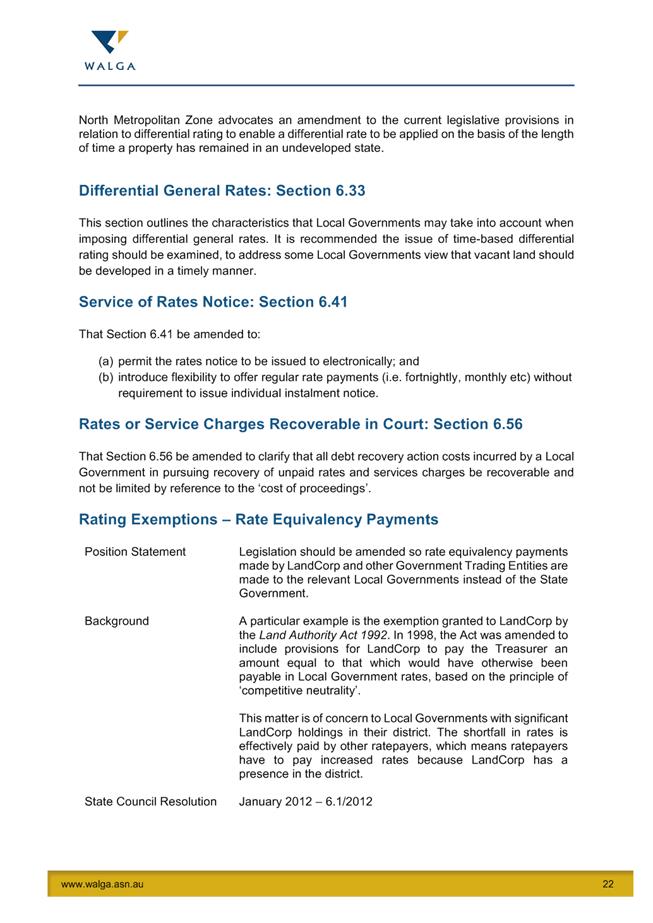
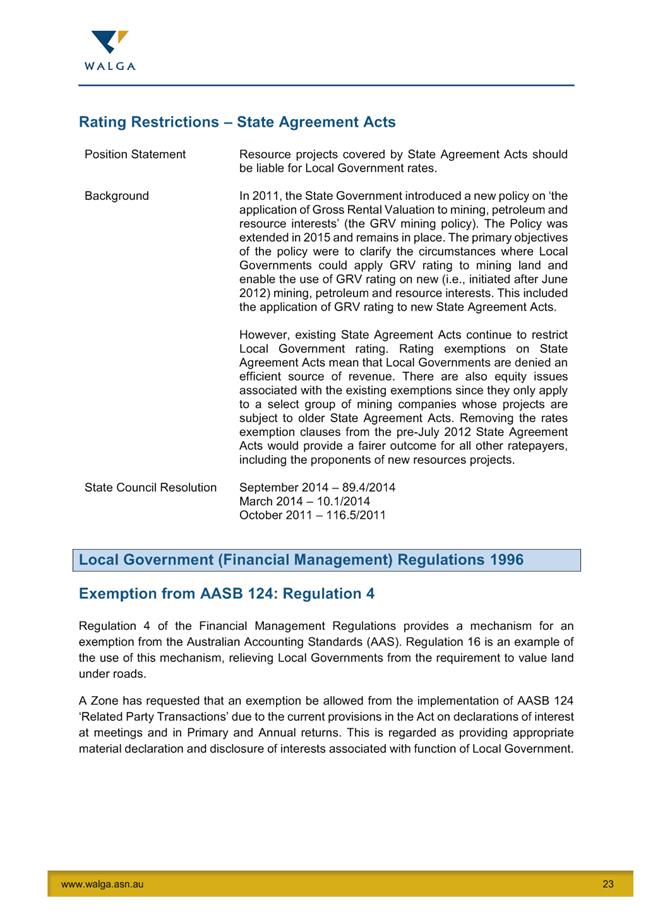




Minutes –
Ordinary Meeting of Council 22 February 2018 Page 853 of 1227
|
9.4.7 Public Libraries Strategy
Consultation 2017
LOCATION/ADDRESS: Nil
APPLICANT: Nil
FILE: CLIB1
AUTHOR: Library
Coordinator
CONTRIBUTOR/S: Nil
RESPONSIBLE
OFFICER: Director
Development and Community
DISCLOSURE
OF INTEREST: Nil
DATE OF REPORT: 10
January 2018
|
|
SUMMARY: The
WA Public Libraries Strategy (Strategy) has been released by the WA
State Government. The Strategy is the result of extensive research and consultation
through the Public Libraries Working Group and with stakeholders including
local government authorities. The priorities outlined in the Strategy are
intended as a consultation tool to establish a shared strategic vision for
public library development in Western Australia.
Feedback on the Strategy is being sought from community
members, library users and those that do not use public libraries, local
governments, public librarians and community groups.
The purpose of this report is to seek Council’s
endorsement of the Shire of Broome’s submission on the Strategy.
Submissions must be provided by 29 March 2018.
|
BACKGROUND
Public libraries are much-loved and used facilities. Across
Western Australia’s 231 public libraries, there are more than one million
active library members who borrowed more than 16 million physical items and
some 600,000 e-books and audio books in 2015-16.
The context for public libraries is
shifting with libraries operating as community spaces with strong links to
community, social cohesion and workforce development. Technological
developments continue to change the way people interact with information,
requiring public libraries to remain relevant at the forefront of technology,
enabling access as well as support for skill development in the community.
Public libraries also need to better communicate their connections with, value
and impact on the community.
The Shire is the Regional Library for
the Kimberley region. In accordance with the agreement with the State
Library of Western Australia (SLWA) formalising this arrangement, the
Shire receives an annual allotment of funding to support the delivery of
library services to the 3 other local government authorities - Shire of Wyndham
East Kimberley; Shire of Halls Creek and Shire of Derby West Kimberley. This
role is in addition to the delivery of library services to community residents
and visitors to Broome.
Previous Considerations
Nil
COMMENT
The Strategy identifies key areas
that can be addressed as priorities over the next 4 years to deliver an
improved and more sustainable library service. A copy of the Strategy is
included as Attachment 1 to this report. The Strategy proposes the
following 5 priority actions:
1. A
single access card and management system that would allow users to borrow an
item at any public library in WA
2. A
new model to support public library service delivery in WA
3. A
new model to support regional and remote library services to ensure equal
access to library services across the State
4. Improved
governance systems, including the development of new legislation to guide
public library services
5. A
system to measure and assess the impact and value of pubic library services on
individuals and communities
The Strategy is accompanied by a
Background Paper that contains supporting information and outlines the results
of extensive research undertaken to develop the Strategy. A copy of the
Background Paper is included as Attachment 2 to this report.
The Background Paper was developed to
promote thinking about public libraries, the strategic opportunities, policy
recommendations and potential reform directions. Following on from this, the
Strategy is a five-step action plan for transformational change to WA’s public
library system to deliver more efficient and flexible services that meet
WA’s growing and diverse community needs.
Given the importance of these
documents on the future of library services in Broome, it is recommended that
the Shire make the submission on the Strategy as shown in Attachment 3.
The key points from the proposed
submission are as follows:
1. For
the most part, the priority areas identified within the Strategy are
supported. The priority areas are likely to result in a responsive and efficient
library framework throughout the State.
2. As
the Regional Library for the Kimberley the proposed changes are likely to
affect the Shire’s delivery of support services throughout the region,
given that a complete reform of this current model is proposed.
3. The
Shire currently receives approximately $23,000 per annum from SLWA to deliver
services to the Broome community. The Strategy creates some uncertainty
regarding future allocation or criteria for further funding for core service
delivery.
Overall, the WA Public Libraries
Strategy Consultation is a timely and important opportunity for the Broome
Public Library and the Shire to contribute to and influence the State’s
future direction in relation to library services. It is therefore
recommended that Council endorse the submission in Attachment 3, and
request that the Chief Executive Officer forward this submission under cover
letter shown in Attachment 4 to the Director General of the Department
of Local Government, Sport and Cultural Industries.
CONSULTATION
The Shire made the survey on the Strategy available on the
Shire’s webpage and Facebook page for interested people to complete.
STATUTORY ENVIRONMENT
Nil.
POLICY IMPLICATIONS
Nil
FINANCIAL IMPLICATIONS
There are no identified financial
implications associated with Council making a submission on the Strategy.
RISK
|
Risk
|
Type
|
Rank
|
Mitigation
|
|
The Shire will be viewed as not
taking a leadership role by not making an independent submission to SLWA
|
Reputational
|
Medium
|
As the Regional Library for the
Kimberley it is recommended that Council makes a submission.
|
|
The Shire’s feedback makes
limited impact
|
Reputational
Financial
|
Low
|
Shire makes the submission.
|
|
The Shire’s submission is not
supported/ recognised by SLWA
|
Reputational
|
Low
|
Shire makes the submission.
|
STRATEGIC
IMPLICATIONS
Our People
Goal – Foster a community environment that is accessible, affordable,
inclusive, healthy and safe:
Affordable services and initiatives
to satisfy community need
Accessible and safe community spaces
Participation in recreational and
leisure activity
Our
Organisation Goal – Continually enhance the Shire’s organisational
capacity to service the needs of a growing community:
Effective community engagement
Improved systems, processes and
compliance
VOTING REQUIREMENTS
Simple Majority
|
COUNCIL RESOLUTION:
(Report Recommendation)
Moved: Cr M Fairborn Seconded:
Cr C Mitchell
That Council:
1. Endorses the
proposed submission as part of the WA Public Libraries Strategy Consultation
as shown in Attachment 3; and
2. Requests that the
Chief Executive Officer forward the submission in Attachment 3 and 4 to the
Director General of the Department of Local Government, Sport and Cultural
Industries.
CARRIED UNANIMOUSLY 8/0
|
Attachments
|
1.
|
WA Public Libraries
Strategy
|
|
2.
|
WA Libraries Background
Paper
|
|
3.
|
Shire of Broome
Submission
|
|
4.
|
Cover letter - Shire of
Broome Submission
|
|
Item 9.4.7 - Public Libraries Strategy Consultation 2017
|
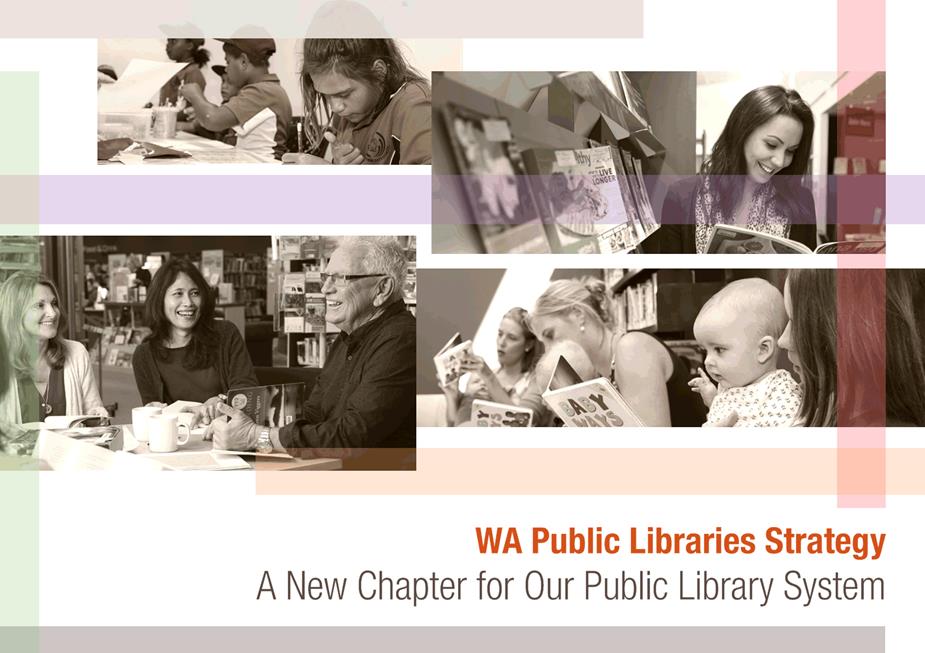

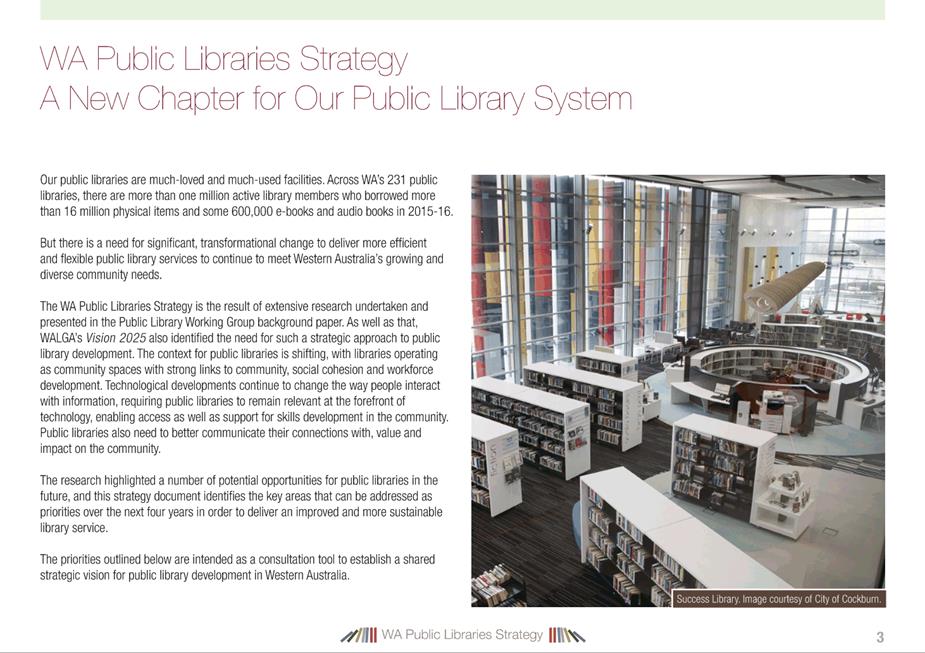


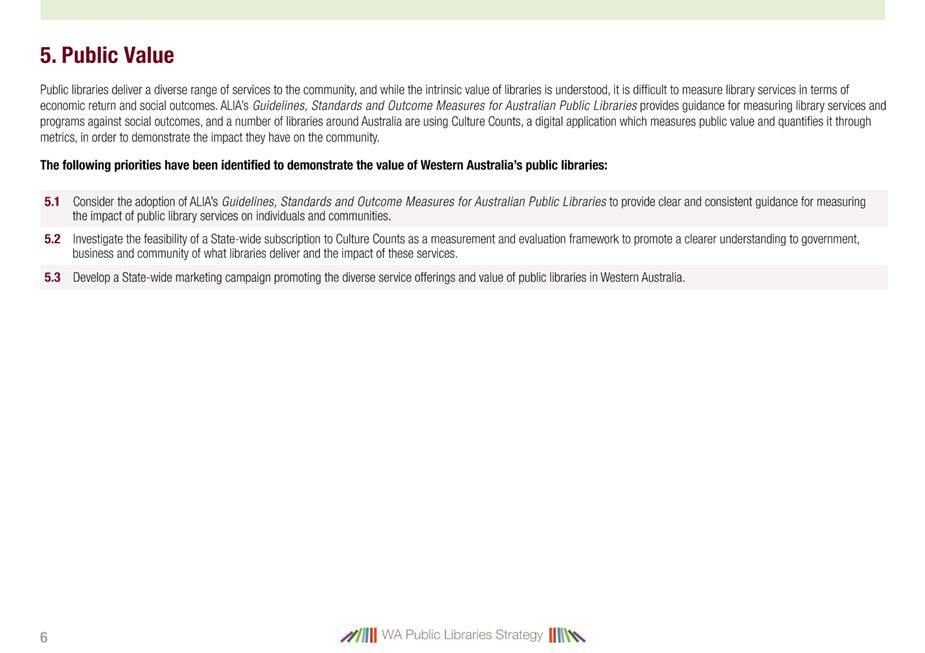
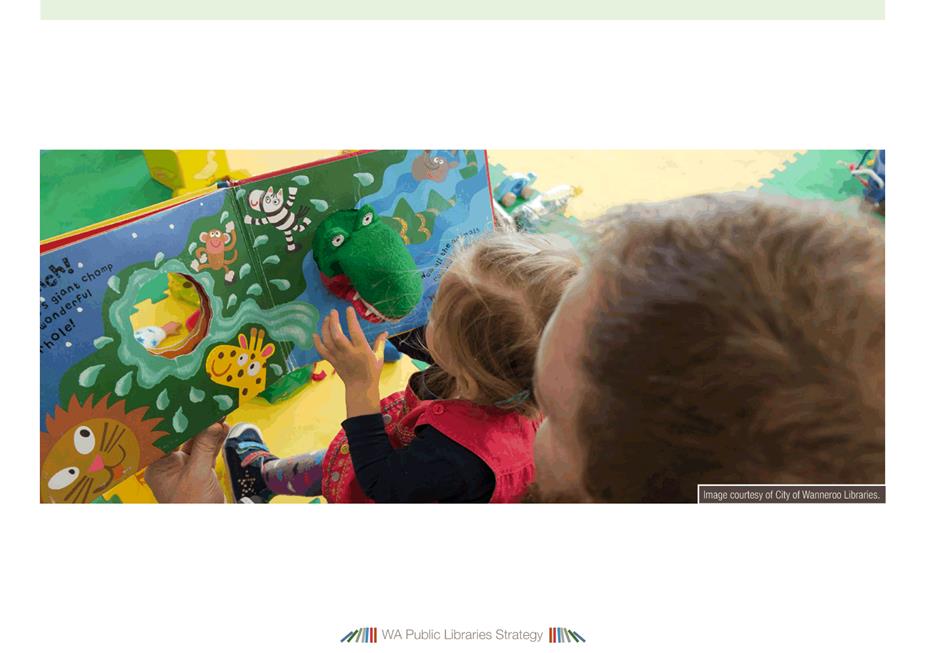
|
Item 9.4.7 - Public Libraries Strategy Consultation 2017
|
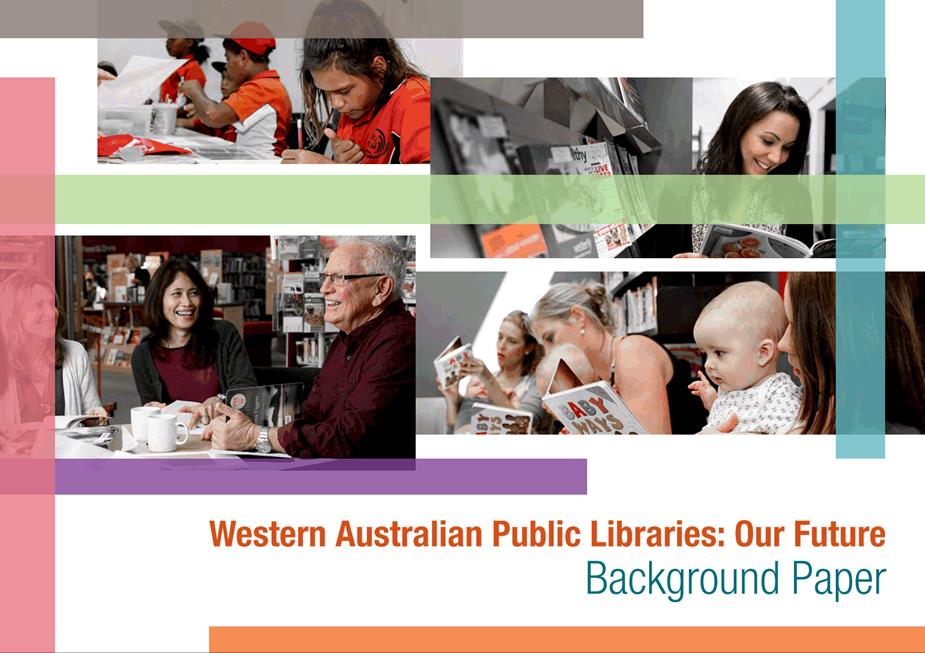
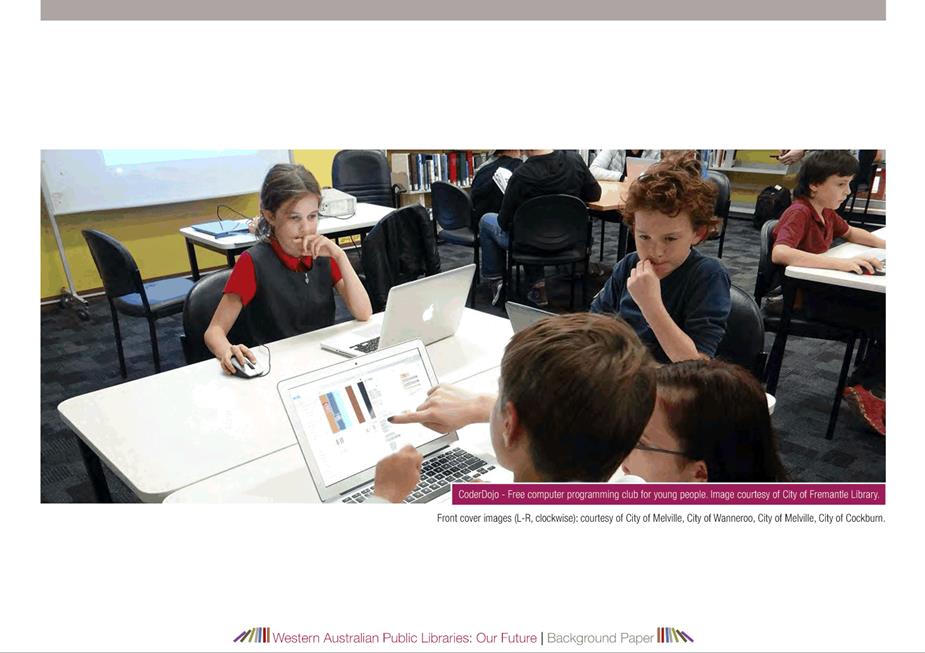






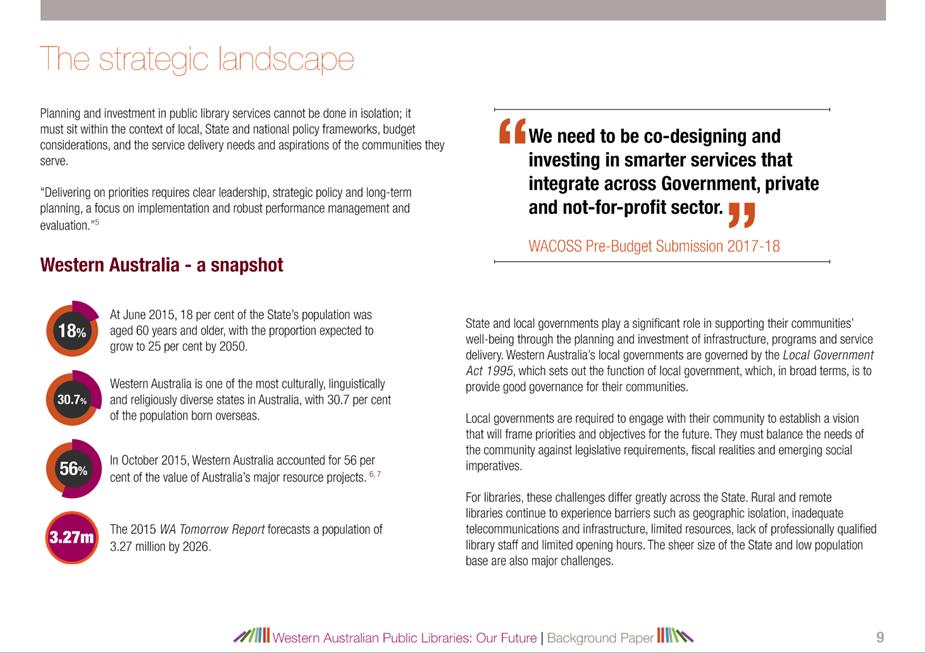
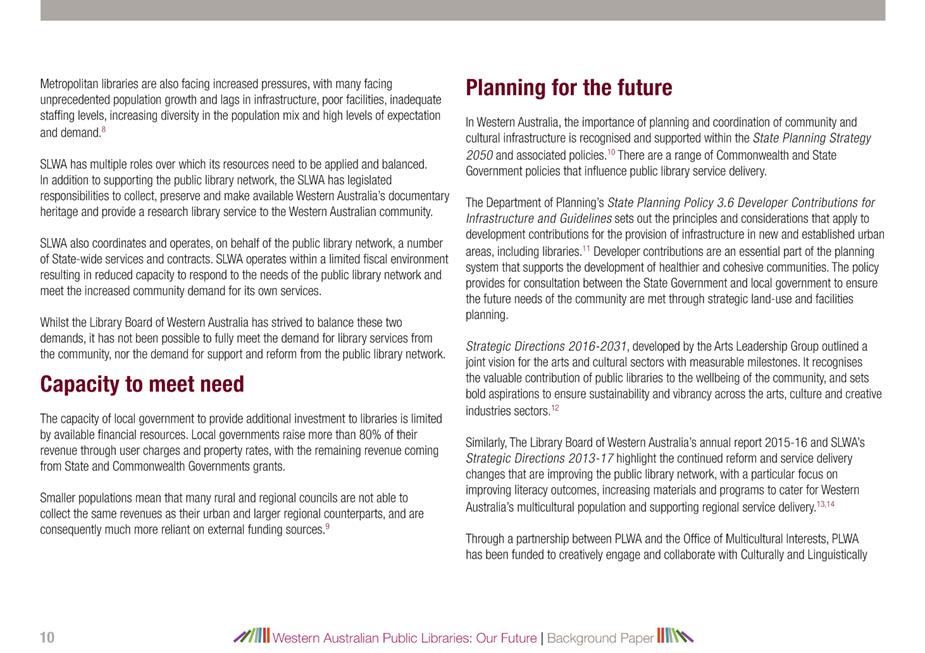
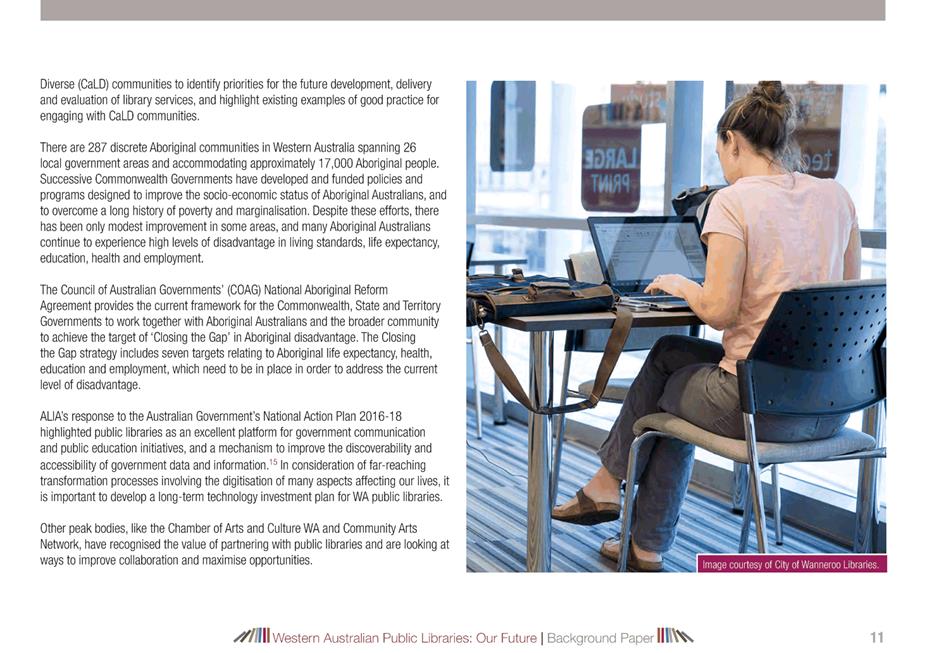






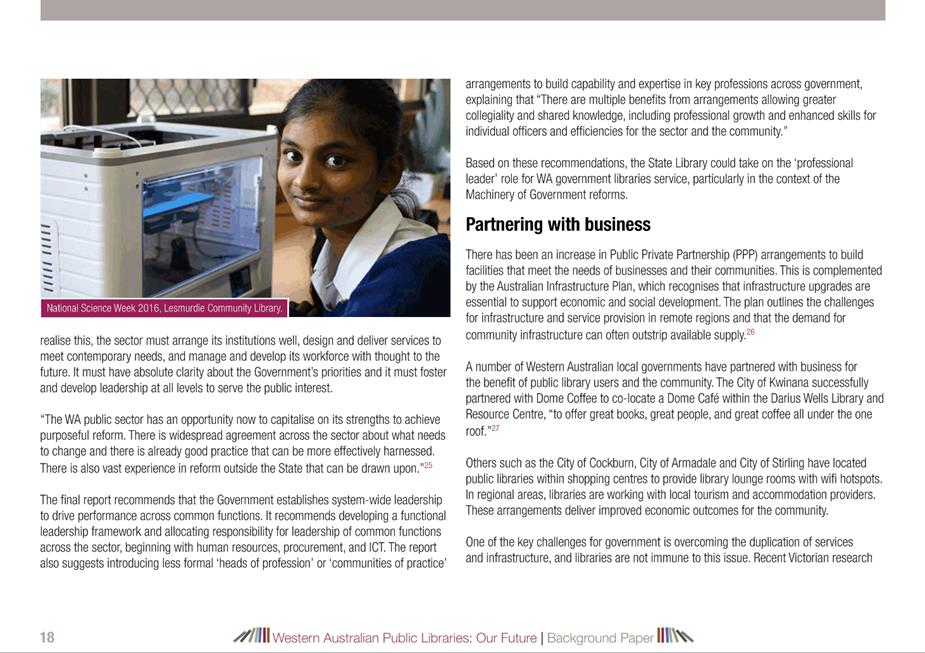








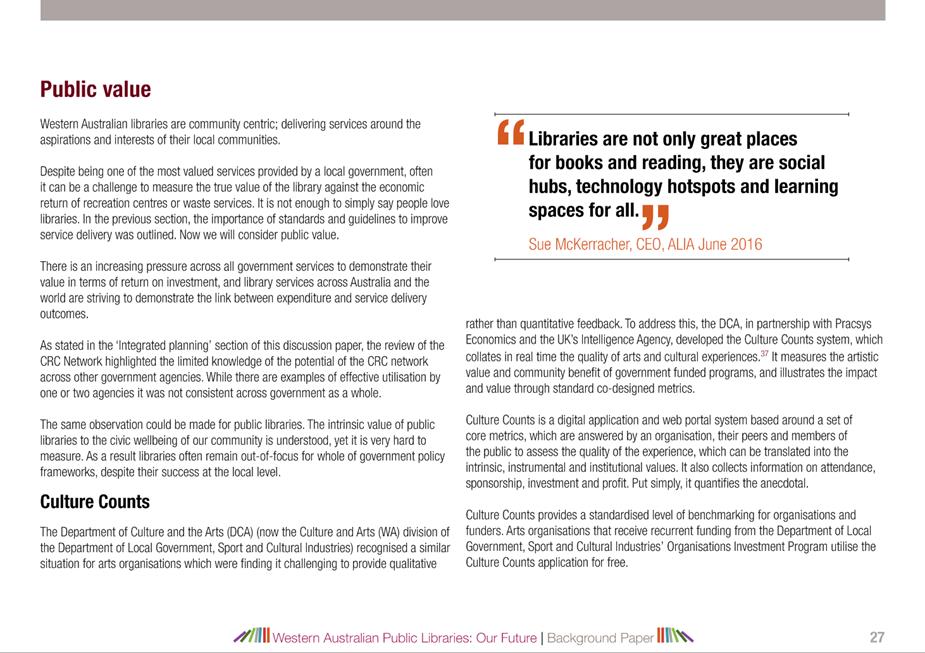
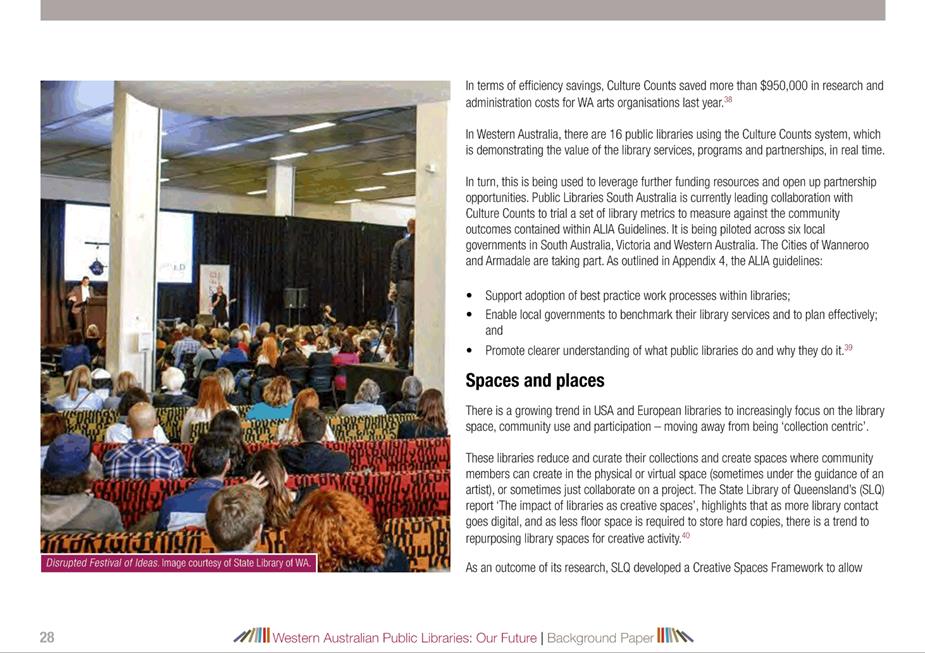



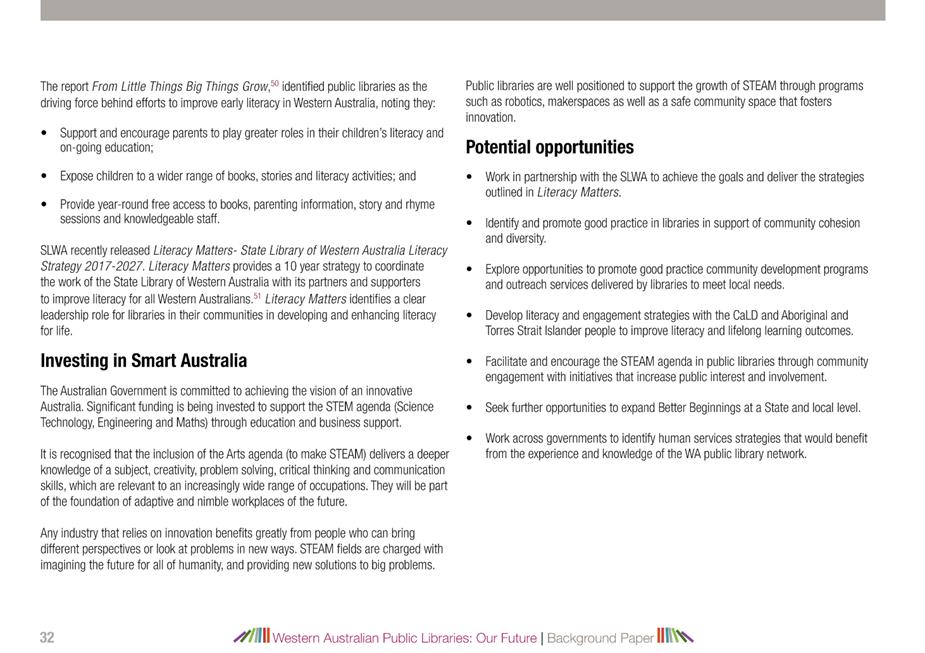



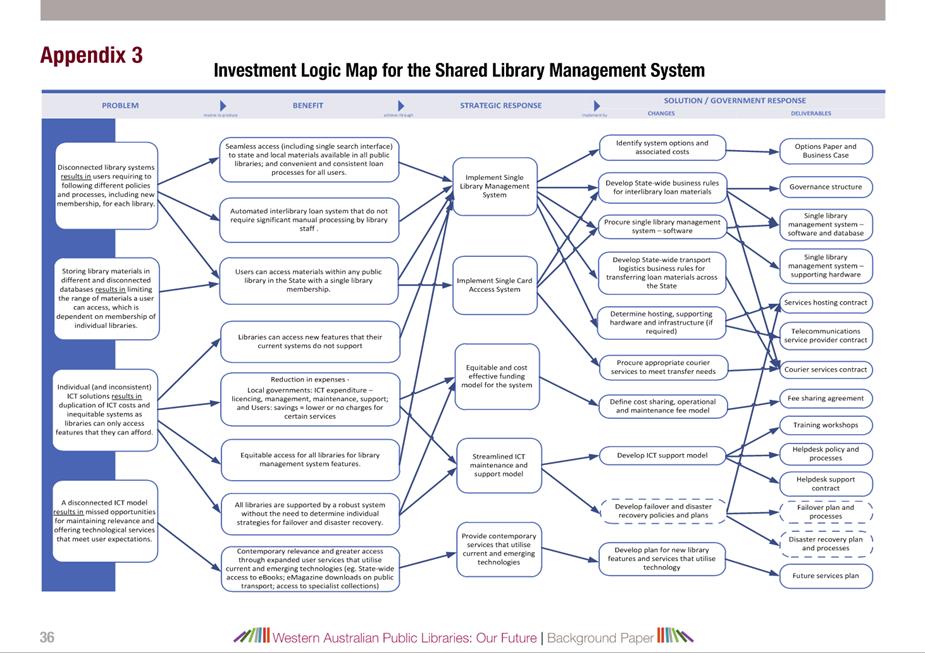
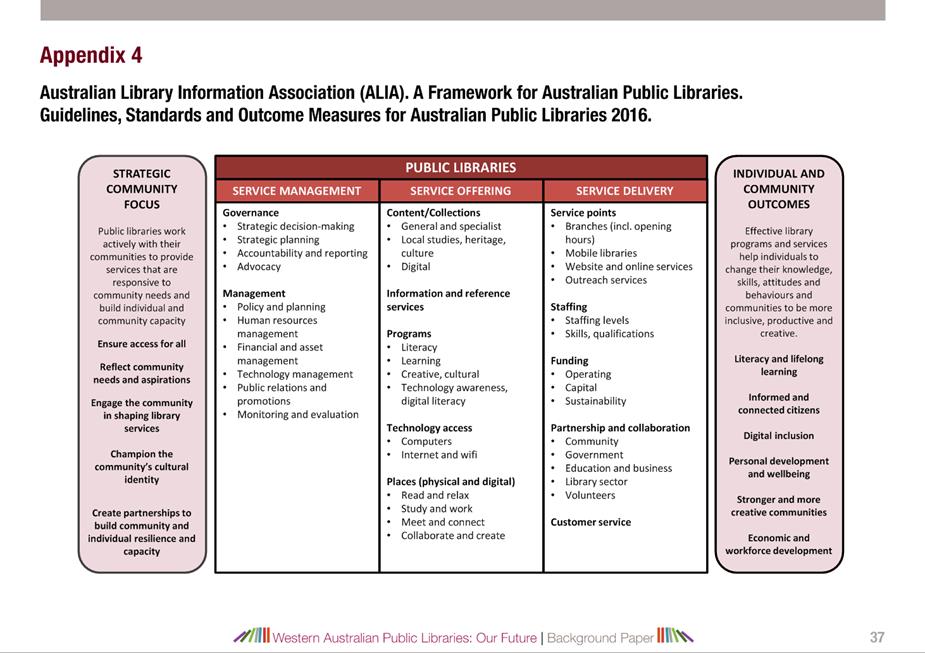





Public Libraries Strategy Consultation 2017 – Survey
Questions
Introduction
Our public libraries
are much-loved and much-used facilities. Across Western Australia’s 231
public libraries, there are more than one million active library members who
borrowed more than 16 million physical items and some 600,000 e-books and audio
books in 2015-16.
But there is a need for
significant, transformational change to deliver more efficient and flexible
public library services to continue to meet Western Australia’s growing
and diverse community needs.
The context for public
libraries is shifting, with libraries operating as community spaces with strong
links to community, social cohesion and workforce development.
Technological developments continue to change the way people interact with
information, requiring public libraries to remain relevant at the forefront of
technology, enabling access as well as support for skills development in the
community. Public libraries also need to better communicate their
connections with, value and impact on the community.
The WA Public Libraries
Strategy is the result of extensive research and consultation through the
Public Libraries Working Group and with stakeholders including local government
authorities. The priorities outlined in the Strategy are intended as a
consultation tool to establish a shared strategic vision for public library
development in Western Australia. The draft Strategy and background research
papers can be found at:
www.slwa.wa.gov.au/about-us/corporate/public-libraries-partnership
We are seeking feedback
on the Strategy from community members, library users and those that do not use
public libraries, local governments, public librarians and community
groups.
Should you have any
questions regarding this consultation process please contact: publiclibraryconsultation@slwa.wa.gov.au
1. Are you a:
 Local
Government Elected Member
Local
Government Elected Member
 Local
Government Officer
Local
Government Officer
 Public Library
Manager
Public Library
Manager
 Public Library
Staff Member
Public Library
Staff Member
 Community
Resource Centre Representative
Community
Resource Centre Representative
 Community
Member
Community
Member
 Other (please
specify)
Other (please
specify)
Regional
Librarian - Kimberley
General
Questions
The
WA Public Library Strategy outlines five priority actions to be addressed in
the next four years, including:
* A single access card and management system that would allow users to borrow
an item at any public library in WA
* A new model to support public library service delivery in WA
* A new model to support regional and remote library services to ensure equal
access to library services across the State
* Improved governance systems, including the development of new legislation to
guide public library services
* A system to measure and assess the impact and value of public library
services on individuals and communities.
2. What do you
most value about WA public libraries?
The Shire of
Broome highly values the provision of a free, inclusive library service which
is accessible for all members of the community and seeks to continue this
service. Continued funding is the key component for this service.
It is increasingly important as technology evolves, that the library responds
to community needs. The financial and other support offered by the State
Government is appreciated and the Shire keen to maintain a working relationship
without a loss of financial investment from the State.
3. How could WA
public libraries change to better meet current community needs?
The Shire notes
the 5 key priorities outlined within the Strategy and is in support. However
the Shire acknowledges that to implement reform will require a revised funding
model, which may or may not be in addition to the current budget. The Shire
would like to see further consultation with local governments regarding
alternate funding models to facilitate change and innovation while maintaining
current levels of service delivery.
4. What do you
think will be the challenges for WA public libraries and their services in the
future?
The Shire would
like to understand the proposed funding model which will drive reform and
transformation of public libraries throughout the State. The beginning of the
reform process may prove challenging should service levels be expected to
continue while funding is reallocated to transformational or innovative
initiatives.
The Shire also
suggests that equitable spread of funding for innovation trials will be a
challenge, and would call for adequate support and distribution to the regions.
___________________________________________________________
Governance
The
Library Board of Western Australia Act 1951 and the Library Board (Registered
Public Libraries) Regulations 1985 are dated and lack relevance to
contemporary public library services in Western Australia.
Do you agree with the following priorities to ensure good
governance?
5. Repeal the
Library Board (Registered Public Libraries) Regulations 1985 as they do not
reflect contemporary public library services.
 Agree
Agree
 Disagree
Disagree
Other (please
specify)
___________________________________________________________________
6. Establish a
Library Board sub committee for governance and strategic oversight of WA public
libraries, composed of local and State Government representatives.
 Agree
Agree
 Disagree
Disagree
Other (please
specify)
___________________________________________________________________
7. Adoption of
the Australian Library and Information Association's (ALIA) Guidelines,
Standards and Outcome Measures for Australian Public Libraries (2016) as an
aspirational framework for benchmarking and measuring public value.
 Agree
Agree
 Disagree
Disagree
Other (please
specify)
With the
proviso that there is consideration of smaller country libraries which due to
staffing and infrastructure would struggle to maintain the expected
service level outlined in the Guidelines, Standards and Outcomes
Measures for Australian Public Libraries.
___________________________________________________________________
8. Develop new
legislation that is reflective of contemporary public library services in WA.
 Agree
Agree
 Disagree
Disagree
Other (please
specify)
New Model to
support public library service in Western Australia
The
State Library of Western Australia leads the development of the public library
network, primarily through the provision of capital funds for the purchase of library
materials. Economies of scale are achieved by the consortia purchasing of print
and electronic materials for State-wide delivery for Western Australia’s
231 public libraries. However, the capital funding model for physical materials
was developed in the 1950s and does not reflect the evolution of public library
services and the expectation to meet the diverse information and recreational
needs of the community through a variety of resources, infrastructure and
programming.
Do you agree with the following priorities identified to implement a
sustainable and appropriate model for the support of public library services?
9. Implement a
multi-tiered support model determined by the ability to meet agreed criteria
for service provision and population size.
 Agree
Agree
 Disagree
Disagree
Other (please
specify)
__________________________________________________________________
10. Introduce a
system for the allocation of annual State Government funding. Funds are
not limited to the purchase of physical library stock; portions can be
allocated for technological infrastructure, implementation of innovative
programming, administration or other priorities.
 Agree
Agree
 Disagree
Disagree
Other (please
specify)
Those libraries
already heavily invested in physical stock may require more funds to be
invested in technology. For economies of scale programming should be
State wide rather than library centric. This approach would also acknowledge
differences in service provision and needs throughout regional Western
Australia.
11. Develop an
accountable and robust reporting framework for expenditure of allocated funds.
 Agree
Agree
 Disagree
Disagree
Other (please
specify)
This is already
achieved on a local level by adhering to weekly quota reports.
12. Investigate
ways in which to foster innovation and experimentation in public libraries
through the introduction of a competitive innovation grants system, using the
available annual State Government funding allocation.
 Agree
Agree
 Disagree
Disagree
Other (please
specify)
The Shire is
supportive of innovation and experimentation, but would like to understand more
regarding the innovation grant scheme using the available annual State
government funding allocation. If a percentage of the available funding is used
for innovation, the Shire is concerned that service levels across the State may
be negatively impacted if further funding is not sourced. This could lead
to added financial and community pressure on local governments to make up the
shortfall to maintain current levels of service.
Rather than introducing
a competitive grants process, the Shire would call for worthwhile initiatives
to be trialled across a number of interested libraries. This would allow for a
spread of results and data, and a more equitable spread of State funding.
New
model to support regional and remote public libraries.
Western
Australia has 161 regional and remote public libraries in eleven regions across
the State. Since 1977, the State Library has supported these libraries through
a model in which regional libraries receive additional funding to support
smaller libraries within their region. The need for reform of this model was
identified in 2011.
A new model for the support of regional and remote libraries needs to be
sustainable and efficient, providing adequate funding, training and support for
staff to ensure equal access to library services across the State.
Do you agree with the following priorities for a new model to support regional
and remote public libraries?
13. Develop a
new support model and an accountable reporting framework for regional and
remote public libraries, to ensure equity of service and consistency of support
across regions.
 Agree
Agree
 Disagree
Disagree
Other (please
specify)
Regional
support is currently not a “one size fits all” and changes do need
to be made to provide equity of service across the State.
14. Realign
public library regional boundaries with WA Regional Development boundaries to
foster better integrated planning at a local level and collaboration within
regions, and for administrative efficiency.
 Agree
Agree
 Disagree
Disagree
Other (please
specify)
__________________________________________________________________
15. Contribute
to a broader strategy to strengthen partnerships and collaboration between
libraries, local government and the Western Australian Community Resource
Network, business and not-for-profit organisations in the regions to enable a
better coordinated approach to service delivery, responding to local needs.
 Agree
Agree
 Disagree
Disagree
Other (please
specify)
__________________________________________________________________
Single access
card system
There
are a number of Library Management Systems currently in use across the State by
different local governments, with little interoperability. A consolidated
system would benefit all Western Australian library members and enable better
collaboration between libraries. Research into a single card access system and
shared Library Management System (LMS) demonstrates that centralisation would
enable a more efficient loans system, improving accessibility across the State.
Do you agree with the following priorities to ensure best value service
delivery?
16. Investigate
further options for a single access card system which provides access to all
232 WA public libraries and the ability to locate and borrow an item from any
public library through that card?
 Agree
Agree
 Disagree
Disagree
Other (please
specify)
__________________________________________________________________
Public
Value
Public
libraries deliver a diverse range of services to the community, and while the
intrinsic value of libraries is understood, it is difficult to measure library
services in terms of economic return and social outcomes. ALIA’s
Guidelines, Standards and Outcome Measures for Australian Public Libraries
provides guidance for measuring library services and programs against social
outcomes, and a number of libraries around Australia are using Culture Counts,
a digital application which measures public value and quantifies it through
metrics, in order to demonstrate the impact they have on the community.
Do you agree with the following priorities that have been identified to demonstrate
the value of Western Australia’s public libraries?
17. Consider
the adoption of ALIA’s Guidelines, Standards and Outcome Measures for
Australian Public Libraries to provide clear and consistent guidance for
measuring the impact of public library services on individuals and communities.
 Agree
Agree
 Disagree
Disagree
Other (please
specify)
Same as
question 7
__________________________________________________________________
18. Investigate
the feasibility of a State-wide subscription to Culture Counts as a measurement
and evaluation framework to promote a clearer understanding to government,
business and community of what libraries deliver and the impact of these
services.
 Agree
Agree
 Disagree
Disagree
Other (please
specify)
The Shire
supports a State wide measurement and evaluation framework, but would promote
the use of a customised tool which is developed for library services. Allowing
all libraries to share and access data would encourage collaboration and
sharing of best practice service delivery for the benefit of all.
19. Develop a
State-wide marketing campaign promoting the diverse service offerings and value
of public libraries in Western Australia.
 Agree
Agree
 Disagree
Disagree
Other (please
specify)
We need to reach other
sections of the community who do not, for a variety of reasons, currently use
our services.
_______________________________________________________________
hank you for
your feedback which will be used to further inform the Strategy.
To assist with understanding the feedback, we would like to learn more about
you:
20. Do you live
in:
 1. Metropolitan
Perth
1. Metropolitan
Perth
 2. Outer
metropolitan Perth
2. Outer
metropolitan Perth
 3. Regional or
remote Western Australia
3. Regional or
remote Western Australia
 Other (please
specify)
Other (please
specify)
___________________________________________________________________
21. Are you a
regular public library user?
 Yes
Yes
 No
No
22. If so,
which libraries?
Broome Public
Library___________________________________
23. If you are
not a regular public library user, would you please tell us why?
___________________________________________________________________
24. Are there
any other comments you would like to make?
__________________________________________________________________
End
Survey
Thank
you for your feedback, we appreciate your thoughts and comments. A
summary of the feedback will be available in the early part of 2018.
Our
ref: SE:DO File CLIB1
22 February 2018
Mr Duncan Ord OAM
Chair, Public Library Working Group
Director General
Department of Local Government, Sport
and Cultural Industries
140 William St, 2nd floor
Reception
Perth WA 6000
Dear Mr Ord
Shire of Broome submission -WA Public
Libraries Strategy Consultation 2017
Thank
you for the opportunity for the Shire of Broome to provide feedback on the
Public Libraries Strategy Consultation 2017. The enclosed submission is
provided by the Broome Public Library representing the Shire of Broome.
As
the Regional Librarian for the Kimberley, the Shire welcomes the introduction
of a new model to assist in supporting remote, regional library services.
The
Shire welcomes this reform initiative and looks forward to continuing dialogue
regarding the reforms. The Shire is largely supportive of the priority areas
and values the continuation of funding and support to deliver library services
across the region.
For
further queries please contact Sally Eaton at sally.eaton@broome.wa.gov.au
Yours faithfully
Aletta Nugent
Director Development and Community
Minutes – Ordinary
Meeting of Council 22 February 2018 Page 912 of 1227
9.4.8 WESTERN
AUSTRALIA NATIONAL DISASTER RELIEF RECOVERY ARRANGEMENTS - CONTRACTS
RFQ17-103 to 17-108 AND RFQ17-110
This item
is located in these Minutes under Section 14, Matters To Be Discussed Behind
Closed Doors.
10.
Reports
Of
Committees
Minutes –
Ordinary Meeting of Council 22 February 2018 Page 918 of 1227
|
10.1 LOCAL EMERGENCY
MANAGEMENT COMMITTEE MEETING MINUTES - 13 DECEMBER 2017
LOCATION/ADDRESS: Nil
APPLICANT: Nil
FILE: EMS02
AUTHOR: Executive
Support Officer
CONTRIBUTOR/S: Nil
RESPONSIBLE
OFFICER: Director
Development and Community
DISCLOSURE
OF INTEREST: Nil
DATE OF REPORT: 3
January 2018
|
|
SUMMARY: This
report presents the minutes and associated recommendations of the Local
Emergency Management Committee meeting held on 13 December 2017 for
Council’s consideration.
|
BACKGROUND
Previous
Considerations
Nil.
The Local Emergency Management
Committee (LEMC) is established by Council under section 38 of the Emergency
Management Act 2005 (Act). In accordance with section 39 of
the Act, the functions of the LEMC are:
(a) to
advise and assist the local government in assuring that local emergency
management arrangements are established for its district;
(b) to
liaise with public authorities and other persons in the development, review and
testing of local emergency management arrangements; and
(c) to
carry out other emergency management activities as directed by the State
Emergency Management Committee, or prescribed by the Emergency Management
Regulations 2006.
COMMENT
The minutes of the LEMC meeting held
on 13 December 2017 are included as Attachments 1 and 2 of this
report.
At the meeting, the LEMC discussed
the following:
Item 5.1 Local
Emergency Management Committee Contact List
The current contact list was reviewed
with members to provide updates as applicable.
Item 5.2 Status
Report
The status of actions from previous
LEMC meetings were circulated and discussed.
Item 5.3 Resource
Register
The Resource Register was circulated,
and members were requested to provide any updates to the Committee Secretariat
where applicable.
Item 5.4 Incident
Report
The 2017 Incident Report was
circulated, and members were requested to provide any updates to the Committee
Secretariat as needed.
Item 5.5 Training
Schedule
The 2017 Training Schedule was
circulated, and members were requested to provide any updates to the Committee
Secretariat where applicable.
Item 5.6 Vegetation
Update by Horizon Power
Jodie Lynch from Horizon Power
discussed the Horizon Power flyer, “Why Trees Should be Trimmed”
and displayed associated photos.
Item 5.7 Department
of Communities – Disaster & Emergency Support Services
Megan Spence from Department of
Communities discussed the holding of the Kimberley Integrated Information
Session 2017.
Item 5.8 Updates
from Committee members
A round table discussion was
conducted allowing Committee members to give an update on their agencies, and
any relevant matters.
CONSULTATION
As outlined in the minutes attached.
STATUTORY ENVIRONMENT
Emergency Management Act
2005
Section 36 Functions of local
government
It is a function of a local
government —
(a) subject
to this Act, to ensure that effective local emergency management arrangements
are prepared and maintained for its district;
(b) to
manage recovery following an emergency affecting the community in its district;
and
(c)
to perform other functions given to the local government under this Act.
38 Local
emergency management committees
(1) A local government is to establish one
or more local emergency management committees for the local government’s
district.
(2) If more than one local emergency
management committee is established, the local government is to specify the
area in respect of which the committee is to exercise its functions.
(3) A local emergency management committee
consists of —
(a) a chairman and other members appointed by the
relevant local government in accordance with subsection (4); and
(b) if the local emergency coordinator is not
appointed as chairman of the committee, the local emergency coordinator for the
local government district.
(4) Subject to this section, the
constitution and procedures of a local emergency management committee, and the
terms and conditions of appointment of members, are to be determined by the
SEMC.
39
Functions of local emergency management committees
The
functions of a local emergency management committee are, in relation to its
district or the area for which it is established —
(a) to advise and assist the local government in
ensuring that local emergency management arrangements are established for its
district;
(b) to liaise with public authorities and other
persons in the development, review and testing of local emergency management
arrangements; and
(c) to carry out other emergency management
activities as directed by the SEMC or prescribed by the regulations.
Section 41 Emergency management
arrangements in local government district
(1) A
local government is to ensure that arrangements (local emergency management
arrangements) for emergency management in the local government’s district
are prepared.
(2) The
local emergency management arrangements are to set out —
(a) the
local government’s policies for emergency management;
(b)
the roles and responsibilities of public authorities and other persons involved
in emergency management in the local government district;
(c)
provisions about the coordination of emergency operations and activities
relating to emergency management performed by the persons mentioned in
paragraph (b);
(d) a
description of emergencies that are likely to occur in the local government
district;
(e)
strategies and priorities for emergency management in the local government
district;
(f) other
matters about emergency management in the local government district prescribed
by the regulations; and
(g) other
matters about emergency management in the local government district the local
government considers appropriate.
(3) Local
emergency management arrangements are to be consistent with the State emergency
management policies and State emergency management plans.
(4) Local
emergency management arrangements are to include a recovery plan and the
nomination of a local recovery coordinator.
(5) A
local government is to deliver a copy of its local emergency management
arrangements, and any amendment to the arrangements, to the SEMC as soon as is
practicable after they are prepared.
Section 42 Reviewing and renewing
local emergency management arrangements
(1)
local government is to ensure that its local emergency management arrangements
are reviewed in accordance with the procedures established by the SEMC.
(2) Local
emergency management arrangements may be amended or replaced whenever the local
government considers it appropriate.
Section 43 Local emergency
management arrangements to be available for inspection
(1) A
local government is to keep a copy of its local emergency management
arrangements at the offices of the local government.
(2) The
arrangements are to be available for inspection, free of charge, by members of
the public during office hours.
(3) The
arrangements may be made available in written or electronic form.
POLICY IMPLICATIONS
Nil.
FINANCIAL IMPLICATIONS
Nil.
RISK
Nil.
STRATEGIC
IMPLICATIONS
Our People
Goal – Foster a community environment that is accessible, affordable,
inclusive, healthy and safe:
Effective communication
Affordable services and initiatives
to satisfy community need
A healthy
and safe environment
Our Organisation
Goal – Continually enhance the Shire’s organisational capacity to
service the needs of a growing community:
Sustainable and integrated strategic
and operational plans
Responsible resource allocation
Effective community engagement
VOTING REQUIREMENTS
Simple Majority
|
COUNCIL Resolution:
(Report Recommendation)
Moved: Cr C Mitchell Seconded:
Cr D Male
That Council receives the minutes of the Local
Emergency Management Committee held on 13 December 2017.
CARRIED UNANIMOUSLY 8/0
|
Attachments
|
1.
|
Unconfirmed Minutes of
the Local Emergency Management Committee held on the 13 September 2017
|
|
2.
|
Associated Attachments
|
|
3.
|
LEMC Contact List
(Confidential to Councillors and Directors Only)
This attachment is confidential in accordance with
Section 5.23(2) of the Local Government Act 1995 section 5.23(2)(h) as it
contains “such other matters as may be prescribed”.
|
|
Item 10.1 - LOCAL EMERGENCY MANAGEMENT COMMITTEE MEETING
MINUTES - 13 DECEMBER 2017
|
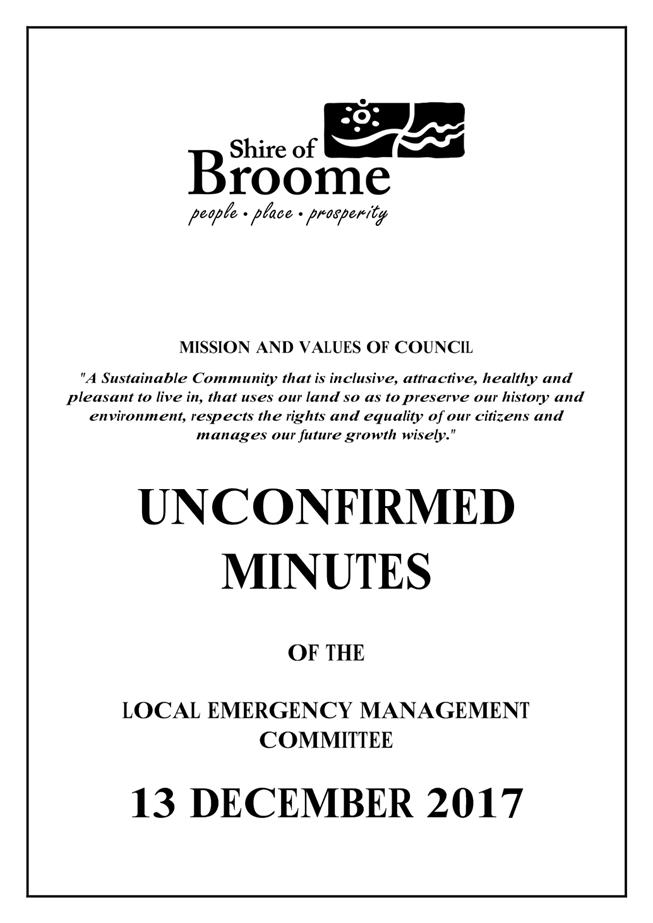



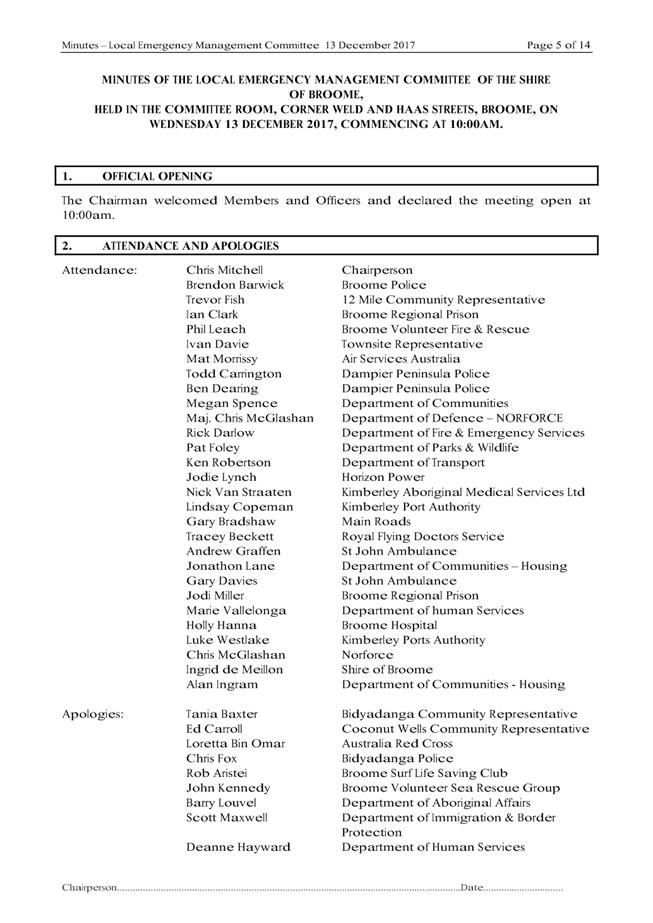




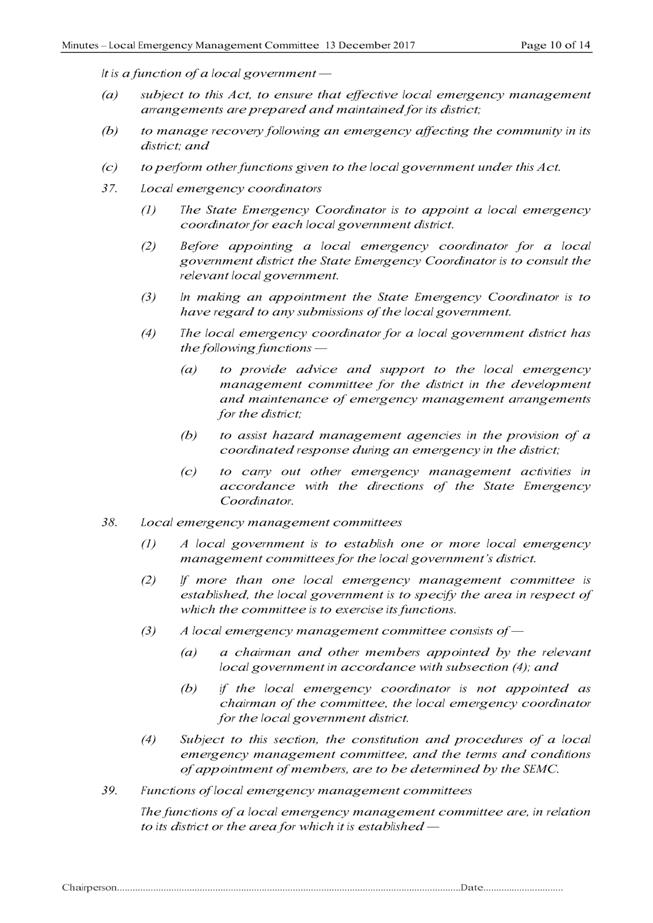




|
Item 10.1 - LOCAL
EMERGENCY MANAGEMENT COMMITTEE MEETING MINUTES - 13 DECEMBER 2017
|
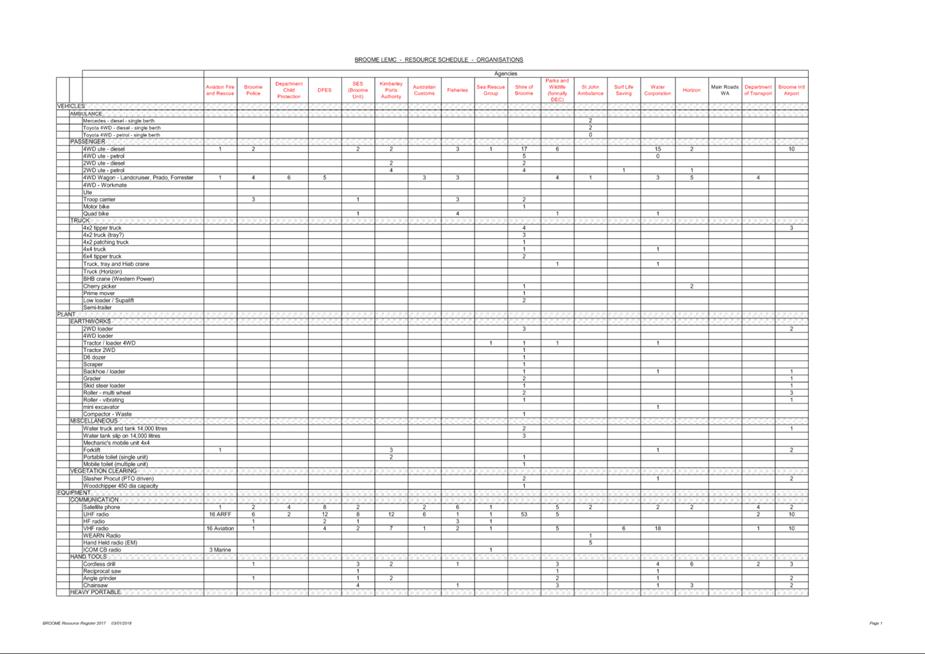


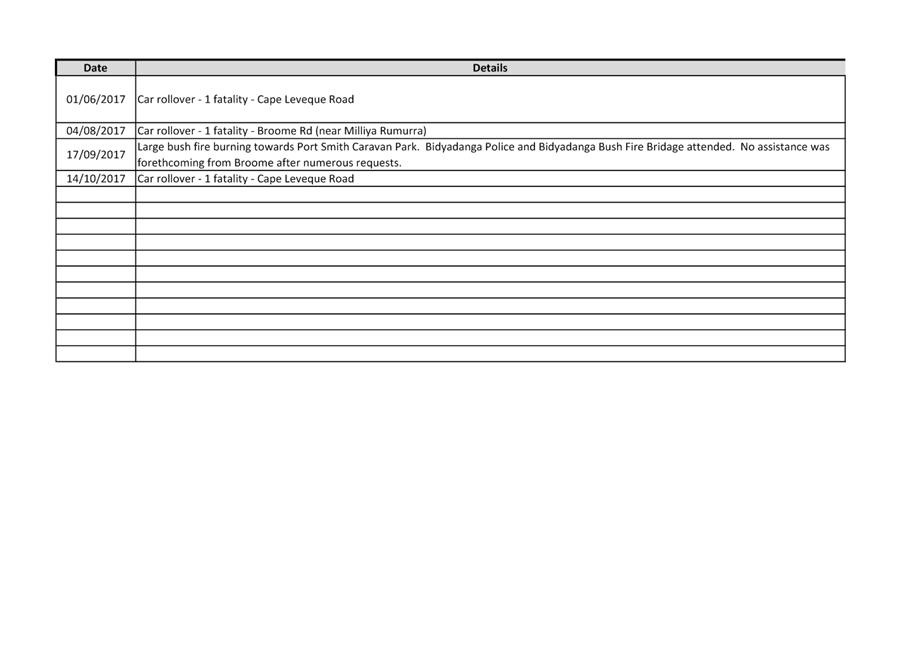
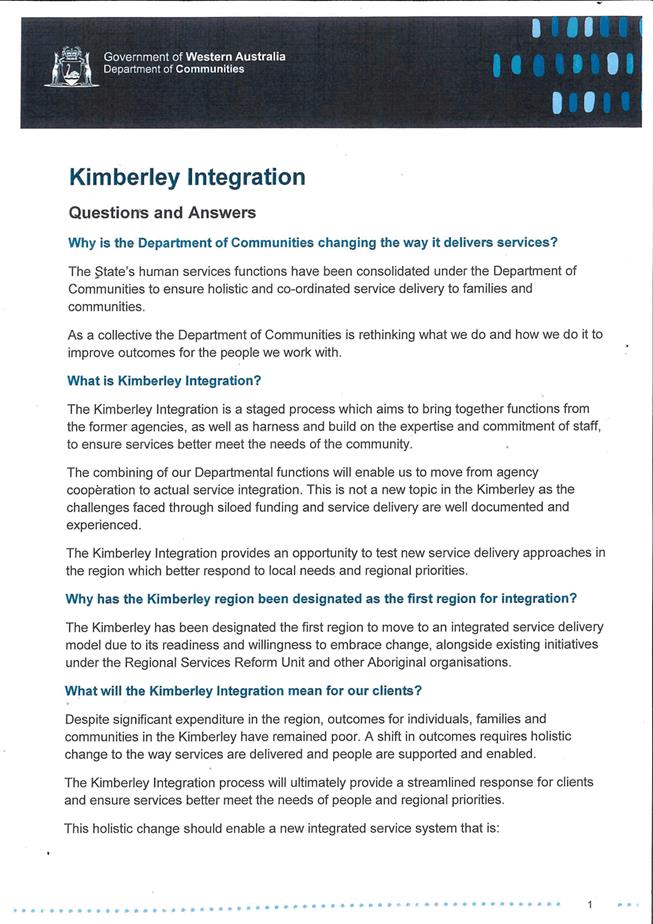

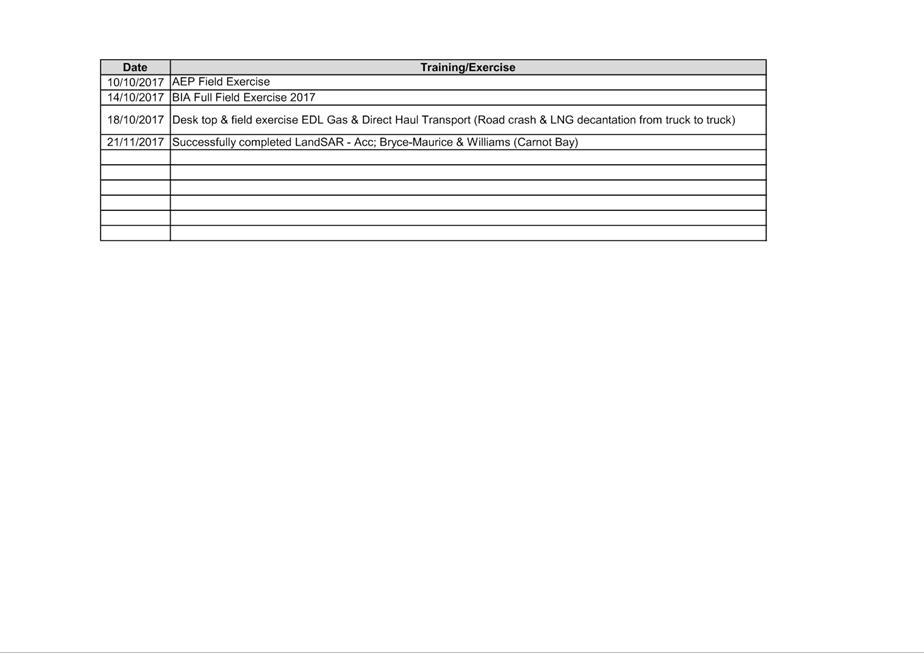



Minutes –
Ordinary Meeting of Council 22 February 2018 Page 951 of 1227
|
10.2 BUSH FIRE ADVISORY
COMMITTEE MEETING MINUTES - 13 DECEMBER 2017
LOCATION/ADDRESS: Nil
APPLICANT: Nil
FILE: EMM06
AUTHOR: Executive
Support Officer
CONTRIBUTOR/S: Nil
RESPONSIBLE
OFFICER: Director
Development and Community
DISCLOSURE
OF INTEREST: Nil
DATE OF REPORT: 10
January 2018
|
|
SUMMARY: This
report presents the minutes and associated recommendations of the Bush Fire
Advisory Committee meeting held on 13 December 2017 for Council’s
consideration.
|
BACKGROUND
Previous
Considerations
Nil.
The Bush Fire Advisory Committee (BFAC)
meets quarterly to provide advice to the Shire of Broome on:
1. All
matters relating to the prevention, controlling and extinguishing of bushfires.
2. The
planning and layout of fire breaks in the district.
3. Prosecutions
for breaches of the Bush Fires Act 1956.
4. The
formation of Bush Fire Brigades.
5. Coordination
and cooperation between agencies within the district.
COMMENT
The minutes of the BFAC meeting held
on 13 December 2017 are included as Attachments 1 and 2 of this
report.
At the meeting, the BFAC discussed
the following items:
Item 5.1 Bush
Fire Advisory Committee Contact List
The current contact list was reviewed
with members to provide updates as applicable.
Item 5.2 Status
Report
The status of actions from previous
BFAC meetings were circulated and discussed.
Item 5.3 Notification
of surrounding property owners before prescribed burn
The matter was discussed, and it was
determined that whoever has the permit to burn is responsible for notifying
neighbours.
Item 5.4 Bush
Fire at Port Smith
The incident was discussed with
advice offered by both DFES and Shire staff.
Item 5.5 Presentation
on the Bush Fire Mitigation Program for 2017
Mark O’Connor, Shire of Broome
Ranger Coordinator presented a PowerPoint Presentation with is a confidential
attachment to the minutes.
Item 5. Updates
from Committee members
A round table discussion was
conducted allowing Committee members to give an update on their agencies, and
any relevant matters.
CONSULTATION
As outlined in the Minutes attached.
STATUTORY ENVIRONMENT
Bush Fires Act 1956
Section 67 – Advisory
committees
1. A
Local Government may at any time appoint such persons as it thinks fit as a
Bush Fire Advisory Committee for the purpose of advising the Local Government
regarding all matters relating to the prevention, controlling and extinguishing
of bush fires, the planning of the layout of firebreaks in the district,
prosecutions for breaches of this Act, the formation of bush fire brigades and
the grouping thereof under group brigade officers, the ensuring of co-operation
and co-ordination of bush fire brigades in their efforts and activities, and
any other matter relating to bush fire control whether of the same kind, as, or
a different kind from, those specified in this subsection.
2. A
committee appointed under this section shall include a member of the Council of
the Local Government nominated by it for that purpose as a member of the
committee, and the committee shall elect one of their number to be Chairman
thereof.
3. In
respect to a committee so appointed, the Local Government shall fix the quorum
for the transaction of business at meetings of the committee and may:-
(a) make
rules for the guidance of the committee;
(b) accept
the resignation in writing of, or remove, any member of the committee, appoint
a person to fill that vacancy.
(c) where
for any reason a vacancy occurs in the office of a member of the committee,
appoint a person to fill that vacancy.
4. A
committee appointed under this section:-
(a) may
from time to time meet and adjourn as the committee thinks fit;
(b) shall
not transact business at a meeting unless the quorum fixed by the Local
Government is present;
(c) is
answerable to the Local Government and shall, as and when required by the Local
Government, report fully on its activities.
POLICY IMPLICATIONS
Nil.
FINANCIAL IMPLICATIONS
Nil.
RISK
Nil.
STRATEGIC
IMPLICATIONS
Our People
Goal – Foster a community environment that is accessible, affordable,
inclusive, healthy and safe:
Effective communication
Accessible and safe community spaces
A healthy
and safe environment
Our
Organisation Goal – Continually enhance the Shire’s organisational
capacity to service the needs of a growing community:
Sustainable and integrated strategic
and operational plans
Responsible resource allocation
Effective community engagement
Improved systems, processes and
compliance
VOTING REQUIREMENTS
Simple Majority
|
COUNCIL Resolution:
(Report Recommendation)
Moved: Cr C Mitchell Seconded:
Cr H Tracey
That Council receives the minutes of the Bush Fire
Advisory Committee meeting held on 13 December 2017.
CARRIED UNANIMOUSLY 8/0
|
Attachments
|
1.
|
Unconfirmed Minutes of
the Bush Fire Advisory Committee Meeting - 13 December 2017
|
|
2.
|
Associated Attachments
(Confidential to Councillors and Directors Only)
This attachment is confidential in accordance with
Section 5.23(2) of the Local Government Act 1995 section 5.23(2)(h) as it
contains “such other matters as may be prescribed”.
|
|
Item 10.2 - BUSH FIRE ADVISORY COMMITTEE MEETING MINUTES
- 13 DECEMBER 2017
|


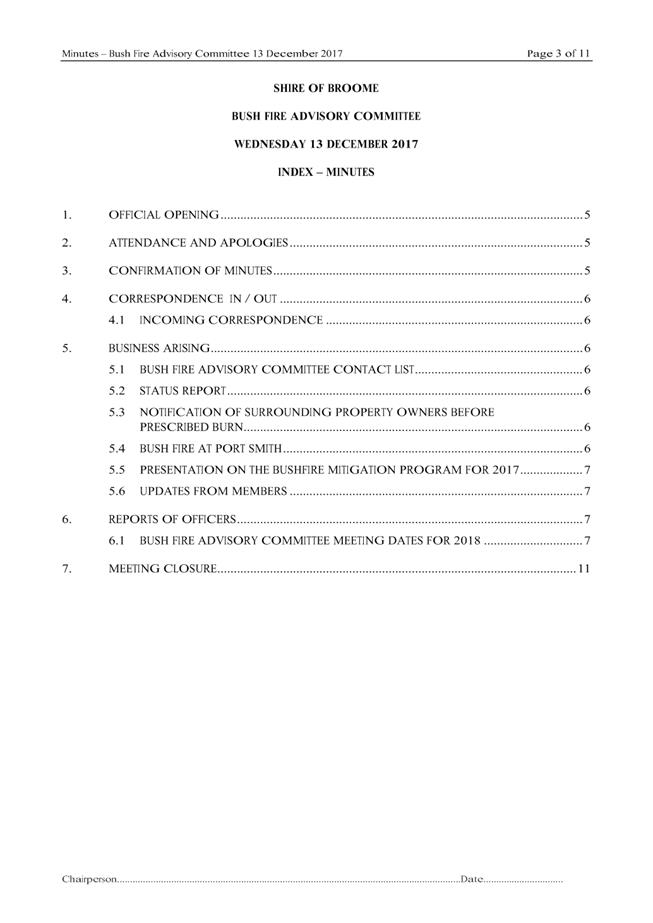



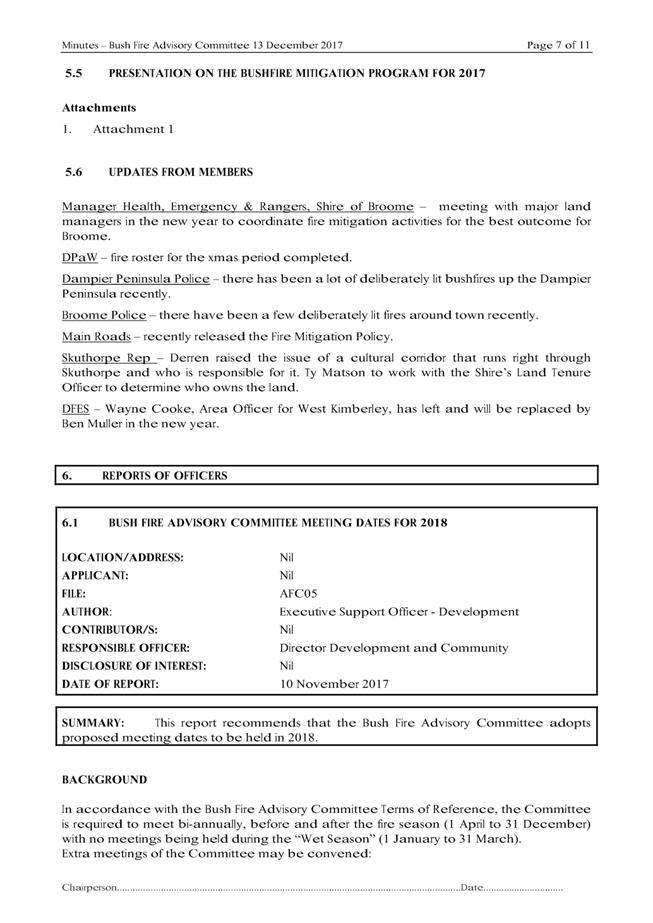
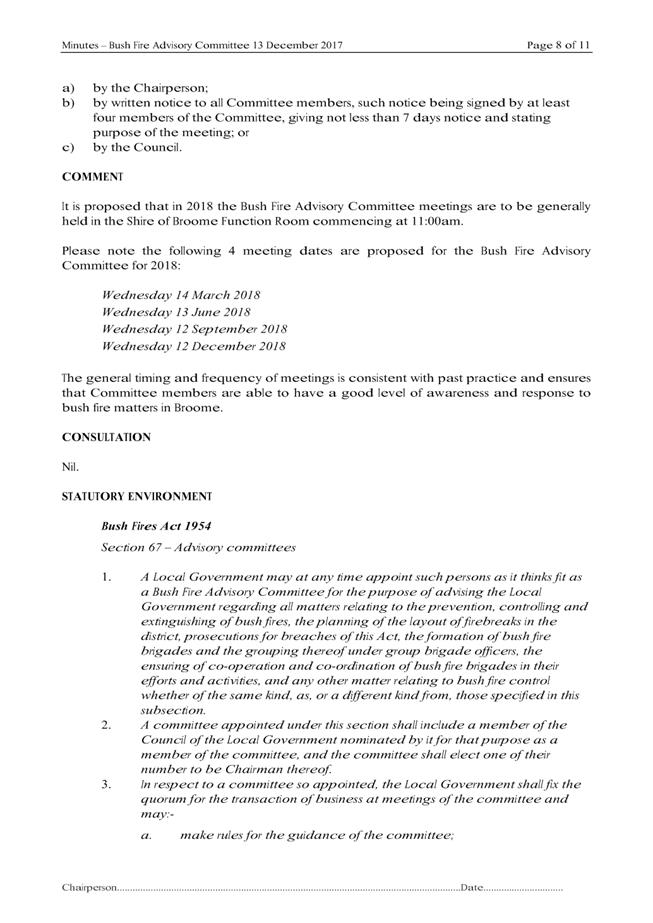

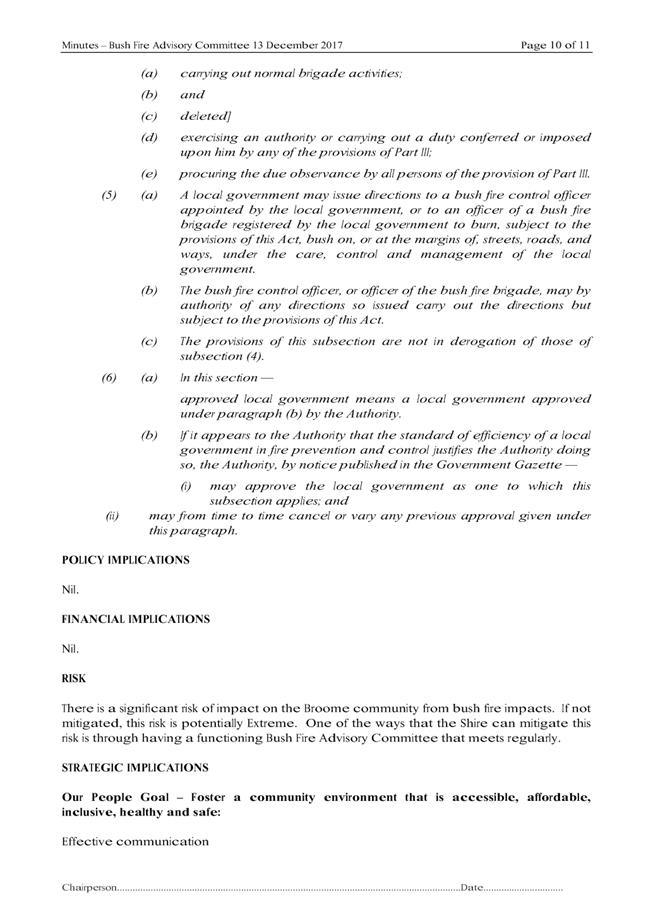

Minutes –
Ordinary Meeting of Council 22 February 2018 Page 974 of 1227
|
10.3 Yawuru Park Council
minutes and recommendations of meetings held on 17 October, 15 November and
20 December 2017.
LOCATION/ADDRESS: Nil
APPLICANT: Nil
FILE: NAt55.1,
NAT55.3
AUTHOR: Land
Tenure Officer
CONTRIBUTOR/S: Nil
RESPONSIBLE
OFFICER: Director
Development and Community
DISCLOSURE
OF INTEREST: Nil
DATE OF REPORT: 12
January 2018
|
|
SUMMARY: This
report presents Council with a progress report for the Yawuru Park Council (YPC),
comprising the draft Minutes and associated recommendations of the YPC
meeting held on 17 October, 15 November and 20 December 2017.
|
BACKGROUND
Previous
Considerations
OMC 15 March 2012 Item
9.2.5
SMC 29 May 2013 Item
9.2.1
OMC 27 November 2014 Item
10.2
OMC 25 June 2015 Item
10.4
OMC 26 November 2015 Item
9.2.4
OMC 28 July 2016 Item
10.2
OMC 25 August 2016 Item
10.1
OMC 15 December 2016 Item
10.1
OMC 27 April 2017 Item
10.1
OMC 28 September 2017 Item
10.1
The Yawuru Park Council (YPC)
has been formed in accordance with the two Yawuru Indigenous Land Use
Agreements (ILUAs) and is comprised of Yawuru Registered Native Title
Body Corporate/Nyamba Buru Yawuru Ltd Representatives (Yawuru),
delegates from the Department of Biodiversity, Conservation and Attractions (DBCA)
(previously DPaW) and Shire of Broome representatives. Through the YPC,
these three organisations are responsible for jointly managing land within the
Yawuru Conservation Estate in accordance with the ILUAs.
The following
table outlines the four land/sea management areas within the Conservation
Estate, including the bodies with direct management responsibility for each
area:
|
Conservation Estate Area
|
Management responsibility
|
|
Minyirr Buru (Townsite Areas)
|
Yawuru and the Shire
|
|
Guniyan Binba (located approximately 600 metres north of
the rocks at Cable Beach) (Cable Beach Intertidal Zone)
|
Yawuru, the Shire and DBCA
|
|
Birragun (Out of town Areas)
|
Yawuru and DBCA
|
|
Nagulagun (Marine Park Areas)
|
Yawuru and DBCA
|
The following are
the current representatives on the YPC:
Yawuru Representatives: Debra
Pigram (Chair), Maxine Charlie and Dean Mathews.
Yawuru
Proxies: Michael
Corpus, Susan Edgar, Rosemary Coffin and Darren Puertollano.
Shire
Representatives: Cr
Harold Tracey, Sam Mastrolembo and Aletta Nugent
Shire
Proxies: Cr
Chris Mitchell.
DBCA
Representatives: Alan
Byrne, Darren Stevens and Daniel Balint.
DBCA Proxies: Anthony
Richardson, Craig Olejnik and Luke Puertollano
The Joint Management Agreement and
Assistant Agreement form part of the ILUAs. In accordance with section
9.3 of the Management Agreement, the Parties (Yawuru RNTBC, DBCA and Shire of
Broome) must ensure their Representative Members and proxies are available and
authorised to carry out their functions as set out in the Joint Management
Agreement and the Terms of Reference, therefore, Minutes are for
Council’s noting.
YPC minutes were last presented to
Council for endorsement at the Ordinary Meeting of Council (OMC) on
28 September 2017 which included minutes for the YPC meeting held on 25 August
2017. Since the OMC on 28 September 2017, the YPC met on 17 October, 15
November and 20 December 2017.
COMMENT
YPC
Meeting on 17 October 2017
The agenda and minutes of the YPC
meeting held on 17 October 2017 are attached (Attachments 1 and 2).
At the meeting, the YPC considered the following items:
3. Matters
across all tenure (Yawuru, Parks & Wildlife, Shire)
3.1 DEMCO – Asbestos Contamination, ongoing concern
|
REPORT RECOMMENDATION:
That Yawuru Park Council:
1. Support
the Shire and Yawuru writing to the Department of Premier and Cabinet (DPC),
in anticipation of Yawuru meeting with the DPC in the week starting 23
October 2017, advising that Asbestos Containing Material (ACM) has been
identified on Reserve 51304 (Yawuru Conservation Estate) and Lot 604 on
Deposited Plan 76204 (to be transferred to Yawuru) presenting a current
public health risk at the site and requesting:
a. that
the State either fund or offer to reimburse the costs of licensed asbestos
handling contractors conducting an emu bob pick of visible ACM on Reserve
51304 and a portion of Reserve 51001 (Simpsons Beach) by 31 October 2017;
b. commit
to undertaking a full site remediation of Reserve 51304 and Lot 604 on
Deposited Plan 76204 by 30 September 2018;
2. In
the event DPC does not provide confirmation that it will either fund or
reimburse the costs of the emu bob pick up in accordance with point 1.a.
above, agrees for the emu bob pick up to be funded from YPC funds, to a
maximum value of $12,000.
3. Fund
the installation of a gate, bollards, ropes, signage etc. to restrict
vehicular access to Reserve 51304.
Moved: Harold
Tracey
Seconded: Aletta Nugent
|
In August
2016, Shire of Broome staff conducted a site inspection at DEMCO (Reserve
50978, 51304 and 43206) in response to a report of suspected asbestos
containing material. Test results confirmed Asbestos Containing Material
(ACM) was present at the site.
A licenced
removalist was engaged to conduct surface hand picking (emu bob) of any visible
or suspected ACM. Temporary fencing and signage was erected around the
site to prevent access while the visible asbestos was removed and a plan
developed to manage the asbestos.
In June 2017, Shire officers
conducted a site inspection of the DEMCO Reserves. As a result of this
inspection, more ACM was found to be present. There is a current public
health risk present at the site. An emu bob has been recommended by the
Shire’s Health Officers to address this risk.
In August 2017, DBCA officers became
aware of similar ACM contamination at the Simpsons Beach carpark.
The Department of Planning, Land and
Heritage advised that it recommends there is no vehicular or pedestrian access
to Lot 604 and will contribute to the construction of bollards and signs to
restrict access. However, the undertaking of ongoing emu bobs was not
supported.
This agenda item recommended that an emu bob and the installation of
bollards and chain related to the joint managed estate be funded from YPC funds
and the YPC write to the Department of Planning, Lands and Heritage requesting
action to address the asbestos contamination at DEMCO.
YPC Meeting on 15 November 2017
The agenda and minutes of the YPC
meeting held on 15 November 2017 are attached (Attachments 3 and 4).
At the meeting, the YPC considered the following items:
3. Matters
across all tenure (Yawuru, Parks & Wildlife, Shire)
3.1 Yawuru Cultural Immersion for Joint Management
Partners
|
REPORT RECOMMENDATION:
That Yawuru Park Council
resolves:
1. That all
Shire of Broome and Department of Biodiversity, Conservation and Attraction
staff involved in Yawuru Joint Management take part in Yawuru’s
Cultural Immersion program at their own cost.
Moved: Seconded:
Noted: All
agree that the Cultural Immersion Program is important for YPC members to
undertake.
|
This agenda item was submitted by
NBY, Manager of Native Title and Environmental Services on the basis that Joint
Management representatives from the Shire of Broome and DBCA should have a
strong understanding of Yawuru cultural and heritage values, connection to
country and cultural protocols. Yawuru requested that the Joint
Management representatives enrol in the Yawuru Cultural Immersion program.
It was noted that the Shire of Broome
undertakes regular Cultural Immersion programs for staff and have recently
emailed NBY seeking to arrange a session for Shire staff.
3.2 Confidential Matters
|
REPORT RECOMMENDATION:
That Yawuru Park Council
resolves:
1. When
necessary, create an amended version of the Yawuru Park Council minutes to
exclude confidential or culturally sensitive items.
Moved: Harold
Tracey
Seconded: Craig Olejnik
|
At the YPC meeting on 25 August 2017,
YPC resolved to direct the YPC Working Group to develop guidelines in relation
to identifying and presenting confidential items for YPC meetings. After
consulting the Shire’s Manager of Governance, it was agreed the matter
could be resolved by amending the YPC minutes to exclude confidential or
culturally sensitive items. These minutes would be identified as
‘modified minutes to delete information that may be confidential or
culturally sensitive’.
It was also agreed that confidential
or culturally sensitive matters could be dealt with in a workshop environment,
similar to the workshop sessions held with Council.
4. Town Site
Areas (Yawuru, Shire)
4.1 Proposed Management Oder and easement to
Water Corporations Sewerage Facility at Dann Place
|
REPORT RECOMMENDATION:
That Yawuru Park Council notes the Yawuru PBC and Shire
of Broome decision of and 7th of September and 24th
January 2017, respectively, resolves:
1. To
Consent to the grant of the proposed easement to Water Corporation with a
Management Order for the purpose of ‘Waste water Pump station
and Pressure Main’.
Moved: Harold Tracey Seconded:
Daniel Balint
|
This agenda item relates to the grant
of an easement over a portion of Lot 561 on Deposited Plan 71526, Woods Drive,
vested with the Water Corporation for the purpose of ‘waster water pump
station and pressure main’.
Council considered this matter at the
Special Meeting of Council on 24 January 2017 and resolved to support the
creation of the easement. Consent of the YPC was also required.
4.2 Update on Kavite Road
|
REPORT RECOMMENDATION:
That Yawuru Park Council notes
the decision of the Yawuru PBC on 19th October 2017 and resolves:
1. To
write to Department of Planning, Lands and Heritage advising of the Yawuru
PBC decision and seek funding to undertake a Heritage Survey – subject
to an approved budget.
Moved: Aletta Nugent
Seconded: Daniel Balint
|
The Department of Planning, Lands and
Heritage, as part of the Yawuru ILUA implementation process, are trying to
resolve the realignment of Gantheaume and Kavite Roads, which are currently
located outside of the gazetted road reserve.
In June 2017, Shire of Broome
officers provided the Joint Managers with a proposed realignment of Gantheaume
and Kavite Roads for consideration. On 19 October 2017, the Yawuru
Prescribed Body Corporate resolved to:
“Not agree to the Dedicated
Road Reserve location until such time as a site visit or heritage survey can be
undertaken to ascertain cultural sensitivities and heritage protection
management plan’.”
The Shire does not consider the
realignment of the roads a priority and will address heritage matters when the
need arises to reconstruct and realign the existing roads. However, the
Shire’s YPC representatives were happy to support the undertaking of a
heritage survey sooner, as long as it was funded by the Department of Planning,
Lands and Heritage.
4.3 Gantheaume Point ‘Public Liability’
mitigation works
|
REPORT RECOMMENDATION:
That Yawuru Park Council:
1. Supports
the use of Yawuru Park Council funds to undertake works identified as
‘high’ in the LGIS Report for Gantheaume Point; and
2. Agrees
that the work required to rectify the exposed culverts are funded by the YPC
and carried out either:
a) By
the Shire of Broome on behalf of the YPC;
b) By
the Department of Biodiversity, Conservation and Attractions; or
c) By
a contractor engaged by the Department of Biodiversity, Conservation and
Attractions.
This item was deferred, pending DBCA providing project
scope and quote from at least two sources.
Moved: Aletta Nugent Seconded:
Luke Puertollano
|
In October 2015, the Local Government
Insurance Scheme (LGIS) undertook the Public Liability Site Risk Assessment
– Coastal Access report (LGIS Report), to provide practical
recommendations for the treatment of public liability risks identified at seven
nominated sites of existing coastal access within the Shire of Broome.
One of these sites was Gantheaume Point (Reserve 51106), which was identified
as having a ‘high’ risk rating.
On 7 August 2017, the YPC Working
Group, as part of the Recreational Master Plan review, undertook onsite
inspections of various locations within the In-town Conservation Estate, including
Gantheaume Point. During this inspection, it was noted, that the items
identified in the 2015 LGIS Report had not been addressed. The Shire of
Broome YPC WG representative offered to provide a quote for the Shire to
undertake some of the ‘high’ priority treatment options.
This agenda item sought YPC support
to undertake the ‘high’ priority works at Gantheaume Point
identified in the LGIS Report. Further, it was proposed that either the
Shire undertakes the works to rectify the exposed culverts and is reimbursed by
the YPC, the DBCA undertakes the work or the DBCA engages a contractor to
undertake the work.
Ultimately, the YPC decided that
quotations for the work and a project scope were required before a decision was
made in relation to the item.
4.4 DEMCO
– Asbestos Contamination, ongoing concern
Verbal update of progress for
obtaining quotes for emu bob, installation of signage, bollards and chains to
restrict access. The Shire of Broome was tasked with actioning:
1. providing quotes for DEMCO / Simpson Beach:
· install bollards / chain
· signage
· emu bob
2. contacting
DBCA to arrange an onsite meeting to identify locations of bollards and gates.
A contractor has since been engaged
to undertake the emu bob. At the time of writing this report, Shire
officers were waiting on contact from DBCA to arrange additional site visit.
4.5 Joint
Management Plan for Yawuru Minyirr Buru Conservation Park – YPC
Endorsement
|
REPORT RECOMMENDATION:
That Yawuru Park Council
endorse:
1. The
‘Joint Management Plan for the Yawuru Minyirr Buru Conservation
Park’ for Ministerial approval.
Deferred, pending meeting with
Kimberley Ports Authority
Moved: Harold Tracey Seconded:
Daniel Balint
|
At the Ordinary Meeting of Council of
28 July 2016, Council endorsed the Joint Management Plan for the Yawuru Minyirr
Buru Conservation Park (Minyirr Buru Management Plan) for public consultation.
Following the public consultation
period in May – June 2017, the Minyirr Buru Management Plan was tabled
for final endorsement by the YPC. The endorsement of the Minyirr Buru
Management Plan was deferred by the YPC to allow time for the Kimberley Ports
Authority (KPA) concerns to be heard and addressed.
On 22 November 2017, a meeting was
held with the YPC working group and KPA and minor amendments agreed. The
Minyirr Buru Management Plan would be tabled at the next YPC meeting of 20
December 2017 for endorsement.
YPC
Meeting on 20 December 2017
The agenda and draft minutes
of the YPC meeting held on 20 December 2017 are attached (Attachments 5 and
6). At the meeting, the YPC considered the following items:
3. Matters
across all tenure (Yawuru, Parks & Wildlife, Shire)
3.1 Recreation Master Plan
|
REPORT RECOMMENDATION:
That Yawuru Park Council:
1. Endorse the
Yawuru Conservation Parks Recreation Masterplan.
This item was deferred.
Moved: Harold Tracey Seconded:
Daniel Balint
|
It was intended to present the Yawuru
Conservation Estate Recreation Master Plan (Master Plan) to the YPC for endorsement,
however, the Master Plan had not been finalised in time for the meeting.
4. Town Site
Areas (Yawuru, Shire)
4.1 Prescribed Burning Planning in Minyirr
Park Buru Conservation Park
|
REPORT RECOMMENDATION:
That Yawuru Park Council:
1. Endorse the
revised prescribed burning schedule of works within the Minyirr Buru
Conservation Estate; and the revised schedule for inclusion in the Bush Fire
Management Plan for the In-Town Conservation Estate for Shire of Broome
consideration in accordance with the Bush Fires Act 1954.
2. Agree that
the Department of Biodiversity, Conservation and Attractions will undertake
prescribed burning in the Minyirr Buru Conservation Park.
3. Provide
letter of support to the Department of Biodiversity, Conservation and Attractions.
Moved: Harold Tracey Seconded:
Dean Mathews
|
On 6 December 2017, NBY, DBCA and
Environs Kimberley (EK) representatives met to discuss the potential
impact of prescribed burning on revegetation and rehabilitation works
undertaken in the Minyirr Buru Conservation Park.
NBY and EK have ongoing projects to
revegetate and rehabilitate various areas within Minyirr Buru Conservation
Park. It was agreed that the rehabilitated areas need to be identified to
the DBCA to ensure fire mitigation planning does not adversely affect the
rehabilitated areas.
The current prescribed burning
schedule was revised to ensure prescribed burning within the Minyirr Buru
Conservation Estate does not impact on Monsoon Vine Thicket population and
rehabilitated areas.
4.2 Minyirr Buru (In Town) Management Plan Endorsement
|
REPORT RECOMMENDATION:
That Yawuru Park Council:
1. Endorse the
version of the Minyirr Buru (In Town) Management Plan, distributed by Shire
of Broome on 15 December 2017, incorporating Kimberley Ports Authority
amendments, for Ministerial approval.
Moved: Aletta Nugent Seconded:
Daniel Balint
|
On 28 July 2016, Council endorsed the
draft Joint Management Plan for the Yawuru Minyirr
Buru Conservation Park for public consultation.
At the YPC
meeting on 15 November 2017, YPC deferred endorsement of the Minyirr
Buru (In Town) Management Plan, pending a meeting with KPA to address
submissions lodged during the public consultation period.
On 22
November 2017, a meeting was held with the YPC working group and KPA and minor
amendments agreed. The final version of the Minyirr Buru (In Town)
Management Plan was ready for endorsement, and therefore has now been endorsed
by the YPC.
It is recommended that Council now
also endorse the final version of the Minyirr Buru (In Town) Management Plan (Attachment
7).
4.3 Weed Management in Minyirr Buru Conservation Park
This item was a presentation and paper for noting only.
Yawuru’s GIS Officer designed a
mapping system for Minyirr Park based on weed distribution and species.
This process involved the systematic mapping of weeds by Country Managers and
Yawuru Rangers. Weed mapping data was used to complete a spatial analysis
of weed distribution within Minyirr Park.
4.4 Environs Kimberley – Old Cable Beach
Revegetation Project
|
REPORT RECOMMENDATION:
That Yawuru Park Council:
1. Supports
Environs Kimberley’s Project Plan within Minyirr Buru Conservation
Park; and
2. Shire of
Broome to advise if the requested in-kind support from Environs Kimberley is
supported by Council or not, for the next Yawuru Park Council.
Moved: Aletta Nugent Seconded:
Daniel Balint
|
EK have secured funding under a
‘20 Million Trees’ grant. The grant’s focus is
on the ‘Revegetation of endangered Monsoon Vine Thickets on the
Dampier Peninsula’. The grant funding has been split into four
segments, with $30,000 allocated to the Minyirr Park Project.
The first planting for the current
Minyirr Park revegetation project occurred in February 2017 with 280 native
plants planted and reticulated. Funding monies have been exhausted.
The next stage of the project
proposes to include community engagement and planting events, further sourcing
of plants and propagation, maintenance (mulching, weeding and watering) and
monitoring and reporting. The report seeks in-kind contribution from NBY
Country Managers, DBCA Yawuru Rangers and the Shire of Broome for road side
slashing of grass and weeds along Gubinge Road, adjacent to Minyirr Park.
The requested in-kind contribution by
the Shire of slashing is intended to take place at a time to be determined to
have the most beneficial effect in relation to weed mitigation.
Currently, the Shire undertakes
slashing to coincide with fire mitigation / fire break works. Unless the
works can be coordinated, committing to the requested in-kind works, may result
in additional slashing for the Shire.
It is recommended that Council supports
the requested in-kind work of verge slashing along Gubinge Road (adjacent to
Minyirr Park) as requested by Environs Kimberley.
7. Reports
7.1 November Financial Statement and 2017/2018
Budget Forecast Endorsement
|
REPORT RECOMMENDATION:
That Yawuru Park Council:
1. Endorses the
2017/2018 Budget.
Moved: Harold Tracey Seconded:
Daniel Balint
|
A budget for the 2017/18 financial
year was presented at the meeting. This budget is considered to contain
sufficient detail over the management of activities in the Yawuru Conservation
Estate to guide the YPC until the end of this financial year. The budget
also provides a sound basis for decision making in relation to the 2018/2019
financial year. Therefore, this budget was endorsed by the YPC (Attachment
8).
CONSULTATION
The YPC comprises representatives
from Yawuru, the Shire and DBCA, working collaboratively to manage the Yawuru
Conservation Estate.
STATUTORY ENVIRONMENT
Local
Government Act
5.23
Meetings generally open to public
(1) Subject
to subsection (2), the following are to be open to members of the public -
(a) all
council meetings; and
(b)
all meetings of any committee to which a local government power or duty has
been delegated.
(2) If
a meeting is being held by a council or by a committee referred to in
subsection (1)(b), the council or committee may close to members of the public
the meeting, or part of the meeting, if the meeting or the part of the meeting
deals with any of the following —
(a) a matter affecting an employee or employees;
and
(b) the personal affairs of any person; and
(c) a contract entered into, or which may be
entered into, by the local government and which relates to a matter to be
discussed at the meeting; and
(d) legal advice obtained, or which may be
obtained, by the local government and which relates to a matter to be discussed
at the meeting; and
(e) a matter that if disclosed, would reveal
—
(i) a
trade secret; or
(ii) information
that has a commercial value to a person; or
(iii) information
about the business, professional, commercial or financial affairs of a person,
where the trade secret or
information is held by, or is about, a person other than the local government;
and
(f) a matter that if disclosed,
could be reasonably expected to —
(i)
impair the effectiveness of any lawful method or procedure for preventing,
detecting, investigating or dealing with any contravention or possible
contravention of the law; or
(ii) endanger
the security of the local government’s property; or
(iii) prejudice
the maintenance or enforcement of a lawful measure for protecting public
safety;
and
(g) information which is the subject of a
direction given under section 23(1a) of the Parliamentary Commissioner Act
1971; and
(h) such other matters as may be
prescribed.
(3) A
decision to close a meeting or part of a meeting and the reason for the
decision are to be recorded in the minutes of the meeting.
POLICY IMPLICATIONS
1.5.1 Yawuru Park Council Representation.
FINANCIAL IMPLICATIONS
Nil.
RISK
Nil.
STRATEGIC
IMPLICATIONS
Our People
Goal – Foster a community environment that is accessible, affordable,
inclusive, healthy and safe:
Effective communication
Accessible and safe community spaces
A healthy and safe environment
Our Place
Goal – Help to protect the nature and built environment and cultural
heritage of Broome whilst recognising the unique sense of the place:
Realistic and sustainable land use
strategies for the Shire within state and national frameworks and in
consultation with the community
Retention and expansion of
Broome’s iconic tourism assets and reputation
Our
Organisation Goal – Continually enhance the Shire’s organisational
capacity to service the needs of a growing community:
Sustainable and integrated strategic
and operational plans
Responsible resource allocation
VOTING REQUIREMENTS
Simple Majority
|
Council Resolution:
(Report Recommendation)
Moved: Cr D Male Seconded:
Cr C Marriott
That Council:
1. Notes
the minutes of the Yawuru Park Council meetings held on 17
October, 15 November and 20 December 2017;
2. Endorses
the final version of the Minyirr Buru (In Town) Management Plan as shown in
Attachment 7; and
3. Supports
the requested in-kind work of verge slashing along Gubinge Road (adjacent to
Minyirr Park) as requested by Environs Kimberley.
CARRIED
UNANIMOUSLY 8/0
|
Attachments
|
1.
|
Agenda and Agenda Items
17 October 2017
|
|
2.
|
Minutes 17 October 2017
|
|
3.
|
Agenda and Agenda Items
15 November 2017
|
|
4.
|
Minutes 15 November
2017
|
|
5.
|
Agenda and Agenda Items
20 December 2017
|
|
6.
|
Minutes 20 December
2017
|
|
7.
|
Minyirr Buru
Conservation Estate Management Plan
|
|
8.
|
Works Budget 2017-18
|
|
Item 10.3 - Yawuru Park Council minutes and
recommendations of meetings held on 17 October, 15 November and 20 December
2017.
|
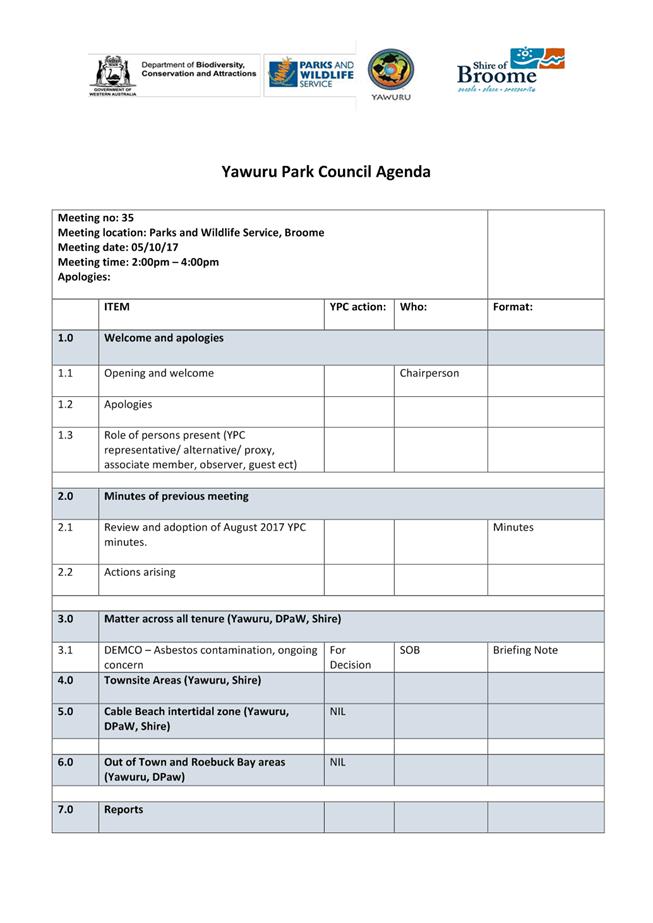
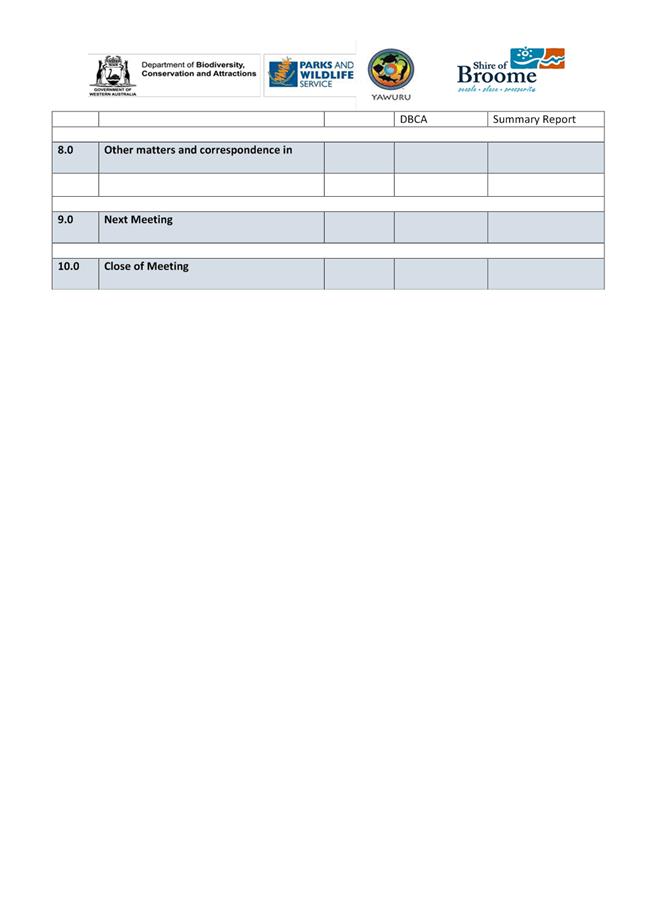
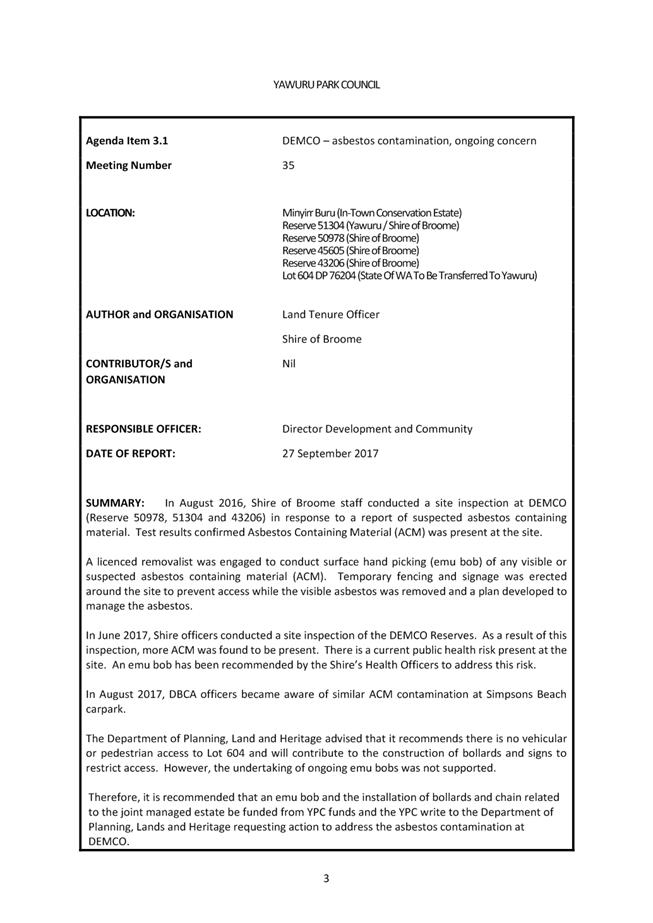
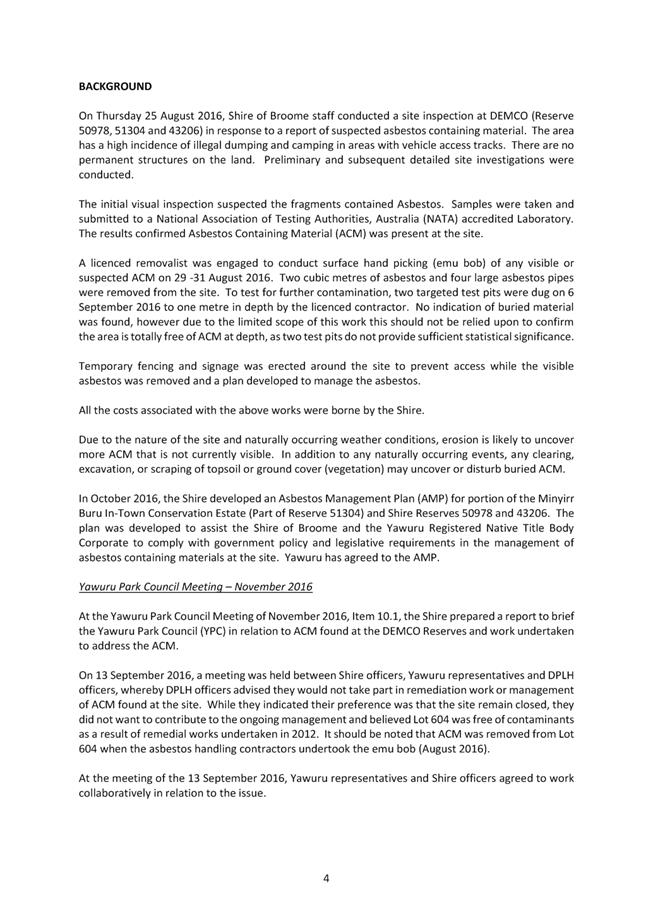


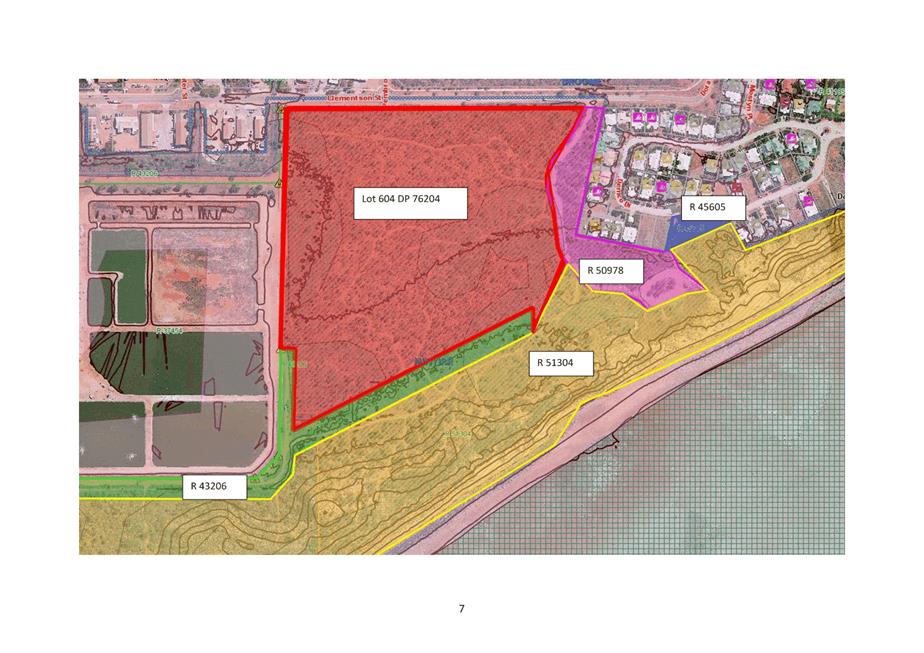
|
Item 10.3 - Yawuru Park Council minutes and
recommendations of meetings held on 17 October, 15 November and 20 December
2017.
|
Yawuru Park Council
Meeting
Minutes
Meeting no: 35
Meeting location: Nyamba Buru Yawuru
Meeting date: 17-10-17
Meeting start: 8:45am
Meeting end: 11:00am
Attendees:
Yawuru: Ben Dolby and Dean Mathews
Shire of Broome: Aletta Nugent, Sam
Mastrolembo, Harold Tracey
Parks & Wildlife Service: Daniel
Balint and Craig Olejnik
Apologies:
Deb Pigram
Guests
/ Observers: Julie
Melbourne (NBY), Sam Legge (NBY) Jacky Jankowski (SOB), Melanie Edgar (DBCA)
1. Welcome and
apologies
1.1. Opening and
welcome
Meeting opened by Dean
Mathews
1.2. Apologies
Deb Pigram
1.3. Role of
persons present (YPC representative/ alternative/ proxy, associate member,
observer etc)
Nyamba Buru
Yawuru: Ben Dolby (representative), Dean Mathews (representative), Julie
Melbourne (observer), Sam Legge (observer)
Shire of
Broome: Sam Mastrolembo (representative), Aletta Nugent (representative),
Harold Tracey (representative), Jacky Jankowski (observer)
Parks and
Wildlife Service: Daniel Balint (repetitive), Craig Olejnik (representative),
Melanie Edgar (observer)
2. Minutes of
previous meeting
2.1. Review and
adoption of previous minuets
JJ – found some minor mistakes to
be amended by ME (DBCA)
Moved- SM
Seconded - HT
Actions arising – to
be discussed at next meeting
3. Matters
across all tenure (Yawuru, Parks & Wildlife, Shire)
3.1. DEMCO
– asbestos contamination, ongoing concern
|
REPORT
RECOMMENDATION:
That Yawuru Park
Council:
1.
Support the
Shire and Yawuru writing to the Department of Premier and Cabinet (DPC), in
anticipation of Yawuru meeting with the DPC in the week starting 23 October
2017, advising that Asbestos Containing Material (ACM) has been identified on
Reserve 51304 (Yawuru Conservation Estate) and Lot 604 on Deposited Plan
76204 (to be transferred to Yawuru) presenting a current public health risk
at the site and requesting:
a. that
the State either fund or offer to reimburse the costs of licensed asbestos
handling contractors conducting an emu bob pick of visible ACM on Reserve
51304 and a portion of Reserve 51001 (Simpsons Beach) by 31 October 2017;
b. commit
to undertaking a full site remediation of Reserve 51304 and Lot 604 on
Deposited Plan 76204 by 30 September 2018;
2.
In the event
DPC does not provide confirmation that it will either fund or reimburse the
costs of the emu bob pick up in accordance with point 1.a. above, agrees for
the emu bob pick up to be funded from YPC funds, to a maximum value of
$12,000.
3.
Fund the
installation of a gate, bollards, ropes, signage etc. to restrict vehicular
access to Reserve 51304.
Moved:
HT
Seconded: AN
|
ACTION: JM to write the letter and have
Yawuru, DBCA and SOB to sign it before presenting at the meeting with Premier
in Cabinet.
ACTION: DB and SOB to meet on sight ASAP to
determine where they will need to install bollards and signs.
ACTION: Emu bob to happen ASAP
4. Townsite
areas (Yawuru, Shire)
5. Cable Beach
intertidal zone (Yawuru, Parks & Wildlife, Shire)
6. Out of town
and Roebuck Bay areas (Yawuru, Parks & Wildlife)
7. Reports
7.1. Expenditure
report summary
8. Other
matters and correspondence
Next meeting
15/11/17
9. Close of
meeting
|
Item 10.3 - Yawuru
Park Council minutes and recommendations of meetings held on 17 October, 15
November and 20 December 2017.
|



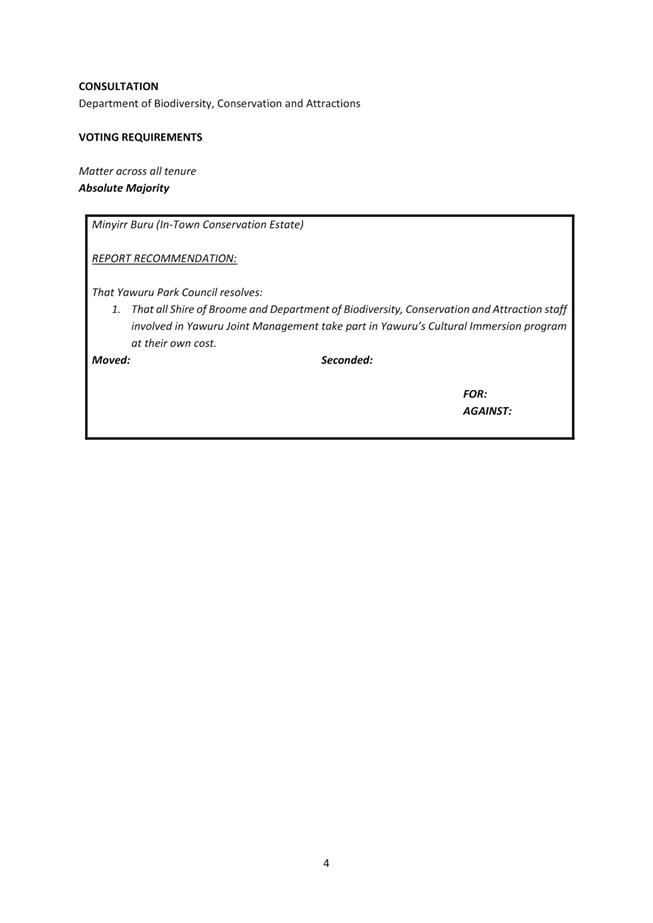

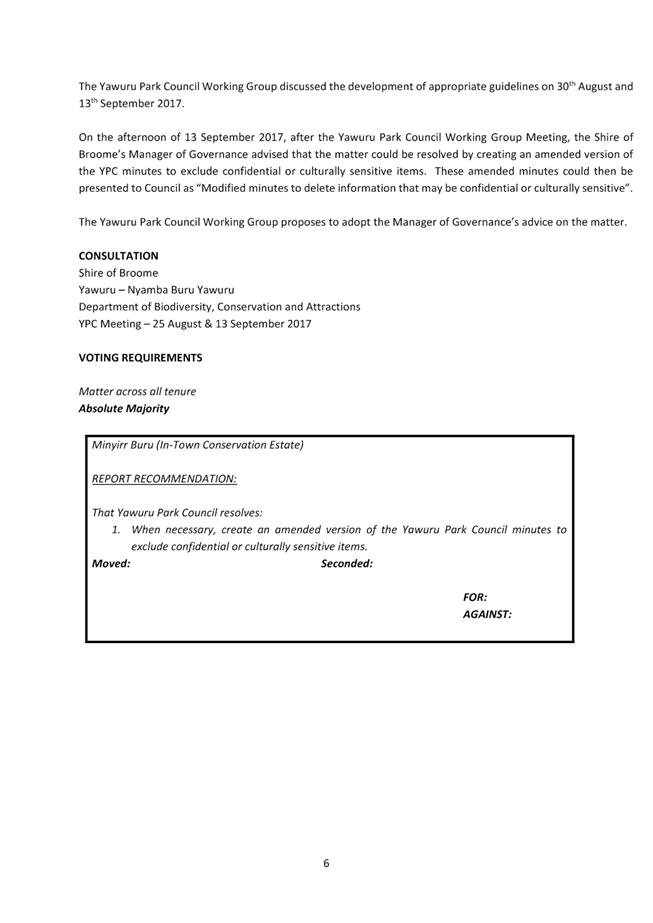

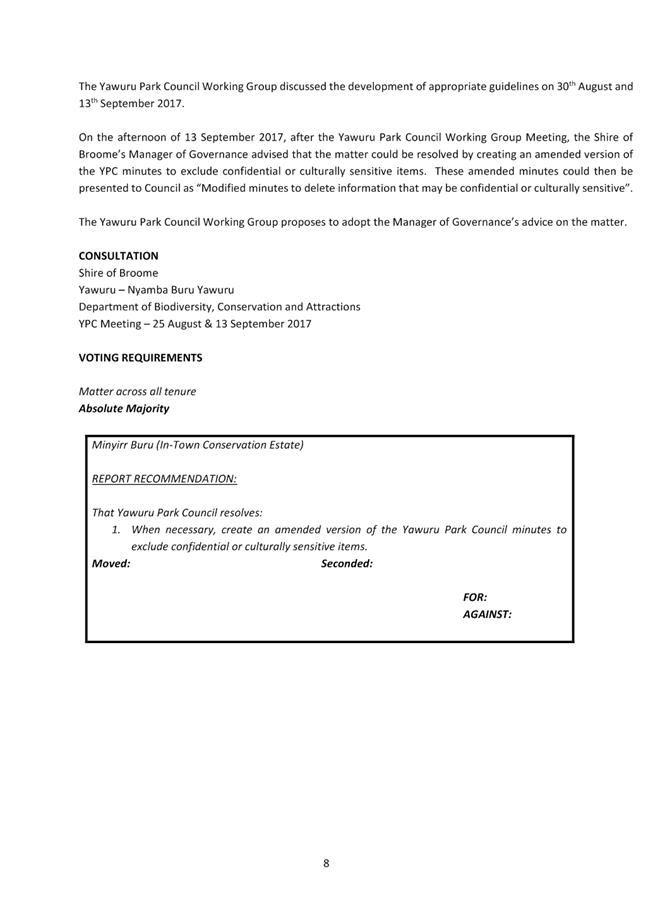
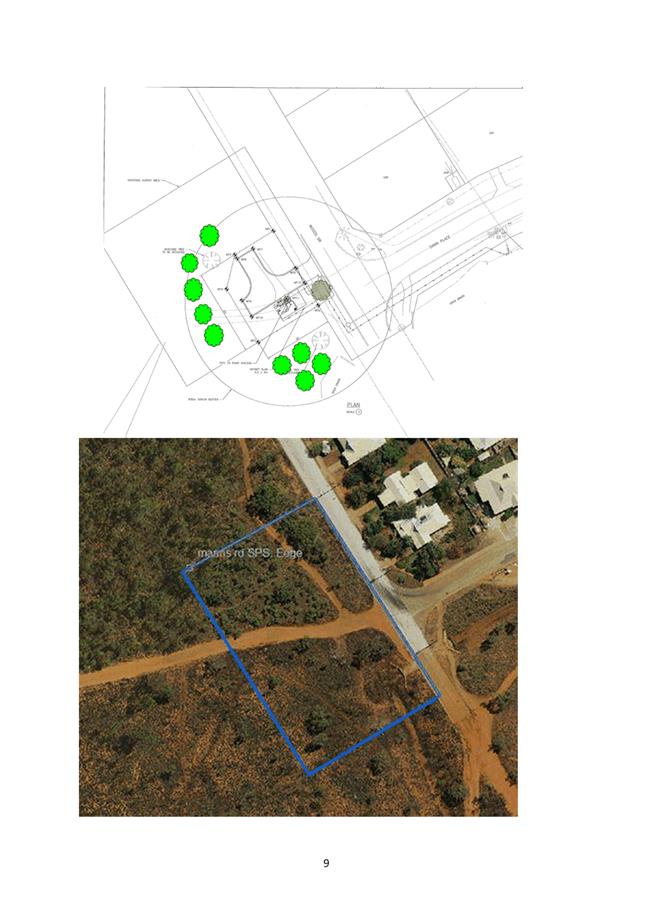
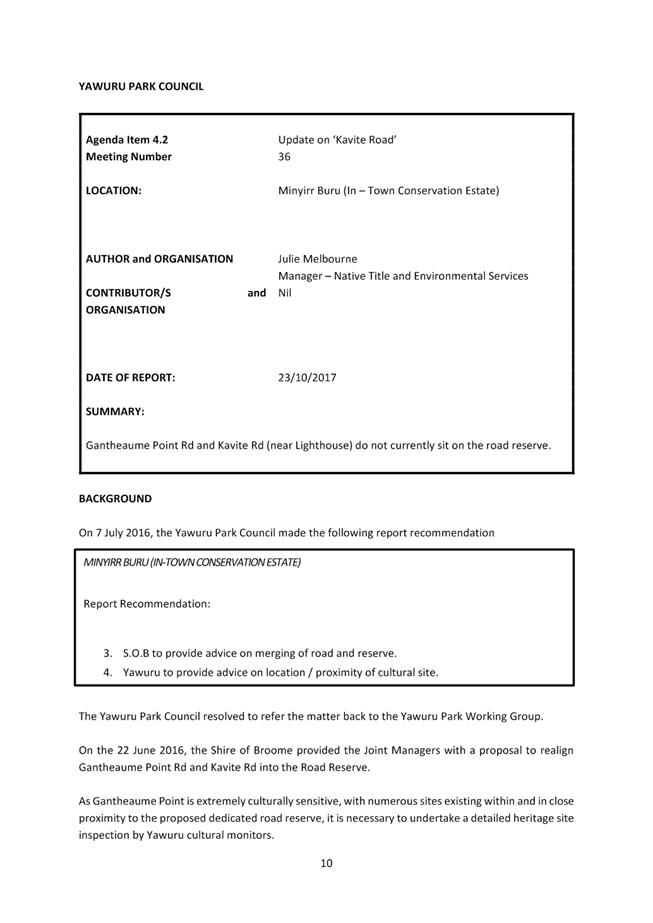


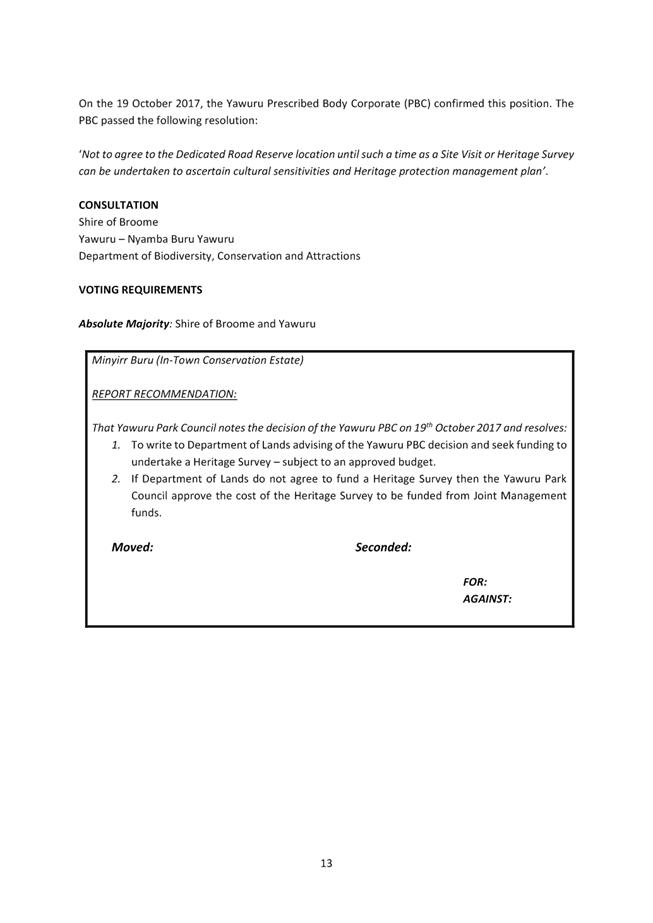

Meeting
Minutes
Meeting no: 36
Meeting location: DBCA Parks and Wildlife
Meeting date: 15th November 2017
Meeting start: 9:30am
Meeting end: 12:25
Attendees:
Yawuru: Dean Mathews, Ben Dolby
Shire of Broome: Harold Tracey, Aletta
Nugent
Department of Biodiversity Conservation and Attractions
Parks & Wildlife Service: Craig Olejnik, Daniel Balint, Luke Puertollano
Apologies:
Deb
Pigram, Sam Mastrolembo
Guests
/ Observers:
Julie Melbourne (NBY), Sam Legge (NBY), Jacqui Jankowski (SOB), Melanie Edgar
(DBCA), Jason Richardson (DBCA), Pat Foley (DBCA)
1. Welcome
and apologies
1.1. Opening
and welcome
Meeting opened by
Chair Dean Mathews
1.2. Apologies
Deb Pigram, Sam Mastrolembo
1.3. Role of
persons present (YPC representative/ alternative/ proxy, associate member,
observer etc)
Nyamba
Buru Yawuru: Dean
Mathews (YPC representative), Ben Dolby (proxy)
Shire of
Broome: Harold
Tracey (YPC representative), Aletta Nugent (YPC representative), Jacquie
Jankowski (observer)
Parks and
Wildlife Service: Craig
Olejnik (YPC representative), Daniel Balint (YPC representative), Luke
Puertollano (YPC representative), Jason Richardson (observer), Melanie Edgar
(observer), Patrick Foley (observer)
2. Minutes of
previous meeting
2.1. Review and
adoption of previous minuets
JJ- found some minor mistakes to be amended by ME (DBCA)
Moved- HT
Seconded- DB
Actions arising
DM- actions table to be available and
attached to meeting minuets as previously done.
3. Matters
across all tenure (Yawuru, Parks & Wildlife, Shire)
3.1. Yawuru
Cultural Immersion for Joint Management Partners
|
Minyirr Buru (In-Town Conservation
Estate)
REPORT RECOMMENDATION:
That Yawuru Park Council
resolves:
1. That all
Shire of Broome and Department of Biodiversity, Conservation and Attraction
staff involved in Yawuru Joint Management take part in Yawuru’s
Cultural Immersion program at their own cost.
Moved: Seconded:
Noted
all agree that the Cultural Immersion Program is important for YPC members to
undertake.
|
AN- SOB has already inquired about
this and already taking the steps to do the program with their staff
ACTION: Request for
cultural Immersion for Shire Staff to be resent
ACTION: NBY to provide
costs Per head for Cultural Immersion be sent to Joint Management Partners
3.2. Confidential
Matters
|
Minyirr Buru (In-Town Conservation
Estate)
REPORT RECOMMENDATION:
That Yawuru Park Council
resolves:
1. When
necessary, create an amended version of the Yawuru Park Council minutes to
exclude confidential or culturally sensitive items.
Moved: HT Seconded:
CO
|
AN – Suggests that all matters
that are considered confidential agenda items are to be workshopped through the
WG rather than bringing to the YPC.
4. Townsite
areas (Yawuru, Shire)
4.1. Proposed
Management Oder and easement to Water Corporations Sewerage Facility at Dann
Place
|
Minyirr Buru (In-Town Conservation
Estate)
REPORT RECOMMENDATION:
That Yawuru Park Council notes the
Yawuru PBC and Shire of Broome decision of and 7th of September
and 24th January 2017, respectively, resolves:
1. To
Consent to the grant of the proposed easement to Water Corporation with a
Management Order for the purpose of ‘Waste
water Pump station and Pressure Main’.
Moved: HT Seconded:
DB
|
4.2. Update on
Kavite Road – agenda noted
|
Minyirr Buru (In-Town Conservation
Estate)
REPORT RECOMMENDATION:
That Yawuru Park Council
notes the decision of the Yawuru PBC on 19th October 2017 and
resolves:
1. To write
to Department of Planning, Lands and Heritage advising of the Yawuru PBC
decision and seek funding to undertake a Heritage Survey – subject to
an approved budget.
Moved:
AN
Seconded: DB
|
2. HT-
suggests if Department of Lands do not agree to fund a Heritage Survey then the
Yawuru Park Council consider approving the cost of the Heritage Survey to be
funded from Joint Management funds prior to commencement of construction.
ACTION: NBY / YPC to
write to DPLH seeking funding to undertake heritage survey for proposed
Gantheaume / Kavite Road realignment
4.3. Gantheaume
Point ‘Public Liability’ mitigation works
JM – suggests that projects be
written out with photos/ diagrams/ quotes/ costs
CO – has put forward that DBCA
can provide quotes for signage, bollards and architect planning
|
Minyirr
Buru (In-Town Conservation Estate)
REPORT RECOMMENDATION:
That Yawuru Park Council:
1. Supports
the use of Yawuru Park Council funds to undertake works identified as
‘high’ in the LGIS Report for Gantheaume Point; and
2. Agrees
that the work required to rectify the exposed culverts are funded by the YPC
and carried out either:
a) By
the Shire of Broome on behalf of the YPC;
b) By
the Department of Biodiversity, Conservation
and Attractions; or
c) By
a contractor engaged by the Department of Biodiversity, Conservation and
Attractions.
This item was deferred, pending DBCA
providing project scope and quote from at least two sources
Moved: AN Seconded:
LP
|
ACTION: Additional
quotes on work sought (DBCA)
ACTION: DBCA to provide
a photo/copy of the visitor risk sign to get approval from the YPC
4.4. DEMCO
asbestos – Verbal update (agenda item noted)
ACTION: SoB
to provide quotes for CE / Simpson Beach:
· Provide
and install bollards / chain
· Signage
· Emu
bob
ACTION:
SOB to contact DBCA to arrange onsite meeting to identify locations of bollards
and gates.
4.5. Joint
Management Plan for the Yawuru Minyirr Buru Conservation Park – YPC
Endorsement.
- Agenda
item deferred
|
Minyirr Buru (In-Town Conservation
Estate)
REPORT RECOMMENDATION:
That Yawuru Park Council
endorse:
1. The
‘Joint Management Plan for the Yawuru Minyirr Buru Conservation
Park’ for Ministerial approval.
Deferred, pending meeting
with Kimberley Ports Authority
Moved: HT Seconded:
DB
|
ACTION:
Invite Kimberley Ports Authority to YPC WG meeting to discuss submissions for
the In-Town Management Plan
5. Cable
Beach intertidal zone (Yawuru, Parks & Wildlife, Shire)
6. Out of
town and Roebuck Bay areas (Yawuru, Parks & Wildlife)
6.1. 353 &
354 update (Verbal update)
ACTION: NBY to forward correspondence to SoB
outlining proposal to restrict access to the west of the Shire’s gravel
Reserve 35493
7. Reports
7.1. Budget
Forecast 2017/2018
ACTION:
DBCA to forward budgets and review budget draft forecast
ACTION:
DBCA to provide costs associated with the fire truck to NBY
8. Other
matters and correspondence
8.1. Fire
Update – Pat Foley
ACTION:
Workshop with SOB, KPA, DBCA, NBY to be held on fire planning and re-veg work
in Minyirr Park (+EK, -KPA)
8.2. Gurlbinwila
update – Luke Puertollano
ACTION: Media release to
go out to the public about what will be happening out at Gurlbinwila (facebook
post on DBCA and NBY pages)
9. Next
meeting
20th Dec 2017
10. Close of
meeting
12:25PM
|
Item 10.3 - Yawuru
Park Council minutes and recommendations of meetings held on 17 October, 15
November and 20 December 2017.
|


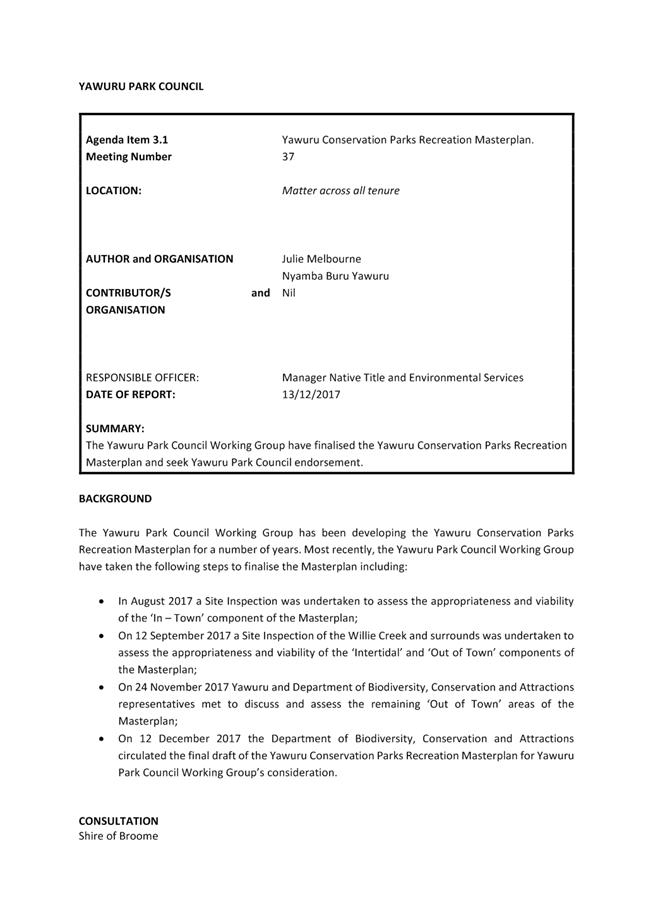




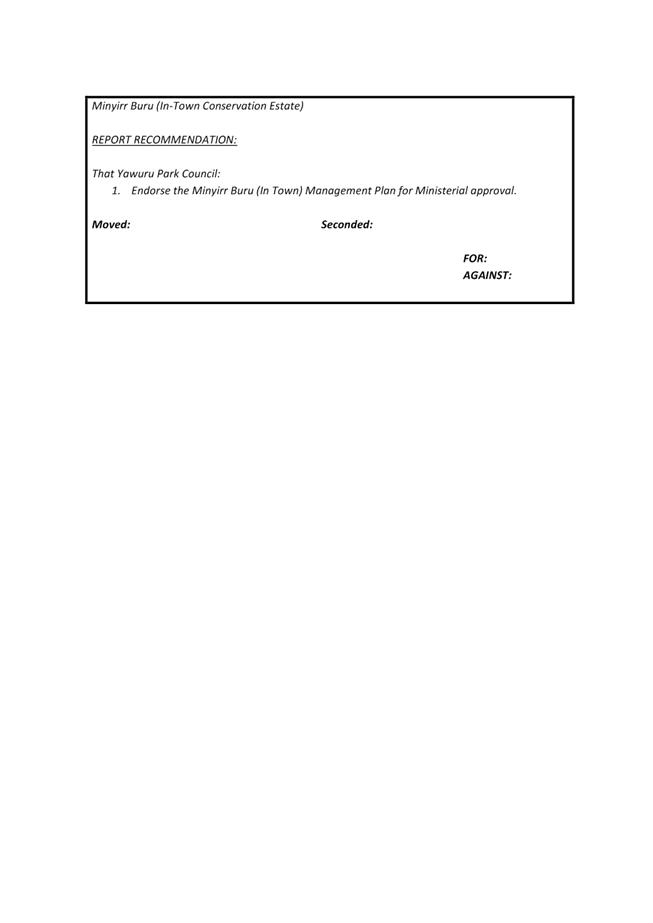
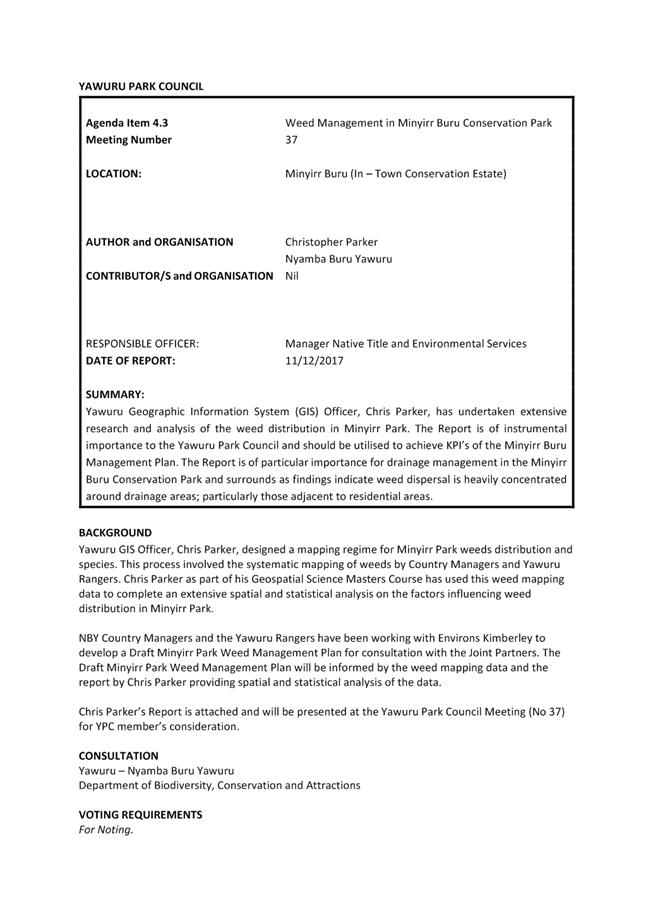
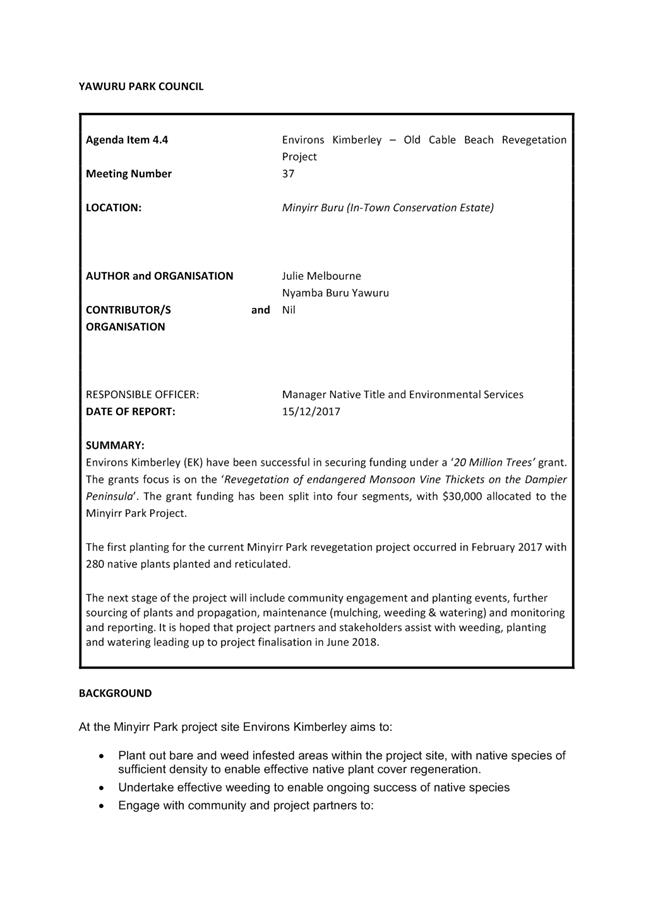
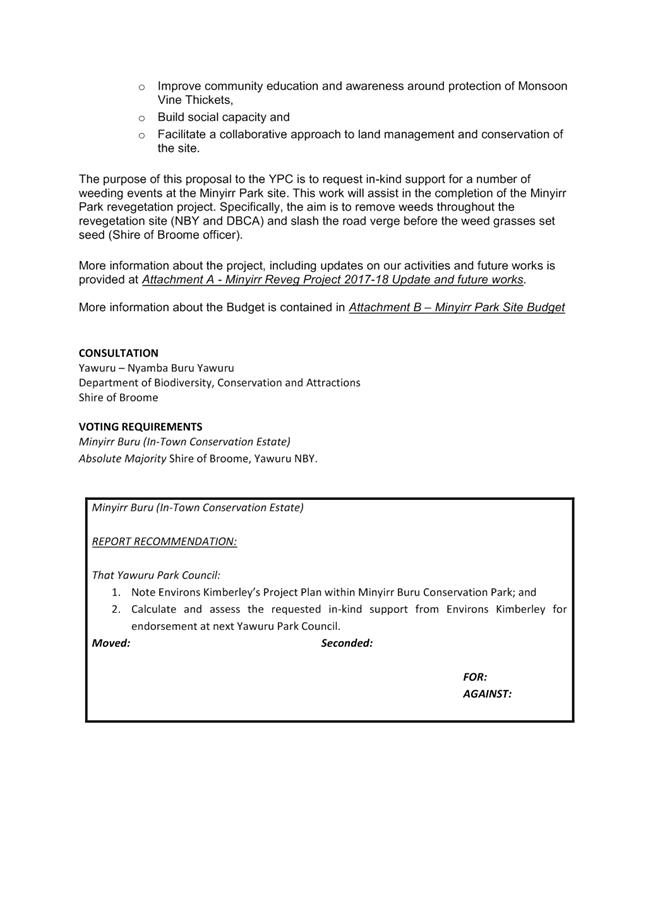
|
Item 10.3 - Yawuru
Park Council minutes and recommendations of meetings held on 17 October, 15
November and 20 December 2017.
|
Yawuru Park Council
Meeting Minutes
Meeting no: 37
Meeting location: Nyamba Buru Yawuru
Meeting date: 20th December
2017
Meeting start: 10:08am
Meeting end: 11:40am
Attendees:
Yawuru: Dean
Matthews, Deb Pigram
Shire of Broome:
Harold Tracey, Aletta Nugent
Department of Biodiversity
Conservation and Attractions Parks & Wildlife Service: Daniel Balint, Luke
Puertollano, David Woods.
Apologies:
Ben
Dolby, Sam Mastrolembo, Craig Olejnik.
Guests
/ Observers: Julie Melbourne (NBY), Sam Legge (NBY), Jacqui Jankowski
(SOB).
1. Welcome
and apologies
1.1. Opening and welcome
Meeting opened by
Chair Deb Pigram
1.2. Apologies
Ben Dolby, Sam Mastrolembo, Craig
Olejnik.
Role of persons present (YPC
representative/ alternative/ proxy, associate member, observer etc)
Nyamba
Buru Yawuru: Dean Matthews (YPC representative), Debra Pigram (Chair)
Shire of
Broome: Harold Tracey (YPC representative), Aletta Nugent (YPC representative),
Jacky Jankowski (observer)
Parks and
Wildlife Service: Daniel Balint (YPC representative), Luke Puertollano (YPC
representative), David Woods (YPC proxy).
2. Minutes of
previous meeting
2.1. Review and adoption
of previous minuets
Moved- AN
Seconded- DB
Actions arising
3. Matters
across all tenure (Yawuru, Parks & Wildlife, Shire)
3.1. Yawuru Conservation
Parks Recreation Master Plan
-
|
Matters
across all tenure
REPORT
RECOMMENDATION:
That
Yawuru Park Council:
1. Endorse
the Yawuru Conservation Parks Recreation Master Plan.
This item was deferred.
Moved:
HT Seconded:
DB
|
S.O.B
request Agenda Item Deferred
4. Townsite
areas (Yawuru, Shire)
4.1. Prescribed Burning in
Minyirr Buru Conservation Park
|
Minyirr Buru
(In-Town Conservation Estate)
REPORT
RECOMMENDATION:
That Yawuru Park
Council:
1. Endorse
the revised prescribed burning schedule of works within the Minyirr Buru
Conservation Estate; and the revised schedule for inclusion in the Bush Fire
Management Plan for the In-Town Conservation Estate for Shire of Broome
consideration in accordance with the Bush Fires Act 1954
2. Agree
that the Department of Biodiversity, Conservation and Attractions will
undertake prescribed burning in the Minyirr Buru Conservation Park.
3. Provide letter of
support to the Department of Biodiversity, Conservation and Attractions
Moved:
HT Seconded:
DM
|
4.2. Minyirr Buru (In
Town) Management Plan Endorsement
|
Minyirr
Buru (In-Town Conservation Estate)
REPORT
RECOMMENDATION:
That
Yawuru Park Council:
1. Endorse
the Minyirr Buru (In Town) Management Plan for Ministerial approval
1. Endorse
the version of the Minyirr Buru (In Town) Management Plan, distributed by
Shire of Broome on 15 December 2017, incorporating Kimberley Ports Authority
amendments, for Ministerial approval.
Moved:
AN
Seconded: DB
|
(Version
9.2v2 endorsed)
4.3. Weed Management in
Minyirr Buru Conservation Park (Agenda Item noted).
4.4. Environs Kimberley
– Old Cable Beach Revegetation Project
|
Minyirr
Buru (In-Town Conservation Estate)
REPORT
RECOMMENDATION:
That
Yawuru Park Council:
1. Support Environs
Kimberley’s Project Plan within Minyirr Buru Conservation Park and
2. Shire of
Broome to advise if the requested in-kind support from Environs Kimberley is
supported by Council or not, for the next Yawuru Park Council.
Moved:
AN
Seconded: DB
|
5. Cable
Beach intertidal zone (Yawuru, Parks & Wildlife, Shire)
6. Out of
town and Roebuck Bay areas (Yawuru, Parks & Wildlife)
7. Reports
7.1. November Financial
Statement 17/18 Budget Forecast Endorsement
Moved:
HT
Seconded:
DB
8. Other
matters and correspondence
9. Next
meeting
14th
Feb 2018
10. Close of meeting
12:00PM
|
Action
|
Outcome
/ Recommendation
|
Lead
|
Group
|
Date
|
Completed
|
|
3.3 Fee Waiver
(25
August 2017)
|
DBCA to
provide YPC WG with data collected on rubbish and estimated cost of waste
disposal
|
DBCA
|
YPC WG
|
|
|
|
3.3 Fee Waiver
(25
August 2017)
|
YPC WG
to discuss and progress broader rubbish strategy in CE
|
YPC WG
|
YPC WG
|
|
|
|
3.1
Cultural
Immersion
(15.11.17)
|
Per head
cost for Cultural Immersion be sent to Joint Management Partners
|
NBY
|
YPCWG
|
Next
YPCWG
$220
– 2017 cost to be confirmed for 2018
|
|
|
4.2 (15.11.17)
|
NBY /
YPC to write to DPLH seeking funding to undertake heritage survey for
proposed Gantheaume / Kavite Road realignment
|
NBY
|
|
|
|
|
4.3 Public Liability Works at GP
(15.11.17)
|
Additional
quotes on work sought
Project
Brief and plans to be presented
|
DBCA
SOB
|
YPC
|
Next YPC
(14.02.18)
DBCA
secured $5K of non-YPC funds.
|
|
|
4.4 DEMCO
(15.11.17)
|
SoB to
provide quotes for CE / Simpson Beach to DoL:
· Provide
and install bollards / chain
· Signage
· Emu bob
|
SoB
|
YPC
|
|
|
|
4.4 (20/12/2017)EK MVT Project
|
SoB to
confirm in kind support for EK MVT Project
|
SoB
|
YPCWG
|
|
|
|
4.1 (20/12/2017) Prescribed Burning
in Minyirr Buru Conservation Park
|
Letter
of support for DBCA prescribed burning on non-CALM land
|
NBY/SOB
|
YPCWG
|
|
|
|
4.2 (20/12/2017) Endorsement of
Minyirr Buru Management Plan
|
Finalise
Minyirr Buru and commence public distribution / printing
|
DBCA /
SoB
|
YPCWG
|
|
|
|
20/12/2017 Crab Creek Road
|
HT
requested Masterplan of Crab Creek area
|
DBCA
|
|
|
|
|
Item 10.3 - Yawuru
Park Council minutes and recommendations of meetings held on 17 October, 15
November and 20 December 2017.
|
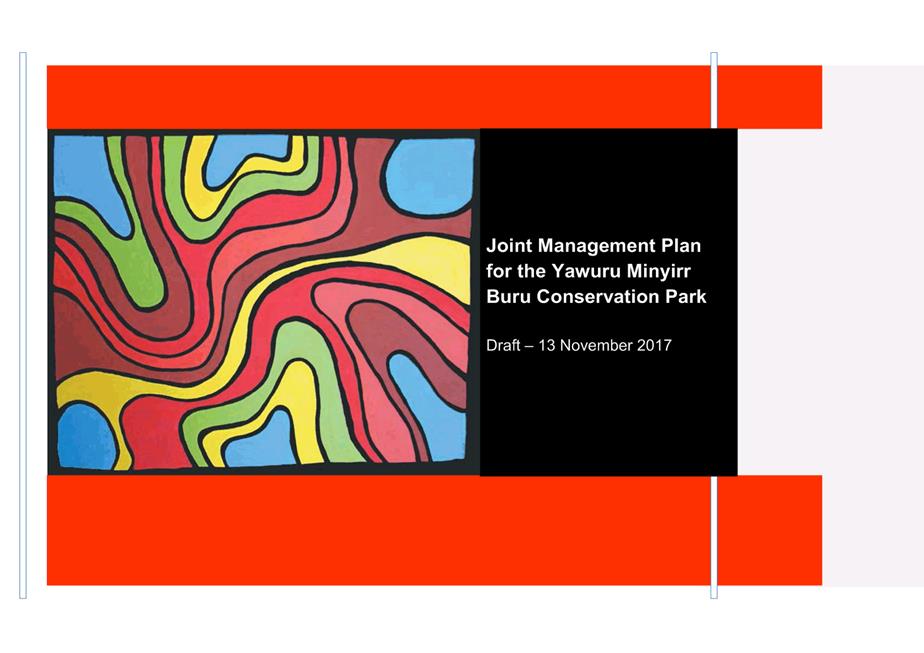

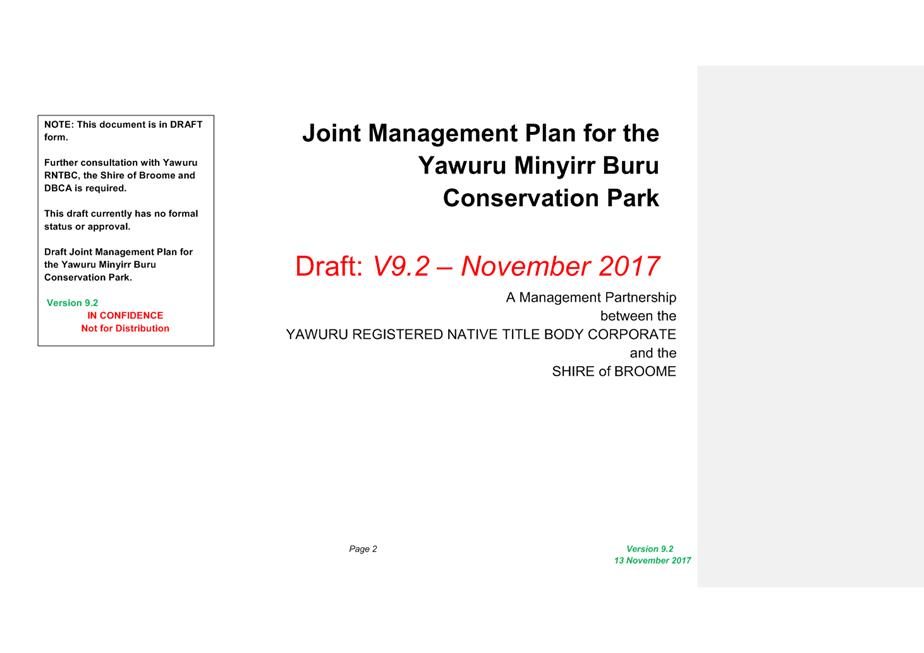
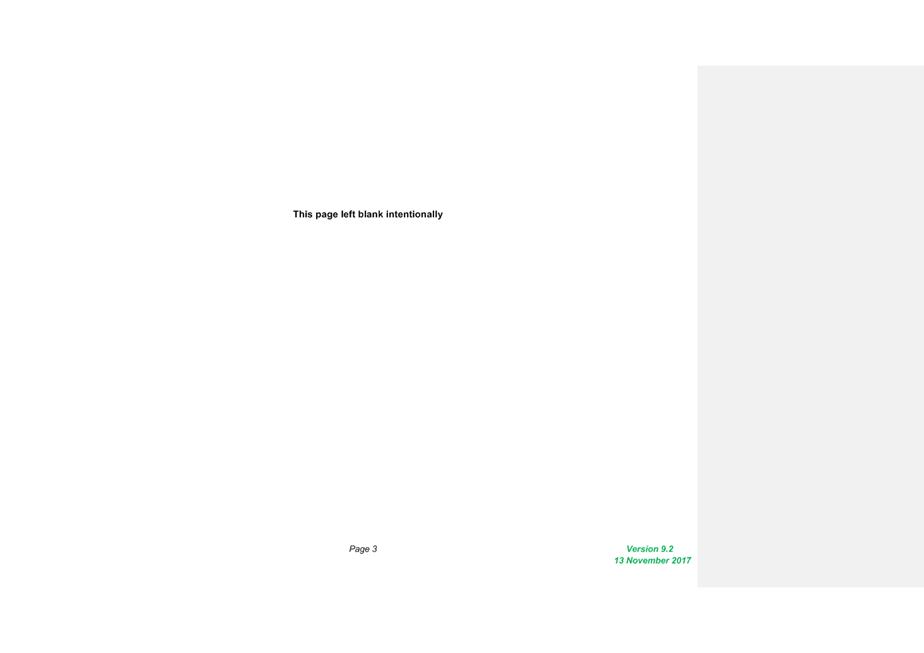
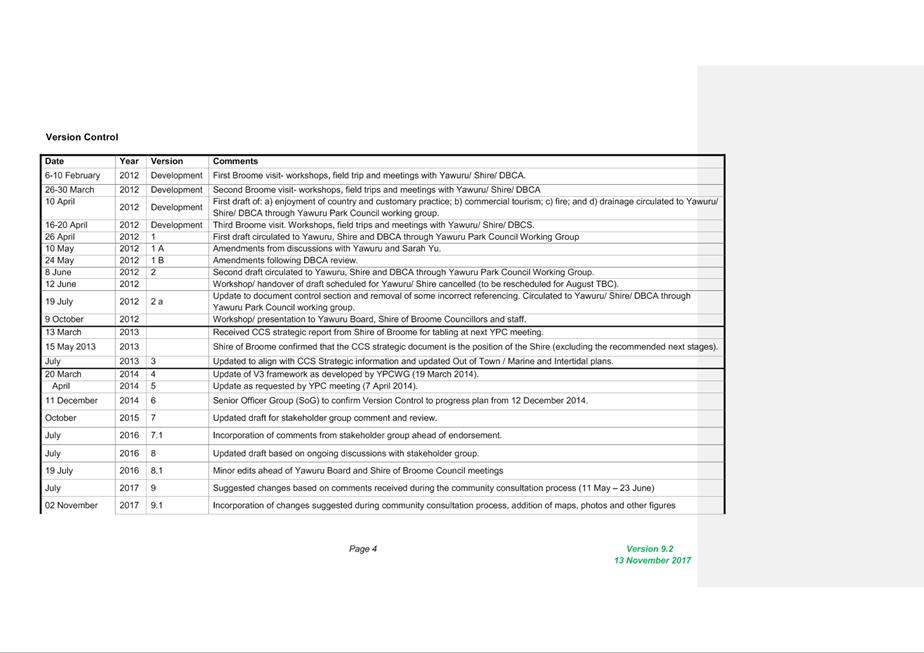
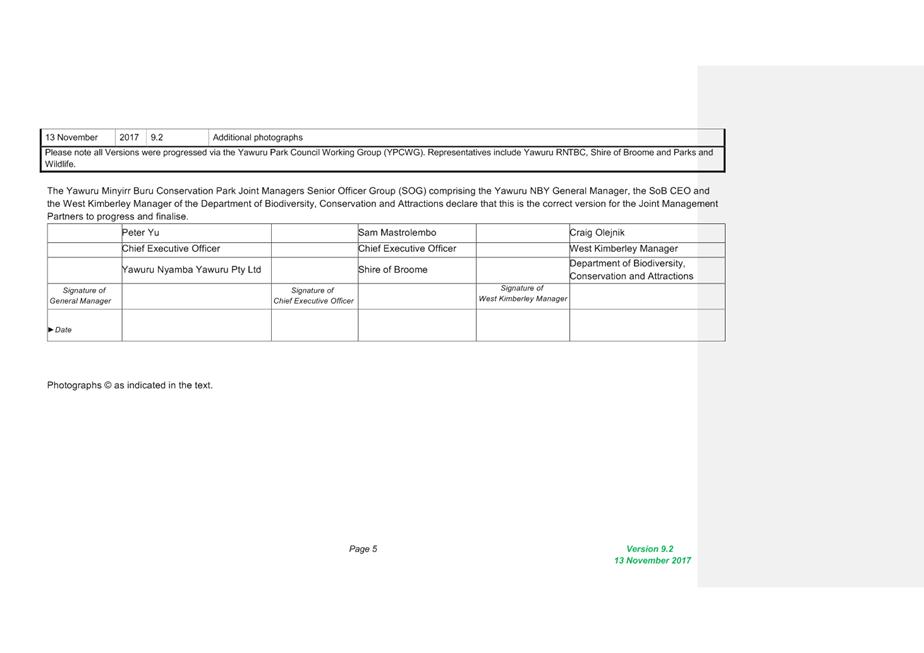
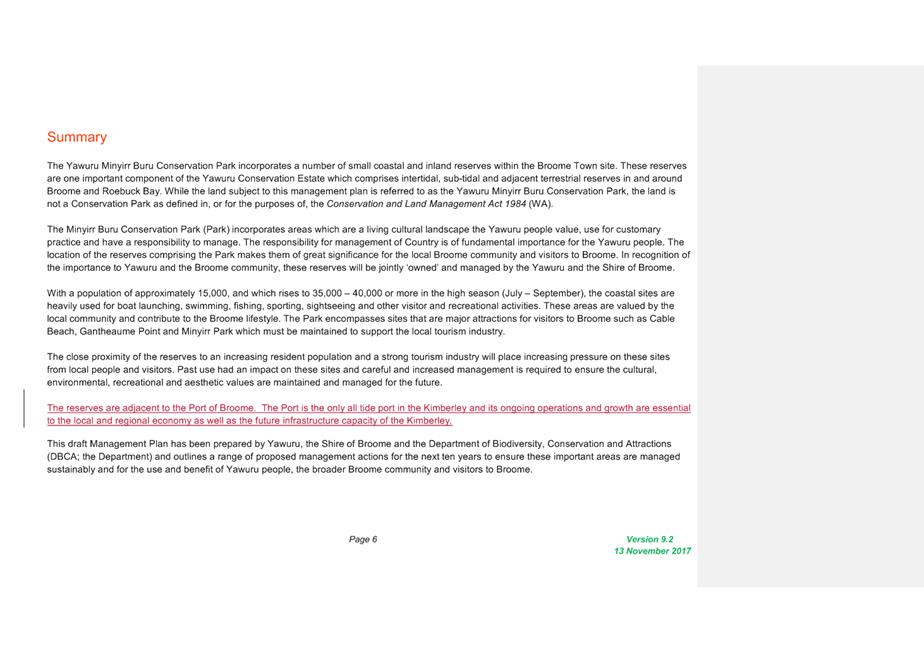
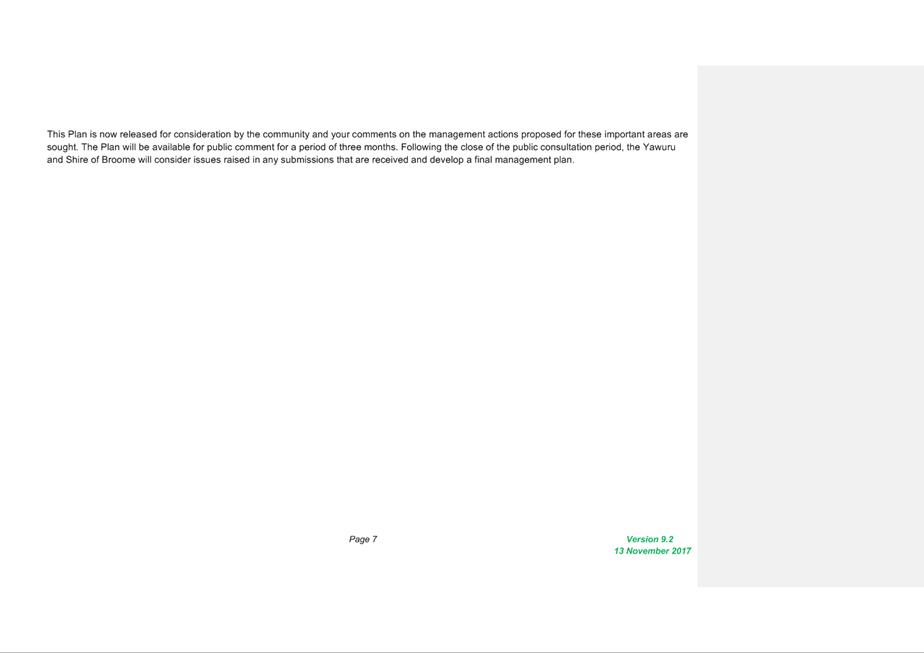

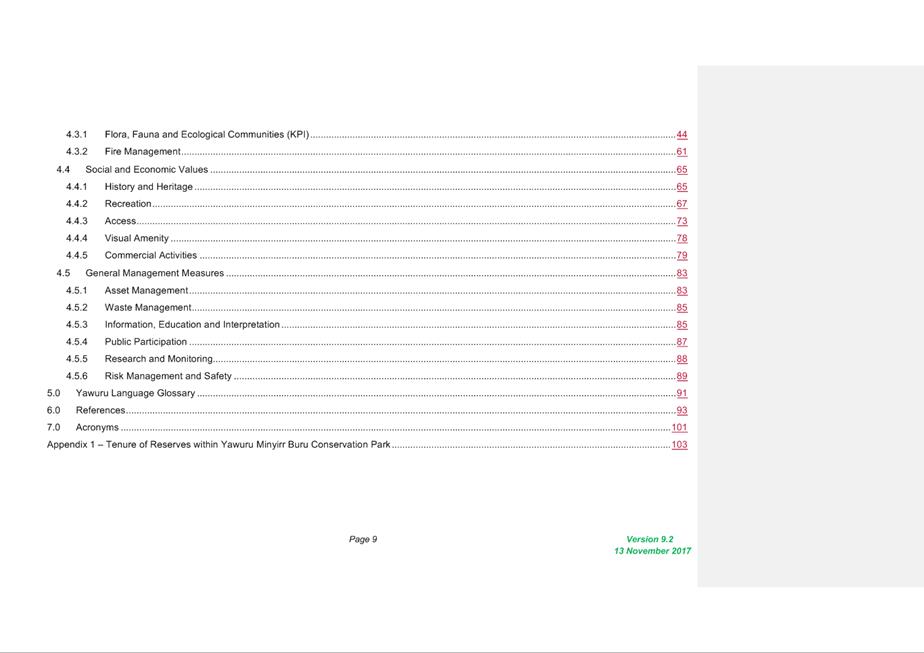

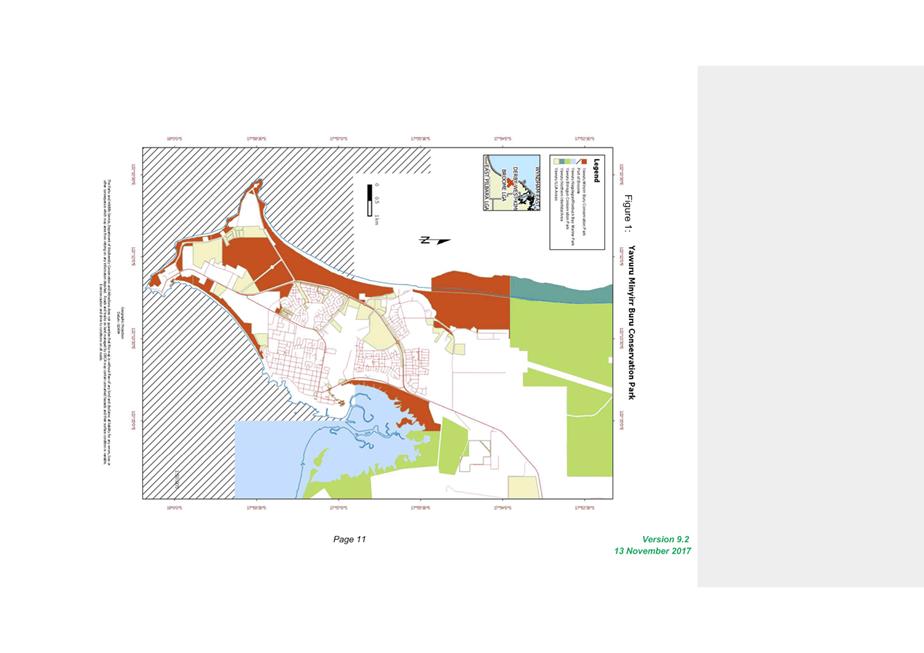

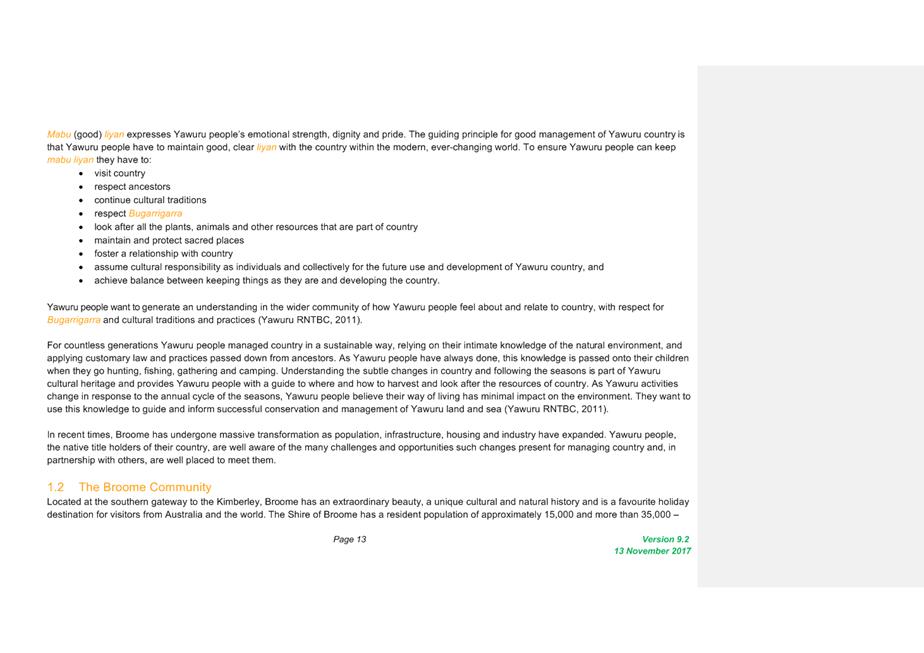
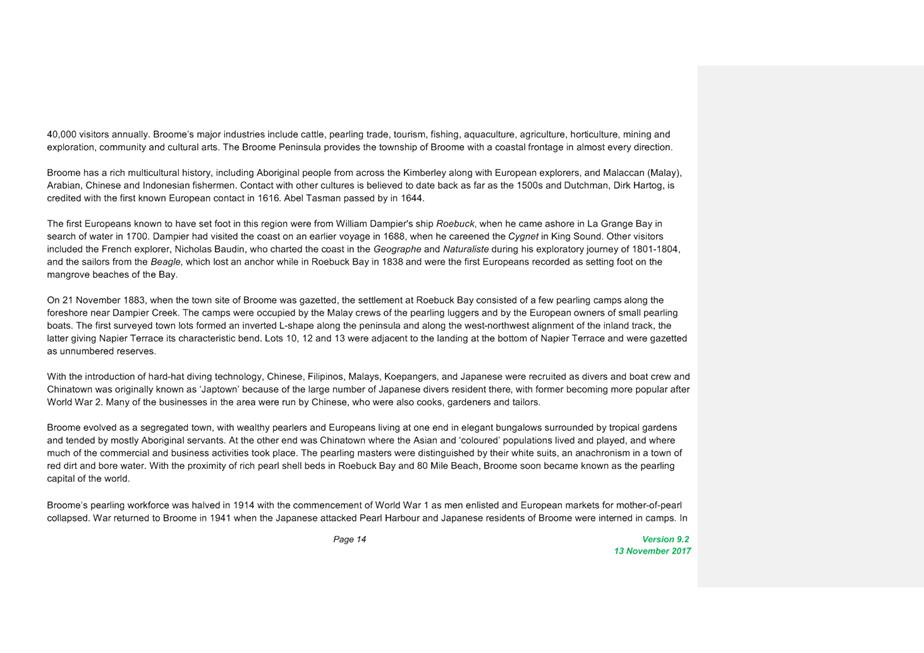

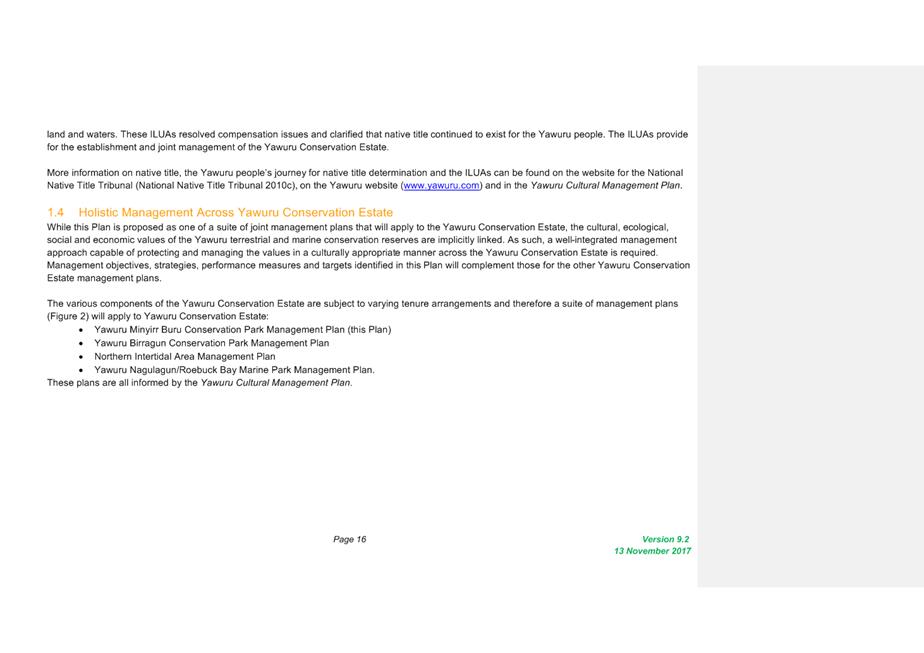
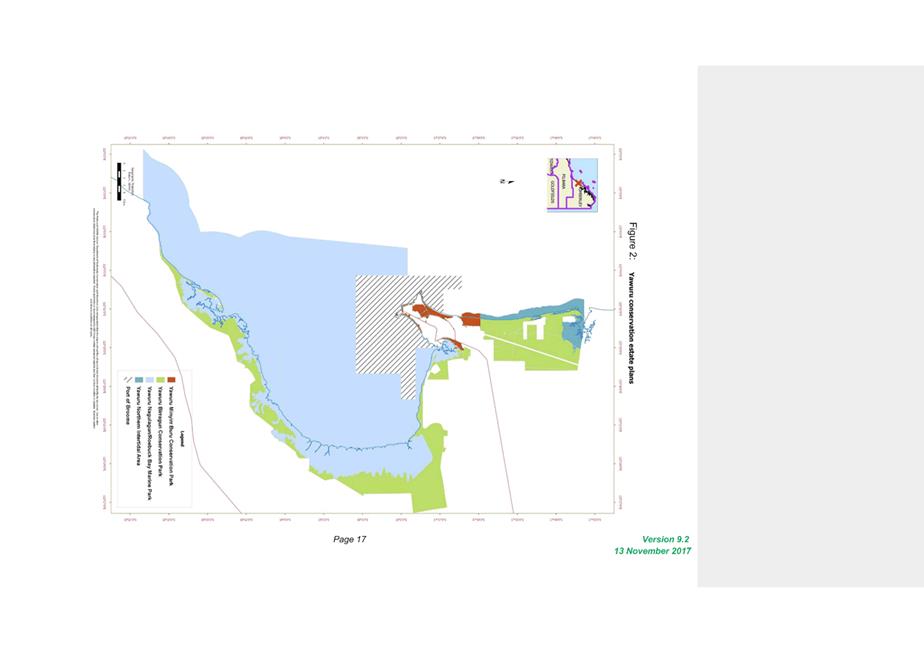
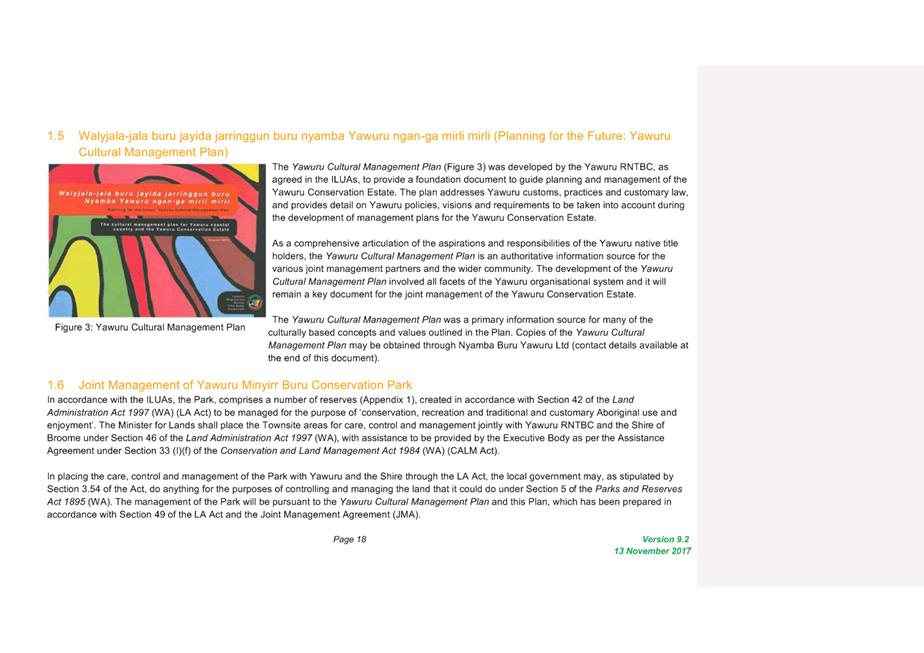
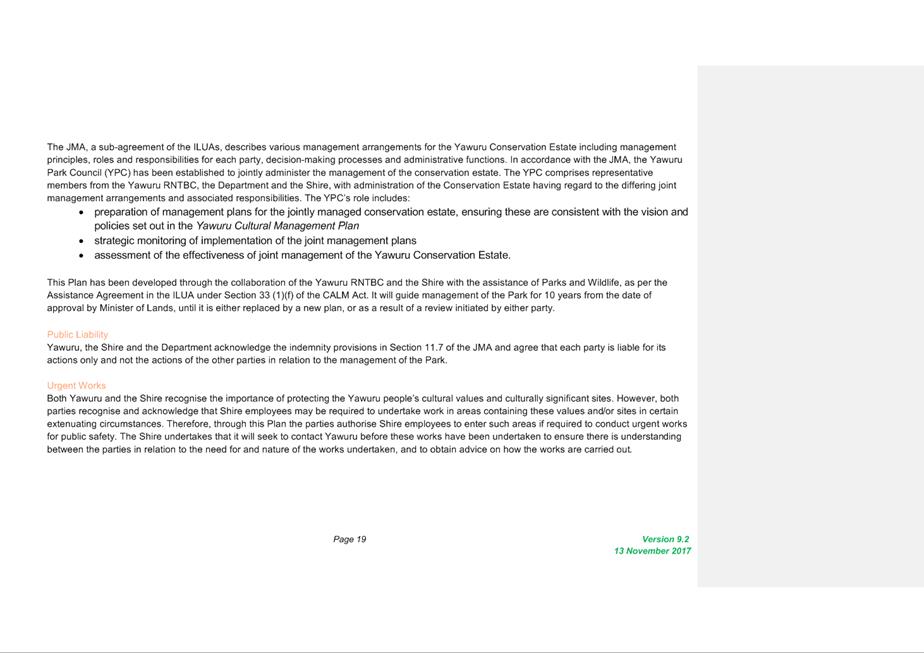
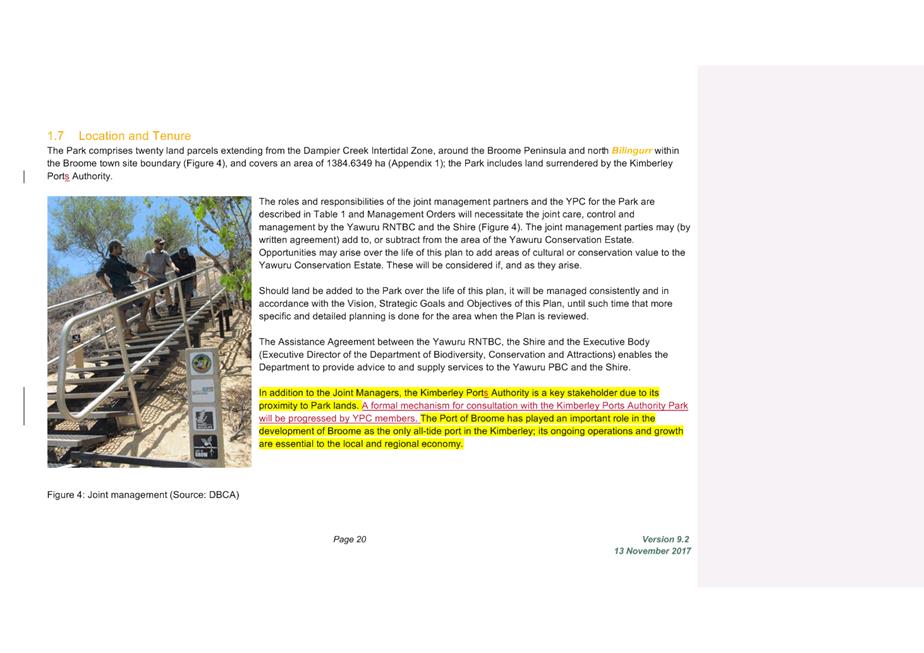

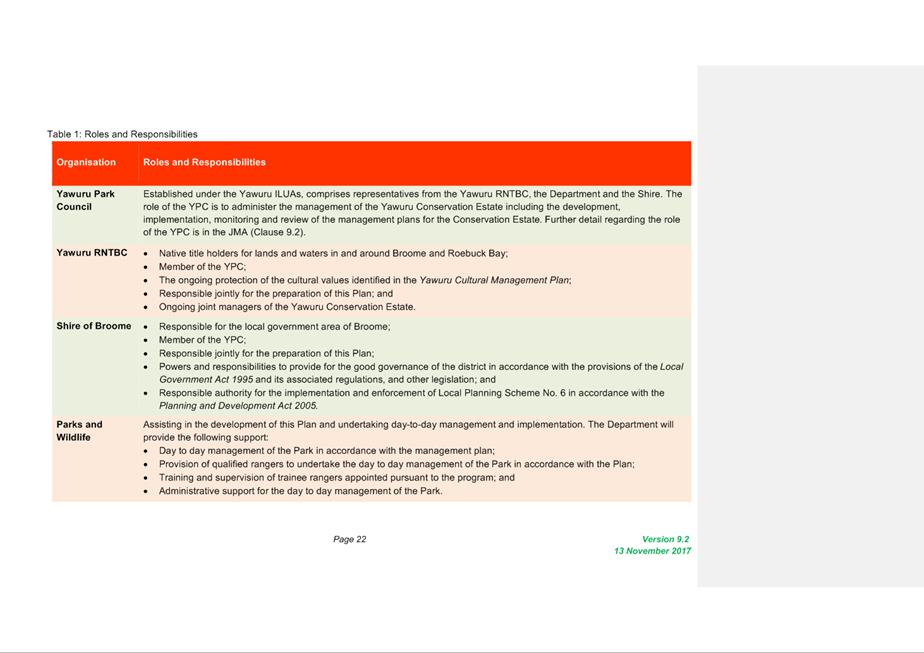
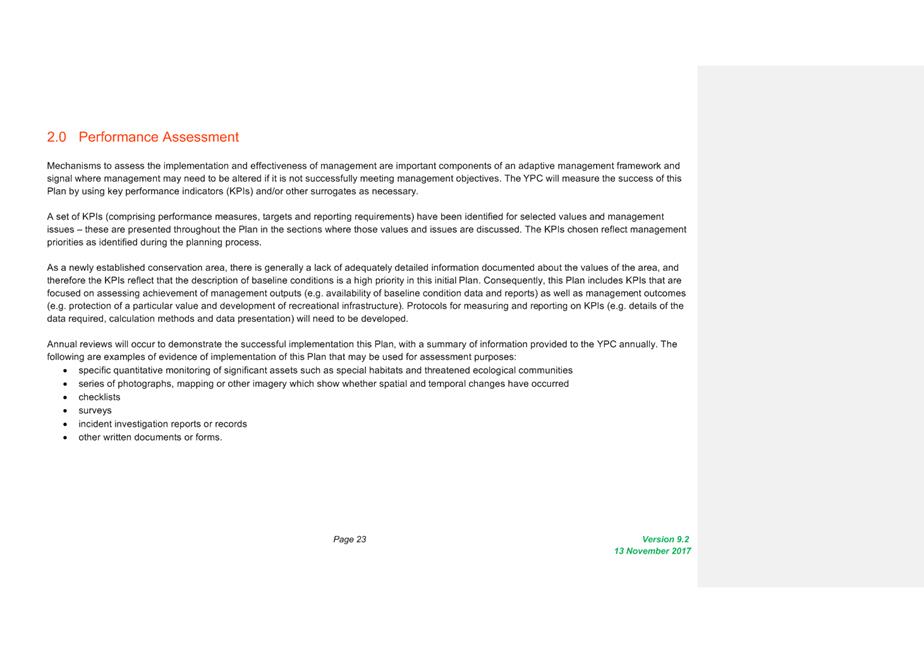
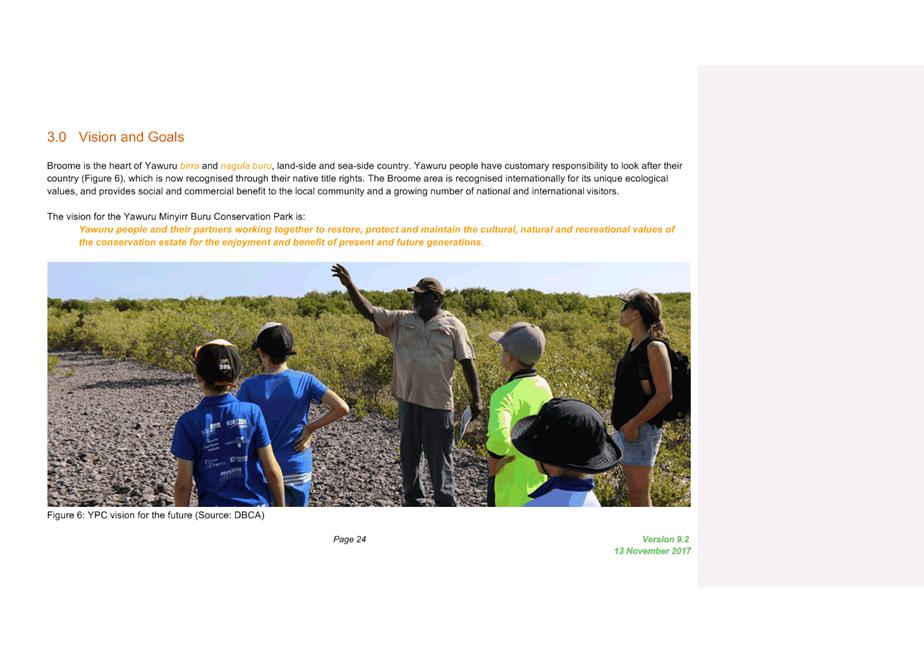

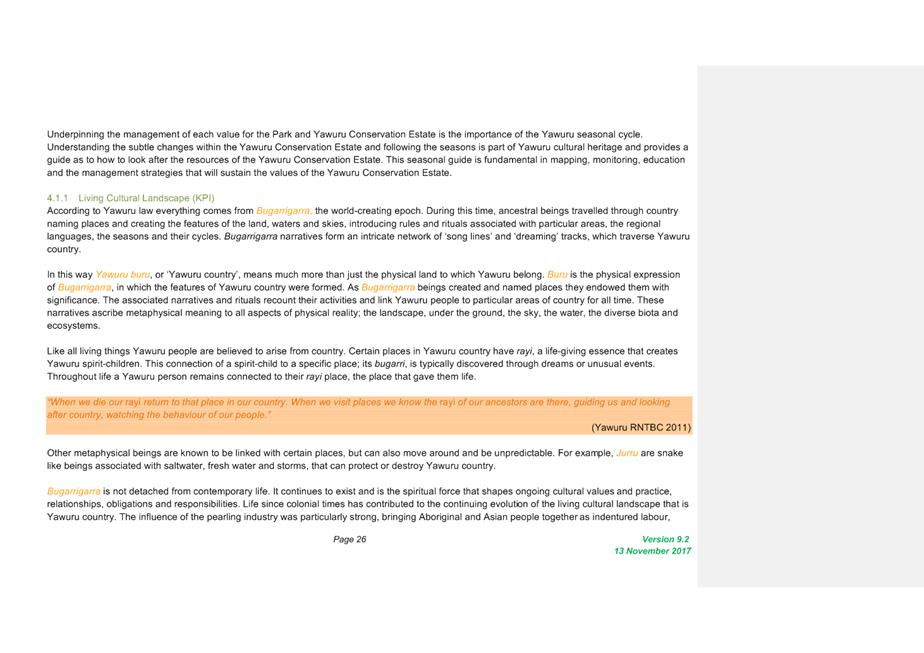
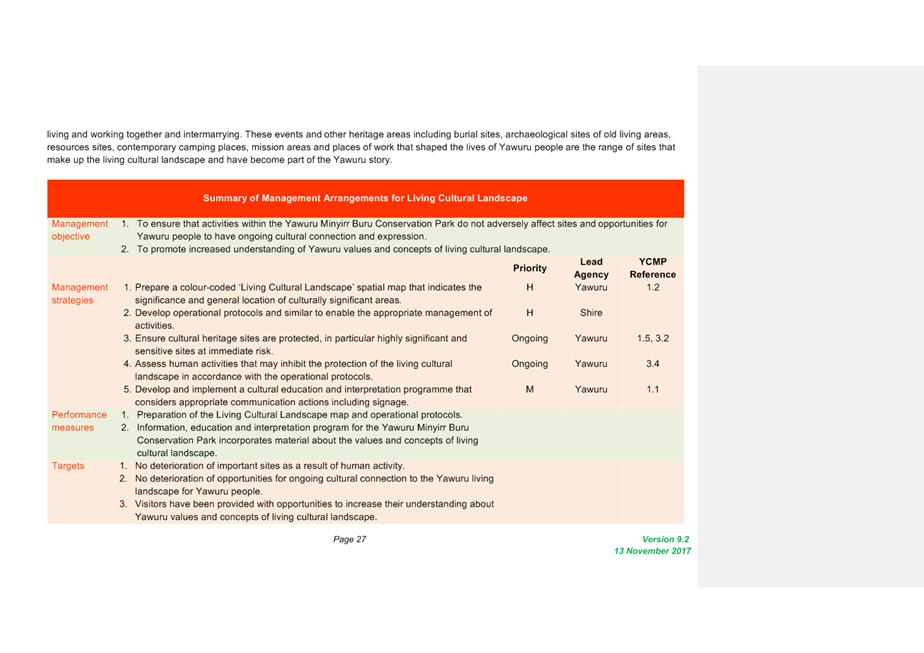


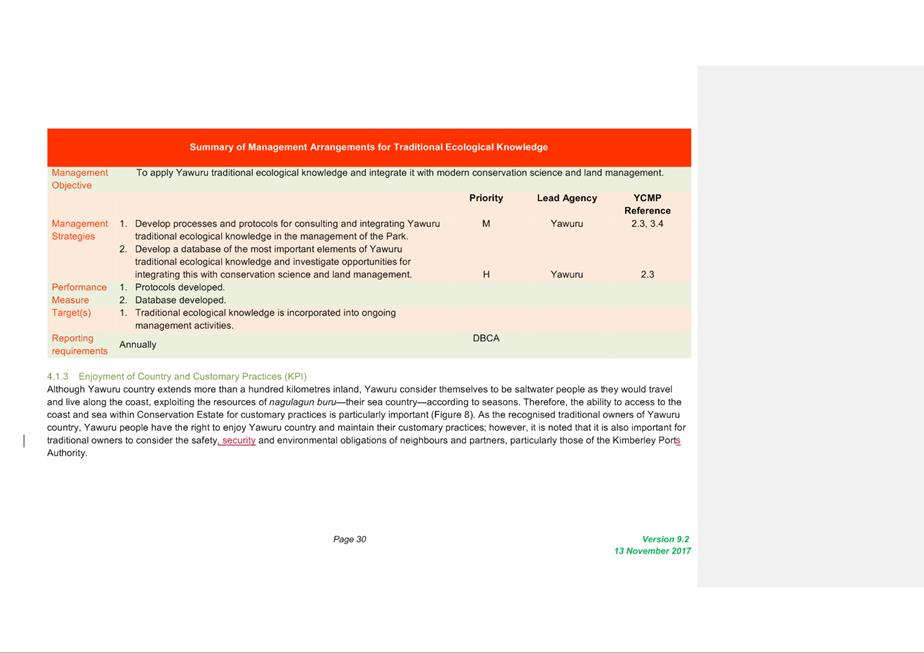

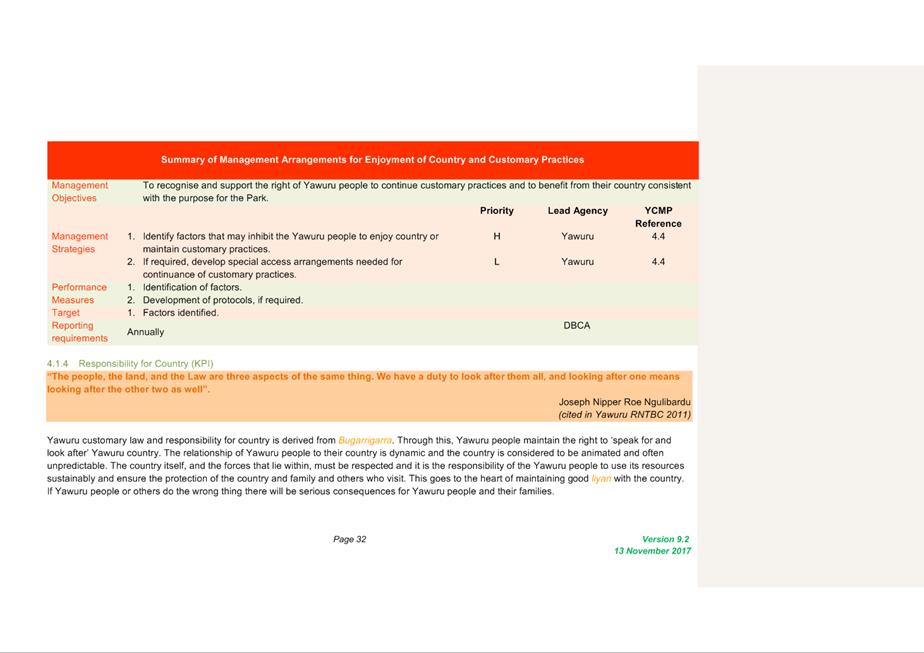
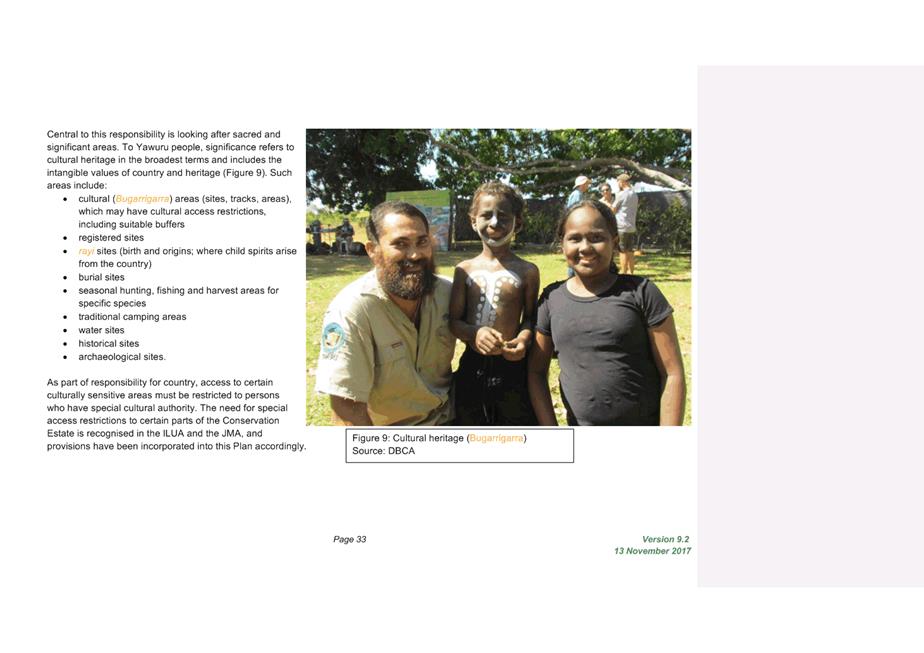

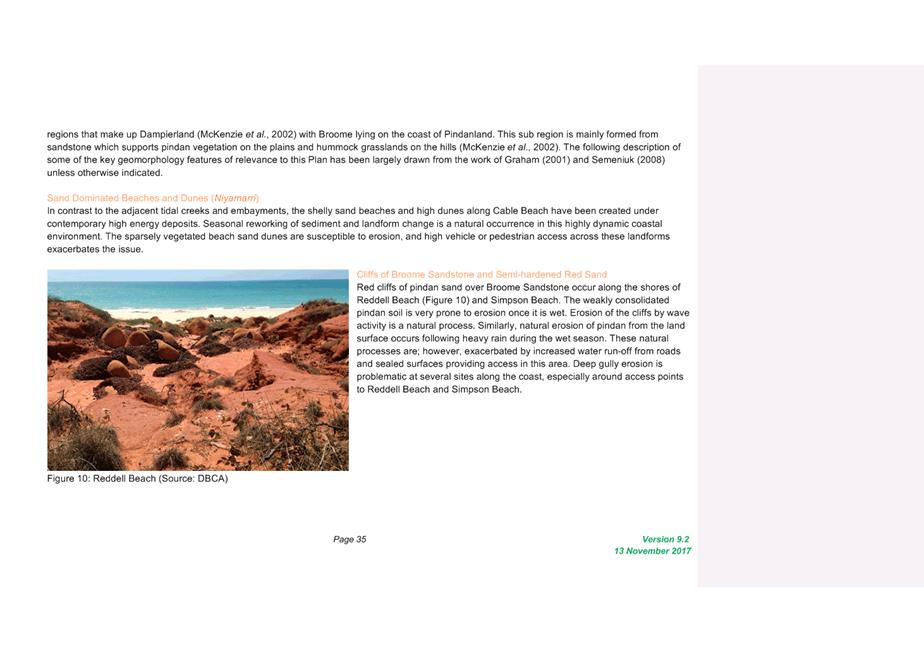

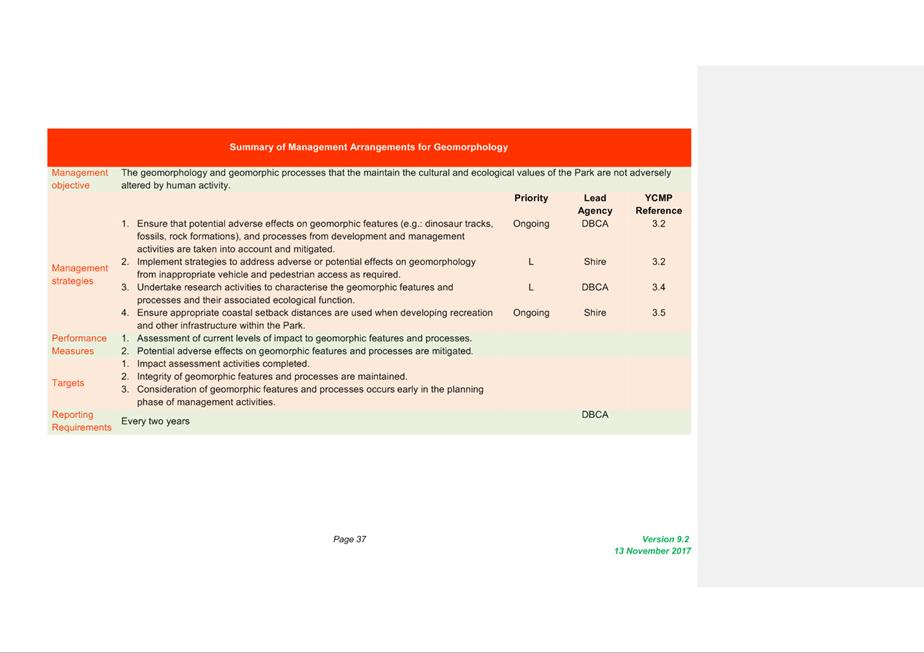
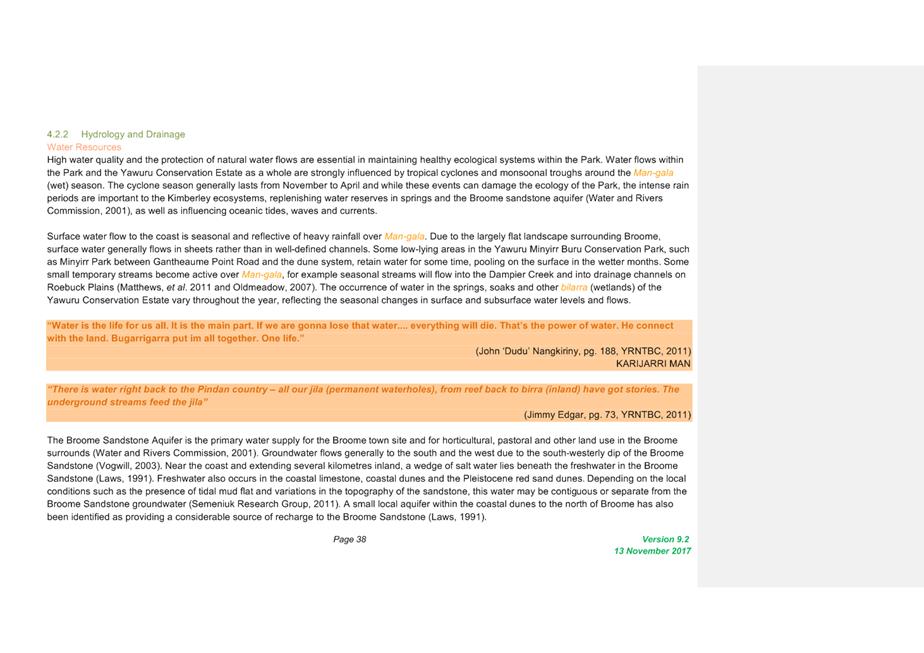



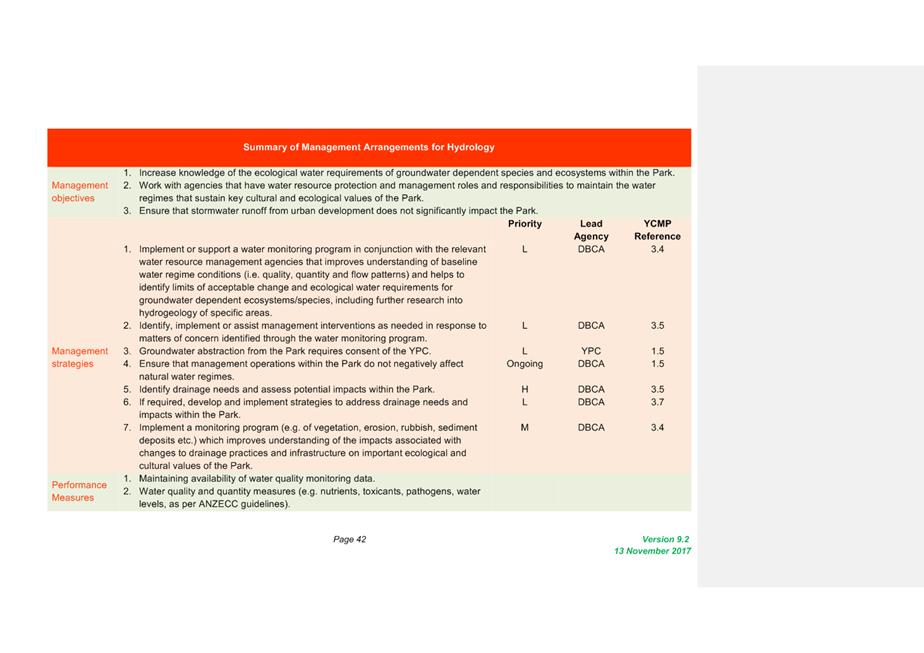
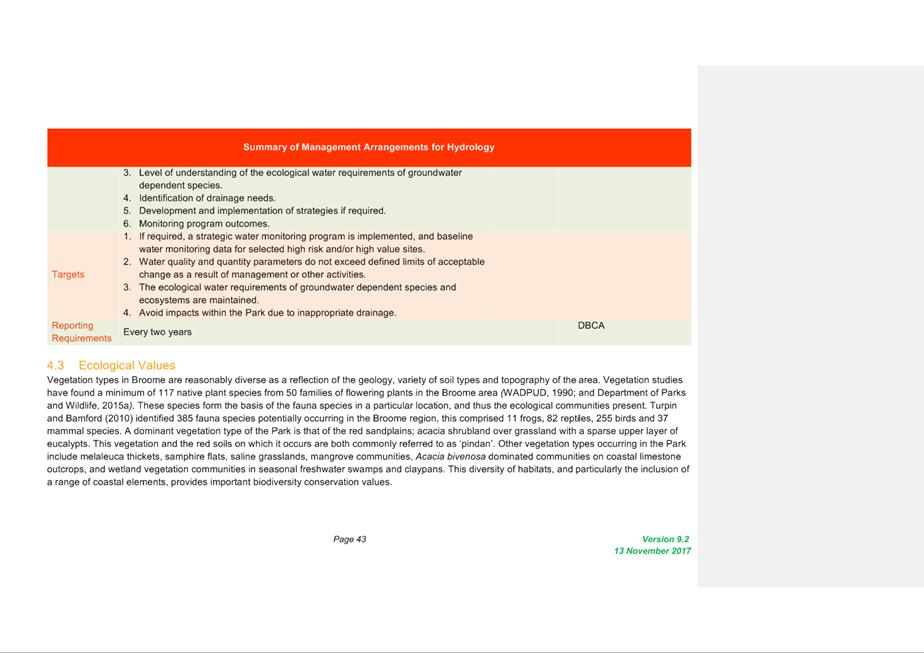

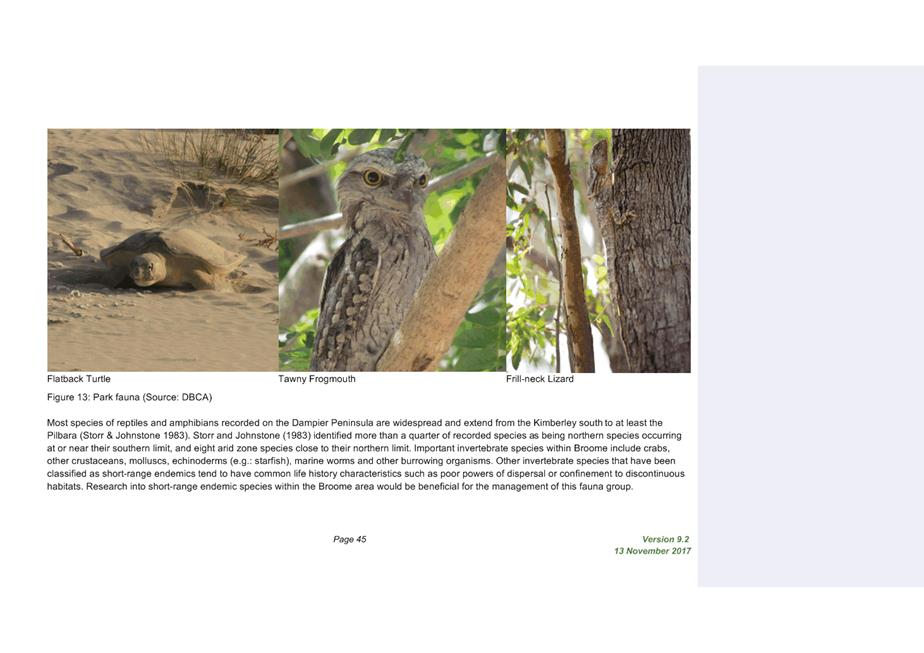



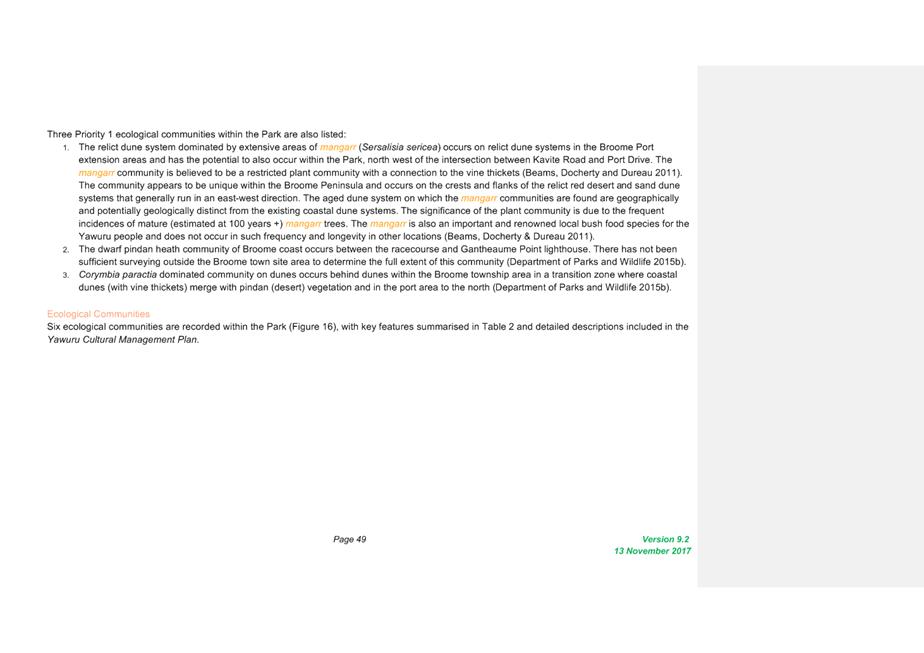
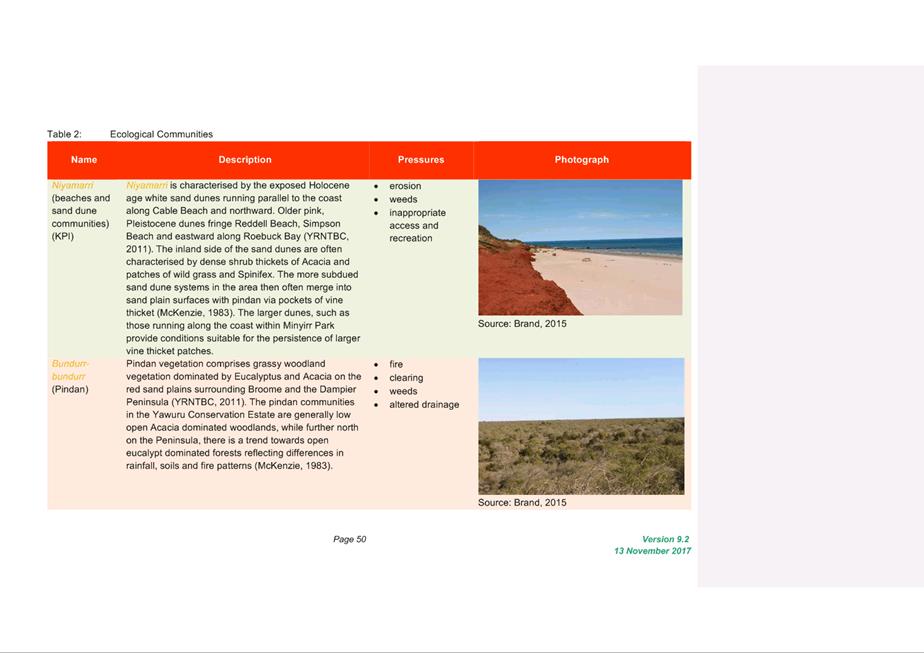

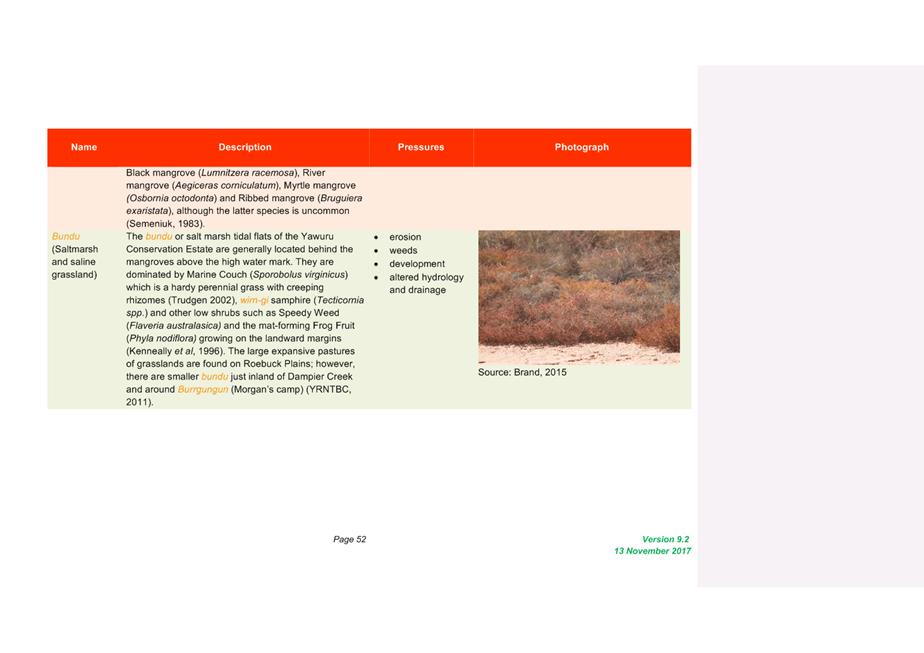
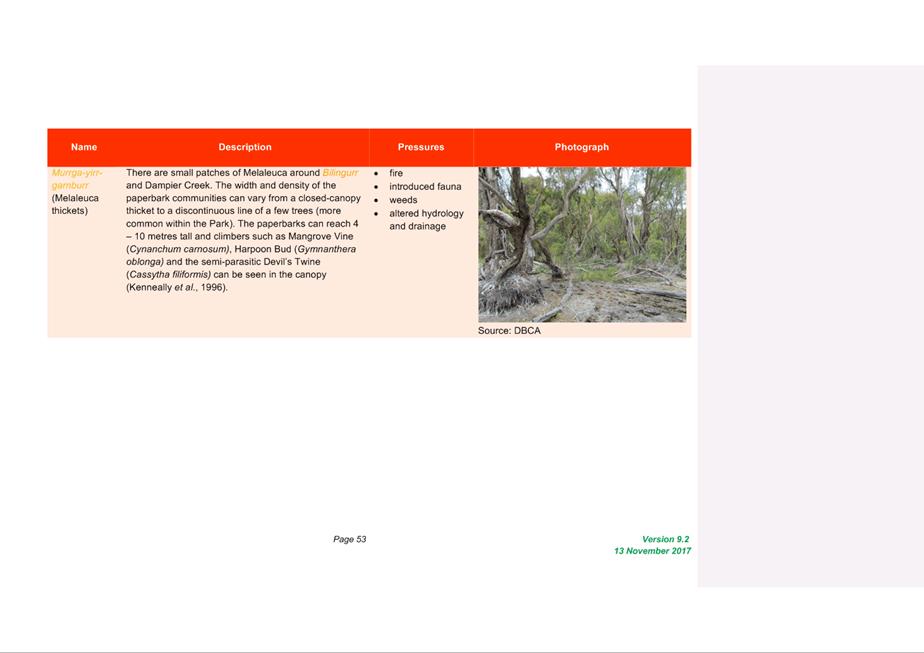

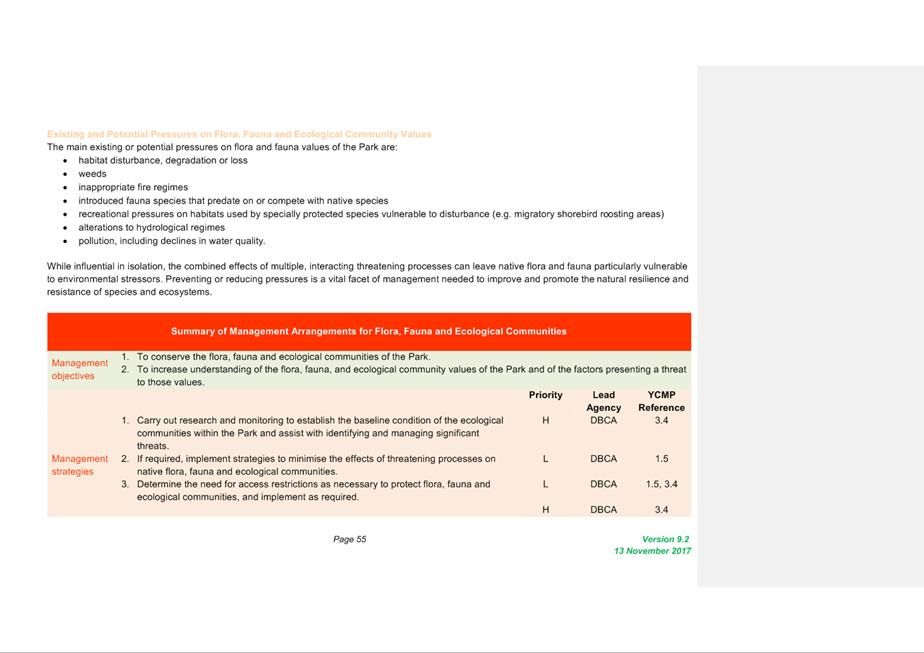


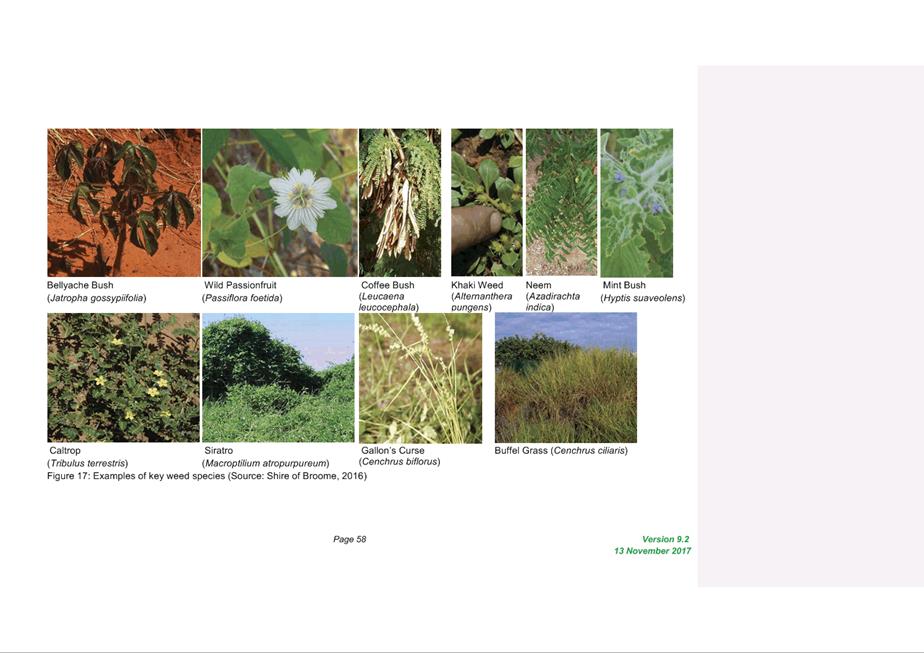

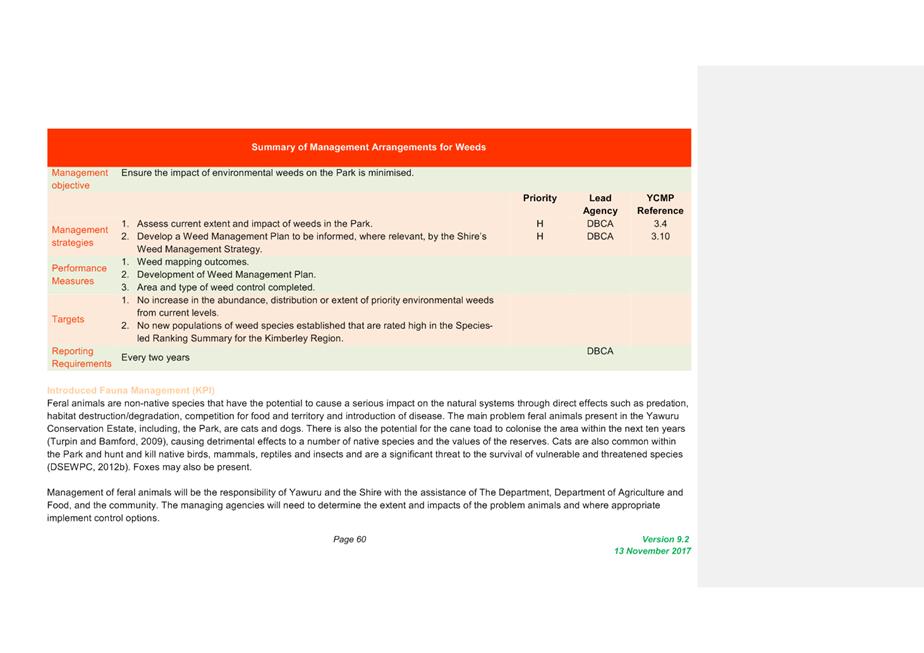
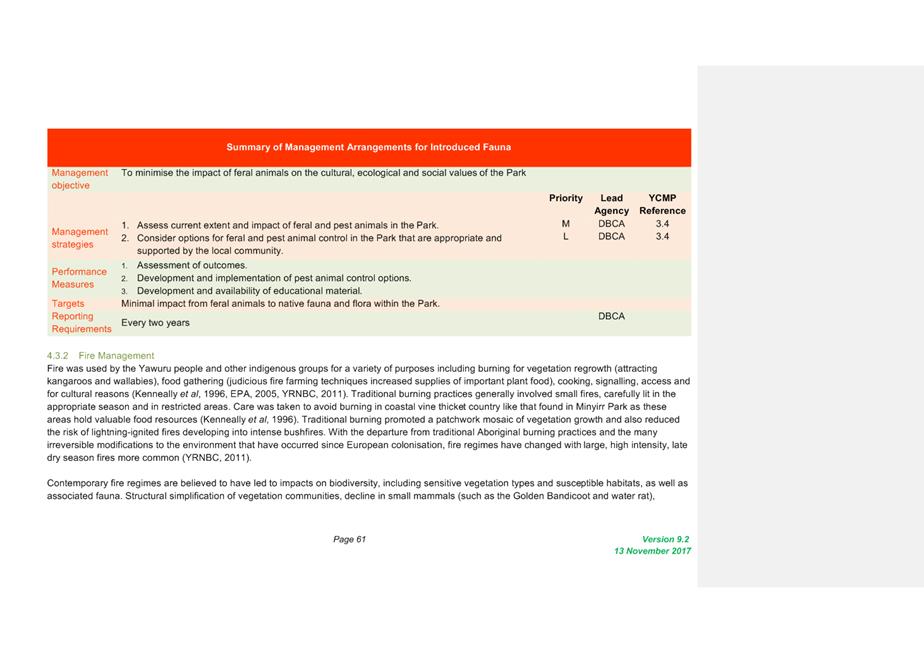

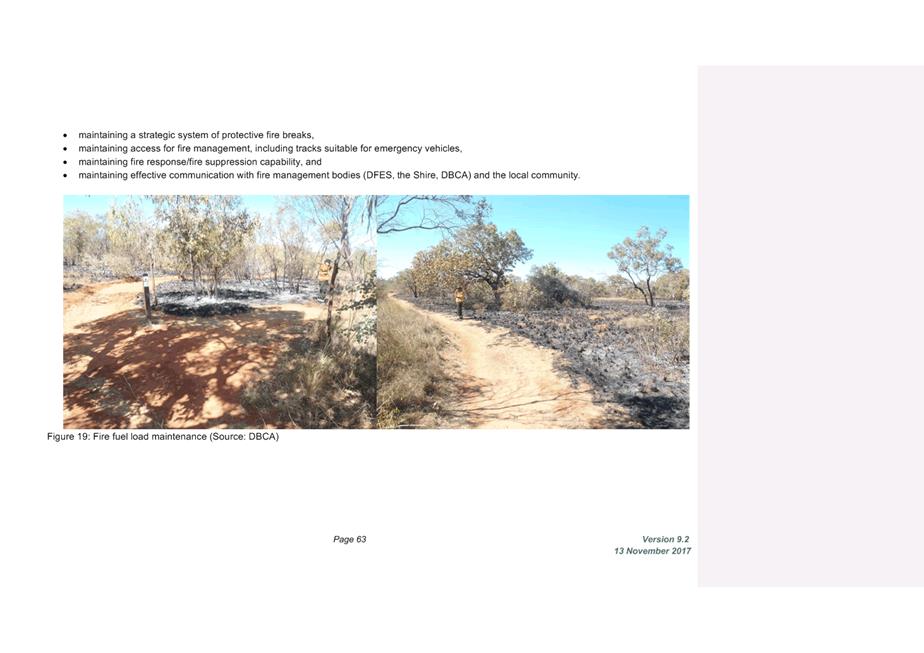
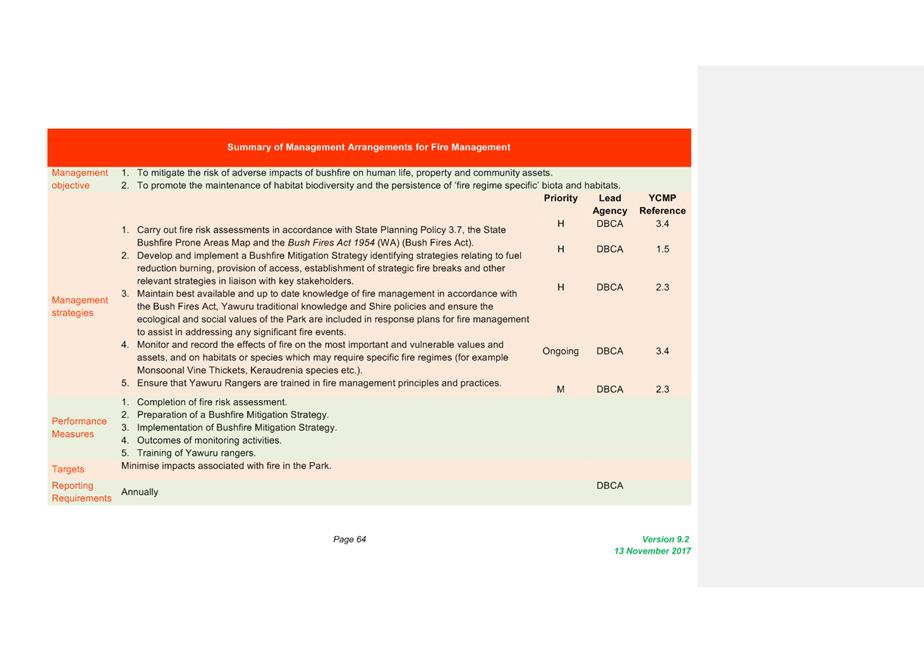

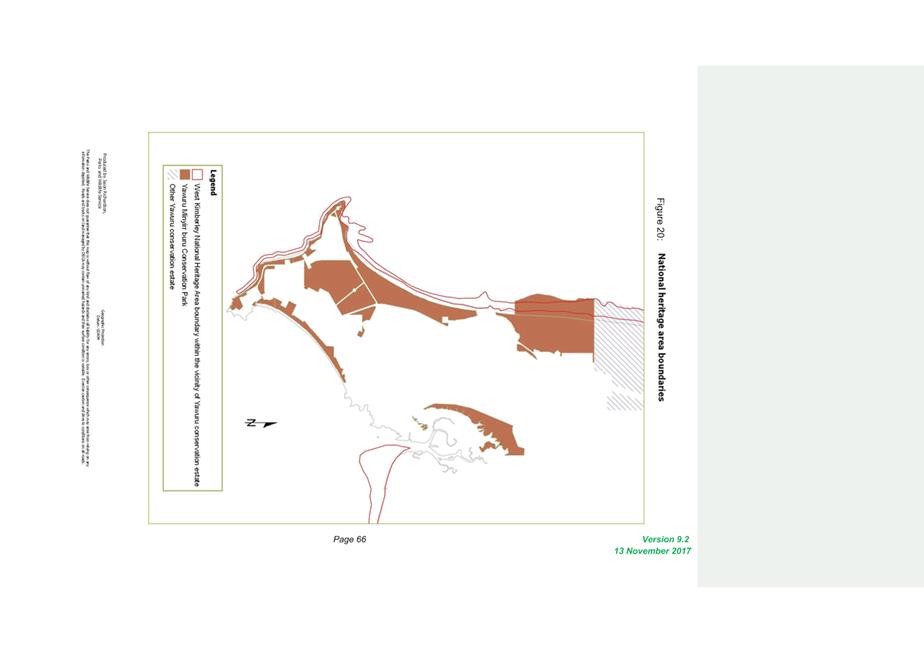

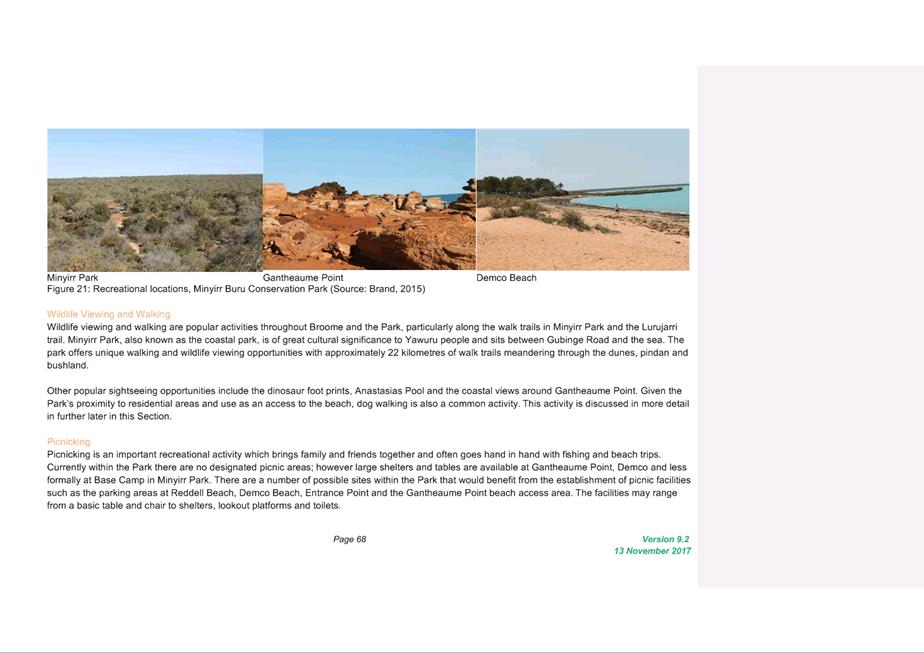

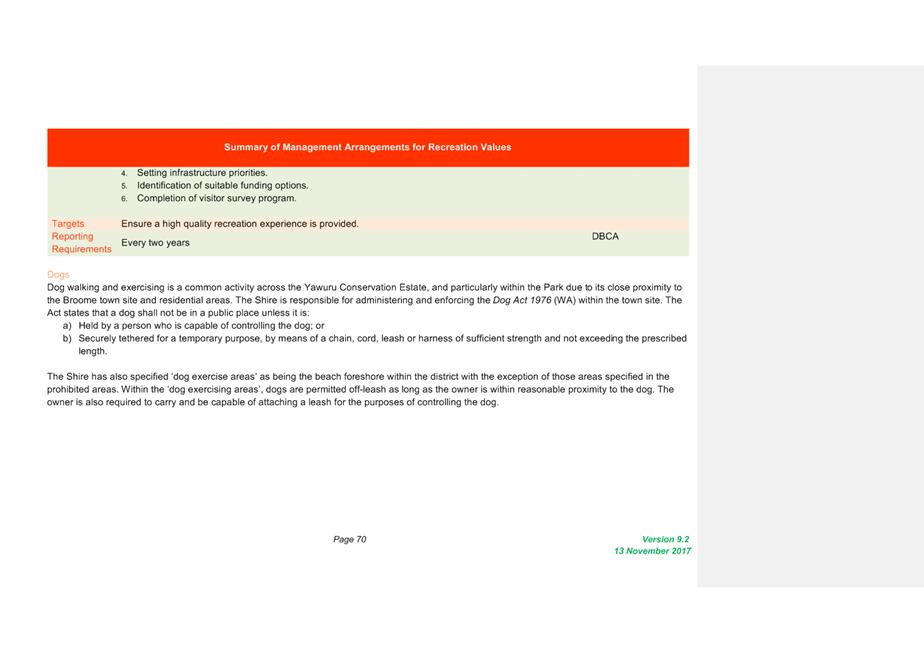
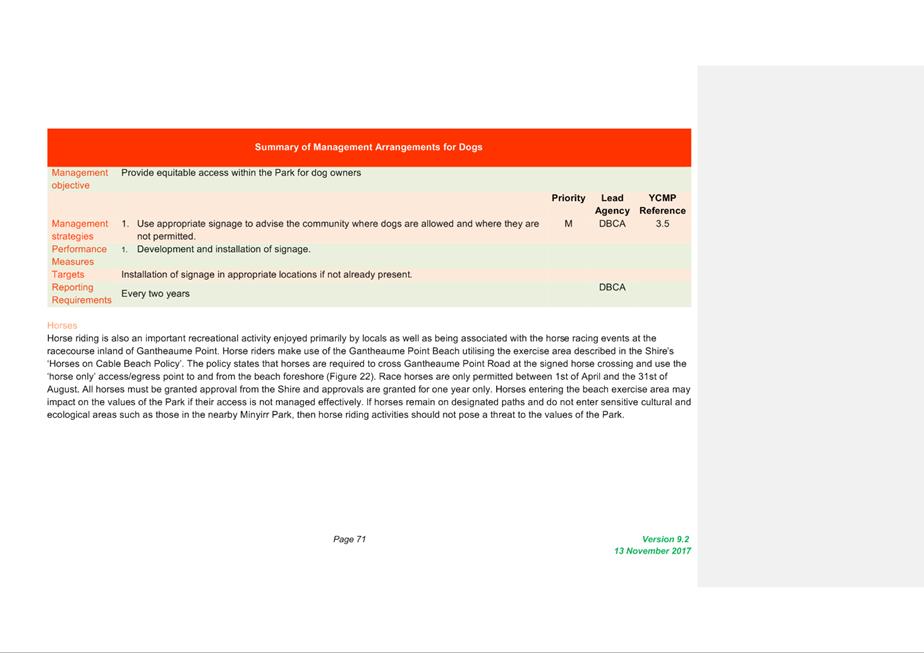
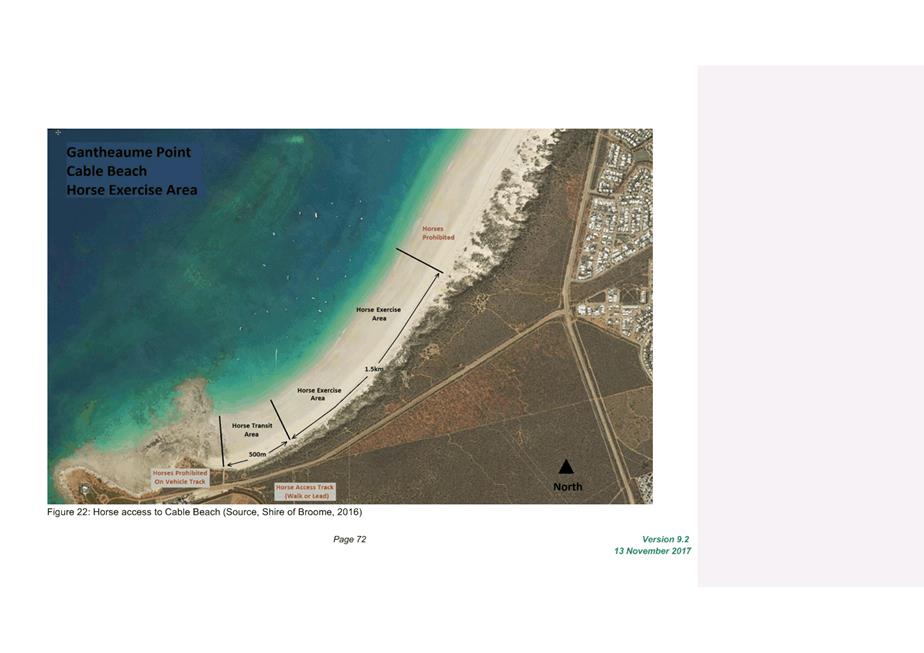
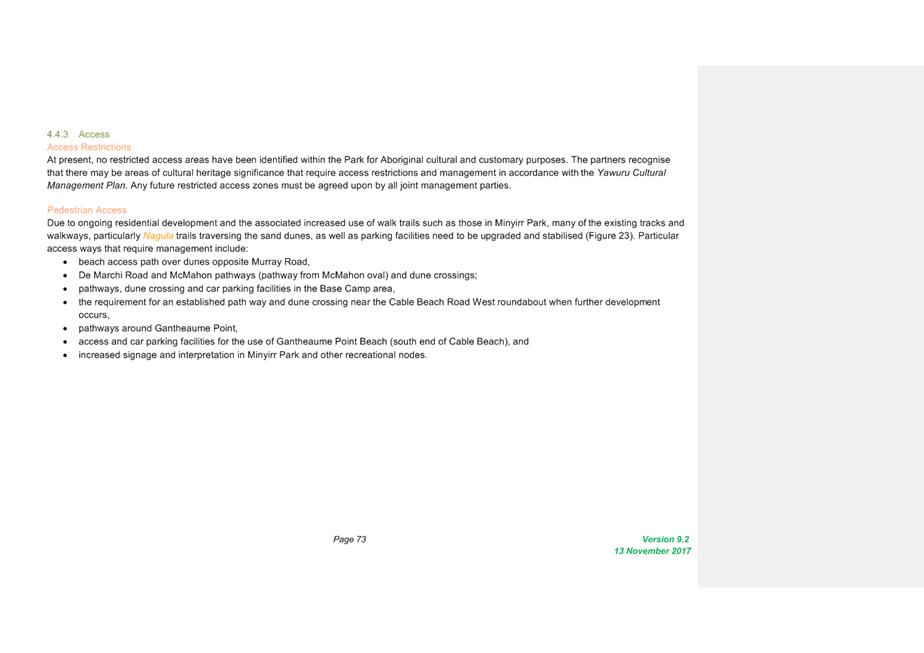
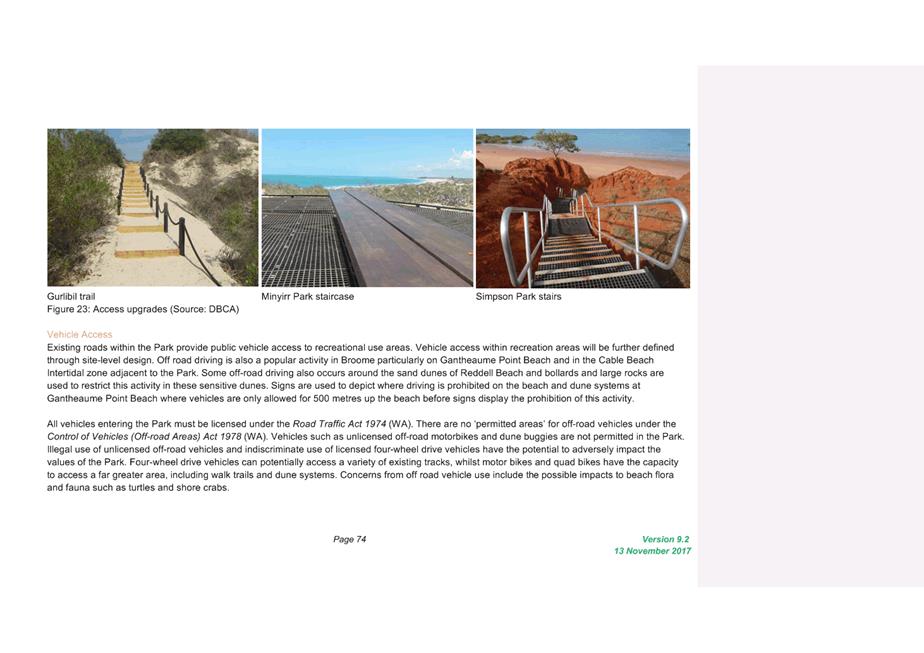
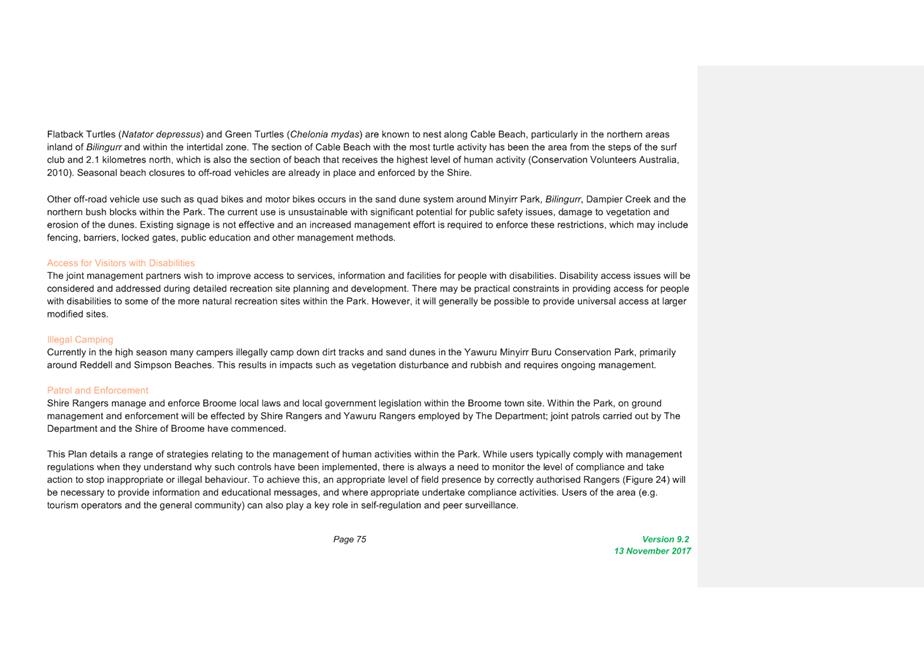
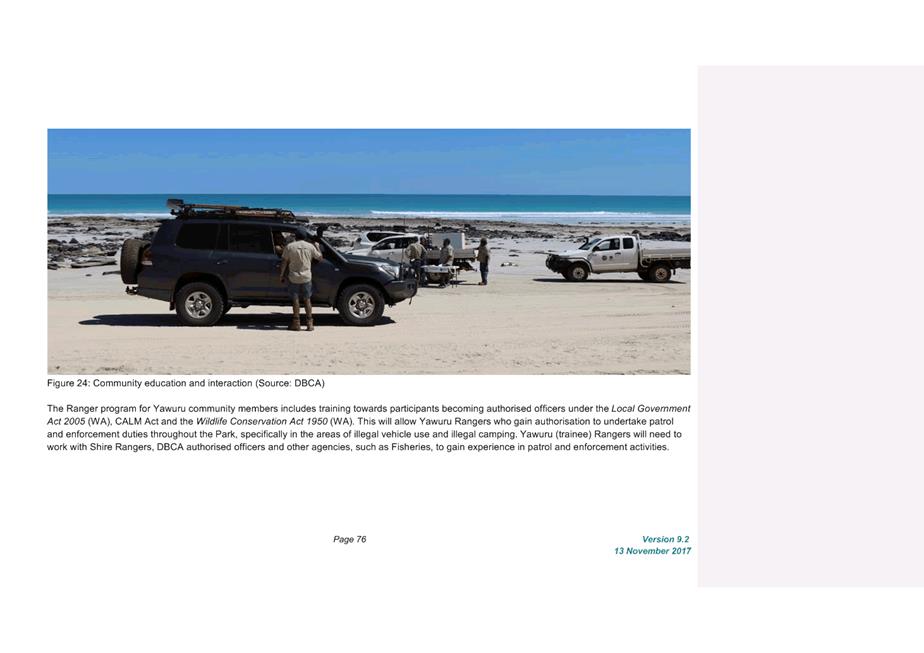
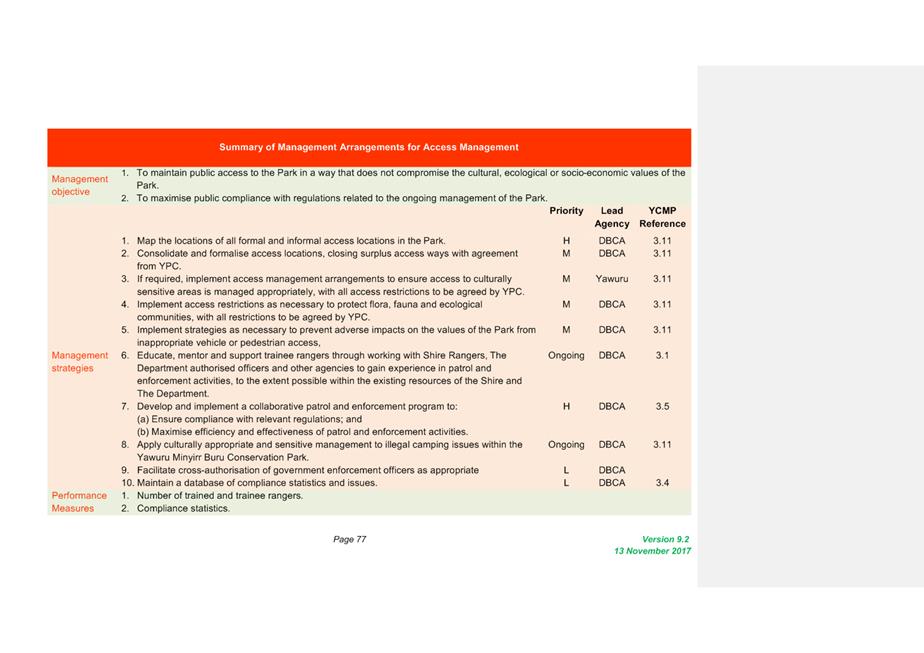
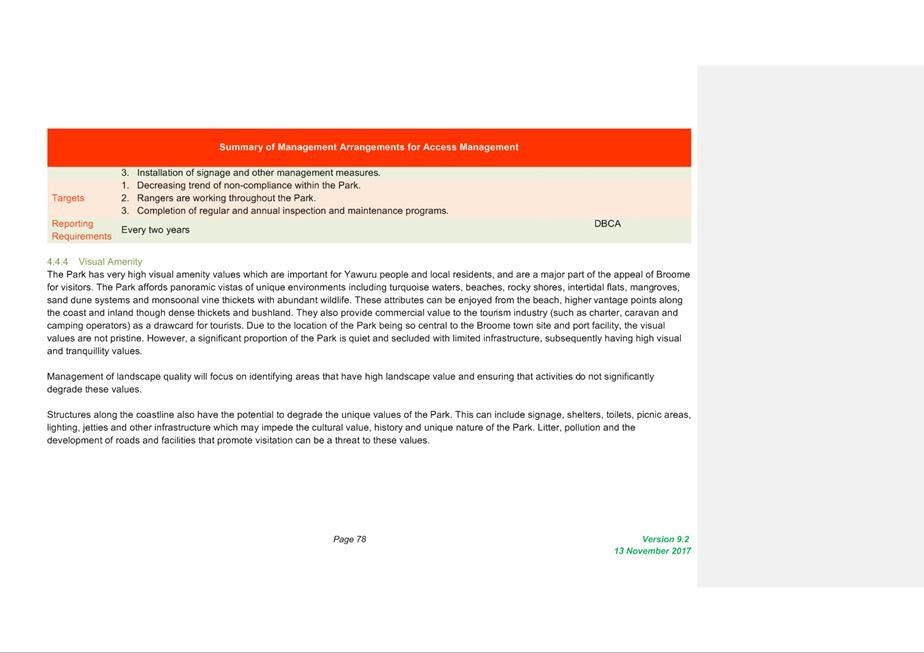
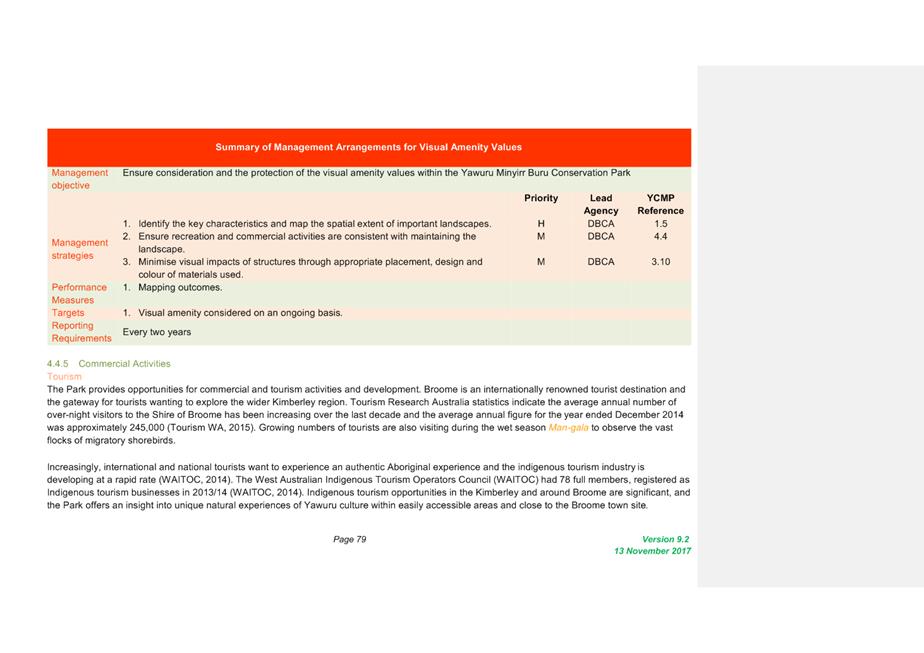
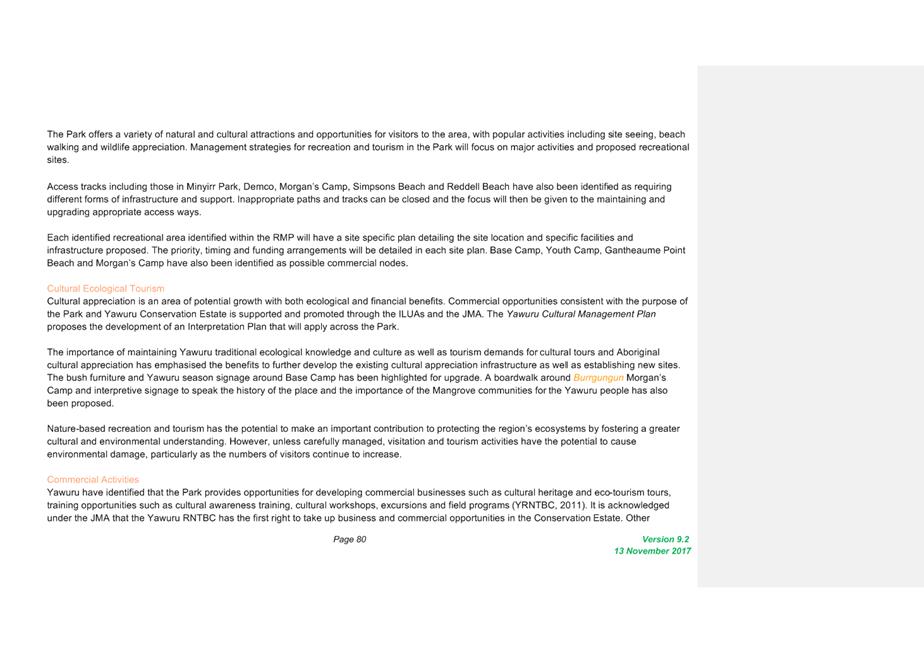
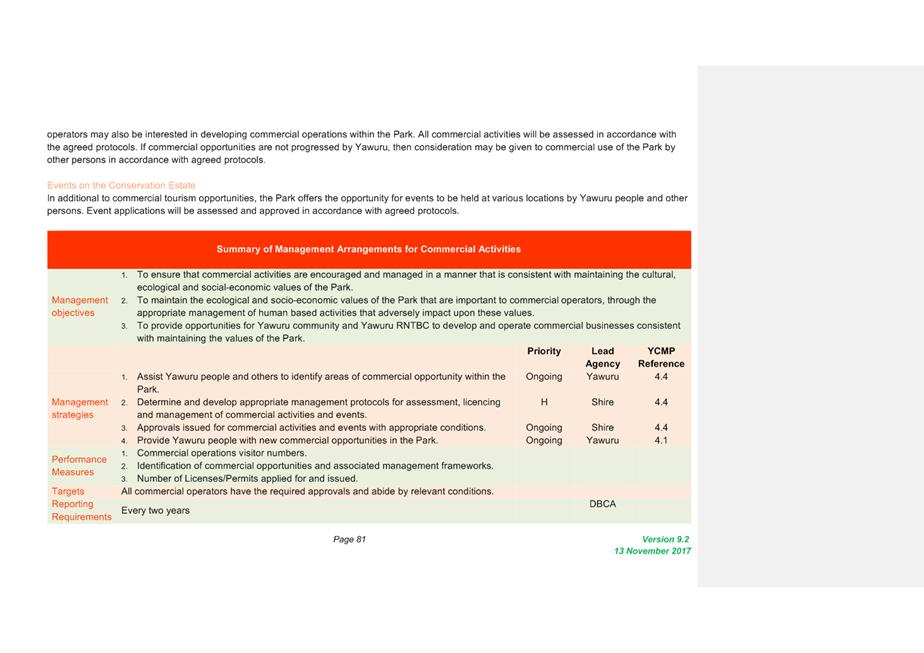




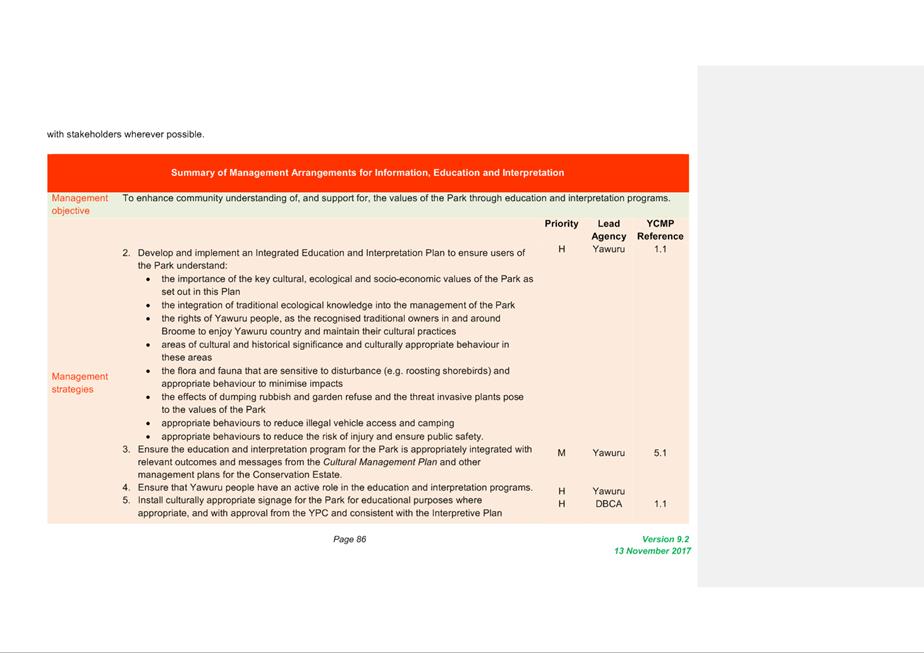
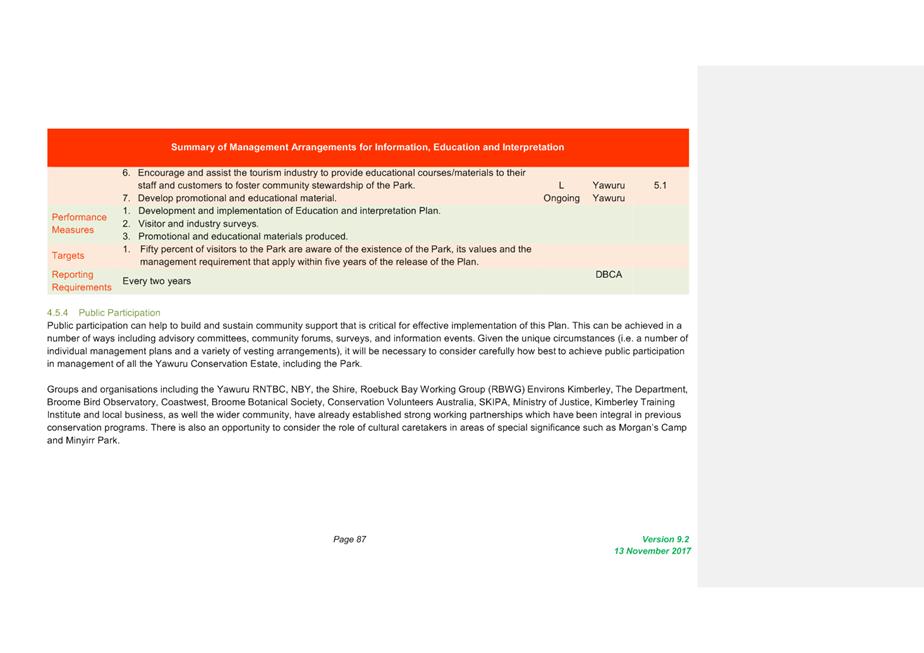

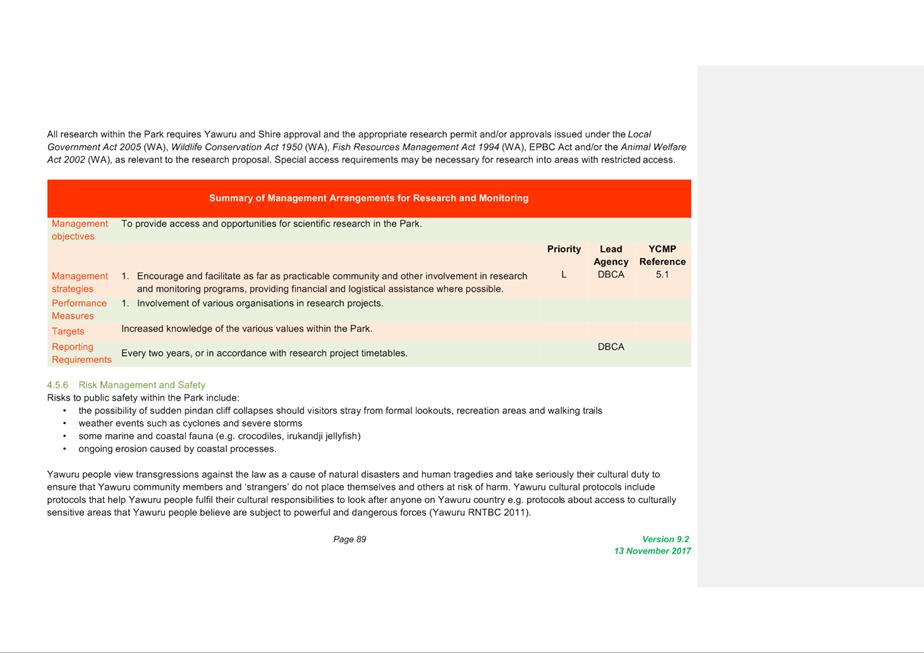
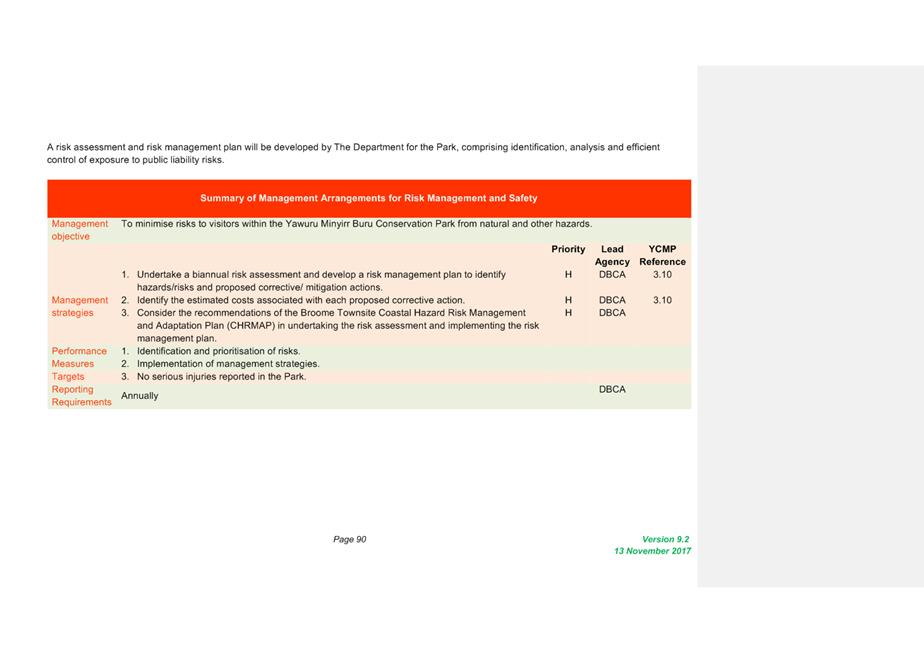
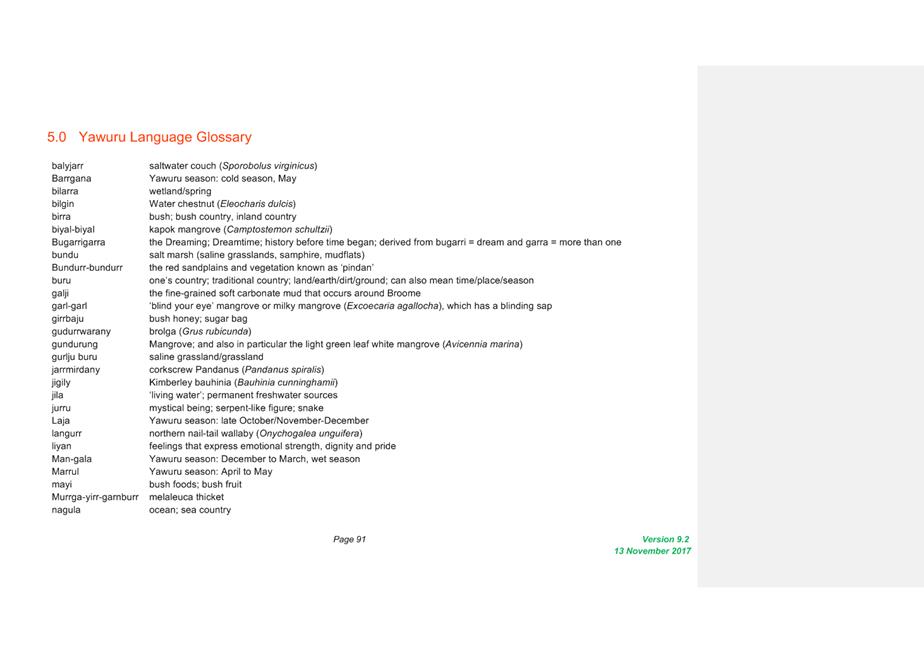

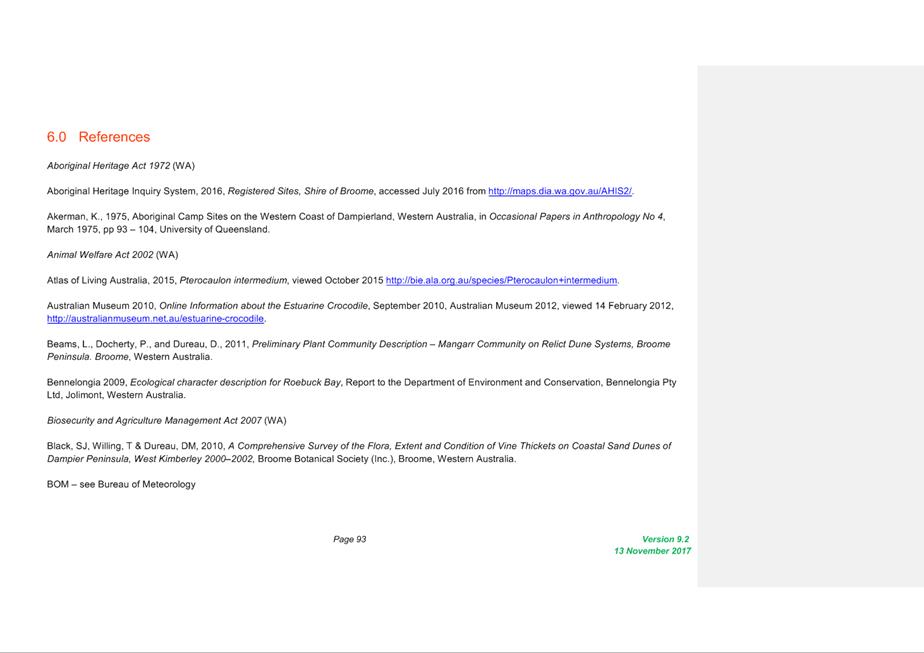
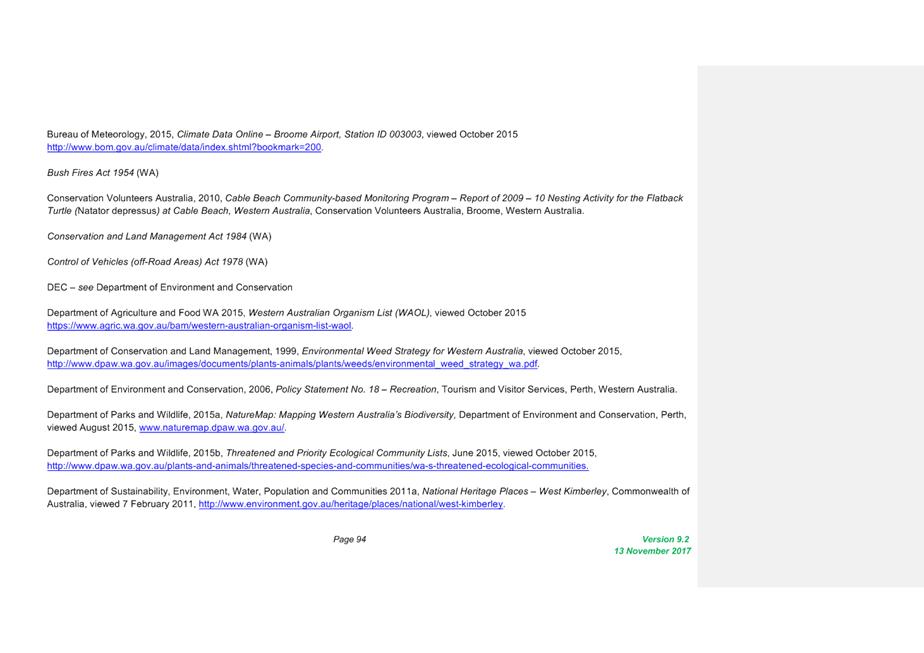
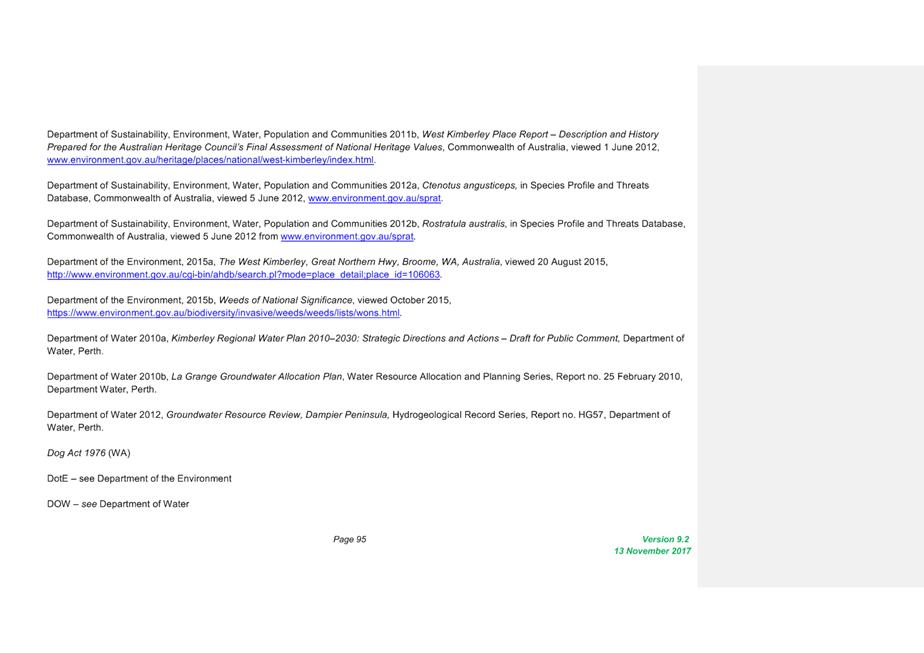
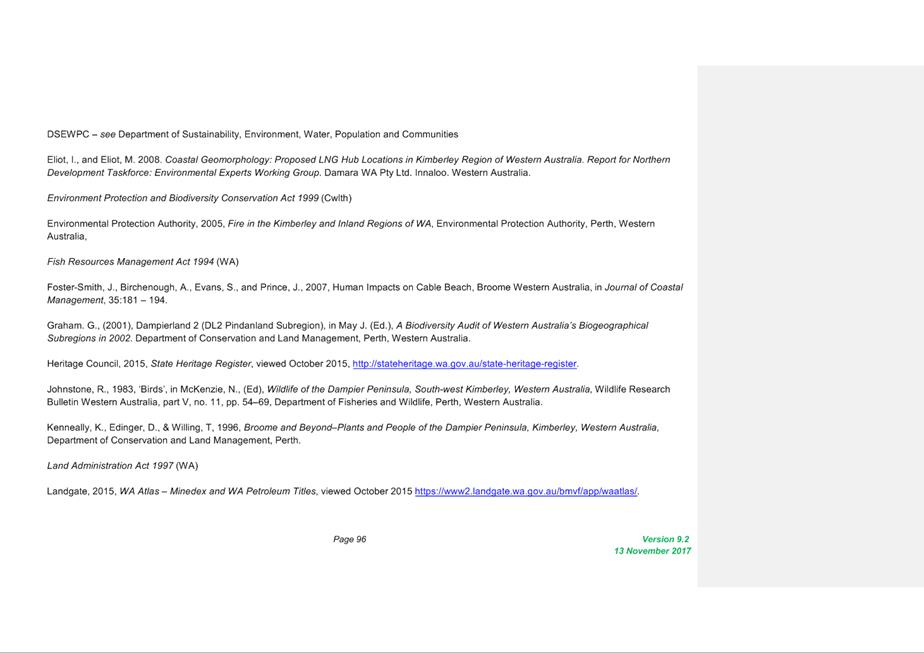

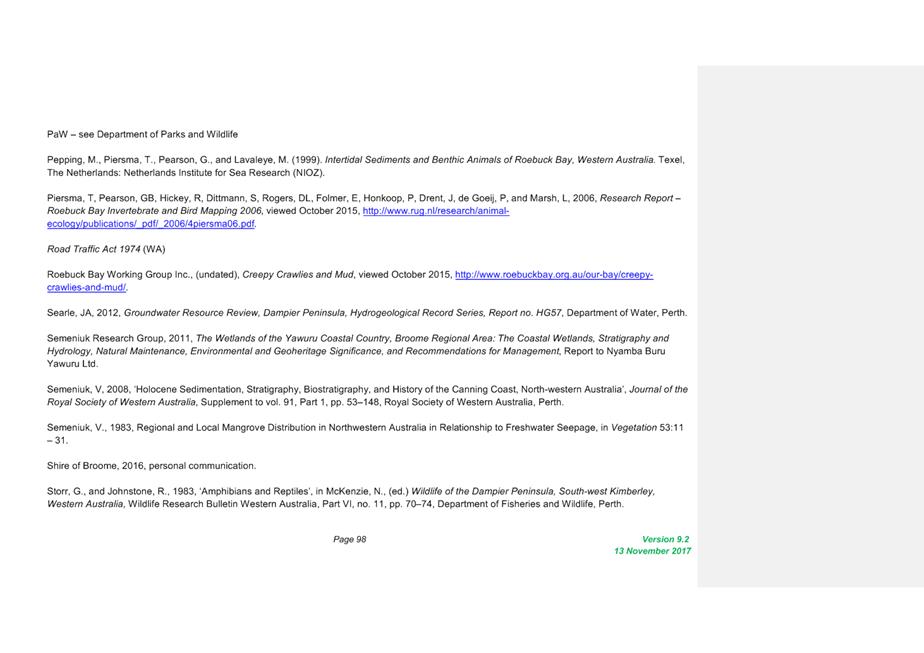
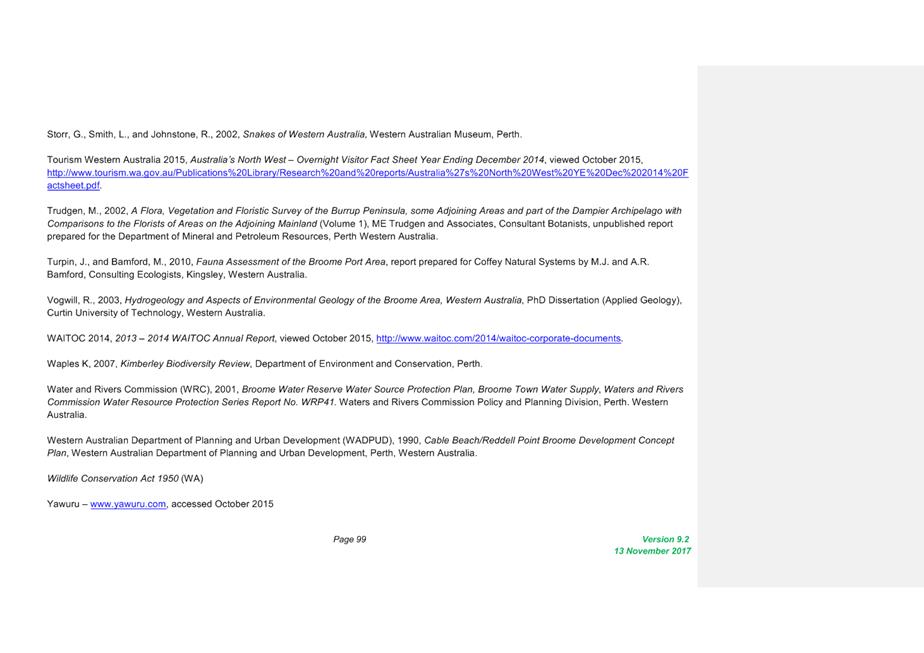
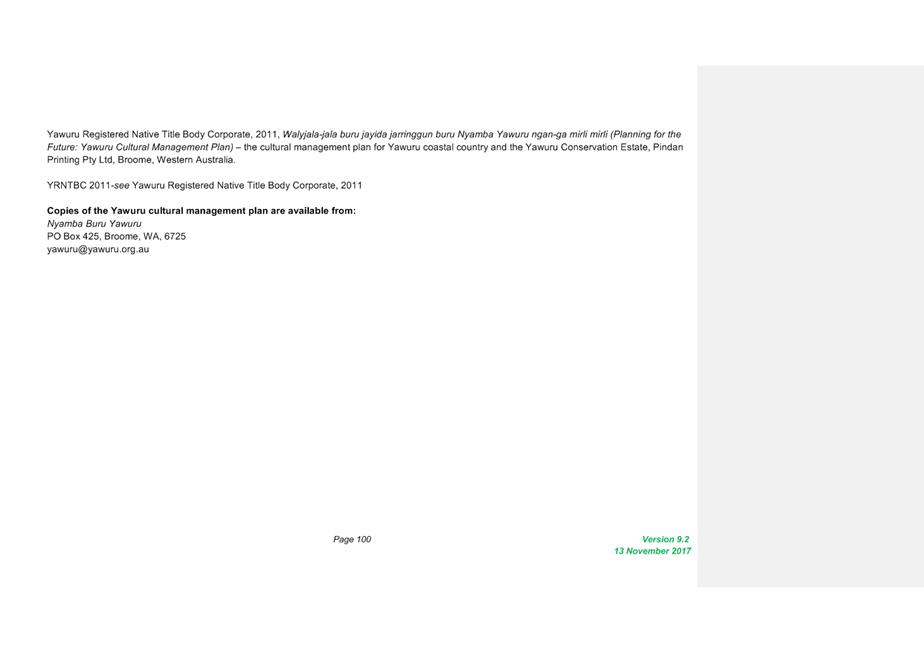
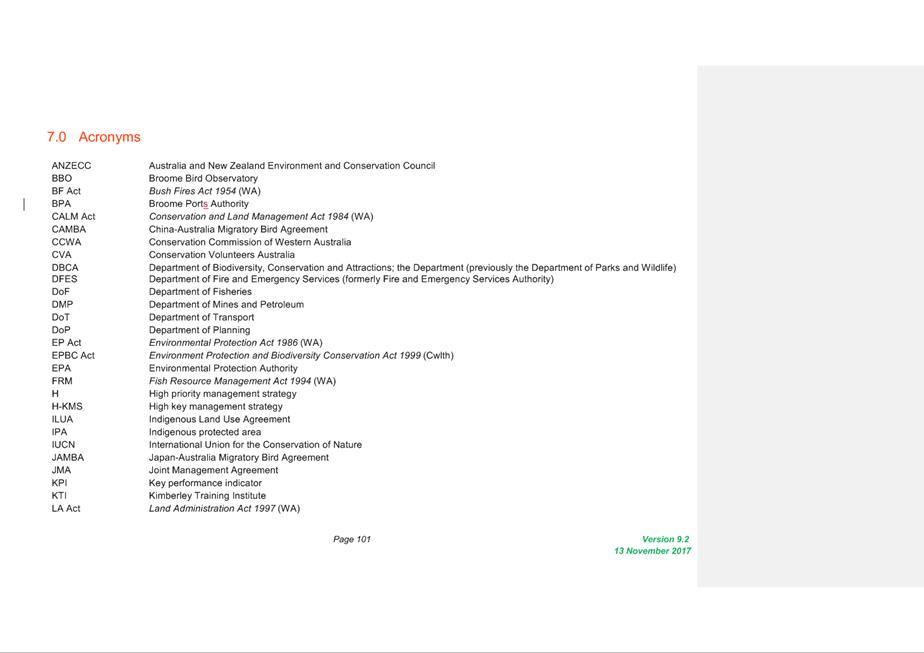
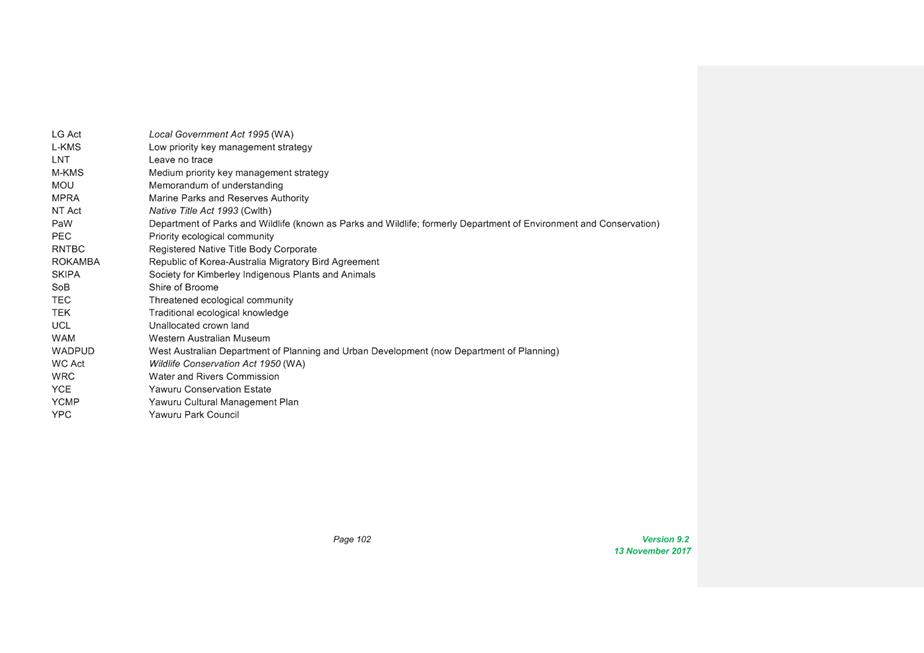

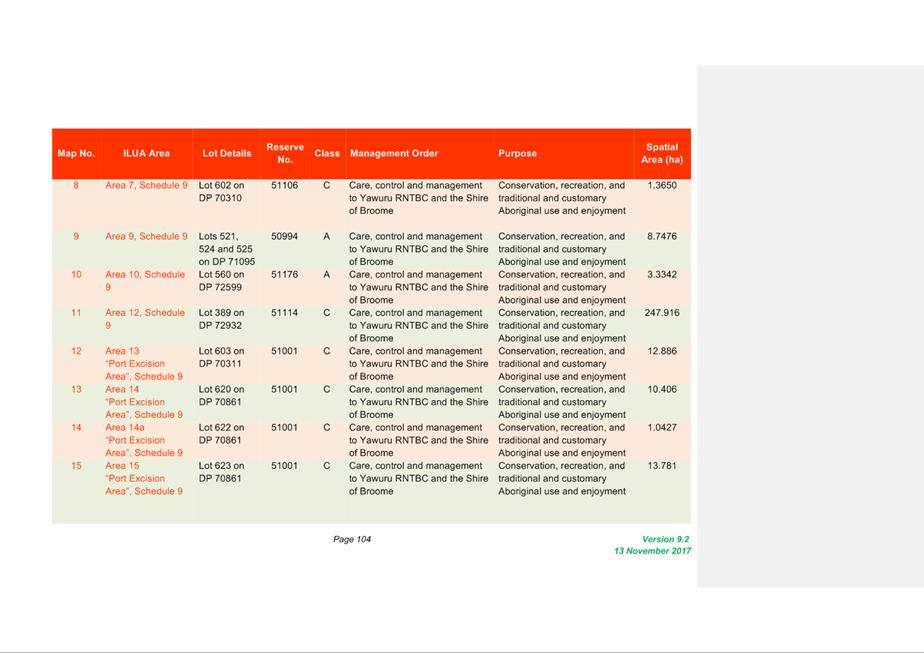
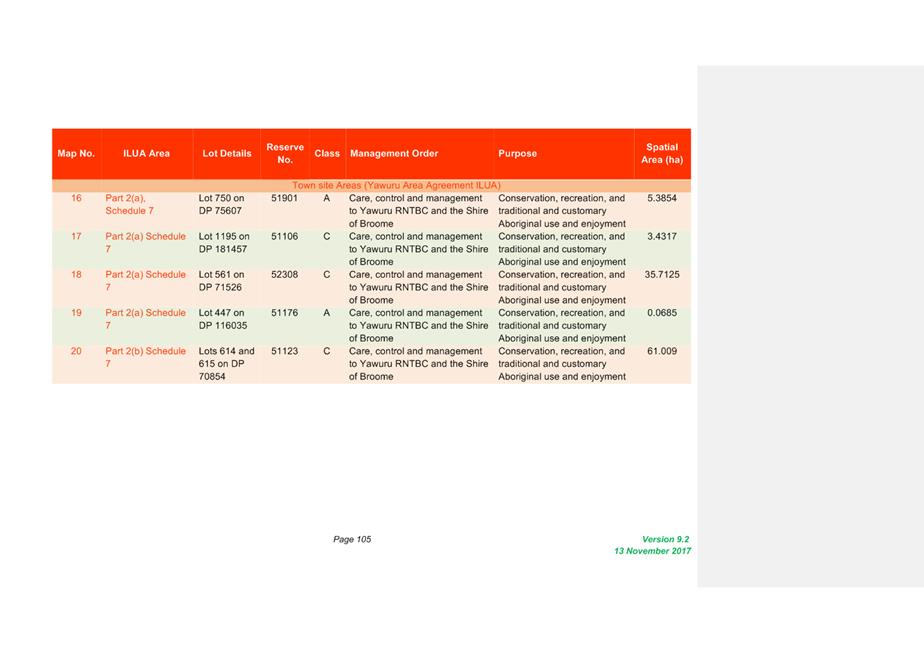
|
Item 10.3 - Yawuru
Park Council minutes and recommendations of meetings held on 17 October, 15
November and 20 December 2017.
|

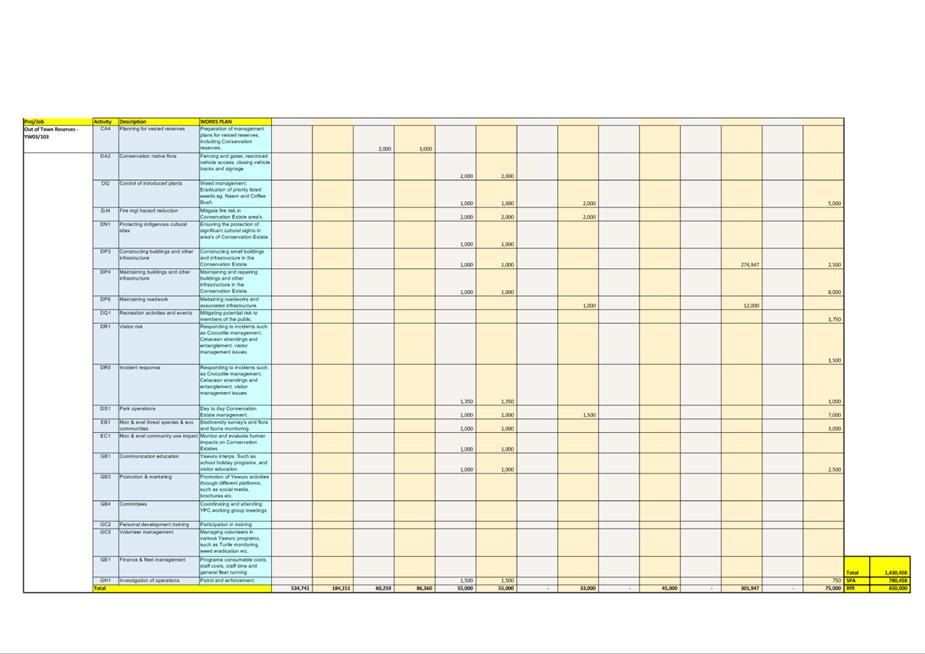
Minutes –
Ordinary Meeting of Council 22 February 2018 Page 1148 of 1227
|
10.4 MINUTES OF THE AUDIT
AND RISK COMMITTEE MEETING HELD 13 FEBRUARY 2018
LOCATION/ADDRESS: Nil
APPLICANT: Nil
FILE: FRE02
AUTHOR: Manager
Financial Services
CONTRIBUTOR/S: Nil
RESPONSIBLE
OFFICER: Director
Corporate Services
DISCLOSURE
OF INTEREST: Nil
DATE OF REPORT: 13
February 2018
|
|
SUMMARY: This
report presents to Council the outcomes of the Audit and Risk
Committee’s meeting held 13 February 2018 and seeks consideration of
adoption of the recommendations pertaining to the Compliance Audit Return
2017, the Audit Regulation 17 Improvement Plan Biannual Progress Report and
the Quarter 2 Finance and Costing Review (FACR).
|
BACKGROUND
Previous
Considerations
Compliance
Audit Return 2017
OMC 23 March 2004 Item
9.1.3
OMC 22 March 2005 Item
9.1.2
OMC 11 April 2006 Item
9.1.4
OMC 15 March 2007 Item
10.4
OMC 13 March 2008 Item
10.1
OMC 24 March 2009 Item
10.3
OMC 18 March 2010 Item
10.1
OMC 17 March 2011 Item
10.2
OMC 15 March 2012 Item
9.4.2
OMC 21 March 2013 Item
10.2
OMC 27 February 2014 Item
10.4
OMC 26 February 2015 Item
10.1
OMC 25 February 2016 Item
10.3
OMC 23 February 2017 Item
10.3
Audit
Regulation 17 Improvement Plan Biannual Progress
SMC 27
June 2014 Item
9.4.6
OMC 28
August 2014 Item
10.2
OMC 27
November 2014 Item 10.3
OMC 2
June 2015 Item
10.1
OMC 26
May 2016 Item
10.3
OMC 23
February 2017 Item
10.3
OMC 25
May 2017 Item
10.1
2017/2018
Quarter 2 Finance and Costing Review
OMC 29 June 2017 Item
9.4.4
OMC 19 Oct 2017 Item
9.4.3
Compliance
Audit Return 2017
Section 7.13(1)(i) of the Local
Government Act 1995 requires that each local government carry out a
compliance audit for the period 1 January to 31 December each year. The
Compliance Audit is an in-house self audit that is undertaken by staff.
In accordance with Regulation 14 of
the Local Government (Audit) Regulations 1996 the Audit and Risk
Committee is to review the Compliance Audit Return (CAR), and is to report to
Council the results of that review. The CAR is to be:
1. presented
to an Ordinary Meeting of Council
2. adopted
by Council; and
3. recorded
in the minutes of the meeting at which it is adopted.
Following the adoption by Council of
the CAR, a certified copy of the return, along with the relevant section of the
minutes and any additional information detailing the contents of the return are
to be submitted to the Department of Local Government Sport and Cultural
Industries (DLGSC) by 31 March 2018.
The return
requires the Shire President and the Chief Executive Officer (CEO) to certify
that the statutory obligations of the Shire of Broome have been complied with.
Audit
Regulation 17 Improvement Plan Biannual Progress
The Local Government Audit
Regulations 1996 (the Regulations) include reviewing the appropriateness
and effectiveness of a local government's Risk management systems and procedures.
Specifically, Audit Regulation 17 (Audit Reg. 17) requires the CEO to conduct a
review and report the results to the Audit and Risk Committee on the
effectiveness of risk management, internal control and legislative compliance.
The DLGSC Audit in Local Government Guideline No. 9 advises that the
review can be undertaken either on an internal or external audit basis.
Initially the Shire of Broome
appointed an external auditor to conduct a third party review of organisational
practices in accordance with updated legislation contained within Audit Reg.
17. The Audit Reg. 17 Review Audit produced a comprehensive Improvement Plan
separated into the three main compliance areas; Risk Management (RM),
Legislative Compliance (LC) and Internal Controls (IC).
The Shire’s Risk Technical
Advisory Group (Risk TAG) effect the framework components identified in the
Improvement Plan. The Risk TAG enables the Shire to fulfil its responsibilities
in relation to reporting on risk management, internal control, and legislative
compliance. The Improvement Plan action items contained within the Audit Reg.
17 Review Audit are allocated to members of the Risk TAG and prioritised in
accordance with organisational need and capacity. The Risk TAG meets monthly to
review and update specific actions contained in the Improvement Plan and report
to the Executive Management Group (EMG) and Council.
The biannual report is to identify
actioned items as detailed in the Improvement Plan. Actions are reported to the
Audit and Risk Committee in May and November each year, follownig endorsement
by EMG. Due to the Ordinary Local Government election being held in October
2017 and appointments to Committees not being considered until the November OMC
the presentation of the biannual report to the Audit and Risk Committee was
delayed.
2017/2018
Quarter 2 Finance and Costing Review
The Shire of
Broome has carried out its 2nd Quarter Finance and Costing Review (FACR) for
the 2017/18 Financial Year. This Review of the 2017-2018 Annual Budget is based
on actuals and commitments for the first three months of the year from 1 July
2017 to 31 December 2017, and forecasts for the remainder of the financial
year.
This process aims
to highlight over and under expenditure of funds for the benefit of Executive
and Responsible Officers to ensure good fiscal management of their projects and
programs.
Once this process
is completed, a report is compiled identifying budgets requiring amendments to
be adopted by Council. Additionally, a summary provides the financial impact of
all proposed budget amendments to the Shire of Broome’s adopted
end-of-year forecast, in order to assist Council to make an informed decision.
It should be
noted that the 2017/2018 annual budget was adopted at the Ordinary Meeting of
Council on 29 June 2017 as a balanced budget. There have been further
amendments adopted by Council as part of the Annual Financial Statements for
the use of additional carried forward surplus and as part of 1st
Quarter FACR. The result of all amendments prior to the 2nd Quarter
FACR is $43,601 deficit upon the Shire of Broome’s forecast end of year
position.
COMMENT
Compliance
Audit Return 2017
The CAR for the period 1 January to
31 December 2017 continues in a reduced format introduced in 2011 with
questions focused on high risk areas of compliance and statutory reporting as
prescribed in Regulation 13 of the Local Government (Audit) Regulations
1996. This year the CAR has been extended to
include 7 additional questions relating to Integrated Planning and
Reporting. These questions are optional.
The 2017 CAR includes a total of 94
questions and focuses on the following areas of compliance:
· Commercial
Enterprises by Local Governments
· Delegation of
Power/Duty
· Disclosure of
Interest
· Disposal of
Property
· Elections
· Finance
· Integrated
Planning and Reporting (optional)
· Local Government
Employees
· Official Conduct
· Tenders for
Providing Goods and Services.
The 2017 CAR has been completed in
consultation with officers responsible for the various areas contained in the
return, and reviewed by the Executive Management Group and the CEO.
The 2017 Compliance Audit reveals a
compliance rating of 100%. This compares to:
2016
Compliance Audit – 1 area of non-compliance of the 87 areas audited
(98.8%)
2015 Compliance
Audit – 0 areas of non-compliance of the 87 areas audited (100%)
2014
Compliance Audit – 1 area of non-compliance of the 78 areas audited
(98.7%)
2013 Compliance
Audit – 0 areas of non-compliance of the 78 areas audited (100%)
2012 Compliance
Audit – 8 areas of non-compliance of 78 areas audited (89.7%)
2011
Compliance Audit – 1 area of non-compliance of 78 areas audited (98.7%)
2010
Compliance Audit – 1 area of non-compliance of 283 areas audited
(99.6%)
2009 Compliance
Audit – 4 areas of non-compliance of 347 areas audited (98.8%)
2008
Compliance Audit – 2 areas of non-compliance of 311 areas audited
(99.4%
2007
Compliance Audit – 13 areas of non-compliance of 271 areas audited
(96.1%)
2006
Compliance Audit – 21 areas of non-compliance of 271 areas audited
(92.3%)
2005
Compliance Audit – 23 areas of non-compliance of 306 areas audited
(92.5%)
2004
Audit – 18 areas of non-compliance and 147 areas audited (87.8%).
Audit
Regulation 17 Improvement Plan Biannual Progress
There are a number of actions that
are completed or in progress with full details contained in the attached
Improvement Plan. The following items have been actioned from May 2017 to
January 2018 in accordance with the Improvement Plan:
|
No.
|
Framework Components
|
|
RM1.1
|
Bi-Annual Risk Reporting
Officer Comment: Bi-annual
reports to EMG and Council are provided through the Audit and Risk Committee
as per Risk Management Policy 2.1.4
|
|
RM3.3
|
Business Continuity Plan
Officer Comment: Draft document
requires final review and amendments to ensure suitability and effectiveness.
To be presented to the Audit and Risk Committee in May 2018.
|
|
RM3.6
|
Local Emergency Management Plan
2014 Draft
Officers Comment: Following
training provided on Managing Recovery Activities the Local Emergency
Management Plan is being reviewed and will be tested once finalised.
|
|
RM3.8
|
Workforce Plan
Officer Comment: The Workforce
Plan is under review. Please note organisational risks have been identified
in the external analysis section 2.1.1-2.1.15 and internal analysis section
3.3.1-3.3.14 and again in Workforce Planning 4.1.1 page 47. In order to
satisfy the auditors, the risk section will itemise the known risks under
4.5.9 organisational risk management. An organisational survey was completed
in late 2017 and will be used to form the basis of the review. Revised
completion date of November 2018.
|
|
RM3.9
|
Infrastructure Asset Management
Plans
Officer Comments: Plans prepared
in 2017 and received by Council at the December 2017 OMC.
|
|
RM3.12
|
Emergency Response Procedures Shire
Buildings
Officer Comment:
Organisational responsibility for this action currently being reviewed. Procedures
have been drafted for the Administration Building however require a review
following the refurbishment.
|
|
RM3.15
|
Volunteer and Contractor Inductions
Officer Comment: Volunteer
inductions provided. Contractor Induction documentation has been reviewed by
LGIS. Existing contractors required to attend induction in February 2018.
|
|
RM4.1
|
Audit and Risk Committee
Officer
Comment: Risk Profiles implemented. External Risk Audit to be
undertaken by external auditor in December 2018.
|
|
RM4.2
|
Monitoring Compliance
Officer Comment: This has been
amended to an ongoing action.
|
|
RM4.4
|
Risk Register
Officer Comment: Risk Profiles
have been developed and implemented. Electronic systems are being
investigated to further streamline the process and provide improved visibility
and management of identified risks.
|
|
RM4.5
|
EMG Minutes
Officer Comment: Process in place to ensure that EMG
Minutes are recorded to Synergy Central Records System. All 2017 meeting
minutes have been recorded to Synergy. EMG minutes will continue to be
recorded to Synergy.
|
|
RM5.2
|
Training
Officer Comment: Risk Management
Training funds assigned through annual budget process for 17/18.
|
|
LC1.1
|
Code of Conduct
Officer Comment: Revised Code of
Conduct is being drafted and will include volunteers and contractors. To be
presented to Council in April.
|
|
LC 5.2
|
EMG Minutes
Officer Comment: Process in
place to ensure that EMG Minutes are recorded to Synergy Central Records
System. All 2017 meeting minutes have been recorded to Synergy. EMG
minutes will continue to be recorded to Synergy
|
|
LC5.3
|
Employee Complaints/Grievance
Handling
Officer Comment: Employee
complaints are addressed by the Manager of HR. This action will be reviewed
as a priority on commencement of the Manager People and Culture.
|
|
IC2.1
|
Management Policy – Internal
Controls
Officers Comment: Internal
Control Framework developed and in operation however leaving open until
process is firmly established and embedded in across the organisation.
|
|
IC2.2
|
Private and Community Works Policy
Officer Comment: The Finance
Department have developed an internal finance procedure to ensure private
works are only undertaken after an appropriate written agreement (signed
letter or purchase order) has been received.
|
|
IC2.3
|
Internal Audit
Officers Comment: The Senior
Procurement, Risk and Governance Officer will coordinate an internal audit.
|
|
IC3.2
|
Staff Training
Officers Comment: Inductions and
specific on the job training for internal control areas i.e. cash handling,
stock control as required. Training programmes to be developed for specific
areas e.g. BRAC, Civic Centre and others as identified.
Financial Services developed an
induction pack that includes relevant information for each function in
Finance.
Governance, Records and IT
inductions are undertaken with designated employees on their commencement.
Other inductions are undertaken as requested. Information sessions on
local government and the Local Government Act were held with internal and
external staff in November 2017.
|
|
IC3.3
|
Documented Procedures
Officers Comment: Standard
operating procedures exist for selected, but not all, financial procedures.
Procedure documentation is being developed by officers where it does not
currently exist.
|
|
IC3.7
|
Credit Card Procedures
Officer Comment: Only members of
the BEST team may utilise the credit cards and the details of the card are
not to be shared with others.
|
|
IC3.8
|
Checklists
Officer Comment: Checklists
exist and are in use by staff as part of endorsed procedures.
|
|
IC4.1
|
Monitoring
Officers Comment: December 2016
review completed by external consultant. While internal
review is recommended current staff resources do not permit the development
of an internal audit function. An external consultant will provide a biennial
review as per the Audit Reg 17 regulations with ongoing risk management
functions monitored by the Risk TAG. Next external audit review December
2018.
|
|
IC5.1
|
Ongoing Improvement Plan
Officers Comment: This
improvement plan forms the basis of an all inclusive continual improvement
process for all three areas.
|
|
Other
|
Lone Worker Risk Management
Officer Comment: Lone Worker
Risk Management consultation paper finalised. Procedure to follow.
CCTV
Officer Comment: BRAC and Depot
CCTV systems implemented to eliminate identified staff safety risks
|
This report recommends that Council
receive the updated Improvement Plan, and adopts the reviewed actions,
timelines and responsible officers contained within the document.
2017/2018
Quarter 2 Finance and Costing Review
The 2nd Quarter
FACR commenced on 24 January 2018 and involved a rigorous review of all budget
accounts. The FACR process has identified a deficit
of $70,296 and net organisational savings of $nil. This is predominantly
due to proposed drainage works in Short Street estimated to cost $400,000 and
Crab Creek Road upgrades totalling $150,000. Savings have been identified to
offset the majority of these additional costs.
The results from
this process indicate a deficit forecast financial position to 30 June 2018 of
$113,897 should Council approve the proposed budget amendments. This will
result in a deficit of $113,897 being carried forward to the next FACR meetings
to be held in April 2018, however senior staff are confident that the deficit
forecast position can be balanced at the Quarter 3 FACR.
It should also be noted that this
figure represents a budget forecast should all expenditure and income occur as
expected. It does not represent the actual end-of-year position which can only
be determined as part of the normal Annual Financial processes at the end of
the financial year.
A comprehensive list of accounts is
included for perusal by Council, summarised by Directorate, resulting in a FACR
Q2 position as follows:
|
|
|
BUDGET IMPACT
|
|
|
|
2017/18
Adopted Budget
(Income) / Expense
|
FACR Q2
Overall (Income) / Expense
(Org Savings not subtracted)
|
FACR Q2
Org Savings
(by Dept.)
|
FACR Q2
Impact
(Income) / Expense
(Org Savings subtracted)
|
YTD
Adopted Budget Amendments
(Income) / Expense
|
YTD
Impact
(Org Savings Subtracted)
|
|
Executive
- Total
|
0
|
50,000
|
0
|
50,000
|
0
|
0
|
|
Corporate
Services - Total
|
0
|
(109,825)
|
(95,000)
|
(14,825)
|
0
|
(14,825)
|
|
Development
& Community - Total
|
0
|
(71,748)
|
(34,000)
|
(37,748)
|
43,601
|
5,853
|
|
Infrastructure
Services - Total
|
0
|
201,869
|
129,000
|
72,869
|
0
|
122,869
|
|
|
|
|
0,000*
|
70,296
|
0
|
70,296
|
43,601†
|
113,897
|
CONSULTATION
Compliance Audit Return 2017
Nil
Audit
Regulation 17 Improvement Plan Biannual Progress
Nil
2017/2018
Quarter 2 Finance and Costing Review
All amendments have been proposed
after consultation with Executive and Responsible Officers at the Shire.
STATUTORY ENVIRONMENT
Local Government Act 1995
7.13 Regulations
as to audits
(1) Regulations
may make provision –
(i) requiring
local governments to carry out, in the prescribed manner and in a form approved
by the Minister, an audit of compliance with such statutory requirements as are
prescribed whether those requirements are –
(i) of
a financial nature or not; or
(ii) under
this Act or another written law.
Local Government (Audit)
Regulations 1996
13. Prescribed
statutory requirements for which compliance audit needed (Act s.
7.13(1)(i))
For
the purposes of section 7.13(1)(i) the statutory requirements set forth in
the Table to this regulation are prescribed.
Table
|
Local Government
Act 1995
|
|
s. 3.57
|
s. 3.58(3) and (4)
|
s. 3.59(2), (4)
and (5)
|
|
s. 5.16
|
s. 5.17
|
s. 5.18
|
|
s. 5.36(4)
|
s. 5.37(2) and (3)
|
s. 5.42
|
|
s. 5.43
|
s. 5.44(2)
|
s. 5.45(1)(b)
|
|
s. 5.46
|
s. 5.67
|
s. 5.68(2)
|
|
s. 5.70
|
s. 5.73
|
s. 5.75
|
|
s. 5.76
|
s. 5.77
|
s. 5.88
|
|
s. 5.103
|
s. 5.120
|
s. 5.121
|
|
s. 7.1A
|
s. 7.1B
|
s. 7.3
|
|
s. 7.6(3)
|
s. 7.9(1)
|
s. 7.12A
|
|
Local Government
(Administration) Regulations 1996
|
|
r. 18A
|
r. 18C
|
r. 18E
|
|
r. 18F
|
r. 18G
|
r. 19
|
|
r. 22
|
r. 23
|
r. 28
|
|
r. 34B
|
r. 34C
|
|
Local Government
(Audit) Regulations 1996
|
|
r. 7
|
r. 10
|
|
|
Local Government
(Elections) Regulations 1997
|
|
r. 30G
|
|
|
|
Local Government
(Functions and General) Regulations 1996
|
|
r. 7
|
r. 9
|
r. 10
|
|
r. 11A
|
r. 11
|
r. 12
|
|
r. 14(1), (3)
and (5)
|
r. 15
|
r. 16
|
|
r. 17
|
r. 18(1) and (4)
|
r. 19
|
|
r. 21
|
r. 22
|
r. 23
|
|
r. 24
|
r. 24AD(2), (4)
and (6)
|
r. 24AE
|
|
r. 24AF
|
r. 24AG
|
r. 24AH(1)
and (3)
|
|
r. 24AI
|
r. 24E
|
r. 24F
|
|
Local Government
(Rules of Conduct) Regulations 2007
|
|
r. 11
|
|
|
[Regulation
13 inserted in Gazette 23 Apr 1999 p. 1722‑4; amended in
Gazette 1 Jun 2004 p. 1917; 31 Mar 2005
p. 1042‑3; 30 Sep 2005 p. 4418-20;
21 Dec 2010 p. 6758-61; 30 Dec 2011
p. 5579-80; 18 Sep 2015 p. 3813.
14. Compliance
audits by local governments
(1) A
local government is to carry out a compliance audit for the period 1 January to
31 December in each year.
(2) After
carrying out a compliance audit the local government is to prepare a compliance
audit return in a form approved by the Minister.
(3A) The
local government’s audit committee is to review the compliance audit
return and is to report to the council the results of that review.
(3) After
the audit committee has reported to the council under subregulation (3A), the
compliance audit return is to be —
(a) presented
to the council at a meeting of the council; and
(b) adopted
by the council; and
(c) recorded
in the minutes of the meeting at which it is adopted.
[Regulation
14 inserted in Gazette 23 Apr 1999 p. 1724‑5; amended in Gazette 30 Dec
2011 p. 5580-1.]
15. Compliance
audit return, certified copy of etc. to be given to Executive Director
(1) After
the compliance audit return has been presented to the council in accordance
with regulation 14(3) a certified copy of the return together with —
(a) a
copy of the relevant section of the minutes referred to in regulation 14(3)(c);
and
(b) any
additional information explaining or qualifying the compliance audit,
is
to be submitted to the Executive Director by 31 March next following the period
to which the return relates.
(2) In
this regulation —
certified
in relation to a compliance audit return means signed by —
(a) the
mayor or president; and
(b) the
CEO.
[Regulation 15
inserted in Gazette 23 Apr 1999 p. 1725.]
Local Government (Financial Management) Regulation 1996
r33A.
Review of Budget
(1)
Between 1 January and 31 March in each financial year a local
government is to carry out a review of its annual budget for that year.
(2A) The review of an annual budget for a financial year must —
(a) consider the local government’s financial performance in the
period beginning on 1 July and ending no earlier than 31 December in that
financial year; and
(b) consider the
local government’s financial position as at the date of the review; and
(c) review the outcomes for the end of that financial year that are
forecast in the budget.
(2) Within
30 days after a review of the annual budget of a local government is
carried out it is to be submitted to the council.
(3) A
council is to consider a review submitted to it and is to determine* whether or
not to adopt the review, any parts of the review or any recommendations made in
the review.
*Absolute majority required.
(4) Within
30 days after a council has made a determination, a copy of the review and
determination is to be provided to the Department.
Local Government Act 1995
6.8.
Expenditure from municipal fund not included in annual budget
1)
A local government is not to incur expenditure from its municipal fund for an
additional purpose except where the expenditure —
a)
is incurred in a financial year before the adoption of the annual budget by the
local government;
b)
is authorised in advance by resolution*; or
c)
is authorised in advance by the mayor or president in an emergency.
(1a
In subsection (1) —
“additional
purpose” means a purpose for which no expenditure estimate is included in
the local government’s annual budget.
Local Government (Audit) Regulations 1996
16. Audit committee, functions
of
An audit committee —
(a) is to
provide guidance and assistance to the local government —
(i) as
to the carrying out of its functions in relation to audits carried out under Part
7 of the Act; and
(ii) as
to the development of a process to be used to select and appoint a person to be
an auditor;
and
(b) may
provide guidance and assistance to the local government as to —
(i) matters
to be audited; and
(ii) the
scope of audits; and
(iii) its
functions under Part 6 of the Act; and
(iv) the
carrying out of its functions relating to other audits and other matters
related to financial management; and
(c) is to
review a report given to it by the CEO under regulation 17(3) (the CEO’s
report) and is to —
(i) report
to the council the results of that review; and
(ii) give
a copy of the CEO’s report to the council.
17. CEO
to review certain systems and procedures
(1) The
CEO is to review the appropriateness and effectiveness of a local
government’s systems and procedures in relation to —
(a) risk
management; and
(b) internal
control; and
(c) legislative
compliance.
(2) The
review may relate to any or all of the matters referred to in subregulation
(1)(a), (b) and (c), but each of those matters is to be the subject of a review
at least once every 2 calendar years.
(3) The
CEO is to report to the audit committee the results of that review.
Local Government (Financial Management) Regulation 1996
r33A. Review of Budget
(1) Between
1 January and 31 March in each financial year a local government is to carry
out a review of its annual budget for that year.
(2A) The review of an annual budget for a
financial year must —
(a) consider the local
government’s financial performance in the period beginning on 1 July and
ending no earlier than 31 December in that financial year; and
(b) consider the local
government’s financial position as at the date of the review; and
(c) review the outcomes for the end
of that financial year that are forecast in the budget.
(2) Within
30 days after a review of the annual budget of a local government is carried
out it is to be submitted to the council.
(3) A
council is to consider a review submitted to it and is to determine* whether or
not to adopt the review, any parts of the review or any recommendations made in
the review.
*Absolute majority required.
(4) Within
30 days after a council has made a determination, a copy of the review and
determination is to be provided to the Department.
Local Government Act 1995
6.8. Expenditure from municipal fund not included in annual budget
1) A local government
is not to incur expenditure from its municipal fund for an additional purpose
except where the expenditure —
(a) is incurred in a financial year
before the adoption of the annual budget by the local government;
(b) is authorised in advance by
resolution*; or
(c) is authorised in advance by the
mayor or president in an emergency.
(1a) In subsection (1) —
“additional purpose” means a purpose for
which no expenditure estimate is included in the local government’s
annual budget.
POLICY IMPLICATIONS
Compliance Audit Return 2017
Nil
Audit
Regulation 17 Improvement Plan Biannual Progress
Nil
2017/2018
Quarter 2 Finance and Costing Review
2.1.1 Materiality in Financial
Reporting
It should be
noted that according to the materiality threshold set in Policy 2.1.1
Materiality in Financial Reporting, should a deficit achieve 1% of
Shire’s operating revenue ($376,296) the Shire must formulate an action
plan to remedy the over expenditure.
FINANCIAL IMPLICATIONS
Compliance Audit Return 2017
Nil
Audit
Regulation 17 Improvement Plan Biannual Progress
The Shire has received membership
funds from the Local Government Insurance Scheme (LGIS) which has been
allocated as a genuine rollover to fund organisational Risk Initiatives.
The financial implications of
actioning individual items contained in the Improvement Plan in Attachment 1
will be implemented using existing, internal resources. If any additional
resources are required they will be progressed via the quarterly Finance and
Costing Review or presented to Council for consideration.
2017/2018
Quarter 2 Finance and Costing Review
The net result of the 2nd Quarter
FACR estimates is a budget deficit position of $113,897 to 30 June 2018 with organisational
savings of $nil.
RISK
Compliance Audit Return 2017
The Local Government Act 1995
requires that each local government carry out a compliance audit for the period
1 January to 31 December each year. The Compliance Audit is an in-house
self audit that is undertaken by staff and is to be submitted to the DLGSC by
31 March each year.
The risk is Extreme if this date is
not met as it results in non-compliance with the legislative requirements of
the Local Government Act 1995 and Local Government (Audit)
Regulations 1996, and loss of reputation with the DLGSC. The
likelihood of this occurring is rare as the Compliance Audit Return has been
prepared well in advance for presentation to Council on the 22 February 2018.
Audit
Regulation 17 Improvement Plan Biannual Progress
Nil
2017/2018
Quarter 2 Finance and Costing Review
The Finance and Costing Review (FACR)
seeks to provide a best estimate of the end-of-year position for the Shire of
Broome at 30 June 2018. Contained within the report are recommendations of
amendments to budgets which have financial implications on the estimate of the end-of-year
position.
The review does not, however, seek to
make amendments below the materiality threshold unless strictly necessary. The
materiality thresholds are set at $10,000 for operating budgets and $20,000 for
capital budgets. Should a number of accounts exceed their budget within these
thresholds, it poses a risk that the predicted final end-of-year position may
be understated.
In order to mitigate this risk, the
CEO enacted the FACRs to run quarterly and executive examine each job and
account to ensure compliance. In addition, the monthly report provides variance
reporting highlighting any discrepancies against budget.
It should also be noted that should
Council decide not to adopt the recommendations, it could lead to some
initiatives being delayed or cancelled in order to offset the additional
expenditure associated with running the Shire’s operations.
STRATEGIC
IMPLICATIONS
Our People
Goal – Foster a community environment that is accessible, affordable,
inclusive, healthy and safe:
Effective communication
Affordable services and initiatives
to satisfy community need
Accessible and safe community spaces
A healthy and safe environment
Our
Prosperity Goal – Create the means to enable local jobs creation and
lifestyle affordability for the current and future population:
Affordable and equitable services and
infrastructure
Our
Organisation Goal – Continually enhance the Shire’s organisational
capacity to service the needs of a growing community:
An organisational culture that strives
for service excellence
Sustainable and integrated strategic
and operational plans
Responsible resource allocation
Effective community engagement
Retention and attraction of staff
Improved systems, processes and
compliance
VOTING REQUIREMENTS
Absolute Majority
|
COUNCIL Resolution:
Moved: Cr D Male Seconded:
Cr C Mitchell
(COMMITTEE
RECOMMENDATION 1)
That Council:
1. Receive the
2nd Quarter Finance and Costing Review Report for the period ended 31
December 2017;
2. Adopts the
operating and capital budget amendment recommendations for the period ended
30 June 2018 as attached; and
3. Notes
a forecast end-of-year position to 30 June 2018 of a $113,897 deficit
position.
CARRIED
UNANIMOUSLY BY ABSOLUTE MAJORITY 8/0
|
|
VOTING REQUIREMENTS
Simply Majority
|
|
council Resolution:
Moved: Cr D Male Seconded:
Cr C Mitchell
(COMMITTEE RECOMMENDATION 2)
That Council:
1. Adopts the
attached 2017 Compliance Audit Return as the official return for the Shire of
Broome; and
2. Following
certification of this document by the Shire President and Chief Executive
Officer, forwards the return and a copy of the minutes relative to this
report to the Department of Local Government, Sport and Cultural Industries
prior to 31 March 2018.
CARRIED UNANIMOUSLY 8/0
|
|
|
|
council Resolution:
Moved: Cr D Male Seconded:
Cr C Mitchell
(COMMITTEE
RECOMMENDATION 3)
That Council:
1. Receives
the updated Audit Regulation 17 Improvement Plan; and
2. Adopts
the reviewed actions, timelines and responsible officers as detailed in the
Audit Regulation 17 Improvement Plan.
CARRIED UNANIMOUSLY 8/0
|
Attachments
|
1.
|
Minutes - Audit and
Risk Committee Meeting
|
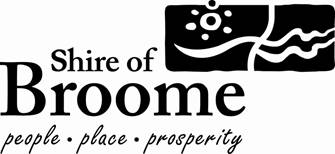
MISSION AND VALUES OF COUNCIL
"A Sustainable Community that is
inclusive, attractive, healthy and pleasant to live in, that uses our land so
as to preserve our history and environment, respects the rights and equality of
our citizens and manages our future growth wisely."
UNCONFIRMED
MINUTES
OF THE
Audit and Risk Committee
Meeting
13 February 2018
OUR VISION
"A
thriving and friendly community that recognises our history and embraces
cultural diversity and economic opportunity, whilst nurturing our unique
natural and built environment."
OUR MISSION
“To
deliver affordable and quality Local Government services.”
CORE
VALUES OF THE SHIRE
The core
values that underpin the achievement of the
mission
will be based on a strong customer service
focus and a
positive attitude:
Communication
Integrity
Respect
Innovation
Transparency
Courtesy
DISCLAIMER
The purpose of Council Meetings is to discuss, and where possible,
make resolutions about items appearing on the agenda. Whilst Council has
the power to resolve such items and may in fact, appear to have done so at the
meeting, no person should rely on or act on the basis of such decision or on
any advice or information provided by a Member or Officer, or on the content of
any discussion occurring, during the course of the meeting.
Persons should be aware that the provisions of the Local
Government Act 1995 (Section 5.25 (e)) establish procedures for revocation or
rescission of a Council decision. No person should rely on the decisions
made by Council until formal advice of the Council decision is received by that
person. The Shire of Broome expressly disclaims liability for any loss or
damage suffered by any person as a result of relying on or acting on the basis
of any resolution of Council, or any advice or information provided by a Member
or Officer, or the content of any discussion occurring, during the course of
the Council meeting.
SHIRE OF BROOME
Audit and Risk Committee Meeting
Tuesday 13 February 2018
INDEX – Minutes
1. Official
Opening.. 5
2. Attendance
And Apologies. 5
3. Declarations
Of Financial Interest / Impartiality. 5
4. Confirmation
Of Minutes. 5
5. Reports
of Officers. 6
5.1 COMPLIANCE AUDIT RETURN 2017. 6
5.2 AUDIT REGULATION 17 IMPROVEMENT
PLAN BIANNUAL PROGRESS REPORT. 23
5.3 2nd QUARTER FINANCE AND COSTING
REVIEW 2017-18. 59
6. Matters
Behind Closed Doors. 72
7. Meeting
Closure. 72
NOTICE OF MEETING
Dear Council Member,
The next Audit and Risk Committee of
the Shire of Broome will be held on Tuesday, 13 February 2018 in the
Council Chambers, Corner Weld and Haas Streets, Broome, commencing at 3.30pm.
Regards

S MASTROLEMBO
Chief Executive Officer
08/02/2018
MINUTES OF THE Audit and Risk Committee Meeting OF THE SHIRE OF BROOME,
HELD
IN THE Council Chambers, Corner Weld and
Haas Streets, Broome, ON Tuesday
13 February 2018, COMMENCING AT 3.30pm.
The Chairperson welcomed Councillors and Officers and
declared the meeting open at 3.37pm.
Attendance:
Cr
D Male Chairperson
Cr
H Tracey Shire
President
Cr
C Mitchell
Leave of Absence: Nil
Apologies: Nil
Officers: Mr
S Mastrolembo Chief Executive Officer
Mr
J Watt Director
Corporate Services
Aletta
Nugent Director
Development and Community
Steven
Harding Director
Infrastructure
Alvin
Santiago Manager
Financial Services
Rochelle
Piggin Manager Governance
|
Committee Member
|
Item No
|
Item
|
Nature of Interest
|
|
Nil.
|
|
Committee Resolution:
Moved: Cr C
Mitchell Seconded:
Cr H Tracey
That the Minutes
of the Audit and Risk Committee held on 6 December 2017, as published and
circulated, be confirmed as a true and accurate record of that meeting.
CARRIED
UNANIMOUSLY 3/0
|
|
5.1 COMPLIANCE
AUDIT RETURN 2017
LOCATION/ADDRESS: Nil
APPLICANT: Nil
FILE: LCR02
AUTHOR: Manager
Governance
CONTRIBUTOR/S: Nil
RESPONSIBLE
OFFICER: Director
Corporate Services
DISCLOSURE
OF INTEREST: Nil
DATE OF REPORT: 1
February 2018
|
|
SUMMARY: The
purpose of this report is to present to the Audit and Risk Committee the 2017
Compliance Audit Return for review, and for a recommendation to Council to
adopt the 2017 Compliance Audit Return for submission to the Department of
Local Government, Sport and Cultural Industries (DLGSC) by 31 March 2018.
|
BACKGROUND
Previous
Considerations
OMC 23 March 2004 Item
9.1.3
OMC 22 March 2005 Item
9.1.2
OMC 11 April 2006 Item
9.1.4
OMC 15 March 2007 Item
10.4
OMC 13 March 2008 Item
10.1
OMC 24 March 2009 Item
10.3
OMC 18 March 2010 Item
10.1
OMC 17 March 2011 Item
10.2
OMC 15 March 2012 Item
9.4.2
OMC 21 March 2013 Item
10.2
OMC 27 February 2014 Item
10.4
OMC 26 February 2015 Item
10.1
OMC 25 February 2016 Item
10.3
OMC 23 February 2017 Item
10.3
Section 7.13(1)(i) of the Local
Government Act 1995 requires that each local government carry out a
compliance audit for the period 1 January to 31 December each year. The
Compliance Audit is an in-house self audit that is undertaken by staff.
In accordance with Regulation 14 of
the Local Government (Audit) Regulations 1996 the Audit and Risk
Committee is to review the Compliance Audit Return (CAR), and is to report to
Council the results of that review. The CAR is to be:
1. presented
to an Ordinary Meeting of Council
2. adopted
by Council; and
3. recorded
in the minutes of the meeting at which it is adopted.
Following the adoption by Council of
the CAR, a certified copy of the return, along with the relevant section of the
minutes and any additional information detailing the contents of the return are
to be submitted to the DLGSC by 31 March 2018.
The return requires the Shire
President and the Chief Executive Officer to certify that the statutory
obligations of the Shire of Broome have been complied with.
COMMENT
The Compliance Audit Return for the
period 1 January to 31 December 2017 continues in a reduced format introduced
in 2011 with questions focused on high risk areas of compliance and statutory
reporting as prescribed in Regulation 13 of the Local Government (Audit)
Regulations 1996. This year the CAR has been
extended to include 7 additional questions relating to Integrated Planning and
Reporting. These questions are optional.
The 2017 CAR includes a total of 94
questions and focuses on the following areas of compliance:
· Commercial
Enterprises by Local Governments
· Delegation of
Power/Duty
· Disclosure of
Interest
· Disposal of
Property
· Elections
· Finance
· Integrated
Planning and Reporting (optional)
· Local Government
Employees
· Official Conduct
· Tenders for
Providing Goods and Services.
The 2017 CAR has been completed in
consultation with officers responsible for the various areas contained in the
return, and reviewed by the Executive Management Group and the Chief Executive
Officer.
The 2017 Compliance Audit reveals a
compliance rating of 100%. This compares to:
2016
Compliance Audit – 1 area of non-compliance of the 87 areas audited
(98.8%)
2015 Compliance
Audit – 0 areas of non-compliance of the 87 areas audited (100%)
2014
Compliance Audit – 1 area of non-compliance of the 78 areas audited
(98.7%)
2013 Compliance
Audit – 0 areas of non-compliance of the 78 areas audited (100%)
2012 Compliance
Audit – 8 areas of non-compliance of 78 areas audited (89.7%)
2011
Compliance Audit – 1 area of non-compliance of 78 areas audited (98.7%)
2010
Compliance Audit – 1 area of non-compliance of 283 areas audited
(99.6%)
2009 Compliance
Audit – 4 areas of non-compliance of 347 areas audited (98.8%)
2008
Compliance Audit – 2 areas of non-compliance of 311 areas audited
(99.4%
2007
Compliance Audit – 13 areas of non-compliance of 271 areas audited
(96.1%)
2006
Compliance Audit – 21 areas of non-compliance of 271 areas audited
(92.3%)
2005
Compliance Audit – 23 areas of non-compliance of 306 areas audited
(92.5%)
2004
Audit – 18 areas of non-compliance and 147 areas audited (87.8%).
CONSULTATION
Nil
STATUTORY ENVIRONMENT
Local Government Act 1995
7.13 Regulations
as to audits
(1) Regulations
may make provision –
(i) requiring
local governments to carry out, in the prescribed manner and in a form approved
by the Minister, an audit of compliance with such statutory requirements as are
prescribed whether those requirements are –
(i) of
a financial nature or not; or
(ii) under
this Act or another written law.
Local Government (Audit)
Regulations 1996
13. Prescribed
statutory requirements for which compliance audit needed (Act s.
7.13(1)(i))
For
the purposes of section 7.13(1)(i) the statutory requirements set forth in
the Table to this regulation are prescribed.
Table
|
Local Government
Act 1995
|
|
s. 3.57
|
s. 3.58(3) and (4)
|
s. 3.59(2), (4)
and (5)
|
|
s. 5.16
|
s. 5.17
|
s. 5.18
|
|
s. 5.36(4)
|
s. 5.37(2) and (3)
|
s. 5.42
|
|
s. 5.43
|
s. 5.44(2)
|
s. 5.45(1)(b)
|
|
s. 5.46
|
s. 5.67
|
s. 5.68(2)
|
|
s. 5.70
|
s. 5.73
|
s. 5.75
|
|
s. 5.76
|
s. 5.77
|
s. 5.88
|
|
s. 5.103
|
s. 5.120
|
s. 5.121
|
|
s. 7.1A
|
s. 7.1B
|
s. 7.3
|
|
s. 7.6(3)
|
s. 7.9(1)
|
s. 7.12A
|
|
Local Government
(Administration) Regulations 1996
|
|
r. 18A
|
r. 18C
|
r. 18E
|
|
r. 18F
|
r. 18G
|
r. 19
|
|
r. 22
|
r. 23
|
r. 28
|
|
r. 34B
|
r. 34C
|
|
Local Government
(Audit) Regulations 1996
|
|
r. 7
|
r. 10
|
|
|
Local Government
(Elections) Regulations 1997
|
|
r. 30G
|
|
|
|
Local Government
(Functions and General) Regulations 1996
|
|
r. 7
|
r. 9
|
r. 10
|
|
r. 11A
|
r. 11
|
r. 12
|
|
r. 14(1), (3)
and (5)
|
r. 15
|
r. 16
|
|
r. 17
|
r. 18(1) and (4)
|
r. 19
|
|
r. 21
|
r. 22
|
r. 23
|
|
r. 24
|
r. 24AD(2), (4)
and (6)
|
r. 24AE
|
|
r. 24AF
|
r. 24AG
|
r. 24AH(1)
and (3)
|
|
r. 24AI
|
r. 24E
|
r. 24F
|
|
Local Government
(Rules of Conduct) Regulations 2007
|
|
r. 11
|
|
|
[Regulation
13 inserted in Gazette 23 Apr 1999 p. 1722‑4; amended in
Gazette 1 Jun 2004 p. 1917; 31 Mar 2005
p. 1042‑3; 30 Sep 2005 p. 4418-20;
21 Dec 2010 p. 6758-61; 30 Dec 2011
p. 5579-80; 18 Sep 2015 p. 3813.
14. Compliance
audits by local governments
(1) A
local government is to carry out a compliance audit for the period 1 January to
31 December in each year.
(2) After
carrying out a compliance audit the local government is to prepare a compliance
audit return in a form approved by the Minister.
(3A) The
local government’s audit committee is to review the compliance audit
return and is to report to the council the results of that review.
(3) After
the audit committee has reported to the council under subregulation (3A), the
compliance audit return is to be —
(a) presented
to the council at a meeting of the council; and
(b) adopted
by the council; and
(c) recorded
in the minutes of the meeting at which it is adopted.
[Regulation
14 inserted in Gazette 23 Apr 1999 p. 1724‑5; amended in Gazette 30 Dec
2011 p. 5580-1.]
15. Compliance
audit return, certified copy of etc. to be given to Executive Director
(1) After
the compliance audit return has been presented to the council in accordance
with regulation 14(3) a certified copy of the return together with —
(a) a
copy of the relevant section of the minutes referred to in regulation 14(3)(c);
and
(b) any
additional information explaining or qualifying the compliance audit,
is
to be submitted to the Executive Director by 31 March next following the period
to which the return relates.
(2) In
this regulation —
certified
in relation to a compliance audit return means signed by —
(a) the
mayor or president; and
(b) the
CEO.
[Regulation 15
inserted in Gazette 23 Apr 1999 p. 1725.]
POLICY IMPLICATIONS
Nil
FINANCIAL IMPLICATIONS
Nil
RISK
The Local Government Act 1995
requires that each local government carry out a compliance audit for the period
1 January to 31 December each year. The Compliance Audit is an in-house
self audit that is undertaken by staff and is to be submitted to the DLGSCI by
31 March each year.
The risk is Extreme if this date is
not met as it results in non-compliance with the legislative requirements of
the Local Government Act 1995 and Local Government (Audit)
Regulations 1996, and loss of reputation with the DLGSCI. The
likelihood of this occurring is rare as the Compliance Audit Return has been
prepared well in advance for presentation to Council on the 22 February 2018.
STRATEGIC IMPLICATIONS
Our
Organisation Goal – Continually enhance the Shire’s organisational
capacity to service the needs of a growing community:
Improved systems, processes and
compliance
VOTING REQUIREMENTS
Simple Majority
|
Committee
Resolution:
(Report Recommendation)
Moved: Cr H Tracey Seconded:
Cr C Mitchell
That the Audit and Risk Committee recommends
Council:
1. Adopts the
attached 2017 Compliance Audit Return as the official return for the Shire of
Broome; and
2. Following
certification of this document by the Shire President and Chief Executive
Officer, forwards the return and a copy of the minutes relative to this
report to the Department of Local Government, Sport and Cultural Industries
prior to 31 March 2018.
CARRIED UNANIMOUSLY 3/0
|
Attachments
|
1.
|
Compliance Audit Return
2017
|
|
5.2 AUDIT
REGULATION 17 IMPROVEMENT PLAN BIANNUAL PROGRESS REPORT
LOCATION/ADDRESS: Nil
APPLICANT: Nil
FILE: COA01
AUTHOR: Manager
Governance
CONTRIBUTOR/S: Nil
RESPONSIBLE
OFFICER: Director
Corporate Services
DISCLOSURE
OF INTEREST: Nil
DATE OF REPORT: 1
February 2018
|
|
SUMMARY: The
Audit and Risk Committee is presented with a report for review on the
progress of the Audit Regulation 17 Improvement Plan (Improvement Plan),
which was adopted by Council at the Ordinary Meeting of Council held 23
February 2017. The Improvement Plan contains a list of items identified by
the auditors as requiring action to improve the appropriateness and
effectiveness of the Shire of Broome’s systems and processes in regard
to risk management, internal control and legislative compliance.
The Audit and Risk Committee is required to review the
attached updated Risk Management Improvement Plan prepared by the Audit
Regulation 17 Technical Advisory Group, then report to Council on the result
of the Audit and Risk Committee’s review.
|
BACKGROUND
Previous
Considerations
SMC 27
June 2014 Item
9.4.6
OMC 28
August 2014 Item
10.2
OMC 27
November 2014 Item 10.3
OMC 2
June 2015 Item
10.1
OMC 26
May 2016 Item
10.3
OMC 23
February 2017 Item
10.3
OMC 25
May 2017 Item
10.1
The Local Government Audit
Regulations 1996 (the Regulations) include reviewing the appropriateness
and effectiveness of a local government's Risk management systems and
procedures. Specifically, Audit Regulation 17 (Audit Reg. 17) requires the
Chief Executive Officer (CEO) to conduct a review and report the results to the
Audit and Risk Committee on the effectiveness of risk management, internal
control and legislative compliance. The Department of Local Government and
Communities Audit in Local Government Guideline No. 9 advises that the
review can be undertaken either on an internal or external audit basis.
Initially the Shire of Broome
appointed an external auditor to conduct a third party review of organisational
practices in accordance with updated legislation contained within Audit Reg.
17. The Audit Reg. 17 Review Audit produced a comprehensive Improvement Plan
separated into the three main compliance areas; Risk Management (RM),
Legislative Compliance (LC) and Internal Controls (IC).
The Shire’s Technical Advisory
Group (TAG) effect the framework components identified in the Improvement Plan.
The TAG enables the Shire to fulfil its responsibilities in relation to
reporting on risk management, internal control, and legislative compliance. The
Improvement Plan action items contained within the Regulation 17 Review are
allocated to members within the TAG and prioritised in accordance with
organisational need and capacity. The TAG meets monthly to review and update
specific actions contained in the Improvement Plan and report to the Executive
Management Group (EMG) and Council.
The biannual report is to identify
actioned items as detailed in the Improvement Plan. All actions are reported to
the Audit and Risk Committee in May and November each year, after endorsement
by EMG. Due to the Ordinary Local Government election being held in October
2017 and appointments to Committees not being considered until the November OMC
the presentation of the biannual report to the Audit and Risk Committee was
delayed.
IMPROVEMENT PLAN
There are a number of actions that
are completed or in progress with full details contained in the attached
Improvement Plan.
The following action items have been
completed in accordance with the Improvement Plan:
|
No
|
Framework Component Improvements
|
|
RM 1.1
|
Agenda template for Council agenda
|
|
RM 1.2
|
Adopted policy work safety health
|
|
RM 2.1
|
Risk matrix amended in accordance
with ISO 31000 (international best practice standards)
|
|
RM 2.1
|
Risk management strategy and
procedure
|
|
RM 2.1
|
Risk management strategy and
procedure adopted by Council
|
|
RM 2.1
|
Risk management strategy and
procedure uploaded to corporate Intranet
|
|
RM 2.3
|
Staff Housing Policy – Staff
Housing Bonds procedures updated
|
|
RM 3.1
|
Risk management working group
(Audit Reg 17 TAG) has been established and monthly meetings initiated
|
|
RM 3.1
|
Risk agenda topic included on
fortnightly EMG agenda
|
|
RM 3.3
|
Records of inductions maintained on
personnel files
|
|
RM 3.3
|
Completed organisational training
and development in risk management principles
|
|
RM 3.4
|
OSH committee risk based assessment
business operating procedure
|
|
RM 3.5
|
Draft Crisis Management and
Business Continuity Response Plan
|
|
RM 3.6
|
Adopted local emergency management
plan
|
|
RM 3.7
|
Adopted local recovery plan
|
|
RM 3.8
|
Completed records disaster
management plan
|
|
RM 3.9
|
Hazard and accident reporting
business operating procedure updated
|
|
RM 3.10
|
Draft contractor management system
includes business operating Procedure, Toolkit and corporate Induction.
|
|
RM 3.10
|
Completed risk management strategy
and procedure endorsed by Council
|
|
RM 3.11
|
Project Specific Risk Assessments
endorsed by Council
|
|
RM 3.12
|
Developing Civic Centre Emergency
Response and Evacuation Plan
|
|
RM 3.12
|
Reviewing BRAC Emergency Response
and Evacuation Plan
|
|
RM 3.13
|
Asset Management Risk Assessment
incorporated into Infrastructure Asset Management Plans
|
|
RM 3.14
|
Events risk assessment undertaken
in risk management plan for large scale events
|
|
RM 3.14
|
Events Toolkit being reviewed by
Local Government Insurance Services and developing online applications
|
|
RM 3.15
|
Volunteer inductions completed
|
|
RM 3.16
|
Workforce plan version 2.0
redeveloped to include Risk Management
|
|
RM 4.1
|
Audit and Risk Committee Risk
Profiles developed and have replaced Improvement Plan. Next biannual report
will utilise Risk Profiles
|
|
RM 4.3
|
Occupational Safety and Health
Register captured in SynergySoft
|
|
RM 4.5
|
Minutes of Executive Management
Group Meetings recorded to the Synergy Central Records system
|
|
RM 5.2
|
Media Training completed for Senior
Staff. Councillor training scheduled.
|
|
LC 1.1
|
Completed legislative compliance
policy
|
|
LC 1.2
|
Completed Council policy for
records management
|
|
LC 2.1
|
Framework developed comprising
Policy 1.1.11 – Legislative Compliance (Action LC1.1), the Legislative
Compliance Register (Action LC5.1) and the Monitoring and Reporting
Procedures for Legislative Compliance BOP (Action LC5.4)
|
|
LC 2.1
|
WALGA advice supports suitability
of current Purchasing policy
|
|
LC 2.2
|
Procurement via Panels of
Pre-Qualified Suppliers Policy developed
|
|
LC 2.4
|
Legislative compliance working
group (Audit Reg 17 TAG) has been established and monthly meetings initiated
|
|
LC 4.1
|
Experienced Staff completed through
review of procedure and management directive requirements
|
|
LC 5.1
|
Developed Legislative Compliance
register to record known breaches
|
|
LC 5.1
|
Increased prominence of credit card
payments in List of Payments
|
|
LC 5.4
|
Developed draft BOP
‘Monitoring and Reporting Procedures for Legislative Compliance’
|
|
IC 1.1
|
Adopted policy internal control
|
|
IC 1.6
|
Council policy materiality in
financial reporting adopted
|
|
IC 1.7
|
Council policy for Investment of
surplus funds adopted
|
|
IC 2.1
|
Rate Exemption Charitable Use BOP
developed
|
|
IC 2.1
|
Signatories Bank Transaction
Processing BOP developed
|
|
IC 2.2
|
Internal controls working group (Audit
Reg 17 TAG) has been established and monthly meetings initiated
|
|
IC 3.4
|
High risk Journals require approval
and monitoring
|
|
IC 3.5
|
Trust Transfer procedures updated
|
|
IC 3.7
|
Links Training for BRAC and Civic
Centre
|
|
IC 3.10
|
Completed review and update of End
of Month checklist
|
|
IC 3.11
|
Debtors Reconciliation processes
performed as part of end of month checklist
|
|
IC 6.1
|
BRAC receipting procedures
documented
|
|
IC 6.2
|
Civic centre receipting included in
staff manual for stock take
|
|
IC 6.2
|
Draft Cash Handling Business
Operating Procedure
|
|
IC 6.3
|
Waste Facility banking procedures
|
|
IC 6.3
|
Developed Cash Handling BOP
|
|
IC 6.4
|
Developed
BOP to control the authorised receipting points and establish processes to
ensure appropriate controls at new, or ad hoc, points.
|
|
IC 6.5
|
Waste Facility debtor invoice
captured in system
|
|
IC 6.6
|
Developed Bank Signatories BOP
|
|
IC 6.7
|
Separation of duties of debtors and
creditors
|
|
Other
|
Reviewed the Technical Advisory
Group Audit Regulation 17 Terms of Reference
|
The following items have been
actioned from May 2017 to January 2018 in accordance with the Improvement
Plan:
|
No.
|
Framework Components
|
|
RM1.1
|
Bi-Annual Risk Reporting
Officer Comment: Bi-annual
reports to EMG and Council are provided through the Audit and Risk Committee
as per Risk Management Policy 2.1.4
|
|
RM3.3
|
Business Continuity Plan
Officer Comment: Draft document
requires final review and amendments to ensure suitability and effectiveness.
To be presented to the Audit and Risk Committee in May 2018.
|
|
RM3.6
|
Local Emergency Management Plan
2014 Draft
Officers Comment: Following
training provided on Managing Recovery Activities the Local Emergency
Management Plan is being reviewed and will be tested once finalised.
|
|
RM3.8
|
Workforce Plan
Officer Comment: The Workforce
Plan is under review. Please note organisational risks have been identified
in the external analysis section 2.1.1-2.1.15 and internal analysis section
3.3.1-3.3.14 and again in Workforce Planning 4.1.1 page 47. In order to
satisfy the auditors, the risk section will itemise the known risks under
4.5.9 organisational risk management. An organisational survey was completed
in late 2017 and will be used to form the basis of the review. Revised
completion date of November 2018.
|
|
RM3.9
|
Infrastructure Asset Management
Plans
Officer Comments: Plans prepared
in 2017 and received by Council at the December 2017 OMC.
|
|
RM3.12
|
Emergency Response Procedures Shire
Buildings
Officer Comment:
Organisational responsibility for this action currently being reviewed.
Procedures have been drafted for the Administration Building however require
a review following the refurbishment.
|
|
RM3.15
|
Volunteer and Contractor Inductions
Officer Comment: Volunteer
inductions provided. Contractor Induction documentation has been reviewed by
LGIS. Existing contractors required to attend induction in February 2018.
|
|
RM4.1
|
Audit and Risk Committee
Officer
Comment: Risk Profiles implemented. External Risk Audit to be
undertaken by external auditor in December 2018.
|
|
RM4.2
|
Monitoring Compliance
Officer Comment: This has been
amended to an ongoing action.
|
|
RM4.4
|
Risk Register
Officer Comment: Risk Profiles
have been developed and implemented. Electronic systems are being
investigated to further streamline the process and provide improved
visibility and management of identified risks.
|
|
RM4.5
|
EMG Minutes
Officer Comment: Process in place to ensure that EMG
Minutes are recorded to Synergy Central Records System. All 2017 meeting
minutes have been recorded to Synergy. EMG minutes will continue to be
recorded to Synergy.
|
|
RM5.2
|
Training
Officer Comment: Risk Management
Training funds assigned through annual budget process for 17/18.
|
|
LC1.1
|
Code of Conduct
Officer Comment: Revised Code of
Conduct is being drafted and will include volunteers and contractors. To be
presented to Council in April.
|
|
LC 5.2
|
EMG Minutes
Officer Comment: Process in
place to ensure that EMG Minutes are recorded to Synergy Central Records
System. All 2017 meeting minutes have been recorded to Synergy. EMG
minutes will continue to be recorded to Synergy
|
|
LC5.3
|
Employee Complaints/Grievance
Handling
Officer Comment: Employee
complaints are addressed by the Manager of HR. This action will be reviewed
as a priority on commencement of the Manager People and Culture.
|
|
IC2.1
|
Management Policy – Internal
Controls
Officers Comment: Internal
Control Framework developed and in operation however leaving open until
process is firmly established and embedded in across the organisation.
|
|
IC2.2
|
Private and Community Works Policy
Officer Comment: The Finance
Department have developed an internal finance procedure to ensure private
works are only undertaken after an appropriate written agreement (signed
letter or purchase order) has been received.
|
|
IC2.3
|
Internal Audit
Officers Comment: The Senior
Procurement, Risk and Governance Officer will coordinate an internal audit.
|
|
IC3.2
|
Staff Training
Officers Comment: Inductions and
specific on the job training for internal control areas i.e. cash handling,
stock control as required. Training programmes to be developed for specific
areas e.g. BRAC, Civic Centre and others as identified.
Financial Services developed an
induction pack that includes relevant information for each function in
Finance.
Governance, Records and IT inductions
are undertaken with designated employees on their commencement. Other
inductions are undertaken as requested. Information sessions on local
government and the Local Government Act were held with internal and external
staff in November 2017.
|
|
IC3.3
|
Documented Procedures
Officers Comment: Standard
operating procedures exist for selected, but not all, financial procedures.
Procedure documentation is being developed by officers where it does not
currently exist.
|
|
IC3.7
|
Credit Card Procedures
Officer Comment: Only members of
the BEST team may utilise the credit cards and the details of the card are
not to be shared with others.
|
|
IC3.8
|
Checklists
Officer Comment: Checklists
exist and are in use by staff as part of endorsed procedures.
|
|
IC4.1
|
Monitoring
Officers Comment: December 2016
review completed by external consultant. While internal
review is recommended current staff resources do not permit the development
of an internal audit function. An external consultant will provide a biennial
review as per the Audit Reg 17 regulations with ongoing risk management
functions monitored by the Risk TAG. Next external audit review December
2018.
|
|
IC5.1
|
Ongoing Improvement Plan
Officers Comment: This
improvement plan forms the basis of an all inclusive continual improvement
process for all three areas.
|
|
Other
|
Lone Worker Risk Management
Officer Comment: Lone Worker
Risk Management consultation paper finalised. Procedure to follow.
CCTV
Officer Comment: BRAC and Depot
CCTV systems implemented to eliminate identified staff safety risks
|
This report recommends the Audit and
Risk Committee receive the updated Improvement Plan, and adopts the reviewed
actions, timelines and responsible officers contained within the document.
CONSULTATION
Nil
STATUTORY ENVIRONMENT
Local Government (Audit) Regulations 1996
16. Audit committee, functions
of
An audit committee —
(a) is to
provide guidance and assistance to the local government —
(i) as
to the carrying out of its functions in relation to audits carried out under
Part 7 of the Act; and
(ii) as
to the development of a process to be used to select and appoint a person to be
an auditor;
and
(b) may
provide guidance and assistance to the local government as to —
(i) matters
to be audited; and
(ii) the
scope of audits; and
(iii) its
functions under Part 6 of the Act; and
(iv) the
carrying out of its functions relating to other audits and other matters
related to financial management; and
(c) is to
review a report given to it by the CEO under regulation 17(3) (the CEO’s
report) and is to —
(i) report
to the council the results of that review; and
(ii) give
a copy of the CEO’s report to the council.
17. CEO
to review certain systems and procedures
(1) The
CEO is to review the appropriateness and effectiveness of a local
government’s systems and procedures in relation to —
(a) risk
management; and
(b) internal
control; and
(c) legislative
compliance.
(2) The
review may relate to any or all of the matters referred to in subregulation
(1)(a), (b) and (c), but each of those matters is to be the subject of a review
at least once every 2 calendar years.
(3) The
CEO is to report to the audit committee the results of that review.
POLICY IMPLICATIONS
Nil
FINANCIAL IMPLICATIONS
The Shire has received membership
funds from the Local Government Insurance Scheme (LGIS) which has been
allocated as a genuine rollover to fund organisational Risk Initiatives.
The financial implications of
actioning individual items contained in the Improvement Plan in Attachment 1
will be implemented using existing, internal resources. If any additional
resources are required they will be progressed via the quarterly Finance and
Costing Review or presented to Council for consideration.
STRATEGIC IMPLICATIONS
Our People
Goal – Foster a community environment that is accessible, affordable,
inclusive, healthy and safe:
Effective communication
Affordable services and initiatives
to satisfy community needs
Accessible and safe community spaces
A healthy and safe environment
Our
Prosperity Goal – Create the means to enable local jobs creation and
lifestyle affordability for the current and future population:
Affordable and equitable services and
infrastructure
Our Organisation
Goal – Continually enhance the Shire’s organisational capacity to
service the needs of a growing community:
An organisational culture that
strives for service excellence
Sustainable and integrated strategic
and operational plans
Responsible resource allocation
Effective community engagement
Improved systems, processes and
compliance
VOTING REQUIREMENTS
Simple Majority
|
Committee
Resolution:
(Report Recommendation)
Moved: Cr C Mitchell Seconded:
Cr H Tracey
That the Audit and Risk Committee recommends that
Council:
1. Receives
the updated Audit Regulation 17 Improvement Plan; and
2. Adopts
the reviewed actions, timelines and responsible officers as detailed in the
Audit Regulation 17 Improvement Plan.
CARRIED UNANIMOUSLY 3/0
|
Attachments
|
1.
|
Improvement Plan
January 2018
|
Shire of Broome 2016 Audit Regulation
17 Review
RISK
MANAGEMENT IMPROVEMENT PLAN
**Note
shaded rows indicate that an item has been carried forward from the previous
iteration of the Improvement Plan.
|
No.
|
FRAMEWORK COMPONENTS
|
PURPOSE/GOAL
|
IMPROVEMENTS
|
Officer
|
Timing
|
Comments
|
Est.
Hours
|
Priority
|
|
RM 1.0 MANDATE AND COMMITTMENT
|
|
RM1.1
|
Council
Policy 1.2.11 2.1.4
Risk
Management Policy
|
To
create an environment where Council, management and staff apply risk
management, techniques through consistent and effective risk management practices.
|
That
the Audit and Risk Committee be provided with
a risk report bi-annually.
|
Director Corporate Services
|
April
and November Annually
|
Report to be presented to November 2016 bi-annually to the Audit and Risk Committee
|
|
|
|
|
|
Policy
to document the commitment and objectives regarding managing uncertainty that
may impact the Shire’s strategies, goals or objectives.
|
Risk
recording and reporting be undertaken in accordance with the Risk Management
Policy.
|
Manager Human Resources
Director Corporate Services
|
Ongoing
|
Risk
Management Policy Requires six monthly reports to EMG, MCG and Council
Bi-annual reports to EMG and Council are provided through the Audit and Risk
Committee as per Risk Management Policy 2.1.4.
|
|
|
|
No.
|
FRAMEWORK COMPONENTS
|
PURPOSE/GOAL
|
IMPROVEMENTS
|
Officer
|
Timing
|
Comments
|
Est.
Hours
|
Priority
|
|
RM 2.0 FRAMEWORK DESIGN
|
|
RM2.1
|
Enterprise-wide
Risk Management Strategy and Framework
|
Defines
and details the various practices to support Risk Management and establishes
the risk management strategy and framework to be followed by all Shire staff.
|
That
the Enterprise-wide Risk Management Strategy and Framework be made available
to users of the Intranet.
|
Manager Human Resources
Director Corporate Services
|
Complete
|
Documents
uploaded to corporate intranet
Complete
|
38
|
Extreme
|
|
RM2.2
|
Insurance
Strategy or Policy
|
A
policy to provide guidance to Officers as to the management of risk through
insurance.
|
That
an Insurance Strategy and Policy be developed to provide clarity on issues
such as the level of self-insurance, the adequacy of cover and the basis of
the valuation of the insured assets.
|
Director
Corporate Services
Manager Governance
|
November
2017
November 2018
|
Draft
document to be developed for presentation to the Audit and Risk Committee November 2017 2018
|
16
|
Medium
|
|
RM2.3
|
2.2.2 1.3.4 Staff Housing
Policy
|
Policy to provide direction on the provision of staff housing.
|
To help prevent damage to Shire properties we suggest housing
bonds be paid in full prior to occupation of the house and lodged with the
Bond Administrator.
|
Manager
HR
Director
Corporate Services
|
Complete
This is
not complete – April 2018
|
The Policy allows for the deduction of a housing bond from an
employee’s payroll.
Housing bonds are required to be lodged with the Bond
Administrator.
Housing bonds are now paid in advance to the Bond Administrator
and Staff Housing BOP has been updated to reflect changes.
Policy requires rework and will be reviewed and presented to MCG,
EMG and Council at the April OMC. BOP has been reviewed and issues
surrounding Staff Housing Bonds have been addressed.
|
6
|
High
|
|
No.
|
FRAMEWORK COMPONENTS
|
PURPOSE/GOAL
|
IMPROVEMENTS
|
Officer
|
Timing
|
Comments
|
Est.
Hours
|
Priority
|
|
RM 3.0 IMPLEMENTING RISK MANAGEMENT
|
|
RM 3.1
|
Executive
Management Group
|
An effective
Executive Management Group charged with implementation of Council policies.
|
That
risks are regularly documented and monitored by the EMG in line with the RM
Strategy and Framework and risk treatments are identified for events
classified as high risk.
|
EMG
|
Ongoing
|
Risk
is a discussion on the weekly monthly EMG
agenda (complete).
|
Ongoing
|
Medium
|
|
RM 3.2
|
Insurance
Strategy or Policy
|
A
policy to provide guidance to Officers as to the management of risk through
insurance.
|
That
an Insurance Strategy and Policy be developed to provide clarity on issues
such as the level of self-insurance, the adequacy of cover and the basis of
the valuation of the insured assets.
|
Director
Corporate Services
Manager Governance
|
November
2017
2018
|
Draft
document to be developed for presentation to the Audit and Risk Committee November 2017 2018.
|
16
|
Medium
|
|
RM 3.3
|
Shire
of Broome Business Continuity Plan
|
To
plan for the prevention, response and recovery from events that may threaten
the capacity of the Shire of Broome to continue to provide services and good
governance to the District.
|
That,
as high priority, an effective documented Business Continuity Plan be
developed including relevant disaster recovery plans.
|
Director
Corporate Services
|
April
2017 2018
|
Draft
document still requires final review and amendment to ensure suitability and
effectiveness. Presented to Audit and Risk Committee
May 2017 2018.
|
76
|
High
|
|
That,
once adopted, the Plan’s effectiveness be tested
|
Director
Corporate Services
|
November
2017 2018
|
Mock
Exercise undertaken 16 June 2016. Further procedures required to ensure
detailed operational testing is undertaken annually by responsible
departments i.e. ICT, Health etc.
|
16
|
High
|
|
RM3.6
|
Local
Emergency Management Plan 2014 Draft
|
A
plan is prepared in accordance with the requirements of Emergency Management
Act 2005 [s.41(4)] and State Emergency Management Policy 2.5
|
That
the draft plan be finalised and once adopted, its effectiveness be tested in
accordance with PART 5 of the plan.
|
Manager
Environmental Health,
Emergency and Rangers
|
November
2017 2018
|
Following
training provided on Managing Recovery Activities the Local Emergency
Management Plan is being reviewed and will be tested once finalised.
The current plan is
compliant with the legislation. It is however considered inadequate by
officers. Grant funding requests have been made to obtain a fixed term
officer to assist in this project.
|
76
|
Extreme
|
|
RM3.8
|
Workforce
Plan
|
A plan to make sure the Shire has the right people, in the right
place, at the right time, to meet the objectives set out in the Strategic
Community Plan.
|
Future reviews of the Workforce Plan contain an assessment and
treatment plan for key identified risks in relation to the workforce.
|
Manager
HR
Manager People and Culture
|
November
2017 2018
|
The
Workforce Plan is under review and will incorporate feedback. Please note
organisational risks have been identified in the external analysis section
2.1.1-2.1.15 and internal analysis section 3.3.1 -3.3.14 and again in
Workforce Planning 4.1.1 page 47. In order to satisfy the auditors, the risk
section will itemise the known risks under 4.5.9 organisational risk
management.
CBP adopted December 2017; Organisational survey completed and
will be used to form the basis of the next review.
|
76
|
High
|
|
RM3.9
|
Asset
Management Plan
|
Plan prepared to assist the Shire to improve the way it delivers
services from its infrastructure assets such as roads, drainage, footpaths,
public open space and buildings.
|
Asset Management Plans be updated/ developed for all classes of
assets and adopted by Council.
Recording of risks identified within the plans in an appropriate
risk register should help ensure follow up assessments of treated risks are
undertaken.
|
Director
Infrastructure
|
June
2017
Complete
|
Building and Transport Asset Management Plans were prepared in
20137. The plans were not received by Council as an informing strategy
for the Shire’s Integrated Planning and Reporting Framework suite of
documents. The Infrastructure Asset Management Plan will be continually
updated based on works done. and are
marked ‘final draft’. The plans contain a risk assessment and
treatment plan. although no follow up assessment of treated risks has been
undertaken. No formal asset management plans were available for other
asset classes for review.
|
152
|
High
|
|
RM3.10
|
Risk Management Framework
|
A management framework to implement a risk management system
throughout the Shire.
|
The development of consequence rating criteria based on the
context of the risk assessment and inclusion of the criteria within the Risk
Management Strategy and Procedures. This should assist in avoiding any need
to redefine the risk assessment framework for each level of risk assessment.
|
Manager Human Resources
Director Corporate Services
|
Complete
|
A Risk Management Strategy and Procedures was were
adopted endorsed by Council in November 2015 2016 – Item 5.2. The
strategy and procedures include a risk assessment matrix however, no criteria
for rating the consequence of identified risk is provided.
Consequence of
risks (Risk Matrix) identified on Pages 14-16 Item
of the document.
|
38
|
Extreme
|
|
RM3.11
|
Project Specific Risk Assessments
|
A risk assessment undertaken as part of a major project.
|
Future assessments be undertaken in accordance with an entity
wide Risk Management Framework (to be developed).
|
Director
Corporate Services
|
Complete
|
This
framework has been endorsed and the relevant risk assessments have been
incorporated within Council reports, policy and project plan templates.
|
76
|
High
|
|
RM3.12
|
Emergency Response Procedures – Shire
Buildings
|
To
ensure uniformity in the handling of building related emergency situations.
|
That
emergency response procedures for all Shire buildings be developed and
implemented.
|
Manager Health, Rangers/
Manager Community Development Organisational responsibility for this action currently
being reviewed.
|
December
2016 November 2018
December
2016 November 2018
|
Update
required for procedures at the Admin Centre, Depot and
Waste Management Facility. and Barker St Office. Procedures have been drafted for
Admin building however require reviewing following administration office
refurbishment
Civic
Centre – emergency response and evacuation plan in existence – to
be updated to reflect cyclone procedures.
|
3
5
|
High
High
|
|
RM3.13
|
Asset Management
Risk Assessment
|
Inclusion of a risk
assessment undertaken as part of development and maintenance of the Shire of
Broome Asset Management Plans (AMP)
|
That
treatment plans be monitored to ensure risks are reduced to a medium level.
|
Asset
Coordinator
|
July
2017
Complete
|
A
risk assessment has been incorporated into the
Infrastructure Asset Management Plan. to be included when reviewing
existing Asset Management Plans and developing new Asset Management Plans.
|
76
|
Medium
|
|
RM3.14
|
Information Systems Plans
|
Plans to ensure the secure provision of information systems in
the event of a disaster.
|
IT Disaster Recovery Plan and IT Security Plan be developed and
tested on a regular basis to gauge their effectiveness.
|
Manager
Information Services
|
April
2017
November 2018
|
No IT Disaster Recovery Plan or IT Security Plan are in place.
Interim protection by relocating a replica of our
current system to the civic centre. The backup is then copied offsite on a
continuous basis. The replica is working and we also now have a GenSet to
maintain power. This has been tested and passed
|
76
|
High
|
|
RM3.15
|
Volunteer and Contractor Inductions
|
Inductions of contractors and volunteers, to ensure they have an
understanding of their roles and responsibilities when undertaking works on
Shire property.
|
All contractors and volunteers undertake a basic induction of
their roles and responsibilities prior to commencing work.
|
Manager
HR
Manager People and Culture
|
April
2017 June 2018 - Ongoing
|
Induction
of Volunteers are provided. Inductions of Contractors identified as risk and
budget allocation to provide a free corporate induction service is being put
through RFQ. Onsite induction paperwork has been updated. Roll out expected
by commencement of new financial year.
Volunteer inductions provided. Contractor Induction documentation
has been reviewed by LGIS. Existing contractors required to attend induction
in February 2018.
|
38
|
High
|
|
|
|
|
|
|
|
|
|
|
|
No.
|
FRAMEWORK COMPONENTS
|
PURPOSE/GOAL
|
IMPROVEMENTS
|
Officer
|
Timing
|
Comments
|
Est.
Hours
|
Priority
|
|
RM 4.0 monitoring and review
|
|
RM4.1
|
Audit and Risk
Committee
|
An Audit Committee
is required by the Local Government (Audit) Regulations 1996, and its
composition and role is prescribed.
|
That
the Committee receive bi-annual reports containing information on extreme and
high risk ratings in accordance with the Enterprise-wide Risk Management
Strategy and Framework.
|
Manager Human Resources
Director Corporate Services
|
April/November
Annually
|
Working
with LGIS to develop organisational profiles. Workshops by Directorate to
capture corporate knowledge and use existing risk resources such as risk
register to develop. Risk Register will be defunct when Profiles are fully
operational.
Risk Profiles implemented.
External Risk Audit to be undertaken by external auditor in December 2018.
|
6
|
High
|
|
RM4.2
|
Monitoring
Compliance
|
To ensure policies
relating to risk management are adhered to by the organisation and their
effectiveness is monitored.
|
That
recording and reporting mechanisms to monitor risks be implemented in
accordance with policy.
|
Manager Human Resources
Director Corporate Services
|
Pending
Ongoing
|
Ongoing
|
|
|
|
RM4.3
|
Occupational Safety
and Health (OSH) Register
|
To maintain a
hazard based register of OSH matters.
|
That
the current outstanding OSH list be augmented by an OSH register capable of
provide regular reports and identifying OSH trends.
|
Manager
Human Resources
Manager People and Culture
|
Ongoing
|
Ongoing
OSH
reporting has been included through electronic means and now captured in
Synergy central records. In addition, a register is being developed to
collate all outstanding items through the OSH Committee secretariat.
OSH Register remains a concern having been raised at
the previous 2 OSH meetings. Apparent that Synergy solution is not working in
its current form.
|
|
|
|
RM4.4
|
Risk Register
|
Provide for the ongoing monitoring and treatment of identified
risks.
|
Identified risks documented within Council Meeting Minutes and
other risk assessments are recorded within the risk register.
As a central
register of identified risks, we suggest the risk register be available for
all senior staff to update and review.
|
Manager
Human Resources
Manager People and Culture
|
Ongoing
|
Development
of Risk Profiles underway to replace defunct Risk Register.
Risk Profiles have been developed and
implemented. Electronic systems are being investigated to further streamline
the process and provide improved visibility and management of identified
risks.
|
|
|
|
RM4.5
|
Minutes of Executive Management Group Meetings
|
To formally document identified risks, internal control and
legislative compliance weaknesses raised by the Executive Management Group.
|
Minutes of the Executive Management Group meetings be maintained
with risks, internal control and legislative compliance weaknesses identified
in the minutes.
|
CEO
PA Executive Assistant to the CEO
|
April
2017 – Ongoing (Complete)
|
No minutes of the Executive Management Group meetings were
available for inspection during the review.
Minutes are taken at each meeting however, it is accepted that
there has been a lack of effective record keeping in this area.
Process in place to ensure that EMG Minutes are recorded to
Synergy Central Records System. All 2017 meeting minutes have been recorded
to Synergy.
EMG minutes will continue to be recorded to
Synergy.
|
6
|
High
|
|
|
|
|
|
|
|
|
|
|
|
|
|
|
|
No.
|
FRAMEWORK COMPONENTS
|
PURPOSE/GOAL
|
IMPROVEMENTS
|
Officer
|
Timing
|
Comments
|
Est.
Hours
|
Priority
|
|
RM 5.0 CONTINUAL IMPROVEMENT OF THe FRAMEWORK
|
|
RM5.1
|
Ongoing Improvement
Program
|
A program developed
to plan and implement improvements in risk management practices and to guide
the process of implementation.
|
That
a risk management improvement plan be maintained into the future to support
the process of continual improvement.
|
Audit Reg 17 TAG
|
Ongoing
|
This
improvement plan forms the basis of an all inclusive continual improvement
process for all three areas.
|
|
|
|
RM5.2
|
Training
|
Structured risk
management training be available for elected members and senior staff.
|
That
risk management training be available to elected members and all senior staff
undergo relevant risk management training.
|
Manager
Human Resources
Director Corporate Services
|
November –
Annually
|
Media Training has
been identified as a key priority and Councillors will be notified in May
2017.
Risk
Management Training funds assigned through annual budget process for 17/18
however may be deferred due to vacancies in HR department.
|
38
|
High
|
|
|
|
|
|
|
|
|
|
|
|
|
LEGISLATIVE
COMPLIANCE IMPROVEMENT PLAN
**Note
shaded rows indicate an item has been carried forward from the previous
iteration of the Improvement Plan.
|
No.
|
FRAMEWORK COMPONENTS
|
PURPOSE/GOAL
|
IMPROVEMENTS
|
Officer
|
Timing
|
Comments
|
Est.
Hours
|
Priority
|
|
LC1.0 MANDATE AND commitment LEGISLATIVE COMPLIANCE
|
|
LC1.1
|
Code of Conduct
|
To provide a documented expectation for the behaviour of elected
members, staff, contractors and volunteers when performing their duties.
|
An expansion of the scope of the Code of Conduct to include
actions by volunteers and contractors. Alternatively, a separate Code of
Conduct be developed for volunteers and contractors.
|
Manager HR
Director
Corporate Services
|
April 2017 2018
|
Volunteers and contractors are not bound by a Code of Conduct
when performing functions on behalf of the Shire.
Revised Code of Conduct is being drafted and will include
volunteers and contractors. To be presented to Council by April.
|
36
|
High
|
|
No.
|
FRAMEWORK COMPONENTS
|
PURPOSE/GOAL
|
IMPROVEMENTS
|
Officer
|
Timing
|
Comments
|
Est.
Hours
|
Priority
|
|
LC2.0 FRAMEWORK DESIGN FOR LEGISLATIVE COMPLIANCE
|
|
LC2.1
|
2.3.7 2.1.2 Purchasing Policy
|
Policy required by legislation to provide guidelines for a
consistent approach for obtaining quotations and tenders for the provision of
materials, services and consultants.
|
We suggest the Policy be amended to require each purchasing
event to be considered independently when determining the thresholds,
legislation prohibits the splitting of any contract for the purpose of
avoiding the relevant purchasing threshold.
|
Manager Governance
|
Complete
|
No
action required based on WALGA email advice dated 2 May 2017, however policy under review in line with release of revised
WALGA Purchasing Policy Template.
|
6
|
High
|
|
LC2.2
|
1.1.12 2.1.7 Procurement via Panels of Pre-Qualified
Suppliers Policy
|
A Policy required by legislation to make provision in respect of
the matters set out in paragraph 24AC (2) of the Local Government (Functions
and General) Regulations 1996.
|
The existing Panel of Suppliers should be cancelled and tenders
called to establish a new compliant Panel of Suppliers. Pending appointment
of a Panel of Suppliers standard contracts should be awarded in accordance
with the Procurement Policy.
|
Manager Governance
|
Complete
|
A Pre-Qualified Supplier Policy was adopted in December 2016,
following the change in the regulations in September 2015.
Contracts with a Panel of Suppliers established prior to the
change in the Regulations were extended subsequent to the introduction of the
requirement to have a Policy in place when utilising a Panel of
Suppliers. Previous Panel contracts have expired. No further
action required.
|
38
|
High
|
|
No.
|
FRAMEWORK COMPONENTS
|
PURPOSE/GOAL
|
IMPROVEMENTS
|
Officer
|
Timing
|
Comments
|
Est.
Hours
|
Priority
|
|
LC3.0 SENIOR MANAGEMENT commitment TO LEGISLATIVE COMPLIANCE
|
|
LC3.1
|
Communications
|
To ensure staff,
contractors and regular volunteers are aware of their obligation to report
breaches of legislation to the appropriate Officer.
|
That
the obligation to report compliance breaches be communicated to contractors
and volunteers.
|
Manager HR
Manager People and Culture
|
May
2017
|
The
Shires current process is undertaken through OSH reporting and the onsite
induction process.
Further
works to be Included in the Shires corporate contractor induction process
pending finalisation.
|
16
|
High
|
|
|
|
|
|
|
|
|
|
|
|
|
|
No.
|
FRAMEWORK COMPONENTS
|
PURPOSE/GOAL
|
IMPROVEMENTS
|
Officer
|
Timing
|
Comments
|
Est.
Hours
|
Priority
|
|
LC4.0 STAFF
EXPERIENCE AND TRAINING
|
|
LC4.1
|
Experienced Staff
|
To ensure staff
engaged at a senior level and on technical roles have an understanding of the
legislative requirements relevant to their role.
|
Experienced senior staff are expected to have a sound
understanding of the requirements of their roles. Given the level of staff
turnover, it is important new senior and technical staff possess the required
experience or quickly acquire a sound understanding of their role.
|
CEO/Manager
Human Resources Manager
People and Culture
|
Ongoing Complete
|
HR
practices include a merit based recruitment process based on experience,
skills and qualification relevant to the position. This has been formalised
through a review of the Recruitment BOP and HR Directive.
|
|
|
|
No.
|
FRAMEWORK COMPONENTS
|
PURPOSE/GOAL
|
IMPROVEMENTS
|
Officer
|
Timing
|
Comments
|
Est.
Hours
|
Priority
|
|
LC5.0
MONITORING AND REVIEW OF LEGISLATIVE COMPLIANCE
|
|
LC5.1
|
List of Payments
|
List of payments presented to Council monthly.
|
To ensure transparency of payments made all payments made
utilising credit cards are presented to Council along with the list of
payments.
|
Manager Financeial Services
|
Complete
|
Details of credit card payments have always been presented
together with direct debit transactions on the Monthly Payment Listing
presented to the Council. Credit card payment details will be given increased
prominence in the report.
|
6
|
High
|
|
LC5.2
|
Minutes of Executive Management Group Meetings
|
To formally document identified risks, internal control and
legislative compliance weaknesses raised by the Executive Management Group.
|
Minutes of the Executive Management Group meetings be maintained
with risks, internal control and legislative compliance weaknesses identified
in the minutes.
|
CEO
PA Executive Assistant to the CEO
|
April
2017 – Ongoing Complete
|
**Refer
RM4.5 & IC4.3
Process in place to ensure that EMG Minutes are recorded to
Synergy Central Records system. All 2017 meeting minutes have been recorded
to Synergy.
EMG minutes will continue to be recorded to
Synergy.
|
6
|
High
|
|
LC5.3
|
Employee Complaints/Grievance Handling
|
Procedures for the handling of employee complaints and
grievances.
|
Staff Complaints Register to be established and maintained.
|
Manager
HR
Manager People and Culture
|
April
2017 November 2018
|
Employee complaints are addressed by the Manager of HR. A Staff
Complaints Register was not available for review. This
action will be reviewed as a priority on the commencement of the Manager
People and Culture.
|
6
|
High
|
|
No.
|
FRAMEWORK COMPONENTS
|
PURPOSE/GOAL
|
IMPROVEMENTS
|
Officer
|
Timing
|
Comments
|
Est.
Hours
|
Priority
|
|
LC6.0 CONTINUAL
IMPROVEMENT OF LEGISLATIVE COMPLIANCE
|
|
LC6.1
|
Ongoing Improvement
Program
|
A program developed
to plan and implement improvements in legislative compliance practices and to
guide implementation.
|
That the improvement program contained within this
report be used as an initial improvement program.
|
Audit Reg 17 TAG
|
Ongoing
|
This
improvement plan forms the basis of an all inclusive continual improvement
process for all three areas.
|
|
|
INTERNAL
CONTROLS IMPROVEMENT PLAN
**Note
shaded rows indicate an item has been carried forward from the previous
iteration of the Improvement Plan.
|
No.
|
FRAMEWORK COMPONENTS
|
PURPOSE/GOAL
|
IMPROVEMENTS
|
Officer
|
Timing
|
Comments
|
Est.
Hours
|
Priority
|
|
IC1.0 MANDATE AND COMMITTMENT
|
|
IC1.1
|
2.1.1 2.2.2 Materiality in Financial Reporting
Policy
|
Policy to clarify the Council’s view on the tolerable
threshold of material variances and to limit the volume of variance reporting
to significant information.
|
To avoid confusion all risks be rated using one context based
risk level matrix and assessment criteria.
|
Manager Financeial Services
|
April
2017
Complete
|
The Policy contains risk ratings for material variances which
differ from those contained within the Risk Matrix attached as an Appendix to
the Policy.
The Risk Rating for Material Variances as per policy 2.1.1
2.2.2 is intended in assessing the nature and magnitude of the
material variance and the associated explanations. This threshold considers
only financial factors.
The Risk Matrix on the other hand is intended for overall risk
assessment of projects to be undertaken. This matrix considers financial and
non-financial factors.
These two thresholds are therefore not designed to be the same.
|
6
|
High
|
|
IC2.0 INTERNAL CONTROL FRAMEWORK DESIGN
|
|
IC2.1
|
Management
Policy - Internal Controls
|
To
establish a risk based Internal Control Framework, Systems and practices to
support the internal control environment.
|
That
an internal control framework be developed reflecting a risk based approach
to internal controls and providing the monitoring and reporting systems.
|
TAG
|
October
2017
November 2018
|
Internal
Control Framework developed and in operation however leaving open until
process is firmly established and embedded in across organisation.
|
10
|
Medium
|
|
IC2.2
|
3.1.5 4.2.1 Private and Community Works
Policy
|
Policy to set out the requirements for undertaking private
works.
|
To ensure appropriate control and minimise potential liability,
we suggest private works only be undertaken after an appropriate written
agreement has been signed with the landowner.
|
Manager
Infrastructure
|
April
2017
- Complete
|
The Policy provides for works to be undertaken on private land
with no requirement for a signed agreement detailing the scope of works and
responsibilities to be in place or any other controls to be in place. The
Finance Department have developed an internal finance procedure to
ensure private works are only undertaken after an appropriate written
agreement (signed letter or purchase order) has been received.
|
6
|
High
|
|
IC2.3
|
Internal Audit
|
Internal audit monitors the level of compliance with internal
procedures and process along with assessing the appropriateness of these
procedures.
|
As the level of documented procedures increases, an expanded
internal audit function to confirm adherence to documented policies and
procedures may be required.
|
Director Corporate
Services
|
November
2017 December 2018
|
Currently, no internal auditors have been appointed, and limited
internal audit functions have been undertaken.
The Senior Procurement, Risk and Governance Officer will
coordinate an internal audit.
|
76
|
High
|
|
No.
|
FRAMEWORK COMPONENTS
|
PURPOSE/GOAL
|
IMPROVEMENTS
|
Officer
|
Timing
|
Comments
|
Est.
Hours
|
Priority
|
|
IC3.0 IMPLEMENTATION OF INTERNAL CONTROLs
|
|
IC3.1
|
Experienced Staff
|
To ensure all
senior staff have an understanding of the inherent risks internal controls
are addressing associated with, and relevant to, their role.
|
Refer to LC4.1
|
Manager Financial Services
|
November
2014 –
Ongoing Complete
|
Implemented
as part of the Internal Control Policy & BOP through all employees. In
addition to Internal Control Policy and BOPs, we take advantage of relevant
training activities available.
|
7
|
High
|
|
IC3.2
|
Staff Training
|
To ensure the staff
have access to ongoing training in internal controls and attend appropriate
training sessions.
|
Refer to LC 5.2
|
Manager
Governance/Manager Financial Services
|
Ongoing
|
Inductions
and specific on the job training for internal control areas ie cash handling,
stock control as required. Training programmes to be developed for
specific areas eg BRAC, Civic Centre and others as identified.
Financial Services
developed an induction pack that includes relevant information for each
function in Finance. Governance, Records and IT
inductions are undertaken with designated employees on their
commencement. Other inductions are undertaken as requested.
Information sessions on the local government and the Local Government Act
were held with internal and external staff in November 2017.
|
22
|
High
|
|
IC3.3
|
Documented Procedures
|
Use of documented procedures by officers helps establish a
standard methodology and identifies key controls for processes undertaken by
officers.
|
Opportunity exists to improve and document standard operating
procedures with key controls clearly identified. Once these procedures are
developed and implemented, they require constant monitoring for adherence and
efficiency.
|
Director
Corporate Services
|
November
2017 - Ongoing
|
Standard operating procedures exist for selected, but not all,
financial procedures. Procedure documentation is being developed by officers
where it does not currently exist.
|
152
|
High
|
|
IC3.4
|
Journals
|
Controls around the passing of journals between accounts.
|
Given the high level of risk associated with journals we suggest
documented controls be developed to ensure the monitoring and approval of
journals processed within the accounting system.
|
Manager
Financeial Services
|
Complete
|
It would be impracticable to document the authorisation and
approval of all journals processed within the accounting system. and this will
create inefficiency particularly on journal entries that are considered as
mere "housekeeping" journal entries (e.g. reclassification entries
among accounts).
In our view, the independent review of the
period-end account balances, regardless
of any accruals, reversals, minor correction and reclassification entries
that occurred in between, would remain to be is the most efficient and effective control to prevent
misstatements either due to fraud or error.
Finance staff
will however continue to utilise the
Account Memos prepared in documenting journal entries involving account
balance write-offs which affect the P&L,
debtor balances, creditor balances and property balances such as:
- Reversal of rates penalty charges raised in error
- Credits applied to sundry debtors for identification of
previously unallocated collections.
- Write-off of assets disposed.
We agree that journals should be monitored and approved but this should be
directed towards high-risk areas and not to every single all journals.
|
6
|
Medium
|
|
IC3.5
|
Trust Transfers
|
Controls in relation to the transfer of funds between the
Municipal and Trust Funds.
|
Unidentified deposits in the Municipal Fund remain within the
Fund and are listed on the debtors’ reconciliation until such time as
they are identified and allocated to the appropriate debtor.
|
Manager
Financeial Services
|
Complete
|
We acknowledge that the aforementioned practice of temporarily
transferring unidentified deposits to trust had occurred in the past but this
practice has long been discontinued.
Subsequent to the discontinuance of such practice, we have since cleared
off significant amount unallocated deposits temporarily transferred to the
Trust account with only a few ageing and legacy items which we are
continually investigating and following up with sundry debtors.
Controls implemented to prevent unidentified funds from being
deposited in the Municipal Fund
|
6
|
Medium
|
|
IC3.6
|
Payroll System
|
A system for the recording and processing of employee timesheets
and effecting payments to employees.
|
Processing of payroll should be undertaken in accordance with
documented procedures and controls with system errors/issues reported.
Systems or documented procedures should be in place for the
pre-authorisation of all staff absentee time. In the circumstances where
staff are not able to obtain pre-authorisation (sick leave) documented
procedures should be developed to ensure staff acknowledge their absence as
soon as practicable.
|
Manager
Financeial Services
|
November
2017 Complete and continuously monitored
|
In
relation to leave procedures, a draft A Leave
Management Business Operating Procedure (Leave BOP) has since been
drafted which addresses:
• OSH and work life balance
• Manage and control leave balance and associated costs
• Define excessive leave
• Ensure any leave taken is recorded
• Provide guidance for employees and managers
The next step is to have the BOP reviewed by MFS and HR for recommendation
for EMG review and approval.
In relation to incorrect account numbers being charged by the online
timesheet program, a Service Request (SR) has been raised to the software
service provider (IT Vision) to resolve the issue with entities 00 and 62
being charged. For reference, the related SR is number SR161996. This has
been prioritised with IT Vision.
|
76
|
High
|
|
IC3.7
|
BOP 1.4.0 2.1.6 Credit
Card Procedures
|
To outline the approval process to be undertaken for use of the
Corporate Credit Card and to ensure the appropriate handling and application
of the card details
|
As credit cards are issued in the name of the signatory, we
suggest credit cards purchases are only utilised by the Officers to whom they
are issued.
|
Manager
Financeial Services
|
November
2017 Complete
|
BOP 1.4.0 2.1.6 has since
been developed to outline the approval process in the use of Corporate Credit
Cards. Only members of the BEST team may utilise the credit cards and the
details of the card are not to be shared with others.
|
6
|
High
|
|
IC3.8
|
Checklists
|
Checklists document the completion of multiple steps within an
overall process.
|
Creation of standard checklists may assist in evidencing key
points of control.
|
Director
Corporate Services
|
November
2017
Complete
|
Whilst some checklists are utilised by various staff, formal
checklists for key functions are not always maintained.
Checklists exist and are in use by staff as part of endorsed
procedures.
|
152
|
High
|
|
IC3.9
|
Workflow Diagrams
|
Workflow diagrams create a visual representation of a process,
clearly identifying key points of control and responsibility.
|
In conjunction with the development of documented procedures and
checklists, development of workflow process diagrams may assist in clearly
identifying controls and processes to be followed.
|
Director
Corporate Services
|
November
2017
April 2019
|
Workflow diagrams have not been compiled.
|
228
|
High
|
|
IC3.10
|
Procedures for the preparation of Monthly Reports
|
Documented procedures and checks for the preparation of the
Monthly Statement of Financial Activity for presentation to Council.
|
All primary reconciliations be completed signed and reviewed
prior to finalisation of the Monthly Statement of Financial Activity for
presentation to Council.
|
Manager
Financeial Services
|
Complete
|
We developed an End of Month Checklist setting out the activities
to be completed to achieve fully reconciled Balance Sheet GL accounts and
cut-off procedures for Income Statement GL accounts. This checklist is
continually developed for any new steps introduced or modified. This
checklist and any resulting reconciliations is reviewed and approved by the
Manager Financial Services prior to preparation of the Monthly Financial
Reports.
|
|
|
|
IC3.11
|
Debtors Reconciliation
|
Reconciliation of outstanding debtors listing to the
debtors’ ledger.
|
Credit amounts should be fully investigated and resolved to help
ensure individual debtor balances are accurately reflected.
|
Manager
Financeial Services
|
Complete
|
As part of the End of Month Checklist, reconciliations of
general ledger with the subsidiary ledgers, identification and investigation
of unusual balances such as credit balances in debtors are now performed on a
regular basis.
|
76
|
High
|
|
No.
|
FRAMEWORK COMPONENTS
|
PURPOSE/GOAL
|
IMPROVEMENTS
|
Officer
|
Timing
|
Comments
|
Est.
Hours
|
Priority
|
|
IC4.0 MONITORING AND REVIEW OF INTERNAL CONTROLS
|
|
IC4.1
|
Monitoring
|
To ensure policies
and other controls relating to internal controls are adhered to within the
organisation and their effectiveness is monitored.
|
That
an internal audit function be developed to monitor the appropriateness and
effectiveness of financial and non-financial internal controls.
|
Audit Reg 17 TAG
|
November
-Annually
Biennially
|
December
2016 review completed by
external consultant.
While internal review is recommended current staff
resources do not permit the development of an internal audit function. An
external consultant will provide a biennial review as per the Audit Reg 17
regulations with ongoing risk management functions monitored by the Risk TAG.
Next external audit review December 2018.
|
|
|
|
IC4.2
|
Breach monitoring
|
To ensure a process
exists to track breaches of internal controls and effectiveness of changes to
internal controls.
|
That
a process to track control breaches be developed as part of the wider risk
management process.
|
Audit Reg 17 TAG
|
Ongoing
|
Monitoring
processes to be developed.
|
|
|
|
IC4.3
|
Minutes of Executive Management Group Meetings
|
To formally document identified risks, internal control and
legislative compliance weaknesses raised by the Executive Management Group.
|
Minutes of the Executive Management Group meetings be maintained
with risks, internal control and legislative compliance weaknesses identified
in the minutes.
|
CEO
PA Executive Assistant to the CEO
|
April
2017 – Ongoing Complete
|
**Refer RM4.5 & LC5.2
Process in place to ensure that EMG Minutes are recorded to
Synergy Central Records system. All 2017 meeting minutes have been recorded
to Synergy.
EMG minutes will continue to be recorded to
Synergy.
|
|
High
|
|
IC5.0 CONTINUAL IMPROVEMENT OF INTERNAL CONTROLS
|
|
IC5.1
|
Ongoing Improvement
Program
|
A program developed
to plan and implement improvements in internal controls practices and to
guide the process of implementation.
|
That a documented program to implement improvements to
internal controls be established as part of the wider risk management
process.
|
Audit Reg 17 TAG
|
Ongoing
|
This
improvement plan forms the basis of an all inclusive continual improvement
process for all three areas.
|
|
|
|
No.
|
FRAMEWORK COMPONENTS
|
PURPOSE/GOAL
|
IMPROVEMENTS
|
Officer
|
Timing
|
Comments
|
Est.
Hours
|
Priority
|
|
IC6.0 INTERNAL CONTROLS IMPROVEMENT PLAN
|
|
IC6.1
|
BRAC Receipting
|
To ensure that all
funds received at the BRAC are receipted to the correct account in a timely
manner.
|
That
documented control procedures be developed and compliance with these
procedures monitored.
|
Manager
Financial Services/
Manager
Community Development
Manager Sport and Recreation, BRAC
|
Ongoing
Complete
Ongoing Complete
|
Procedures
documented and monitored by BRAC Manager.
BOP accepted in
July 2016. Financial Services working with BRAC regarding continuing
receipting and balancing issues.
The
Revenue Officer monitors BRAC activities after each month-end closing
activities in order ensure completeness of revenue.
|
22
|
High
|
|
IC6.2
|
Accounting Control
Procedures
|
To ensure all
financial transactions are appropriately recorded/ reported and the risk of
fraud or error is minimised.
|
That
the accounting procedures be expanded to more fully describe the task and its
associated consequences and lines of authority.
|
Financial
Services Team
|
December 2017 Complete
and continuously monitored
|
Detailed
tasks lists have been developed which identify activities that are performed
on a daily, weekly, fortnightly, monthly, quarterly and annual basis. Related
procedures are being developed.
Detailed procedures are however continually produced and developed.
|
|
|
APPENDIX 1: RISK MATRIX
|
Shire of Broome Measures of Consequence
|
|
Rating
|
Health
|
Financial Impact
|
Service Interruption
|
Compliance
|
Reputational
|
Property
|
Environment
|
|
Insignificant
1
|
Near miss / minor injuries
|
Less than $10,000
|
No material service interruption
|
Minor regulatory or statutory impact
|
Unsubstantiated, localised low impact on community / stakeholder
trust, low profile or no media item
|
Inconsequential damage
|
Contained, reversible impact managed by on site response
|
|
Minor
2
|
First aid injuries/
Lost time injury
<30 Days
|
$10,001 - $250,000
|
Short term temporary interruption – backlog cleared < 1
day
|
Some temporary non compliances
|
Substantiated, localised impact on community / stakeholder trust
or low media item
|
Localised damage rectified by routine internal procedures
|
Contained, reversible impact managed by internal response
|
|
Moderate
3
|
Medical type injuries/
Lost time injury
>30 Days
|
$250,001 - $2,000,000
|
Medium term temporary interruption – backlog cleared by
additional resources < 1 week
|
Short term non-compliance but with significant regulatory
requirements imposed
|
Substantiated, public embarrassment, moderate impact on
community/stakeholder trust or moderate media profile
|
Localised damage requiring external resources to rectify
|
Contained, reversible impact managed by external agencies
|
|
Major
4
|
Long-term disability / multiple injuries
|
$2,000,001 - $4,000,000
|
Prolonged interruption of services – additional resources;
performance affected< 1 month
|
Non-compliance results in termination of services or imposed
penalties
|
Substantiated, public embarrassment, widespread high impact on
community / stakeholder trust, high media profile, third party actions
|
Significant damage requiring internal & external resources
to rectify
|
Uncontained, reversible impact managed by a coordinated response
from external agencies
|
|
Extreme
5
|
Fatality, permanent disability
|
More than $4,000,000
|
Indeterminate prolonged interruption of services –
non-performance> 1 month
|
Non-compliance results in litigation, criminal charges or
significant damages or penalties
|
Substantiated, public embarrassment, widespread loss of
community/stakeholder trust, high widespread multiple media profile, third
party actions
|
Extensive damage requiring prolonged period of restitution
|
Uncontained, irreversible impact
|
|
Measures of Likelihood
|
|
Rating
|
Definition
|
Frequency
|
Chance of Occurrence
|
|
Almost Certain (5)
|
The event is expected to occur in most
circumstances
|
More than once per year
|
> 90% chance
of occurring
|
|
Likely (4)
|
The event will
probably occur in most
circumstances
|
At least once
per year
|
60% - 90% chance of occurring
|
|
Possible (3)
|
The event should occur
at some time
|
At least once
in 5 years
|
40% - 60% chance of occurring
|
|
Unlikely (2)
|
The event could
occur at some time
|
At least once
in 10 years
|
10% - 40% chance of occurring
|
|
Rare (1)
|
The event may
only occur in exceptional circumstances
|
Less than
once in 15 years
|
< 10% chance
of occurring
|
|
Risk Matrix
|
|
Consequence
Likelihood
|
Insignificant
|
Minor
|
Moderate
|
Major
|
Extreme
|
|
1
|
2
|
3
|
4
|
5
|
|
Almost
Certain
|
5
|
Moderate (5)
|
High (10)
|
High (15)
|
Extreme (20)
|
Extreme (25)
|
|
Likely
|
4
|
Low (4)
|
Moderate (8)
|
High (12)
|
High (16)
|
Extreme (20)
|
|
Possible
|
3
|
Low (3)
|
Moderate (6)
|
Moderate (9)
|
High (12)
|
High (15)
|
|
Unlikely
|
2
|
Low (2)
|
Low (4)
|
Moderate (6)
|
Moderate (8)
|
High (10)
|
|
Rare
|
1
|
Low (1)
|
Low (2)
|
Low (3)
|
Low (4)
|
Moderate (5)
|
|
5.3 2nd
QUARTER FINANCE AND COSTING REVIEW 2017-18
LOCATION/ADDRESS: Nil
APPLICANT: Nil
FILE: FRE02
AUTHOR: Manager
Financial Services
CONTRIBUTOR/S: Senior
Finance Officer
RESPONSIBLE
OFFICER: Director
Corporate Services
DISCLOSURE
OF INTEREST: Nil
DATE OF REPORT: 29
January 2018
|
|
SUMMARY:
The Audit Committee is requested to consider results of the 2nd Quarter
Finance and Costing Review (FACR) of the Shire’s budget for the period
ended 31 December 2017, including forecast estimates and budget
recommendations to 30 June 2018.
|
BACKGROUND
Previous
Considerations
OMC 29 June 2017 Item
9.4.4
OMC 19 Oct 2017 Item
9.4.3
Quarter 2
Finance and Costing Review
The Shire of
Broome has carried out its 2nd Quarter Finance and Costing Review (FACR) for
the 2017/18 Financial Year. This Review of the 2017-2018 Annual Budget is based
on actuals and commitments for the first three months of the year from 1 July
2017 to 31 December 2017, and forecasts for the remainder of the financial
year.
This process aims
to highlight over and under expenditure of funds for the benefit of Executive
and Responsible Officers to ensure good fiscal management of their projects and
programs.
Once this process
is completed, a report is compiled identifying budgets requiring amendments to be
adopted by Council. Additionally, a summary provides the financial impact of
all proposed budget amendments to the Shire of Broome’s adopted
end-of-year forecast, in order to assist Council to make an informed decision.
It should be
noted that the 2017/2018 annual budget was adopted at the Ordinary Meeting of
Council on 29 June 2017 as a balanced budget. There have been further
amendments adopted by Council as part of the Annual Financial Statements for
the use of additional carried forward surplus and as part of 1st
Quarter FACR. The result of all amendments prior to the 2nd Quarter
FACR is $43,601 deficit upon the Shire of Broome’s forecast end of year
position.
COMMENT
The 2nd Quarter
FACR commenced on 24 January 2018. The FACR process has identified a deficit of $70,296 and net organisational savings
of $nil.
The results from
this process indicate a deficit forecast financial position to 30 June
2018 of $113,897 should Council approve the proposed budget amendments.
This deficit is predominantly associated with the aforementioned drainage works
estimated to cost $400,000.
It is recommended that any surplus
funds identified throughout the FACR process be quarantined to reserve which is
$nil for the quarter ended December 2017. This will carry a deficit of
$113,897 forward to the next FACR meetings to be held in April 2018.
It should also be noted that this
figure represents a budget forecast should all expenditure and income occur as
expected. It does not represent the actual end-of-year position which can only
be determined as part of the normal Annual Financial processes at the end of
the financial year.
A comprehensive list of accounts
(refer to Attachment 1) has been included for perusal by the committee and
summarised by Directorate.
A summary of
the results follows:
|
|
|
BUDGET IMPACT
|
|
|
|
2017/18
Adopted Budget
(Income) / Expense
|
FACR Q2
Overall (Income) / Expense
(Org Savings not subtracted)
|
FACR Q2
Org Savings
(by Dept.)
|
FACR Q2
Impact
(Income) / Expense
(Org Savings subtracted)
|
YTD Adopted
Budget Amendments
(Income) / Expense
|
YTD
Impact
(Org Savings Subtracted)
|
|
Executive
- Total
|
0
|
50,000
|
0
|
50,000
|
0
|
0
|
|
Corporate
Services - Total
|
0
|
(109,825)
|
(95,000)
|
(14,825)
|
0
|
(14,825)
|
|
Development
& Community - Total
|
0
|
(71,748)
|
(34,000)
|
(37,748)
|
43,601
|
5,853
|
|
Infrastructure
Services - Total
|
0
|
201,869
|
129,000
|
72,869
|
0
|
122,869
|
|
|
|
|
0,000*
|
70,296
|
0
|
70,296
|
43,601†
|
113,897
|
CONSULTATION
All amendments have been proposed
after consultation with Executive and Responsible Officers at the Shire.
STATUTORY ENVIRONMENT
Local Government (Financial Management) Regulation 1996
r33A. Review of Budget
(1) Between
1 January and 31 March in each financial year a local government is to carry
out a review of its annual budget for that year.
(2A) The review of an annual budget for a
financial year must —
(a) consider the local
government’s financial performance in the period beginning on 1 July and ending
no earlier than 31 December in that financial year; and
(b) consider the local
government’s financial position as at the date of the review; and
(c) review the outcomes for the end
of that financial year that are forecast in the budget.
(2) Within
30 days after a review of the annual budget of a local government is carried
out it is to be submitted to the council.
(3) A
council is to consider a review submitted to it and is to determine* whether or
not to adopt the review, any parts of the review or any recommendations made in
the review.
*Absolute majority required.
(4) Within
30 days after a council has made a determination, a copy of the review and
determination is to be provided to the Department.
Local Government Act 1995
6.8. Expenditure from municipal fund not included in annual budget
1) A local government
is not to incur expenditure from its municipal fund for an additional purpose
except where the expenditure —
(a) is incurred in a financial year
before the adoption of the annual budget by the local government;
(b) is authorised in advance by
resolution*; or
(c) is authorised in advance by the
mayor or president in an emergency.
(1a) In subsection (1) —
“additional purpose” means a purpose for
which no expenditure estimate is included in the local government’s
annual budget.
POLICY IMPLICATIONS
2.1.1 Materiality in Financial
Reporting
It should be
noted that according to the materiality threshold set in Policy 2.1.1
Materiality in Financial Reporting, should a deficit achieve 1% of
Shire’s operating revenue ($376,296) the Shire must formulate an action
plan to remedy the over expenditure.
FINANCIAL IMPLICATIONS
The net result of the 2nd
Quarter FACR estimates is a budget deficit position of $113,897 to 30
June 2018 with organisational savings of $nil.
RISK
The Finance and Costing Review (FACR)
seeks to provide a best estimate of the end-of-year position for the Shire of
Broome at 30 June 2018. Contained within the report are recommendations of
amendments to budgets which have financial implications on the estimate of the
end-of-year position.
The review does not, however, seek to
make amendments below the materiality threshold unless strictly necessary. The
materiality thresholds are set at $10,000 for operating budgets and $20,000 for
capital budgets. Should a number of accounts exceed their budget within these
thresholds, it poses a risk that the predicted final end-of-year position may
be understated.
In order to mitigate this risk, the
CEO enacted the FACRs to run quarterly and executive examine each job and
account to ensure compliance. In addition, the monthly report provides variance
reporting highlighting any discrepancies against budget.
It should also be noted that should
Council decide not to adopt the recommendations, it could lead to some initiatives
being delayed or cancelled in order to offset the additional expenditure
associated with running the Shire’s operations.
STRATEGIC
IMPLICATIONS
Our People
Goal – Foster a community environment that is accessible, affordable,
inclusive, healthy and safe:
Effective communication
Affordable services and initiatives
to satisfy community need
Our
Prosperity Goal – Create the means to enable local jobs creation and
lifestyle affordability for the current and future population:
Affordable and equitable services and
infrastructure
Key economic development strategies
for the Shire which are aligned to regional outcomes working through recognised
planning and development groups/committees
Our
Organisation Goal – Continually enhance the Shire’s organisational
capacity to service the needs of a growing community:
An organisational culture that
strives for service excellence
Sustainable and integrated strategic
and operational plans
Responsible resource allocation
Improved systems, processes and
compliance
VOTING REQUIREMENTS
Absolute Majority
|
Committee
Resolution:
(Report Recommendation)
Moved: Cr D Male Seconded:
Cr C Mitchell
That the Audit and Risk Committee recommends that
Council:
1. Receive the
2nd Quarter Finance and Costing Review Report for the period ended 31
December 2017;
2. Adopts the
operating and capital budget amendment recommendations for the period ended
30 June 2018 as attached; and
3. Notes a
forecast end-of-year position to 30 June 2018 of a $113,897 deficit
position.
CARRIED UNANIMOUSLY BY ABSOLUTE
MAJORITY 3/0
|
Attachments
|
1.
|
QUARTER 2 FINANCE AND
COSTINGS REVIEW REPORT 2017-18
|
6. Matters
Behind Closed Doors
There being no further business the Chairperson declared the
meeting closed at 4.35pm.
Minutes – Ordinary
Meeting of Council 22 February 2018 Page 1221 of 1227
12.1 BROOME
REGIONAL RESOURCE RECOVERY PARK - UPDATE ON SITE SELECTION
This item
is located in these Minutes under Section 14, Matters To Be Discussed Behind
Closed Doors
Minutes
– Ordinary Meeting of Council 22 February 2018 Page
1222 of 1227
Nil.
|
COUNCIL RESOLUTION:
Moved: Cr C Marriott Seconded:
Cr M Fairborn
That the meeting be closed to the public at 5.32pm
CARRIED
UNANIMOUSLY 8/0
|
Members of the Public departed the Chambers at 5.32pm.
This
item and any attachments are confidential in accordance with Section 5.23(2) of
the Local Government Act 1995 section 5.23(2)((e)(iii)) as it contains “a
matter that if disclosed, would reveal information about the business,
professional, commercial or financial affairs of a person, where the
information is held by, or is about, a person other than the local
government”.
|
SUMMARY: This report seeks Council to consider
quotations and award contracts for the supply of traffic management, plant
and materials for Western Australian National Disaster Relief Recovery
Arrangements (WANDRRA) funded rehabilitation works.
|
|
Council Resolution:
(Report Recommendation)
Moved: Cr C Mitchell Seconded:
Cr D Male
That Council:
1. Award:
a) RFQ17-103
Supply of Plant and Equipment Town Region, Old Broome Road, Lawrence Road and
Denham Road – 12 Mile – Fong and Yamashita to Roadline Civil
Contractors;
b) RFQ17-104
Supply of Plant and Equipment Cape Leveque Road SLK0.00-13.5 to Roadline
Civil Contractors;
c) RFQ17-105
Supply of Plant and Equipment Manari Road to Roadline Civil Contractors;
d) RFQ17-106
Supply of Plant and Equipment Cape Leveque Road SLK108.8-192.5 to Roadline
Civil Contractors;
e) RFQ17-107
Supply of Plant and Equipment One Arm Point Road SLK1.492-143.140
to Roadline Civil Contractors;
f) RFQ17-108
Supply Traffic Management to Roadline Civil Contractors;
g) RFQ17-110
Supply and Deliver Bush Gravel to various sites to McCorry Brown Earthmoving Pty.
Ltd.; and
2. Authorises
the Shire President and Chief Executive Officer to sign the contract
documents.
CARRIED UNANIMOUSLY 8/0
|
Attachments
|
1.
|
Evaluation Report -
WANDRRA
|
|
2.
|
Disaster Relief and
Recovery Arrangements
|
This
item and any attachments are confidential in accordance with Section 5.23(2) of
the Local Government Act 1995 section 5.23(2)(c) as it contains “a
contract entered into, or which may be entered into, by the local government
and which relates to a matter to be discussed at the meeting”.
With
regard to Item 12.1 Cr H Tracey declared a Financial Interest – “I
am a Director and Shareholder in a jointly owned company of which Yawuru is
part owner” and departed the chambers at 5.34pm.
The Deputy Shire President
Cr D Male assumed the Chair.
|
SUMMARY: This
report seeks Council’s direction as to which of the two sites
‘A1’ or ‘G1’ would be preferred given that both have
been verified as suitable sites for the proposed Regional Resource Recovery
Park (RRRP). On the basis that a site is selected, Council’s
endorsement is sought to negotiate terms and legal instruments required to
secure long term tenure of the site.
|
|
Council Resolution:
(Report Recommendation)
Moved: Cr C Mitchell Seconded:
Cr B Rudeforth
That Council:
1. Acknowledges
the negotiations that have occurred with both Nyamba Buru Yawuru Ltd on site
G1 and the native title claimant Jabirr Jabirr on site A1 in regards to a
preferred site for the Regional Resource Recovery Park.
2. Endorse G1
as the preferred site for the Regional Resource Recovery Park.
3. Requests the
Chief Executive Officer to:
(a)
Accept the lease terms as set out in Attachment 7 and the lease
offer as offered in Attachment 1.
(b)
Progress the Lease Agreement and Indigenous Land Use Agreement
with Nyamba Buru Yawuru Ltd for site G1.
(c)
Carry out any additional studies required to complete design
and obtain licenses on the G1 site; and
4. Note
that the negotiated Lease Agreement and Indigenous Land Use Agreement will be
presented to Council for consideration.
CARRIED UNANIMOUSLY 7/0
|
Attachments
|
1.
|
Letter from Nyamba Buru
Yawuru Ltd
|
|
2.
|
Valuation Report
|
|
3.
|
A1 and G1 Site
|
|
4.
|
Site A1 Buffer Zone
|
|
5.
|
Site G1 Buffer Zone
|
|
6.
|
Email Response Site A1
|
|
7.
|
Email Response Lease
Terms Site G1
|
Cr H Tracey returned to the
Chambers at 5.46pm and resumed the Chair.
Cr D Male advised that the Report Recommendation was
carried.
|
Council Resolution:
Moved: Cr C Mitchell Seconded:
Cr M Fairborn
That the Meeting again be open to the public
at 5.47pm.
CARRIED
UNANIMOUSLY 8/0
|
The Council chambers were opened and members of the
public returned to the Chambers.
The Shire President read aloud the resolutions from
Item 9.4.8 – Western Australia National Disaster Relief Recovery
Arrangements – Contracts RFQ17-103 to 17-108 and RFQ17-110 and Item 12.1
– Broome Regional Resource Recovery Park – Update on Site Selection.
There being no further business the
Chairman declared the meeting closed at 5.51pm.




















































































































































































































































































































































































































































































































































































































































































